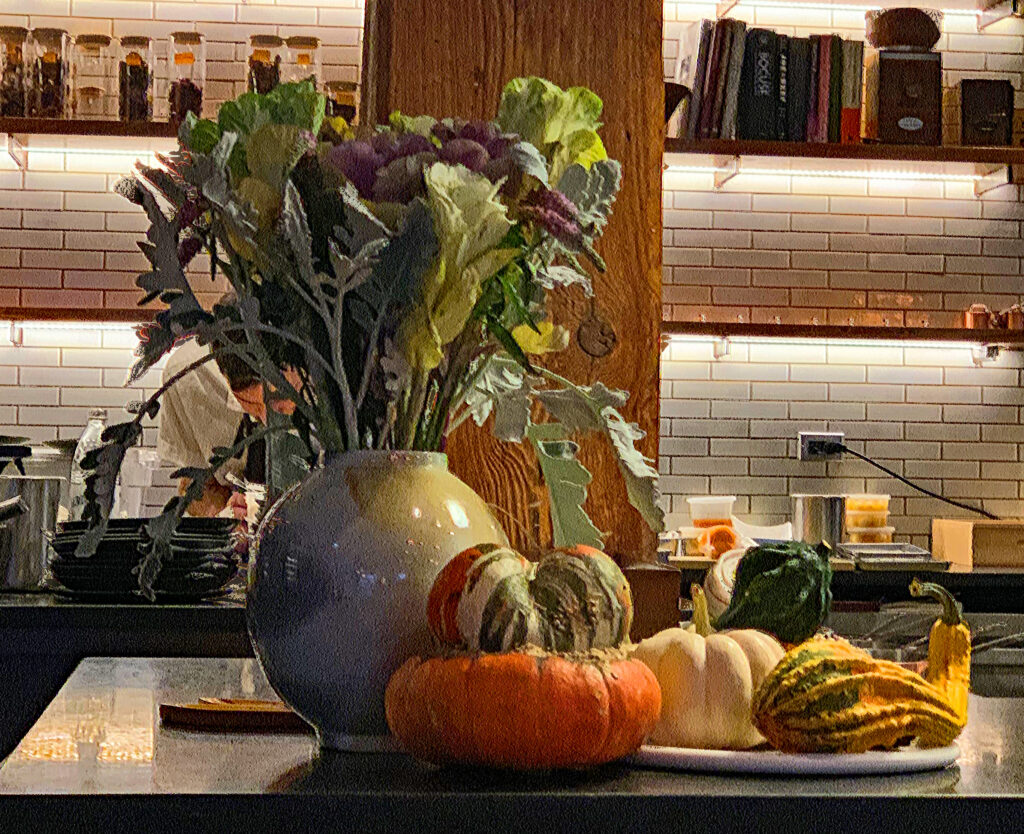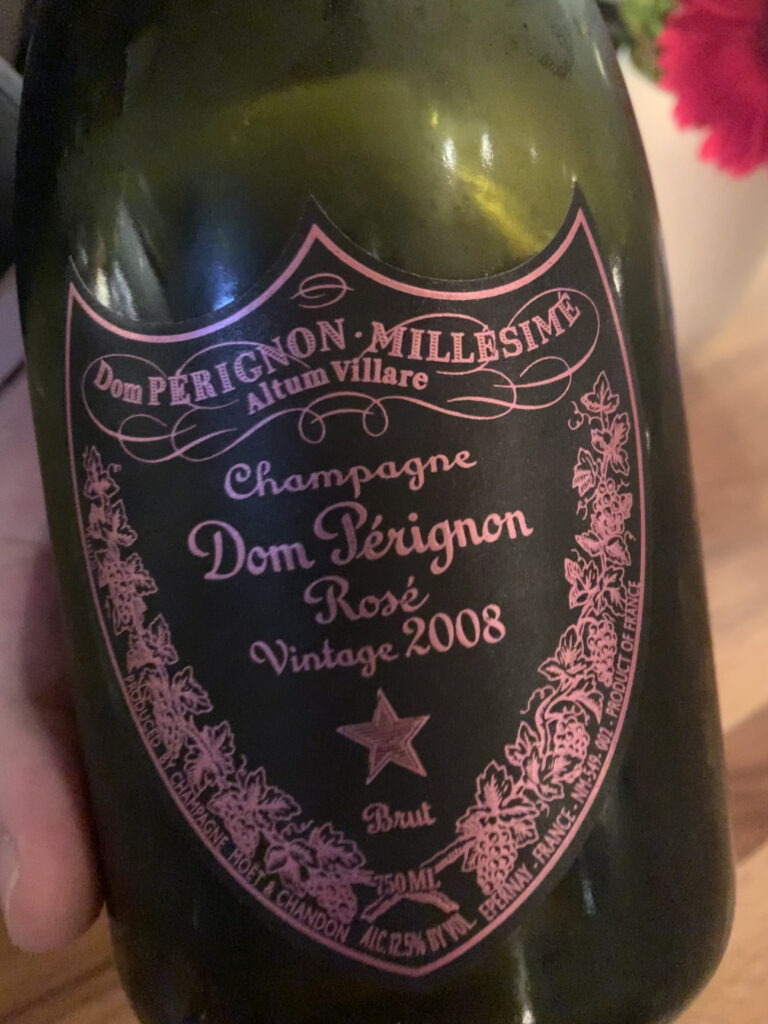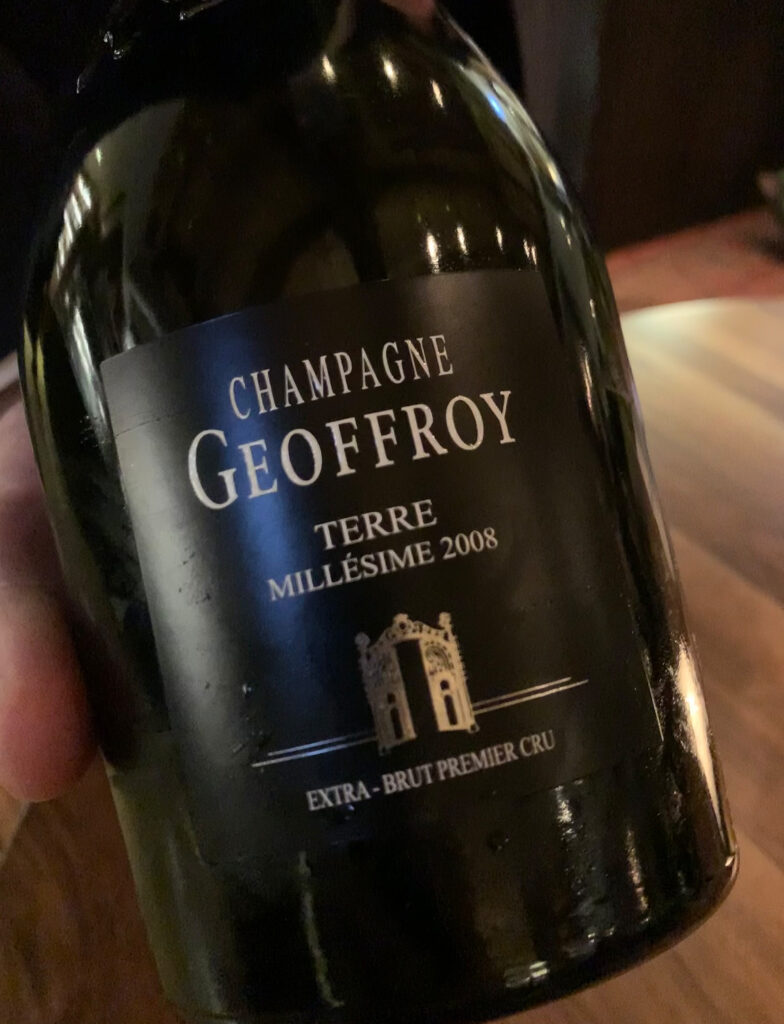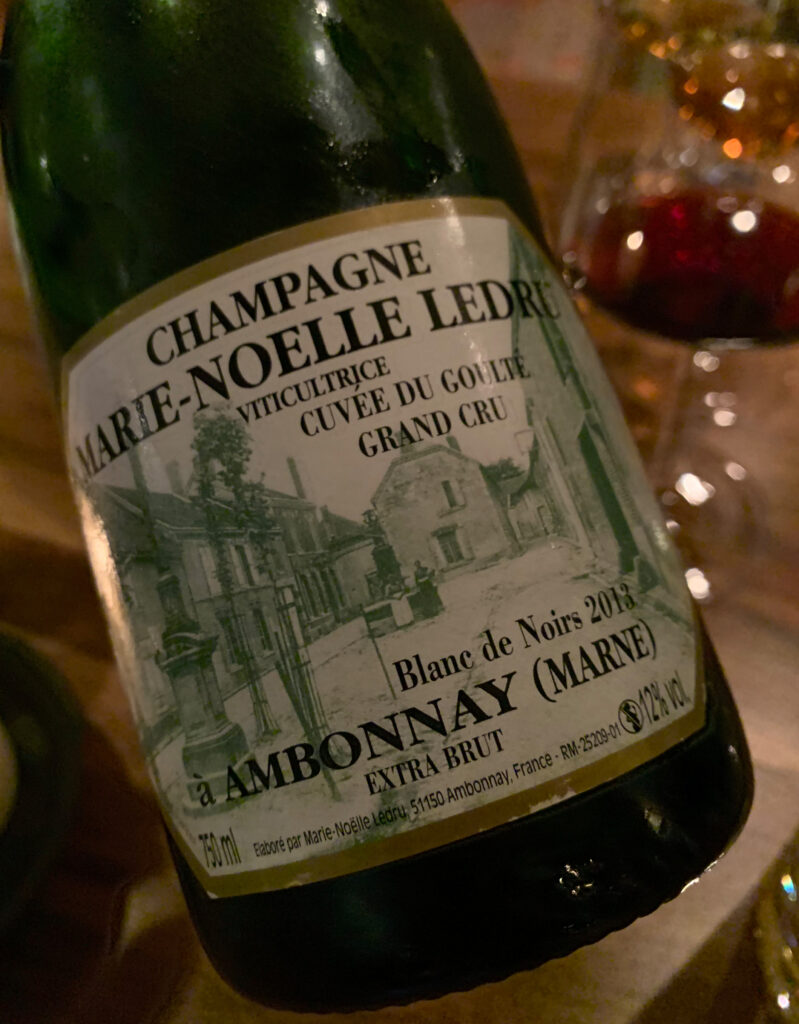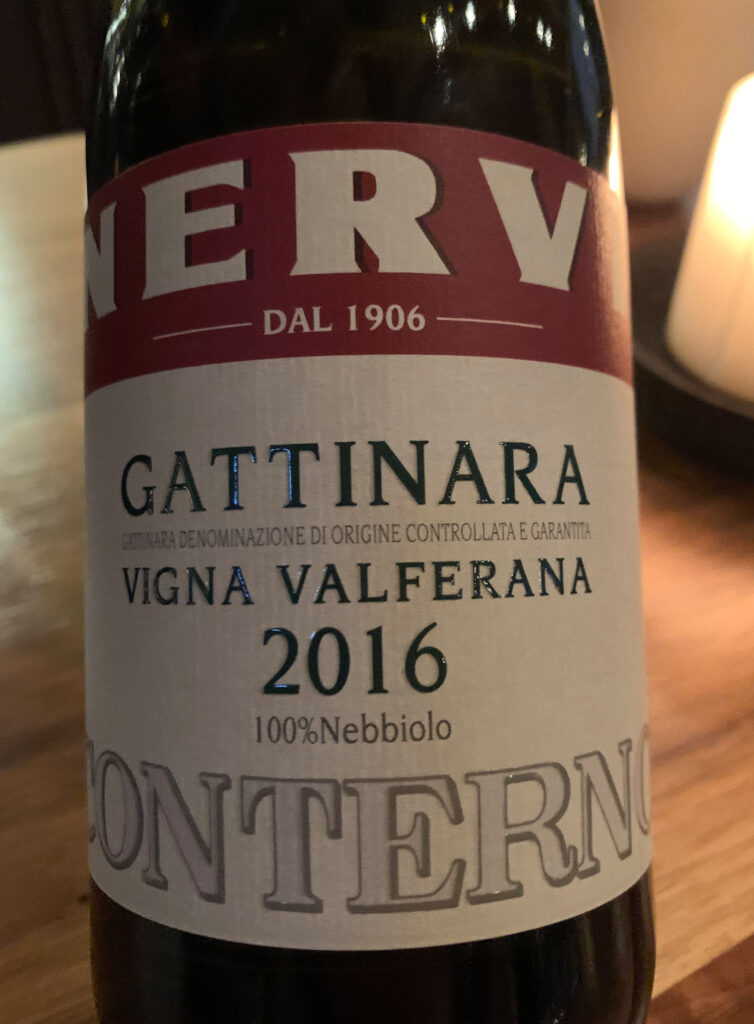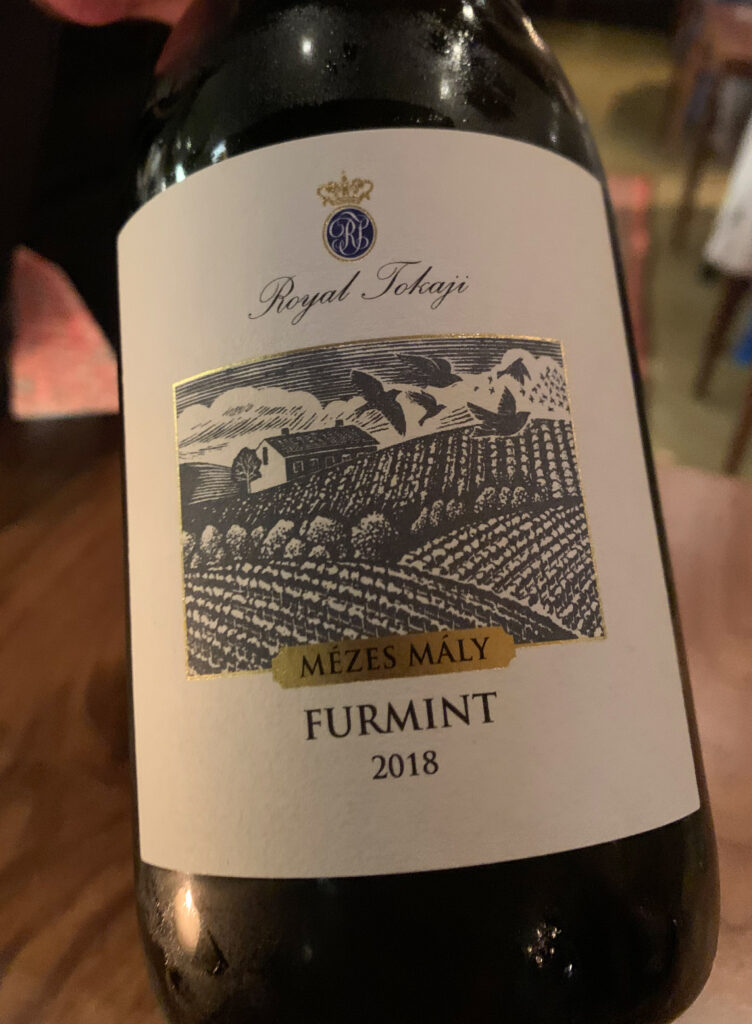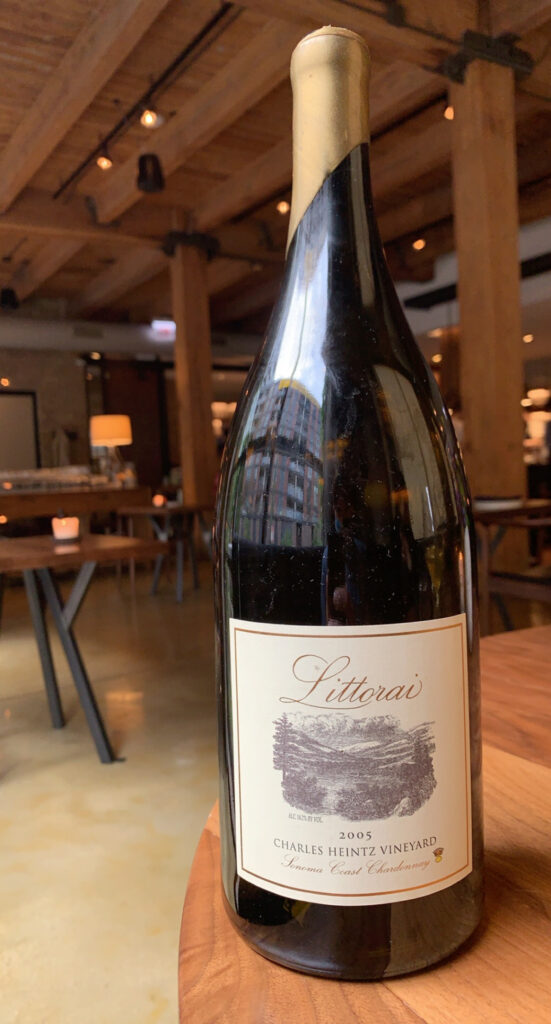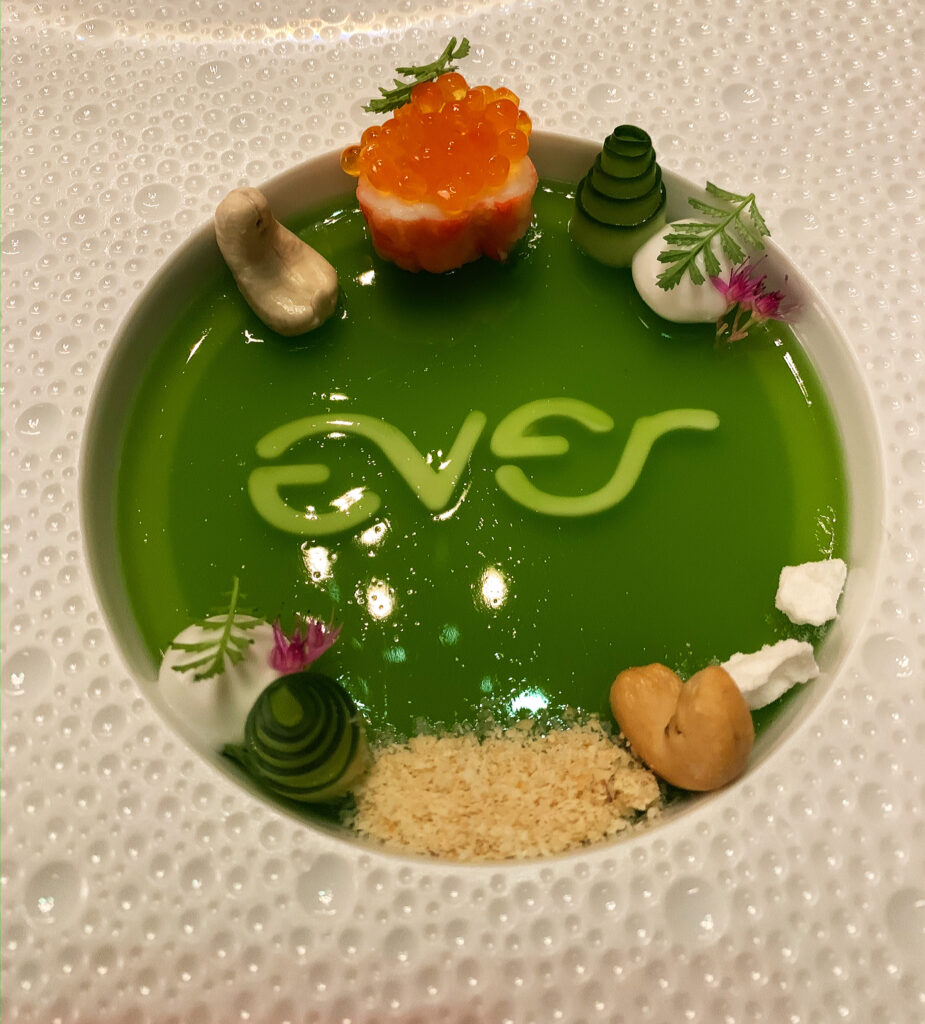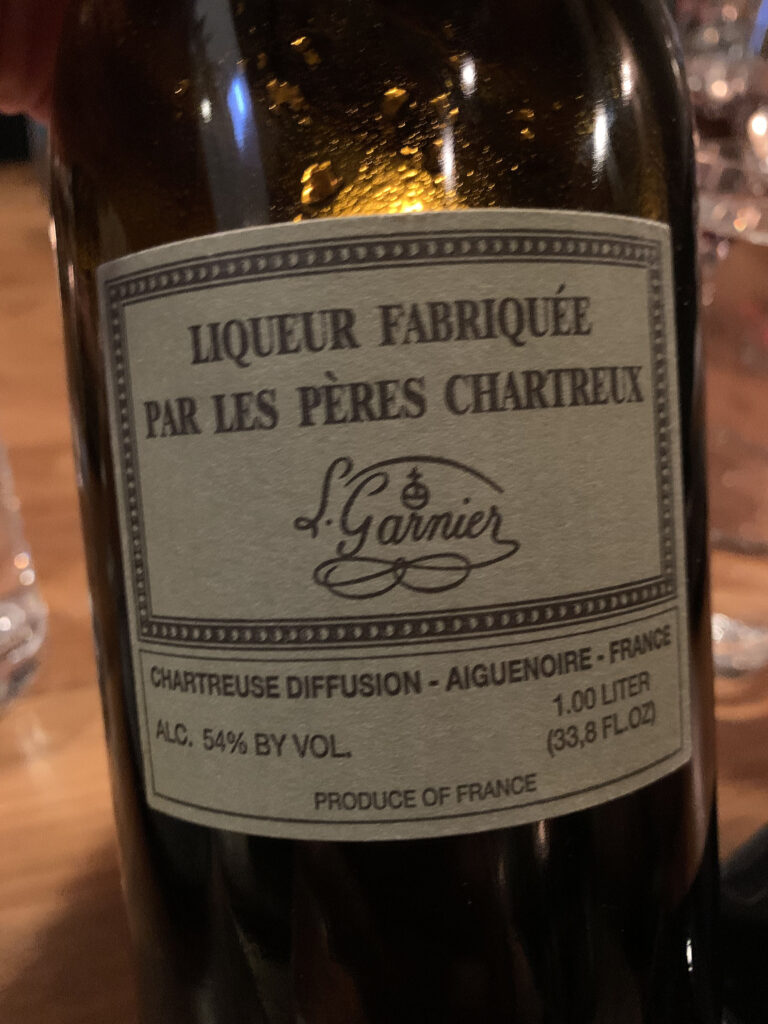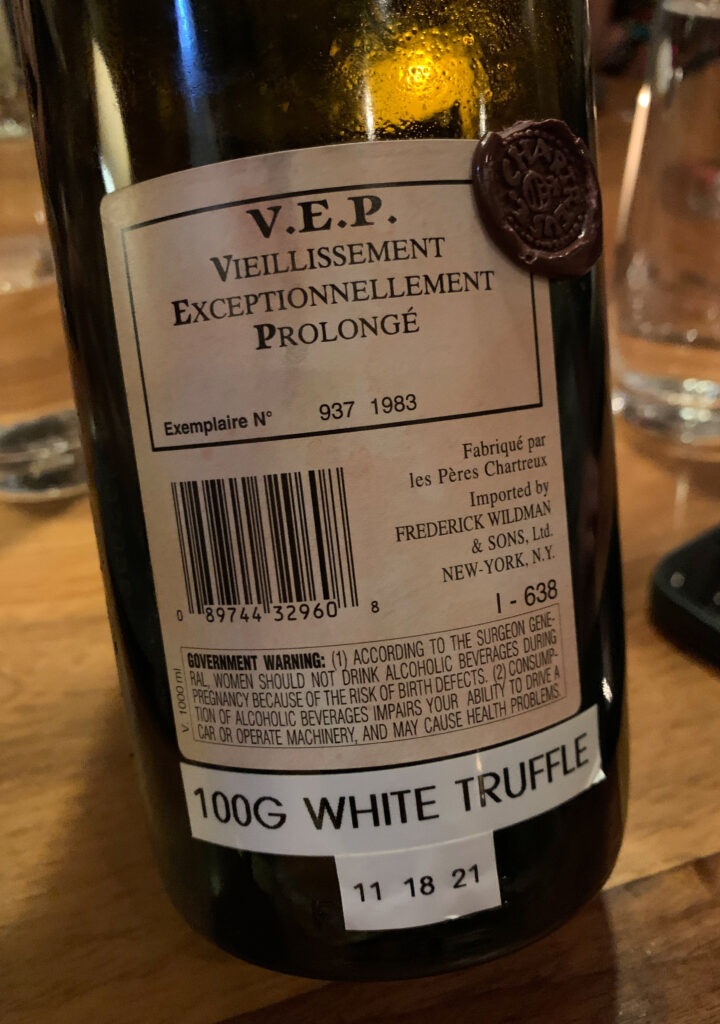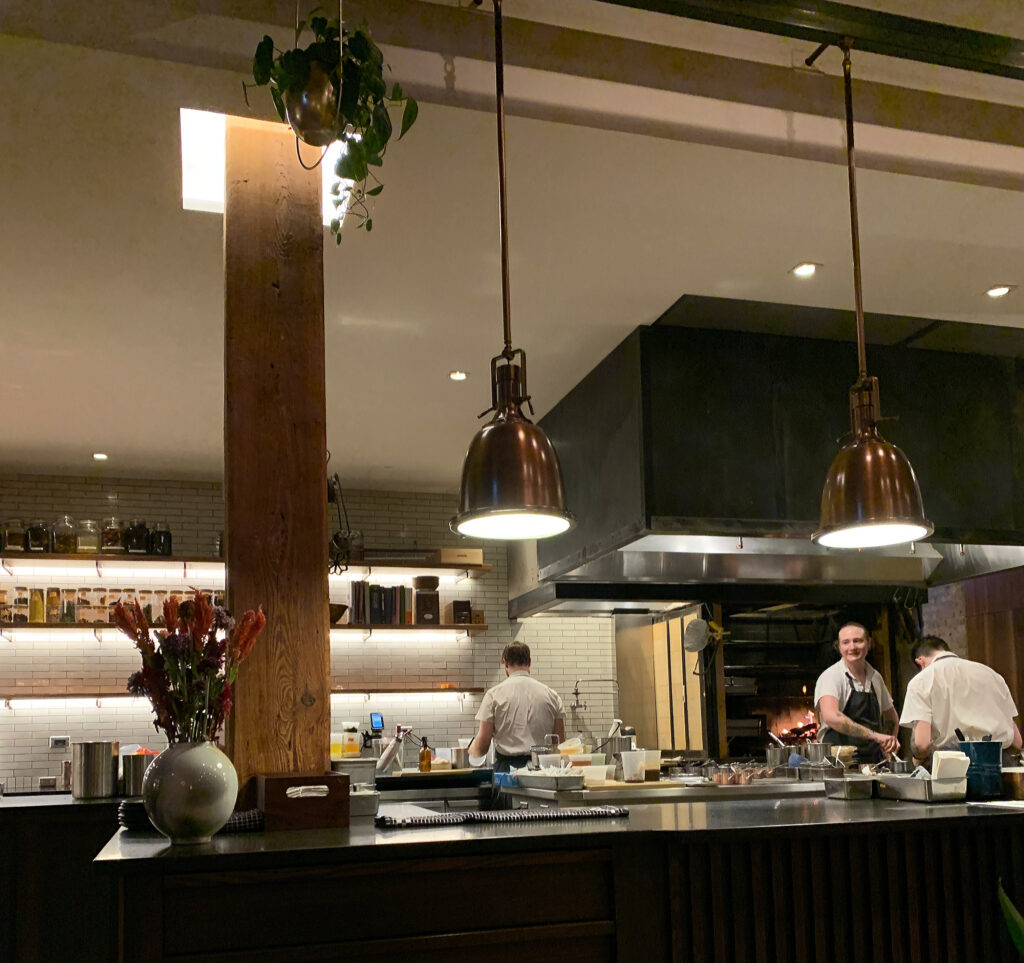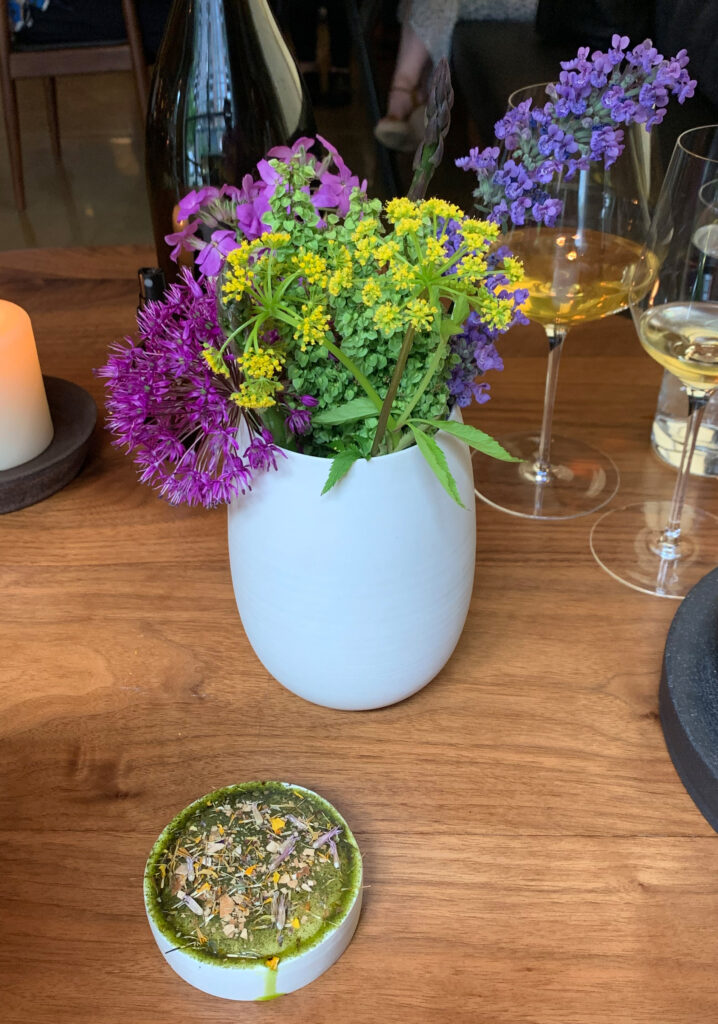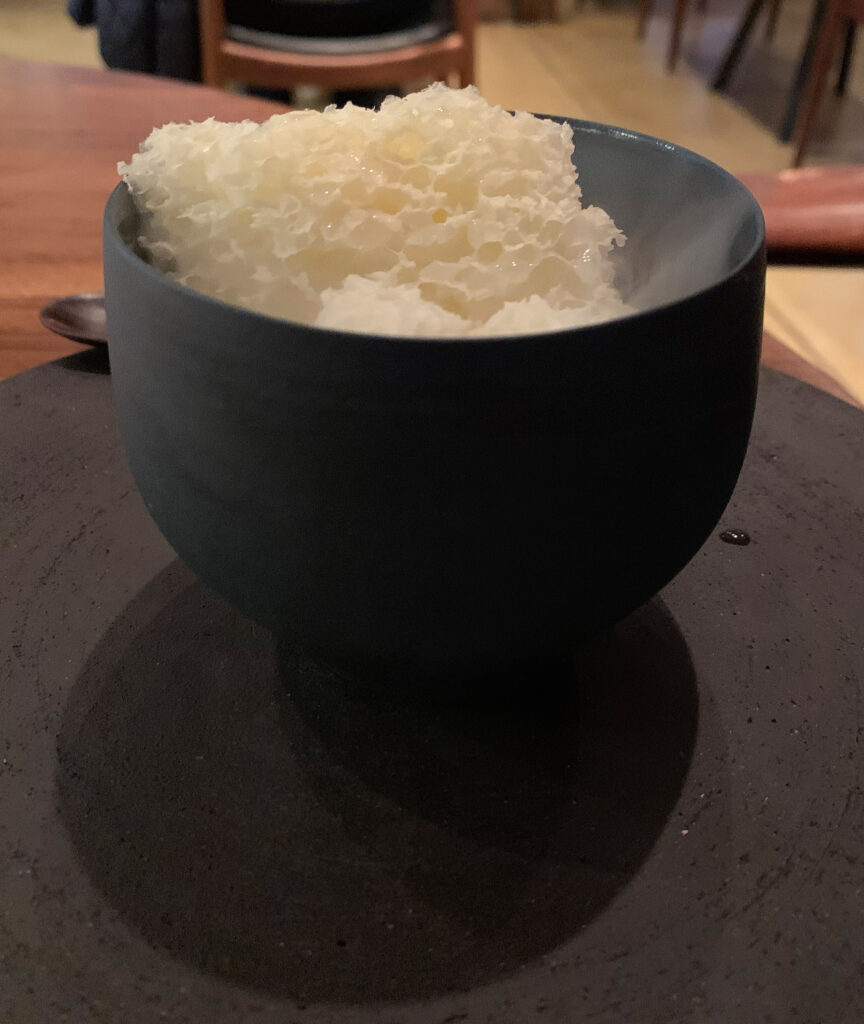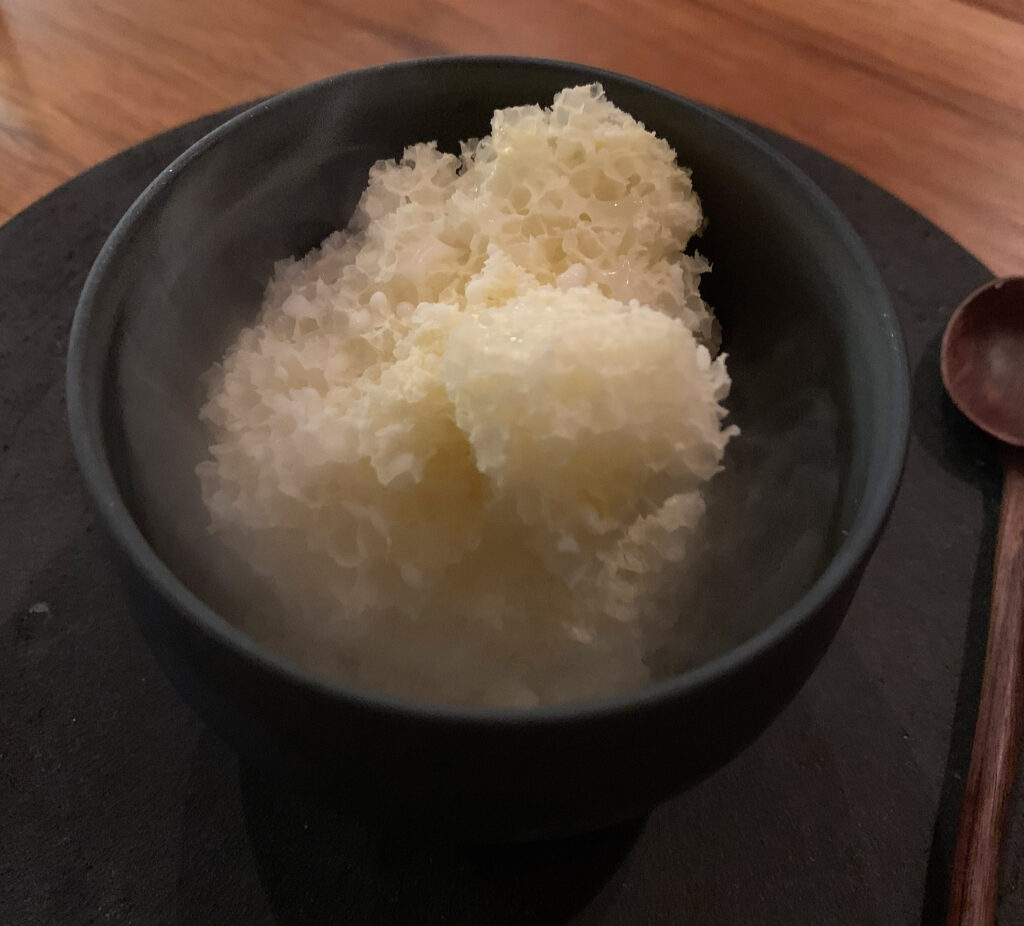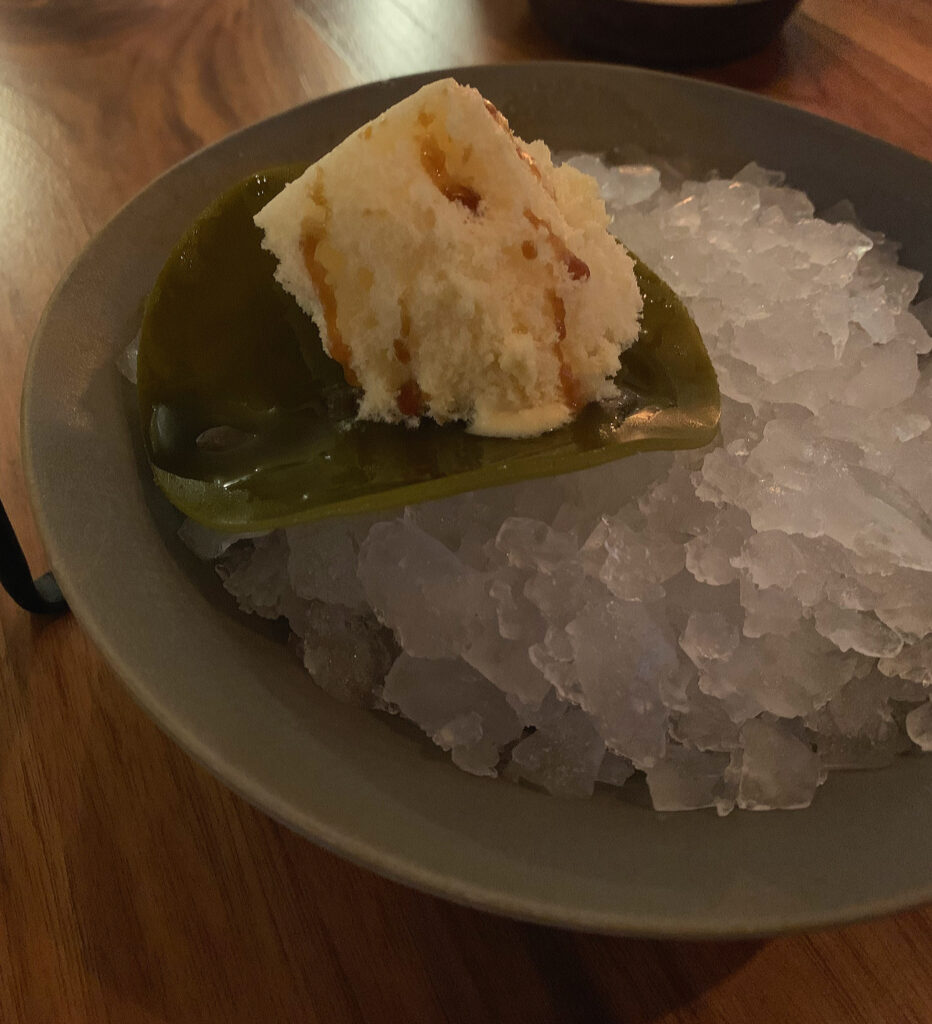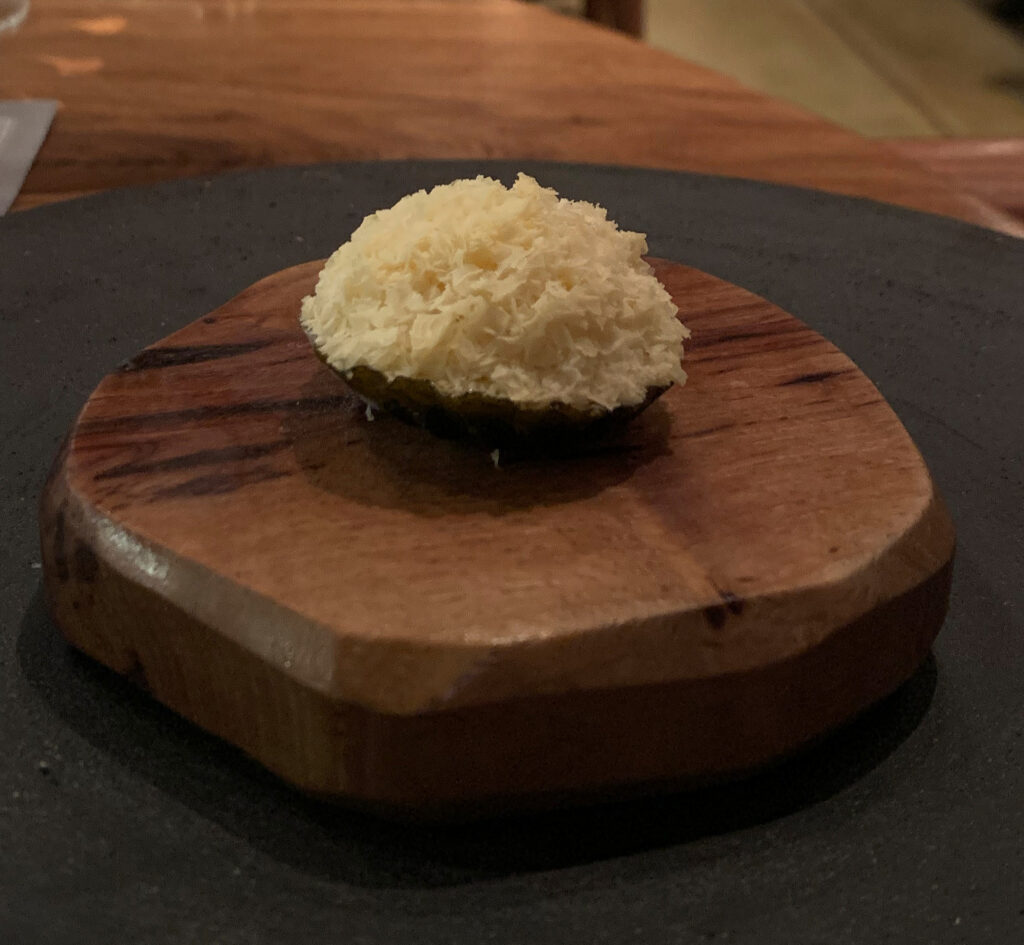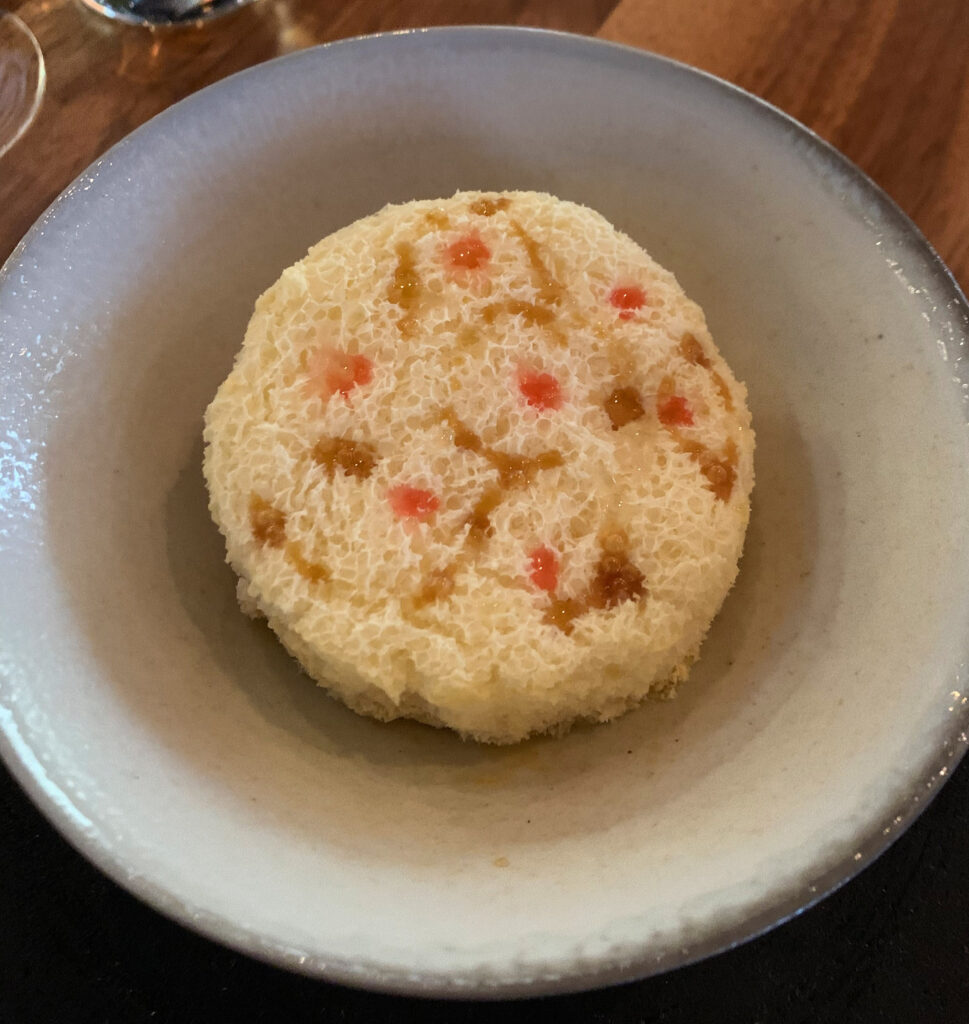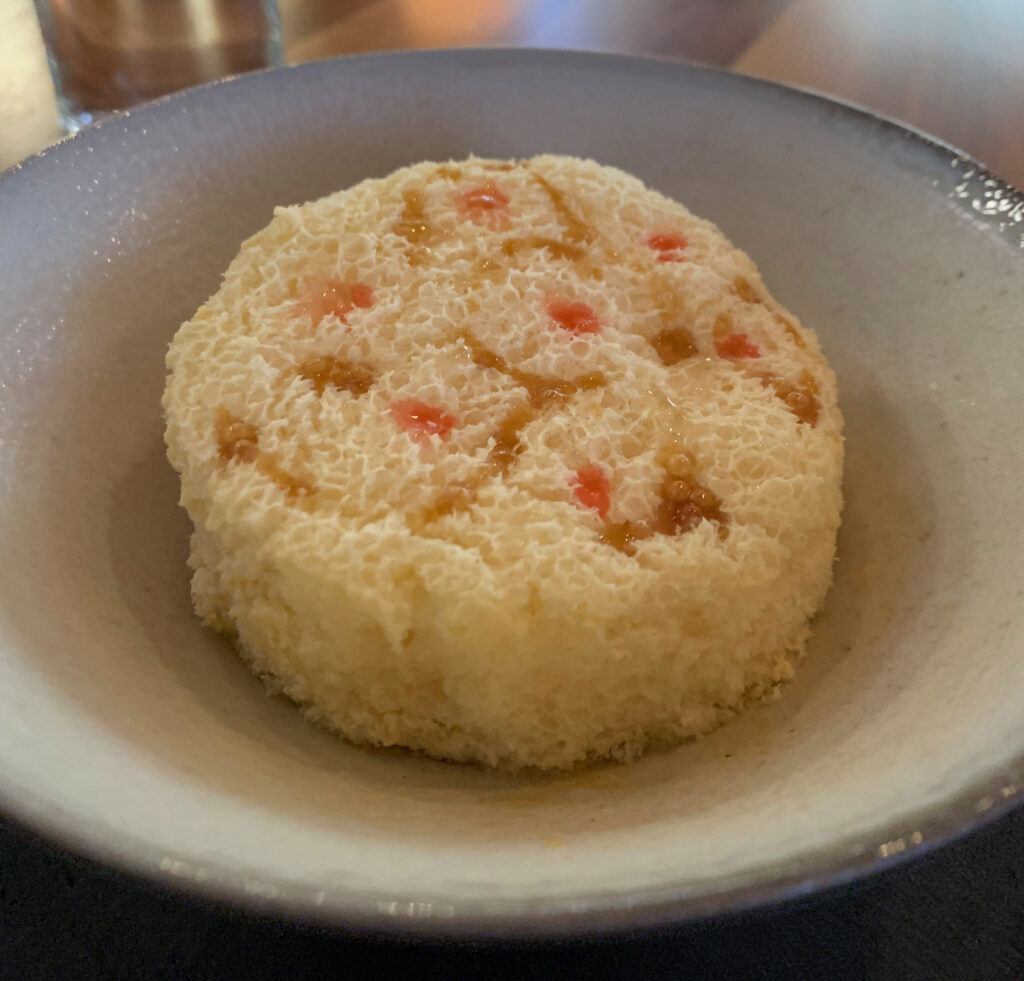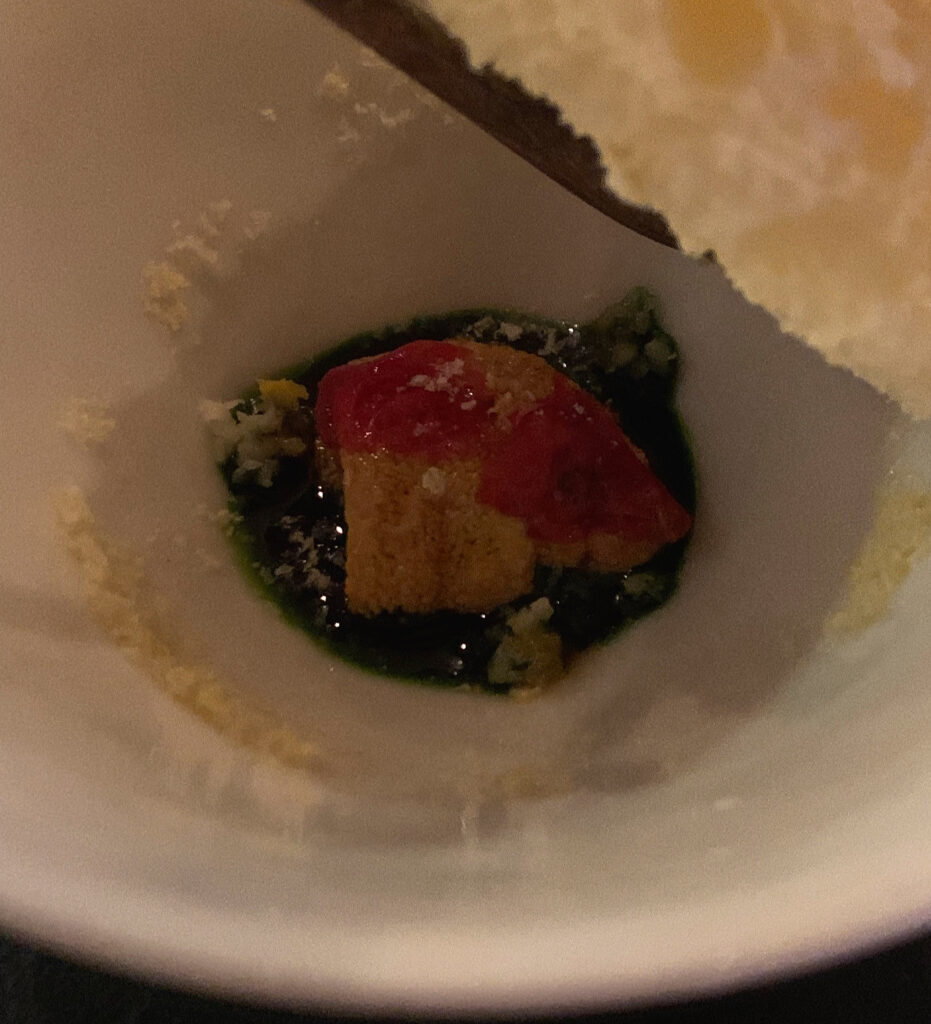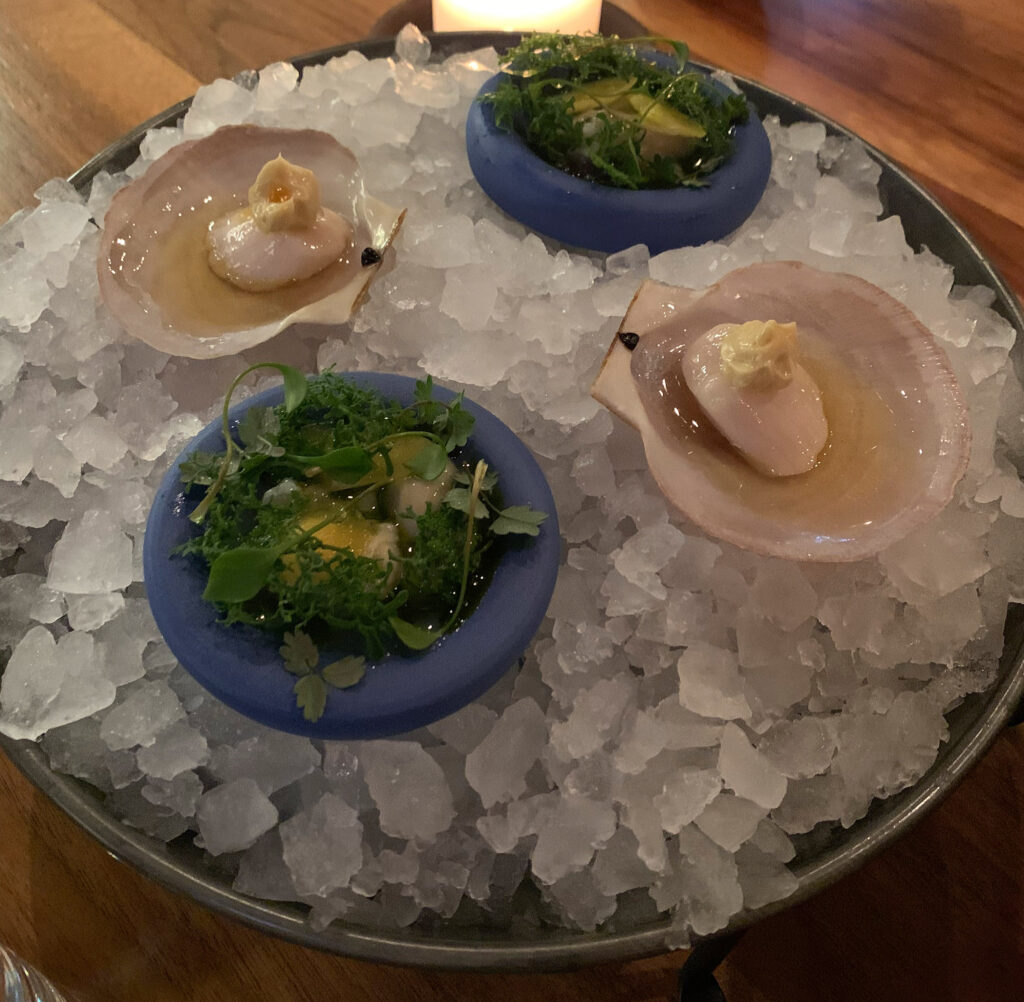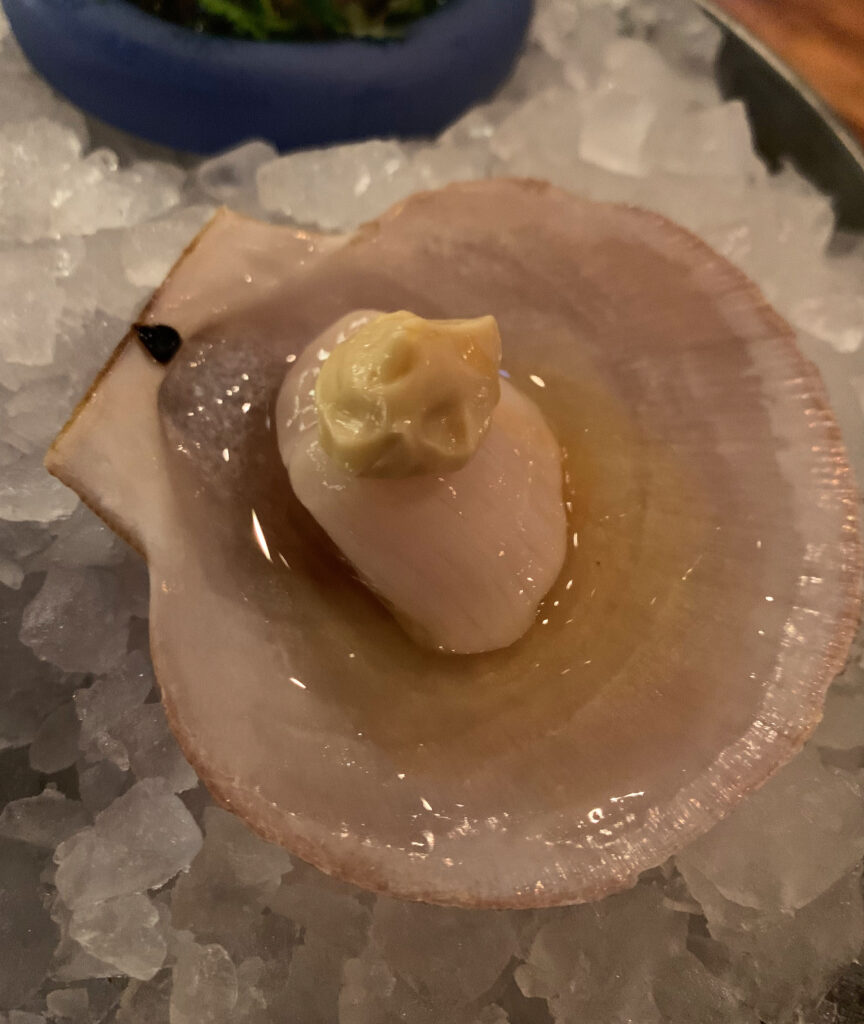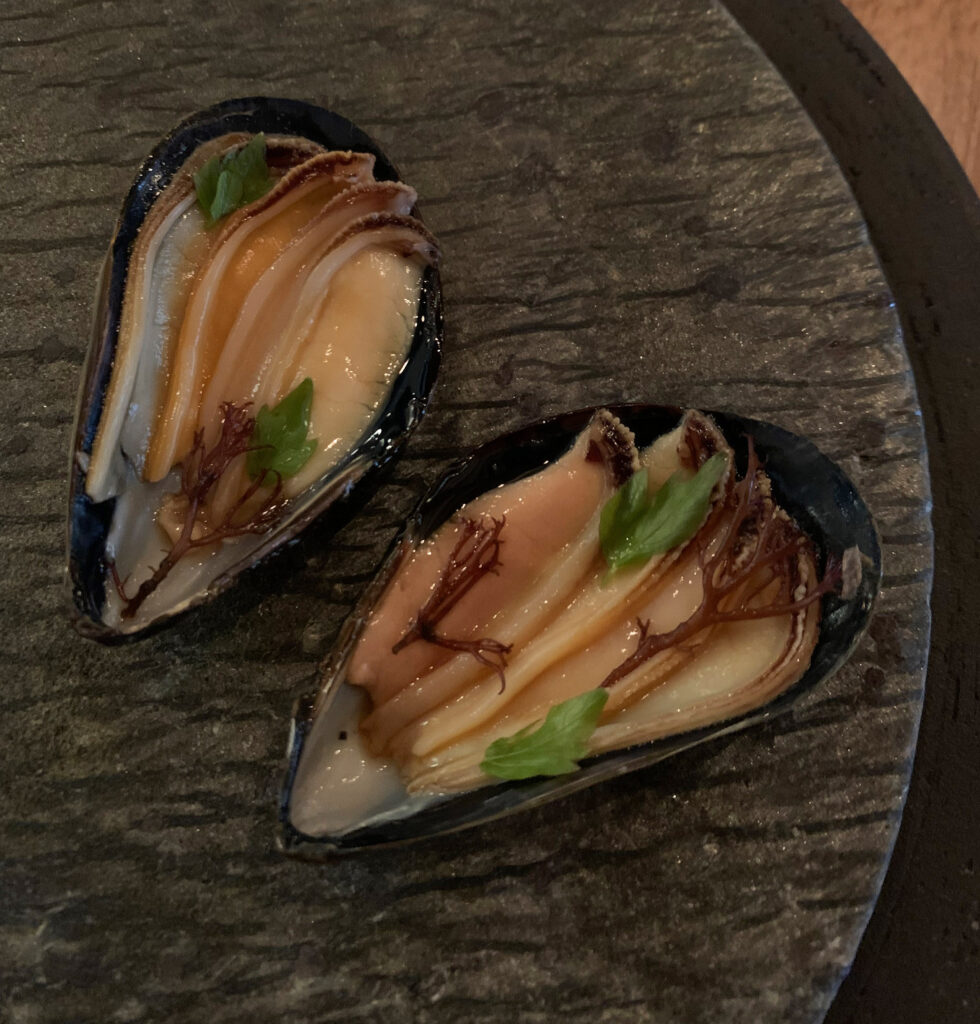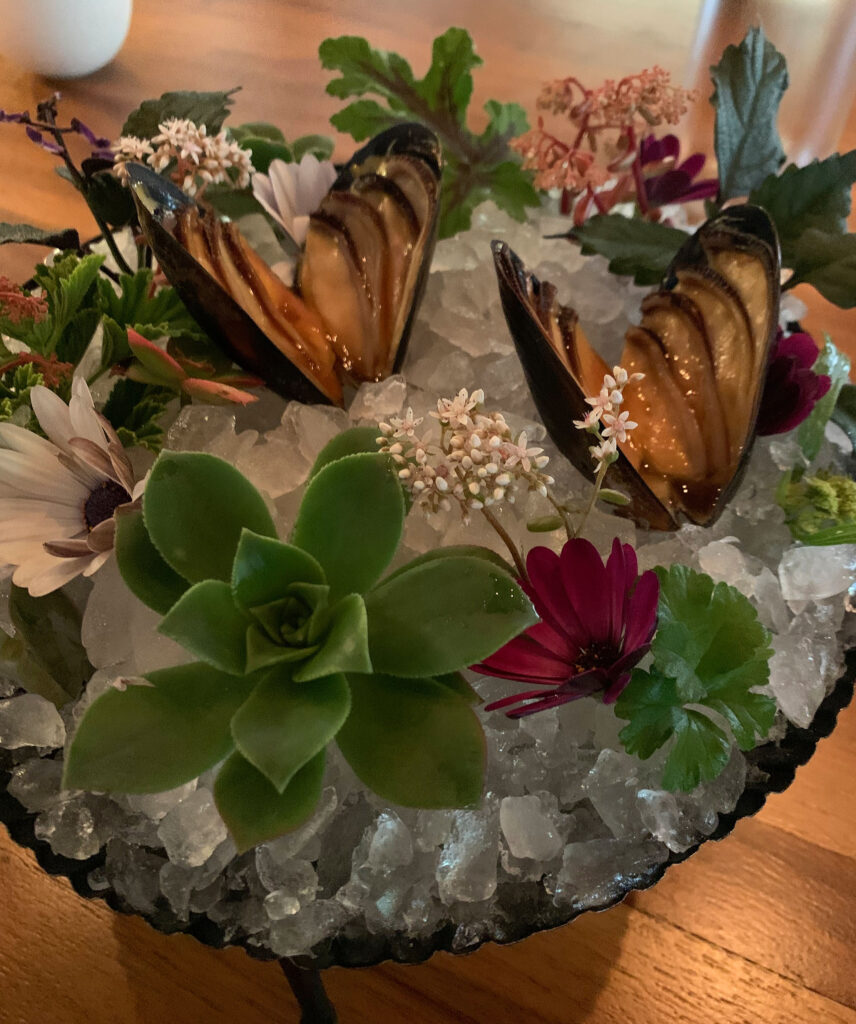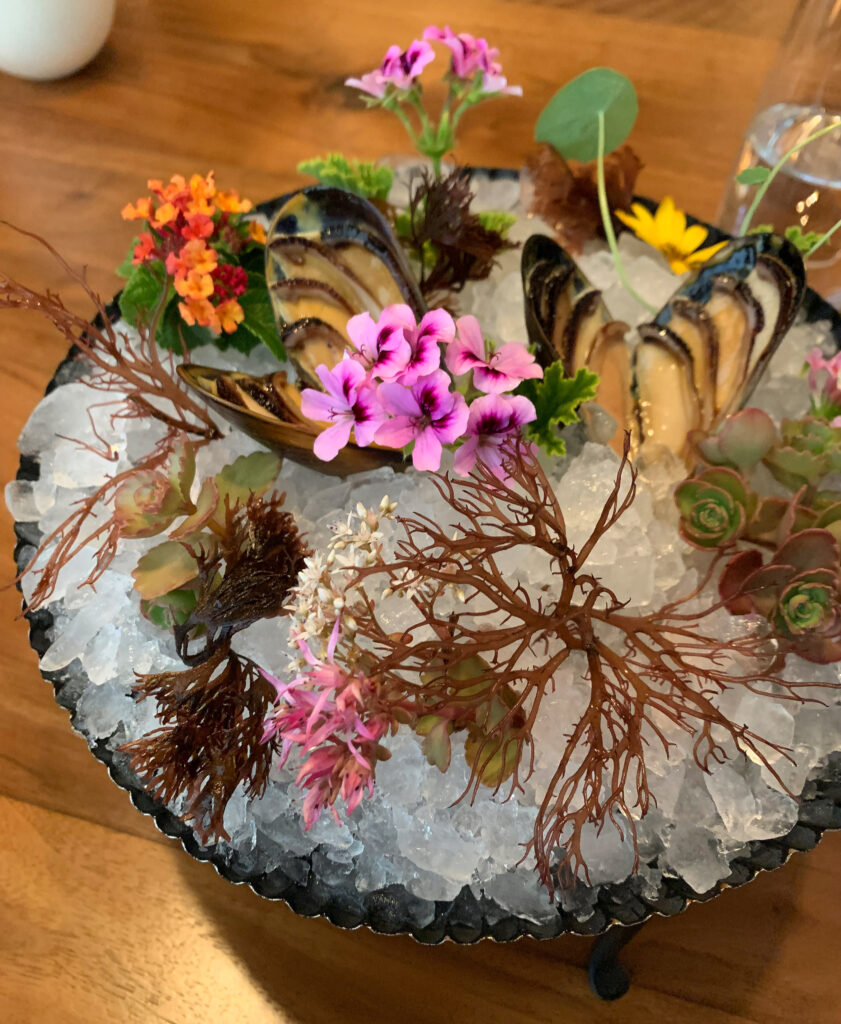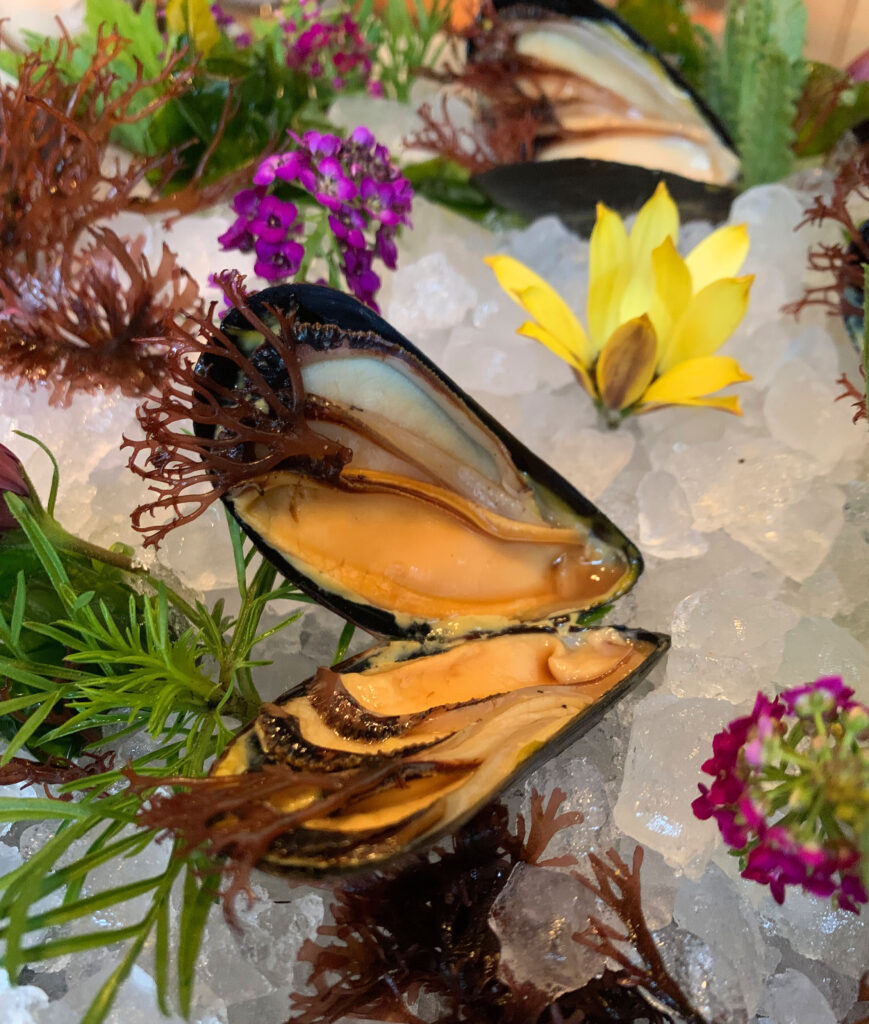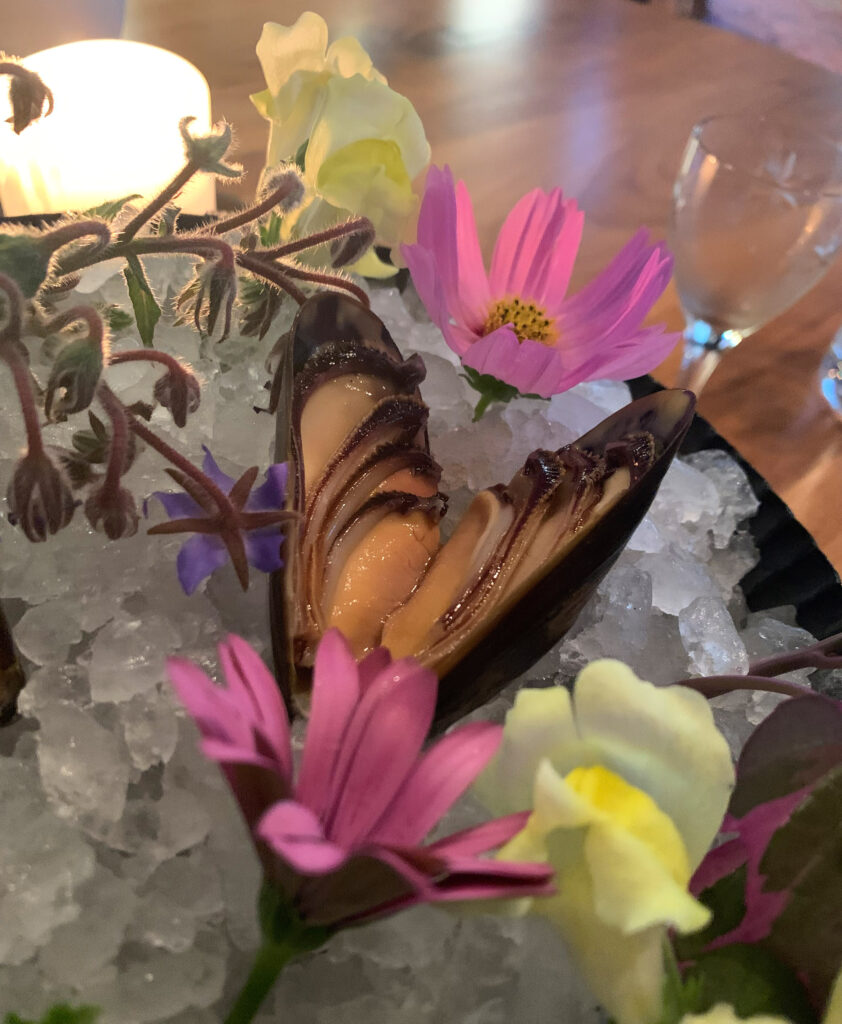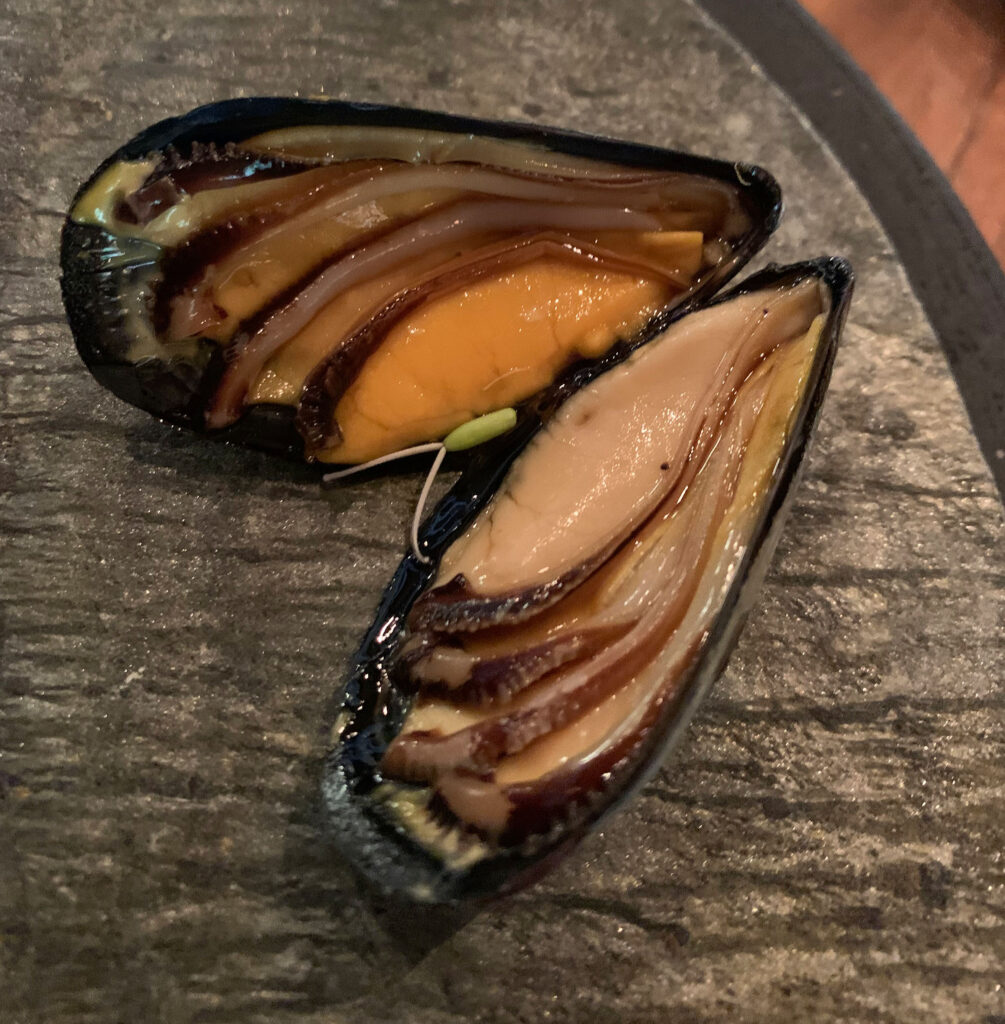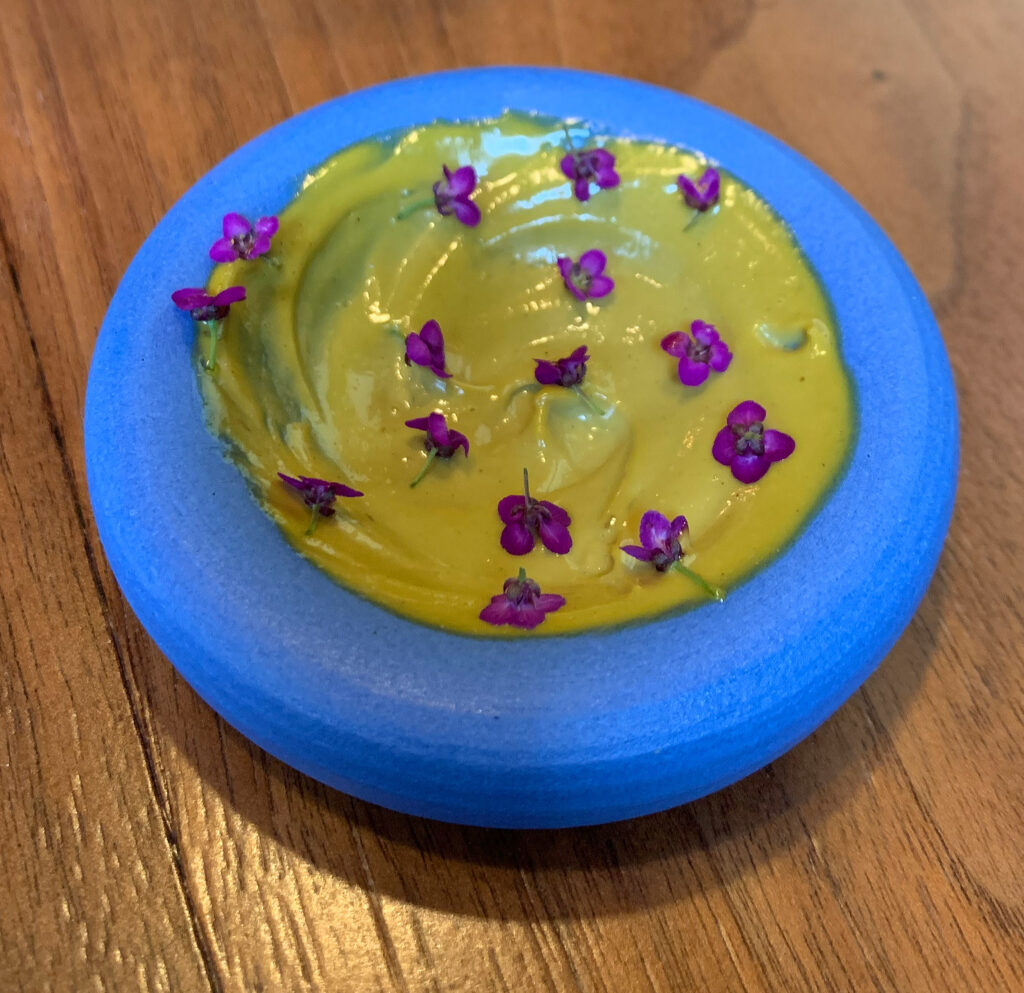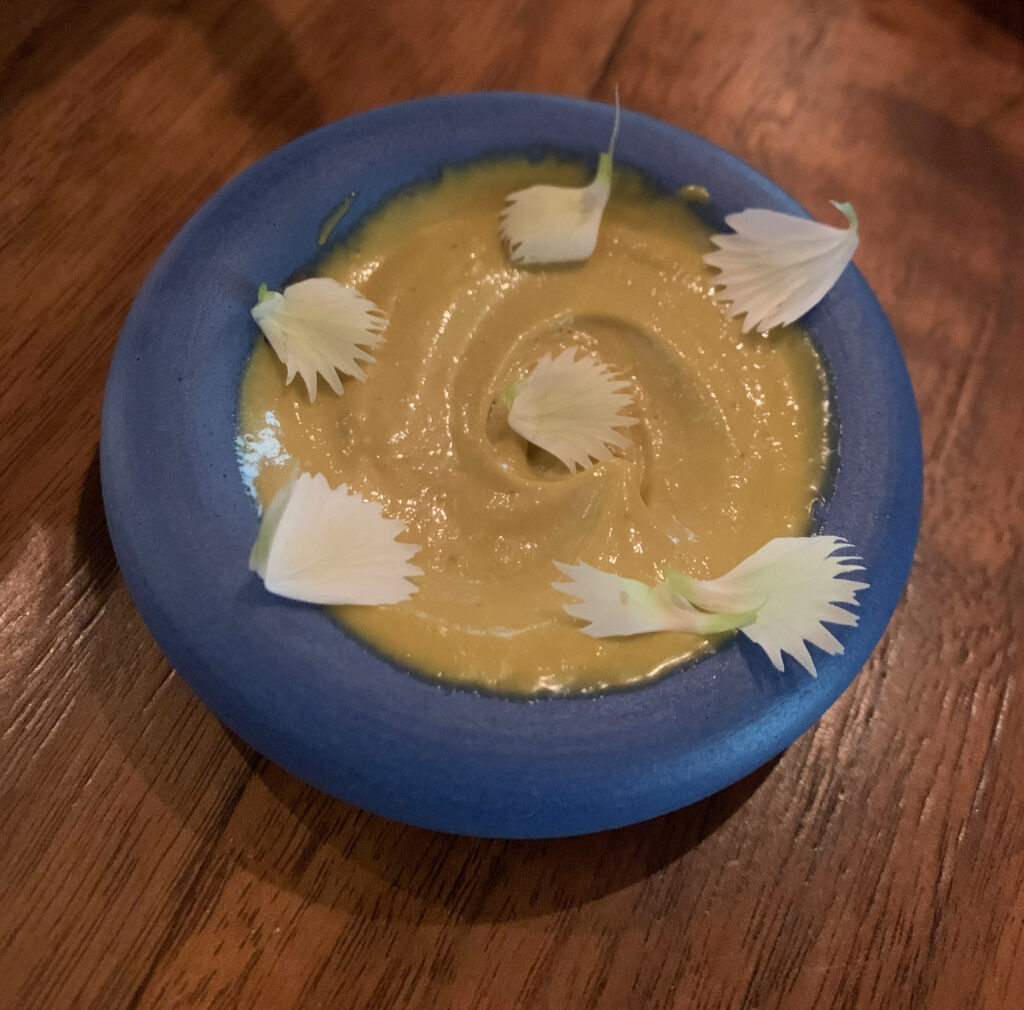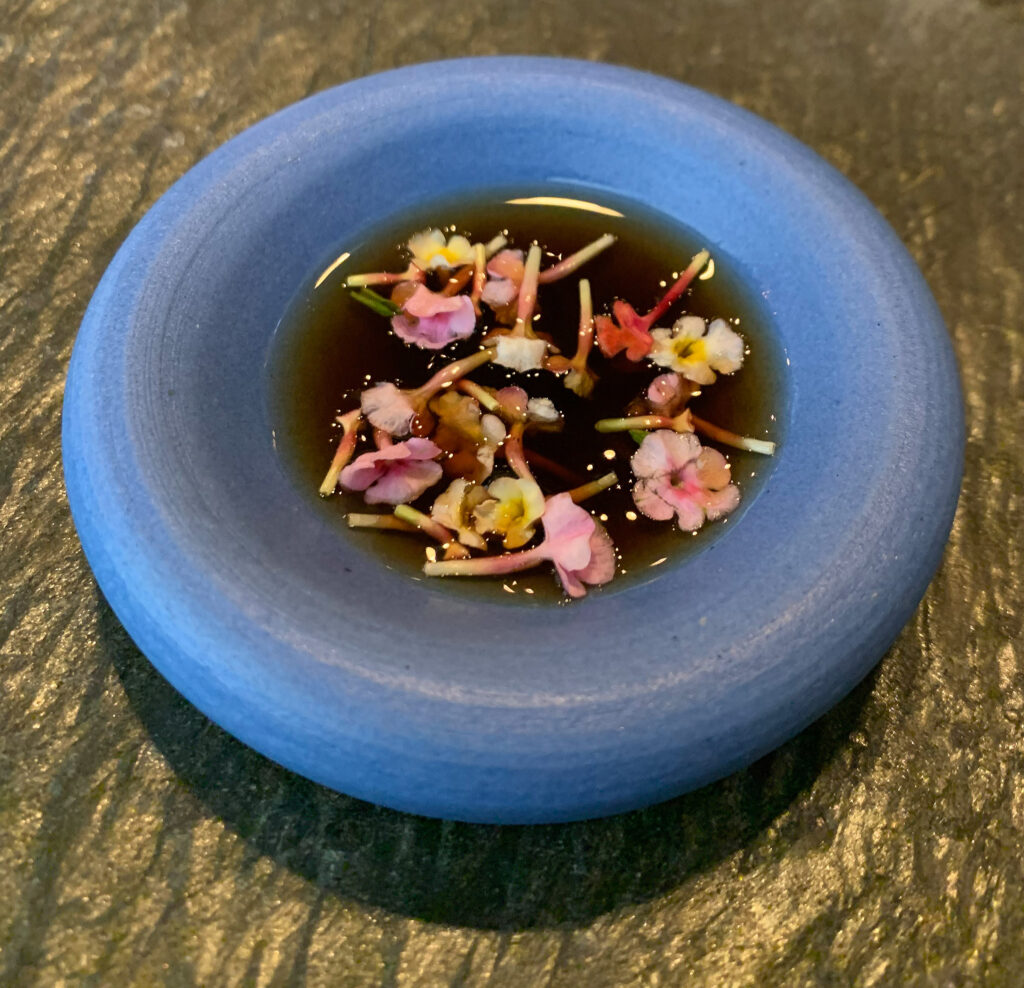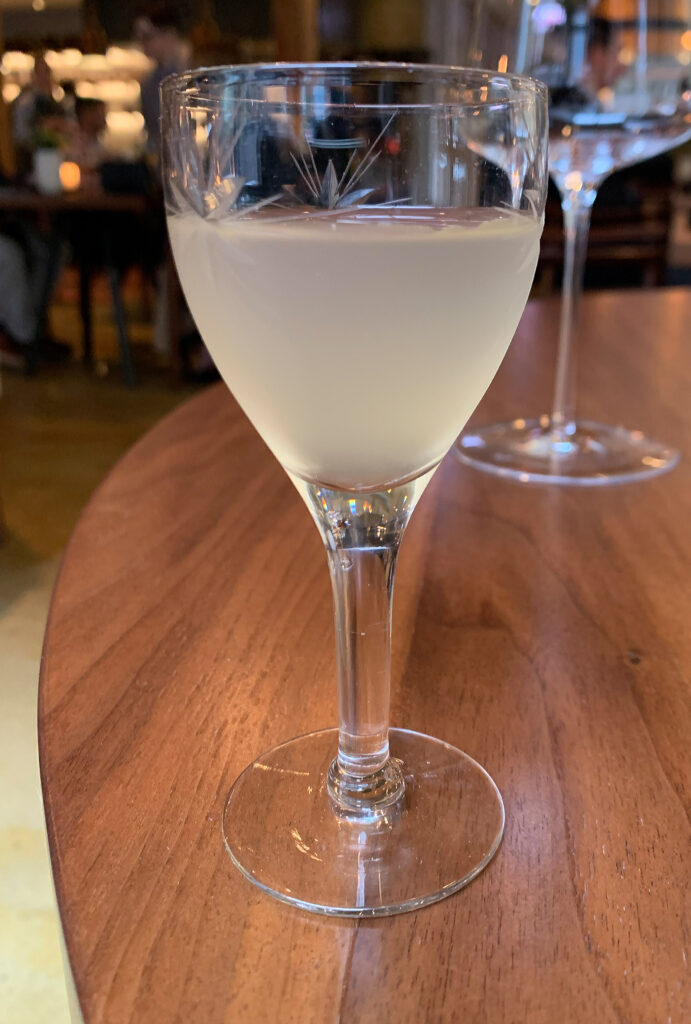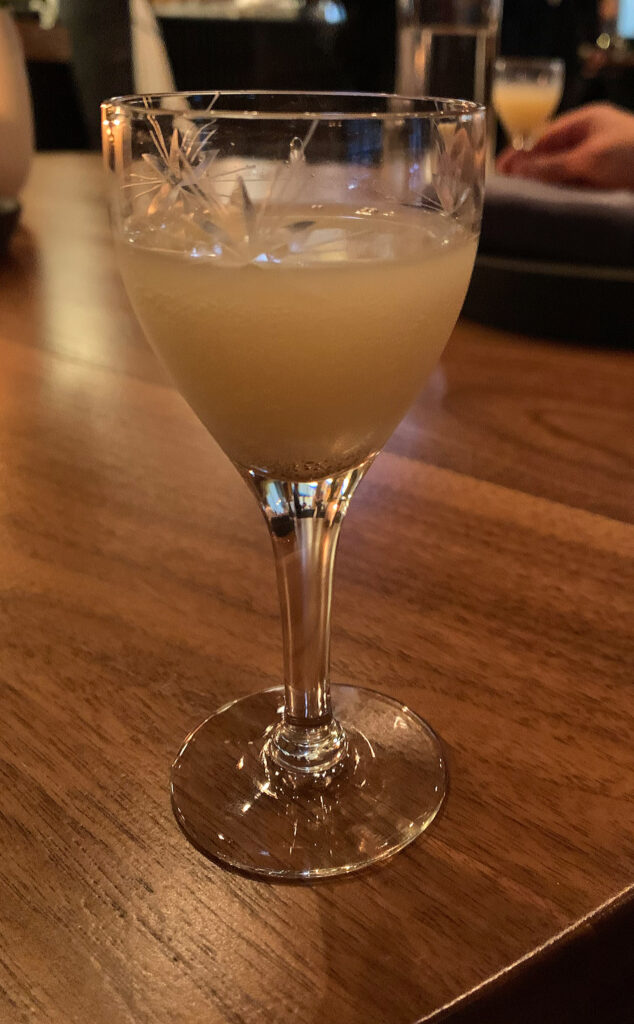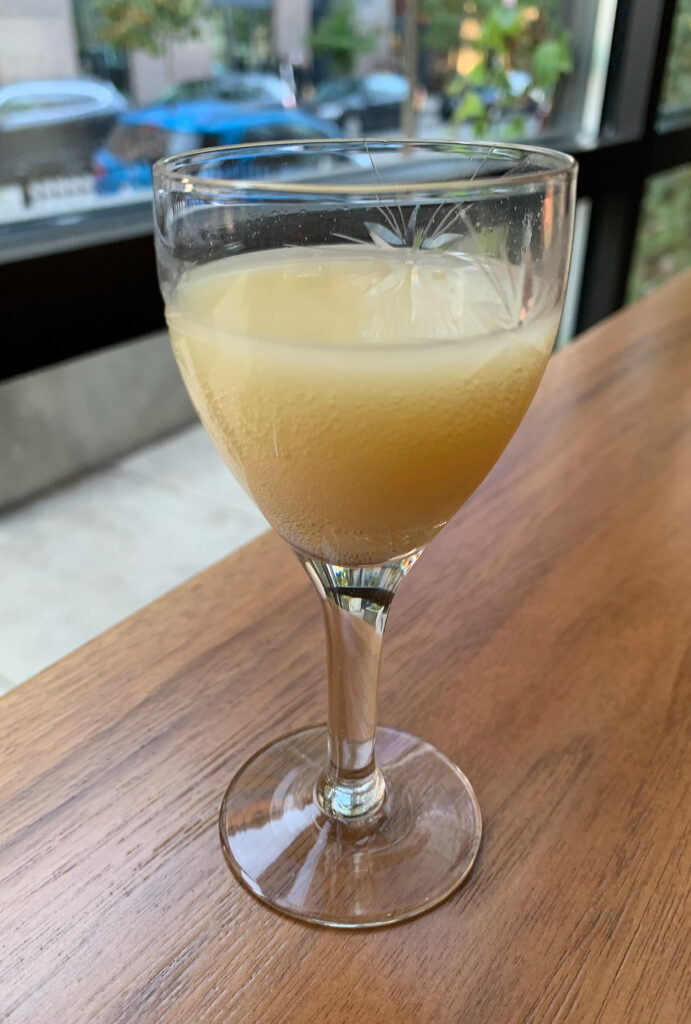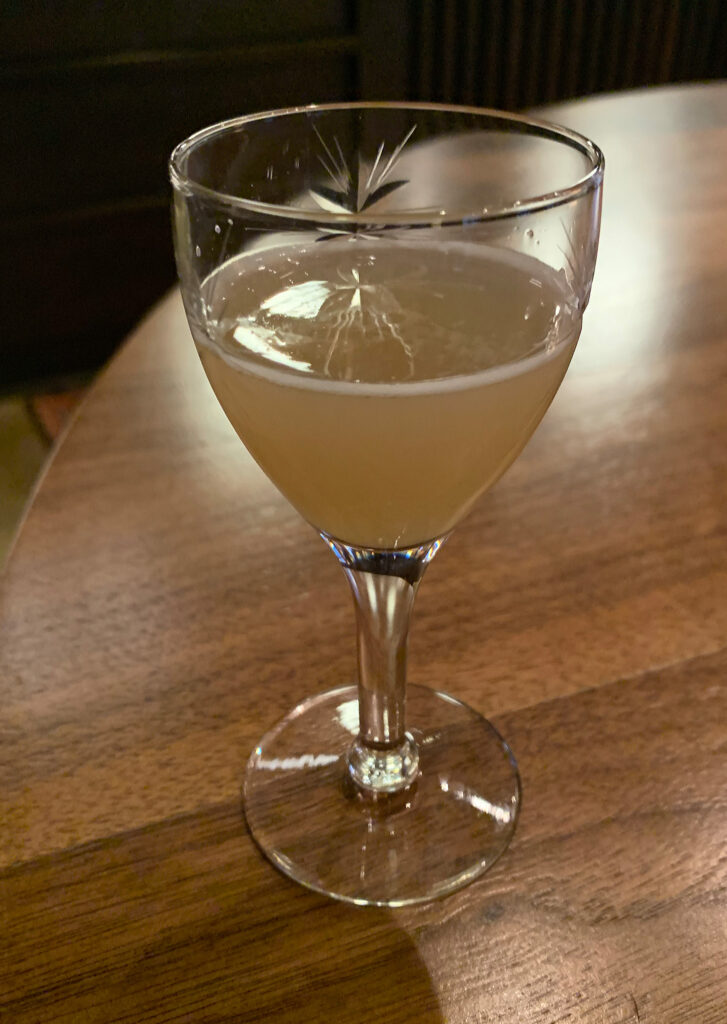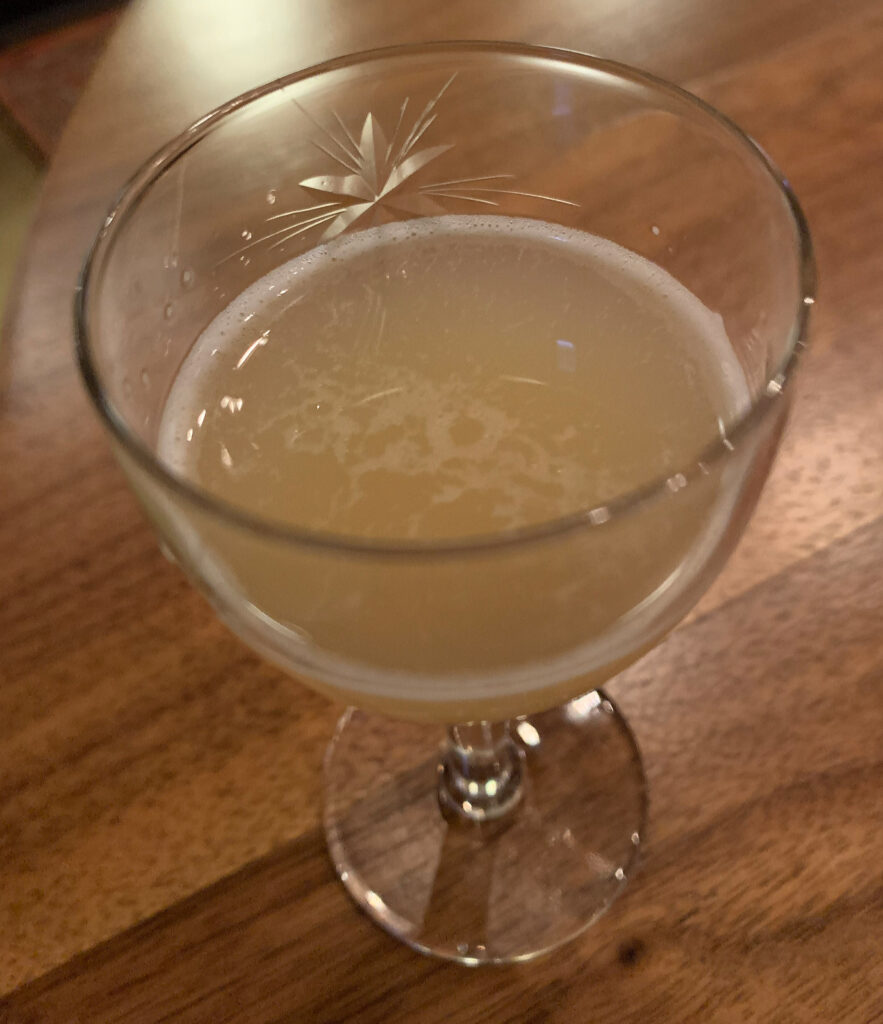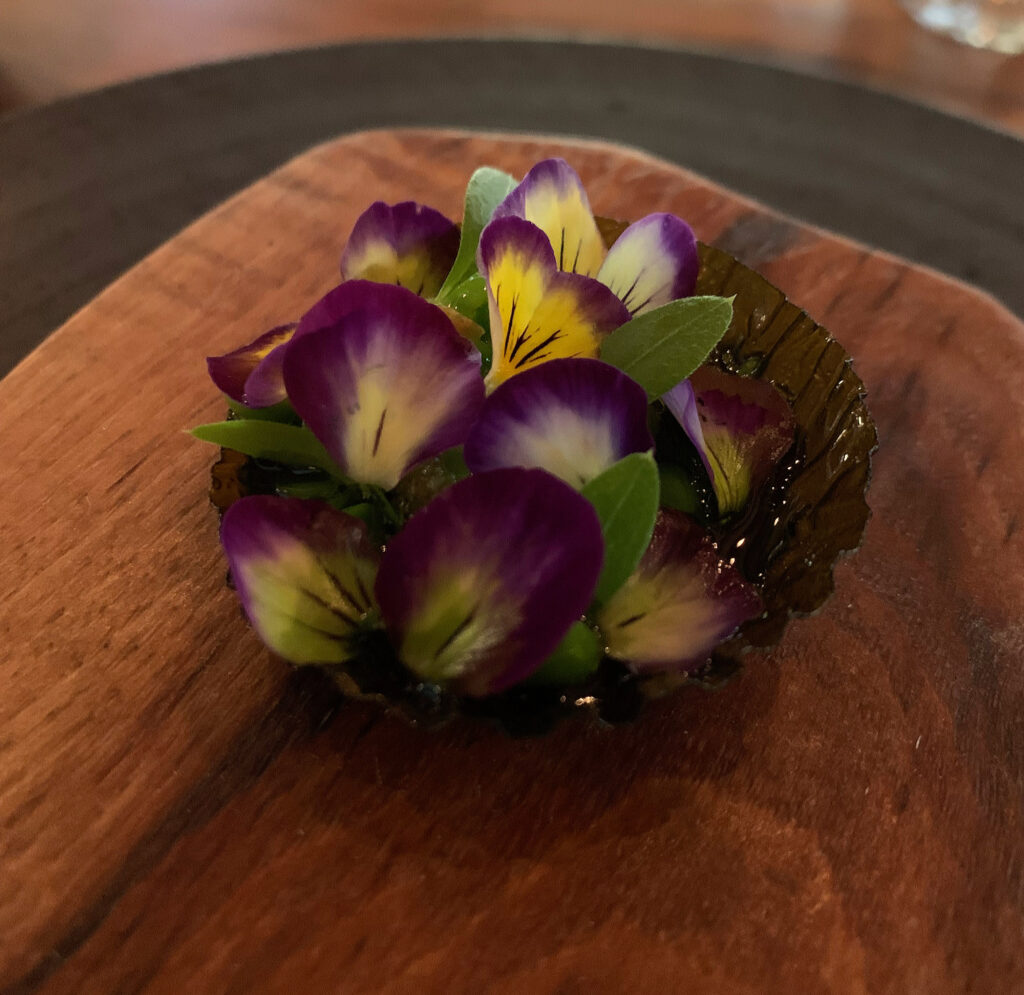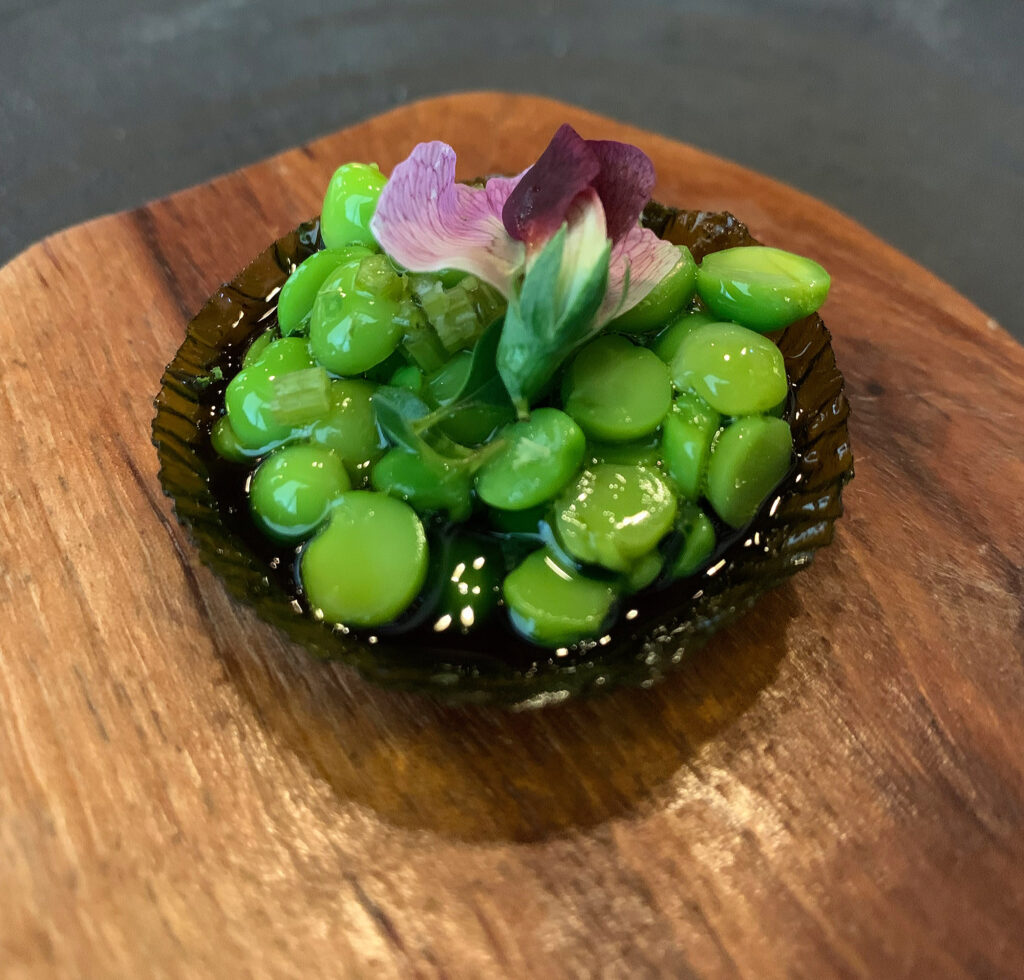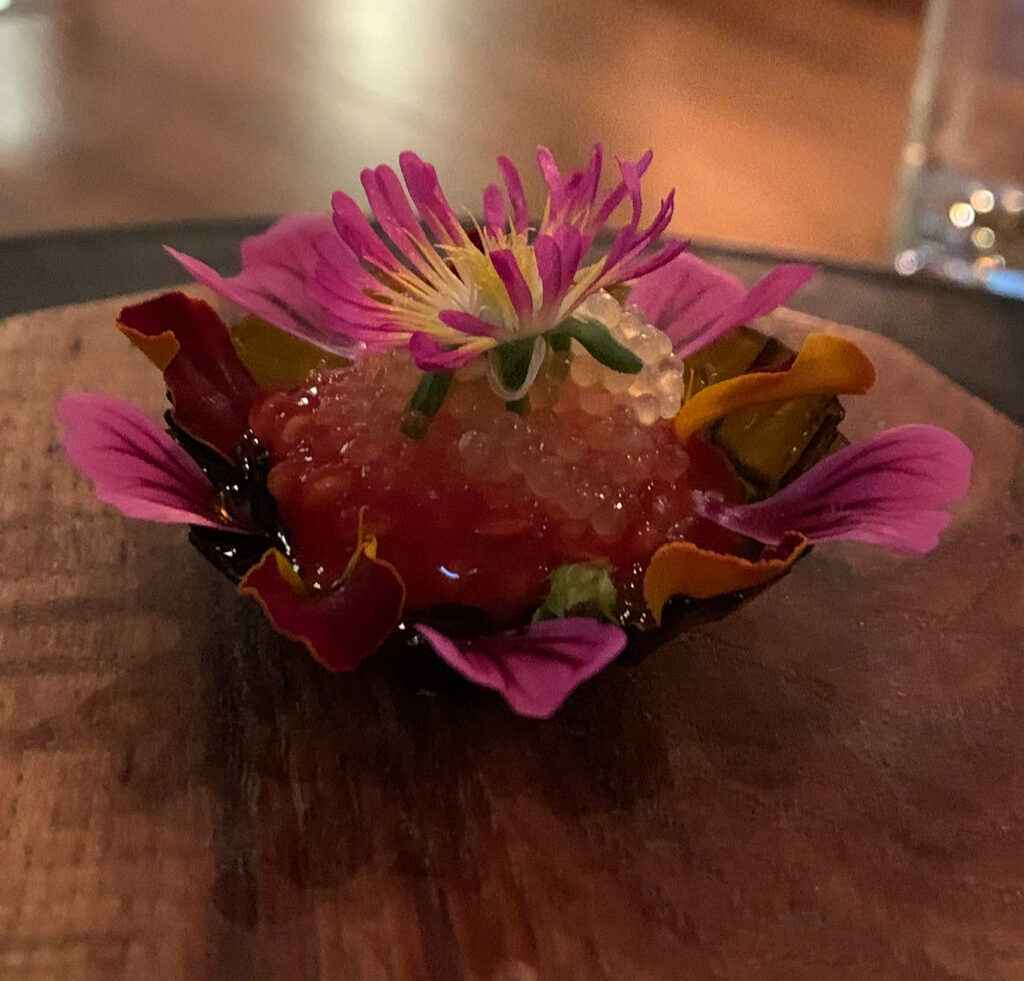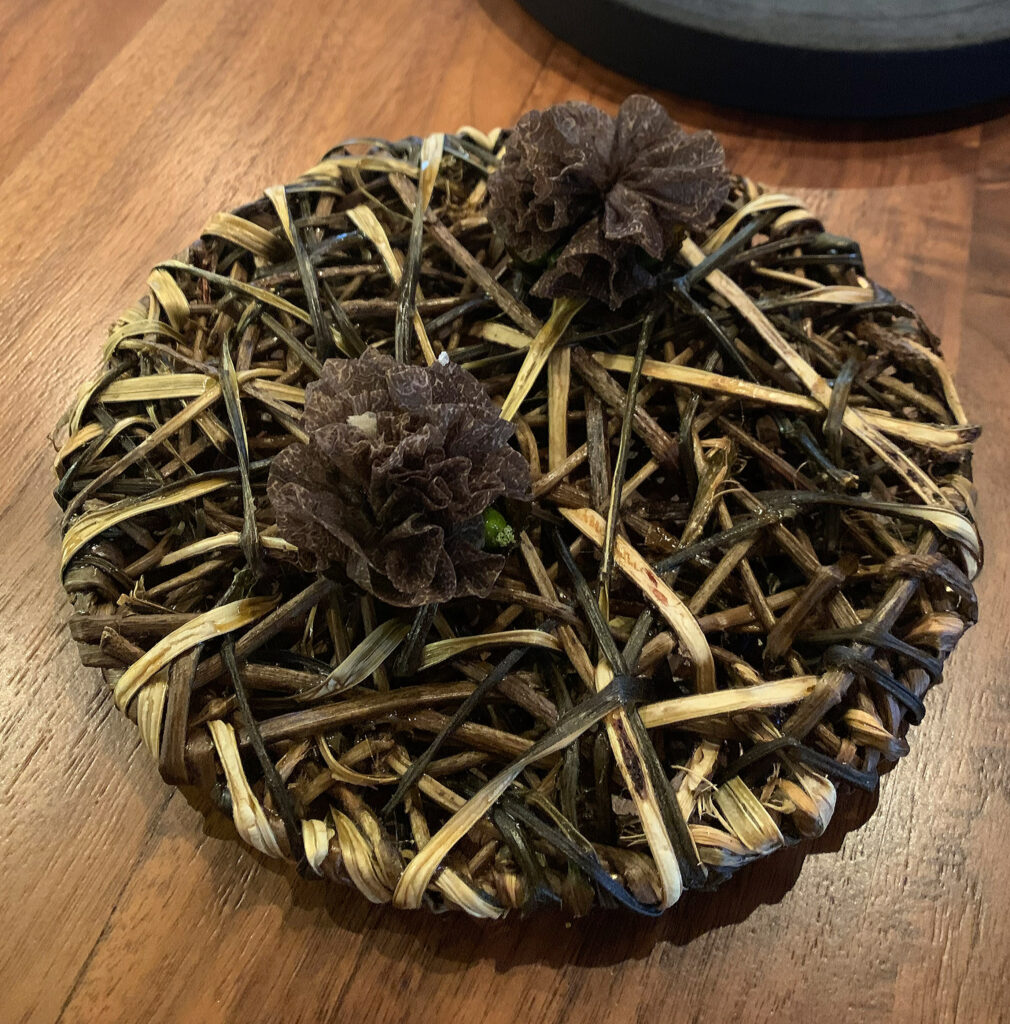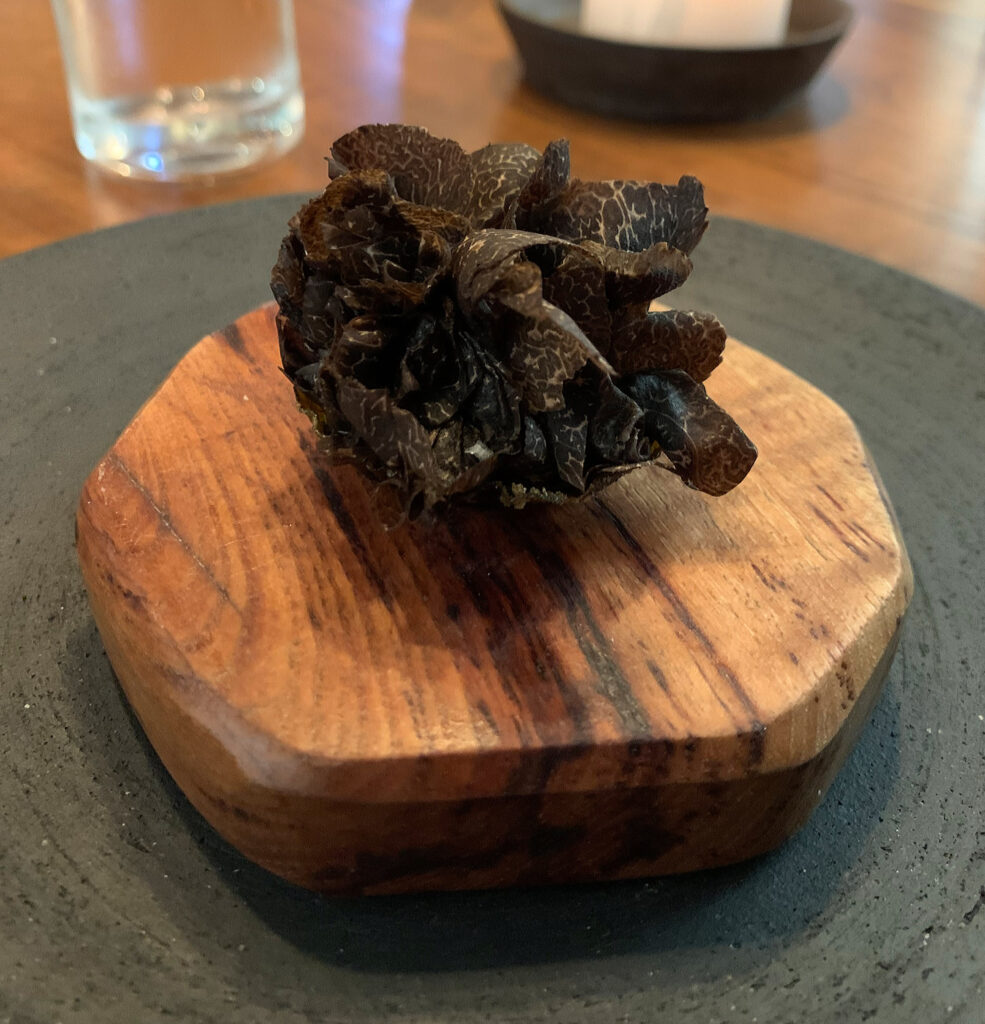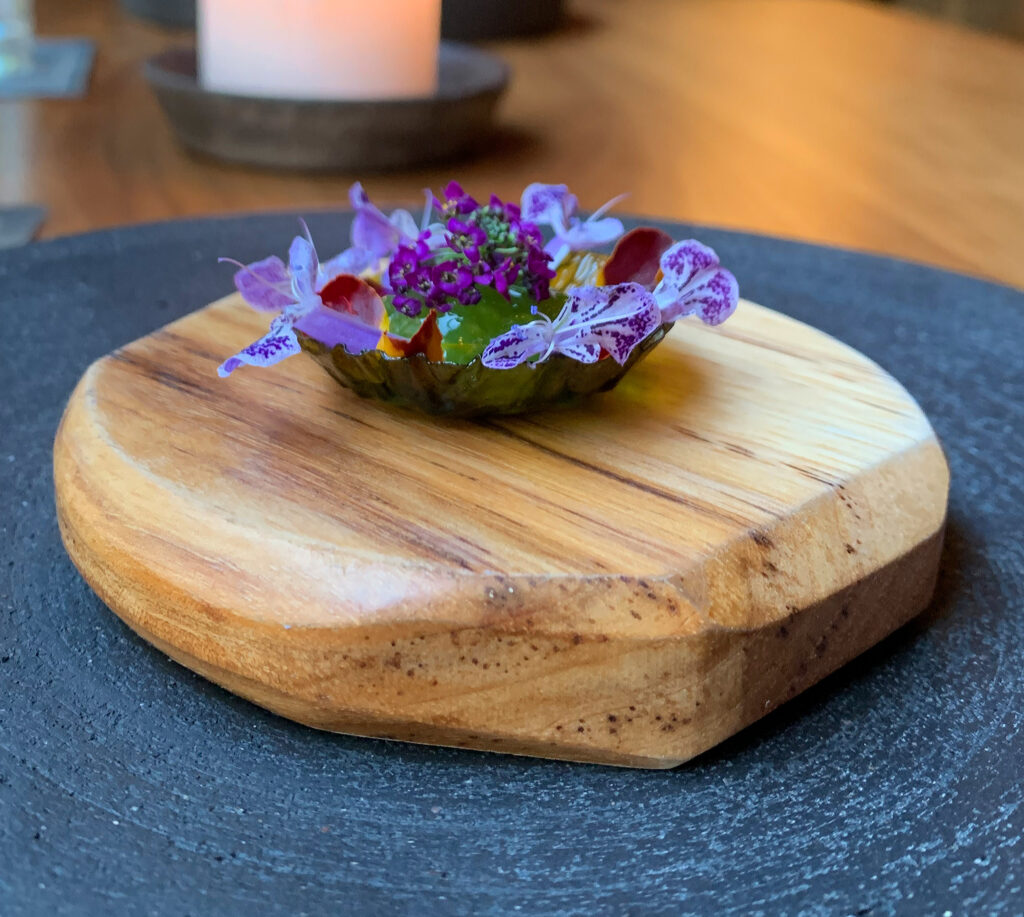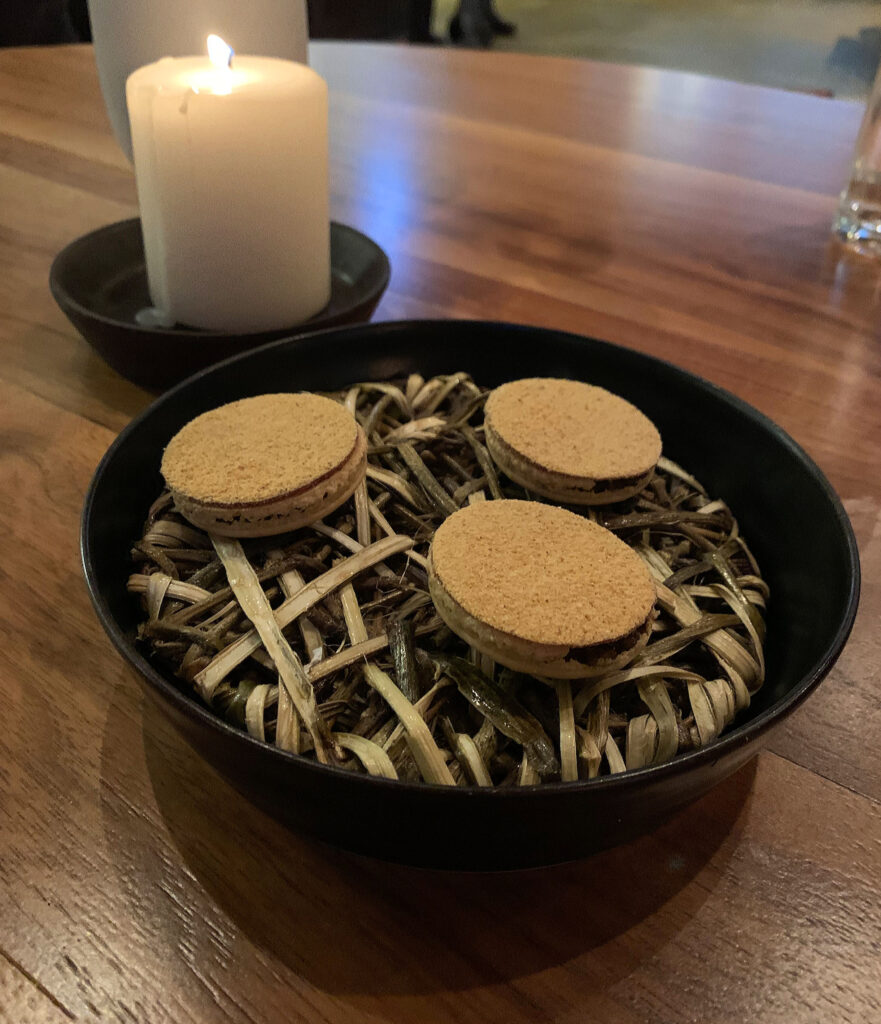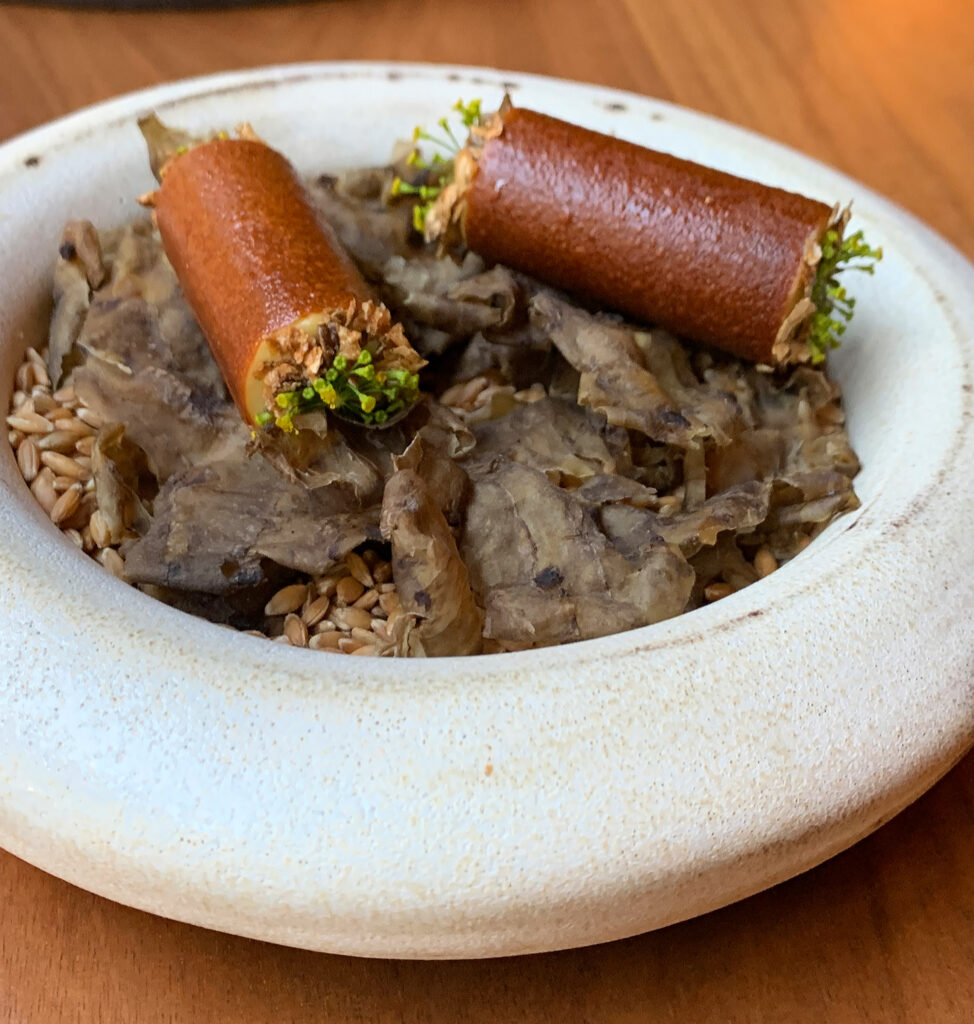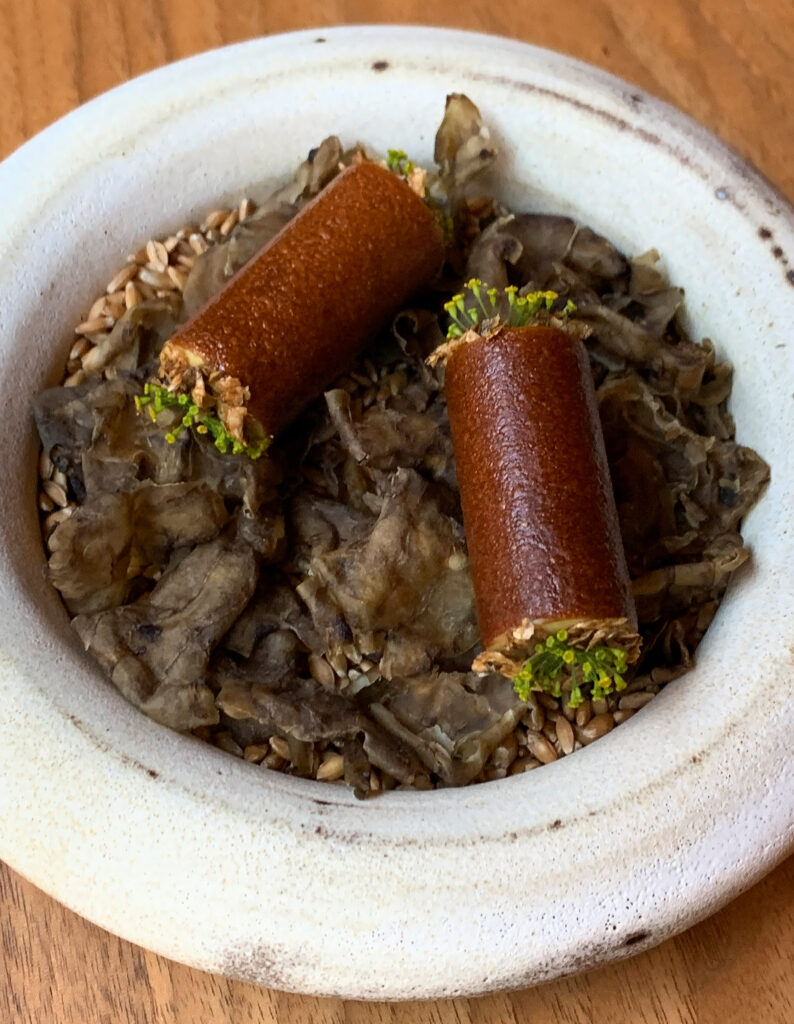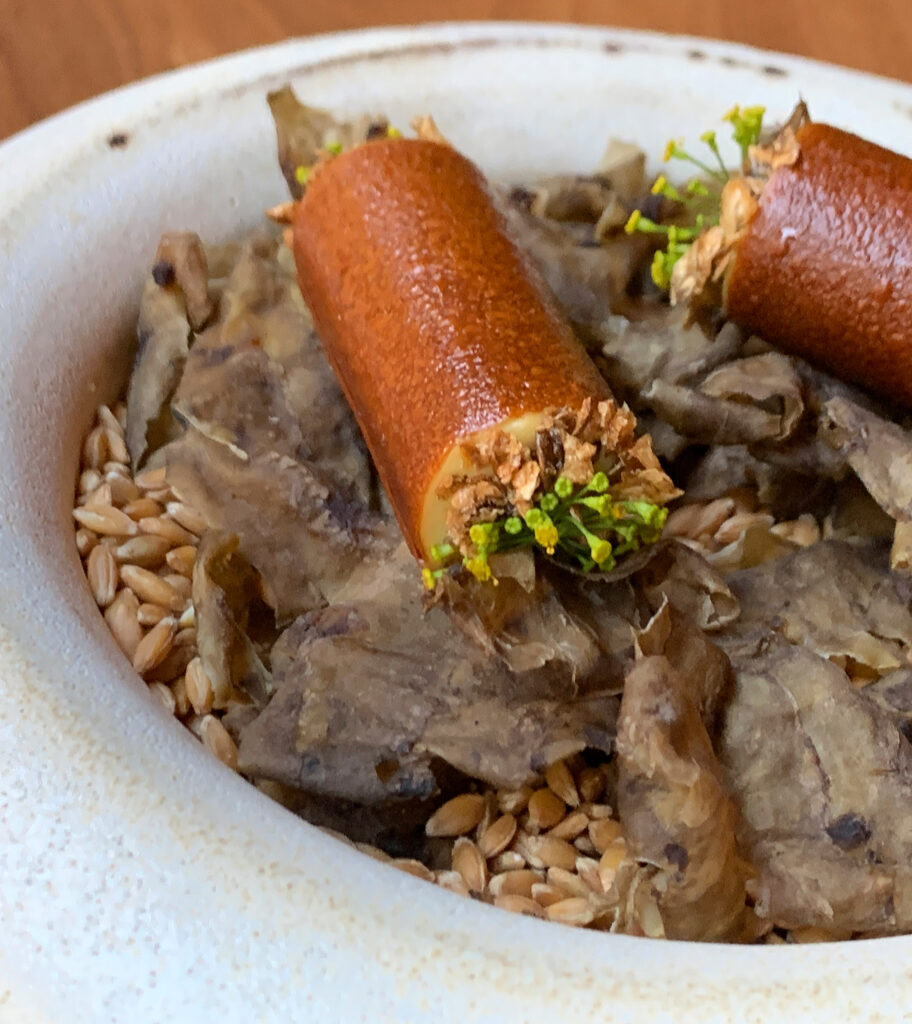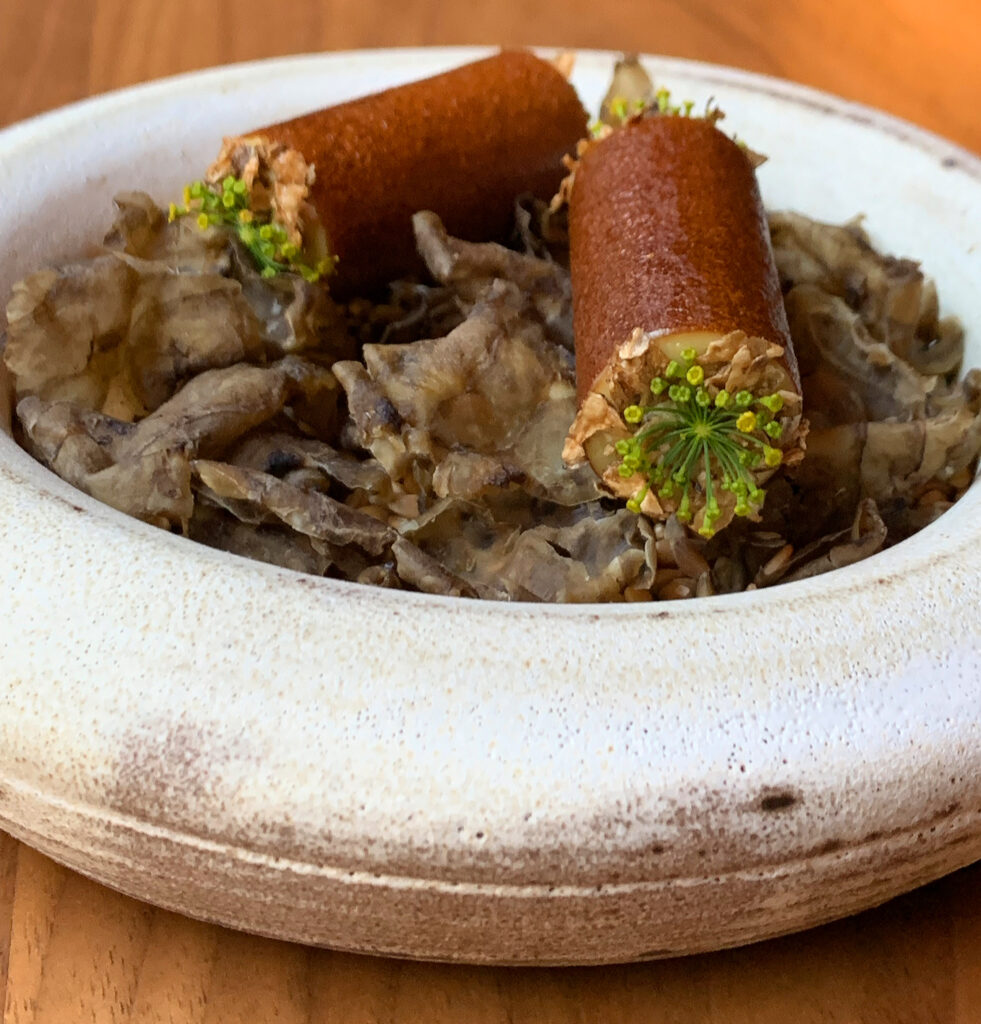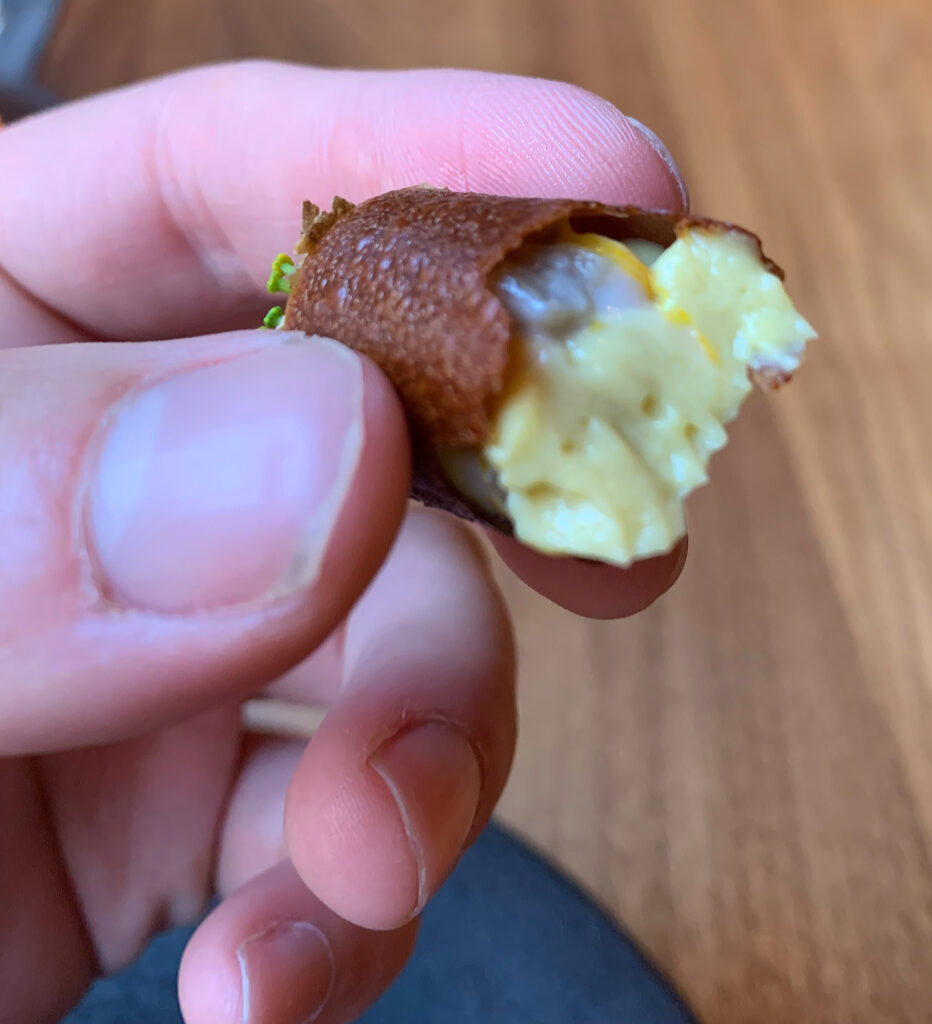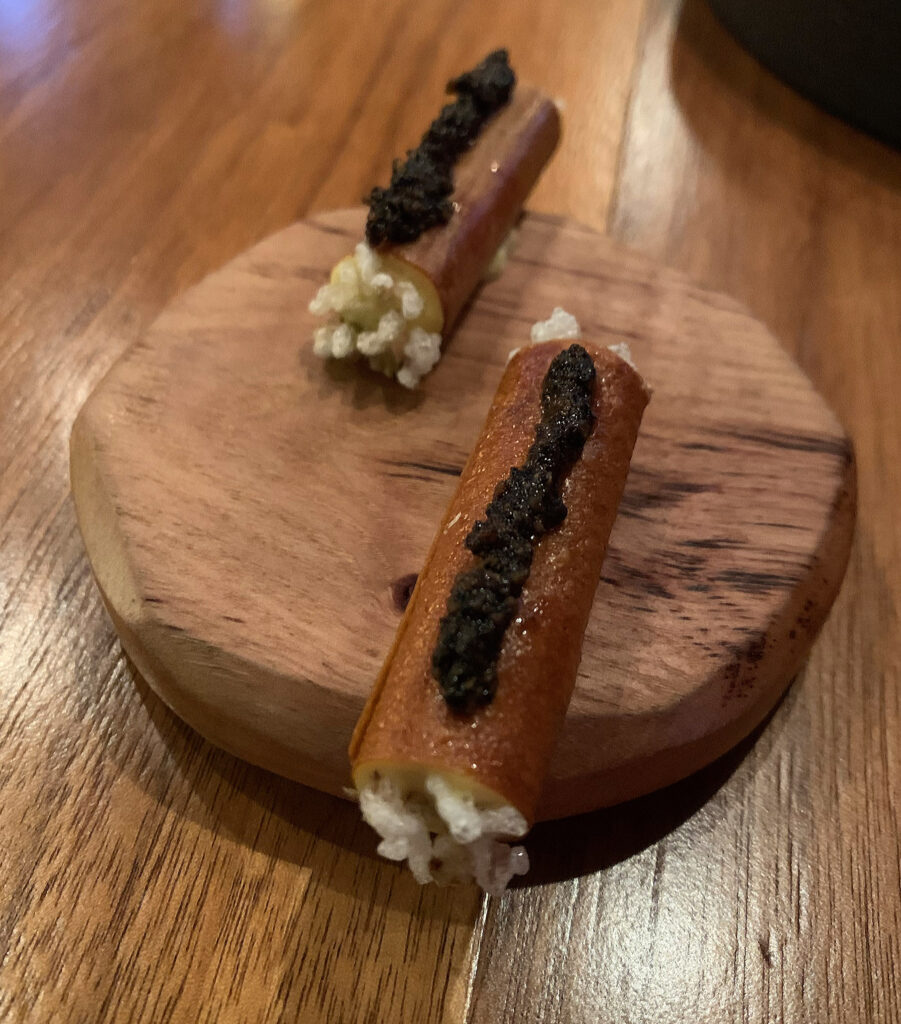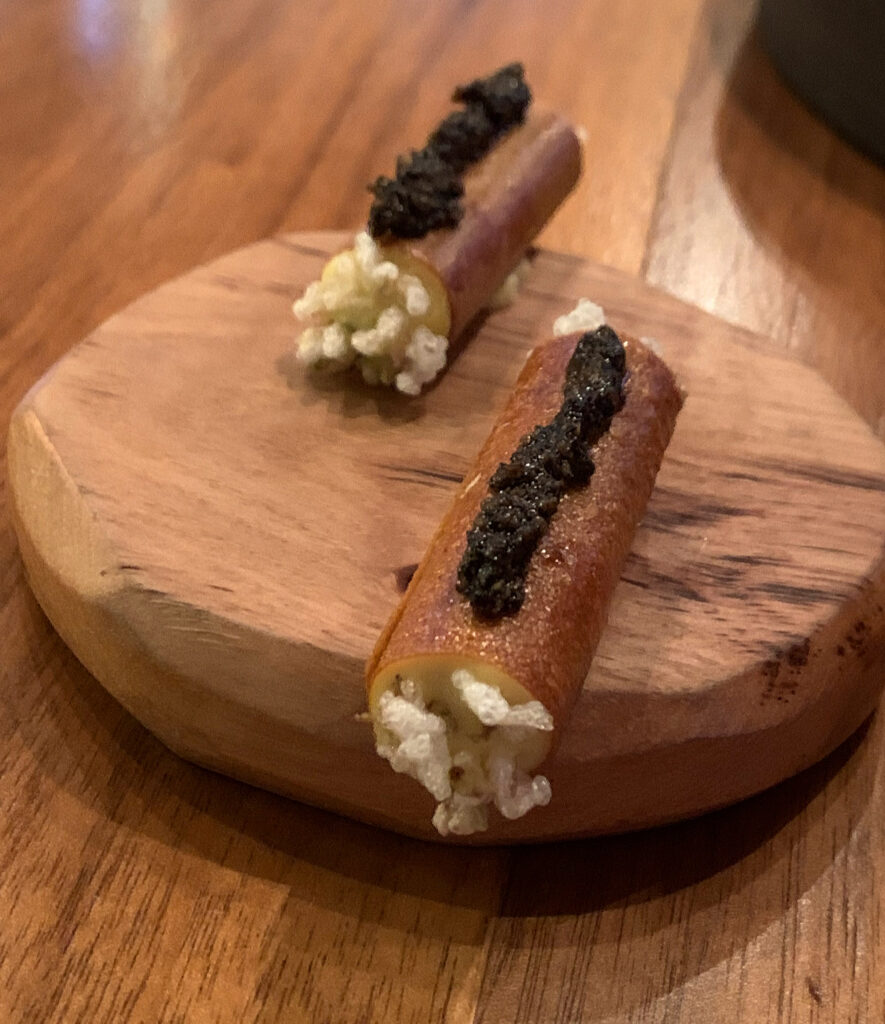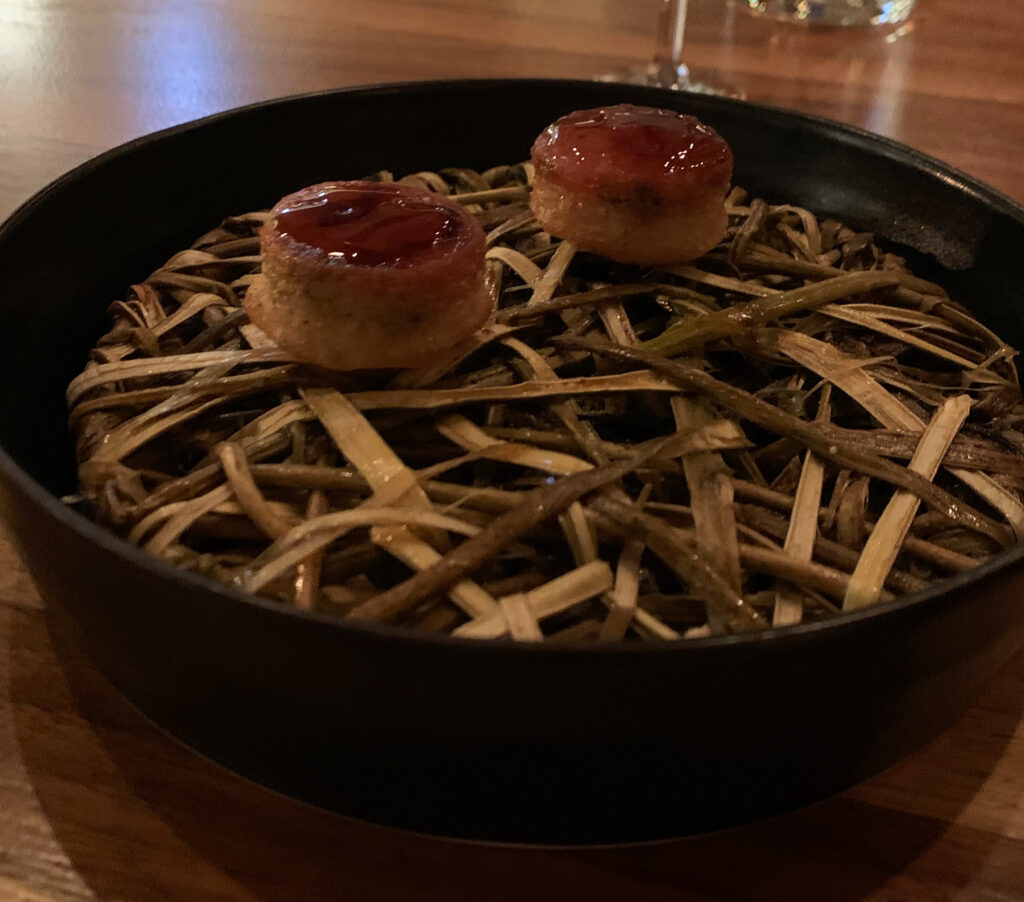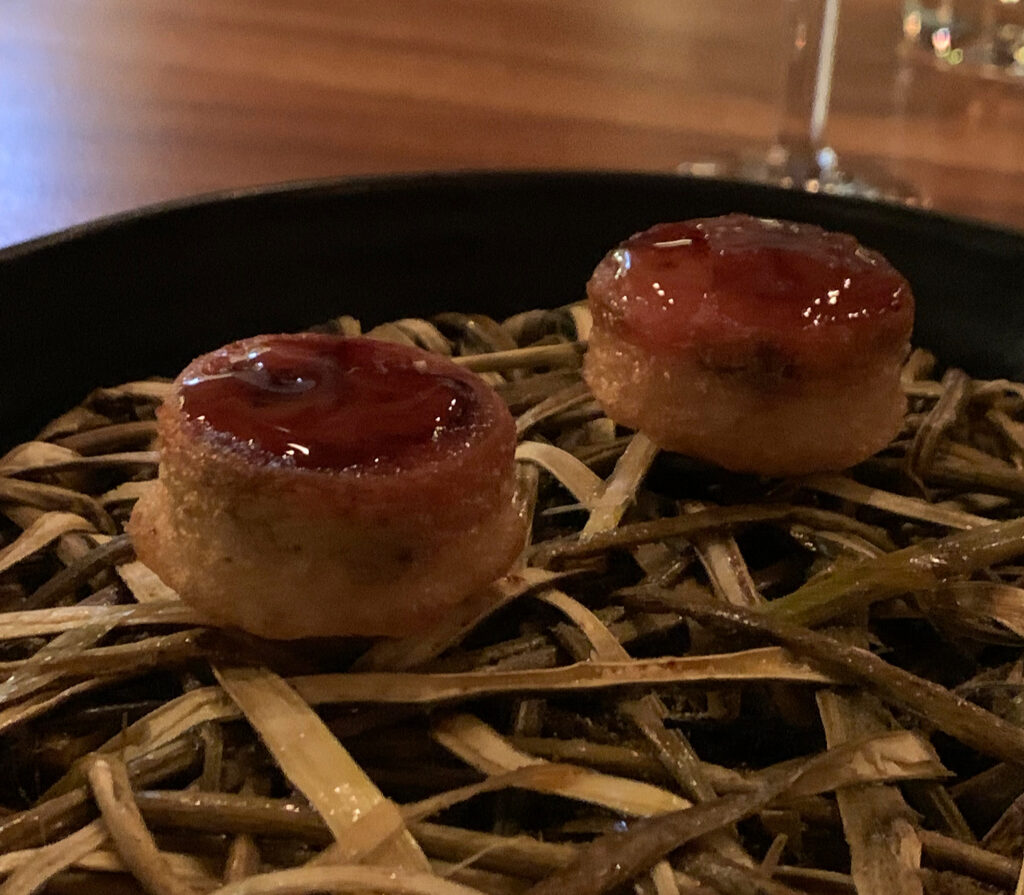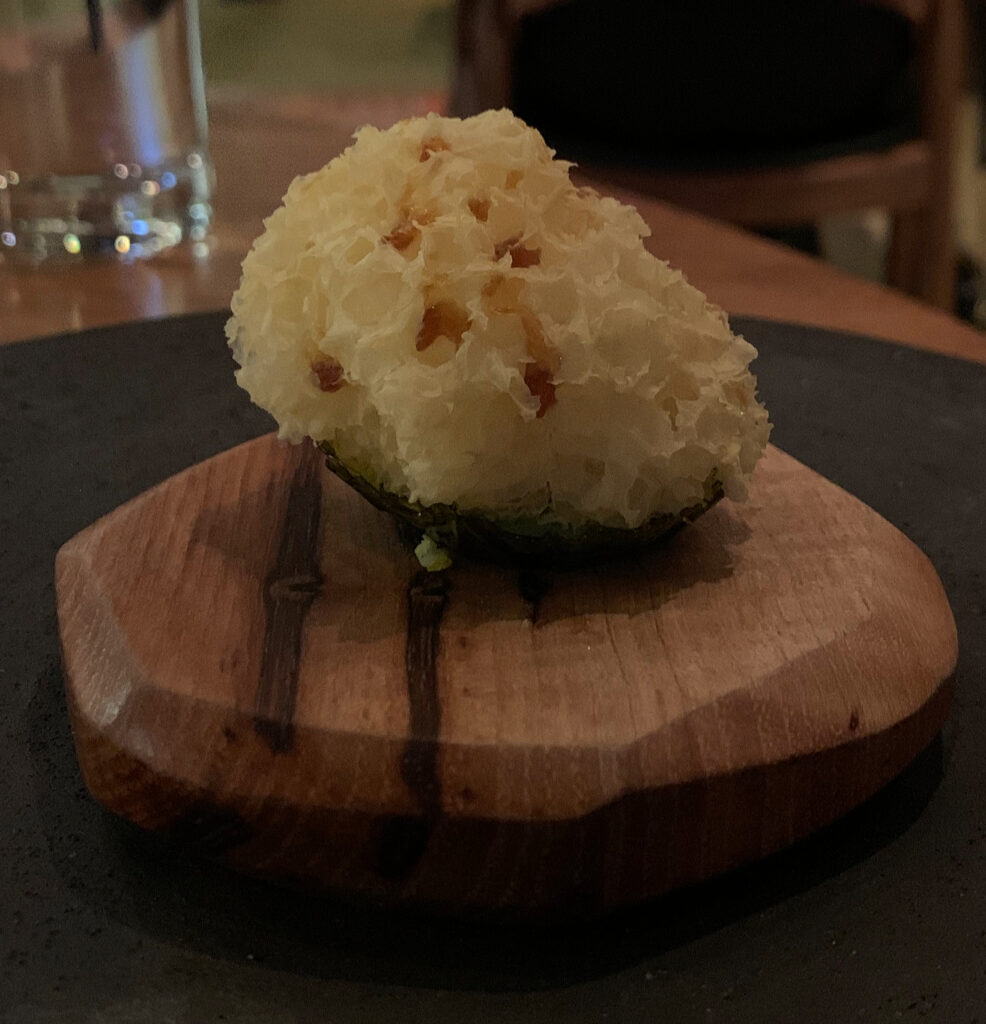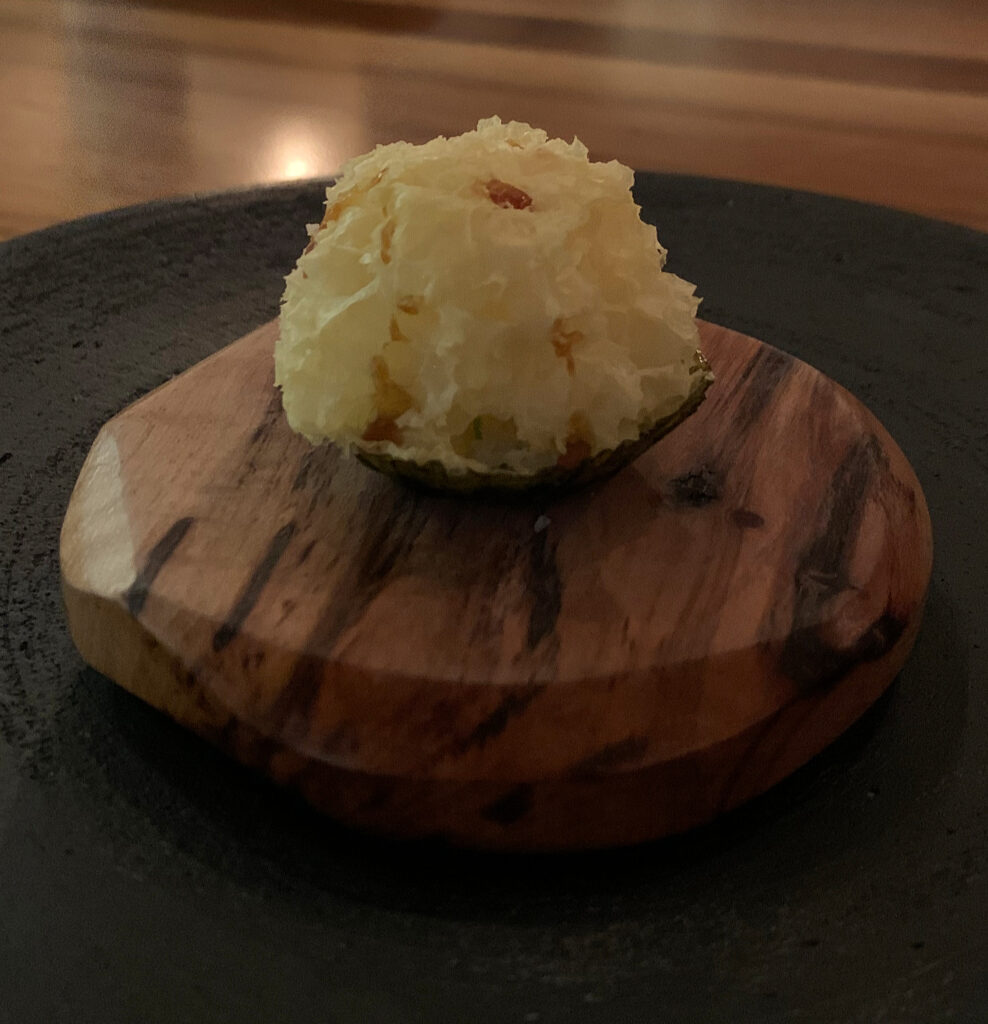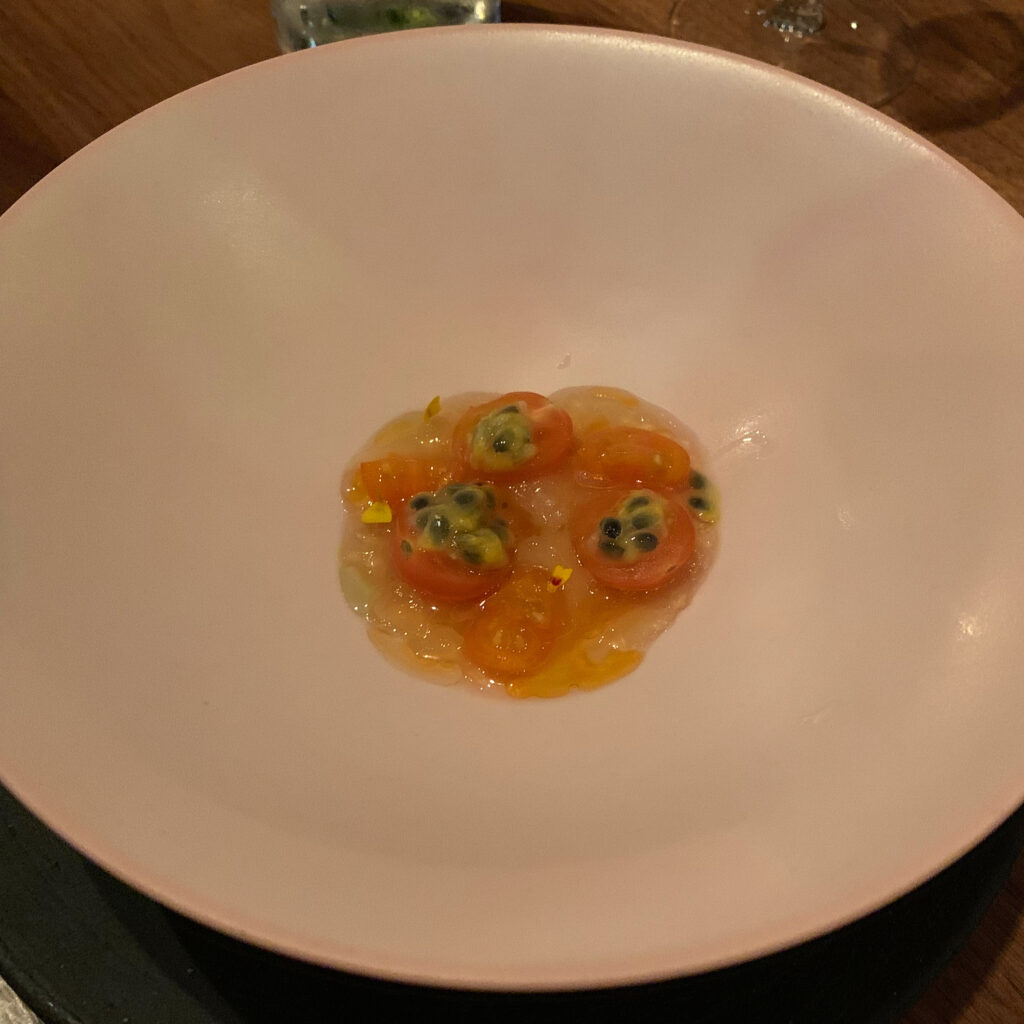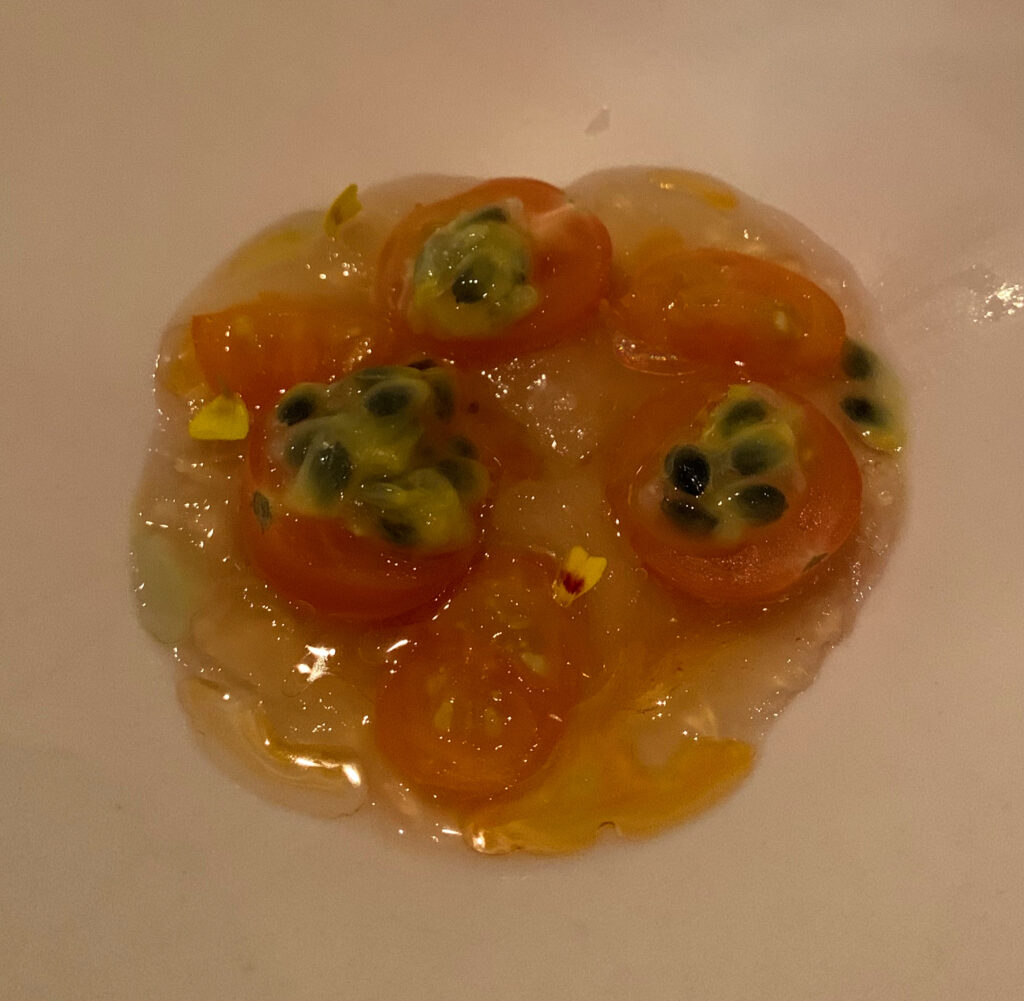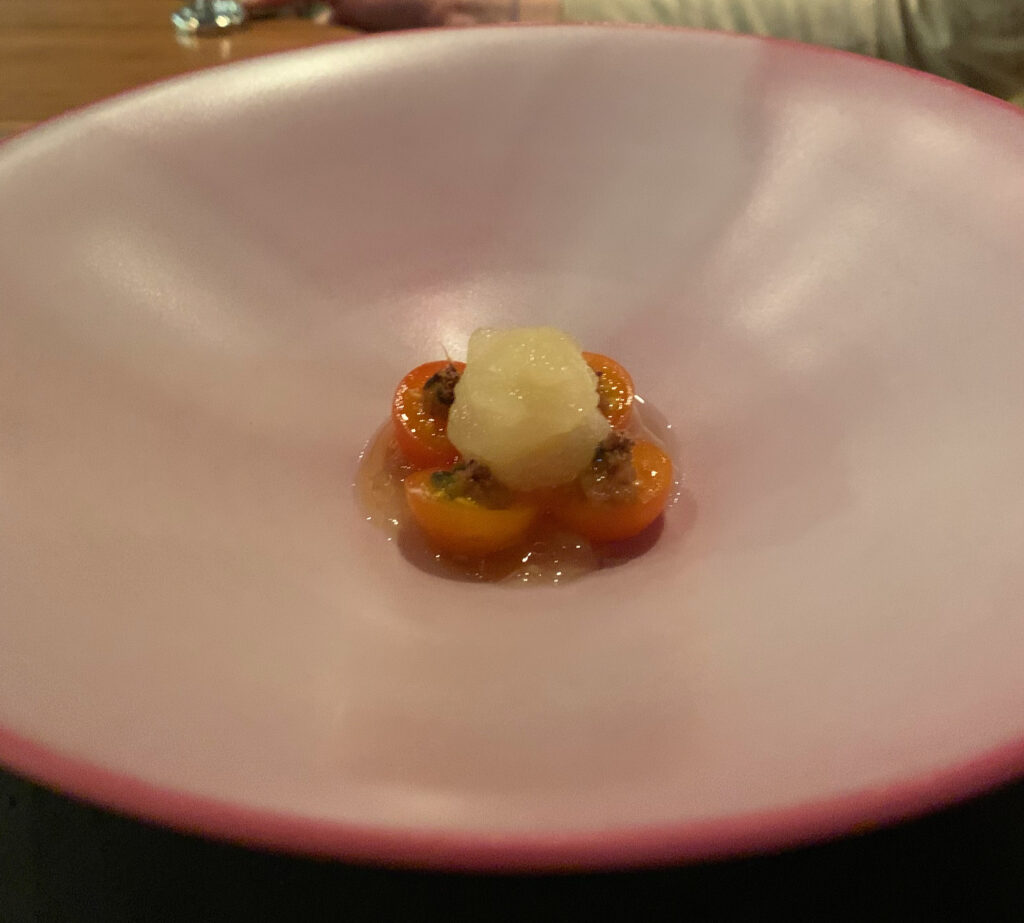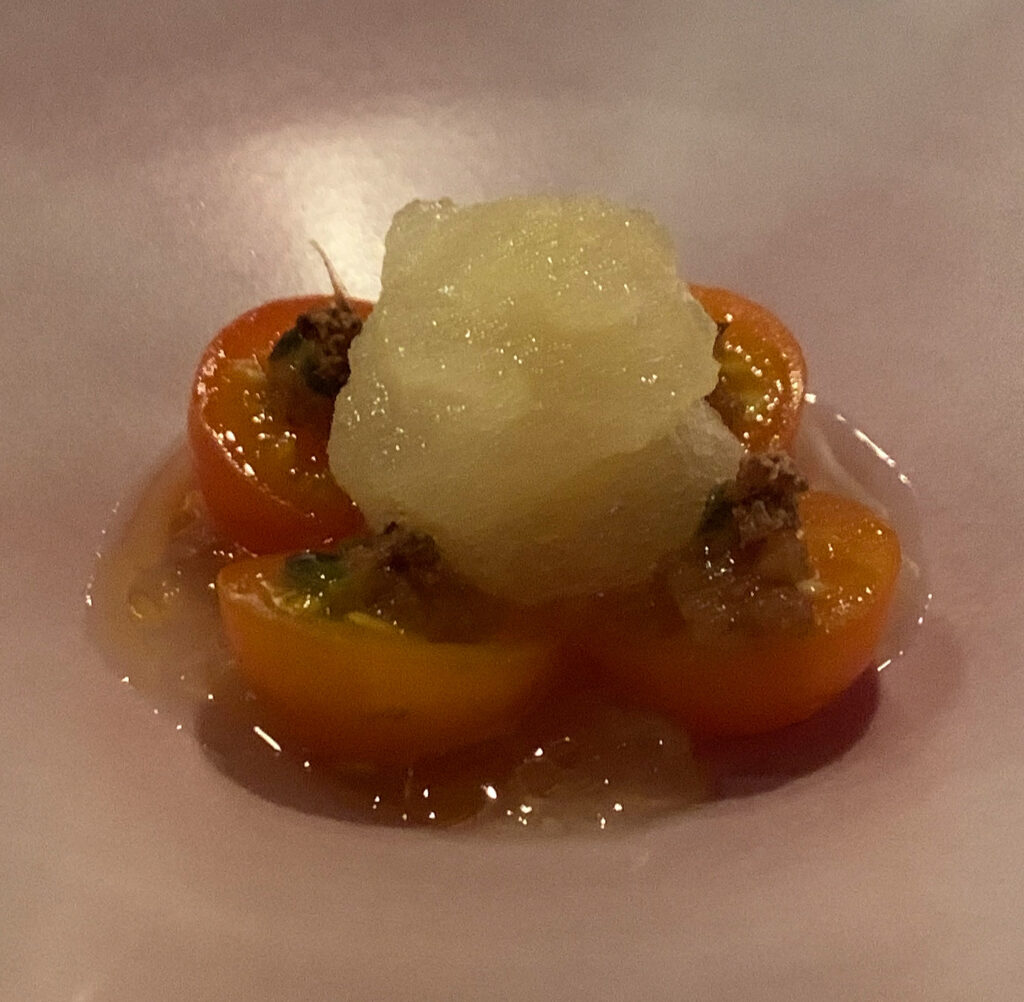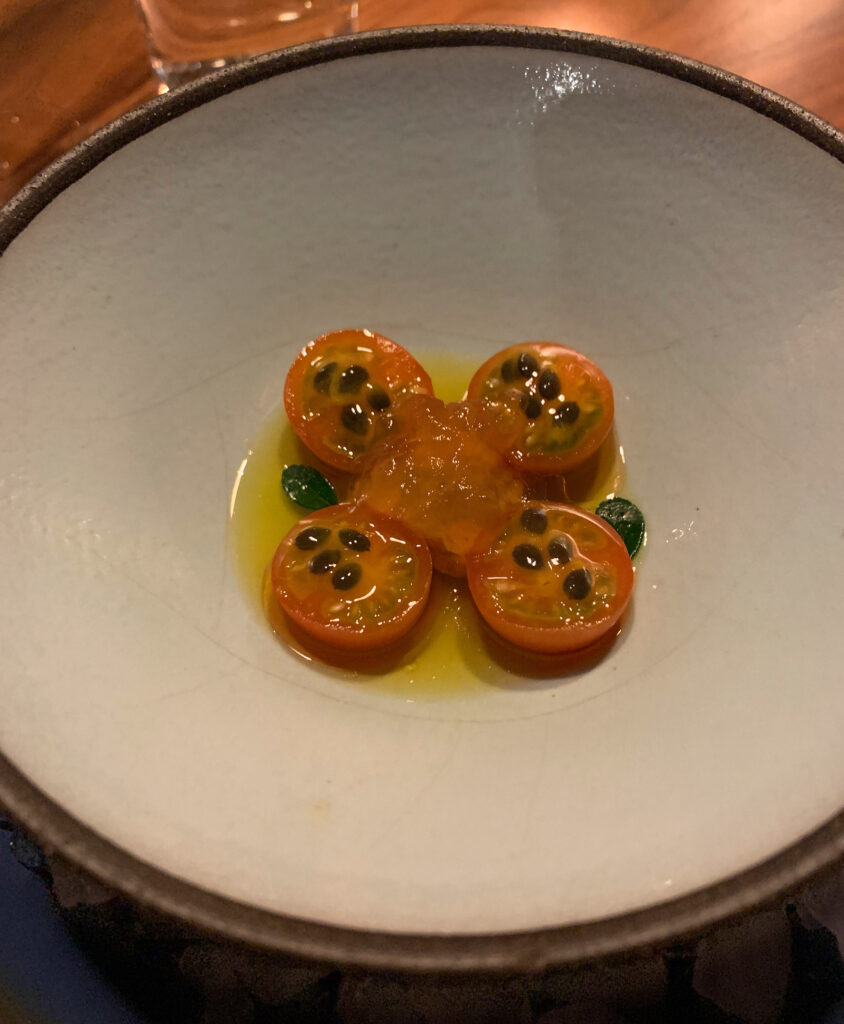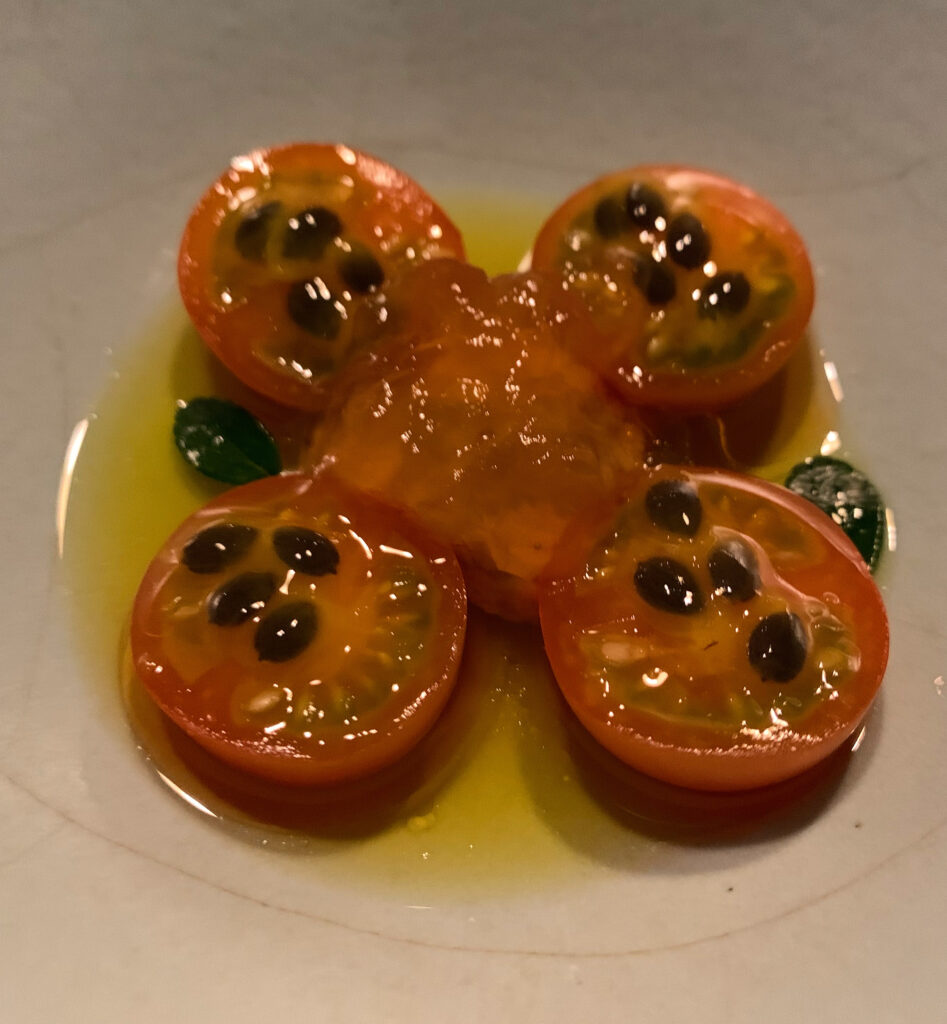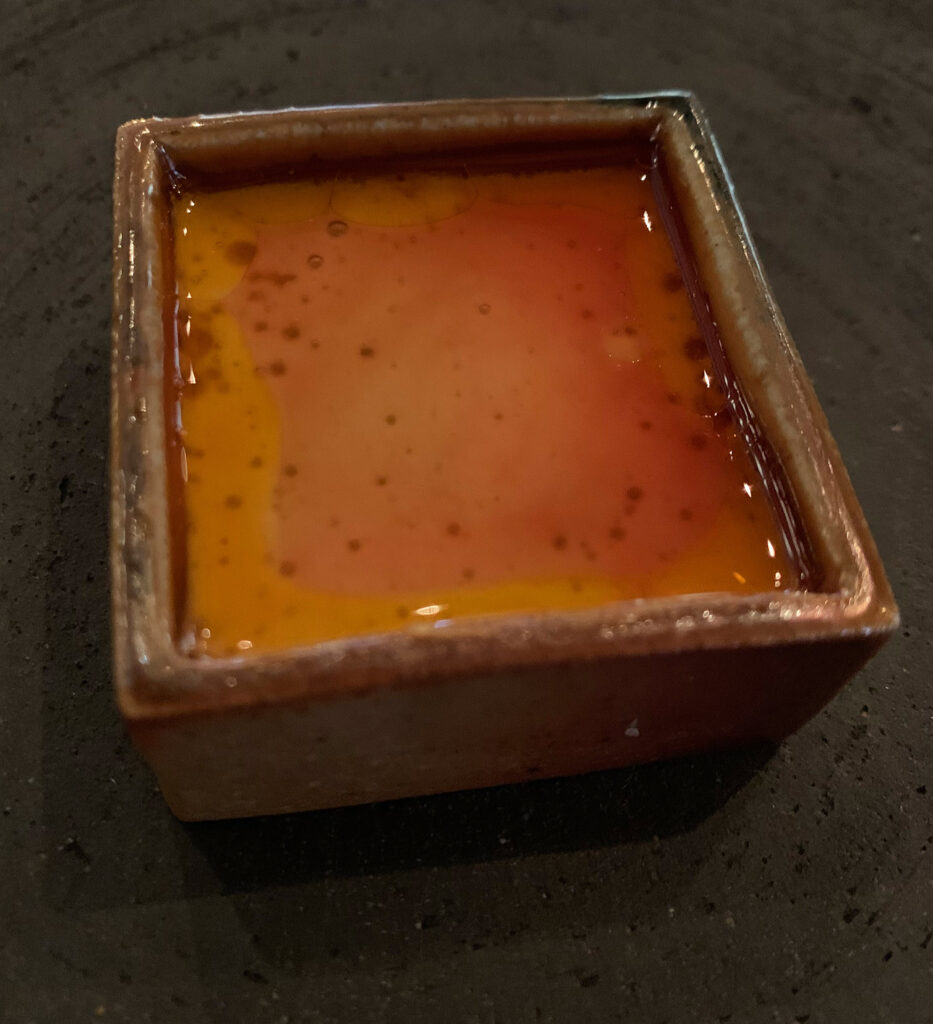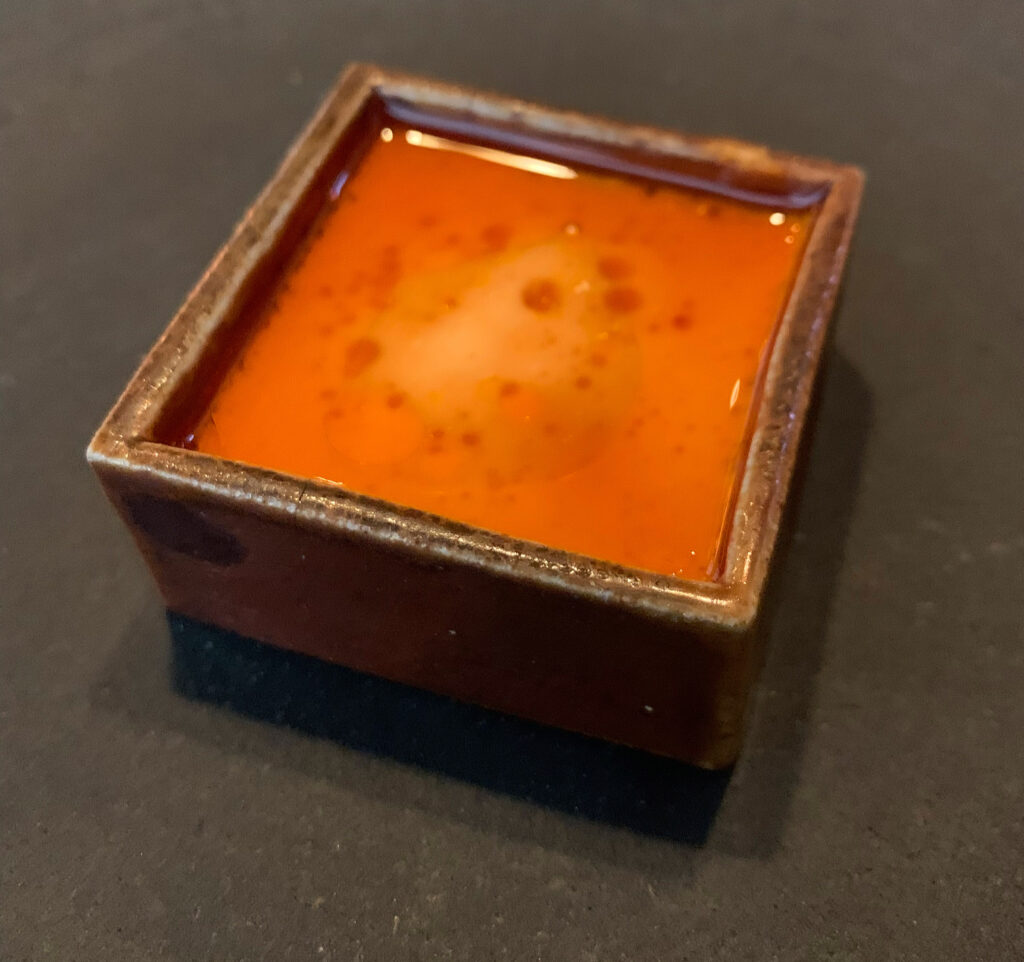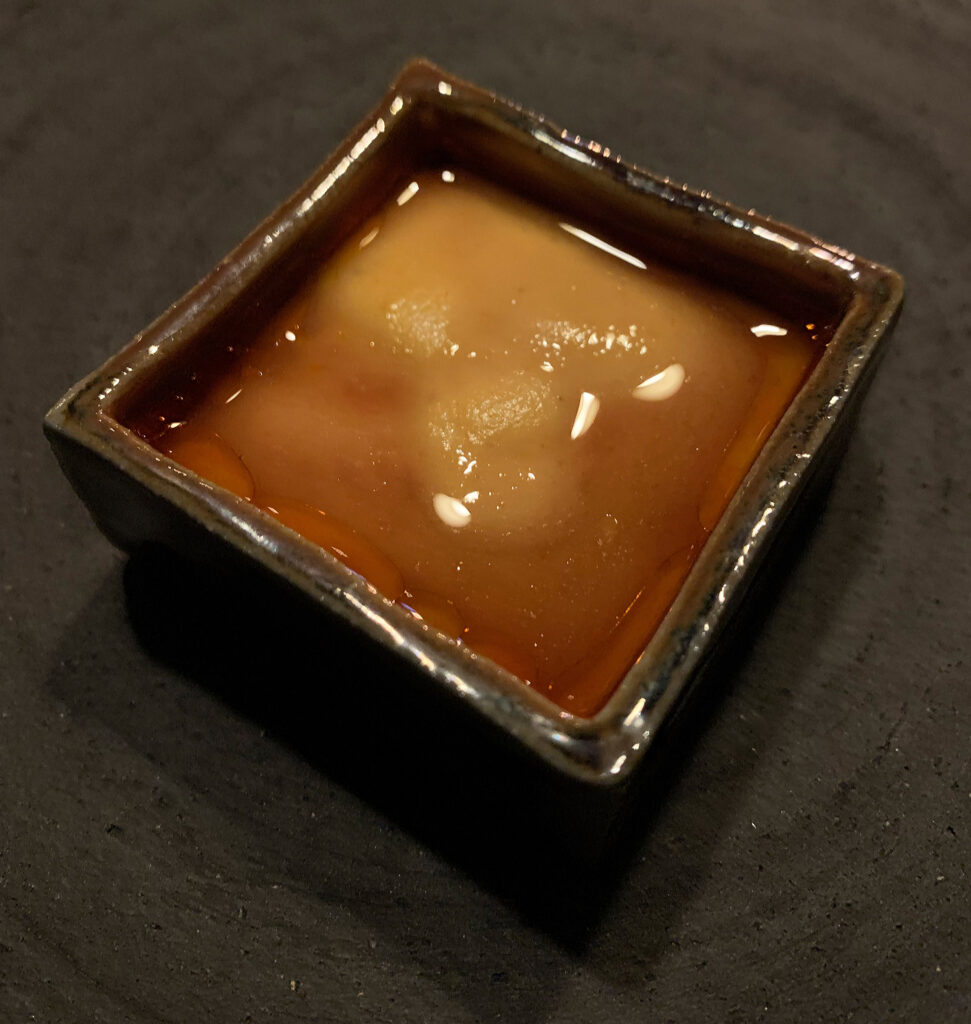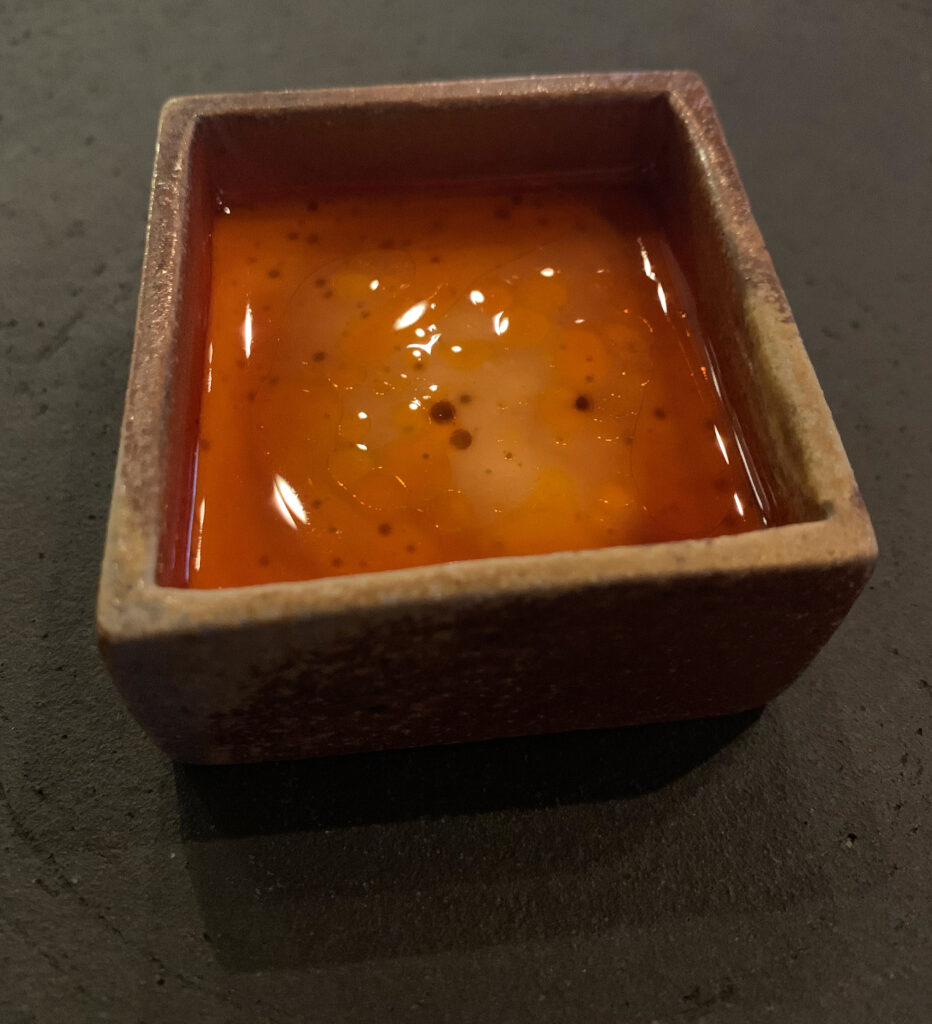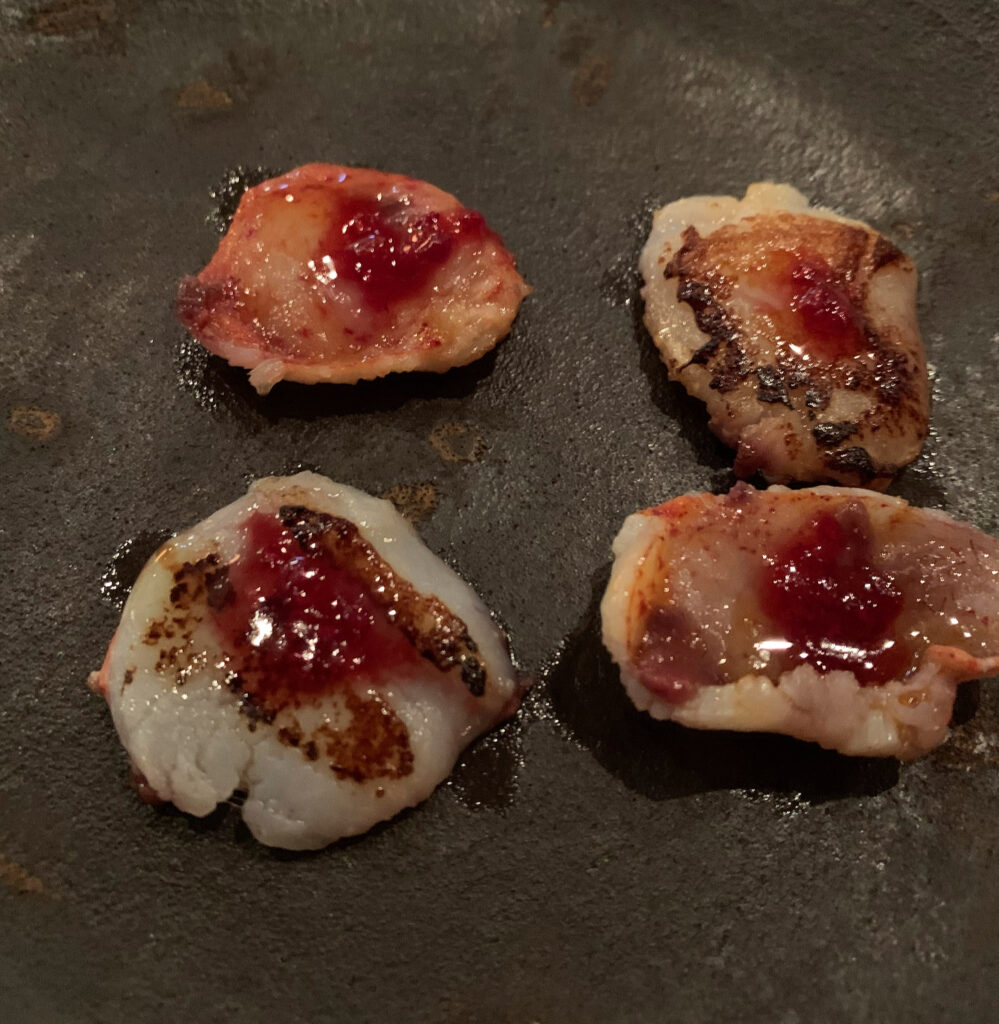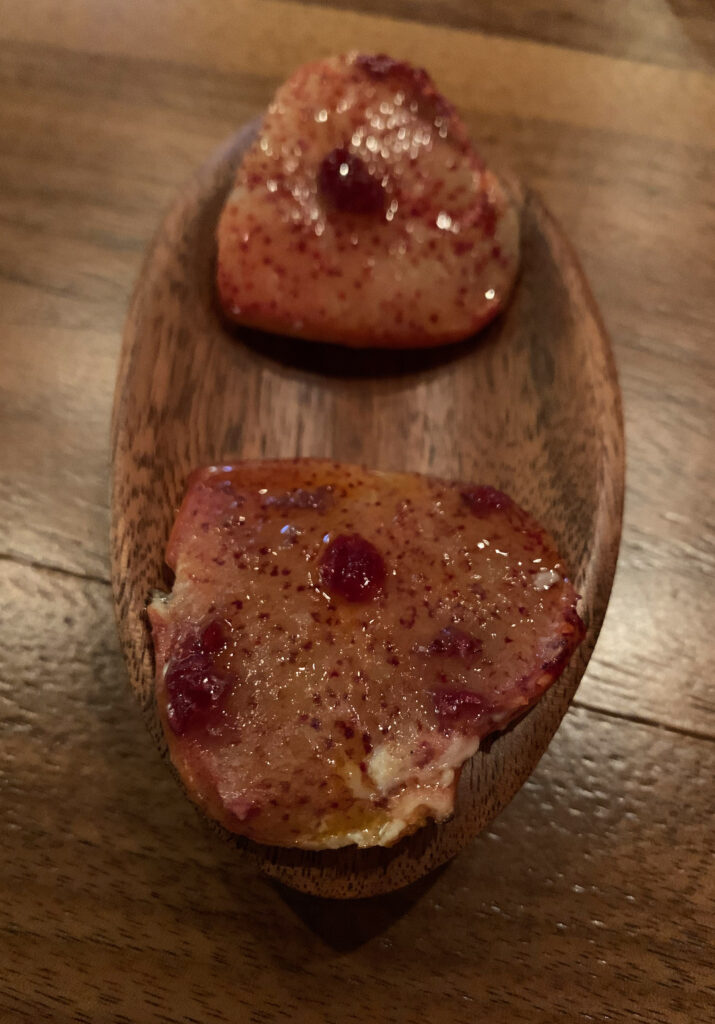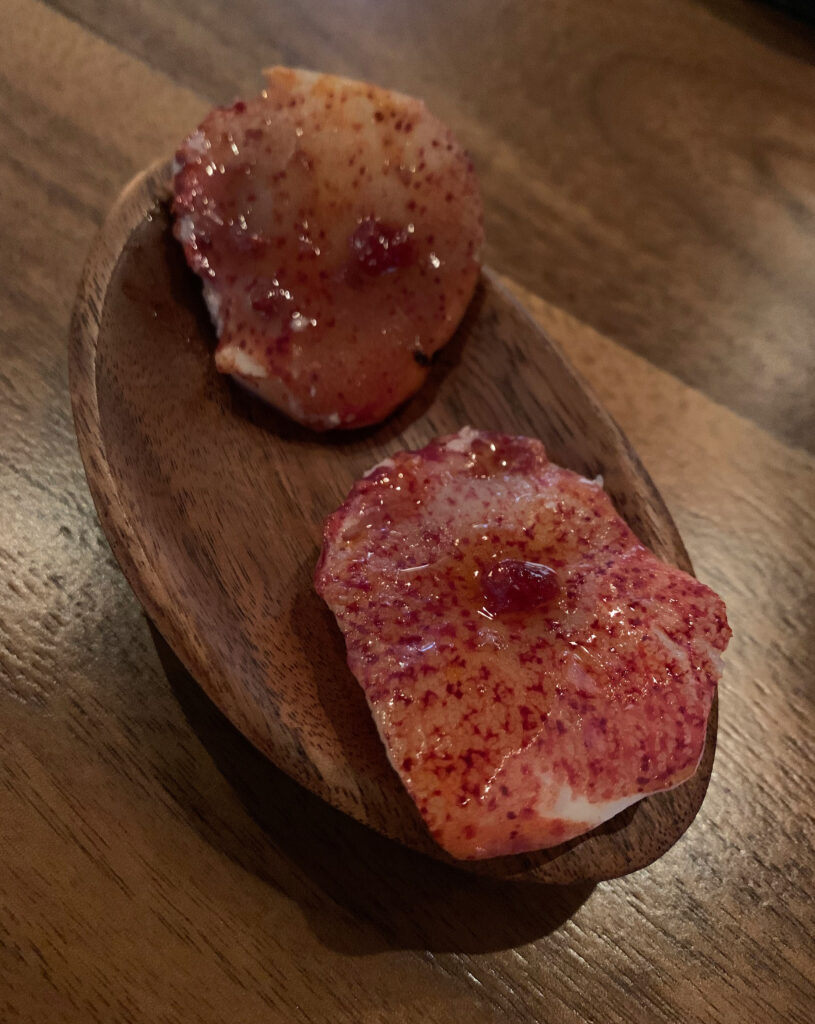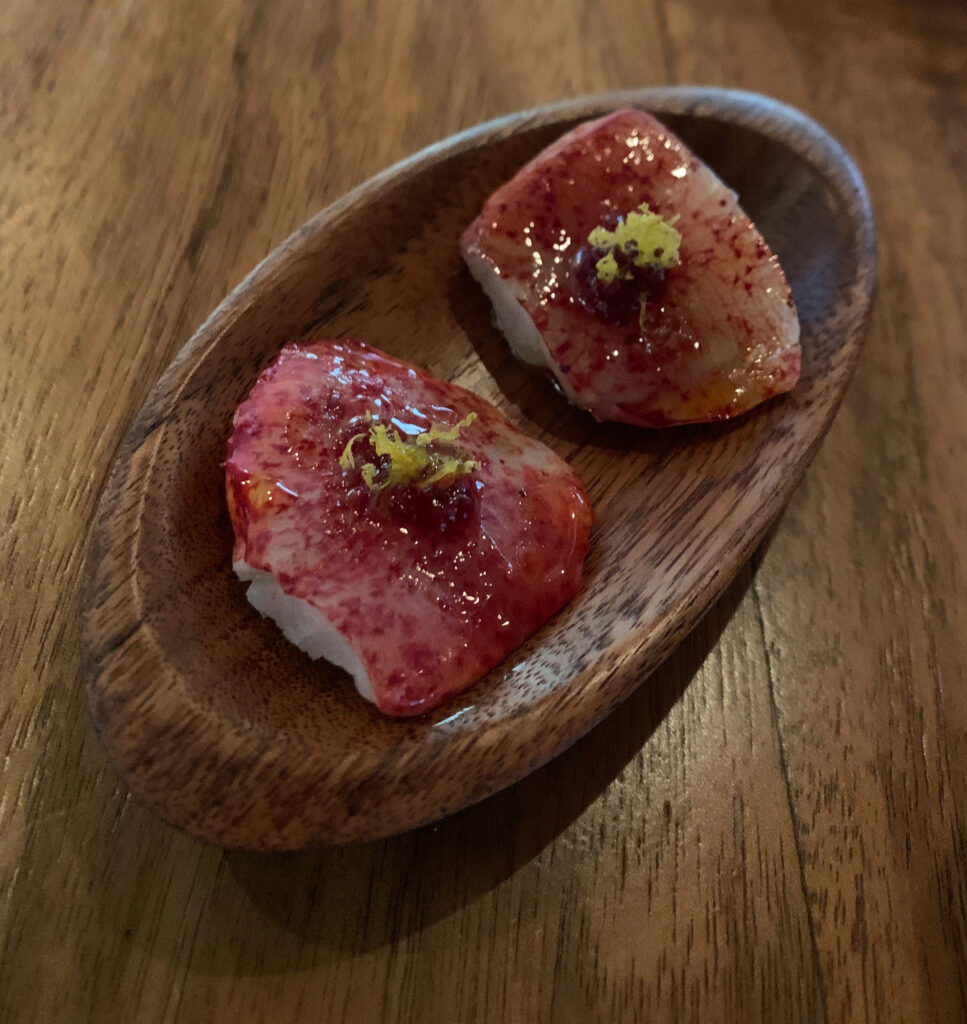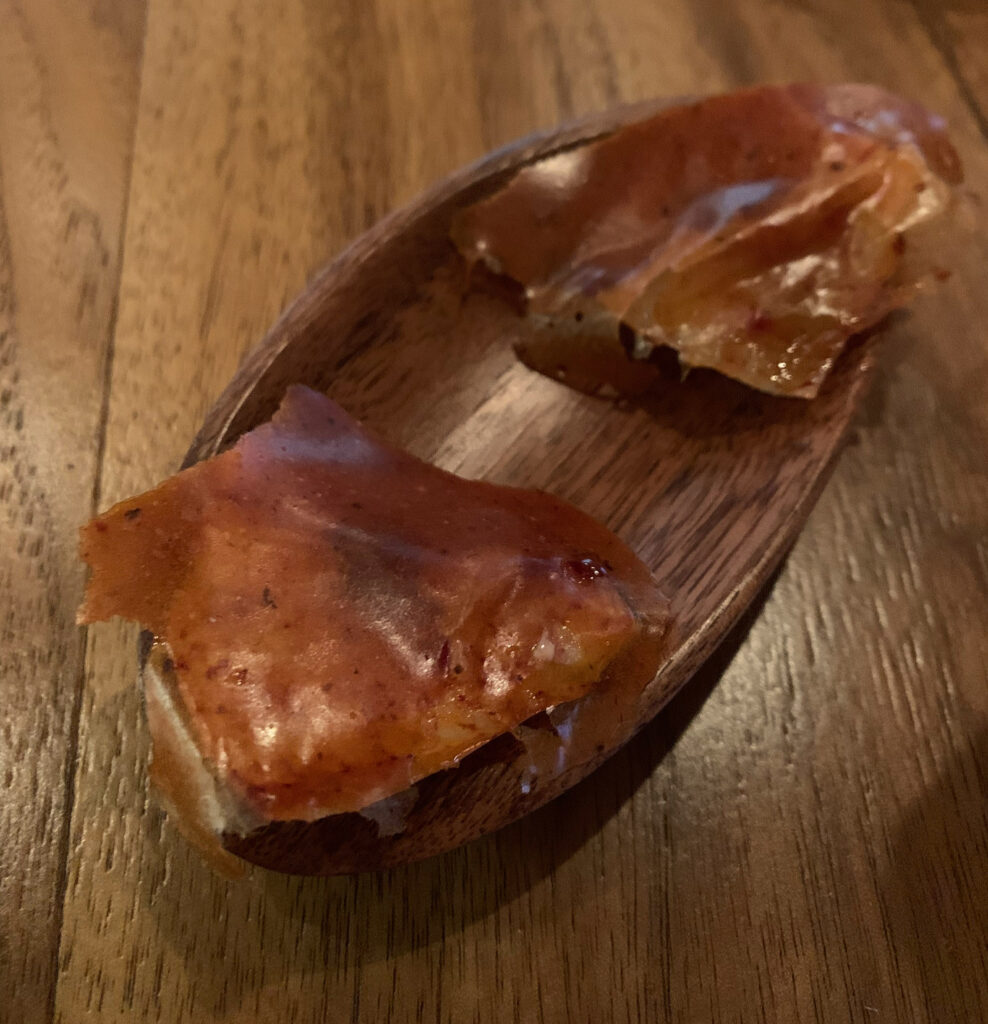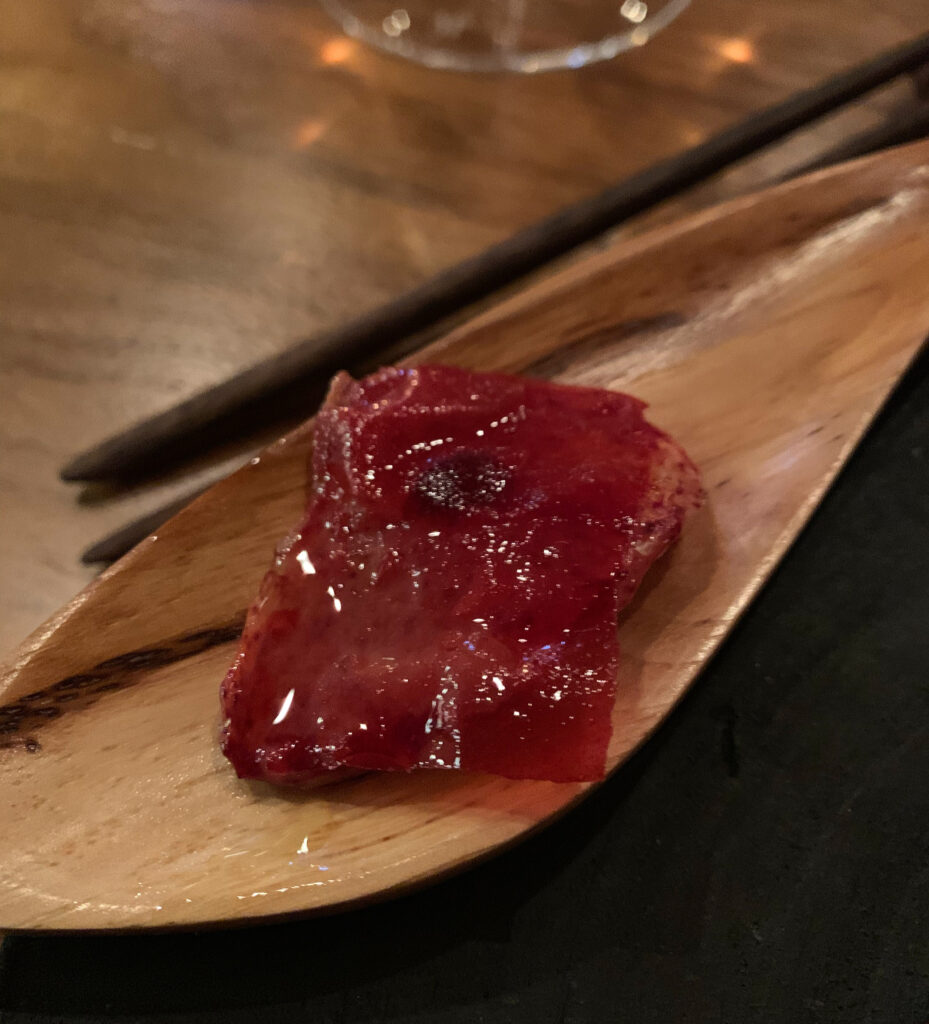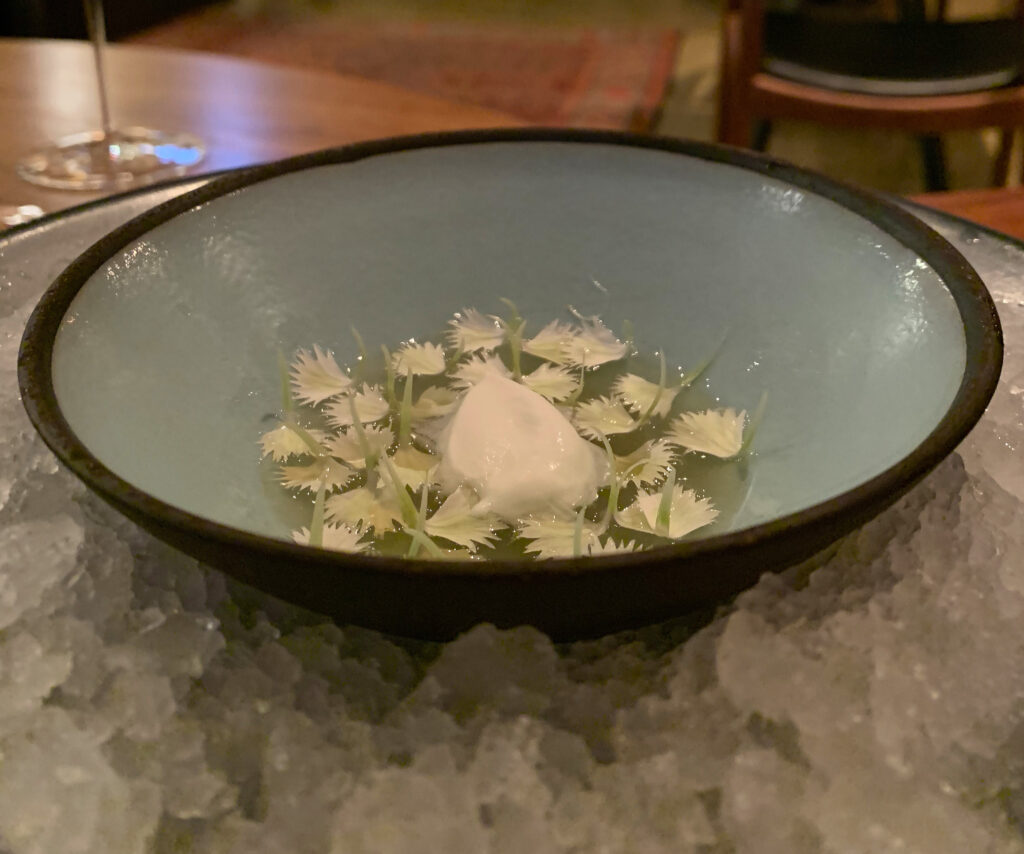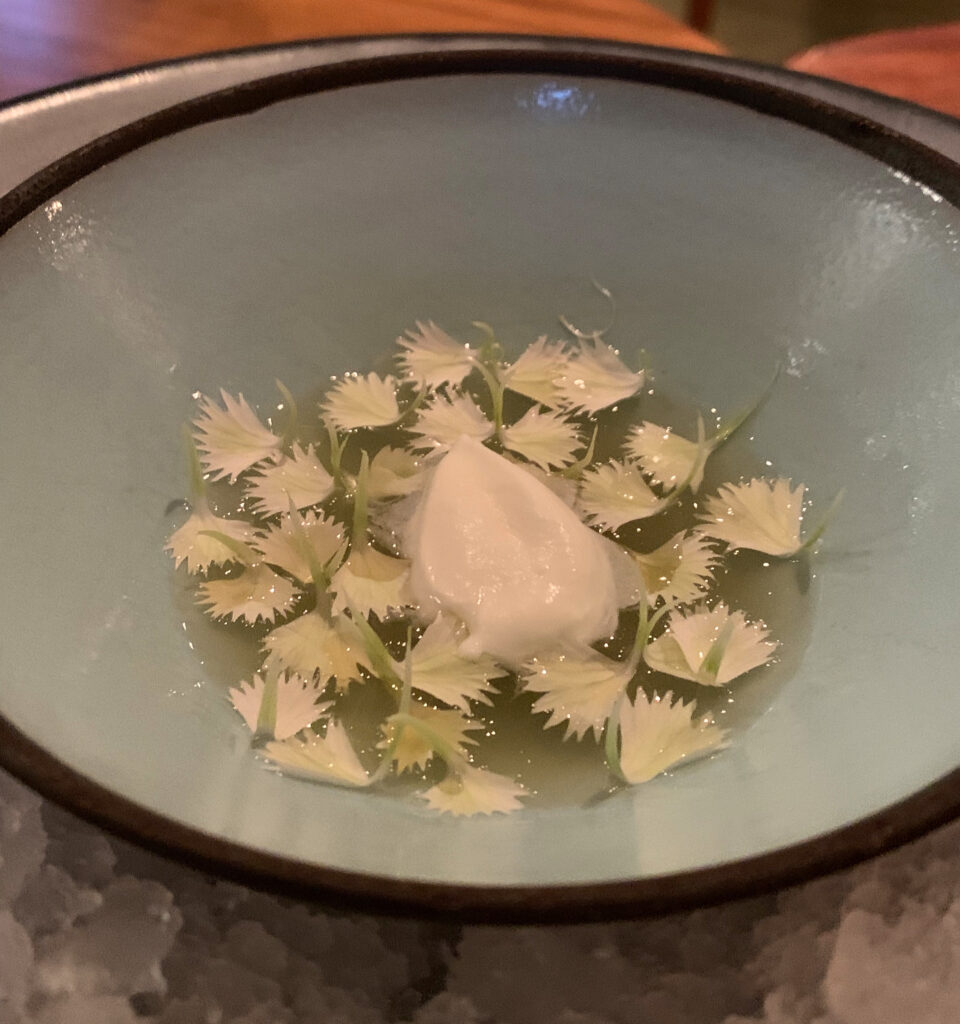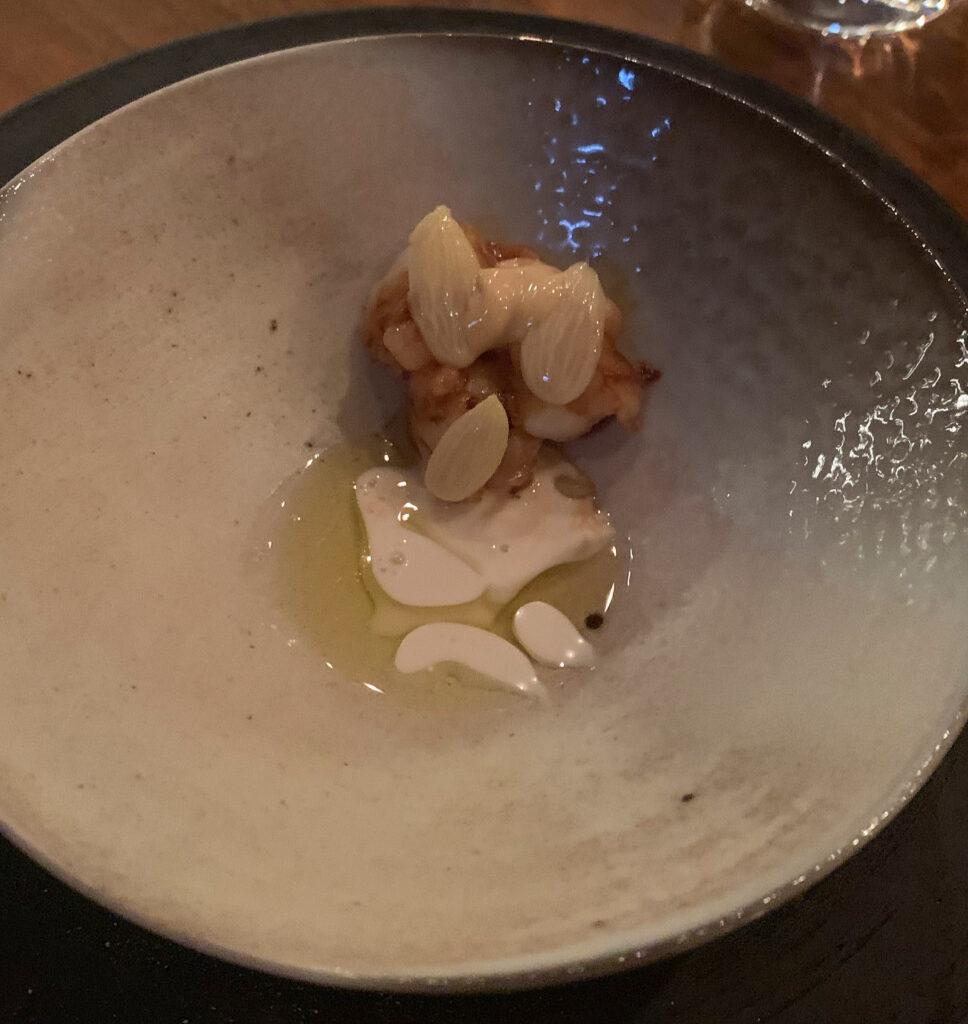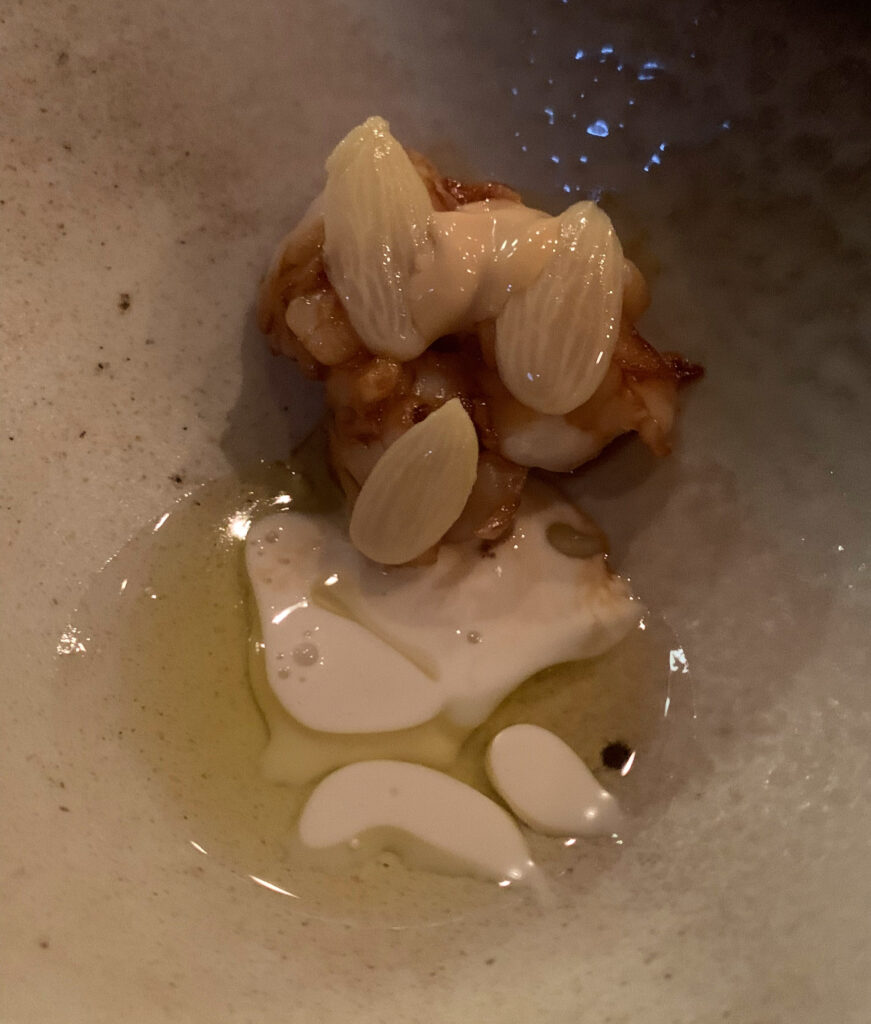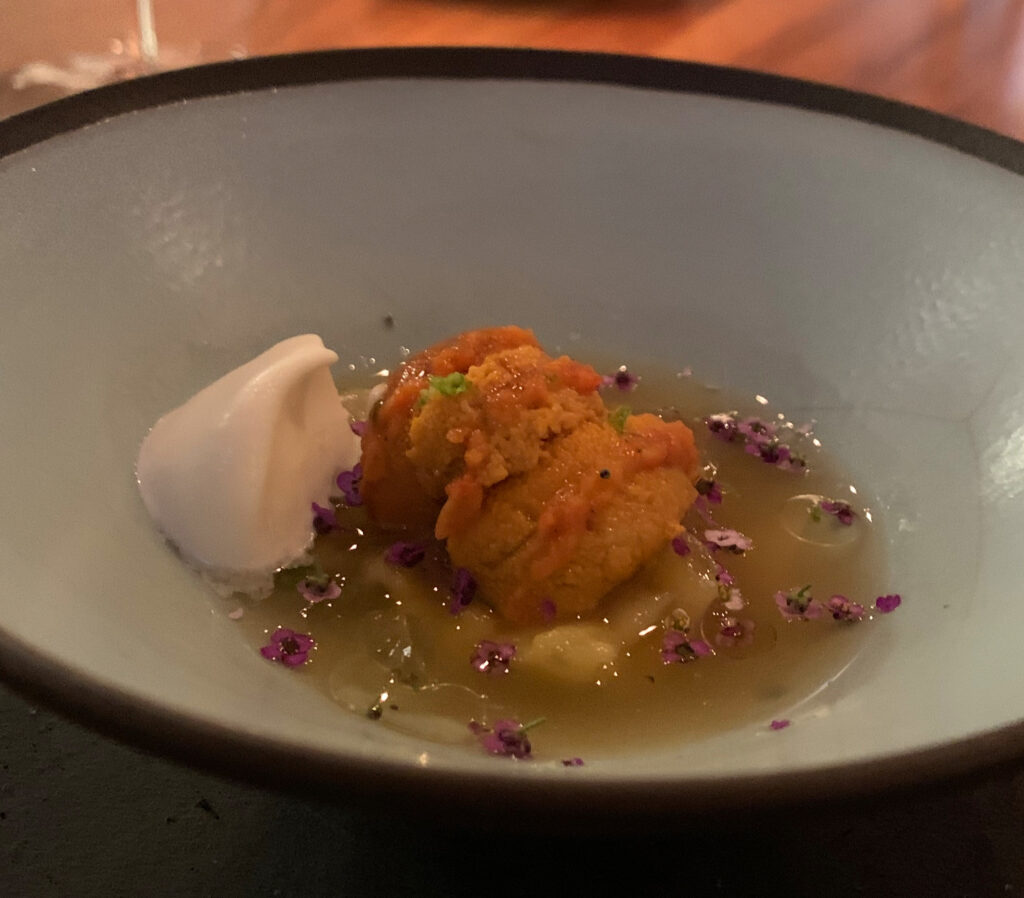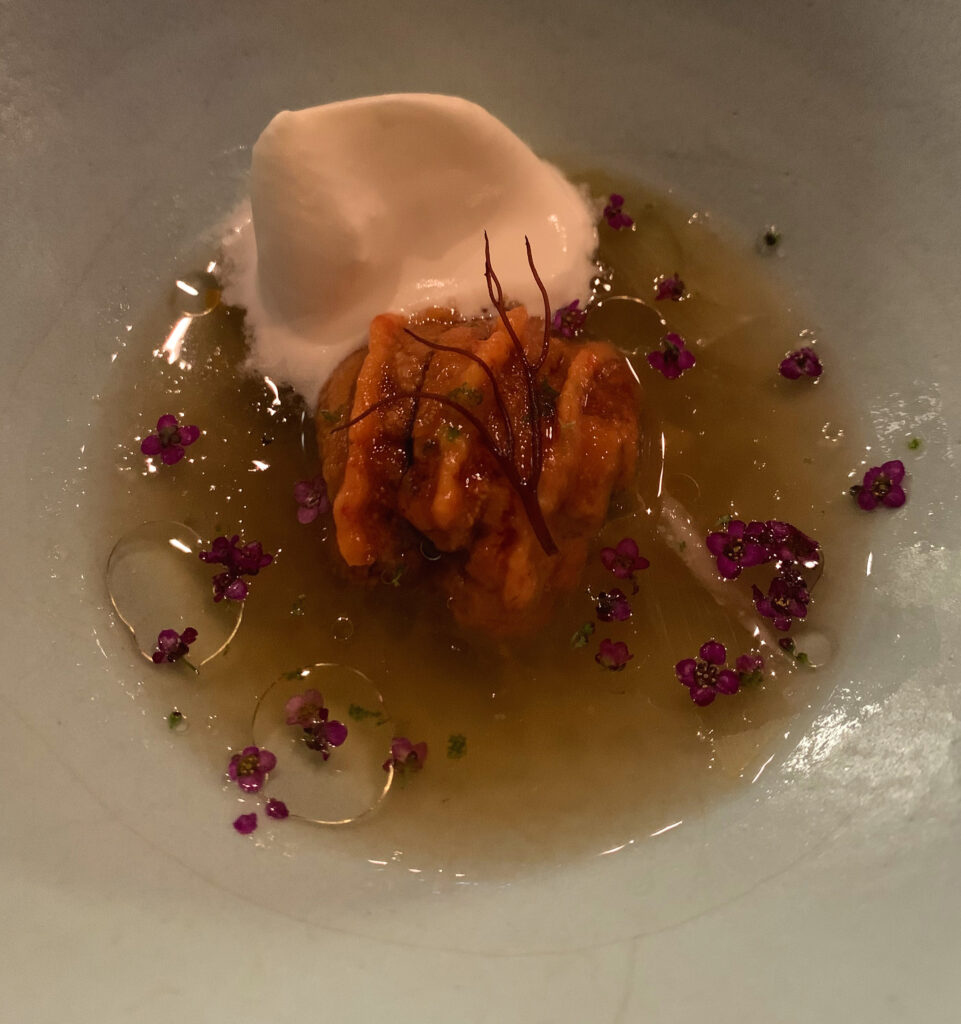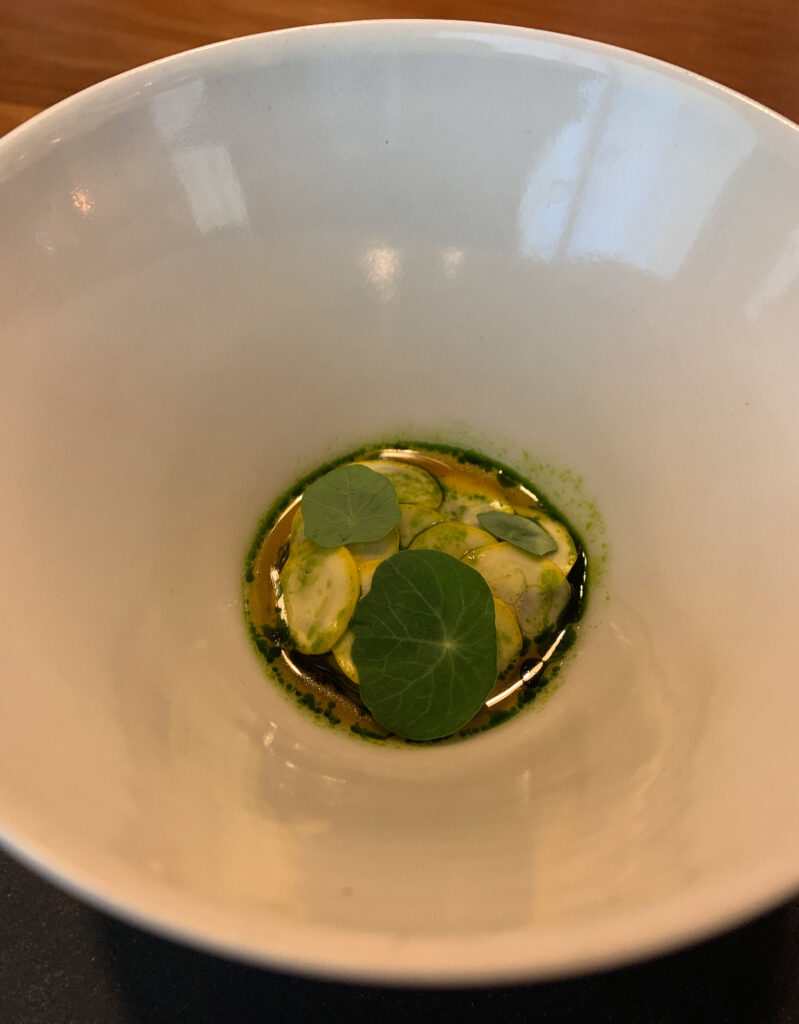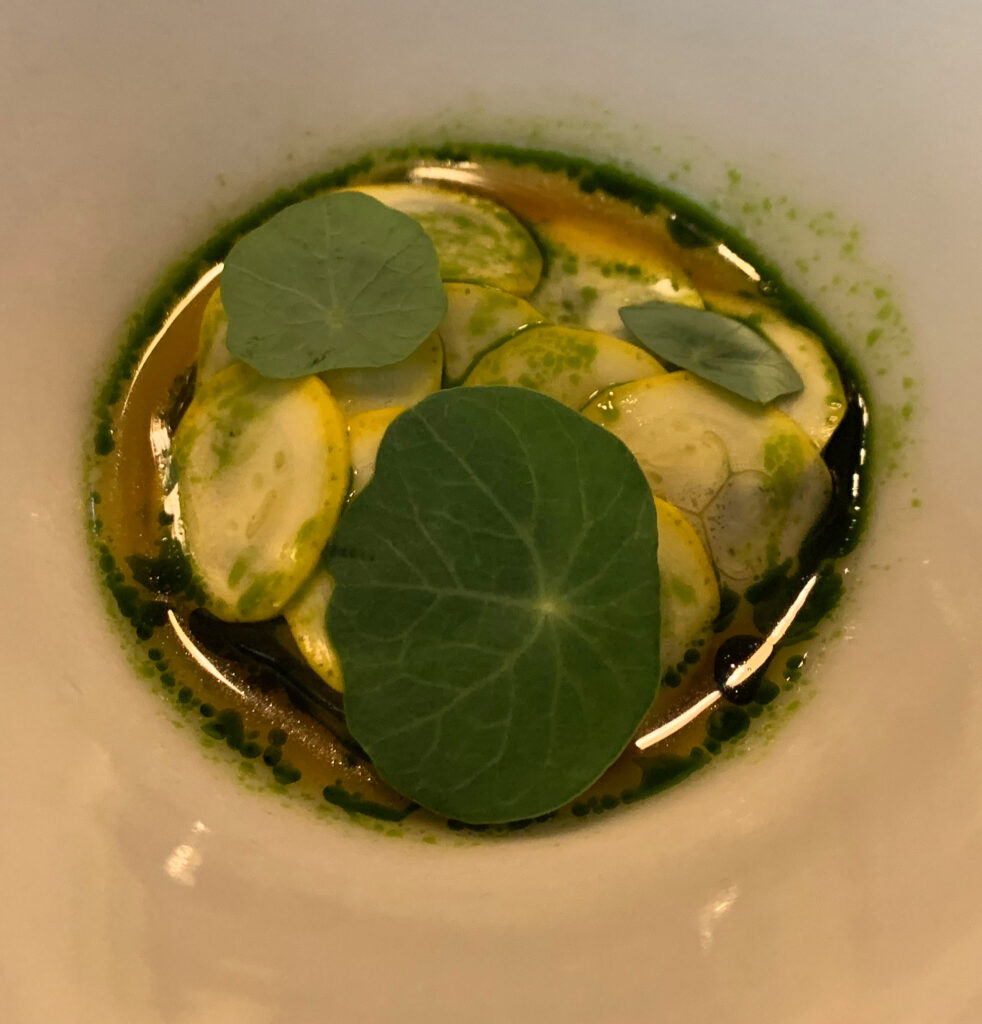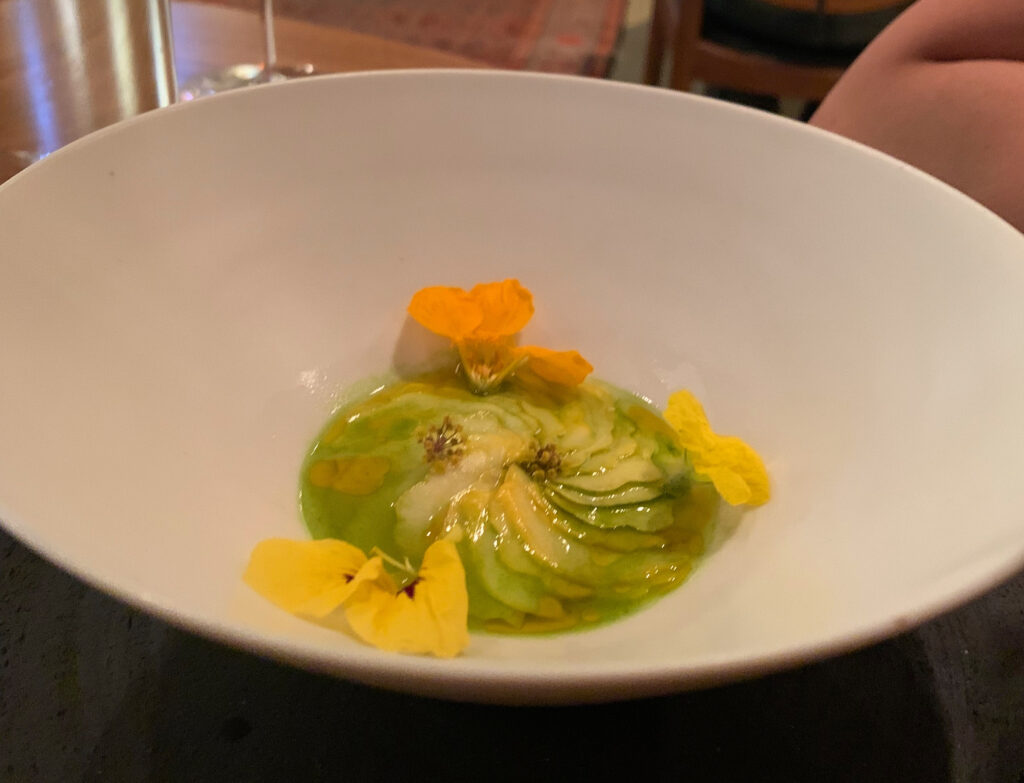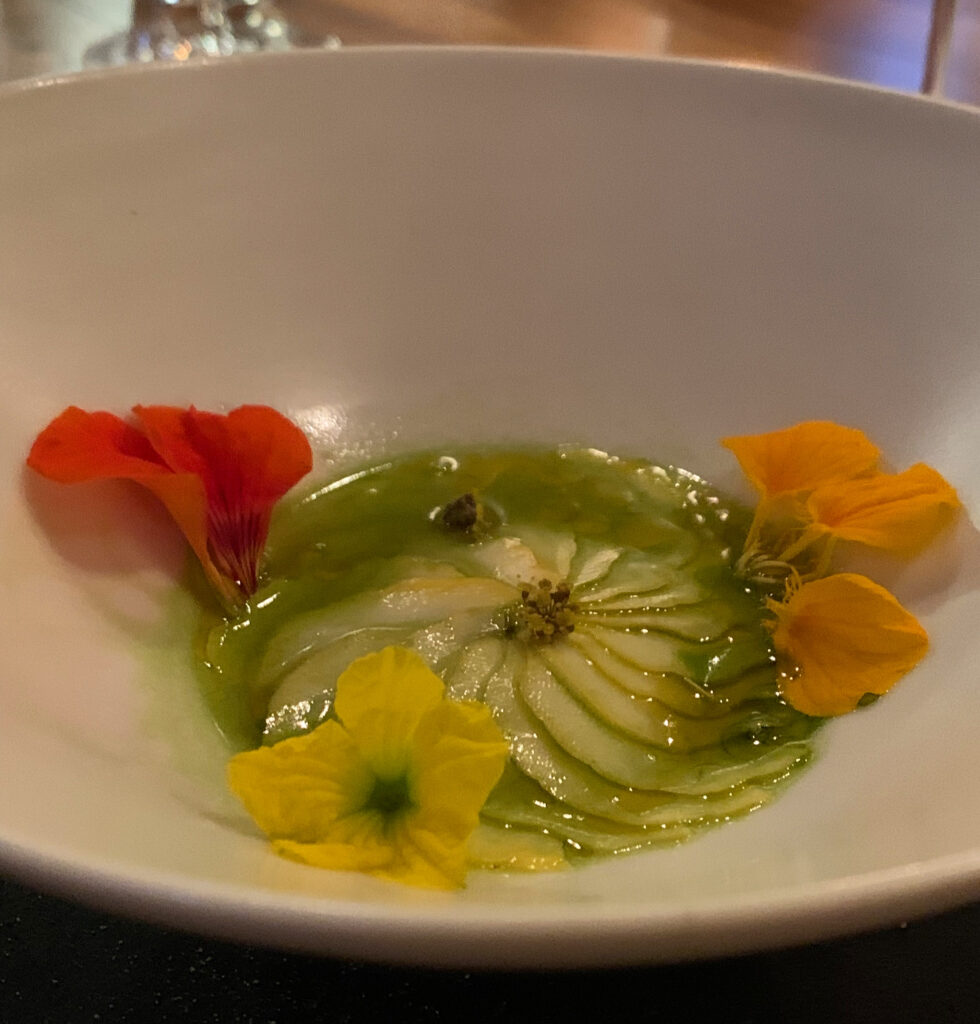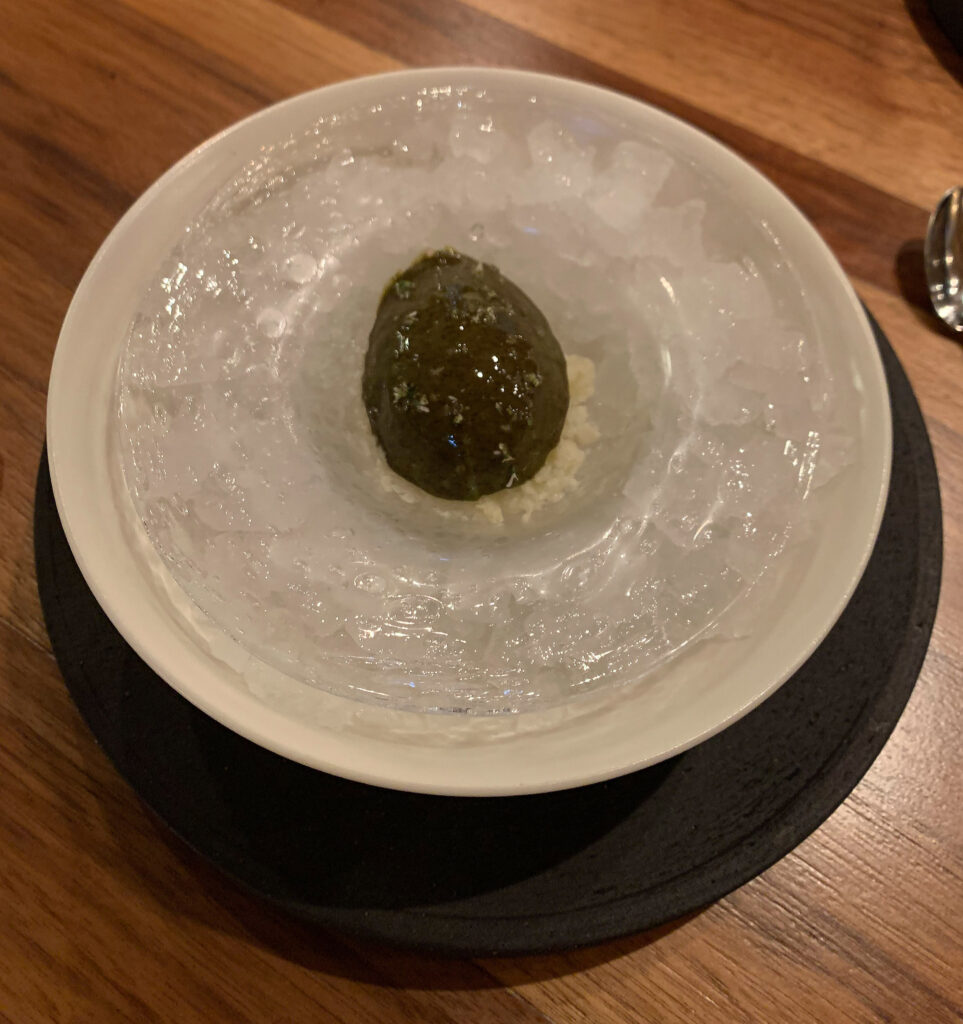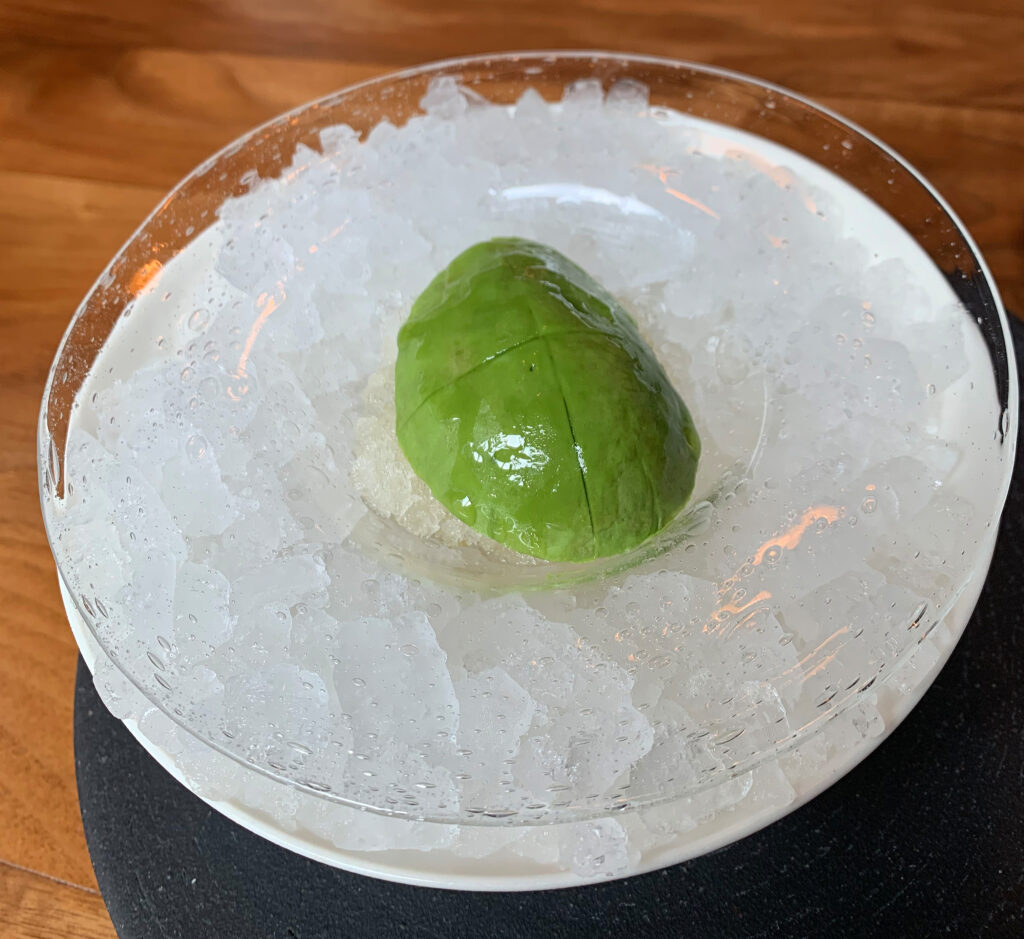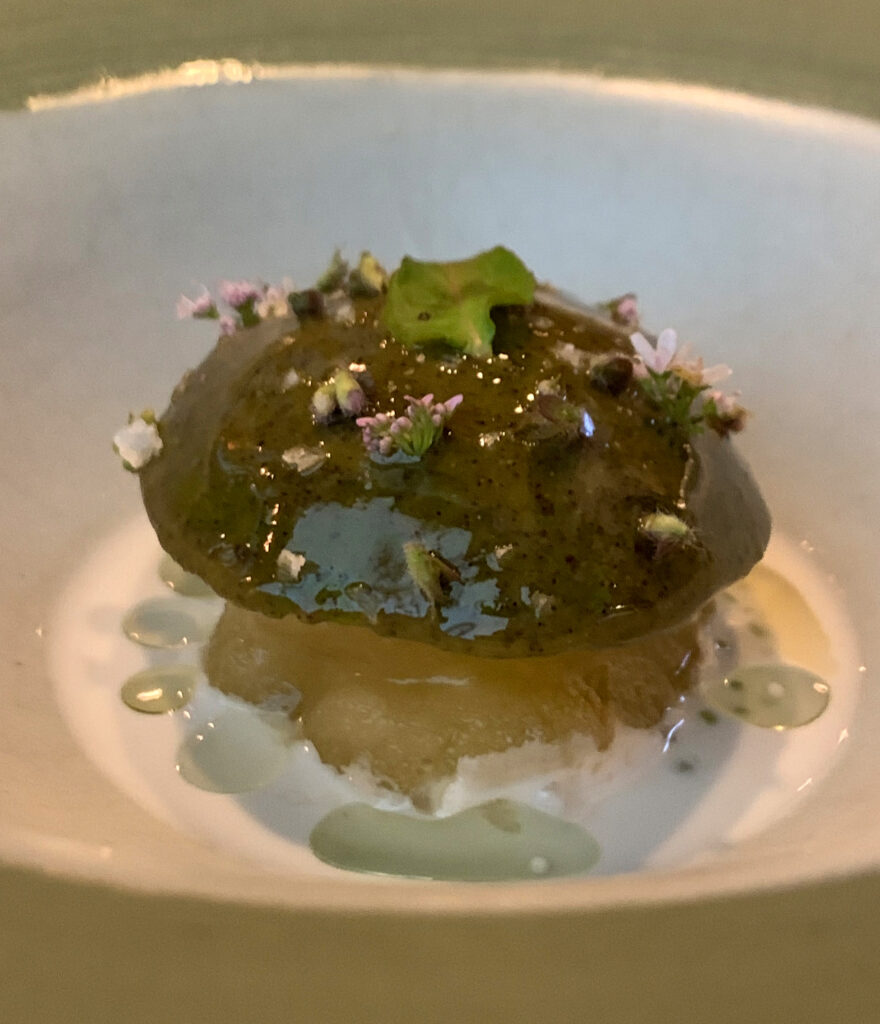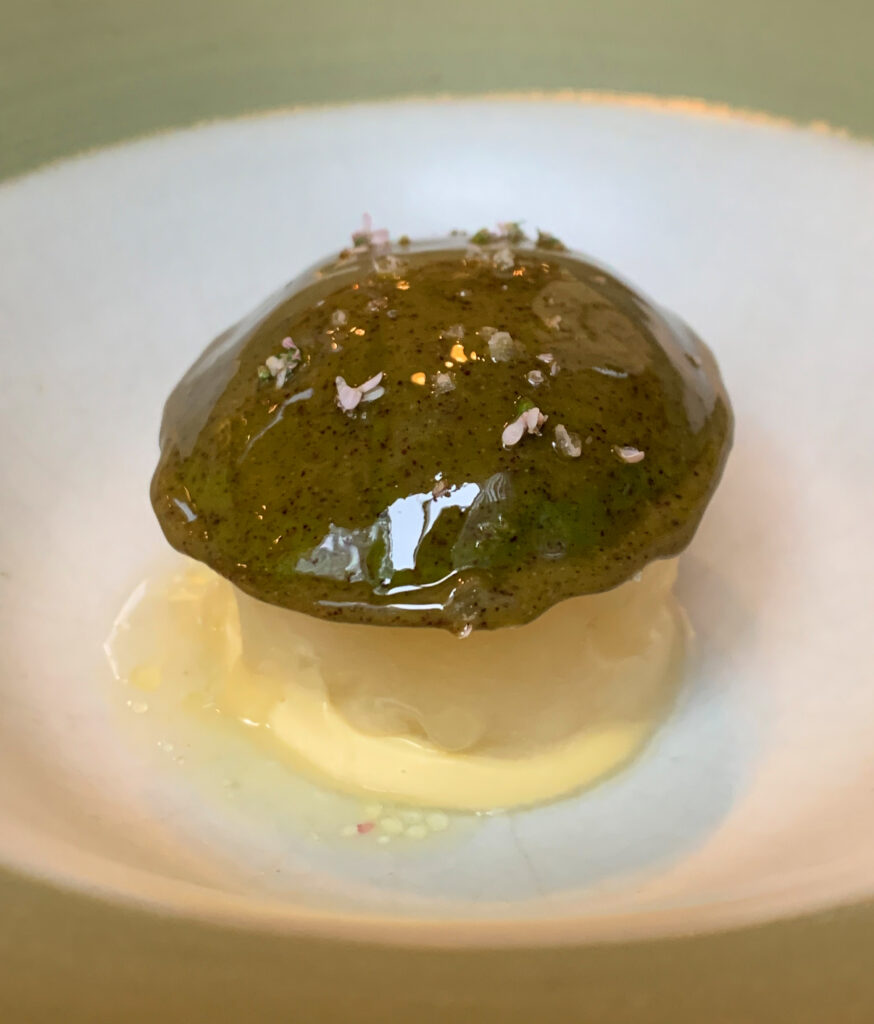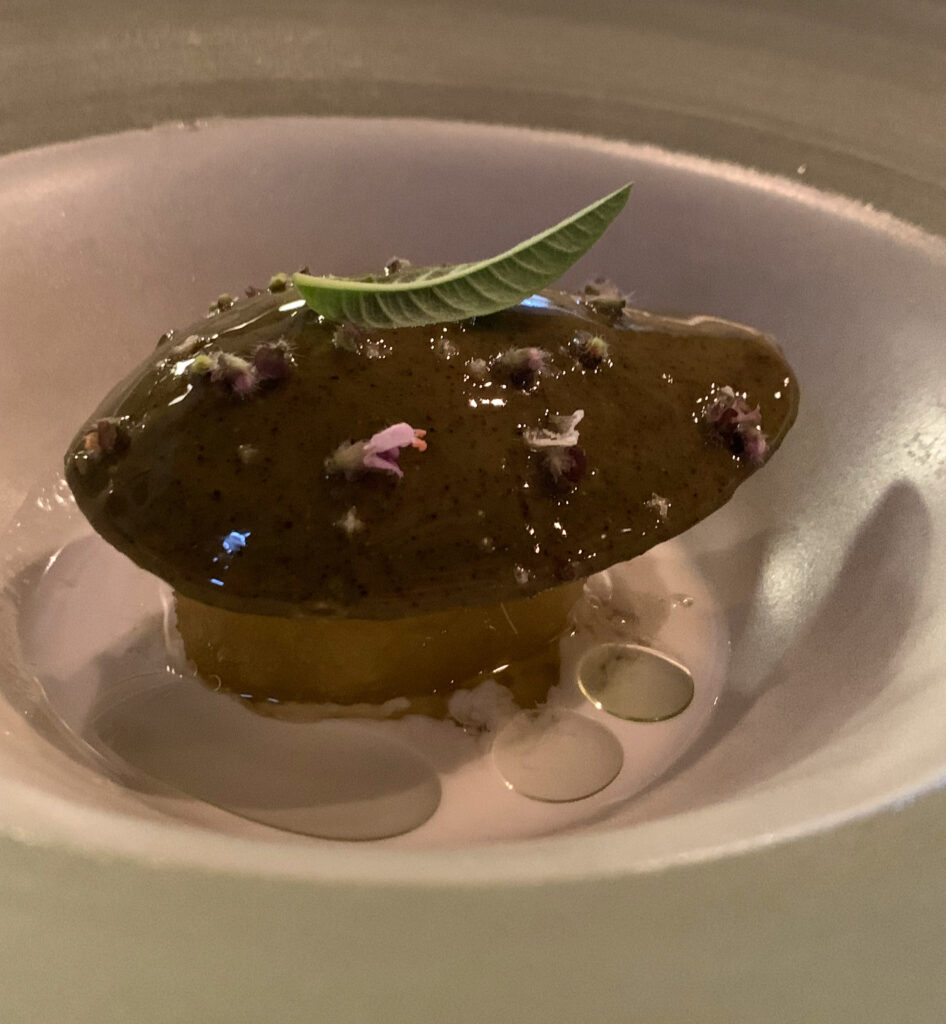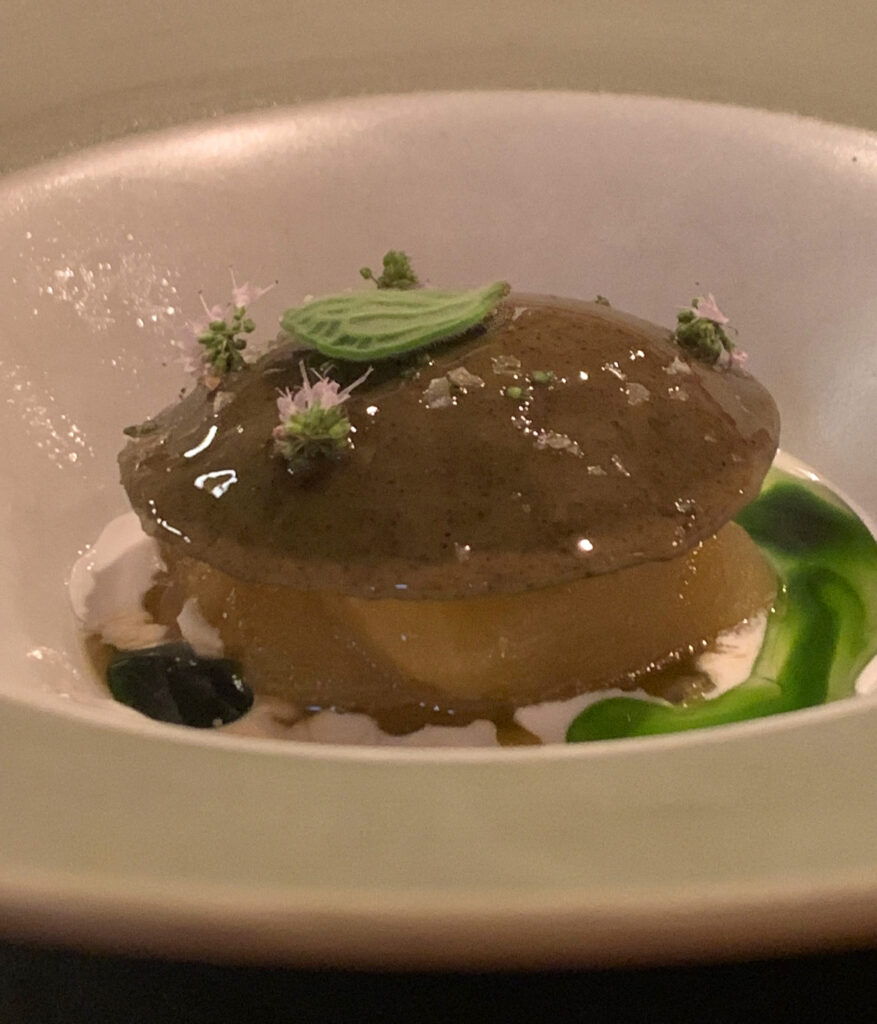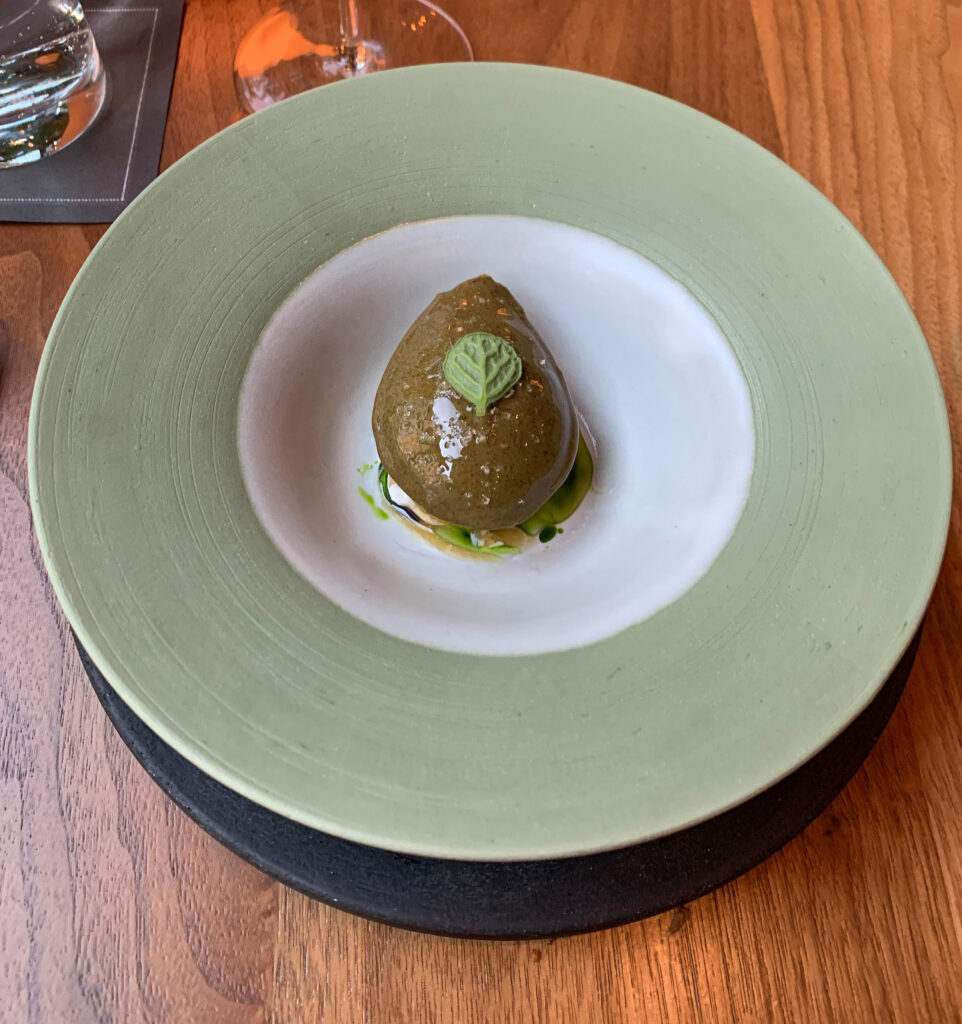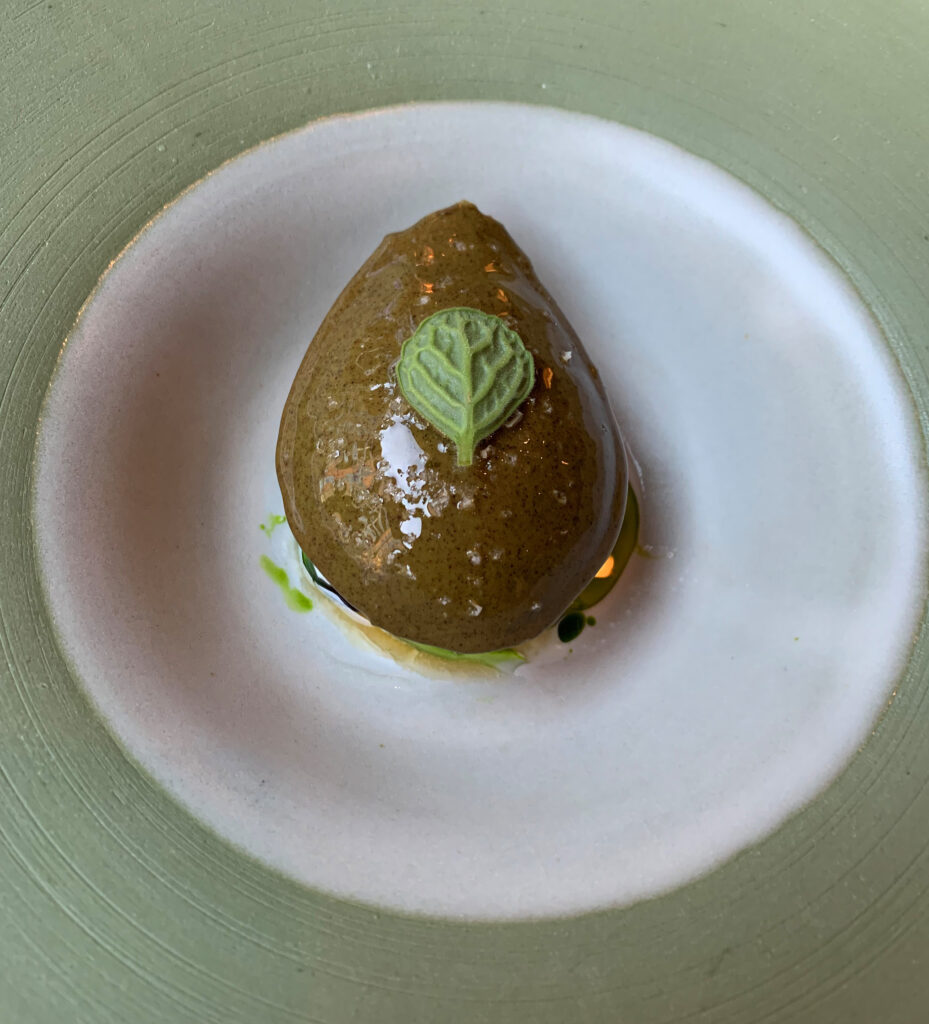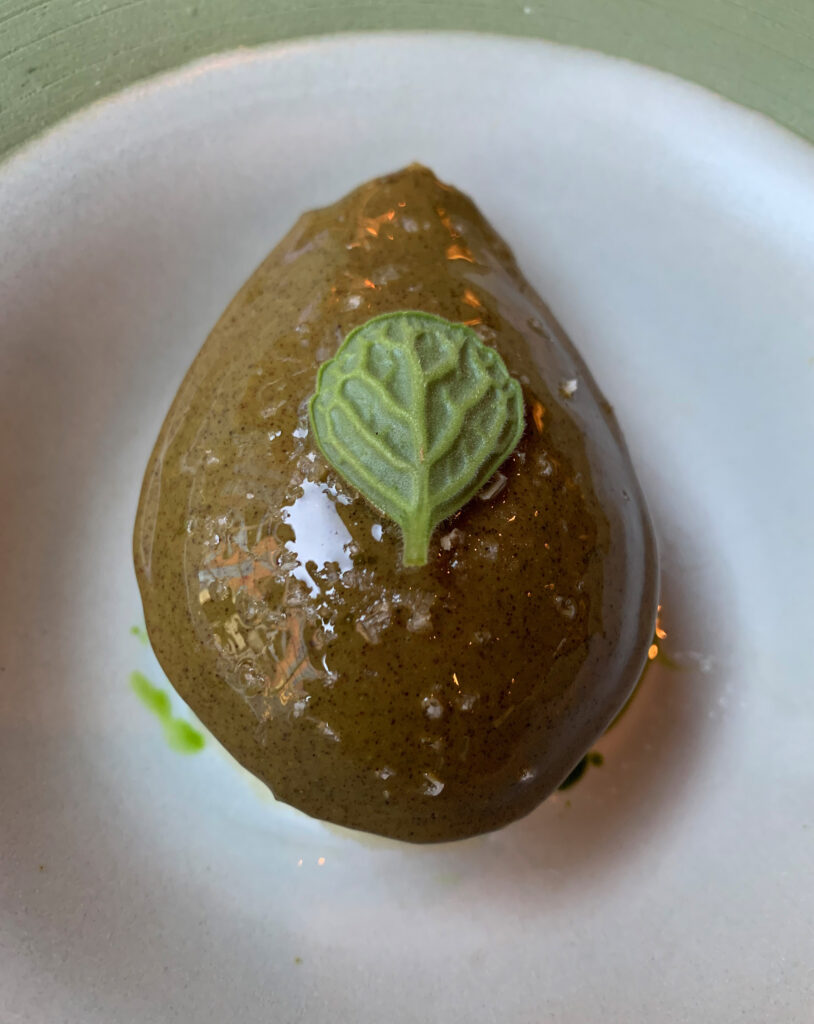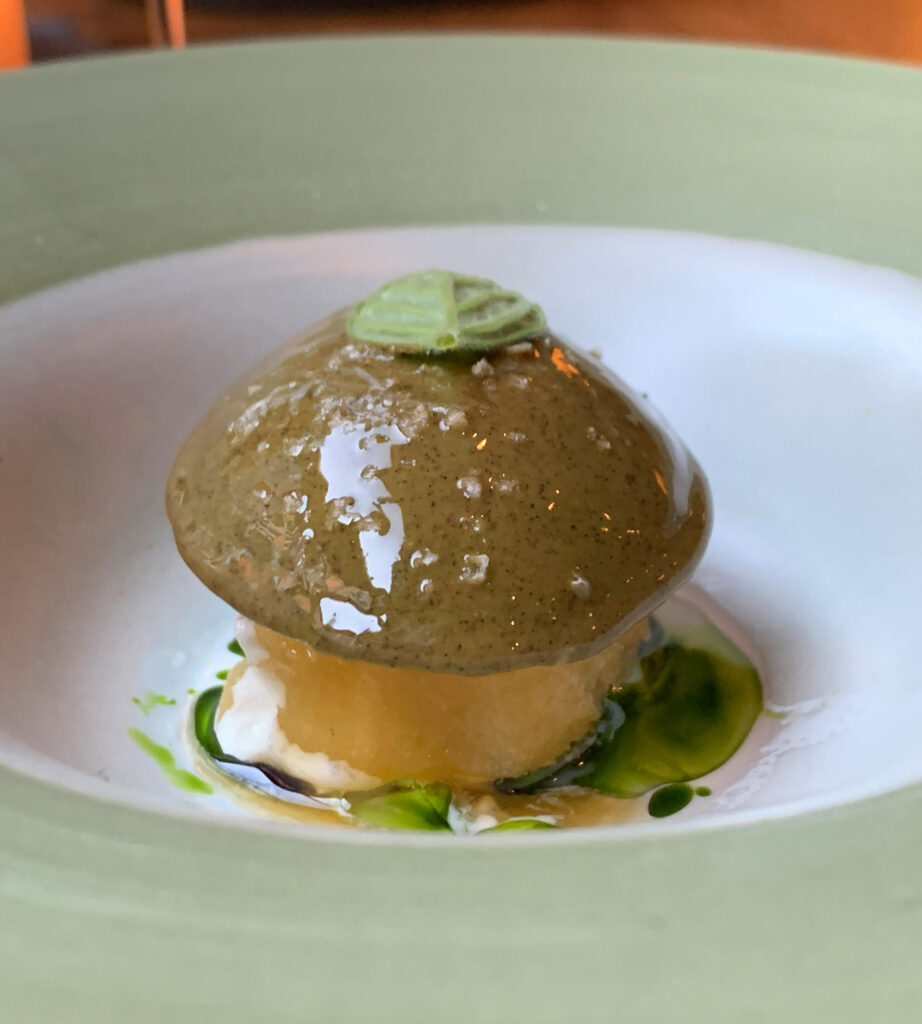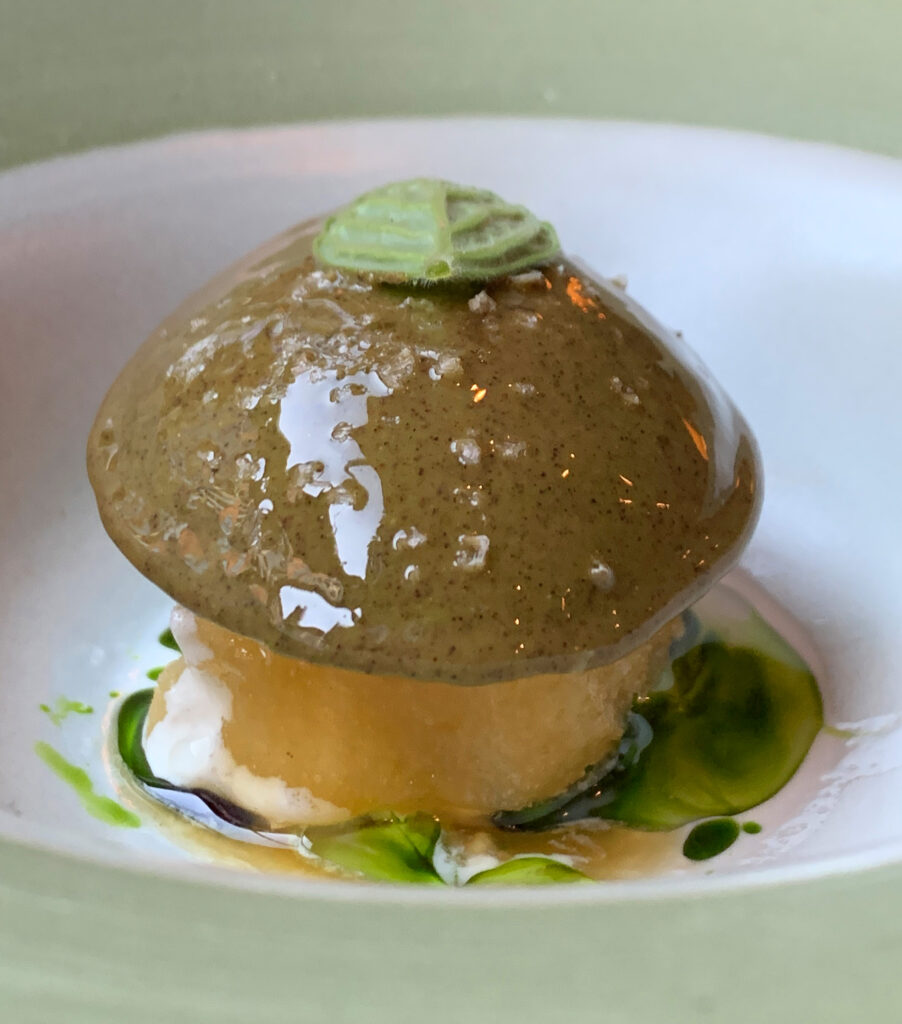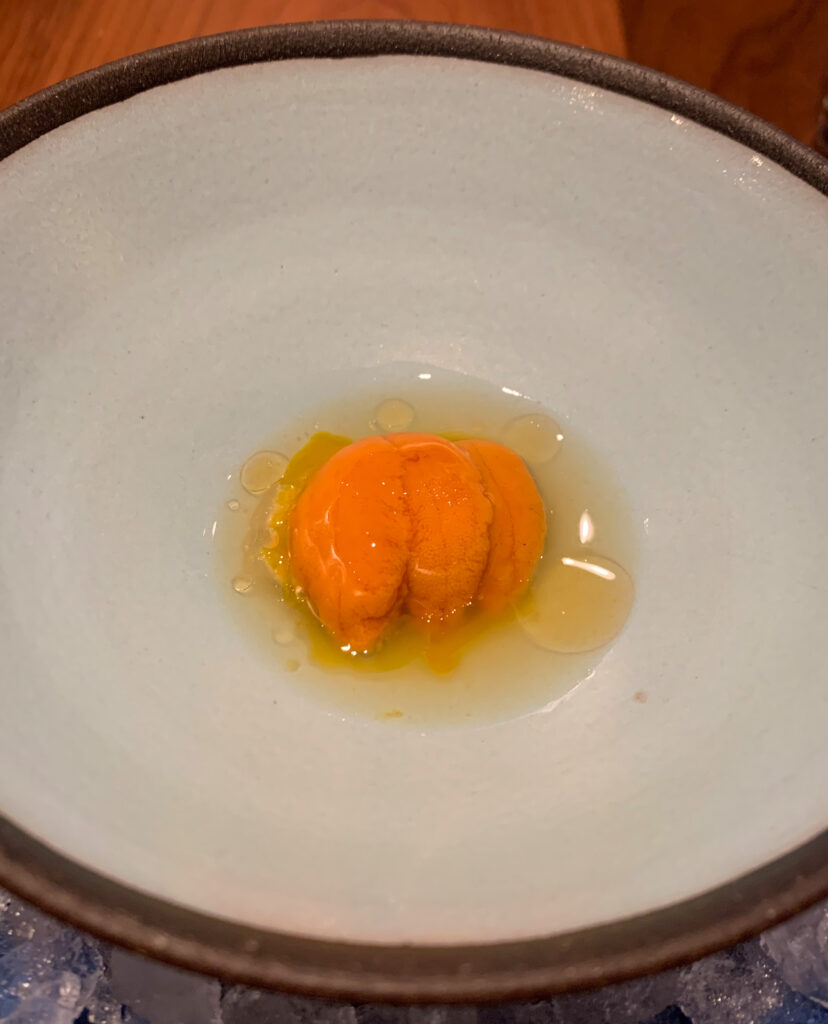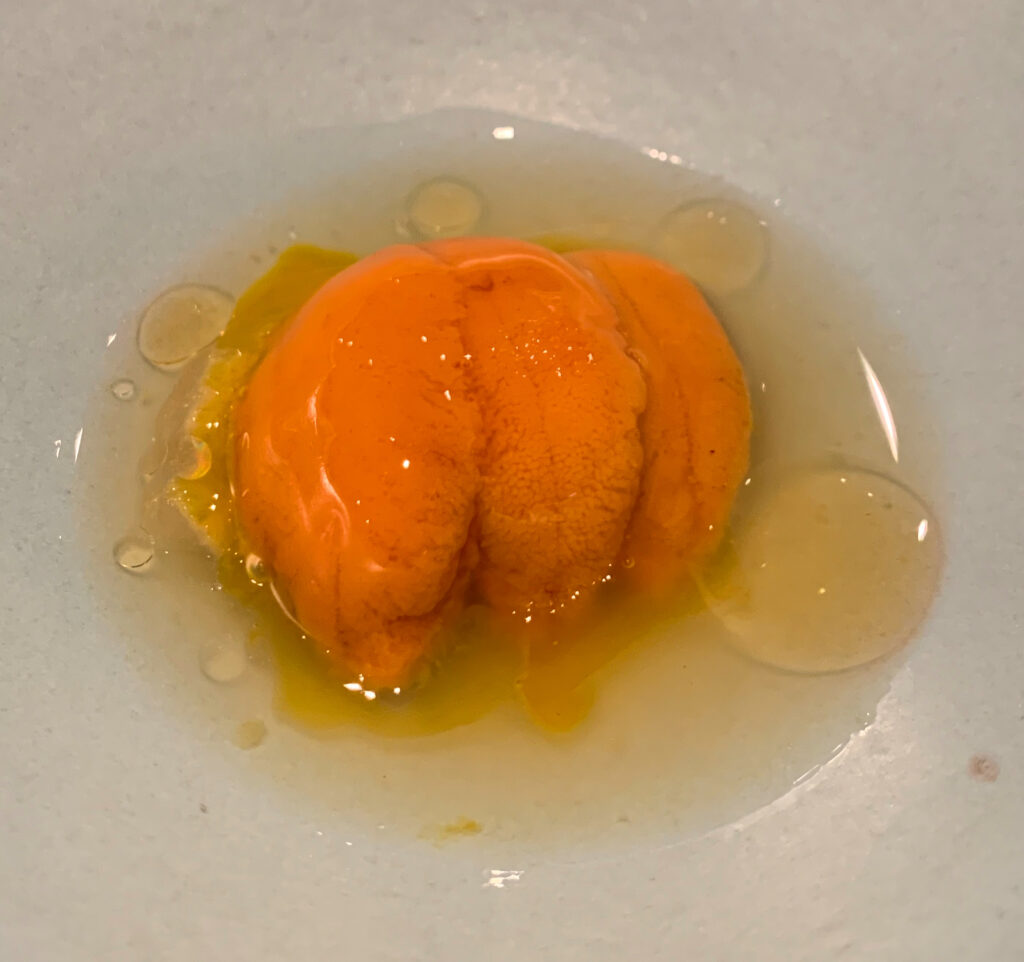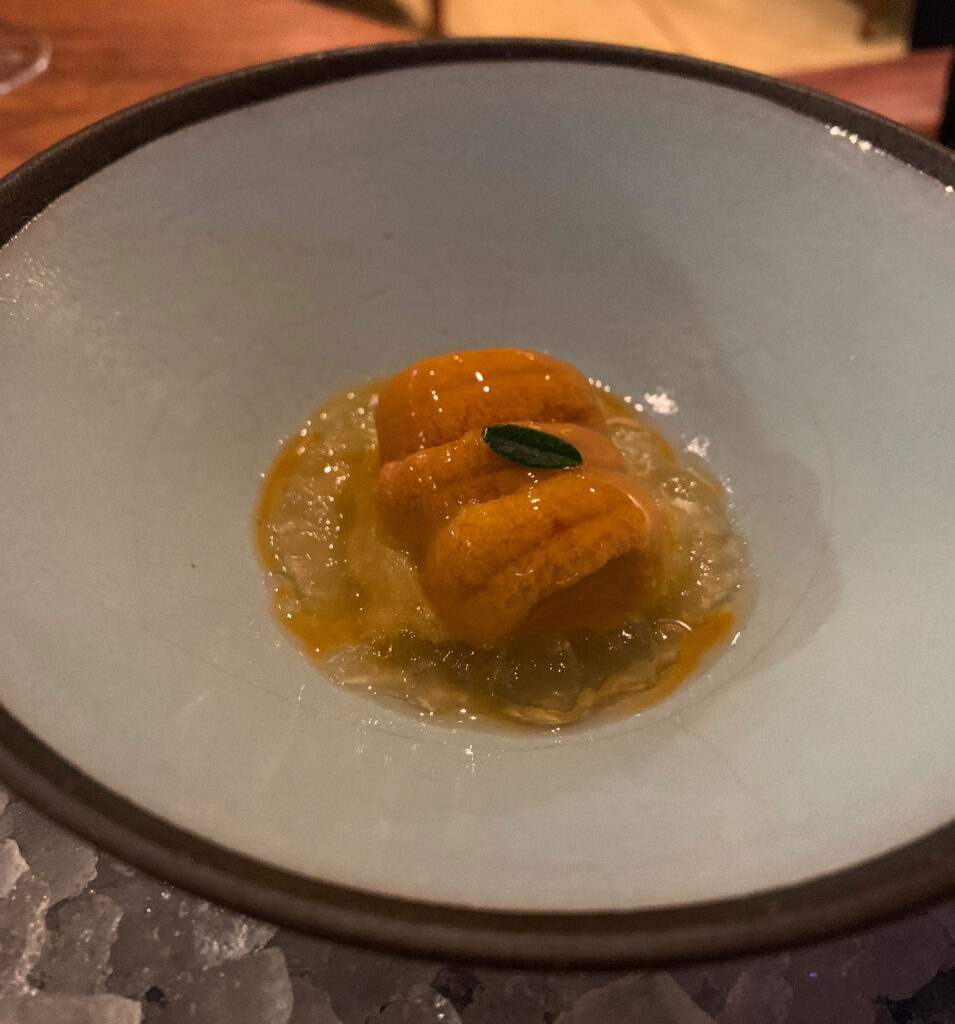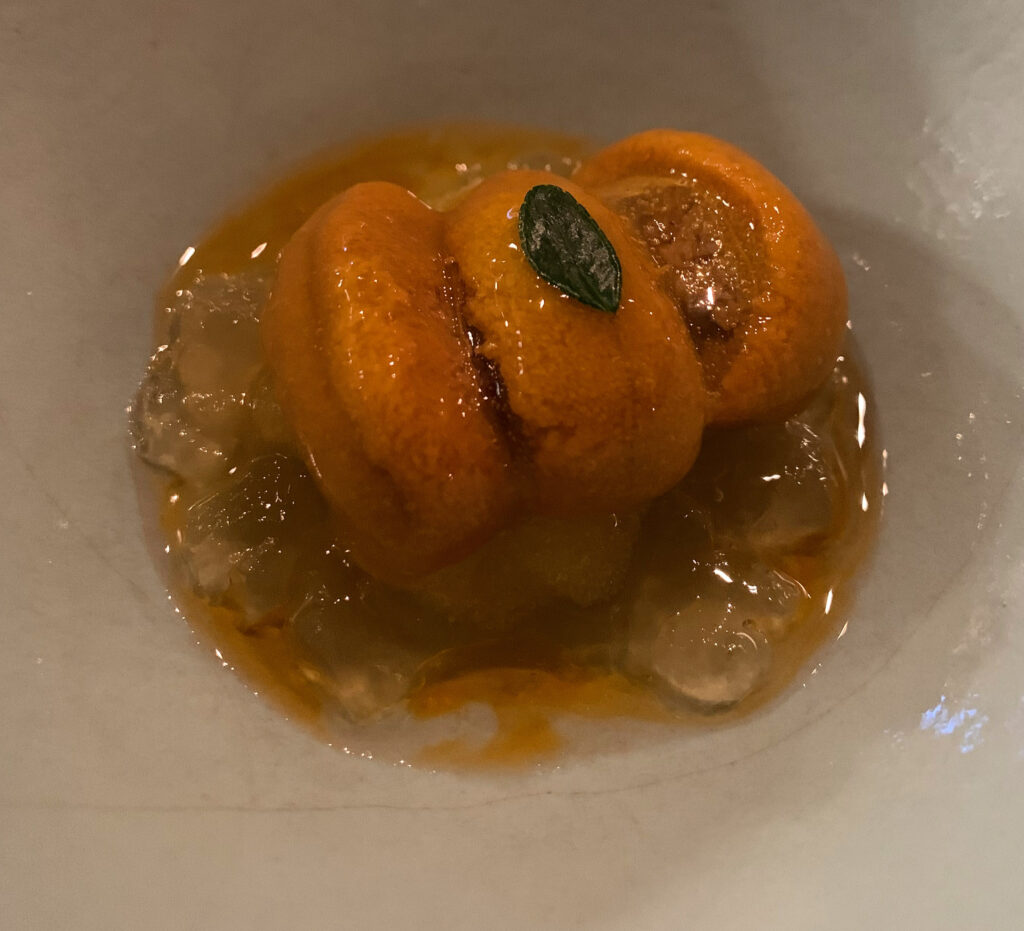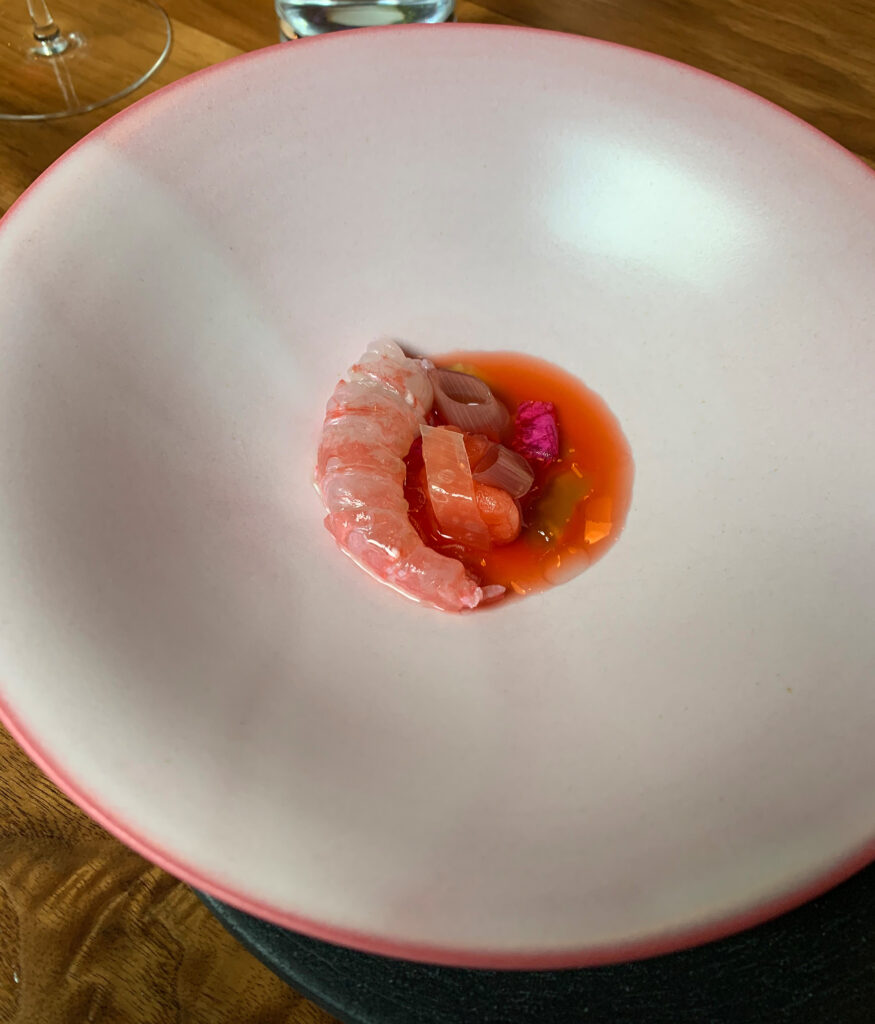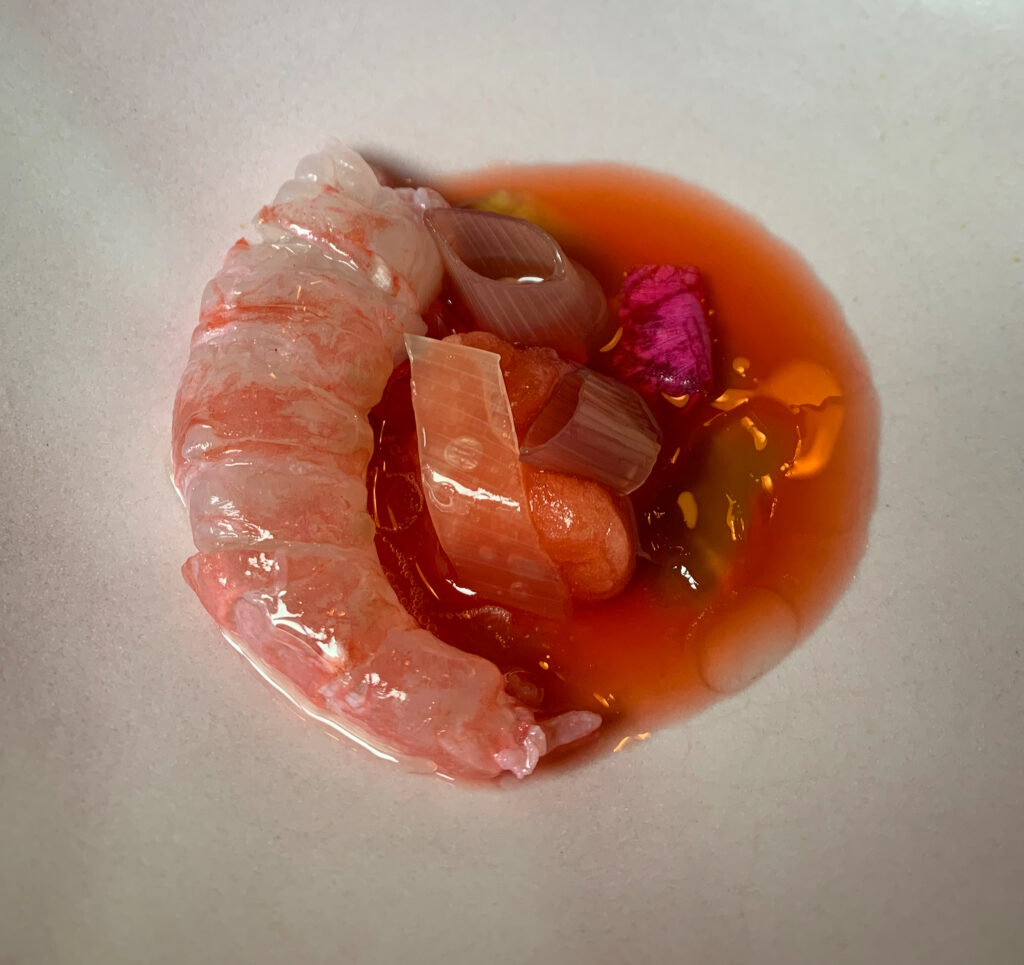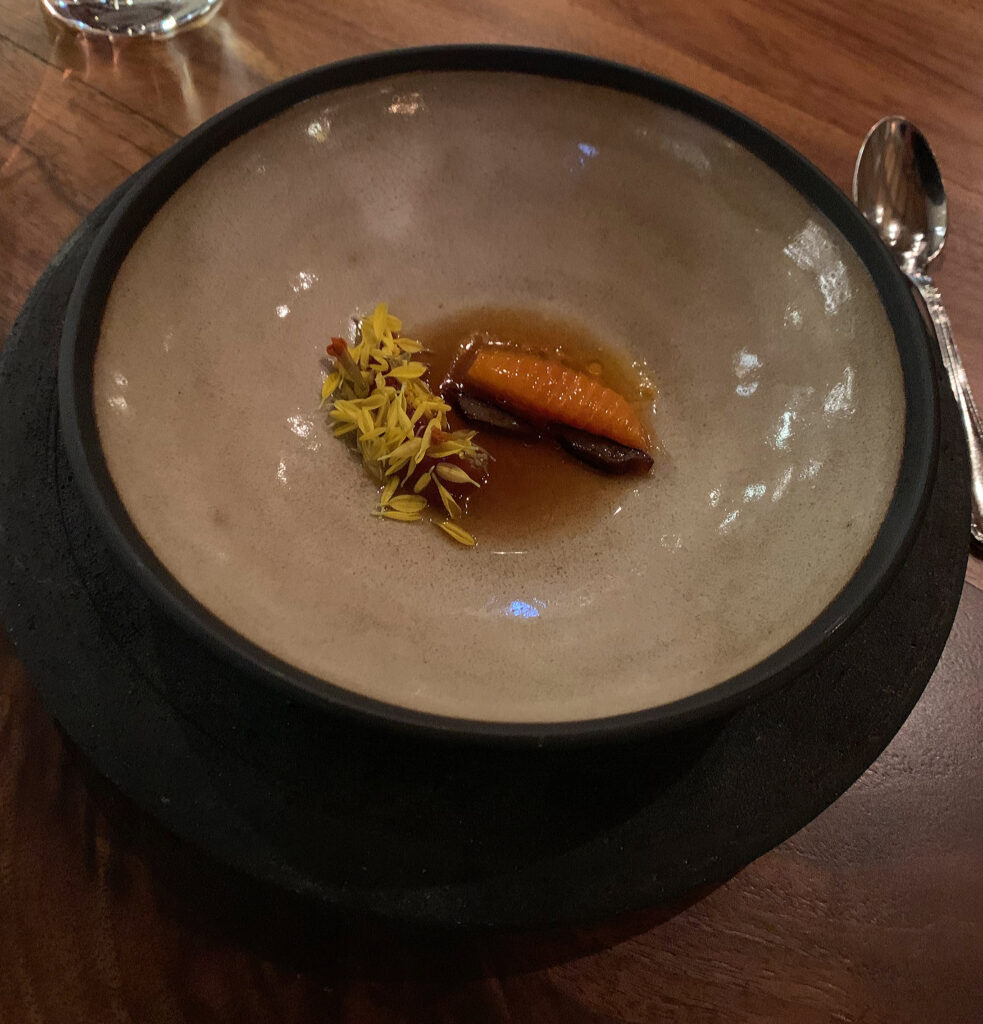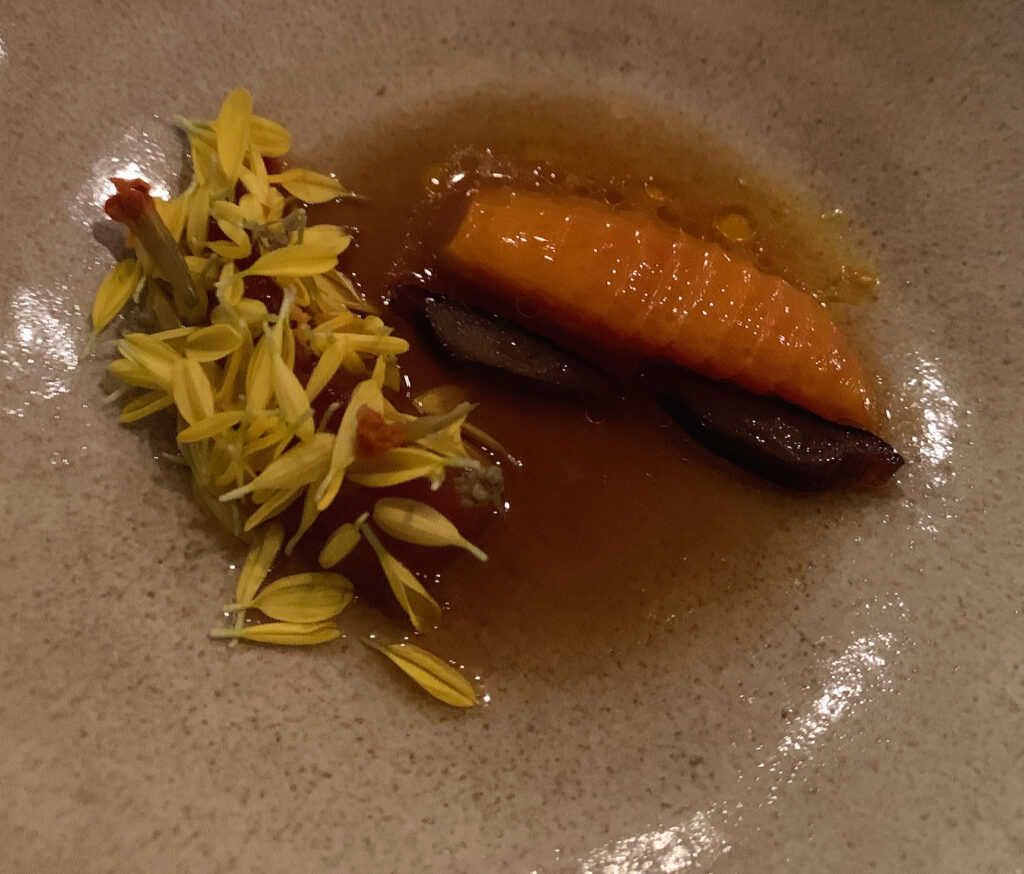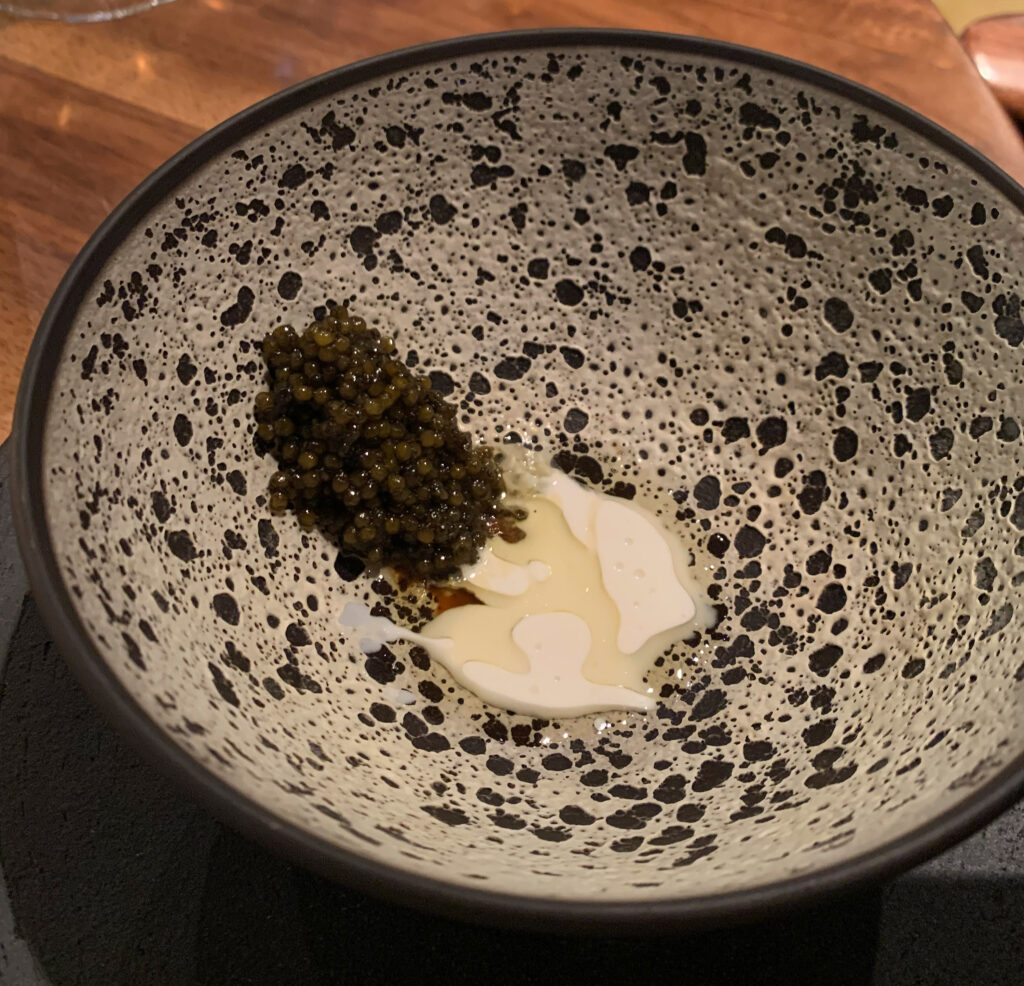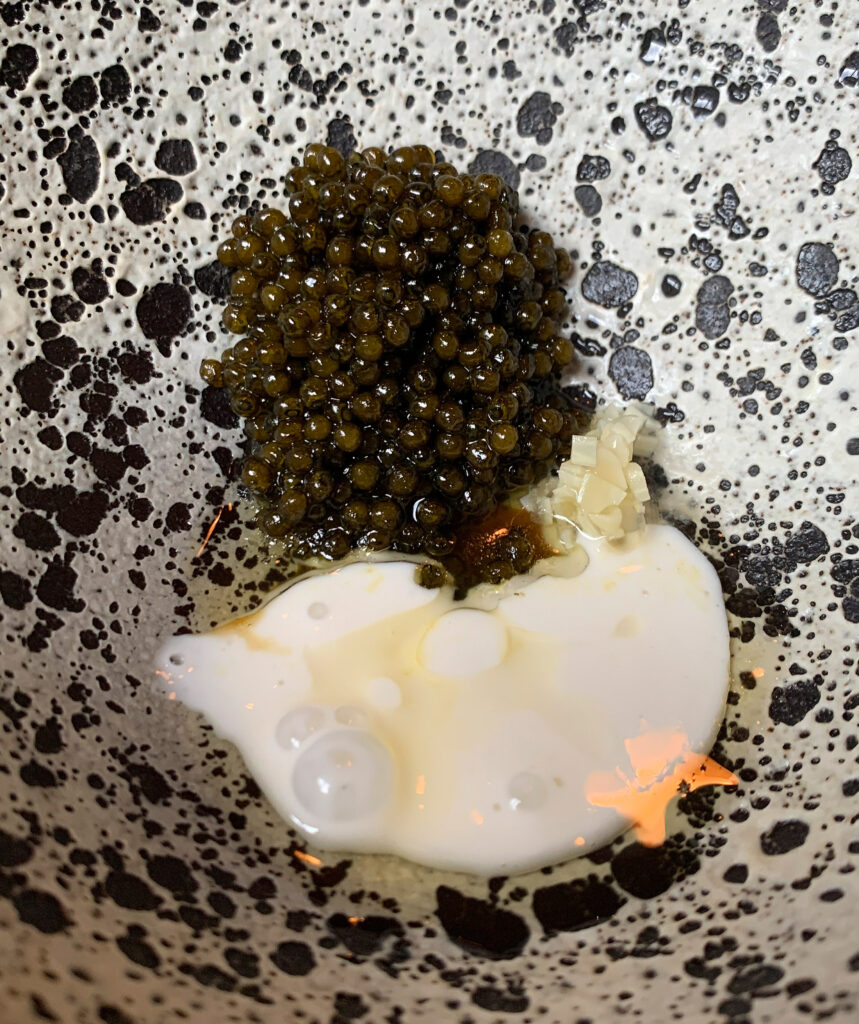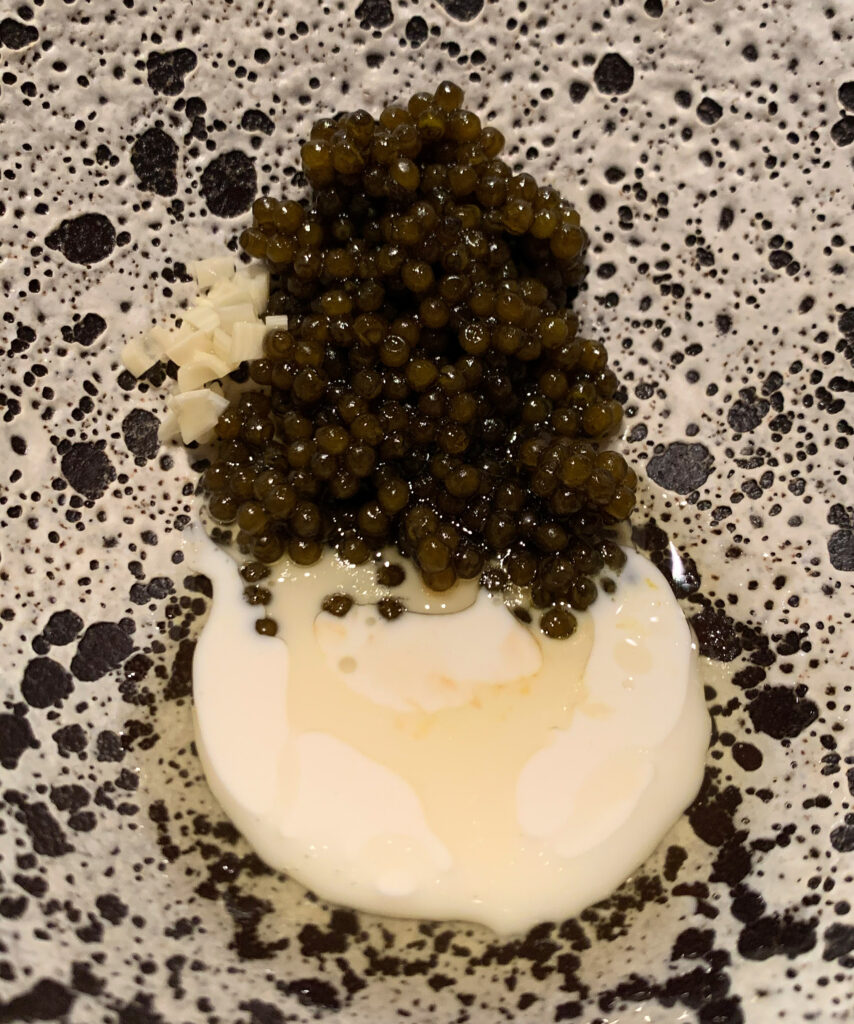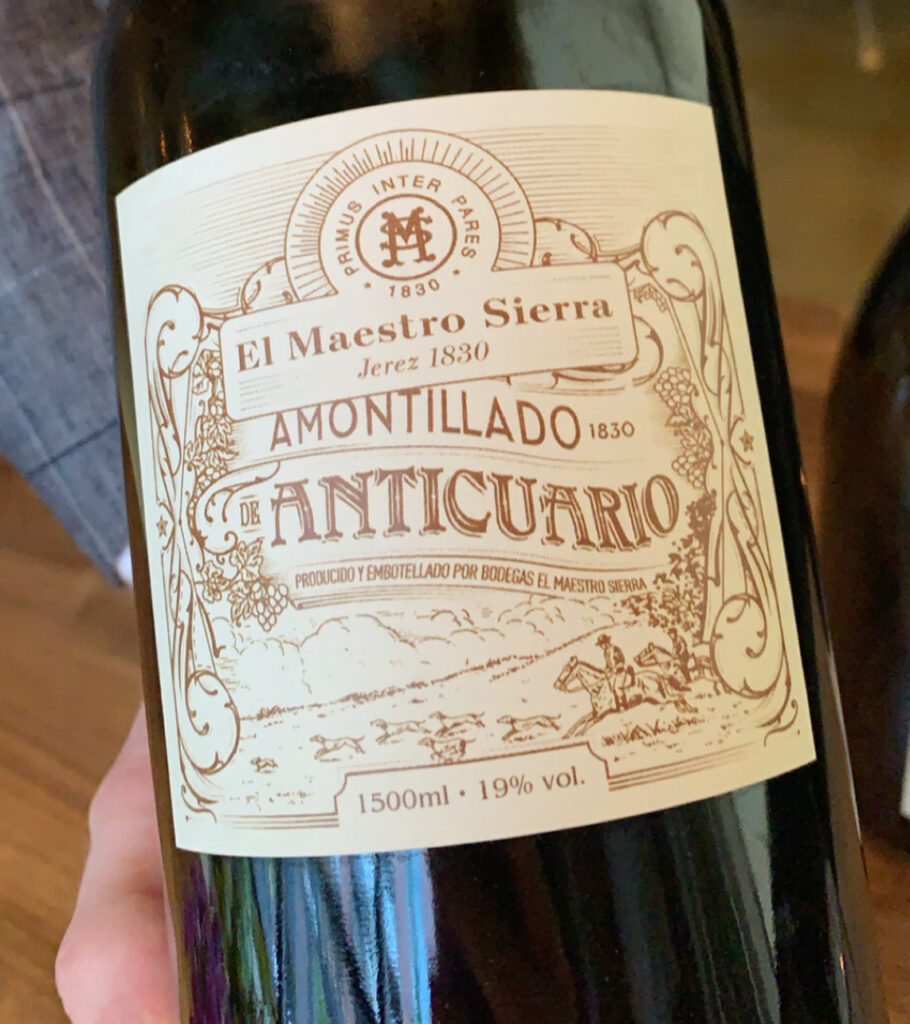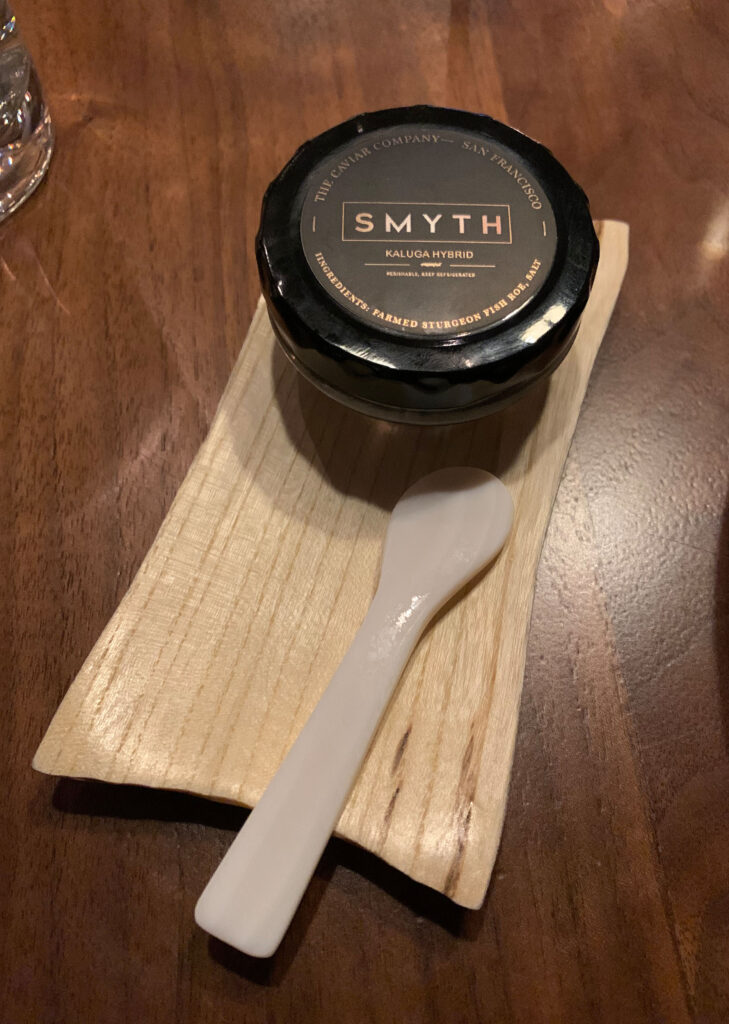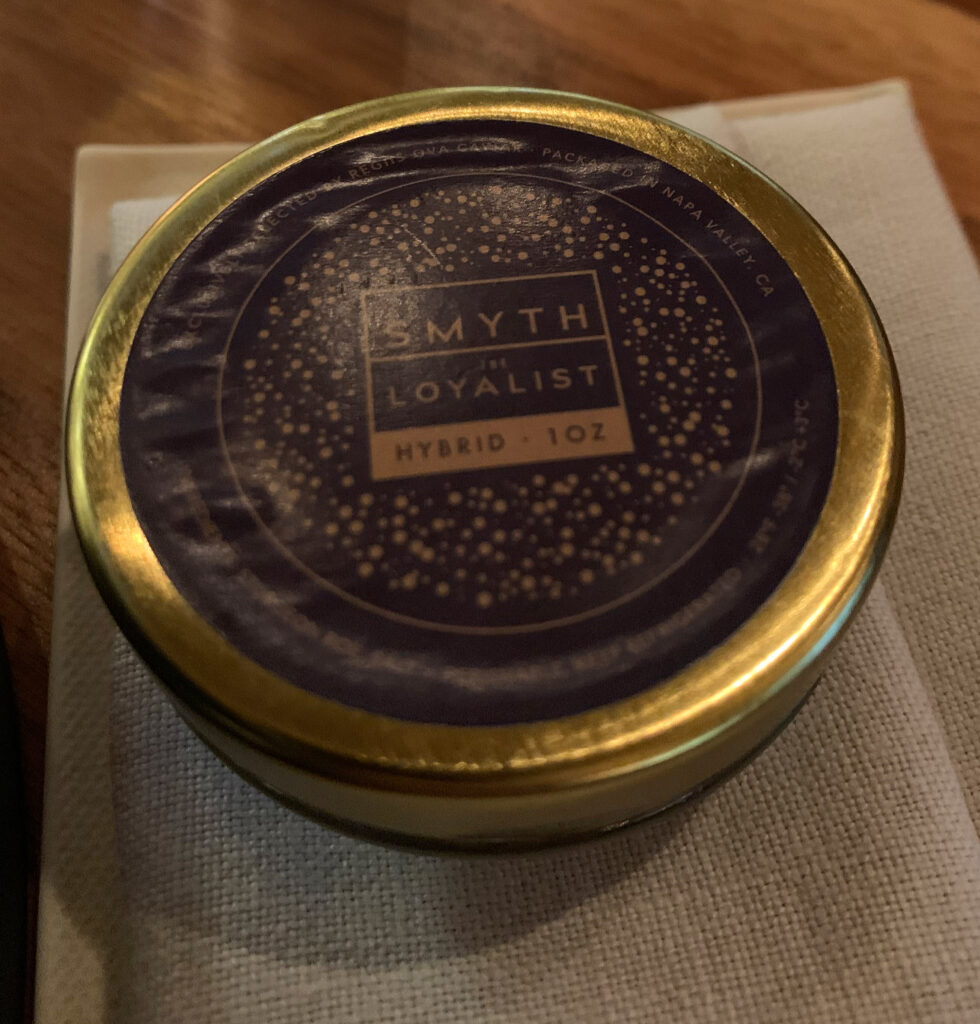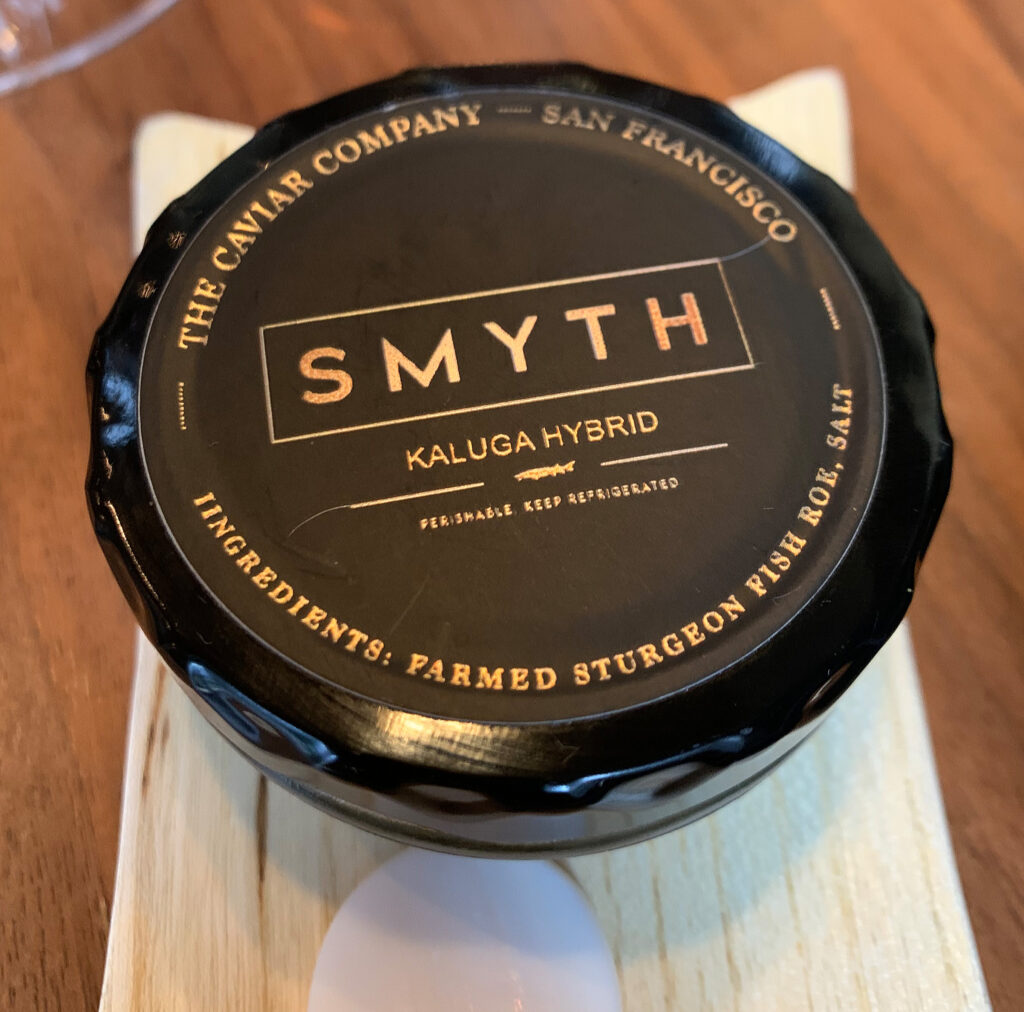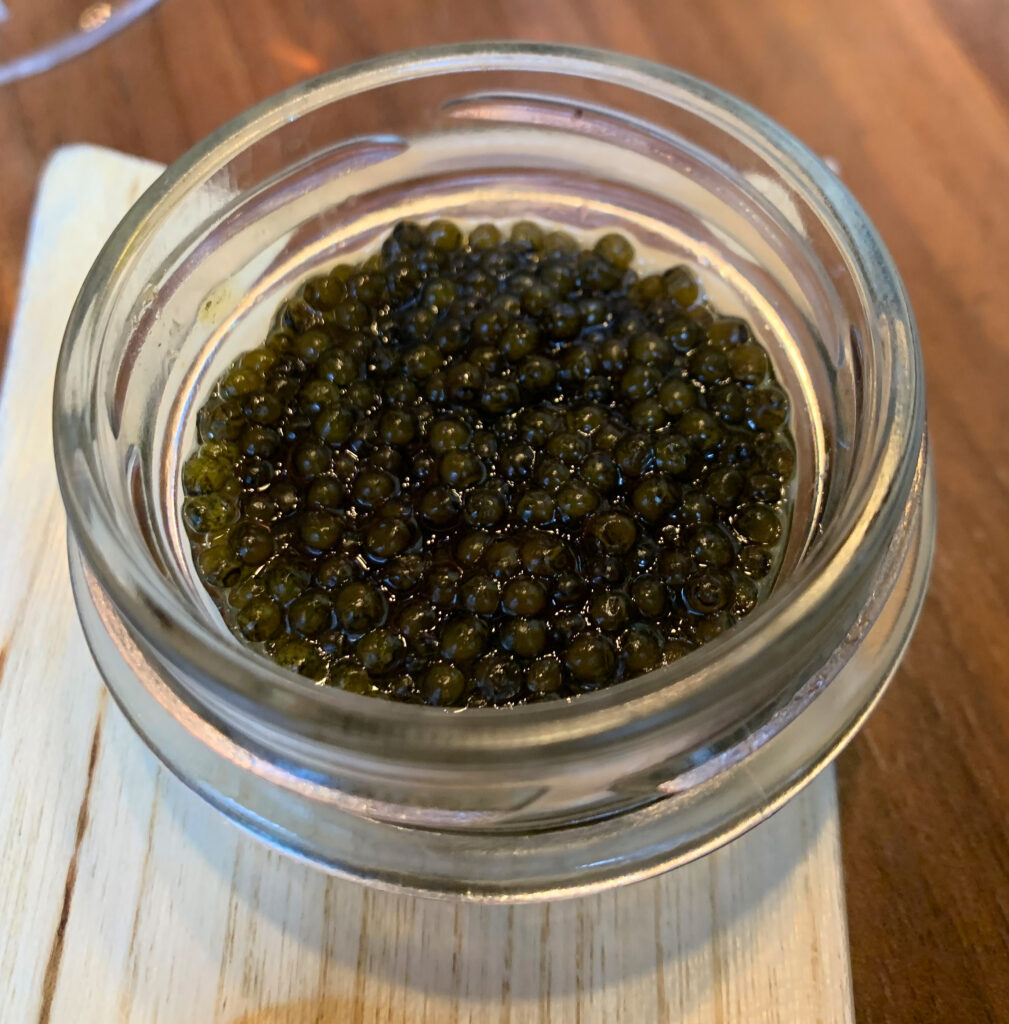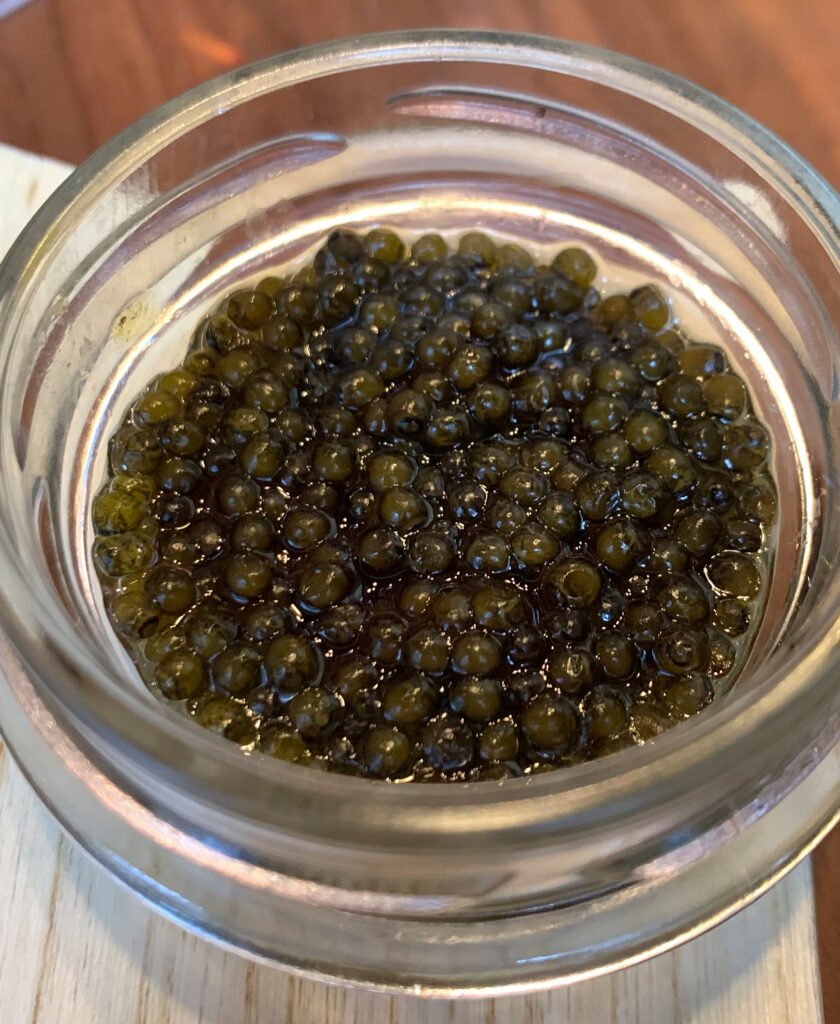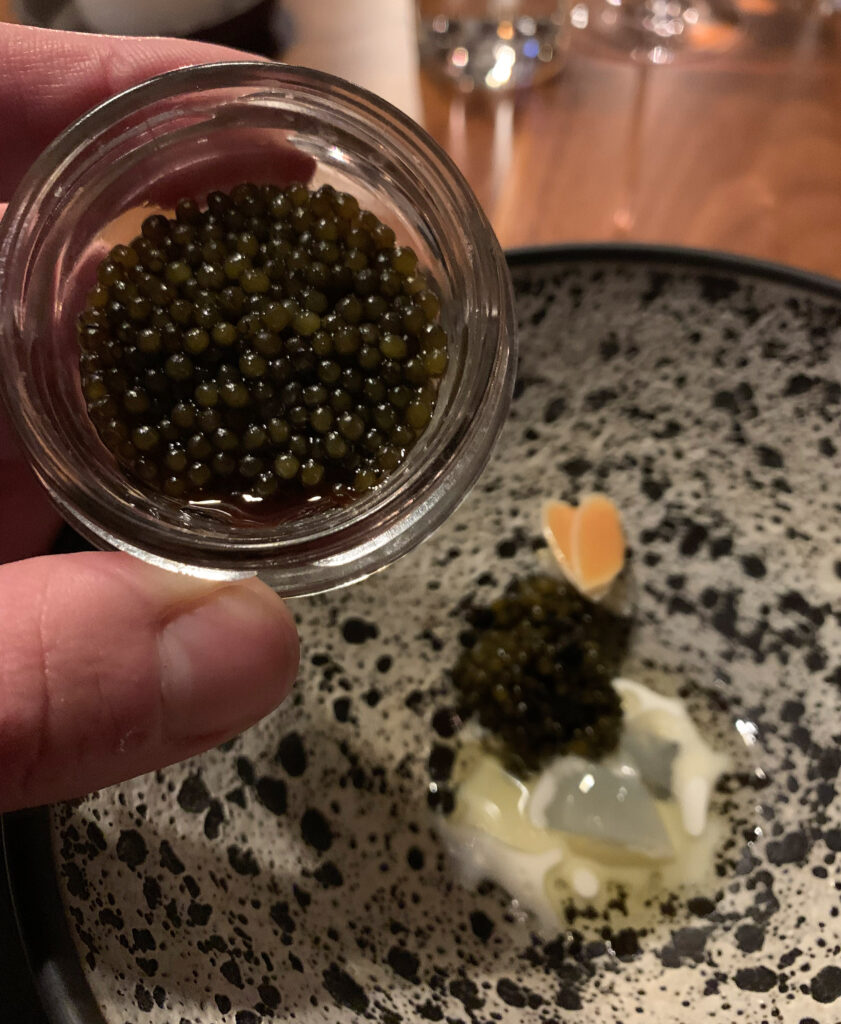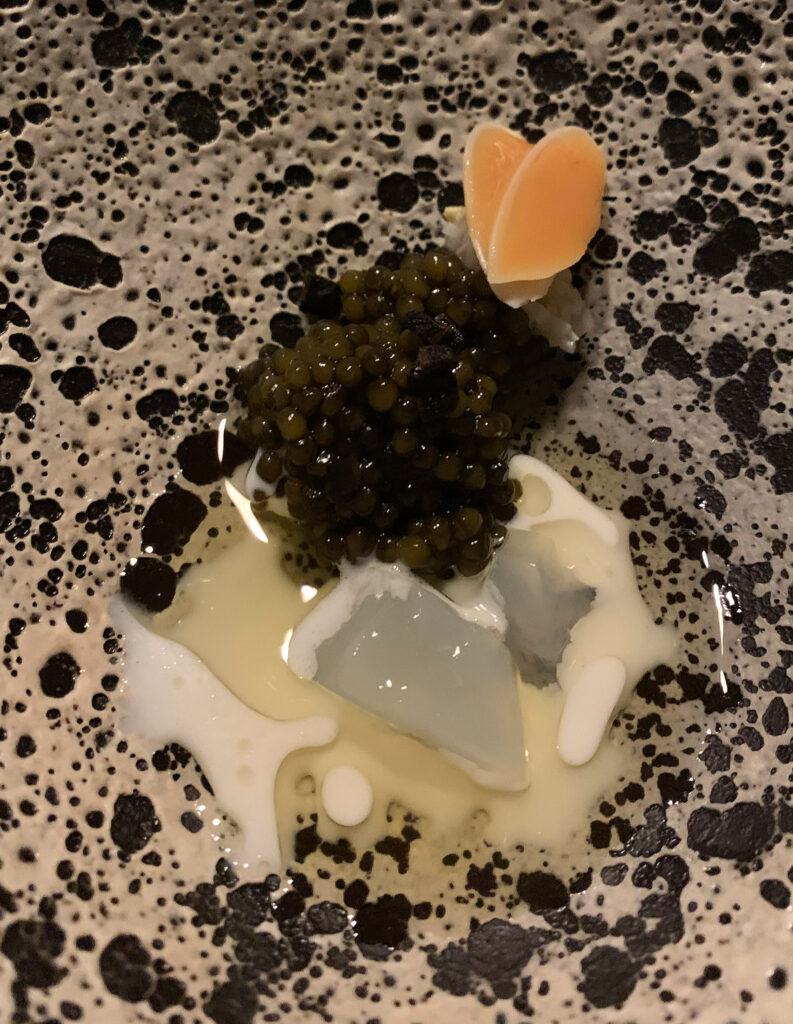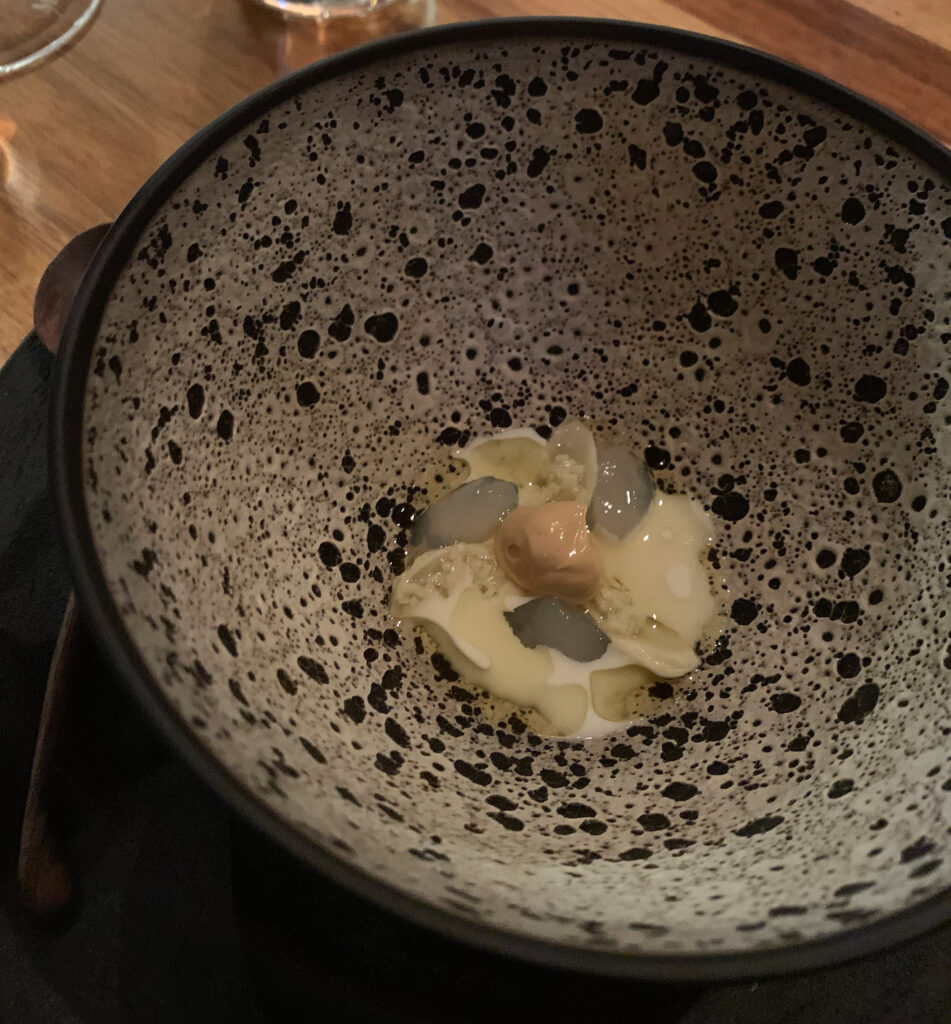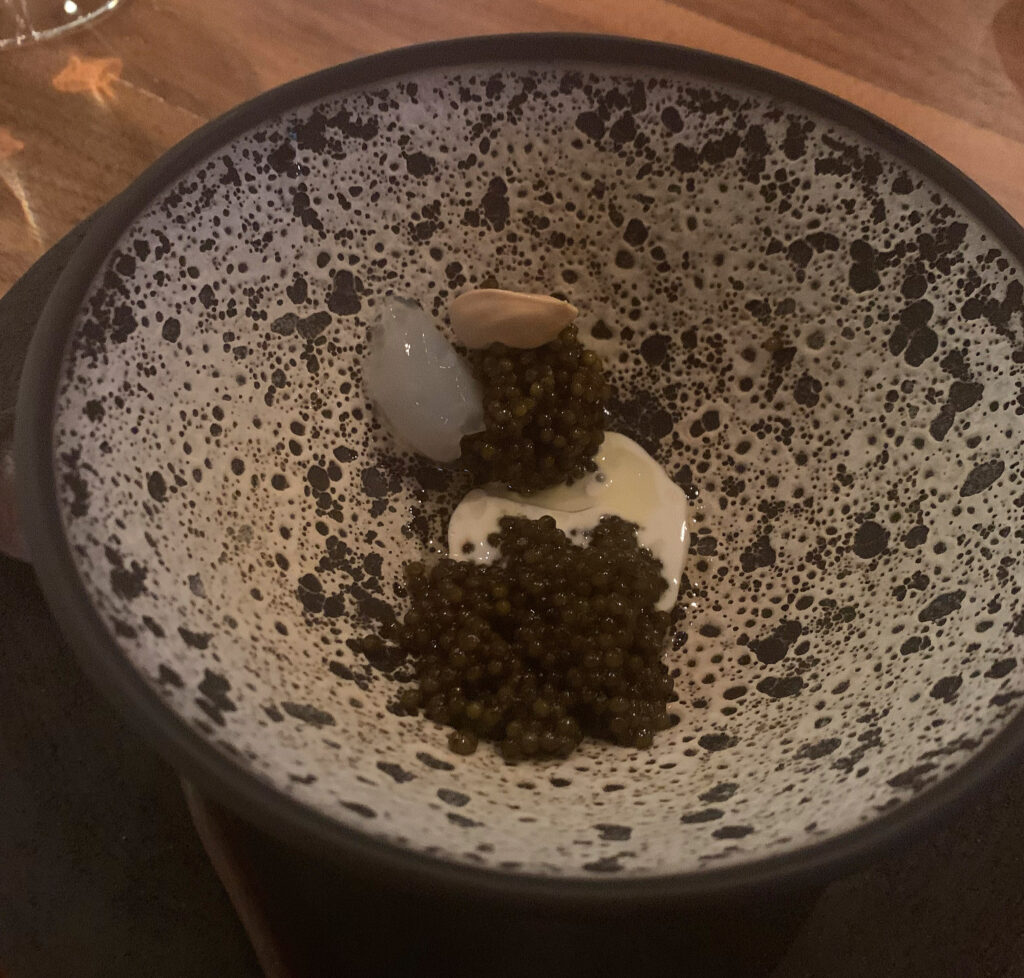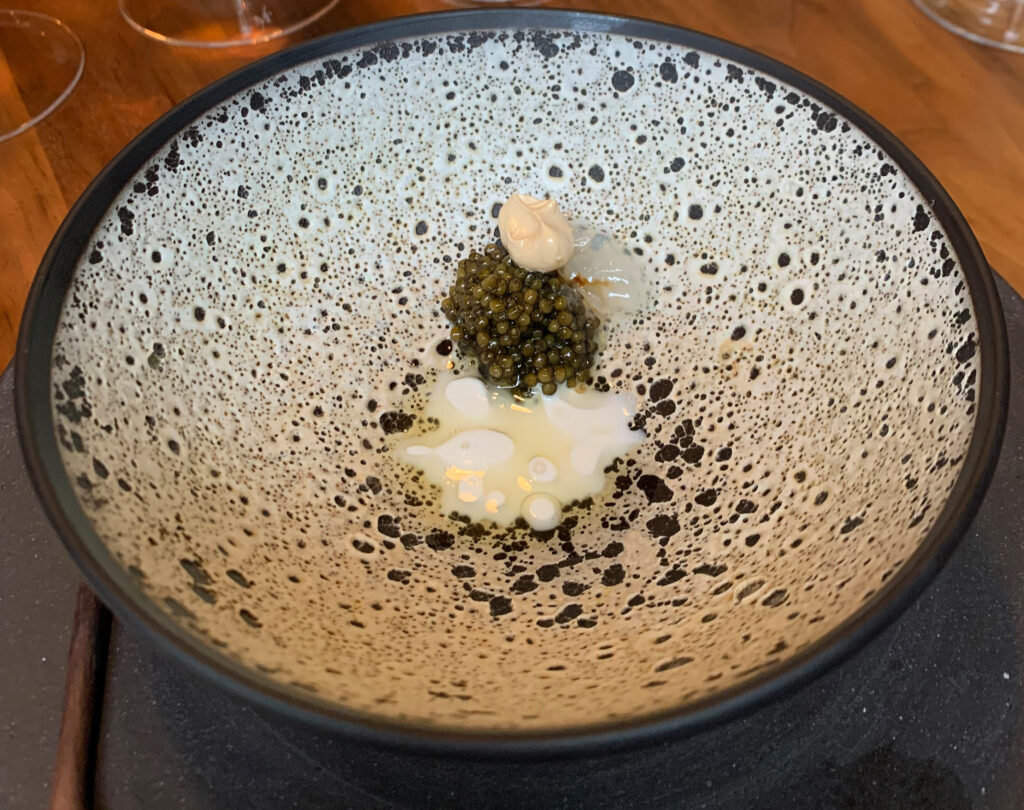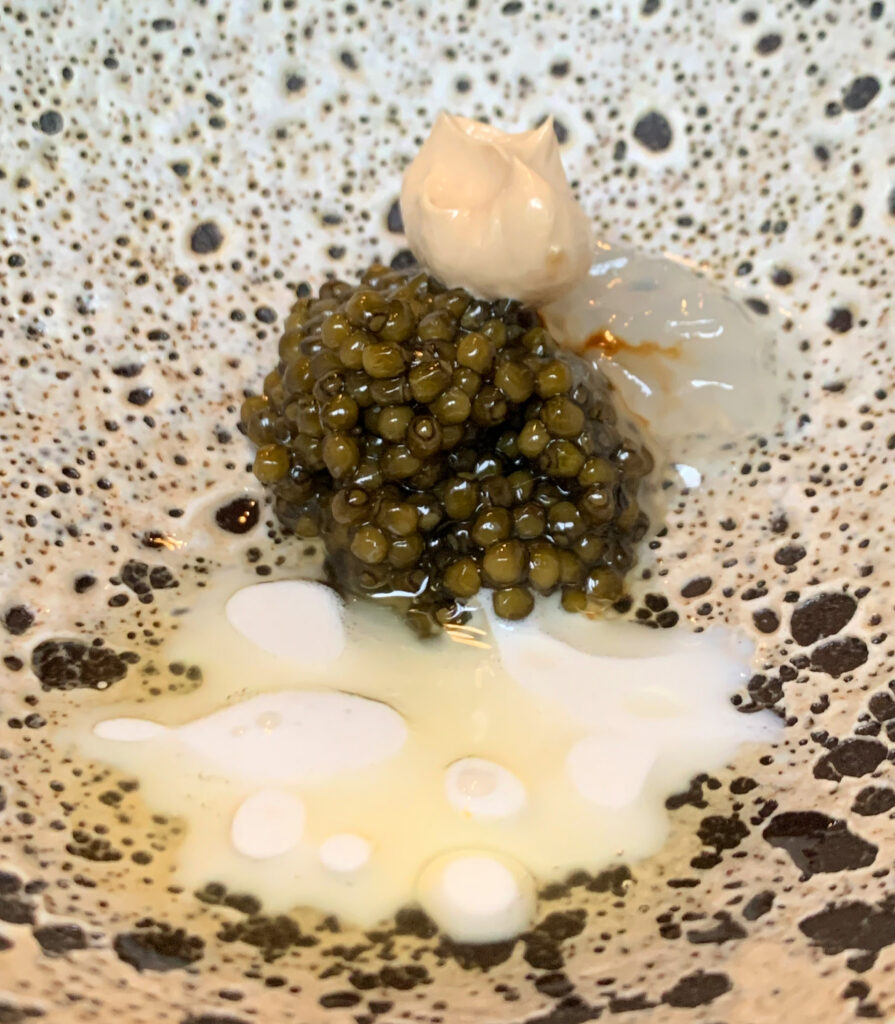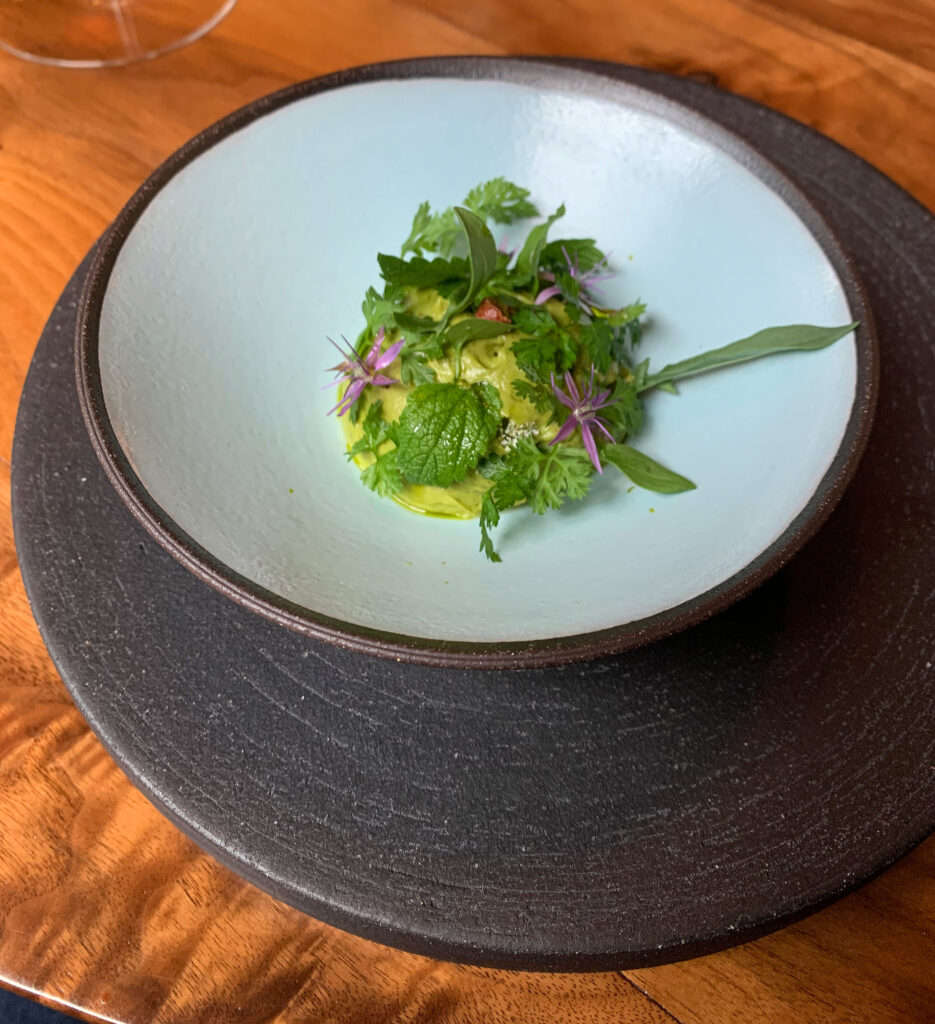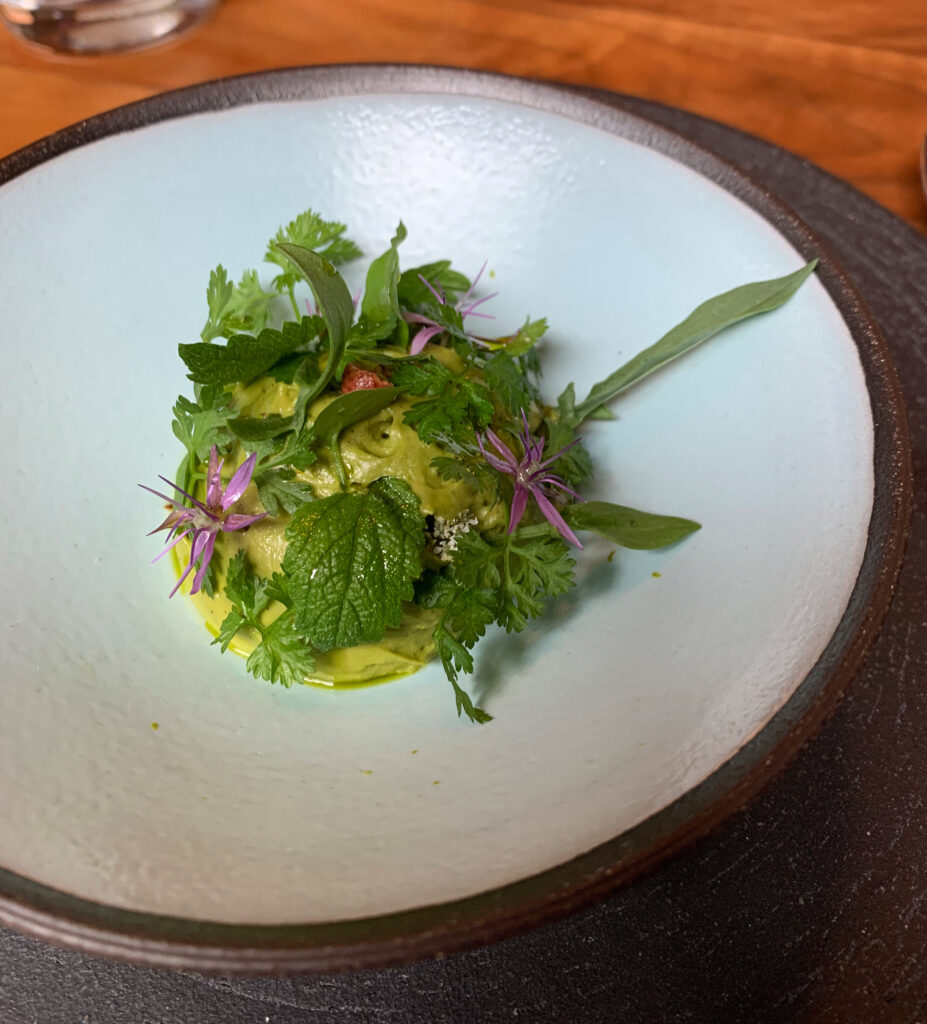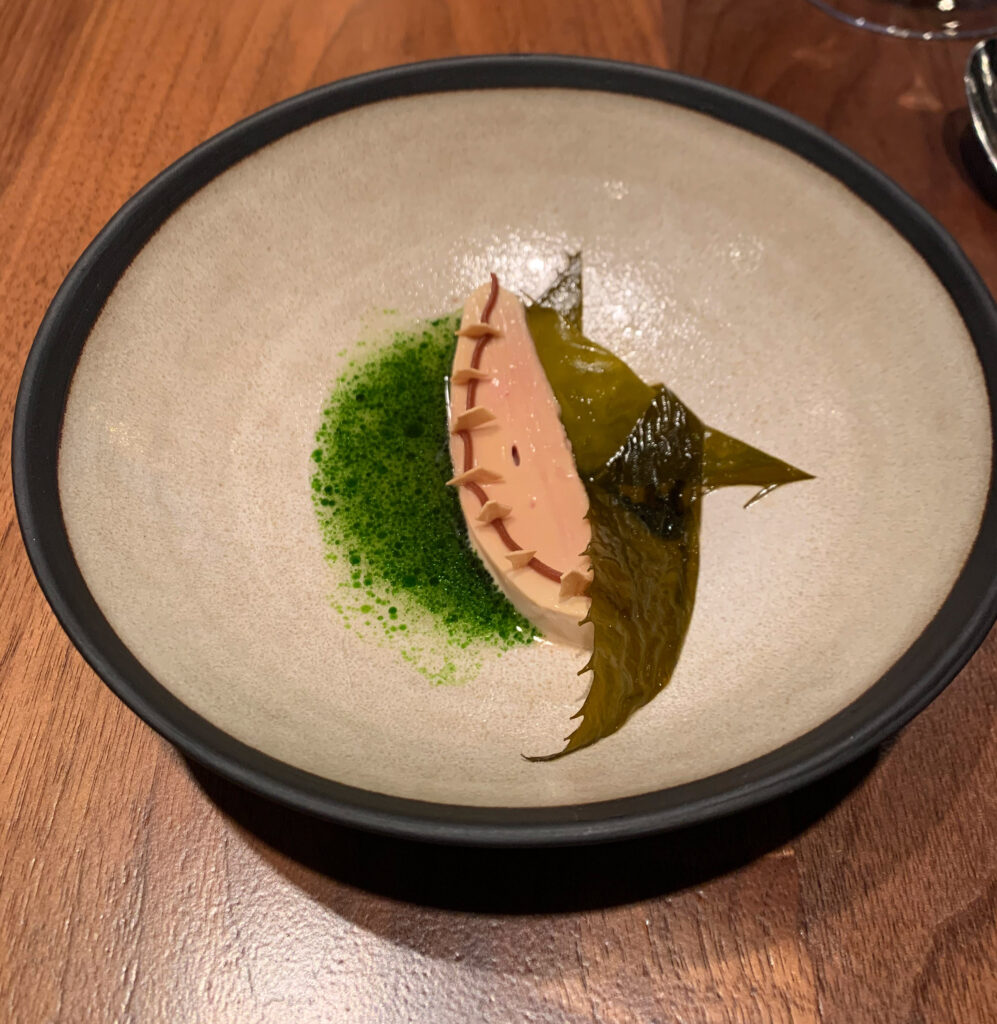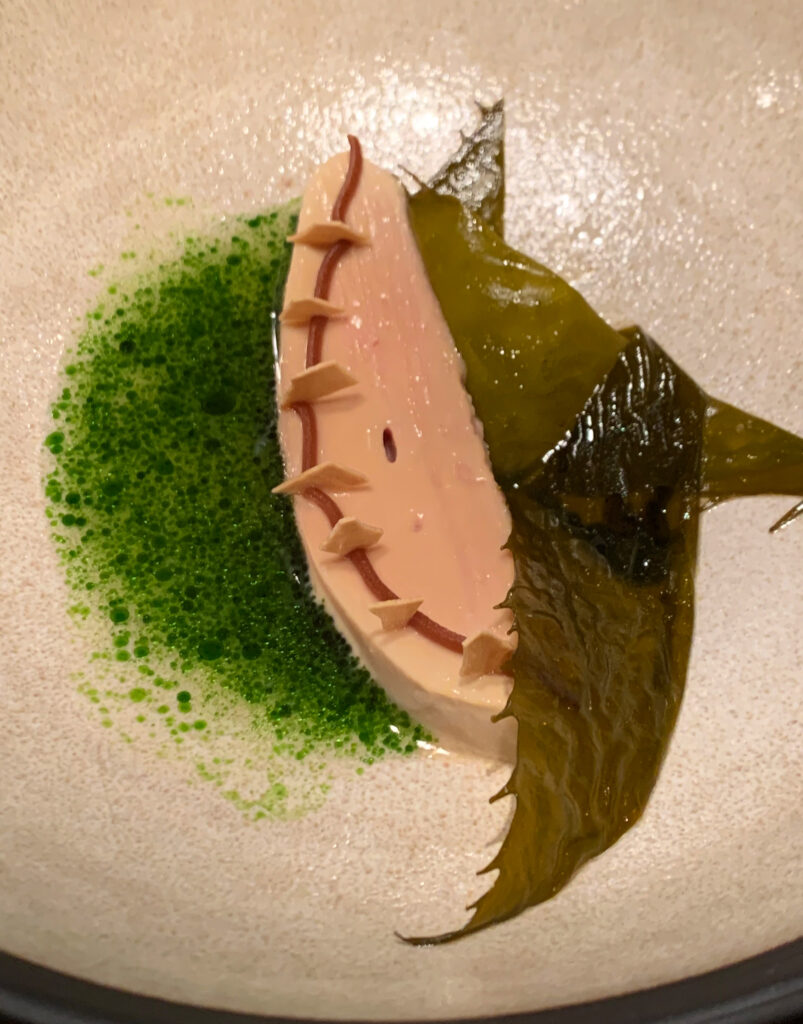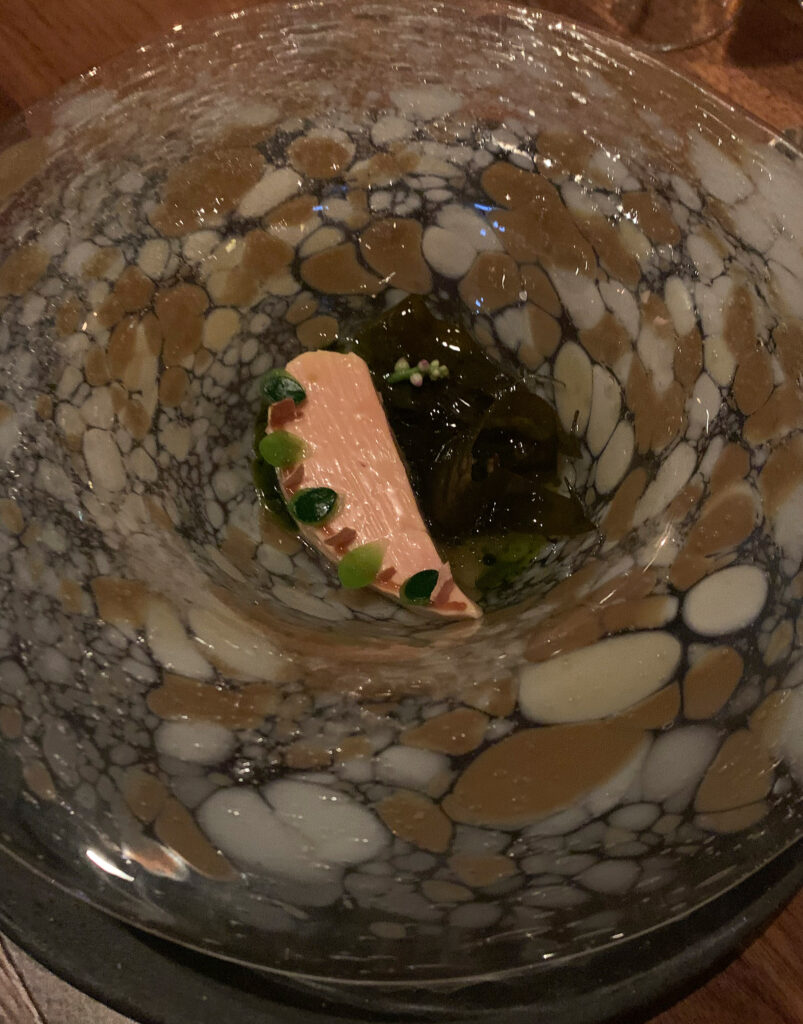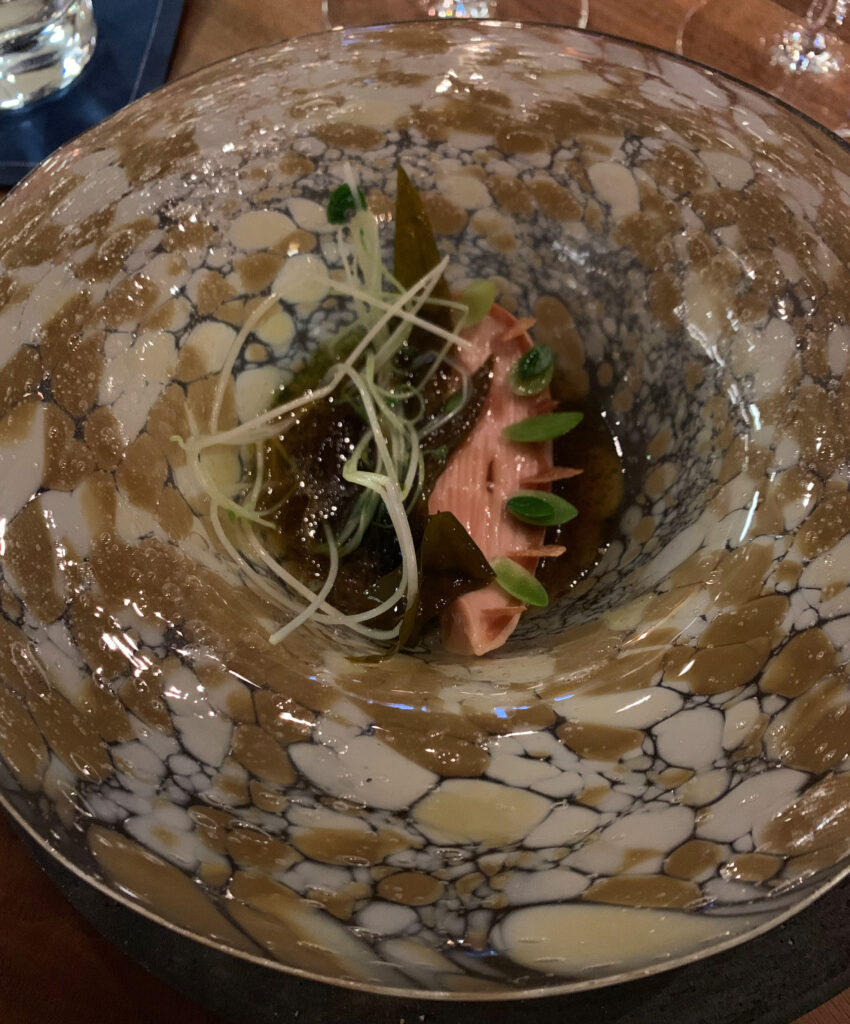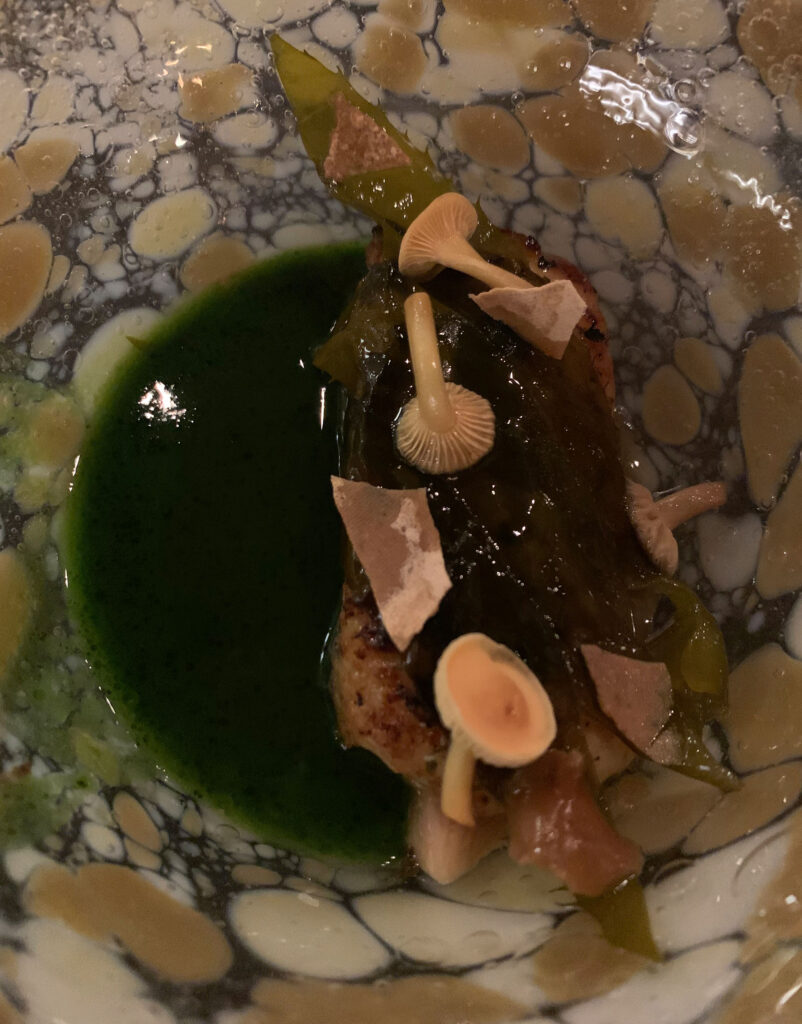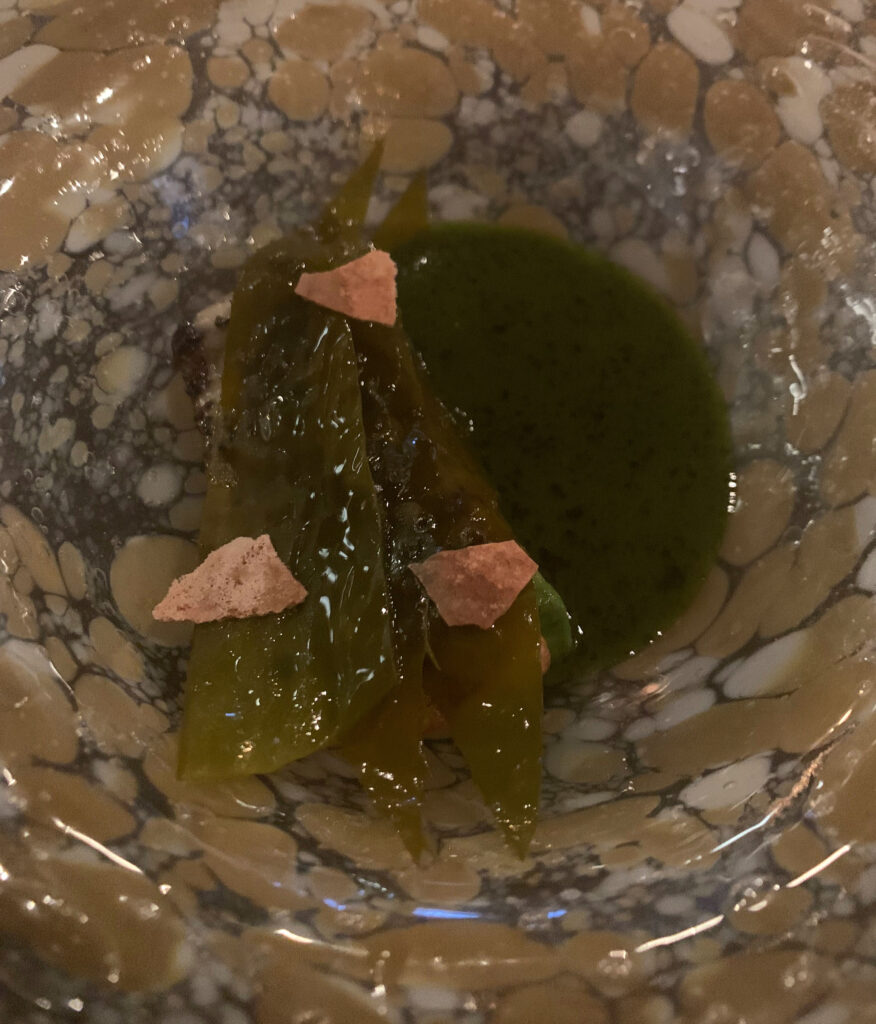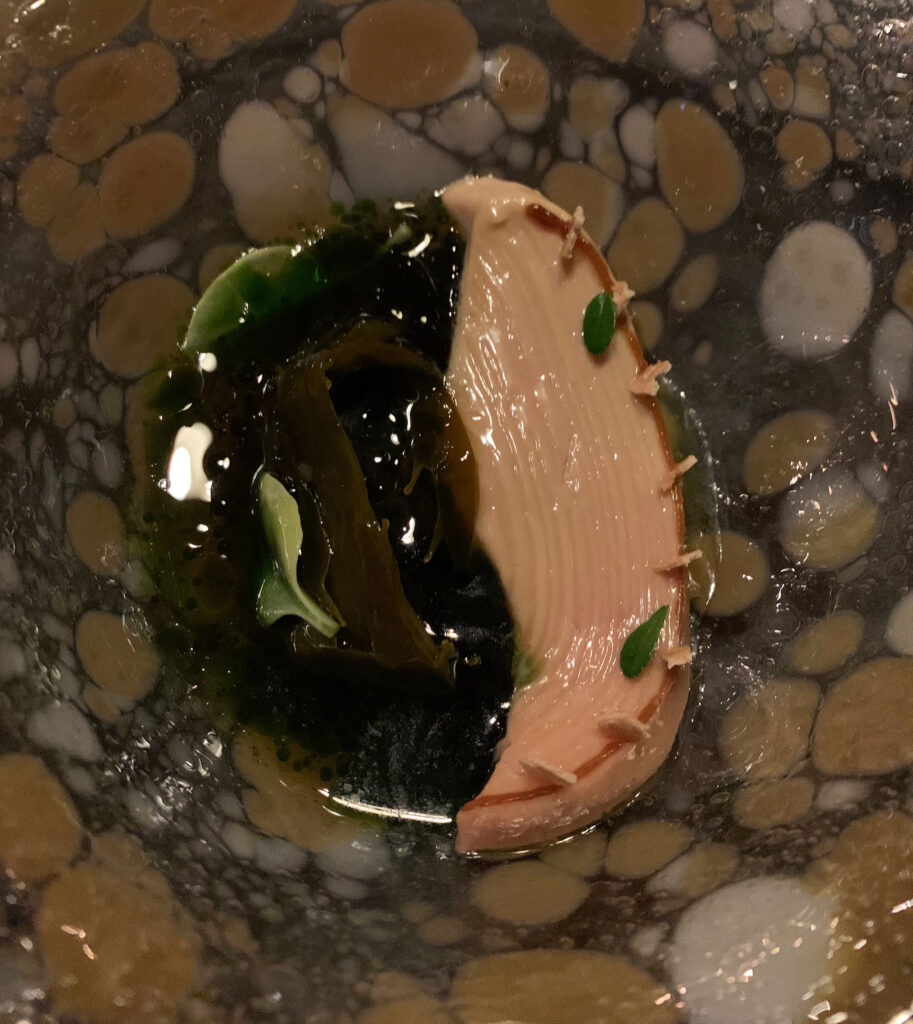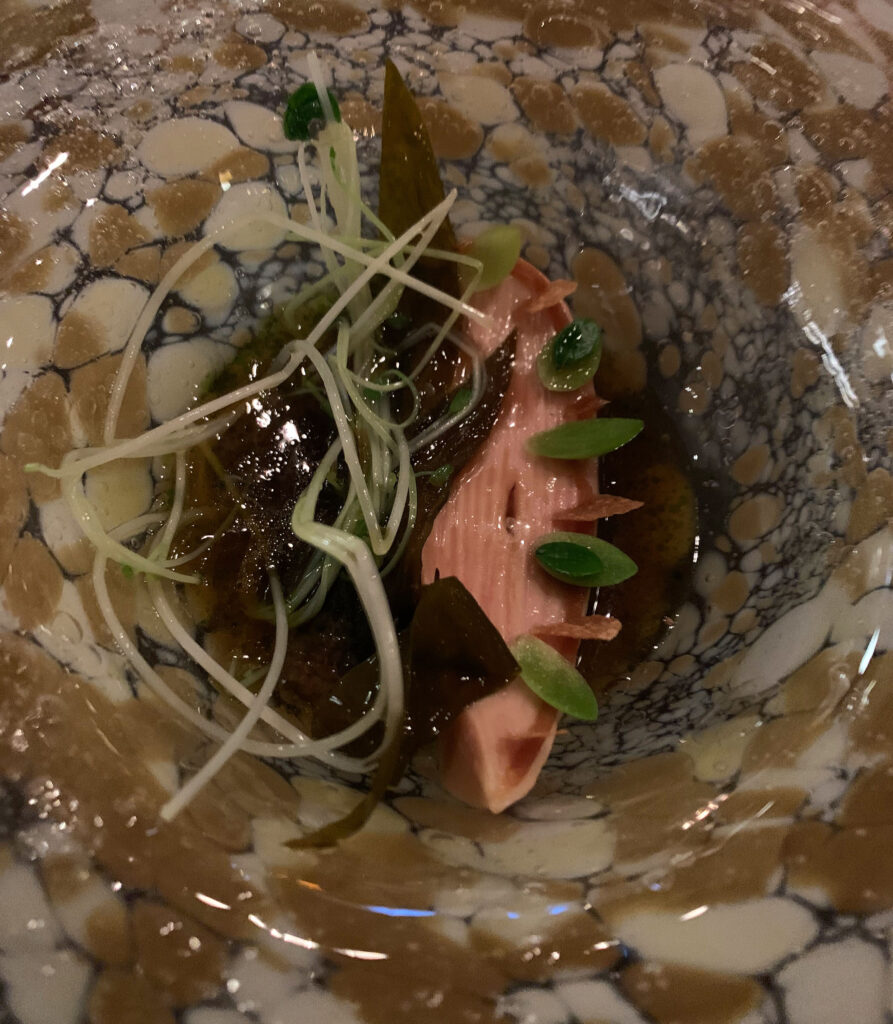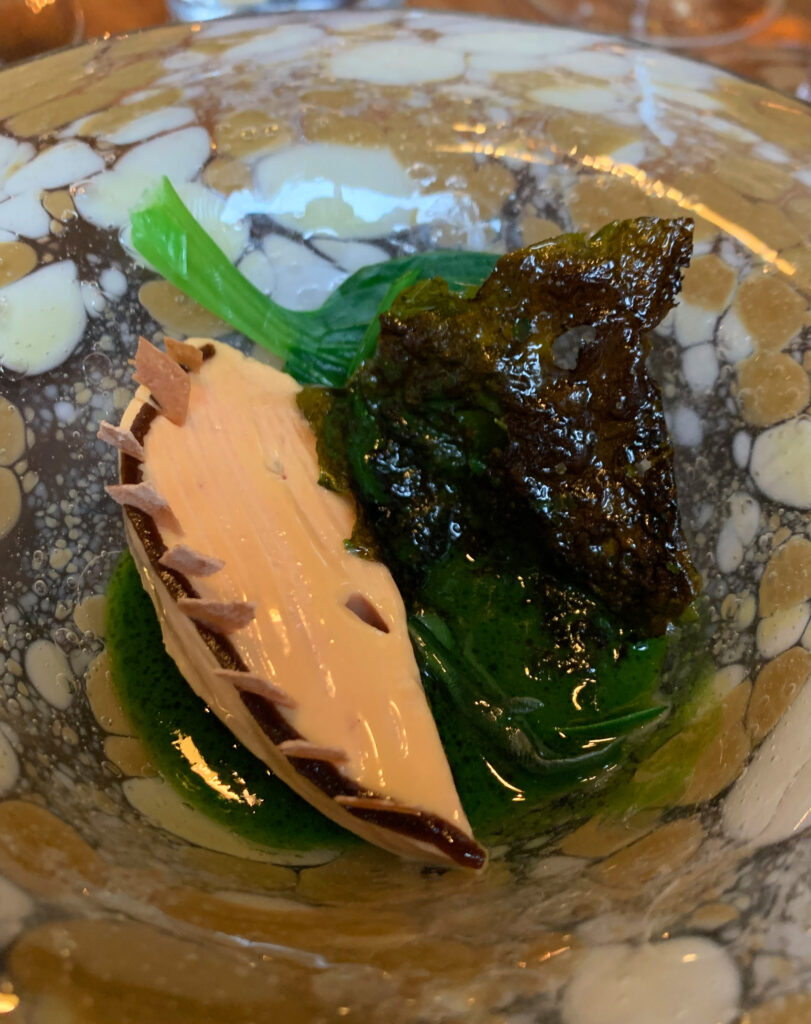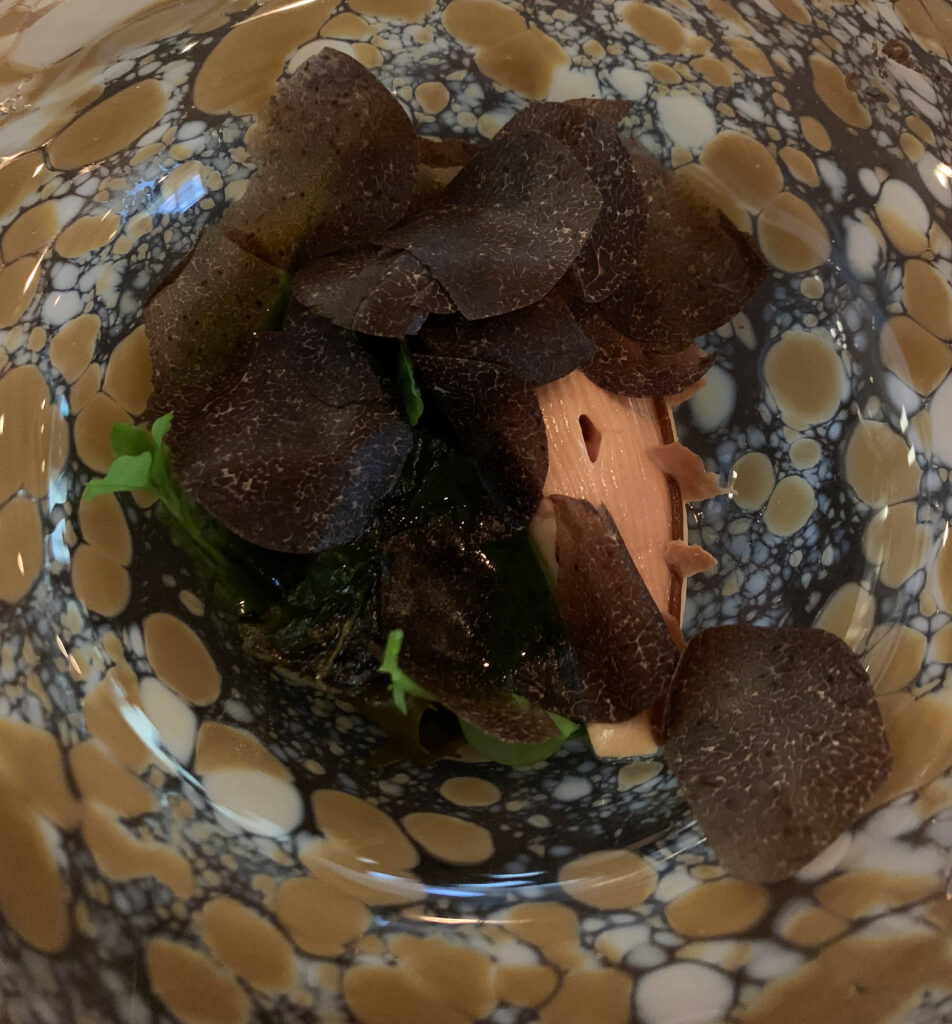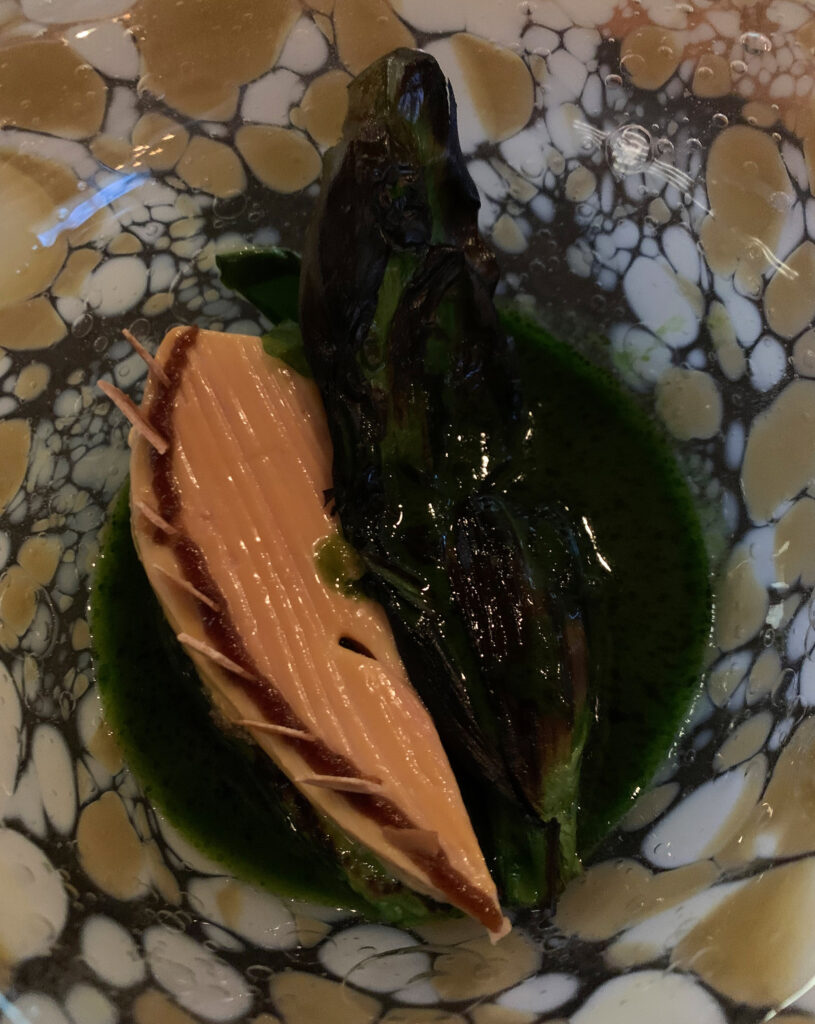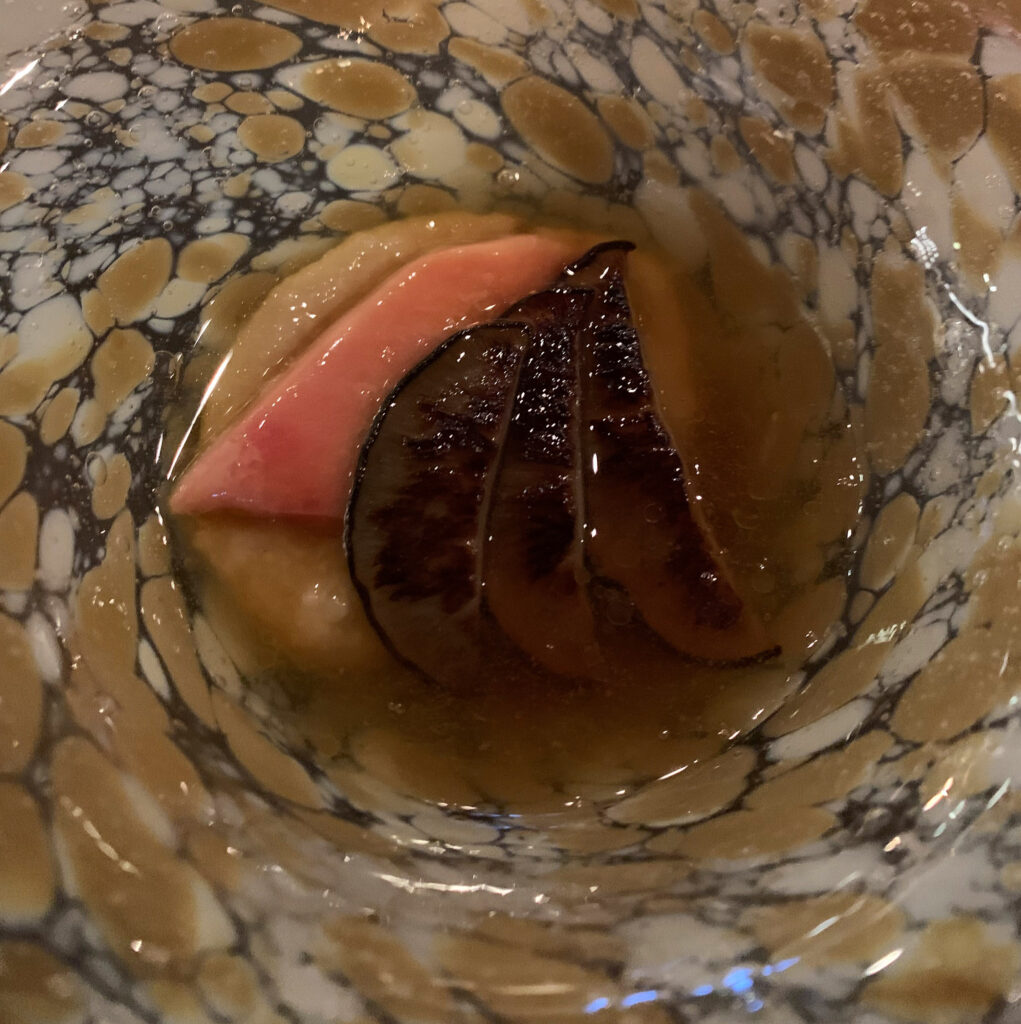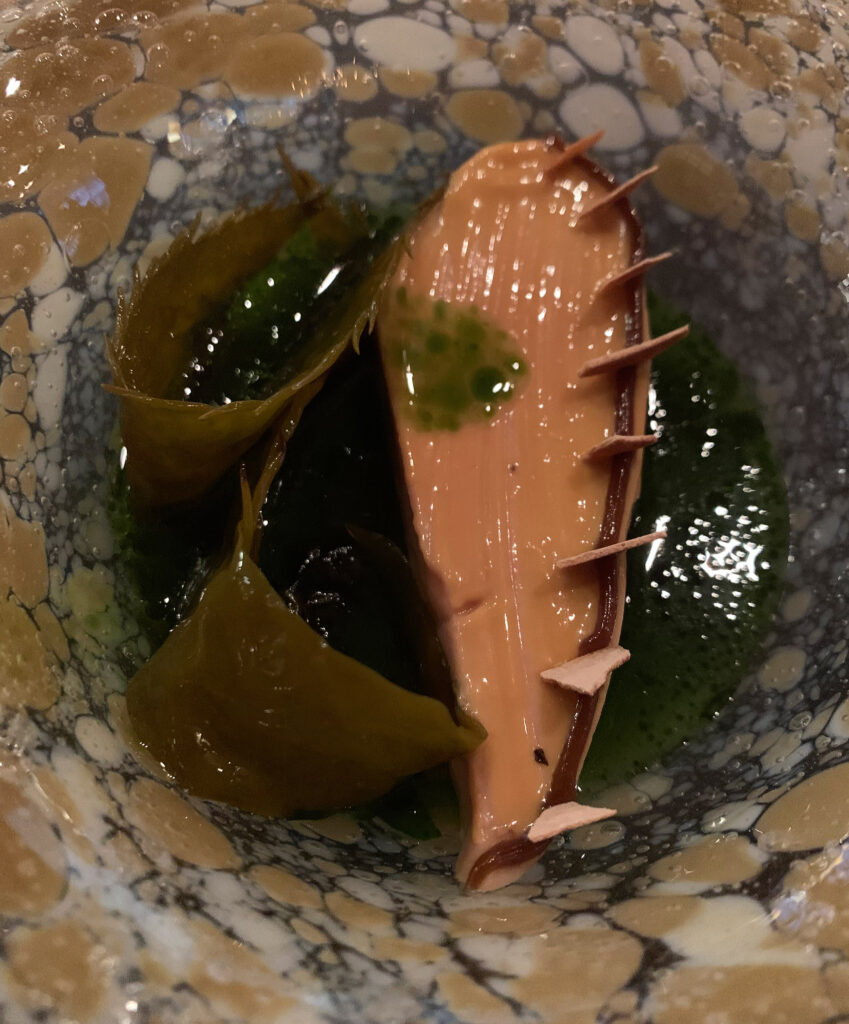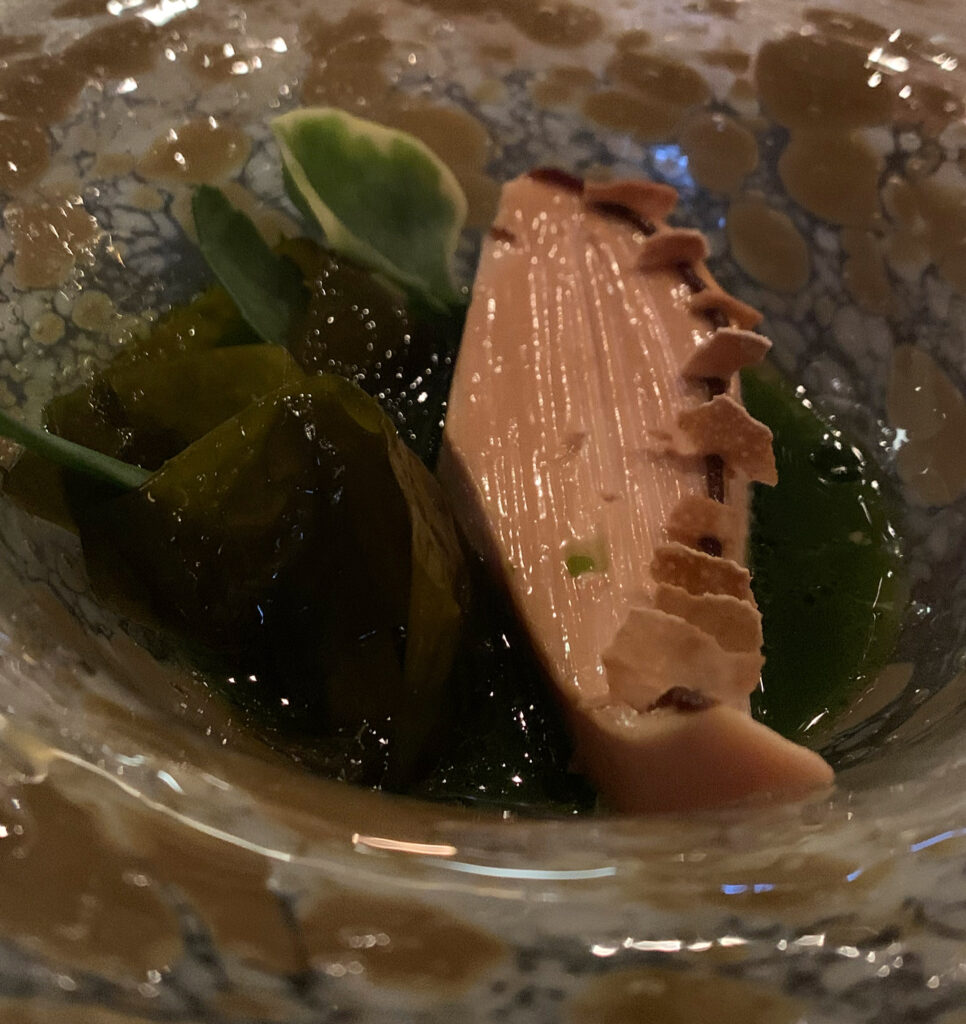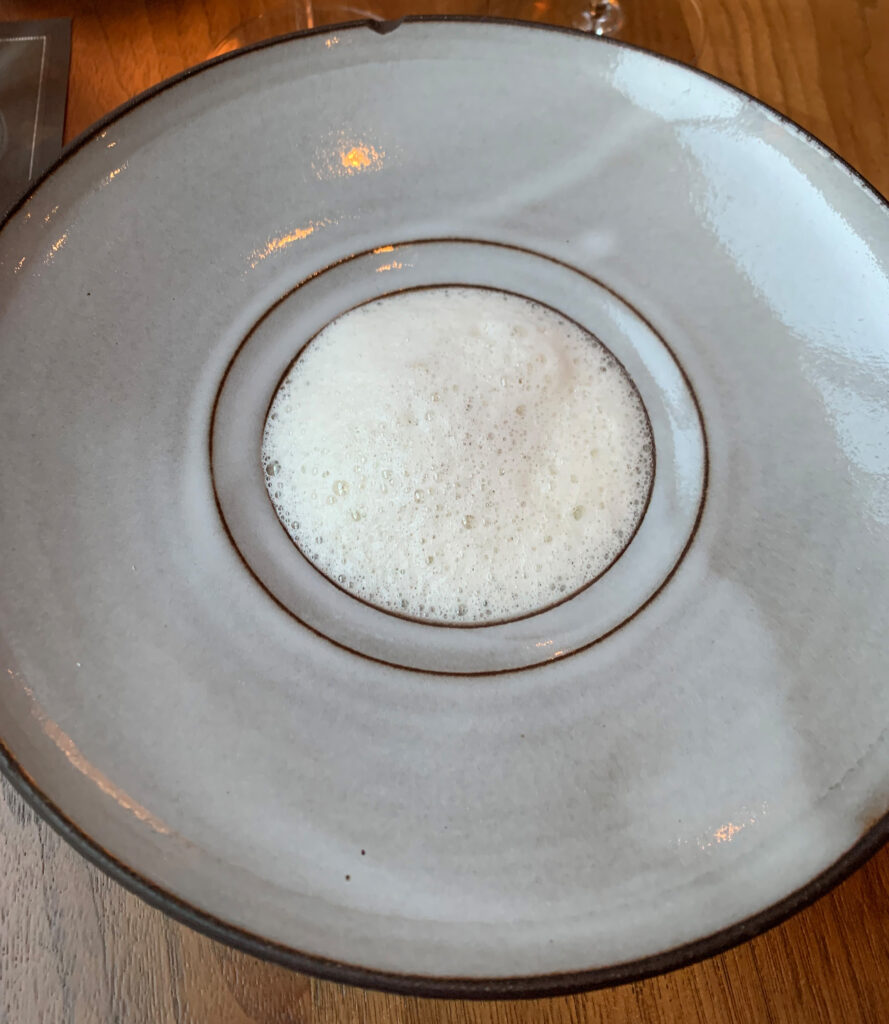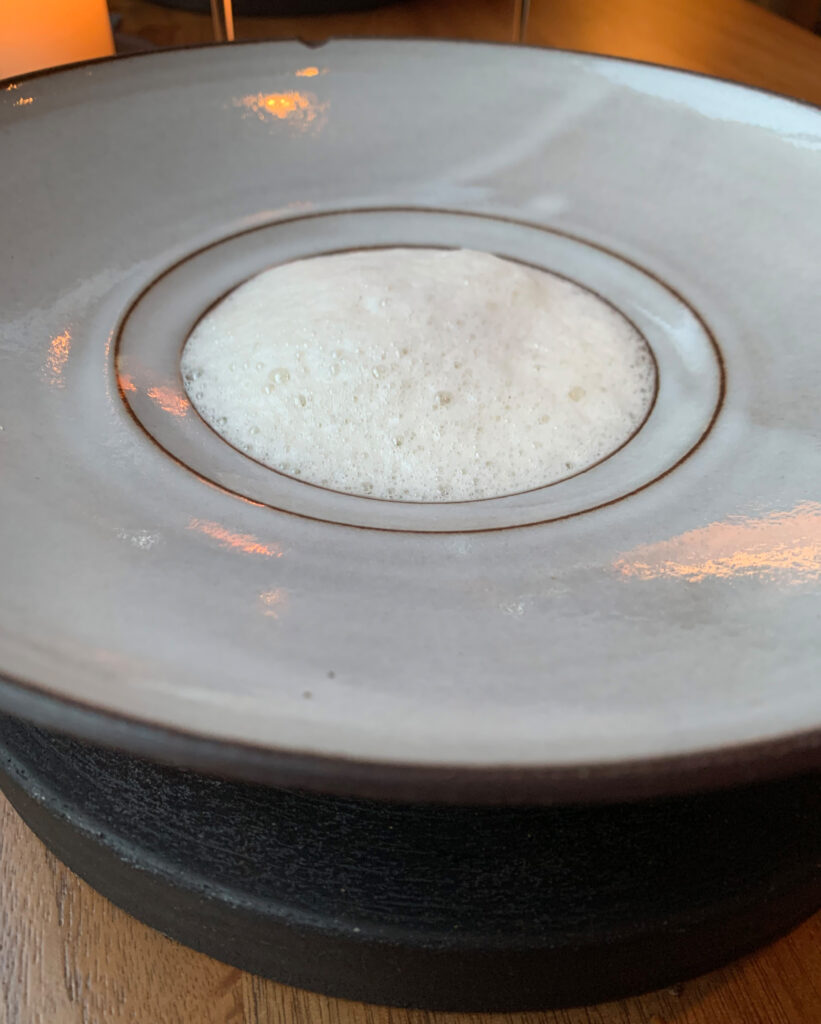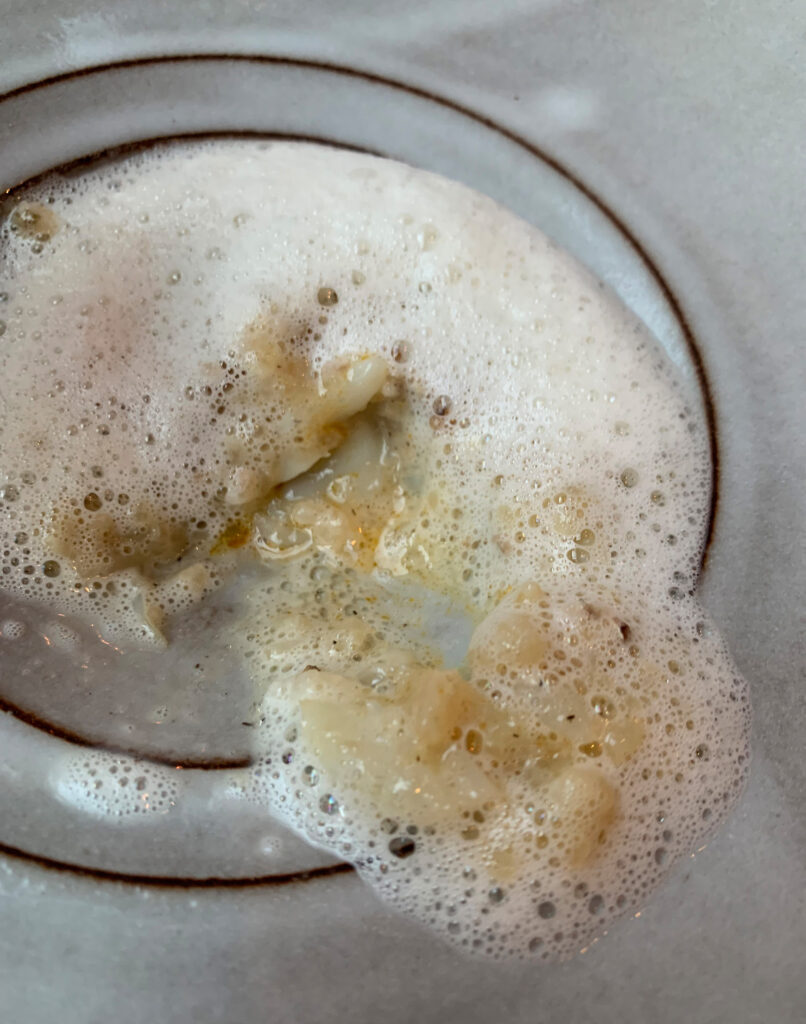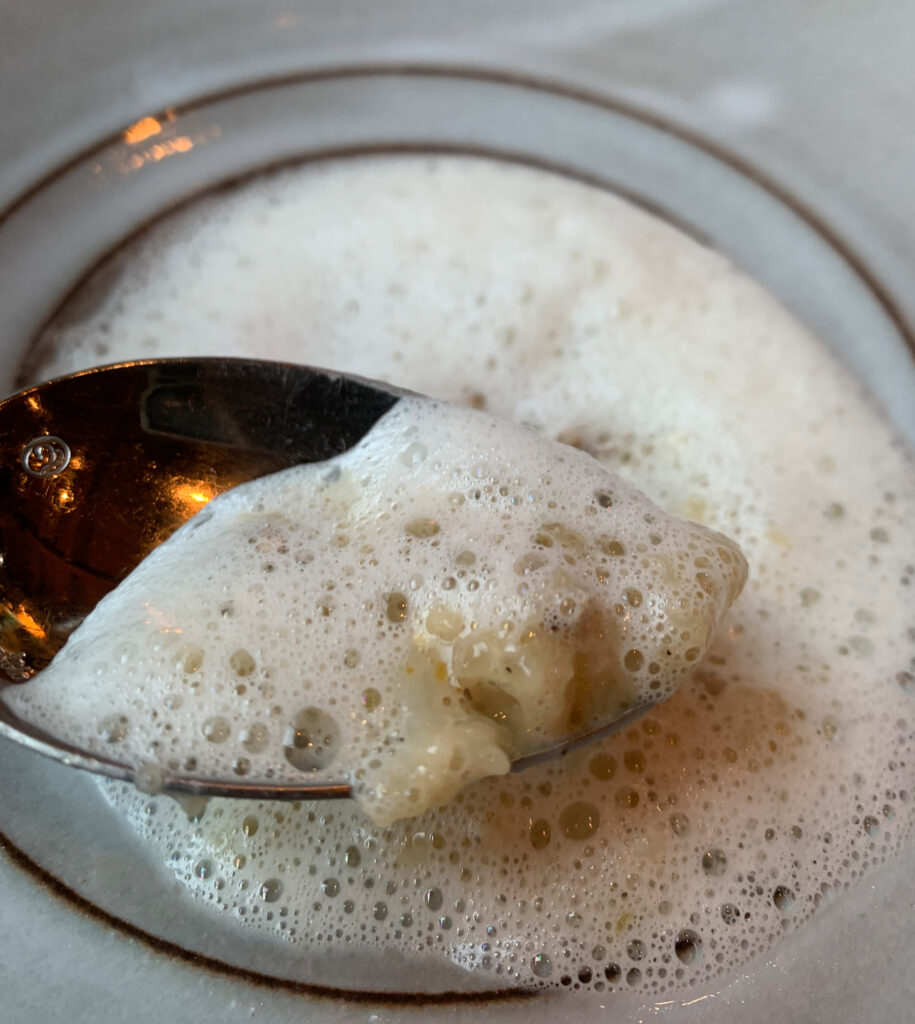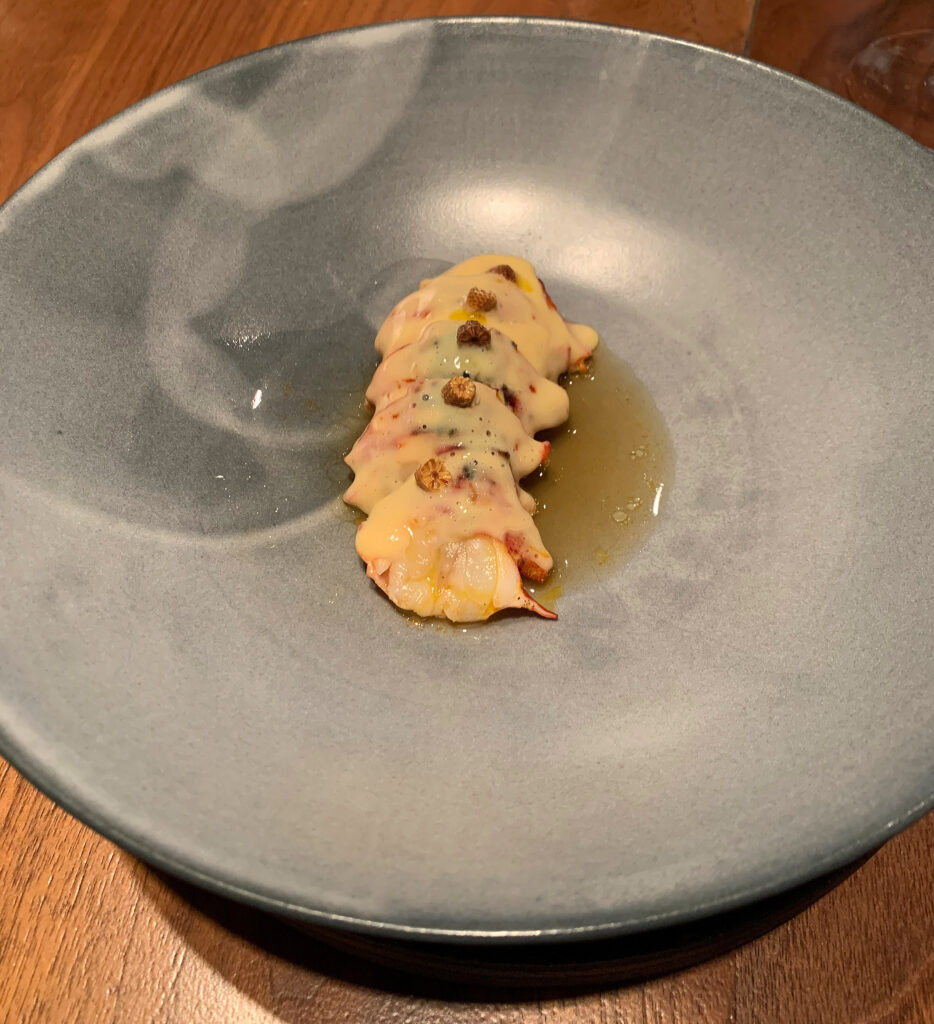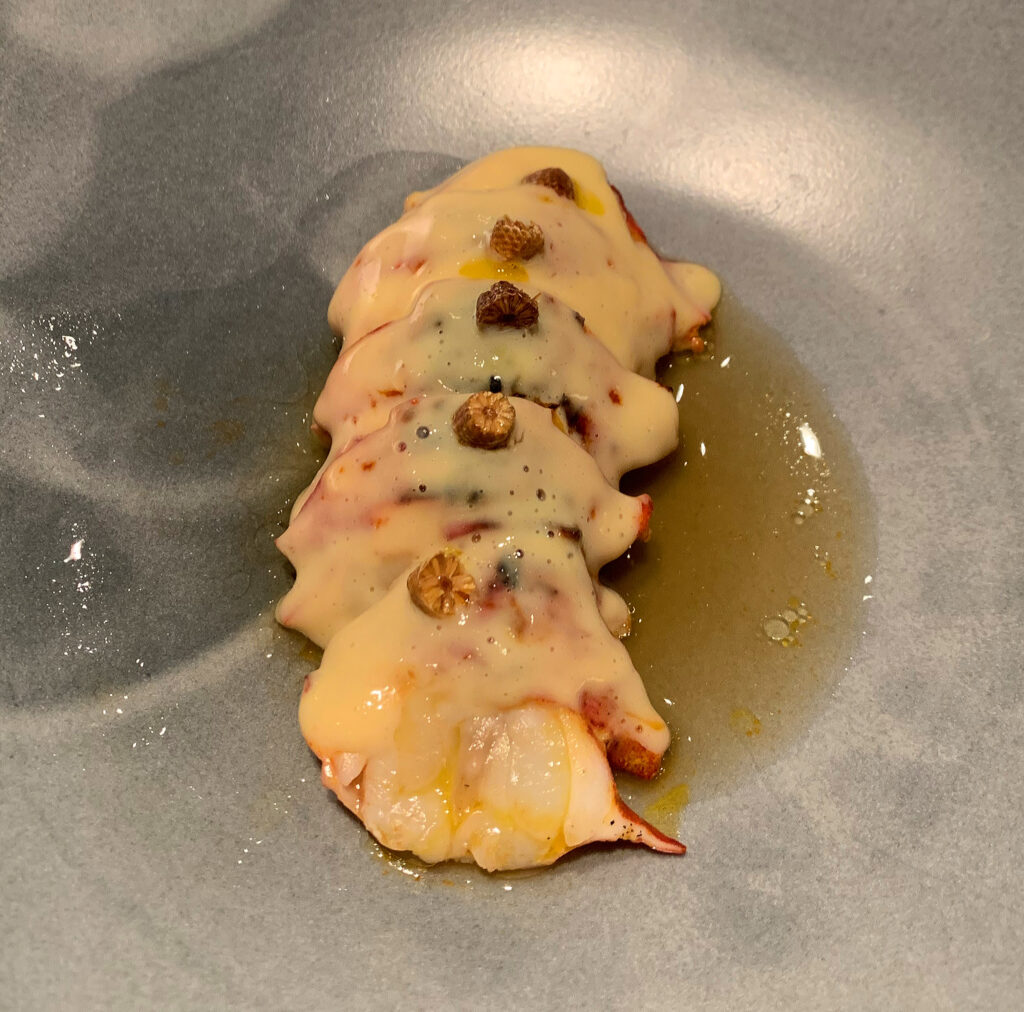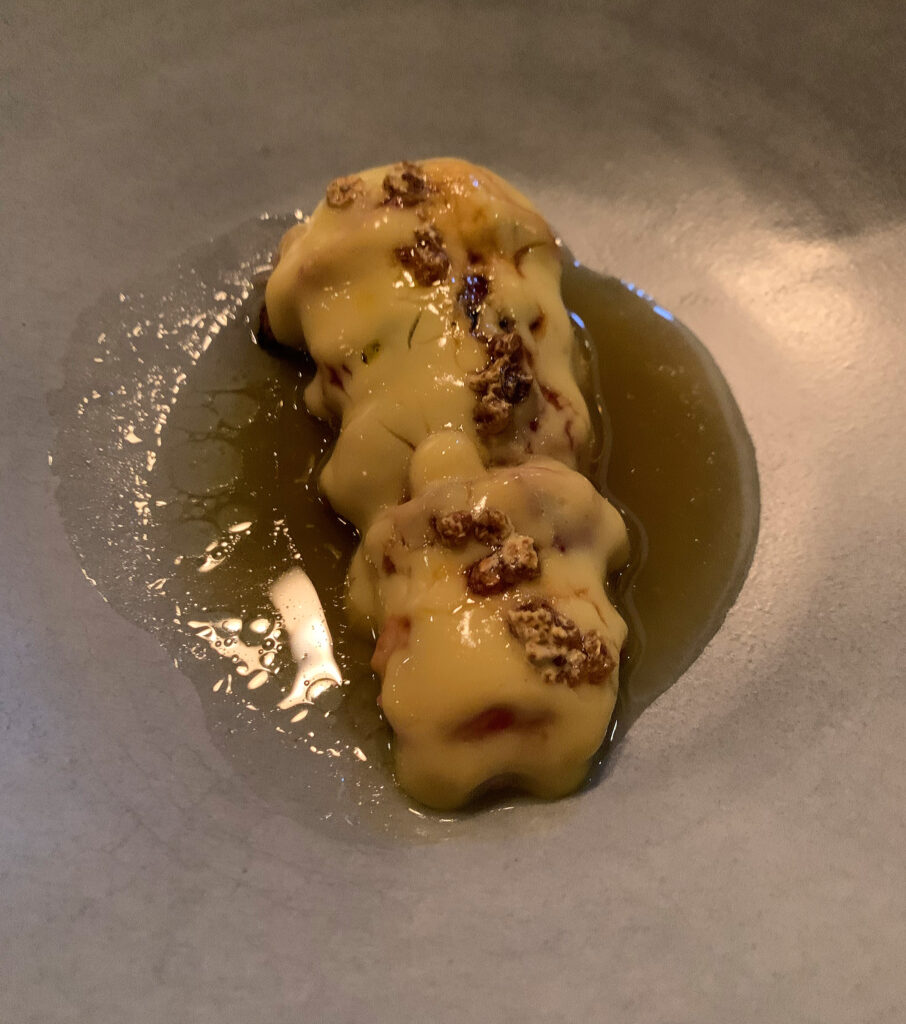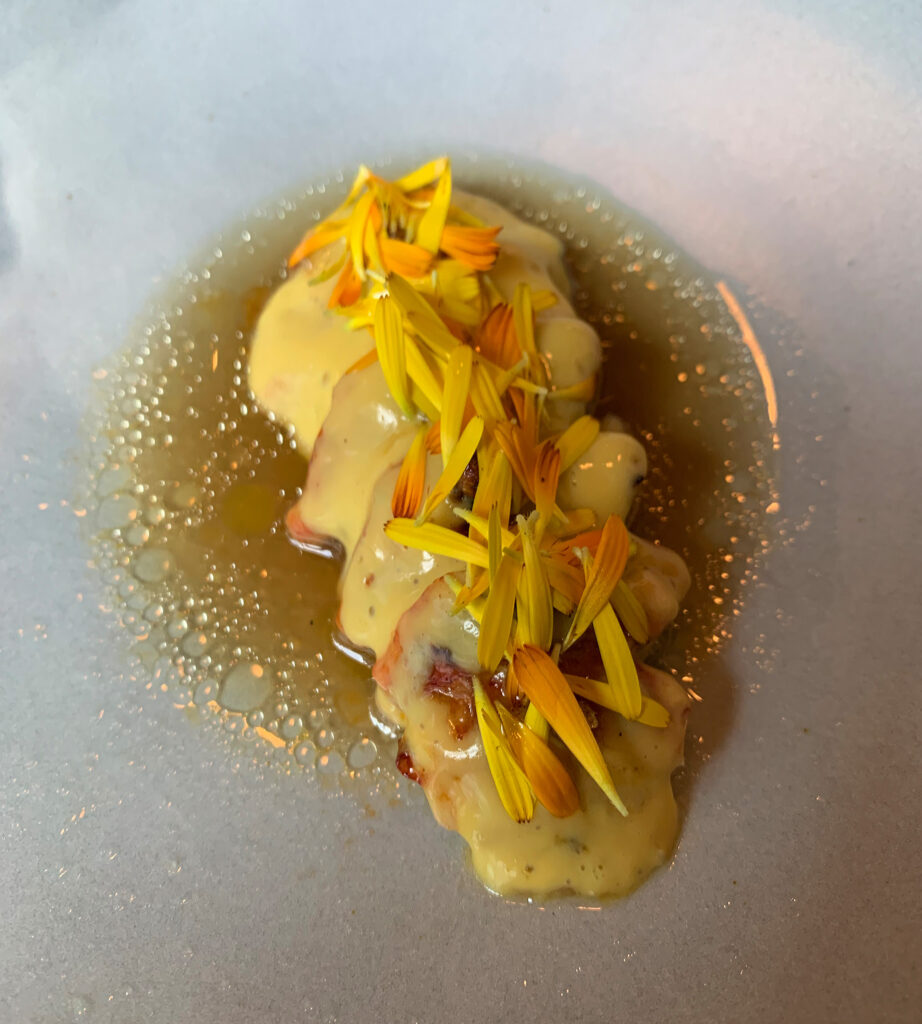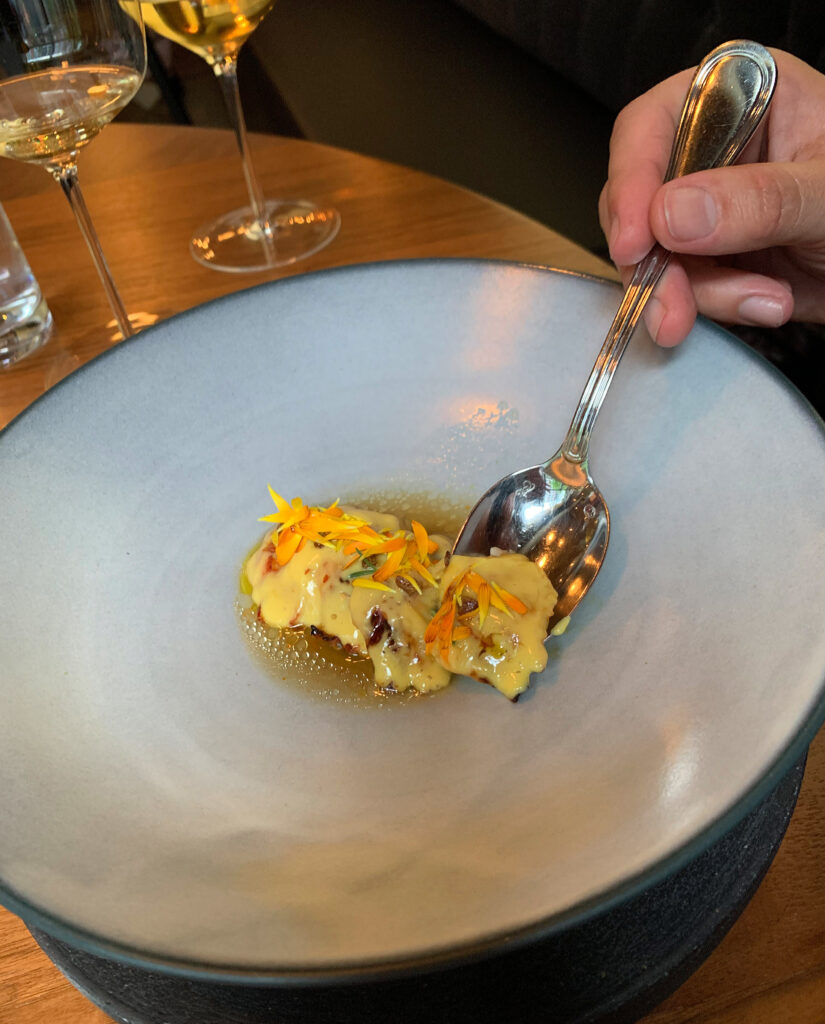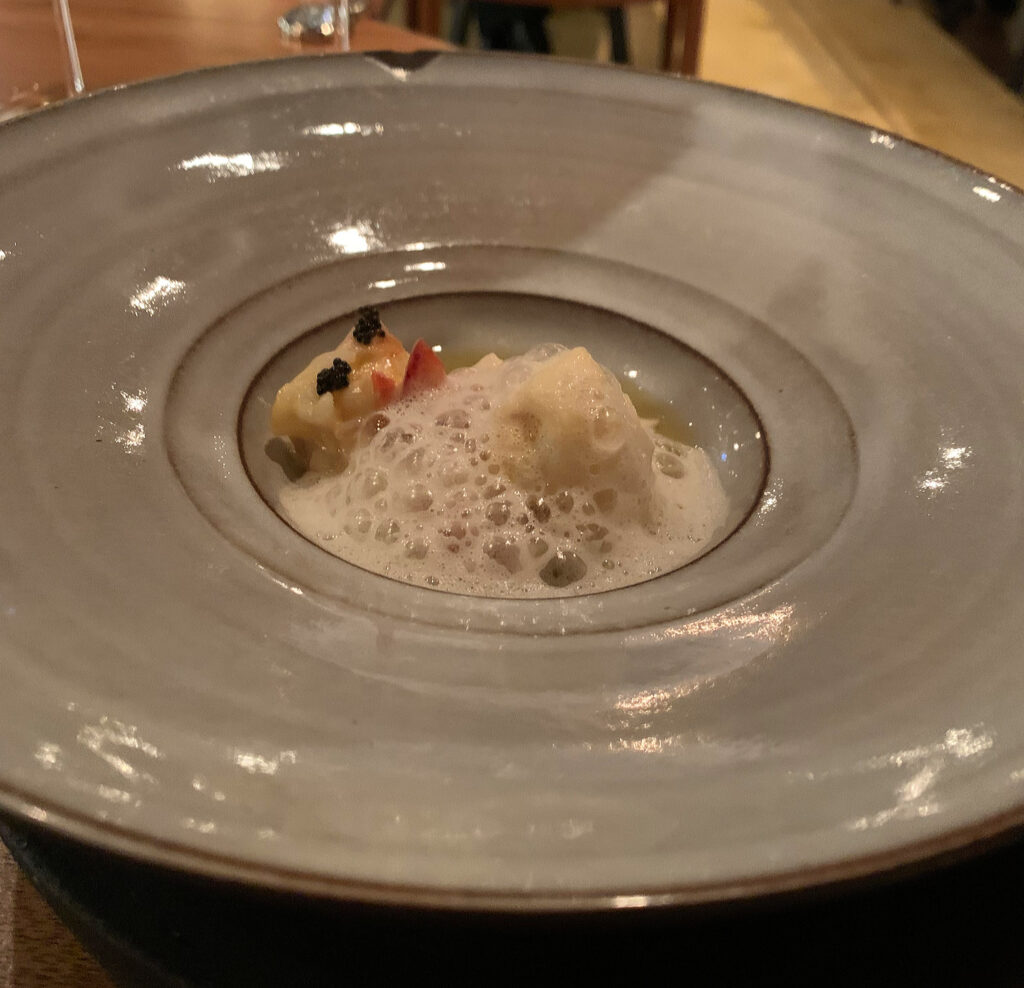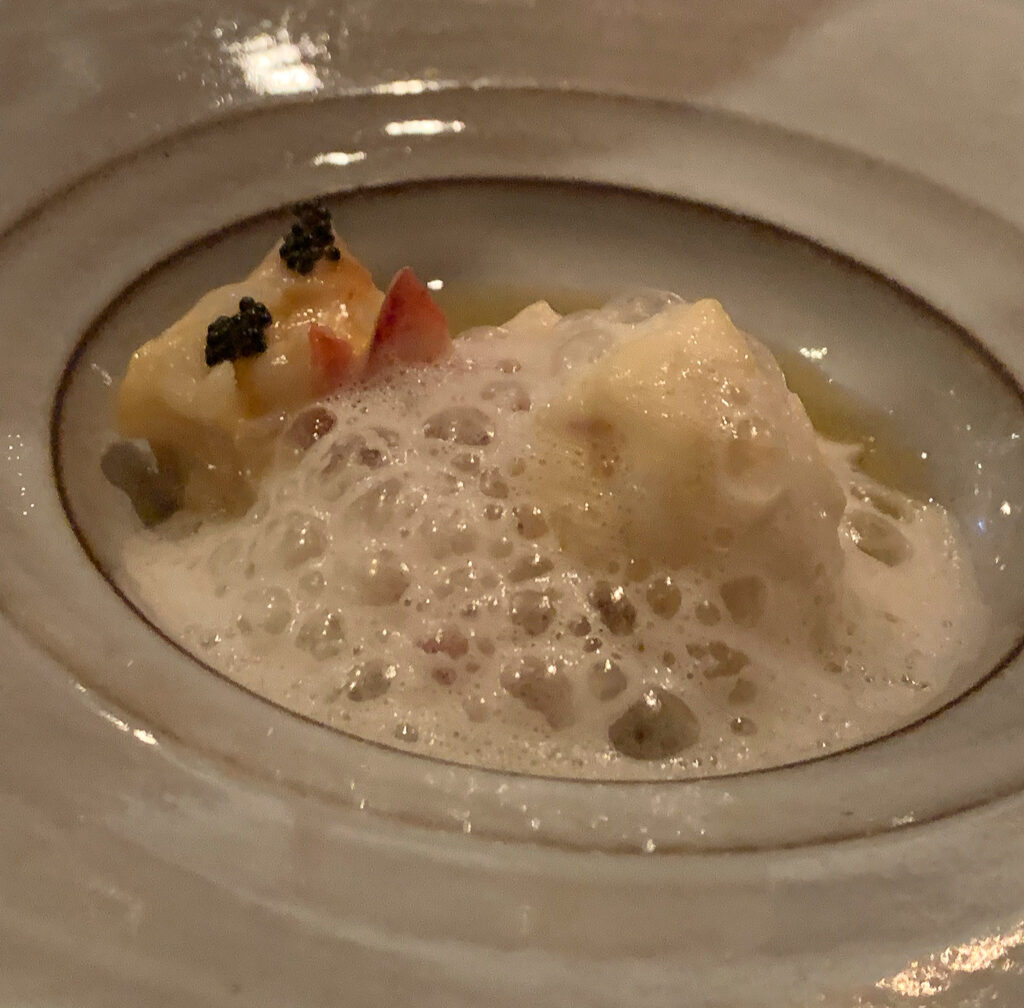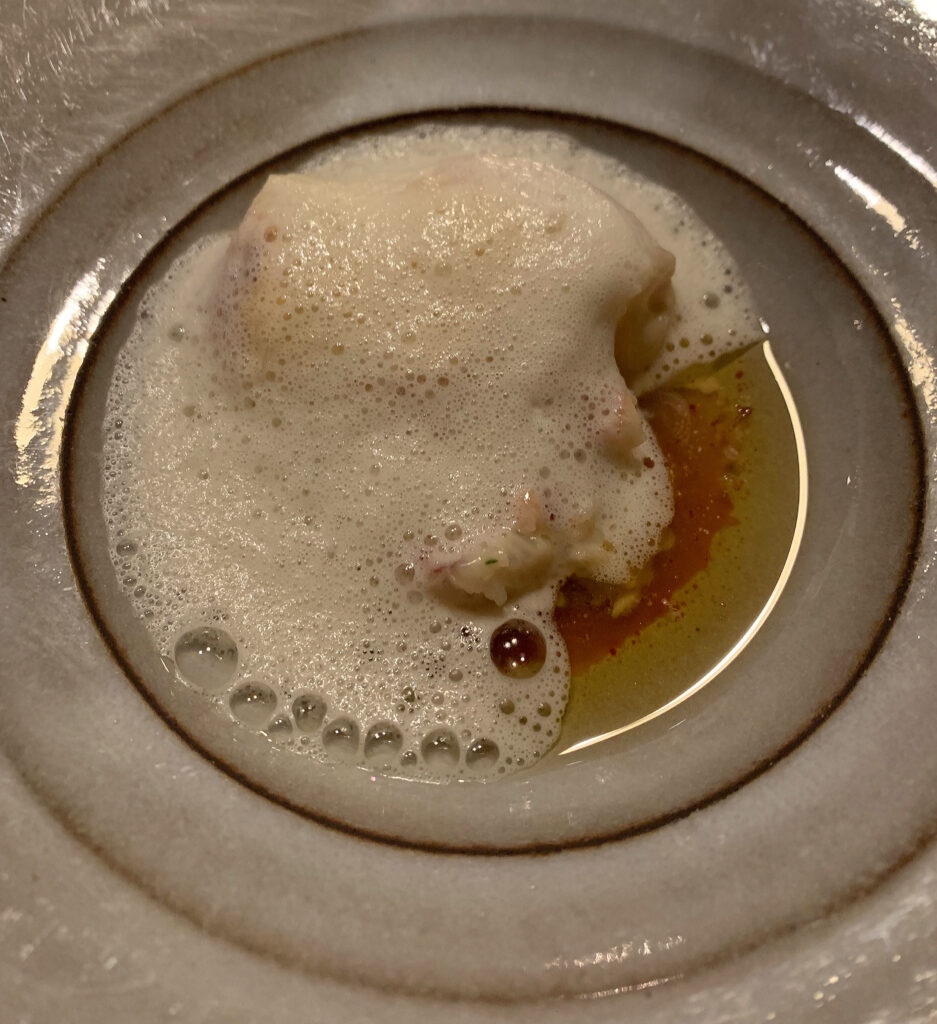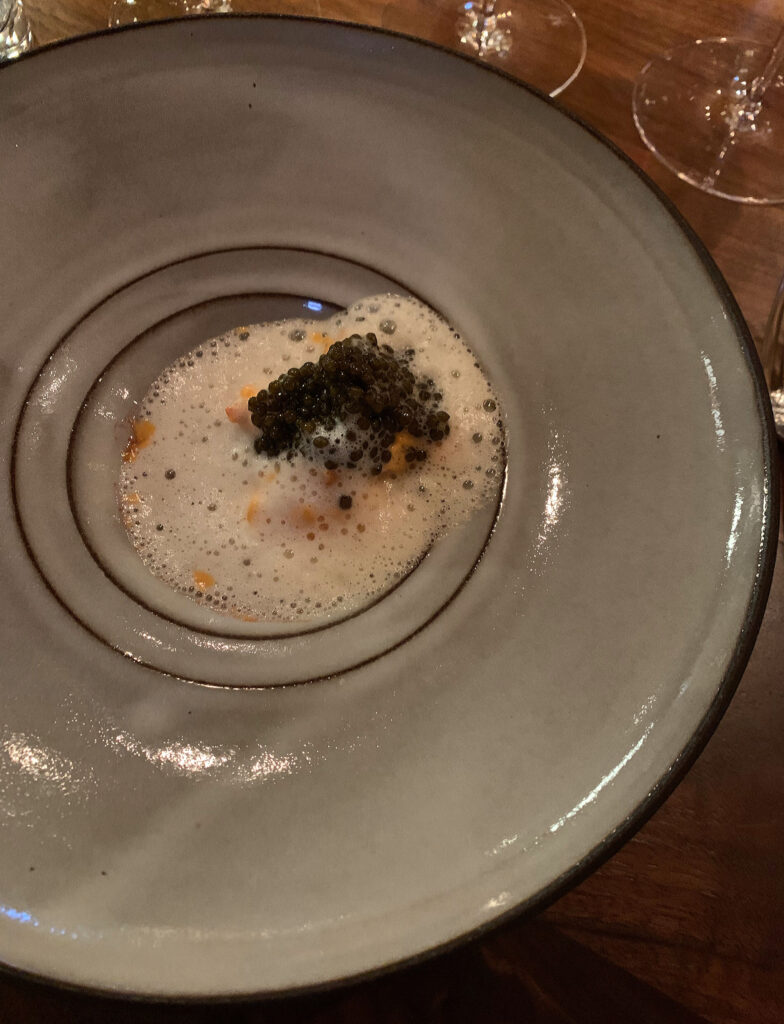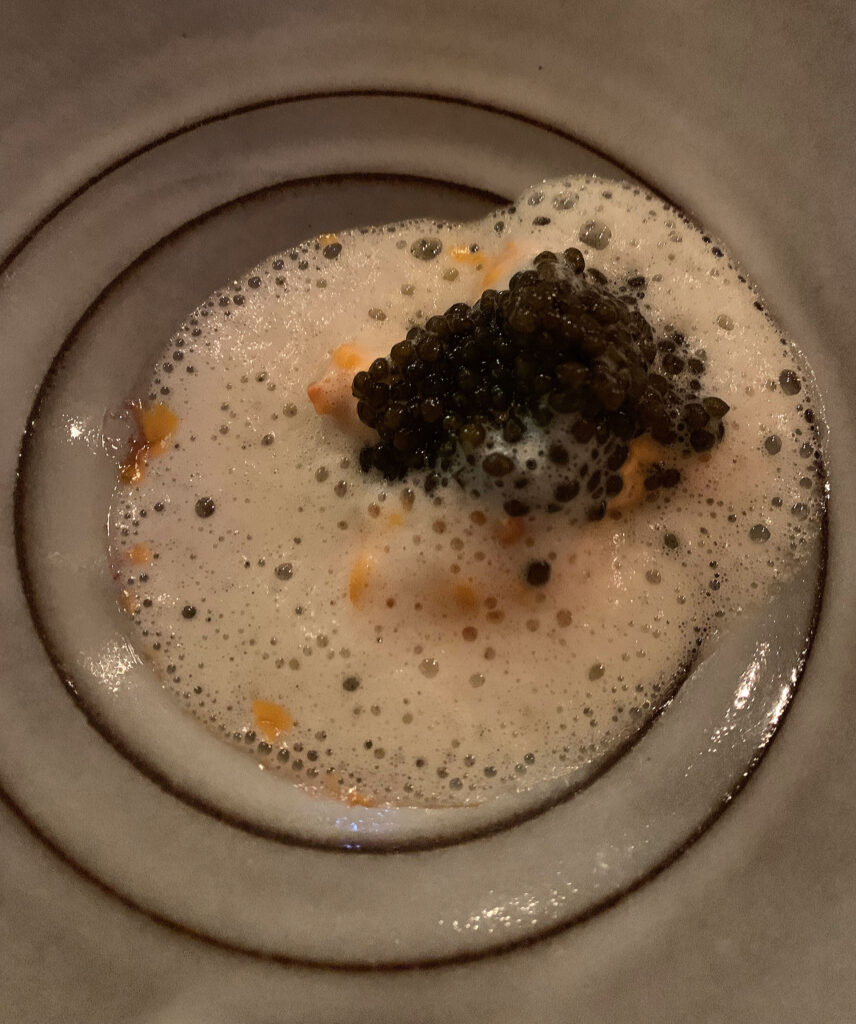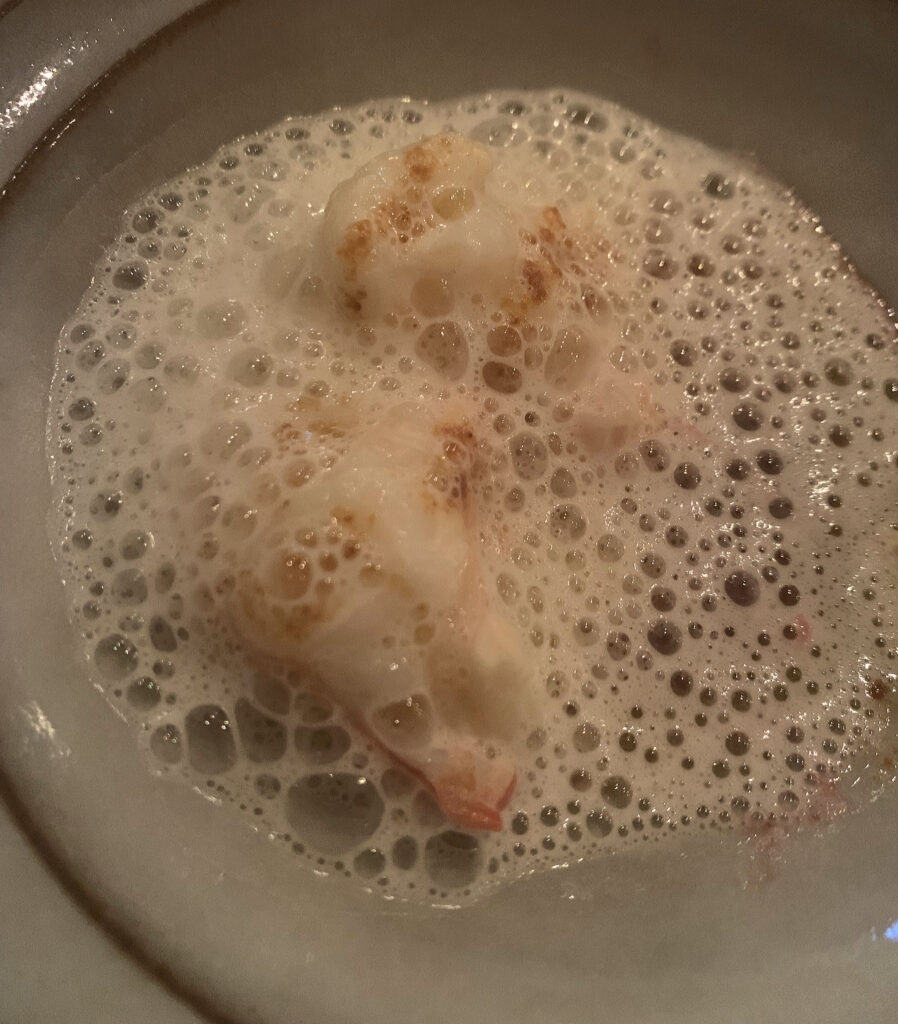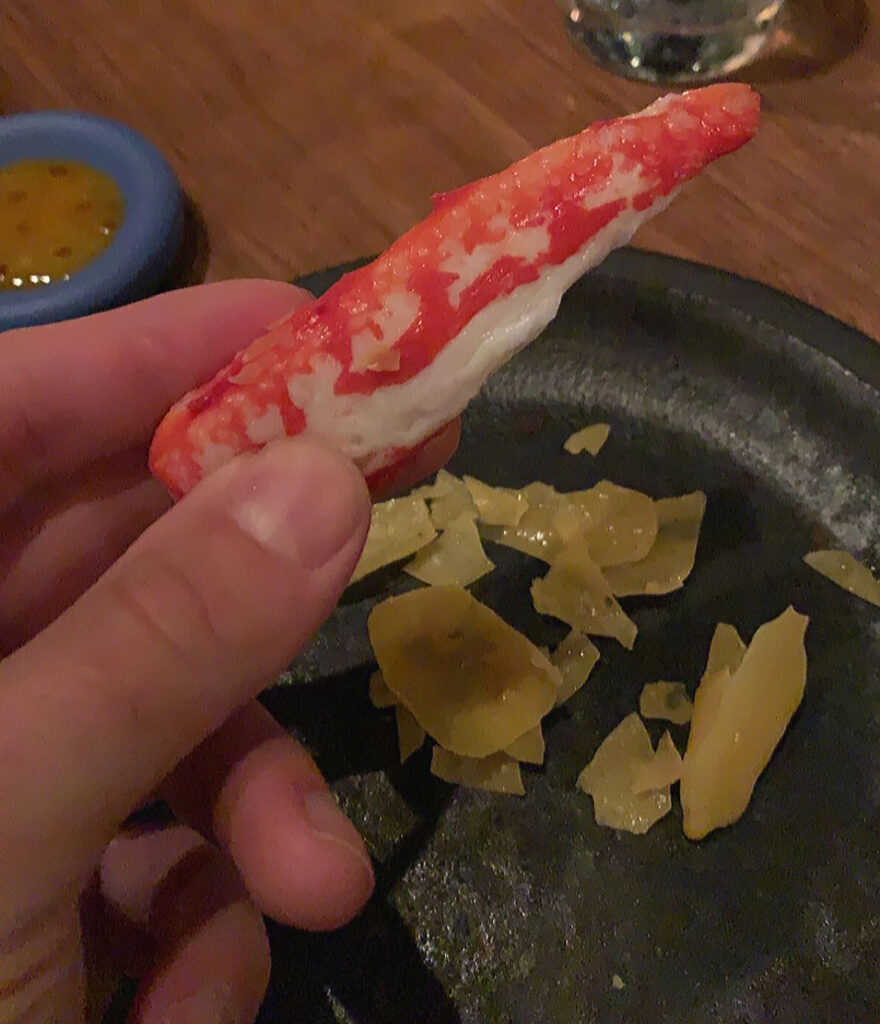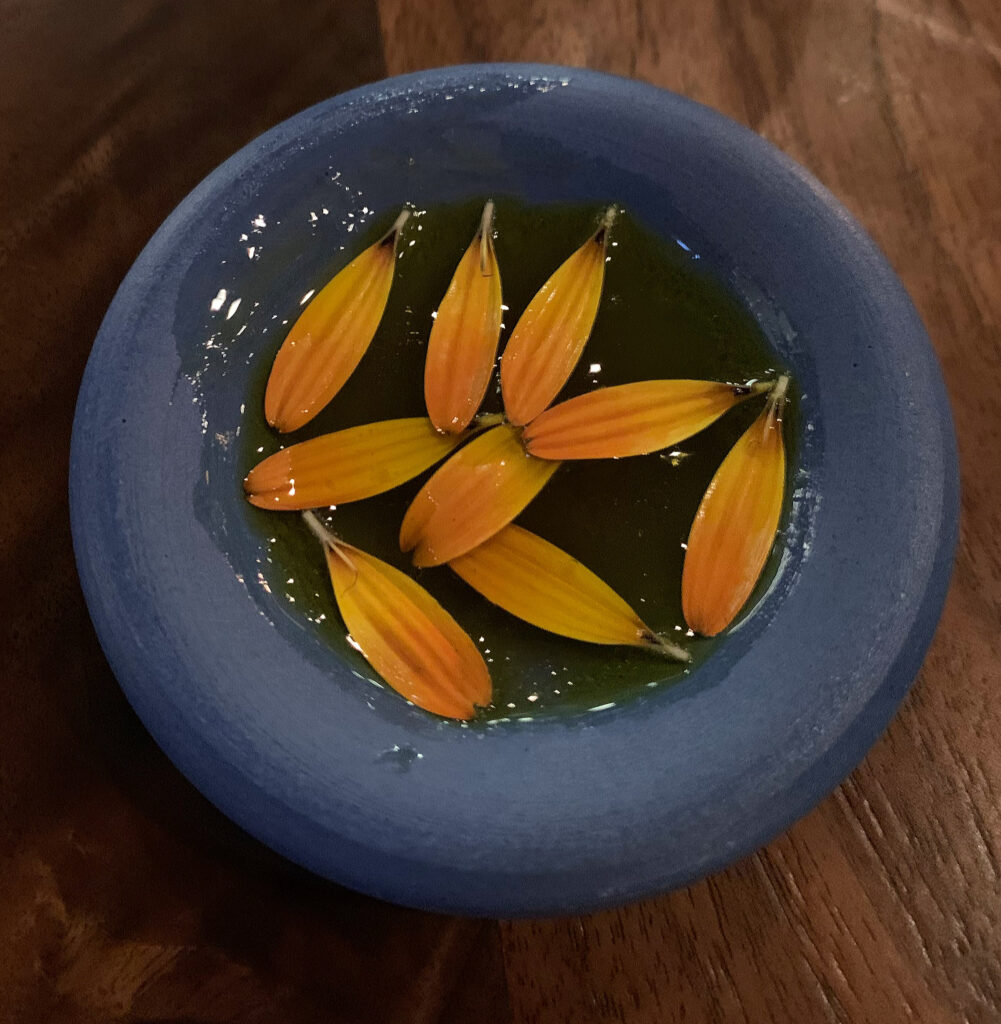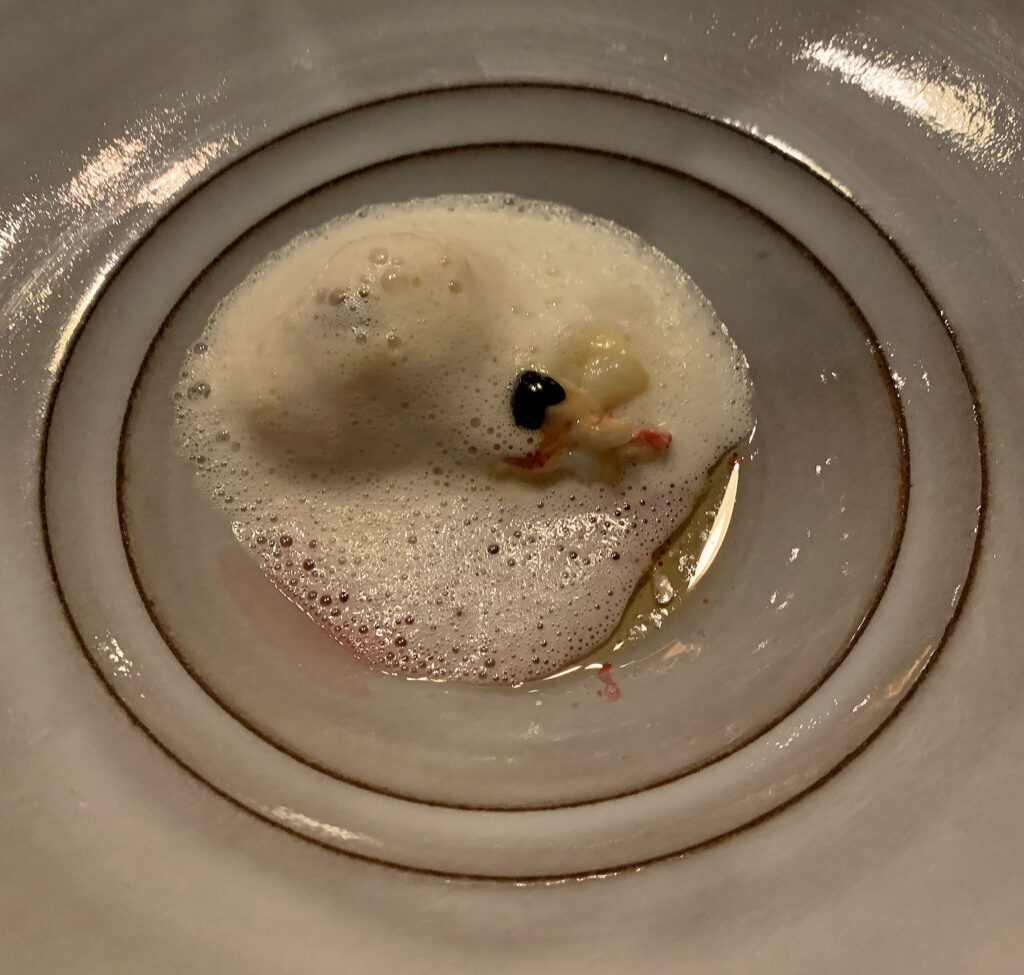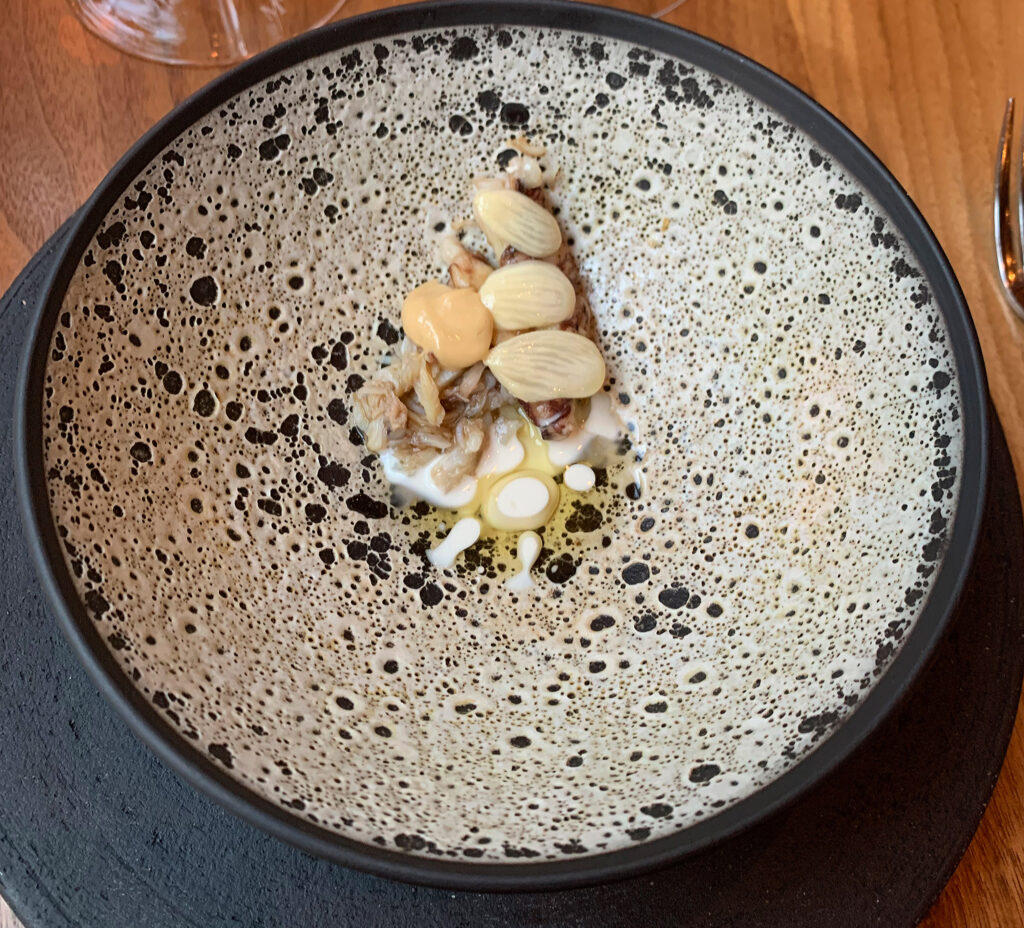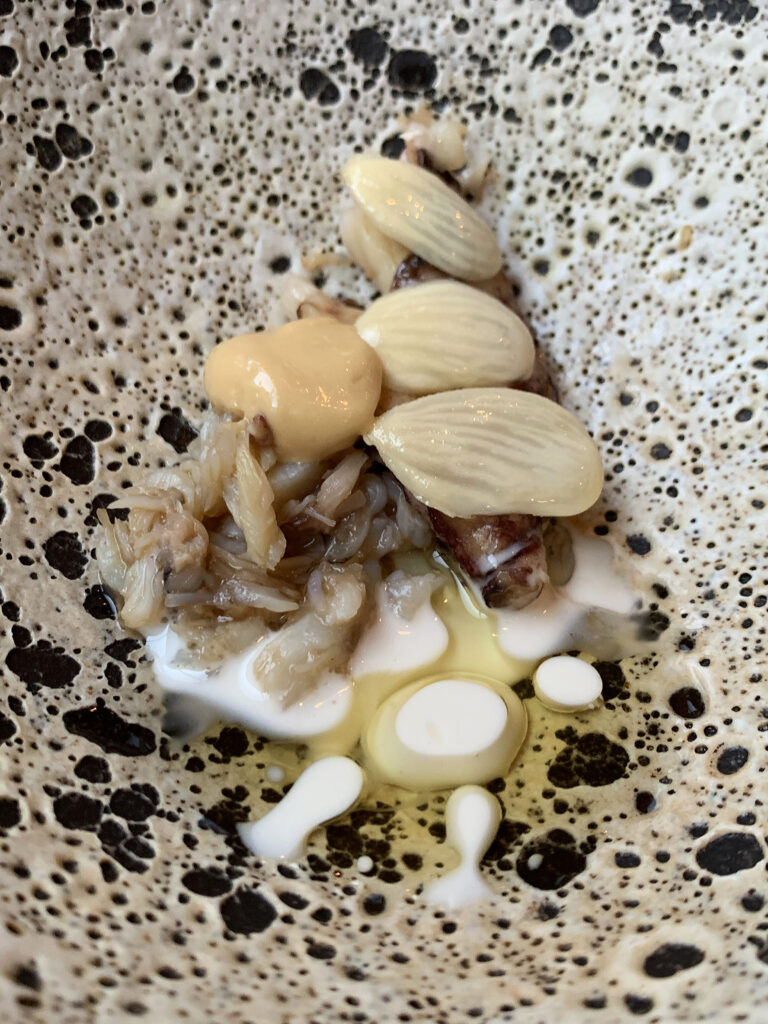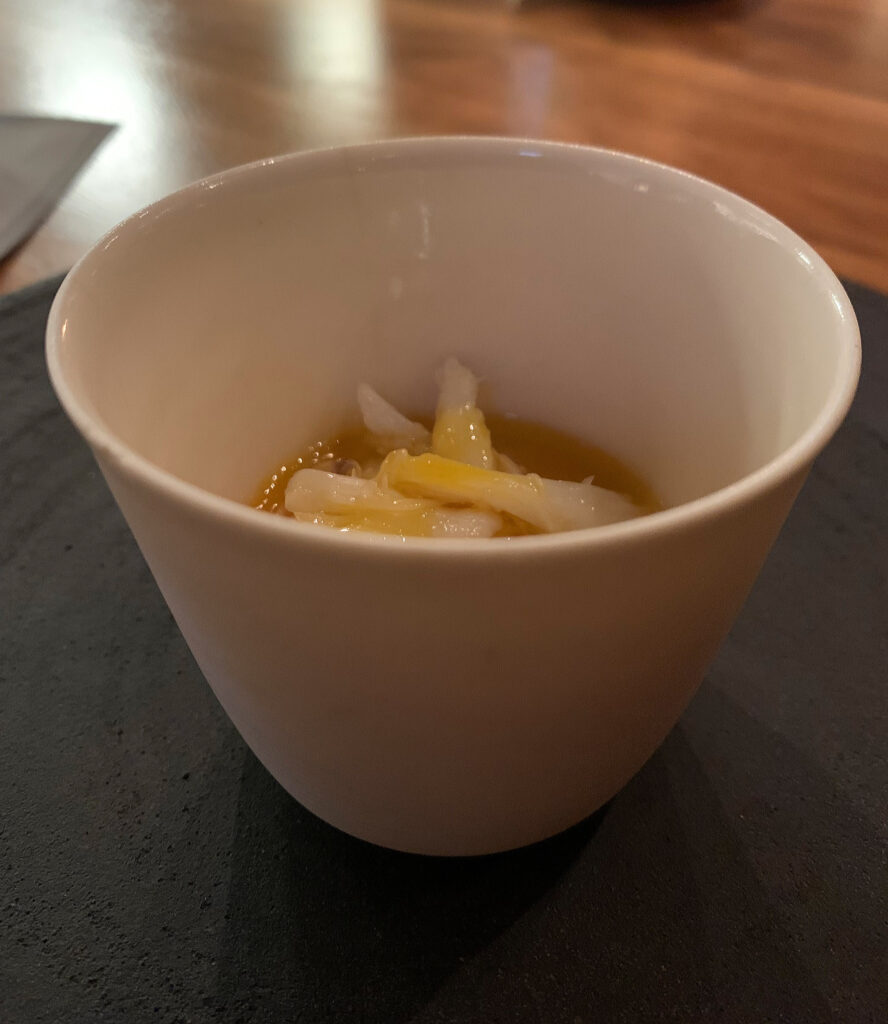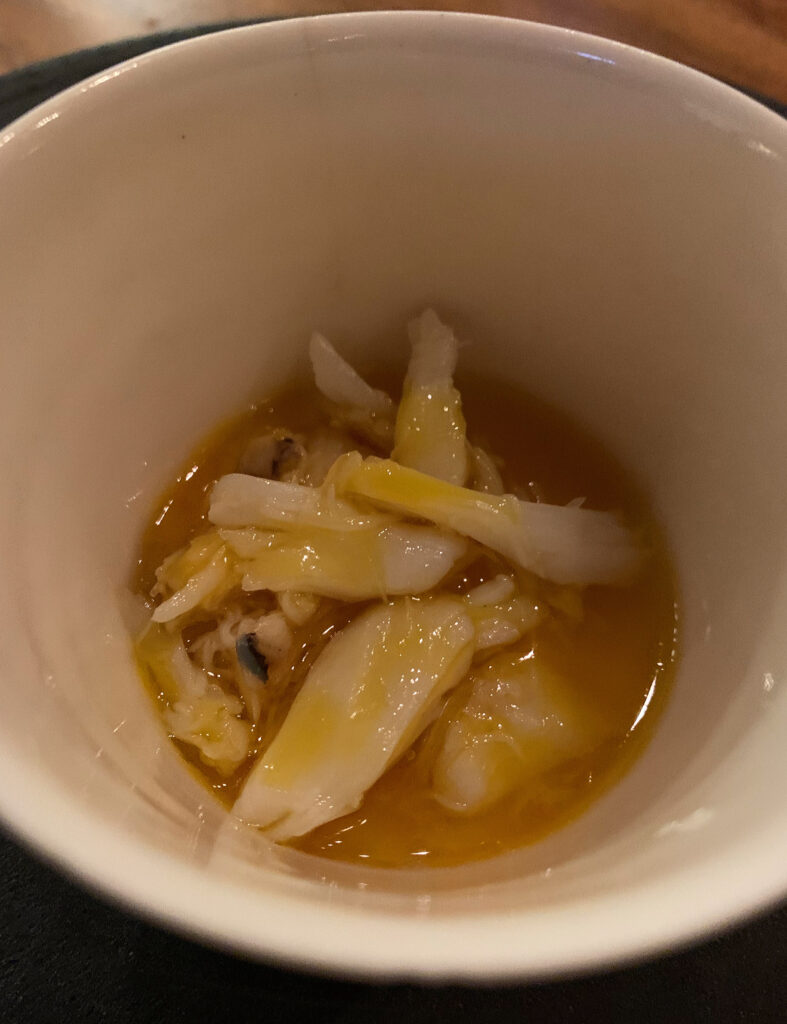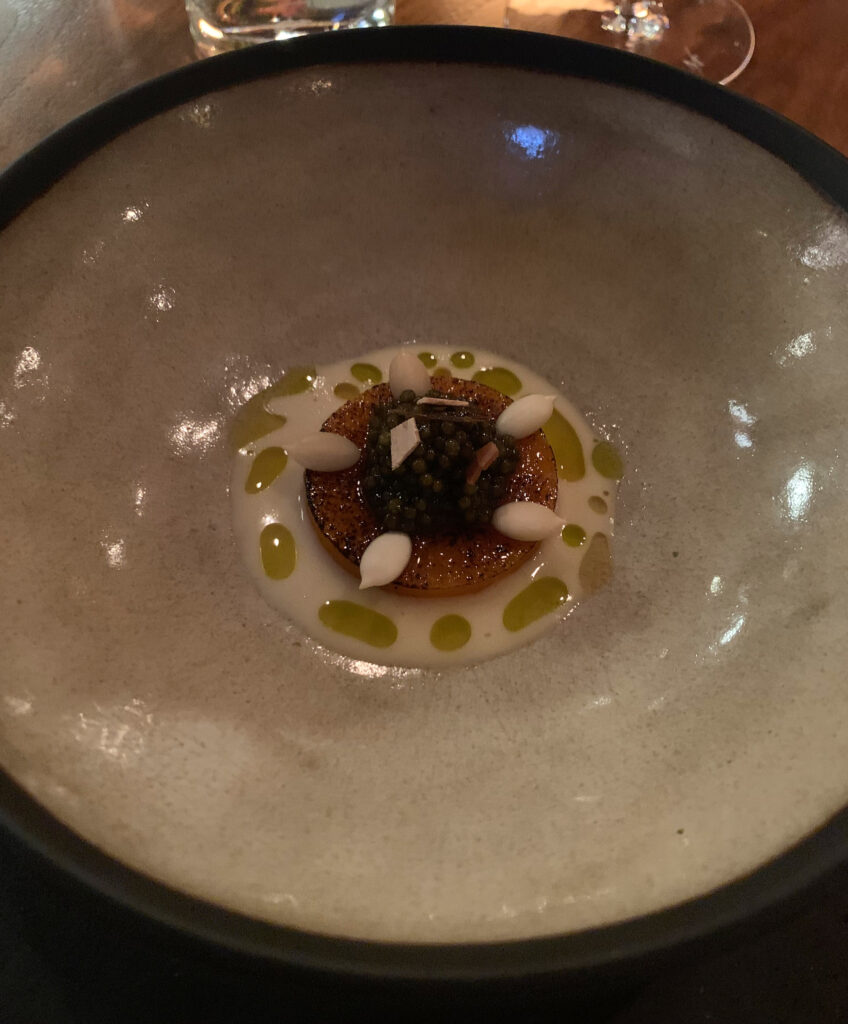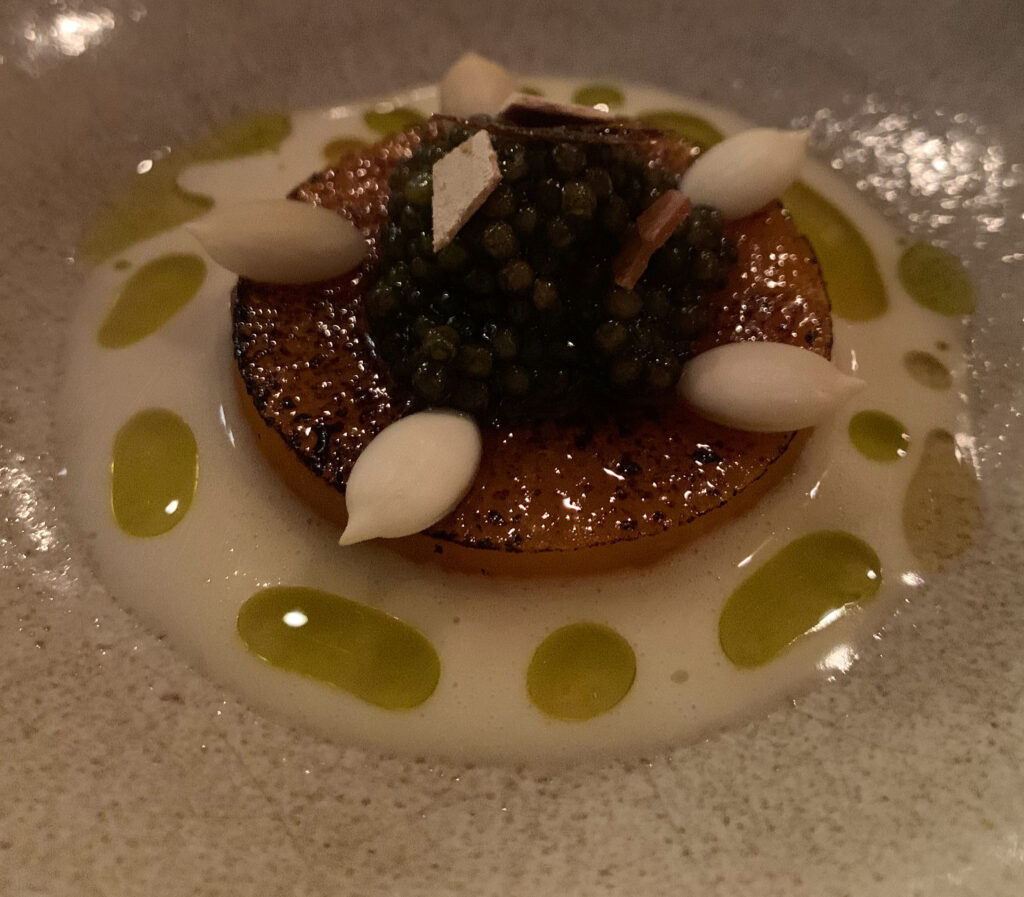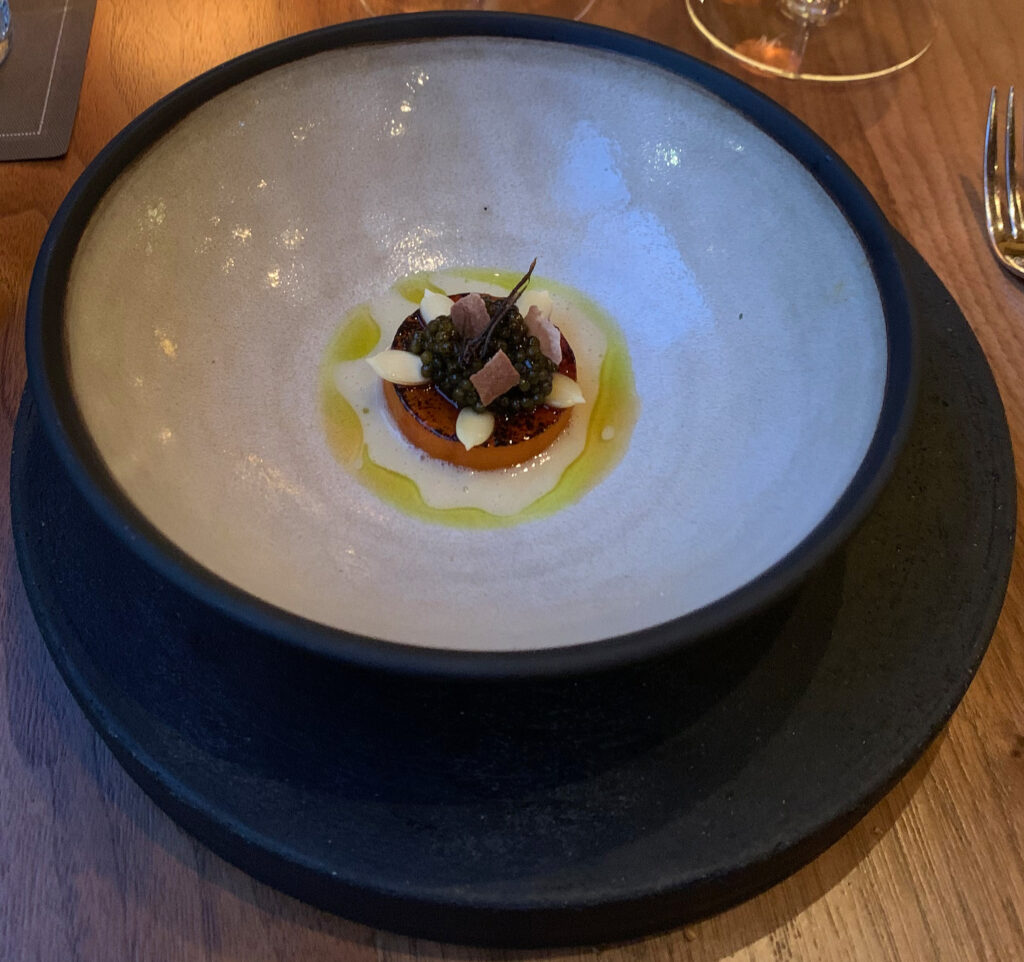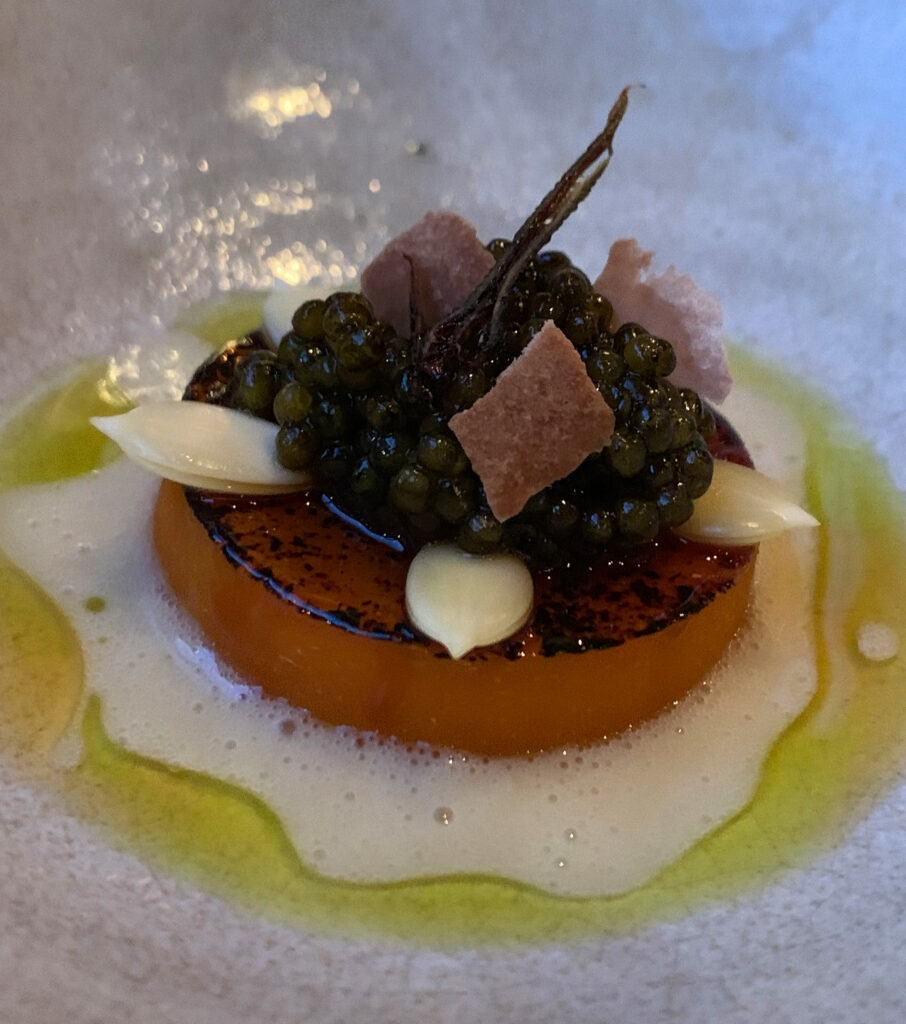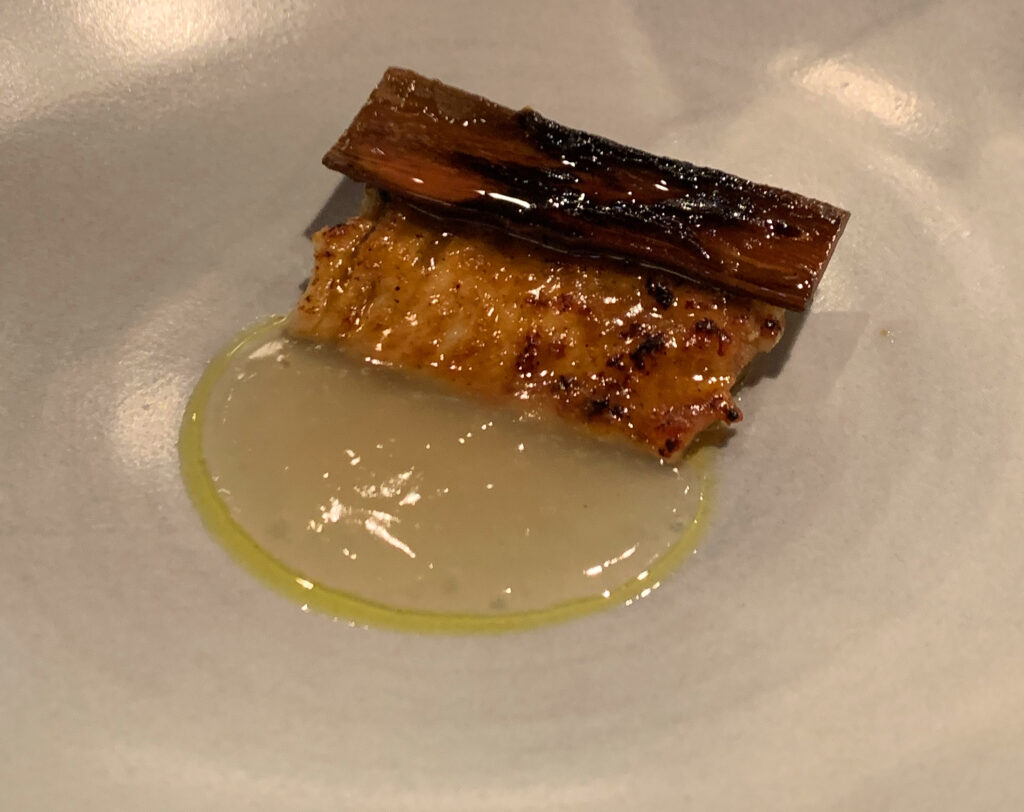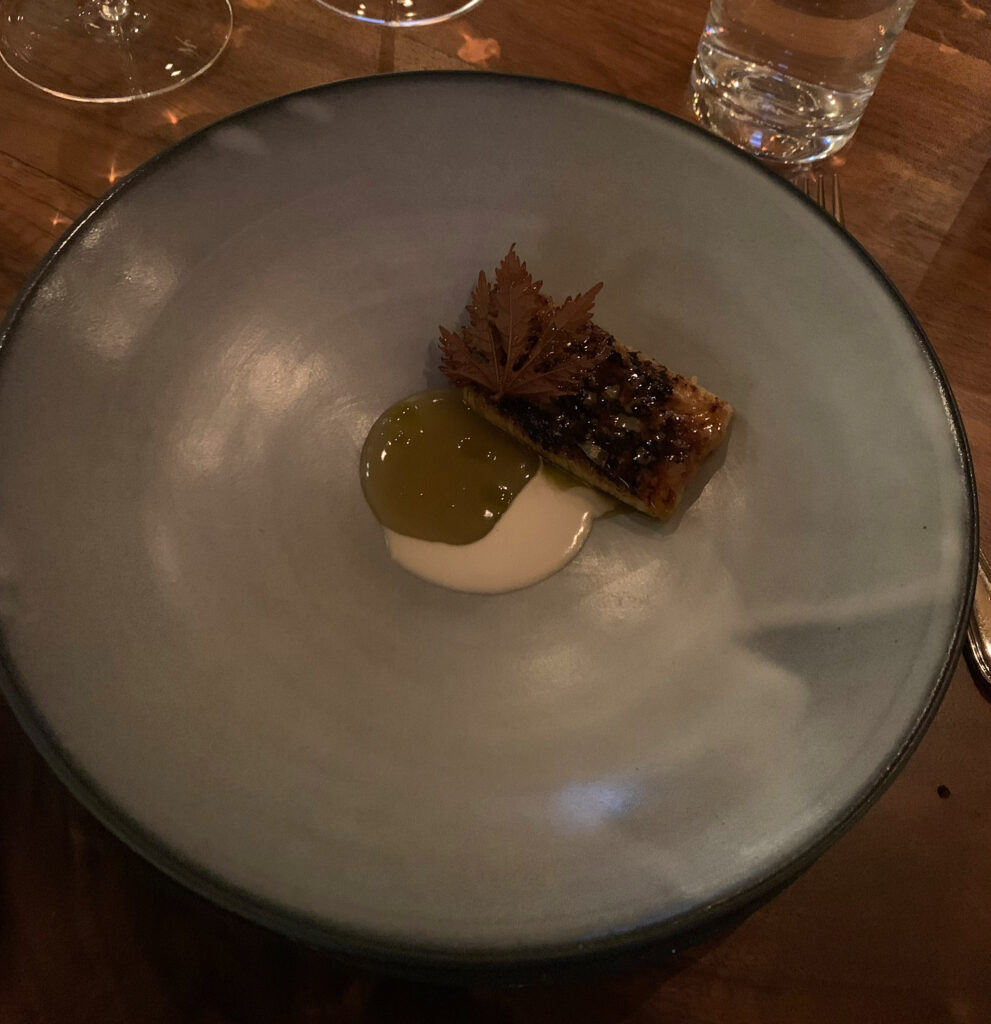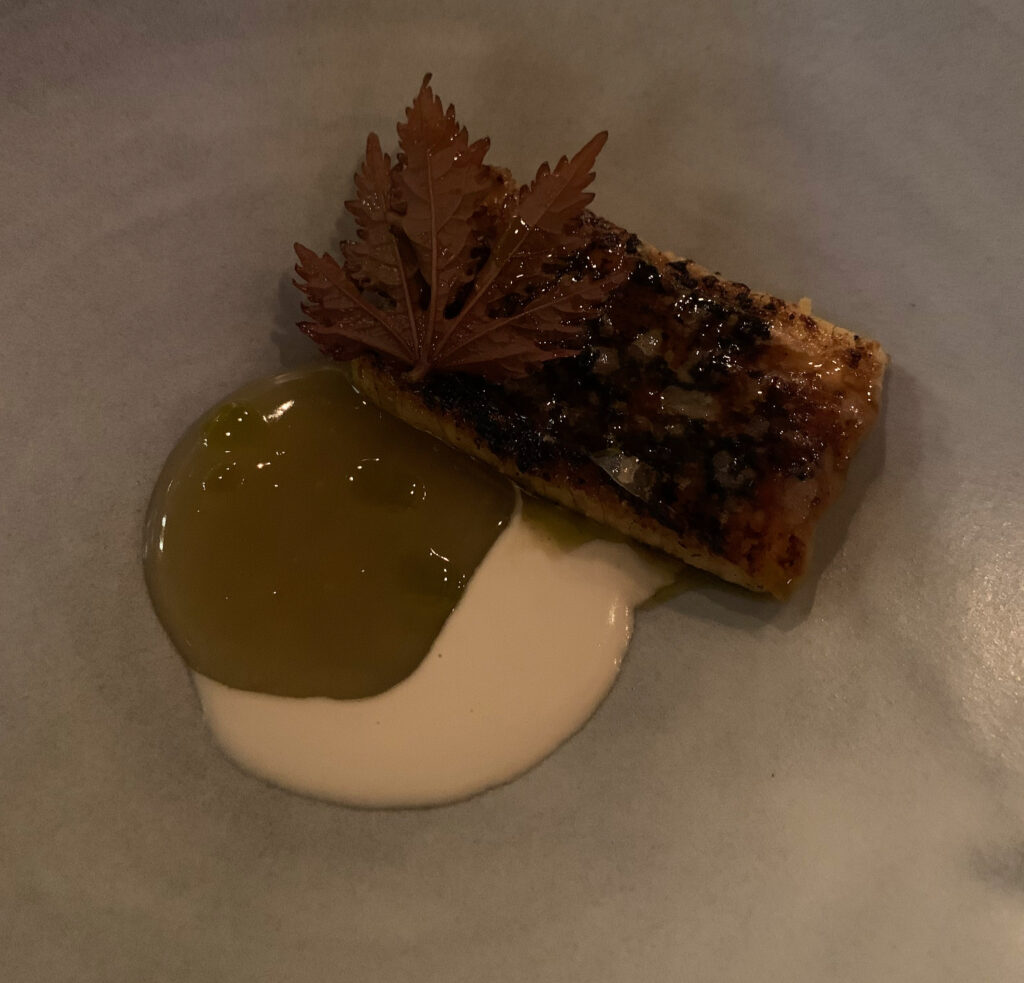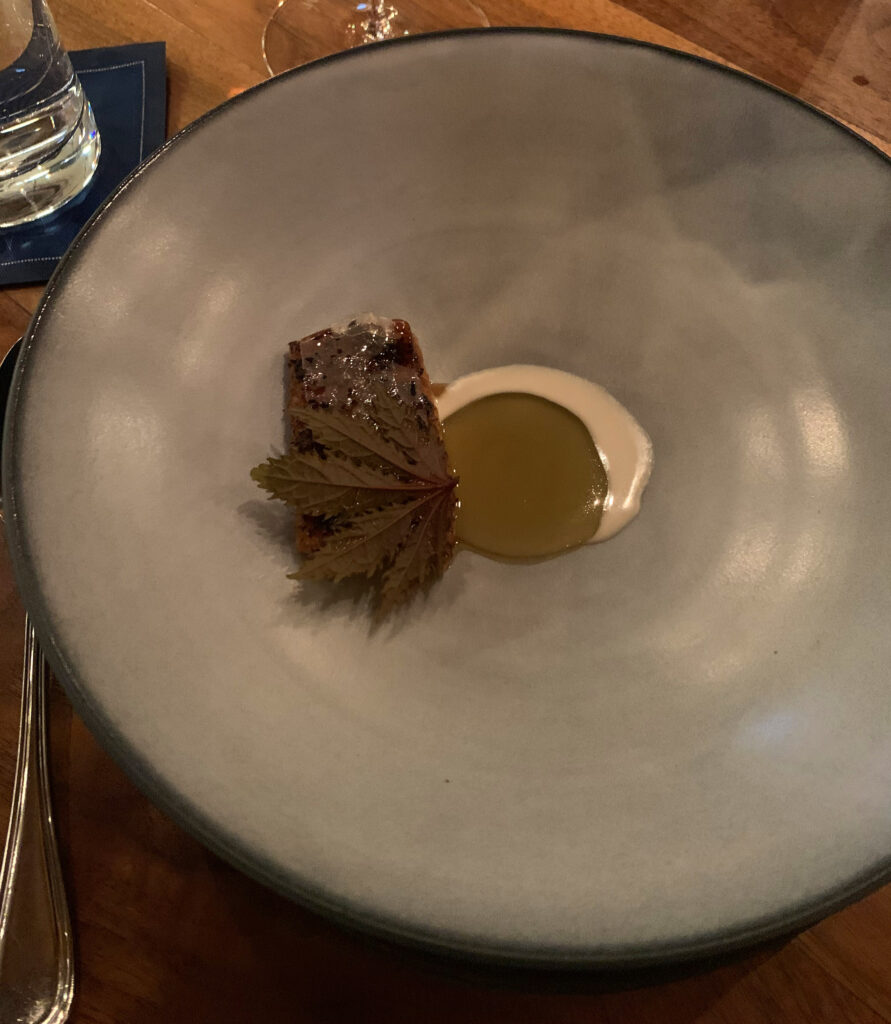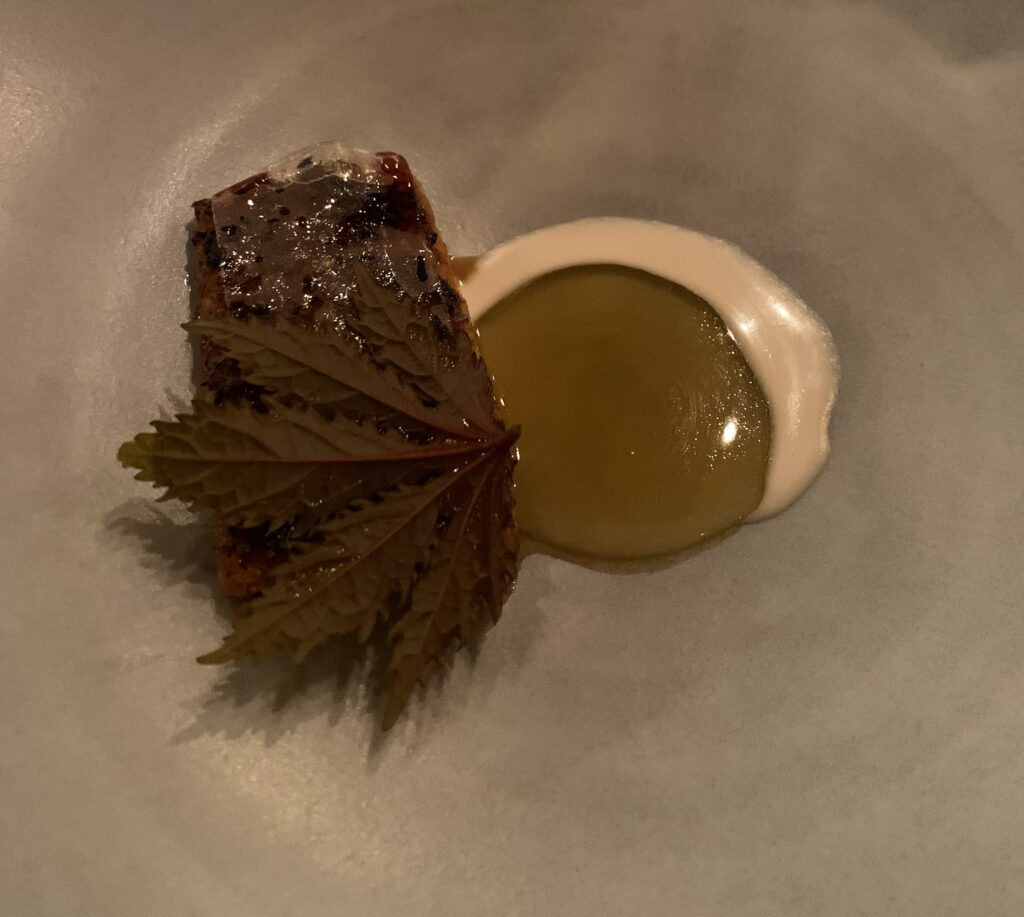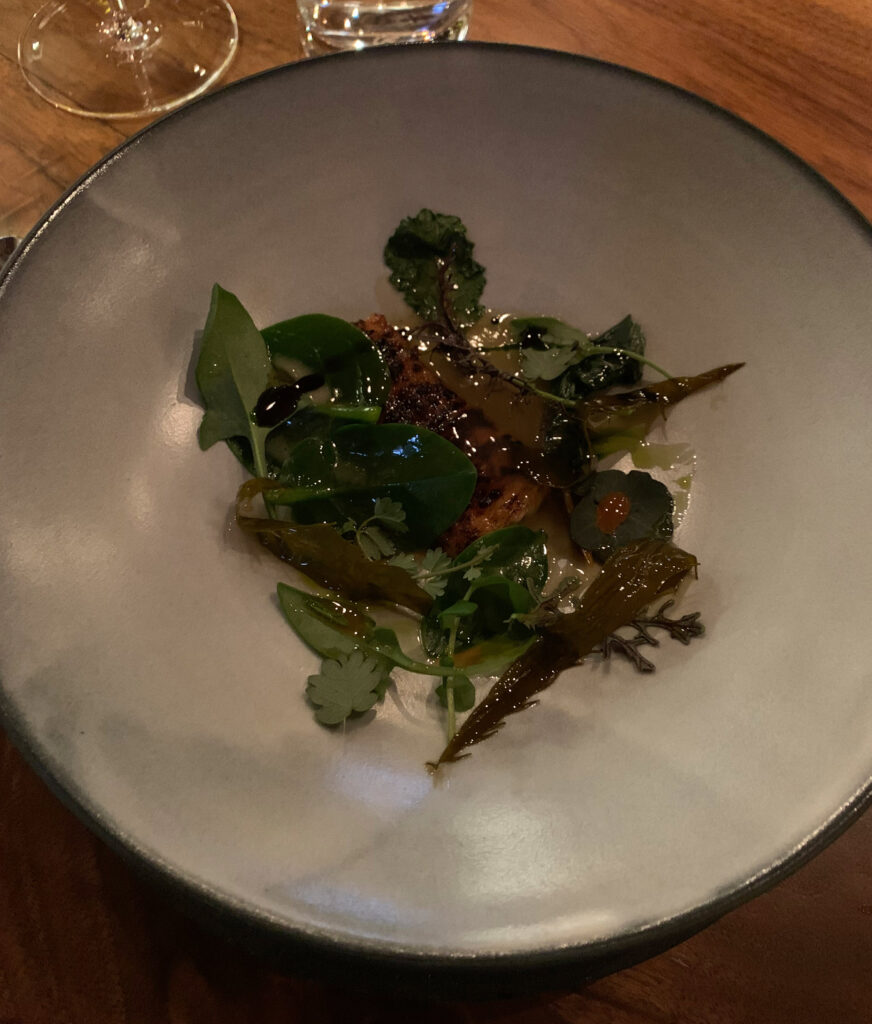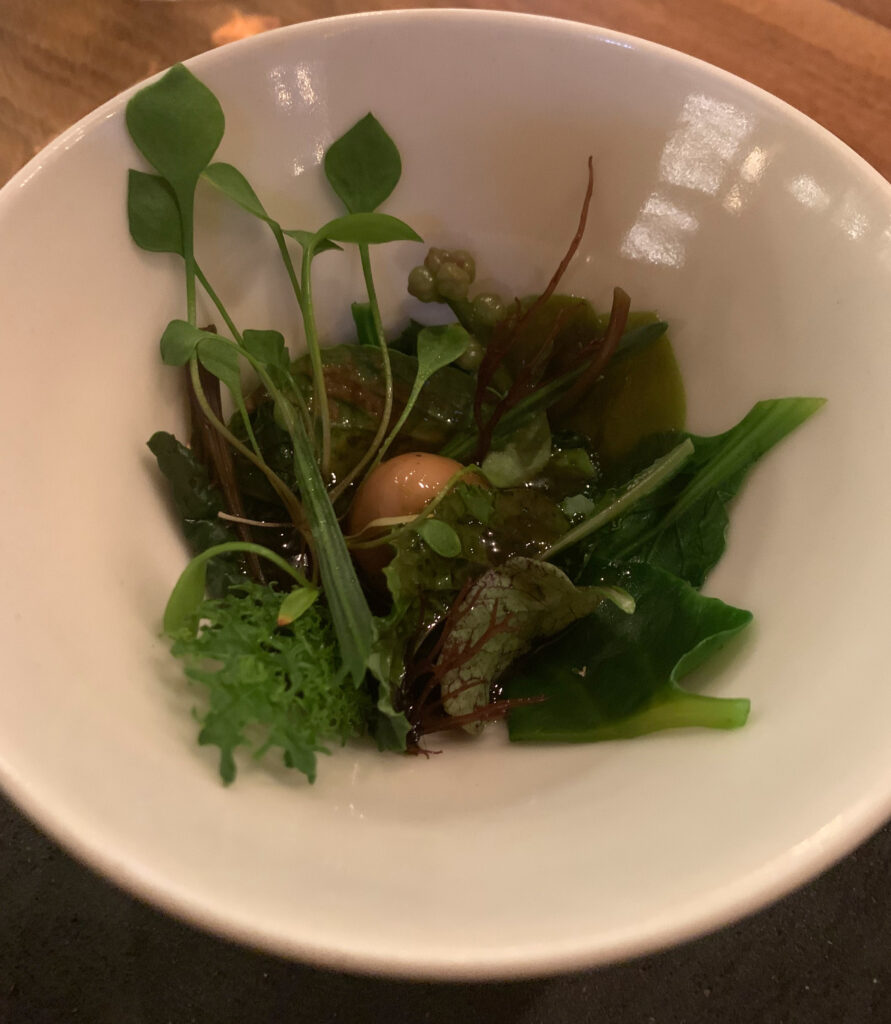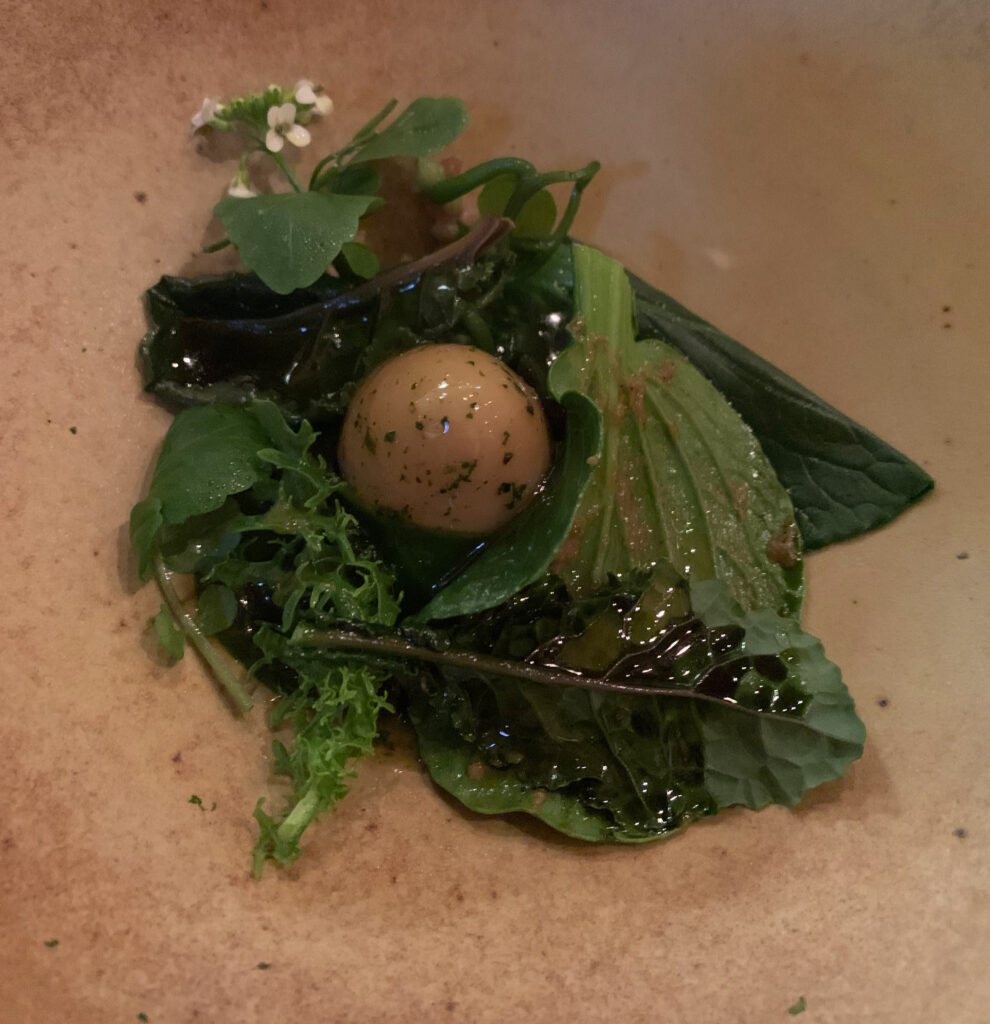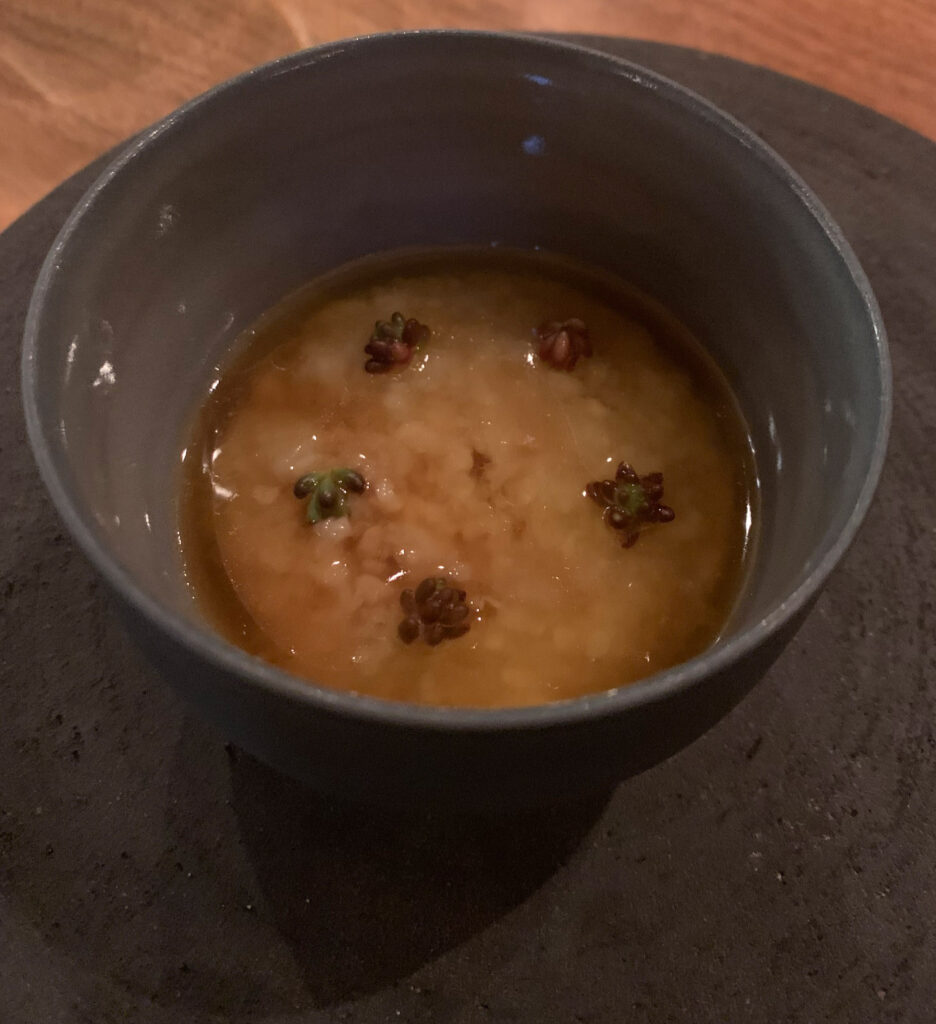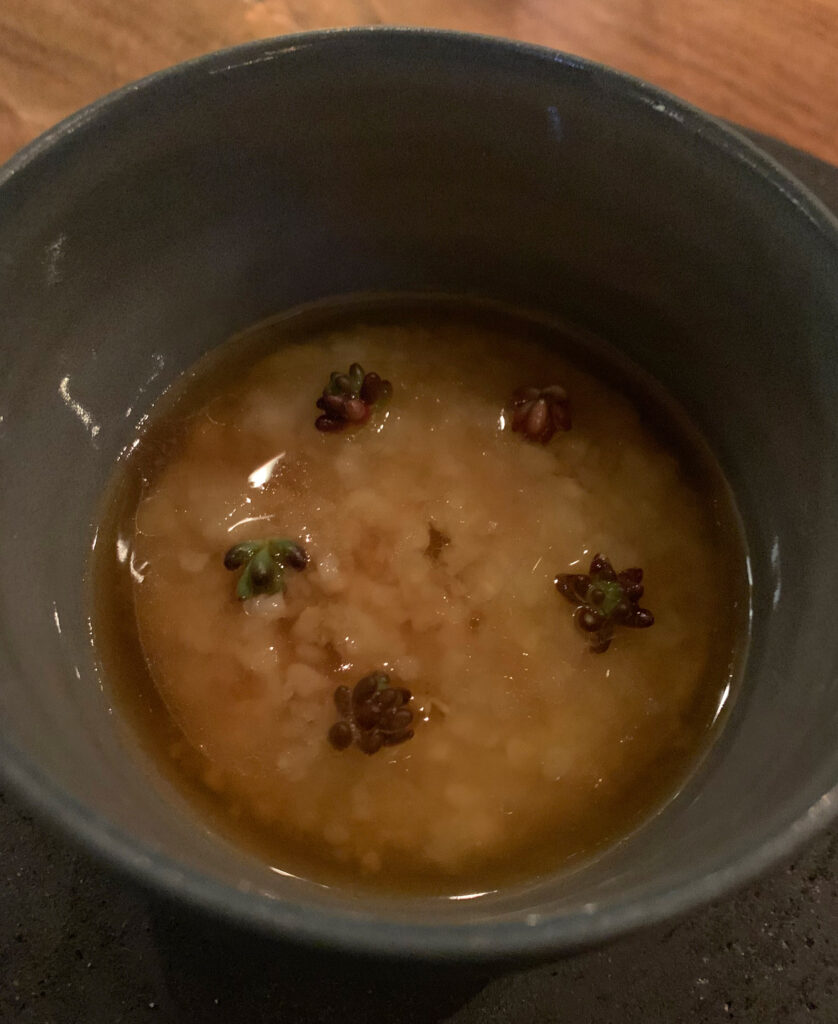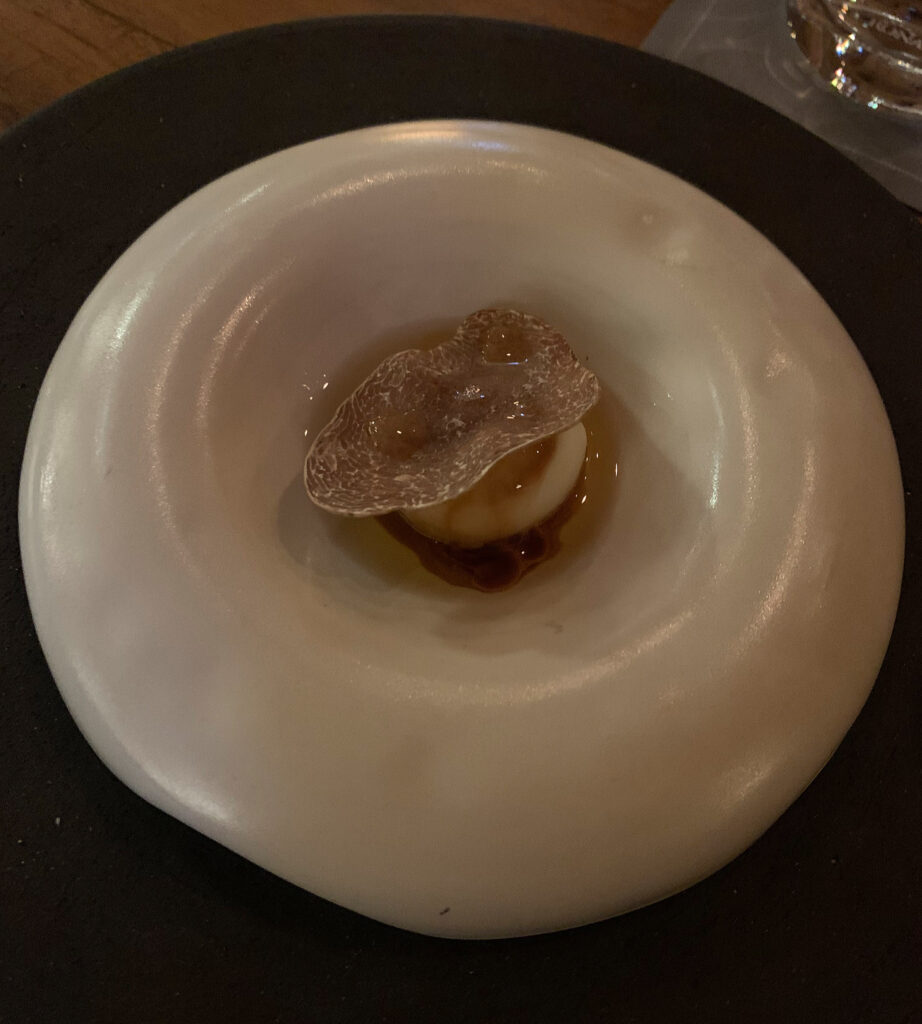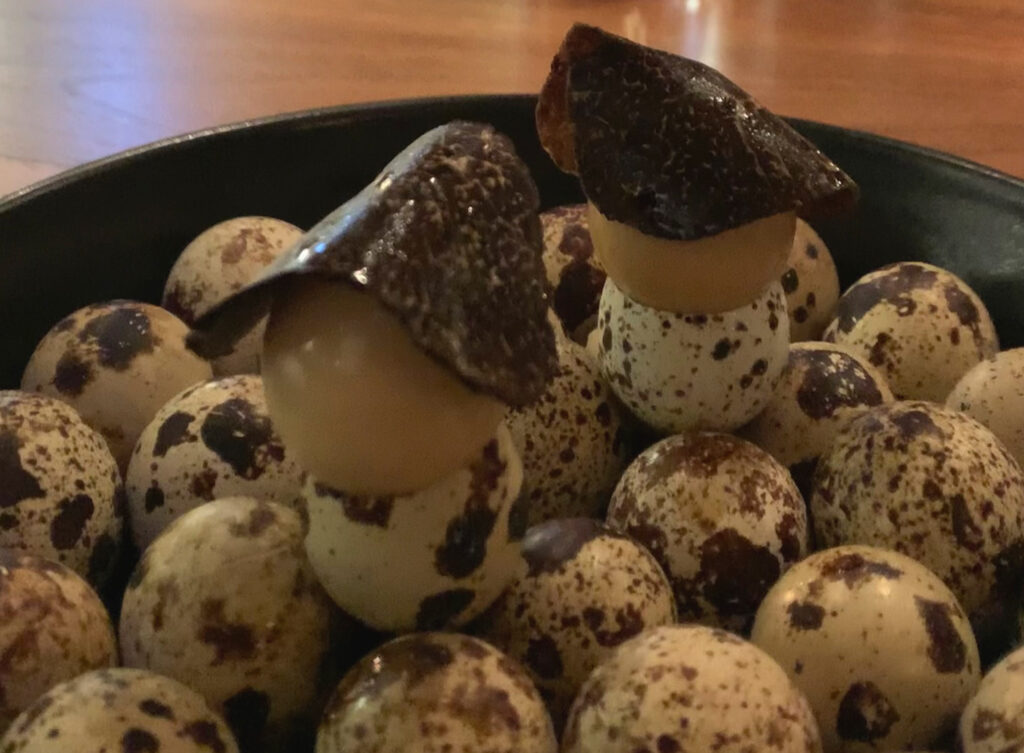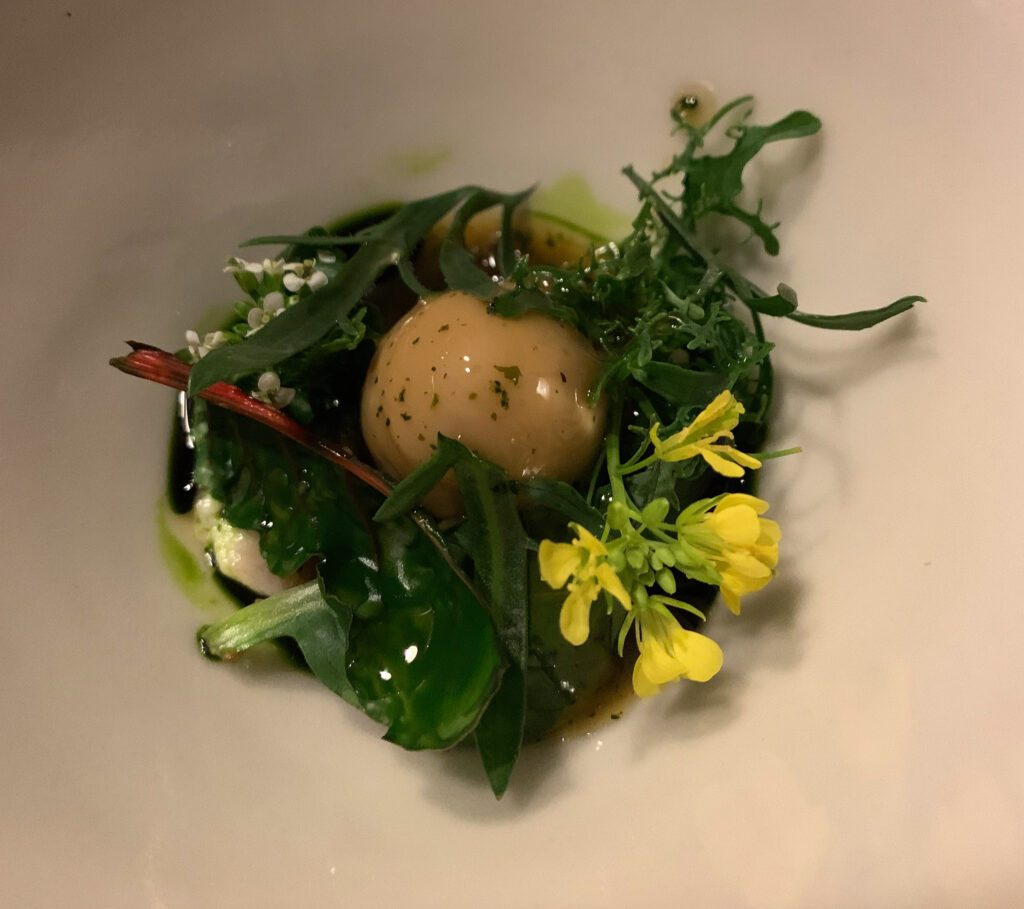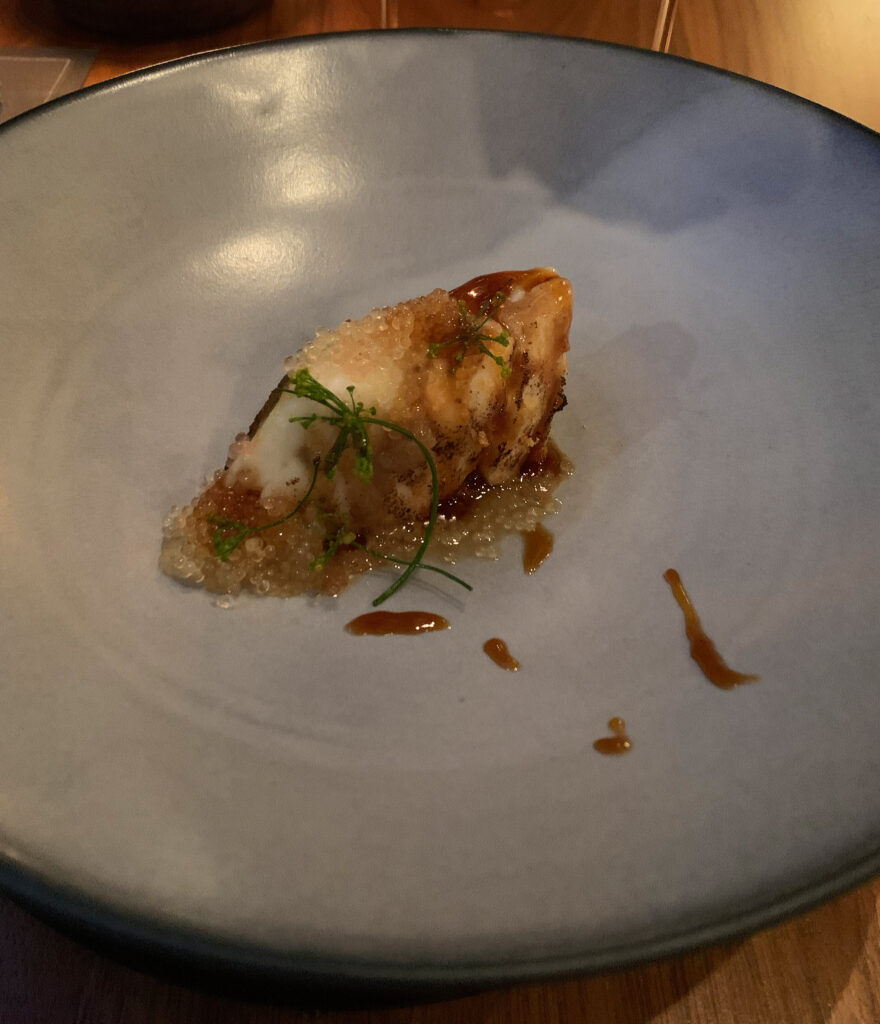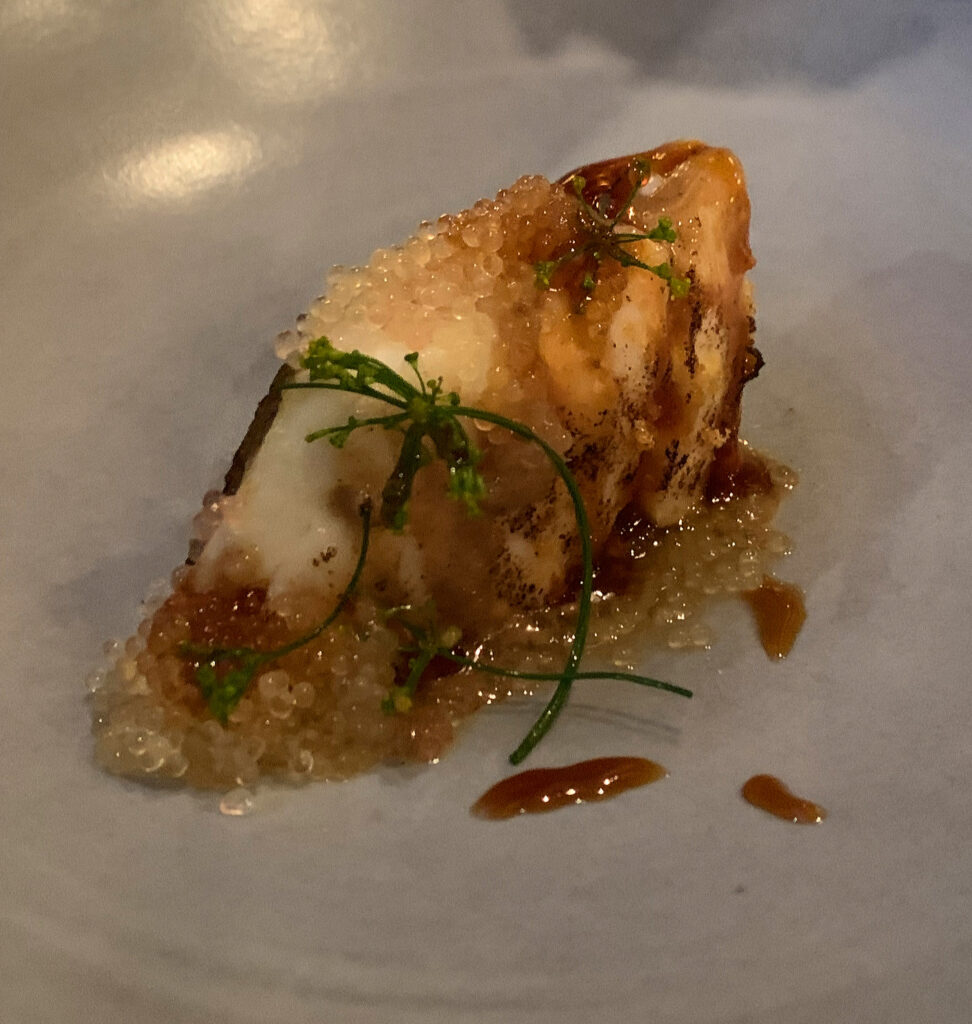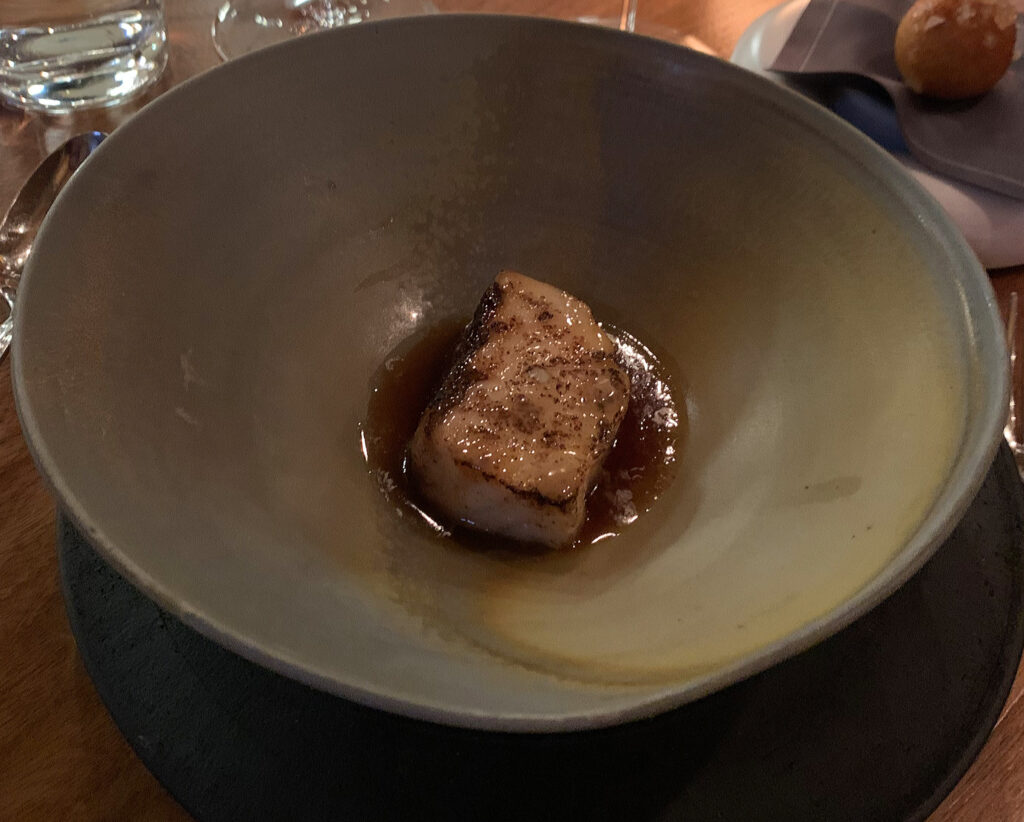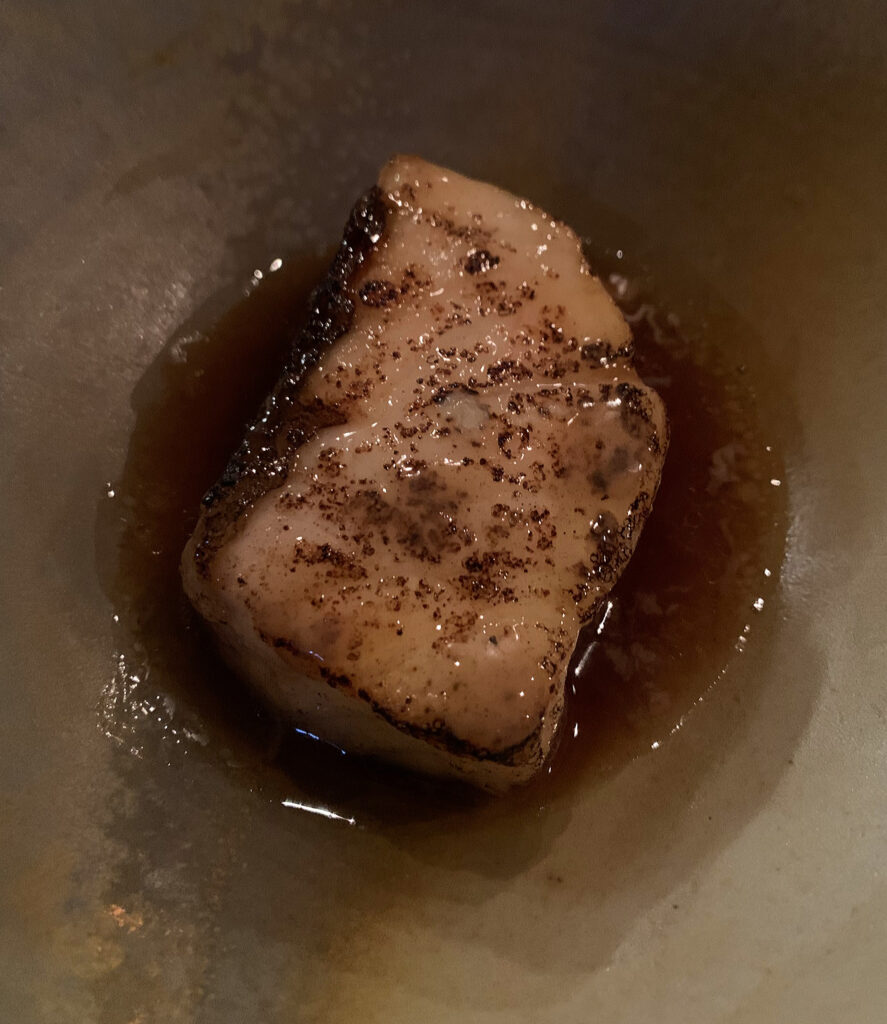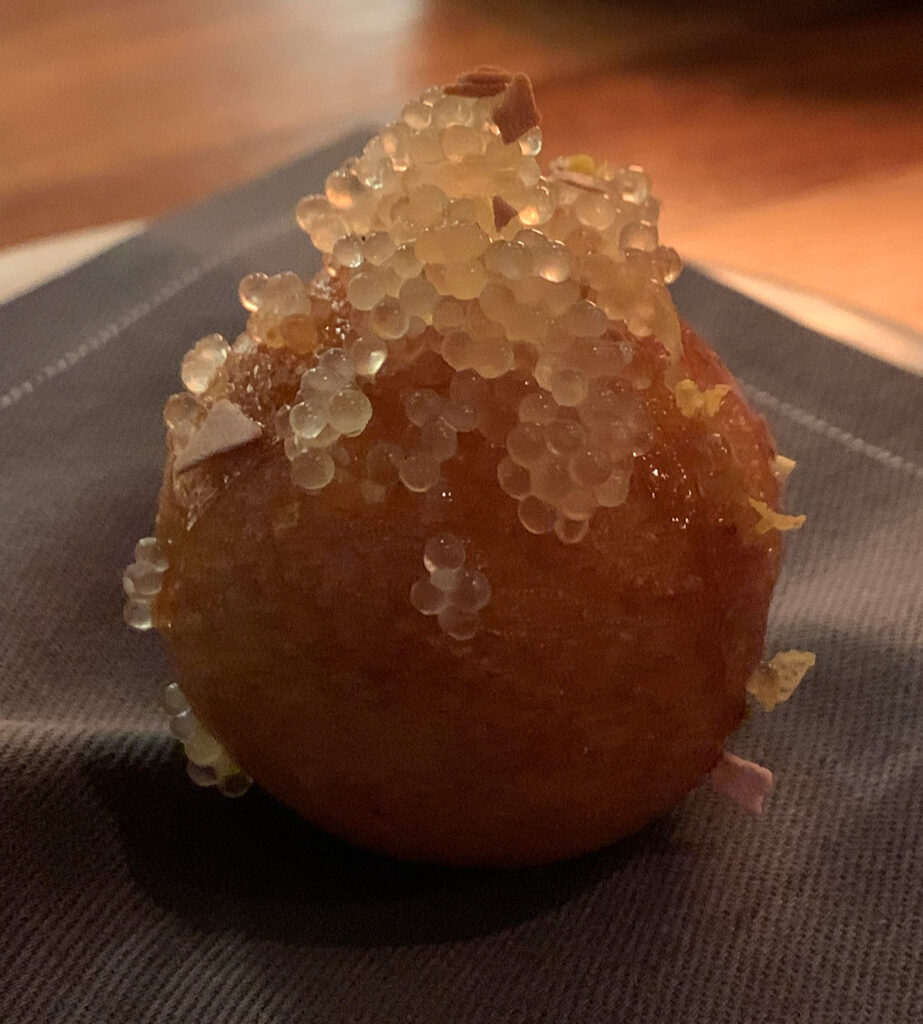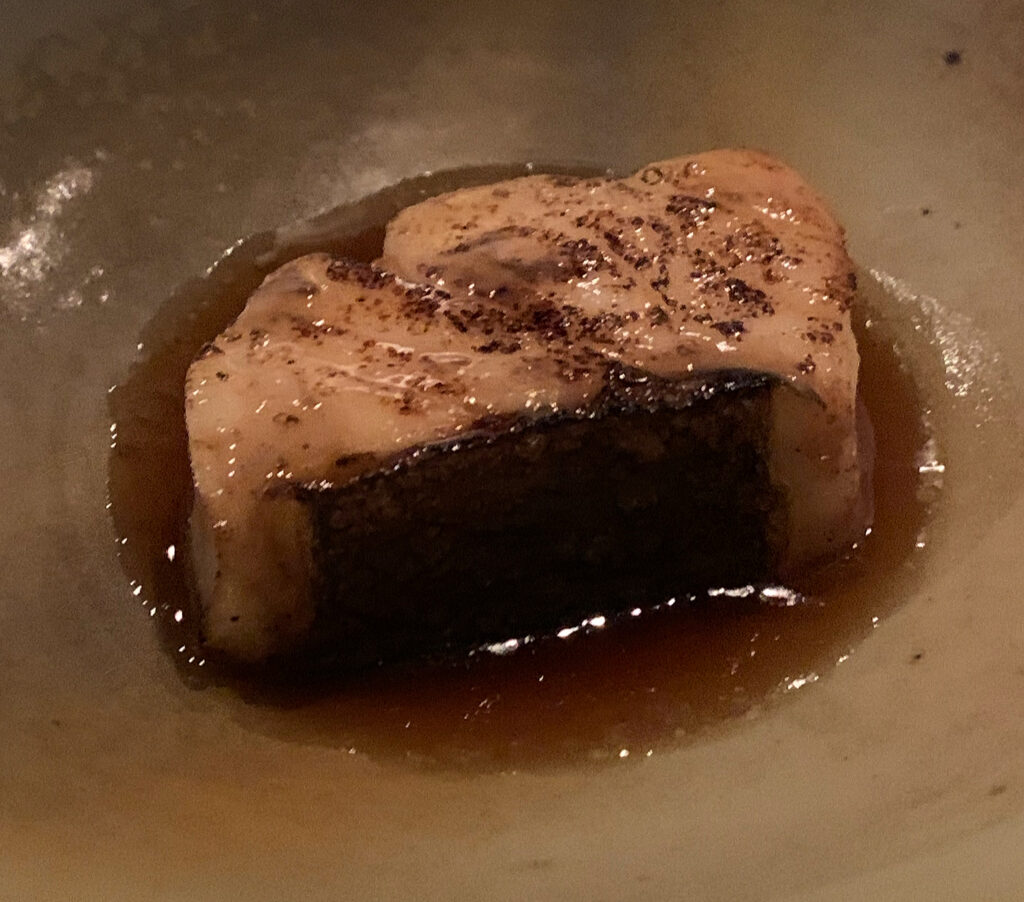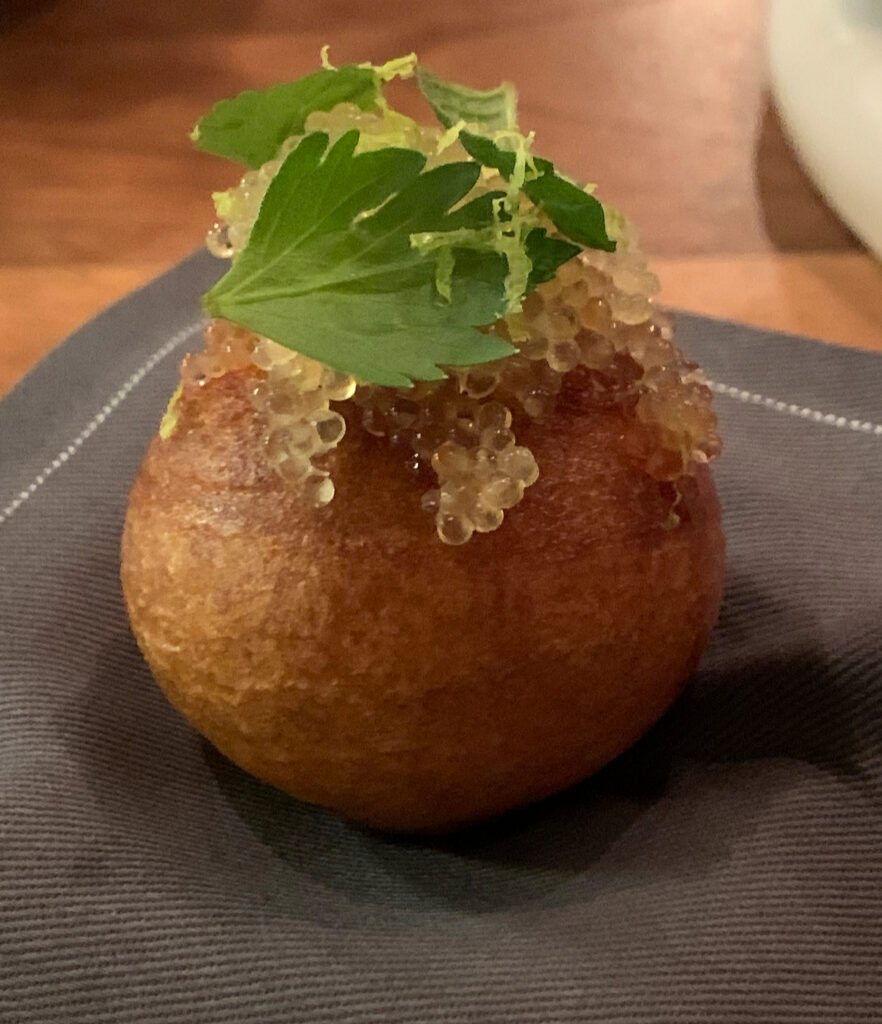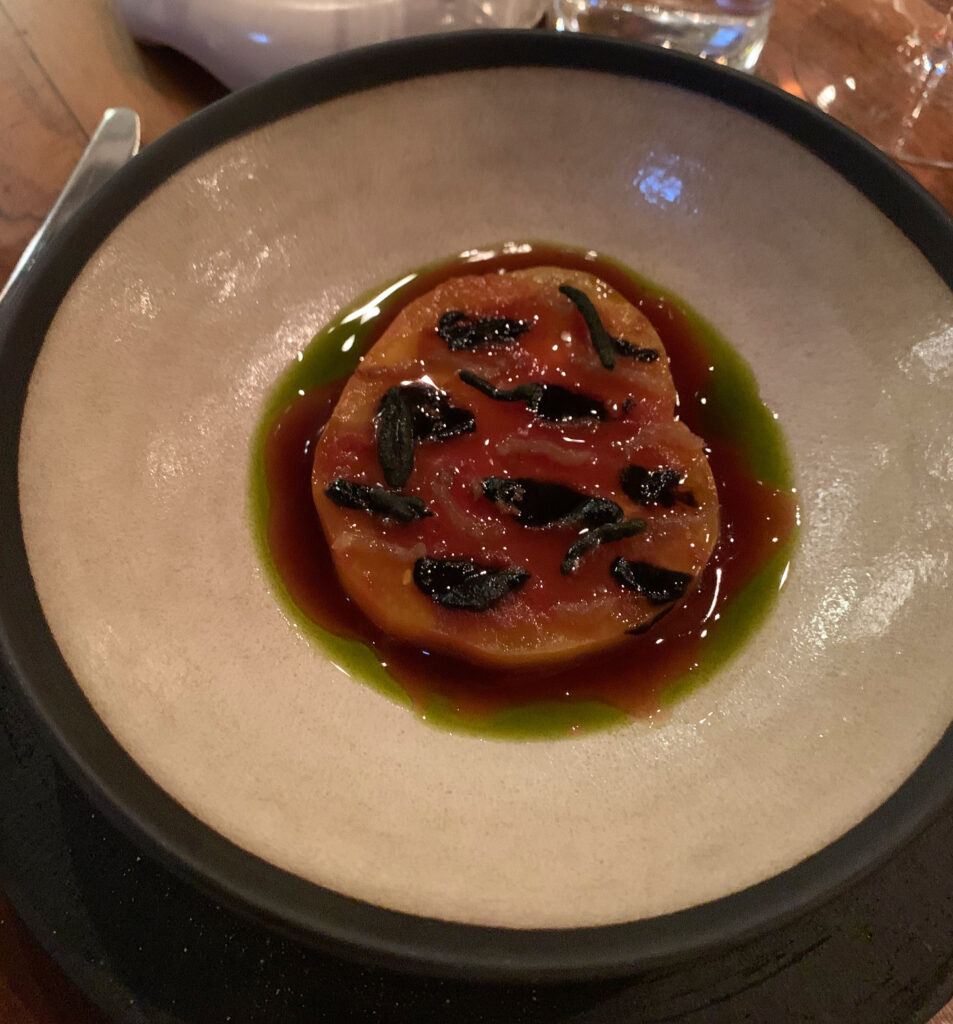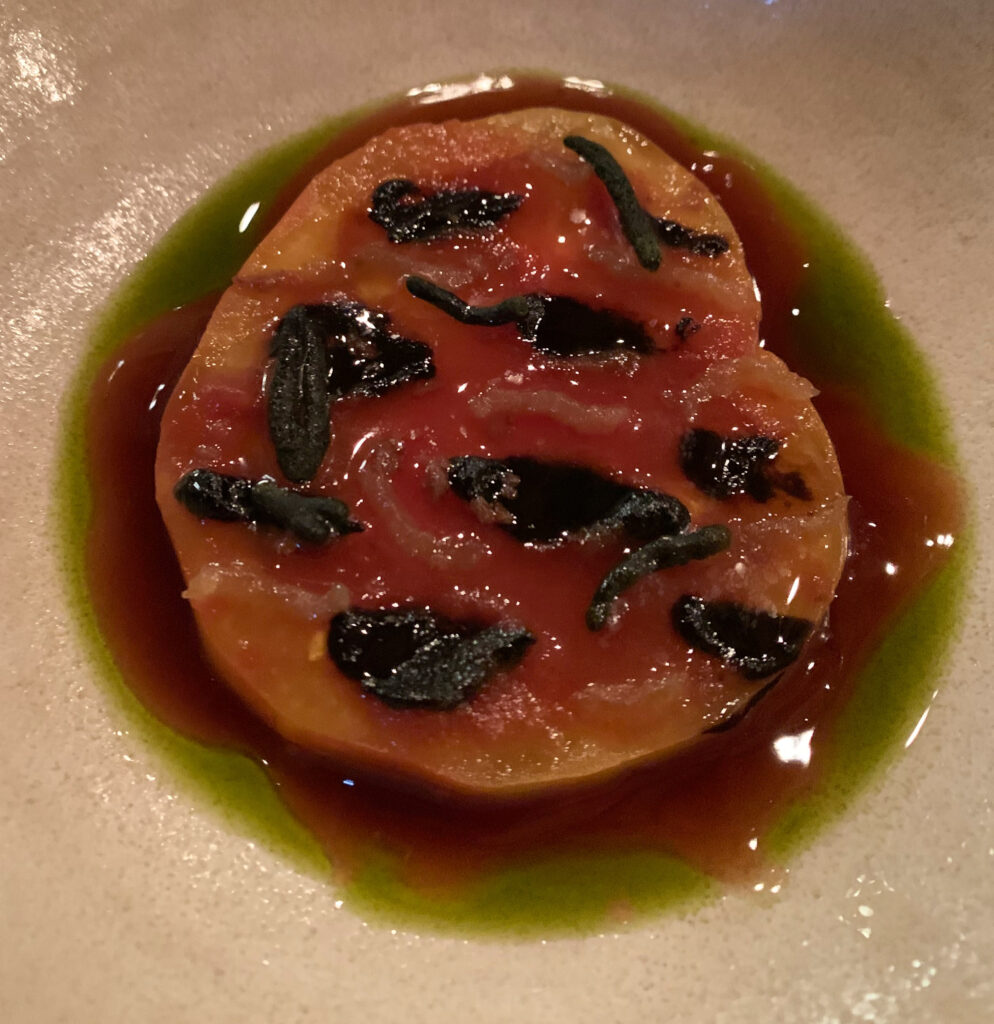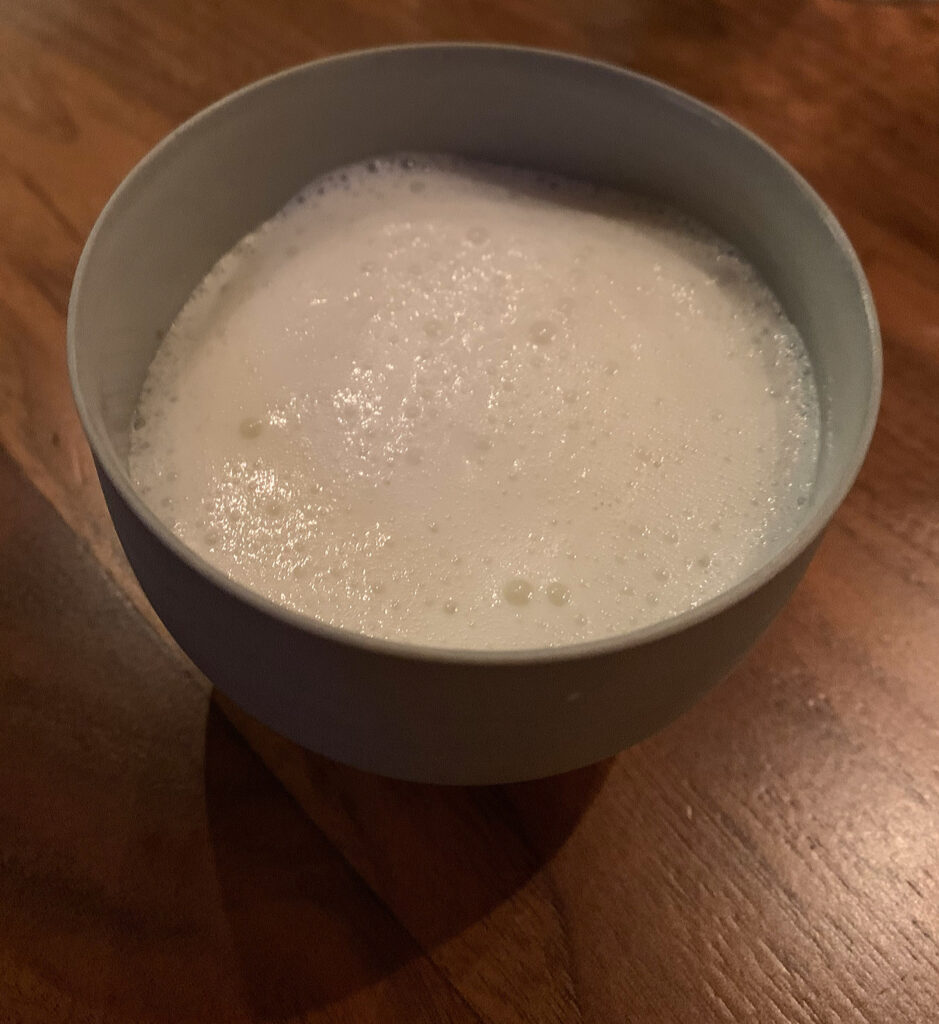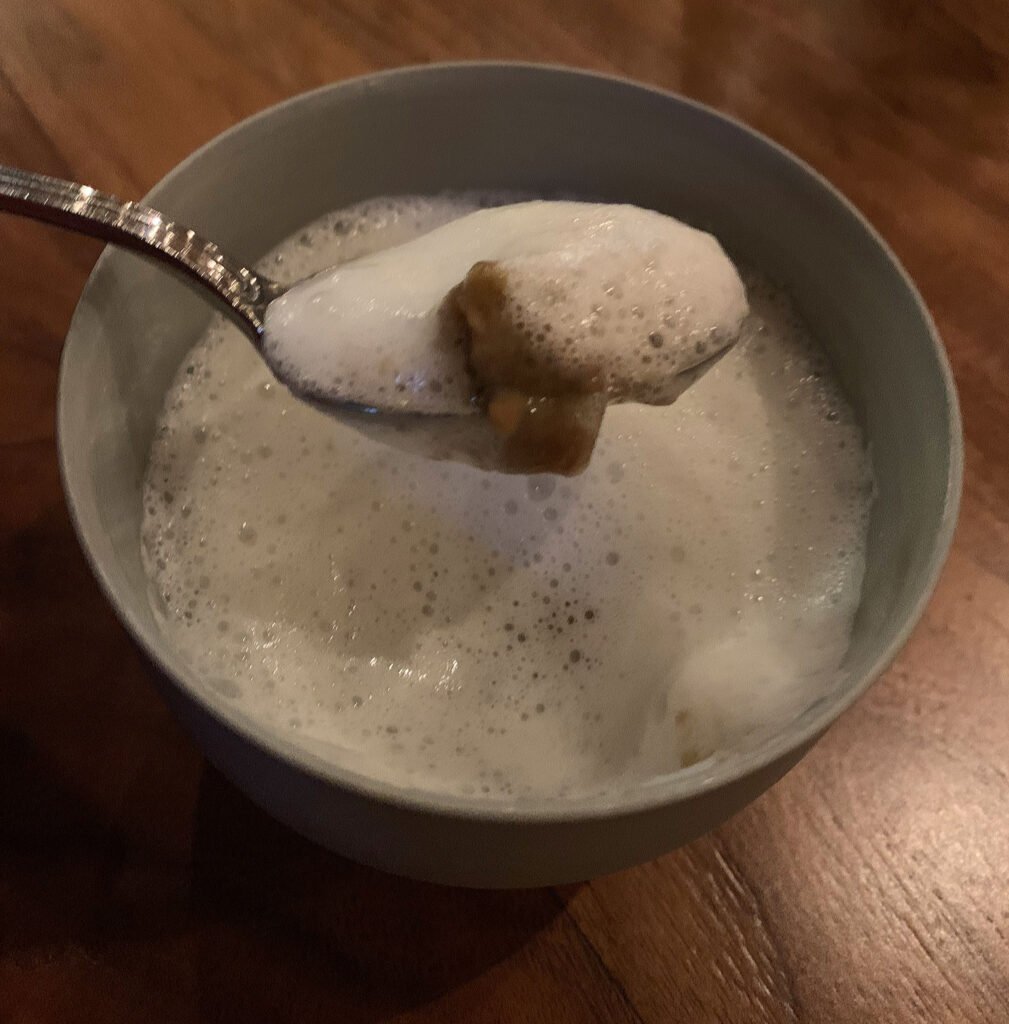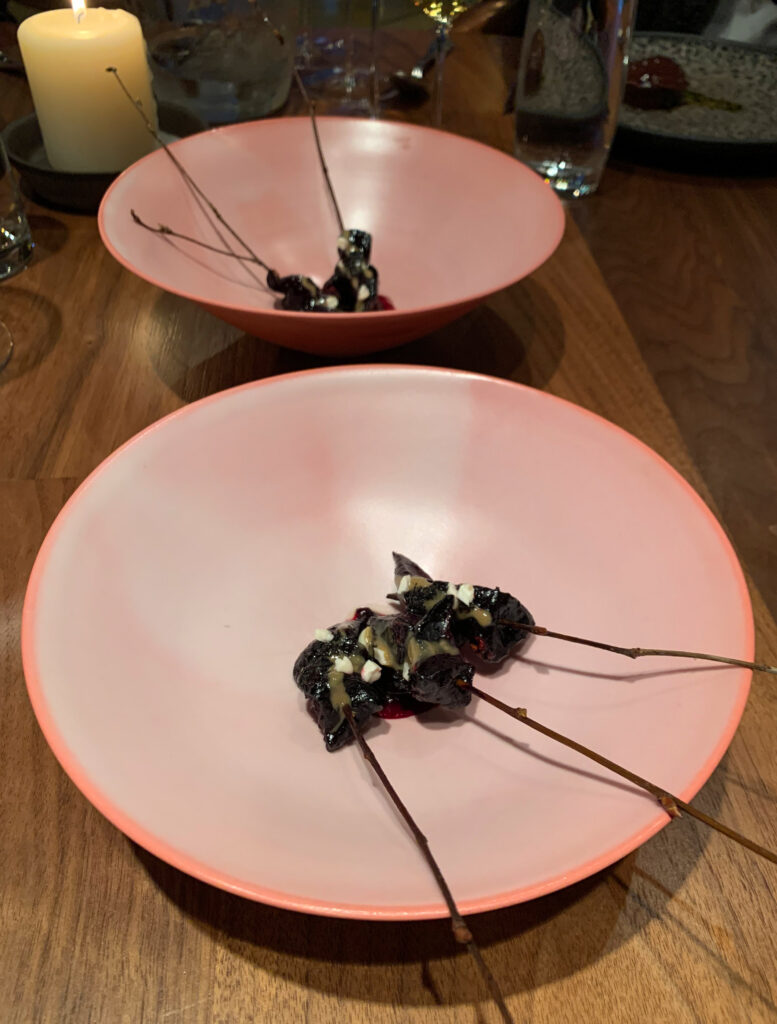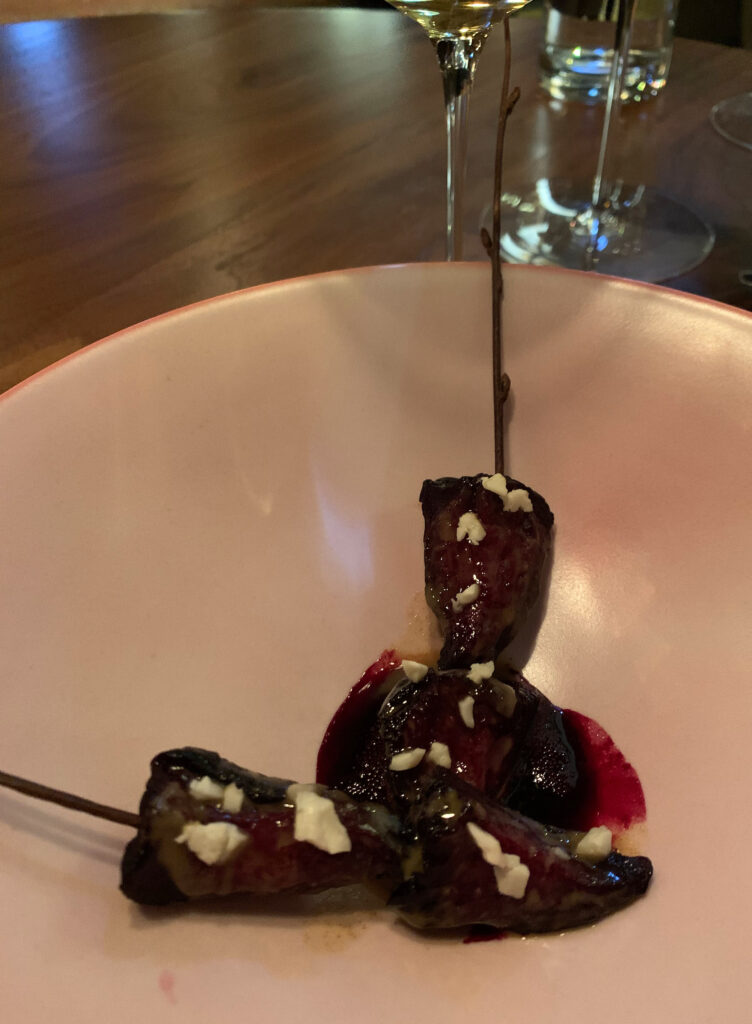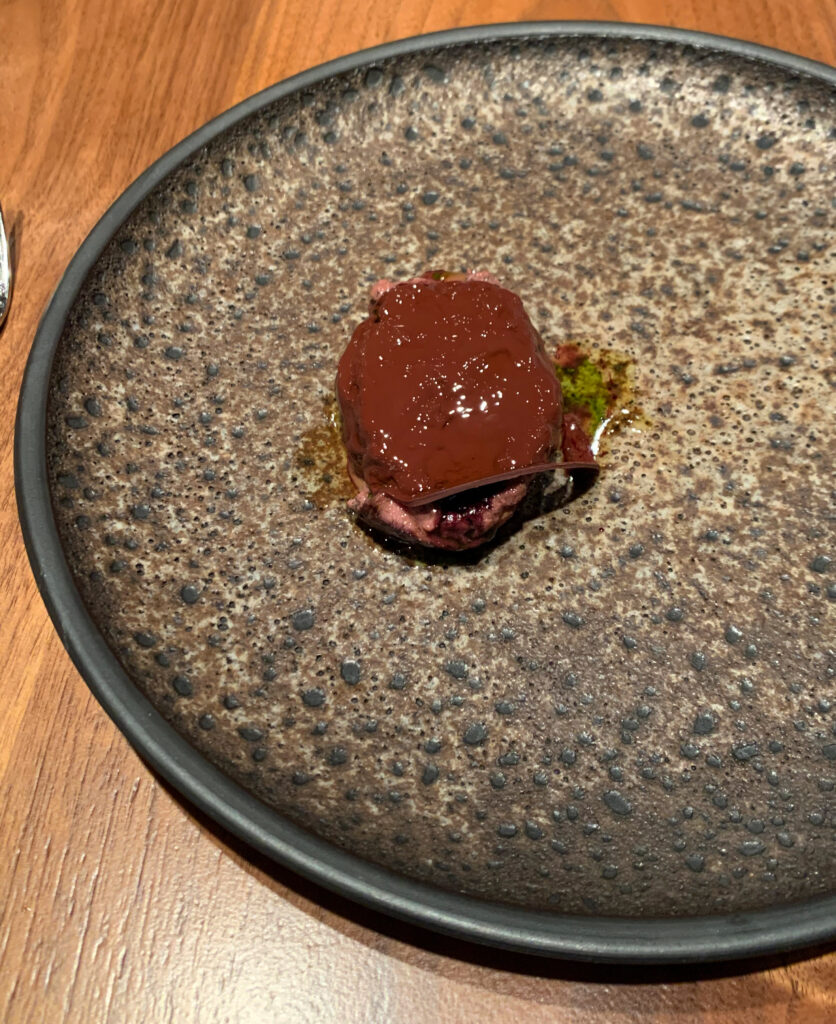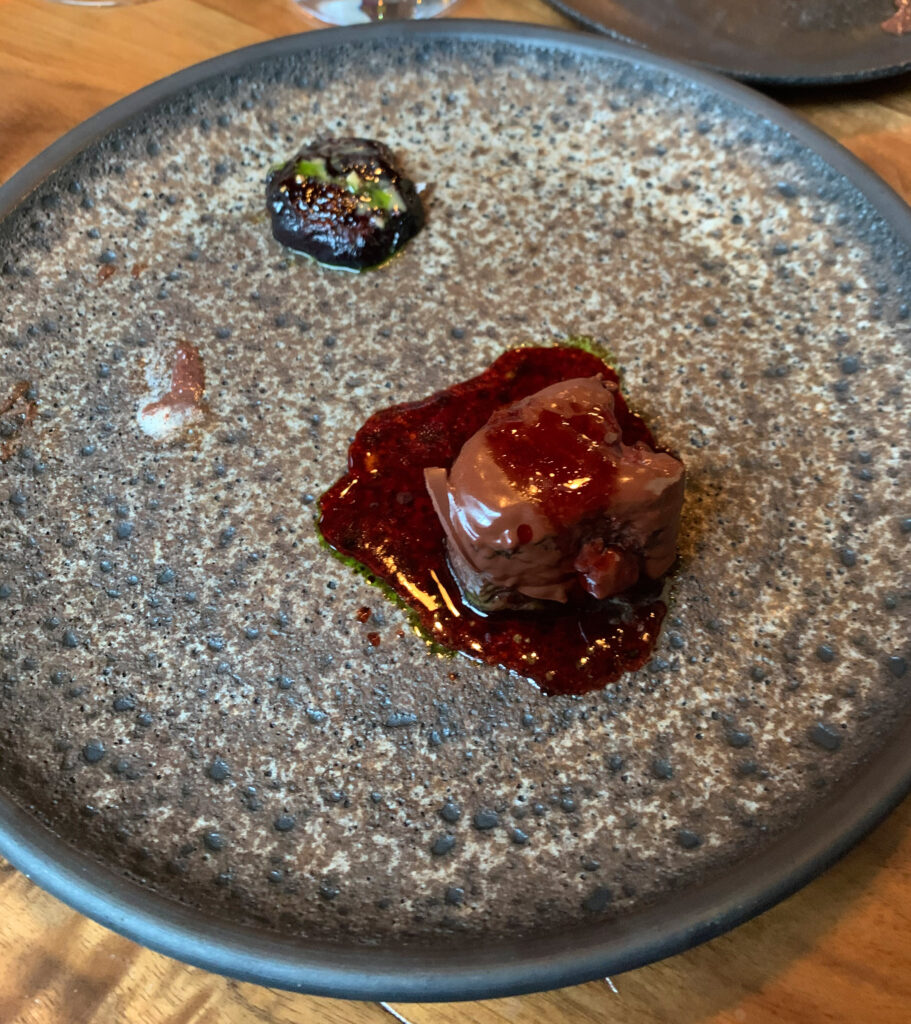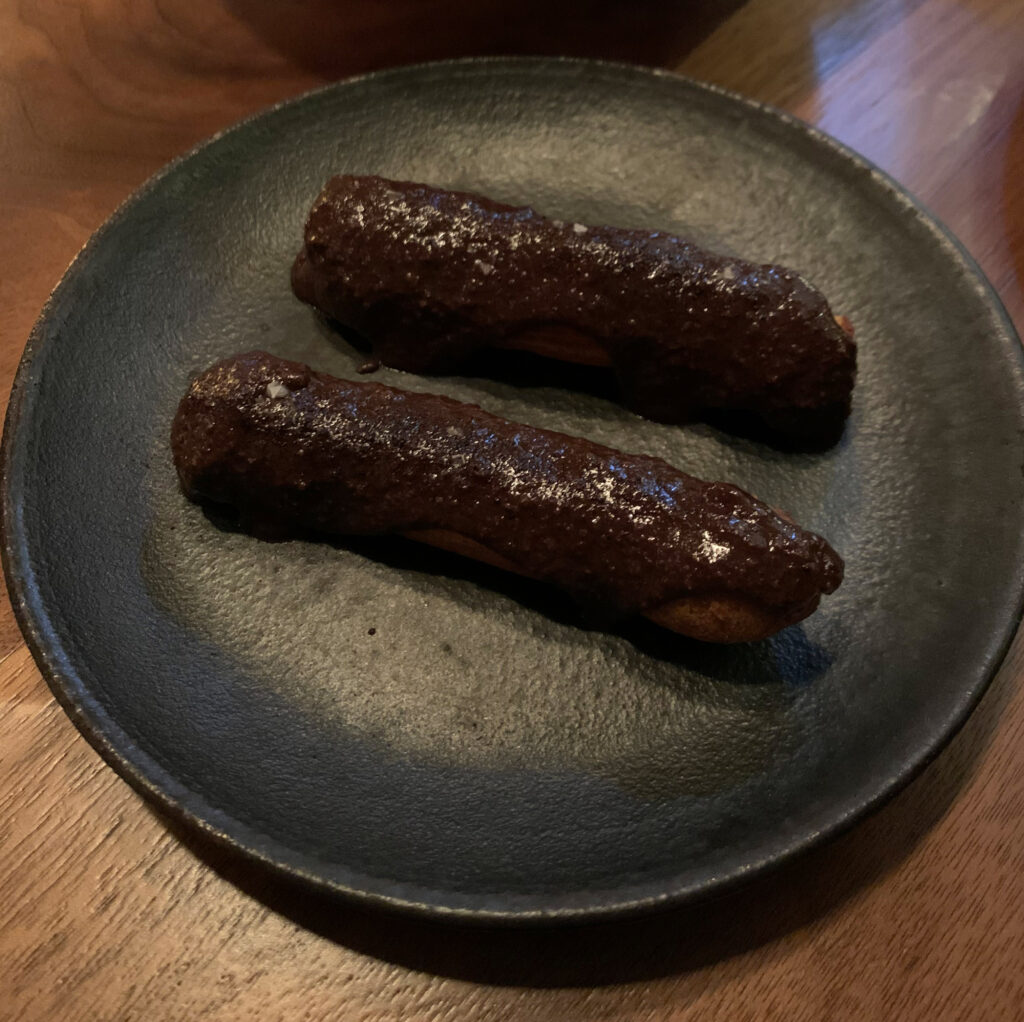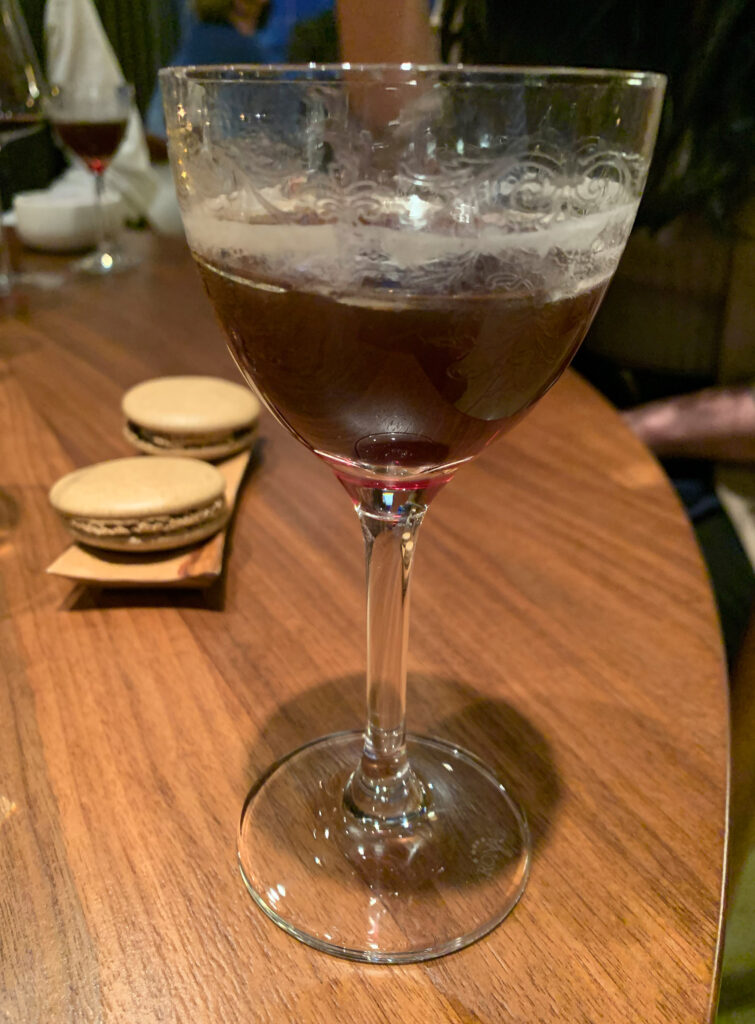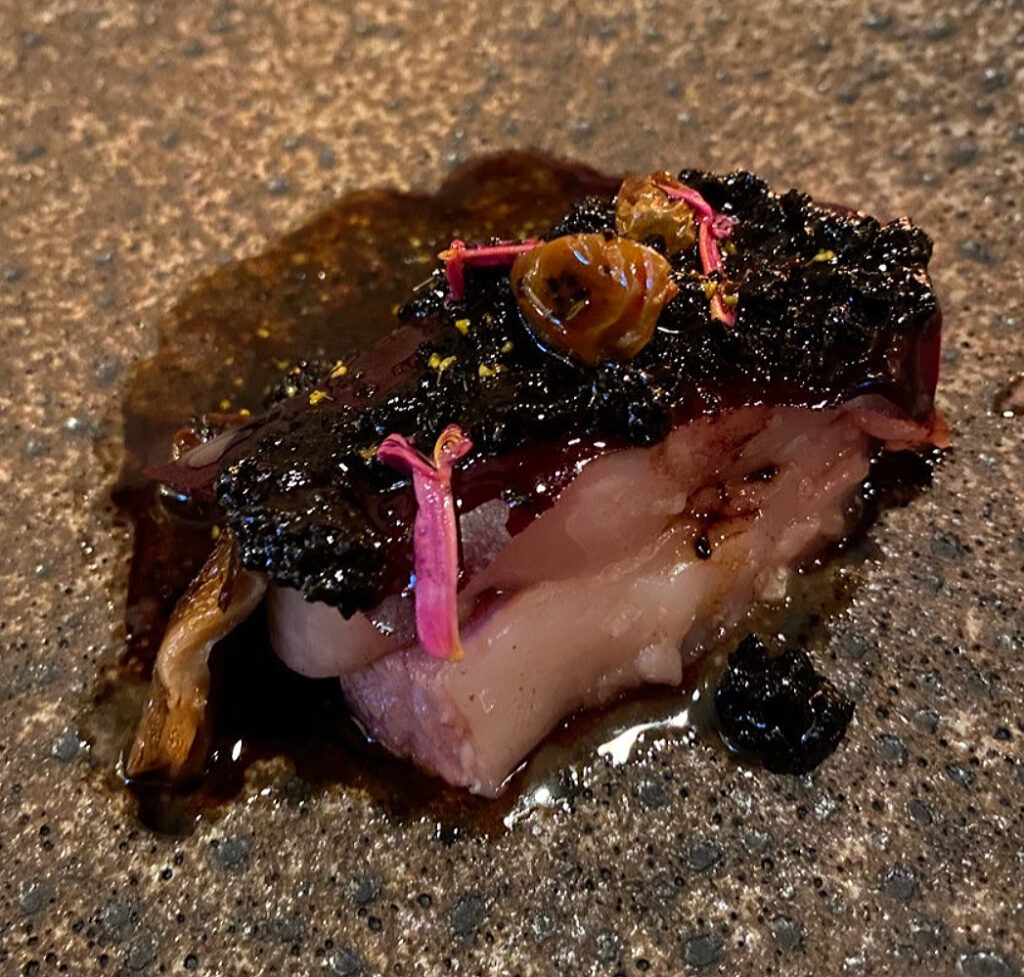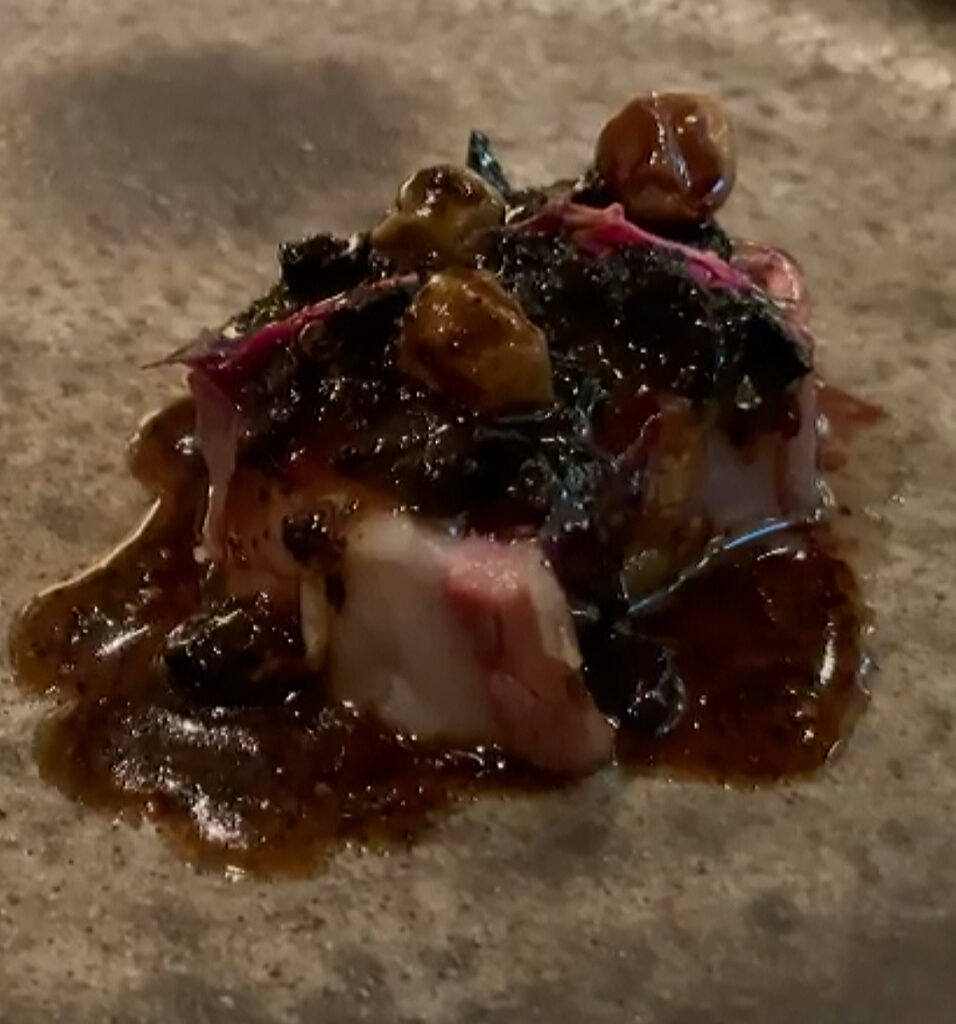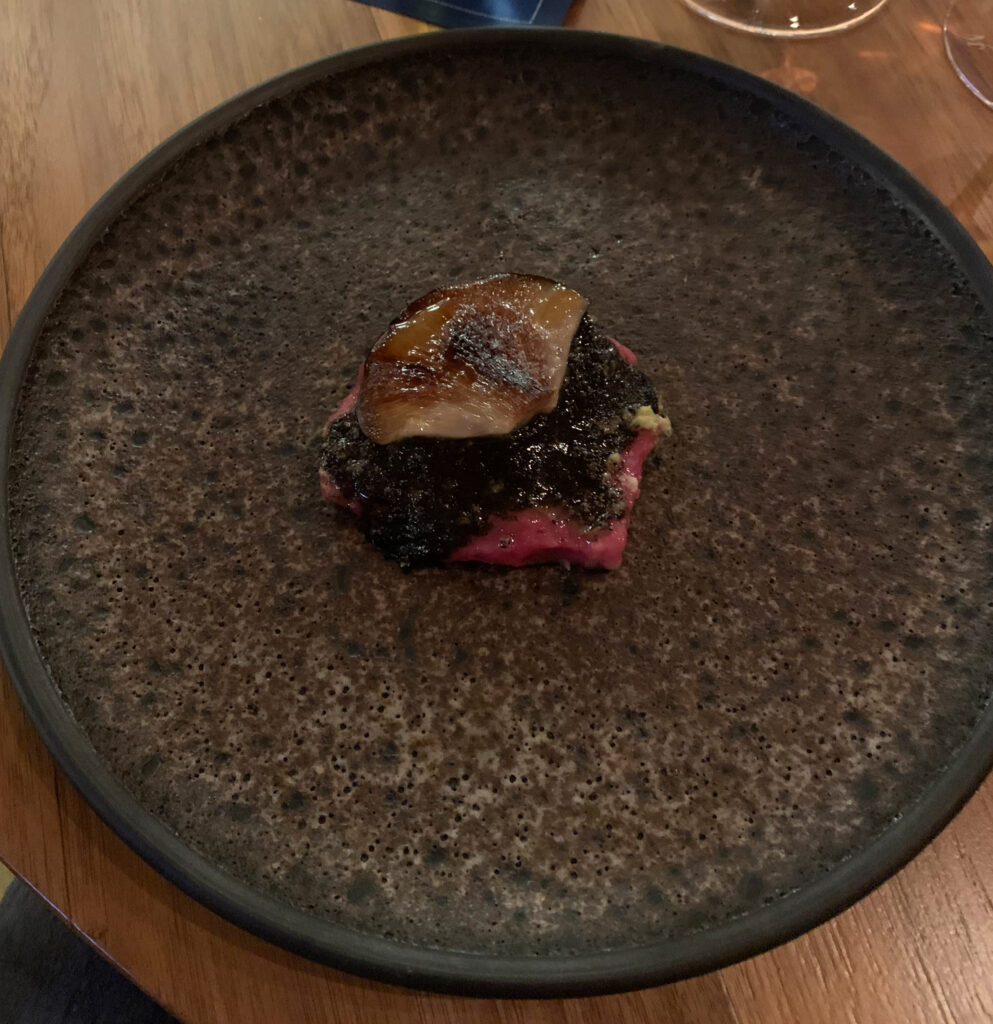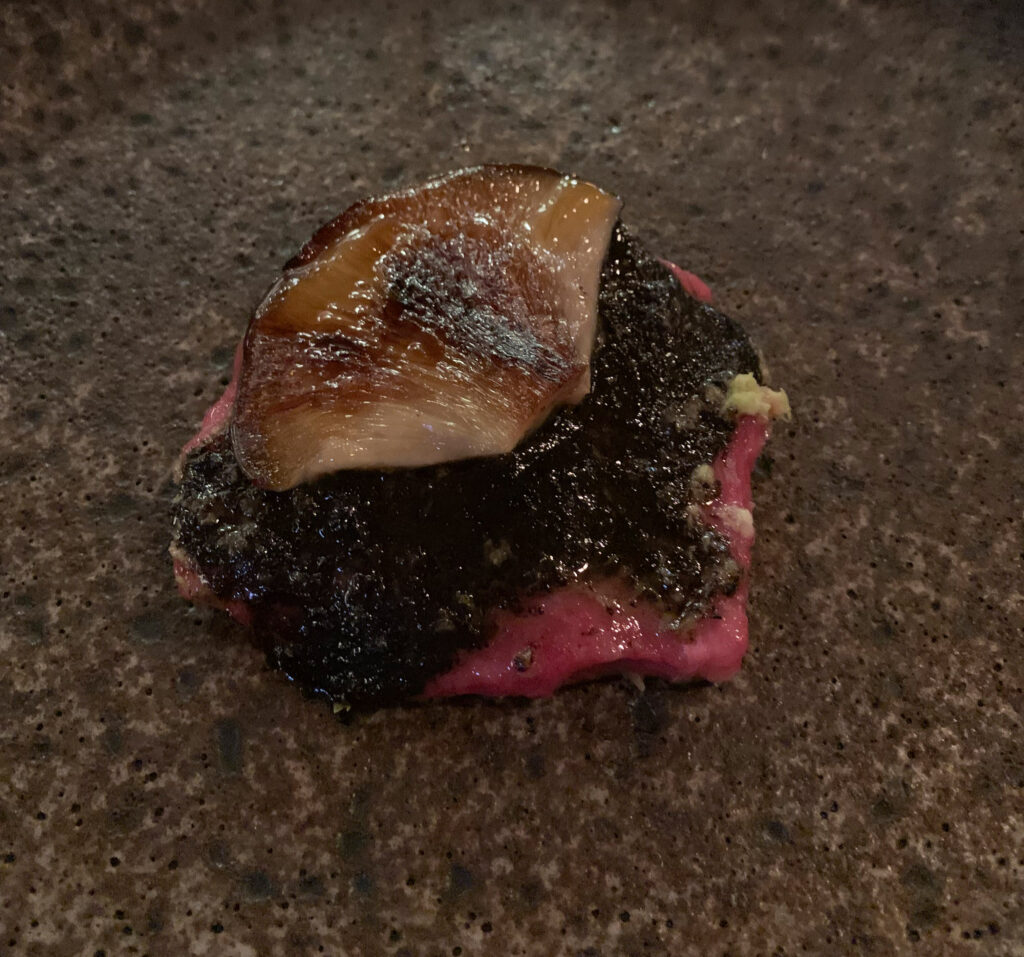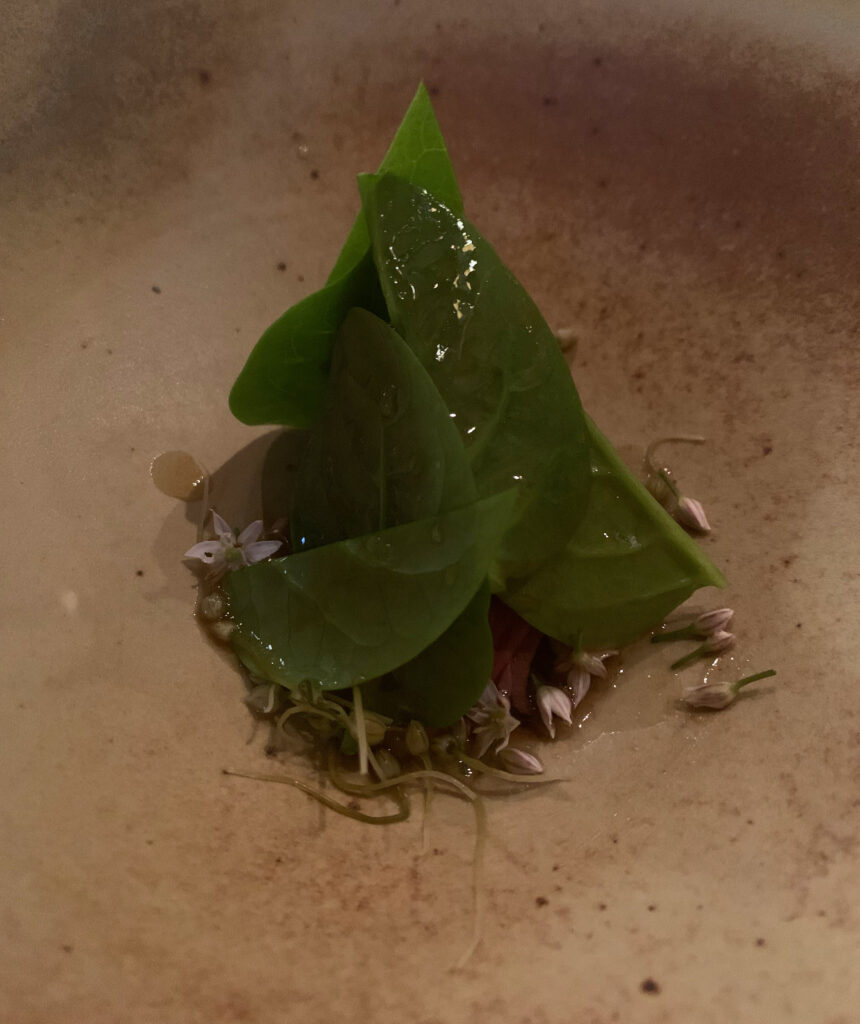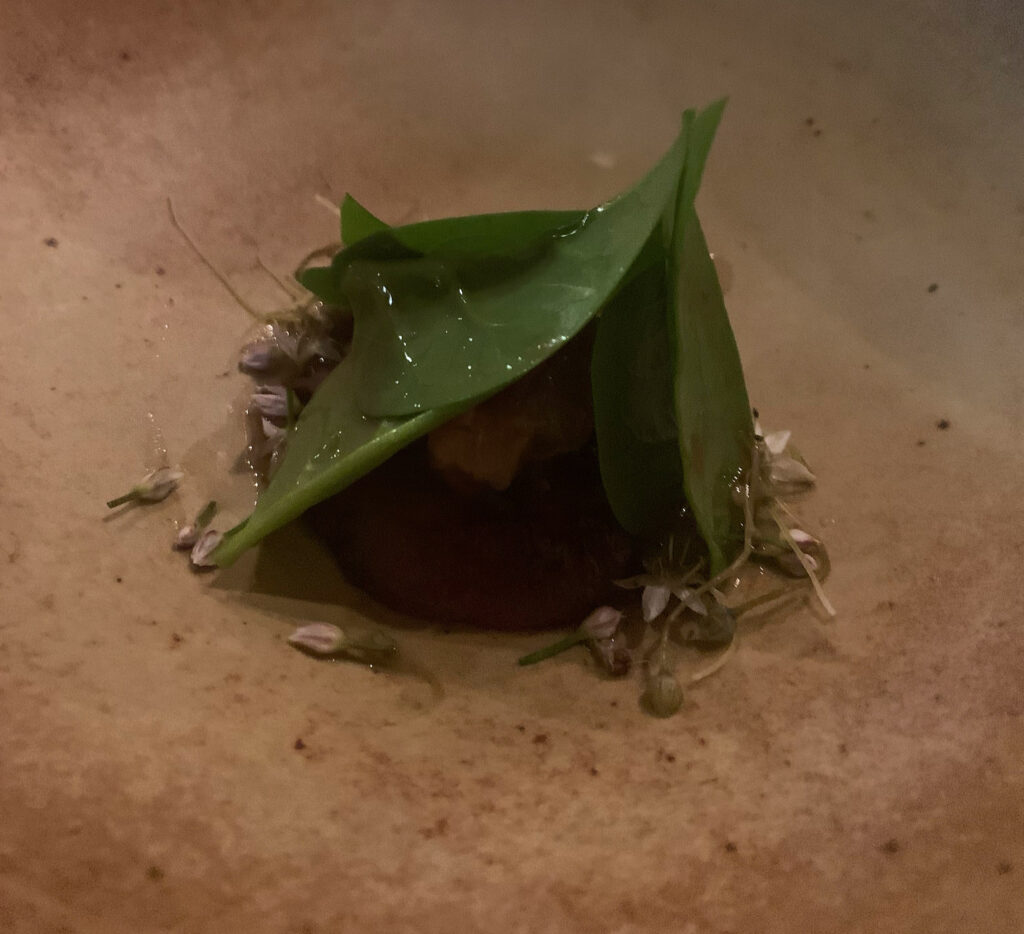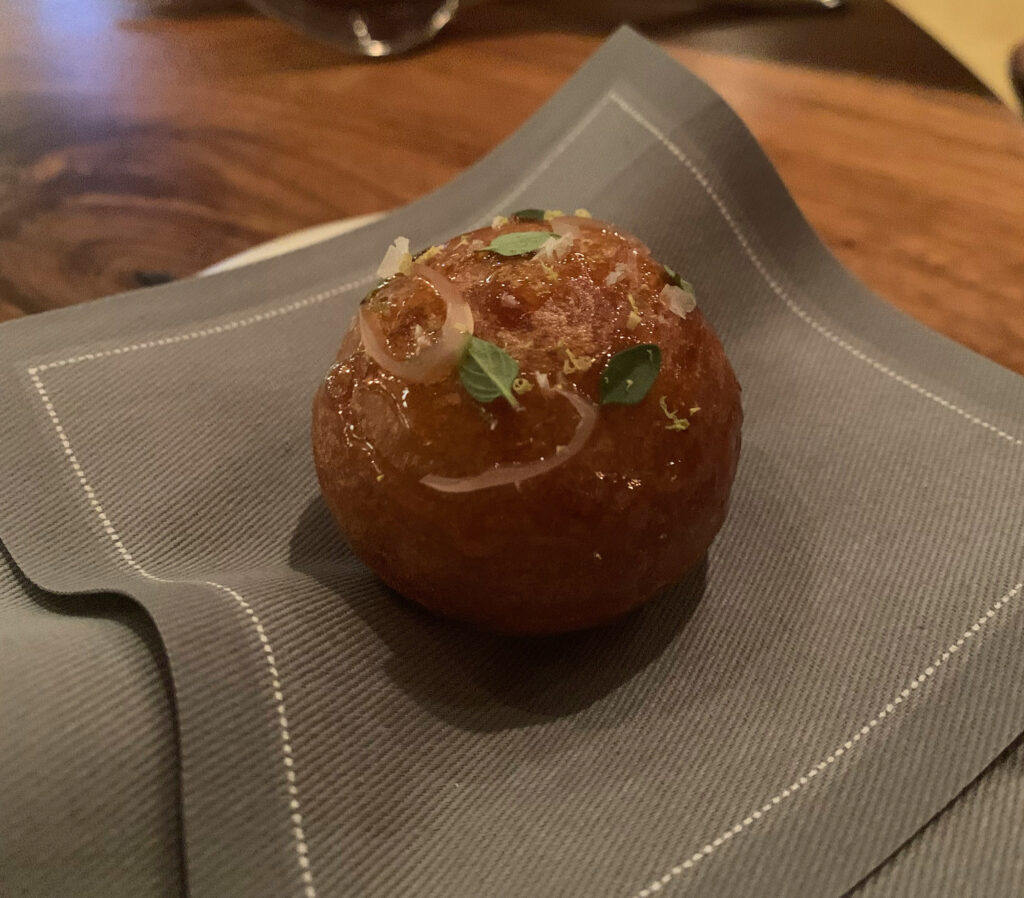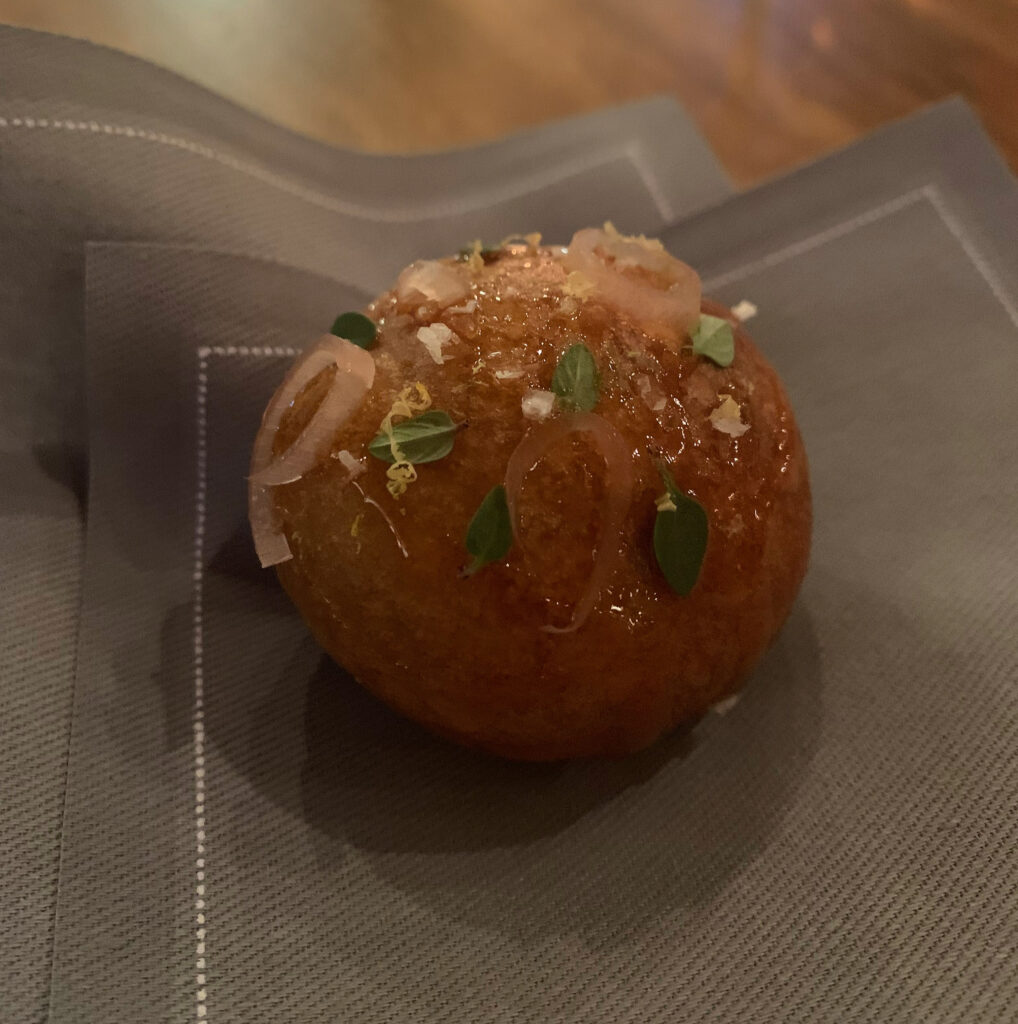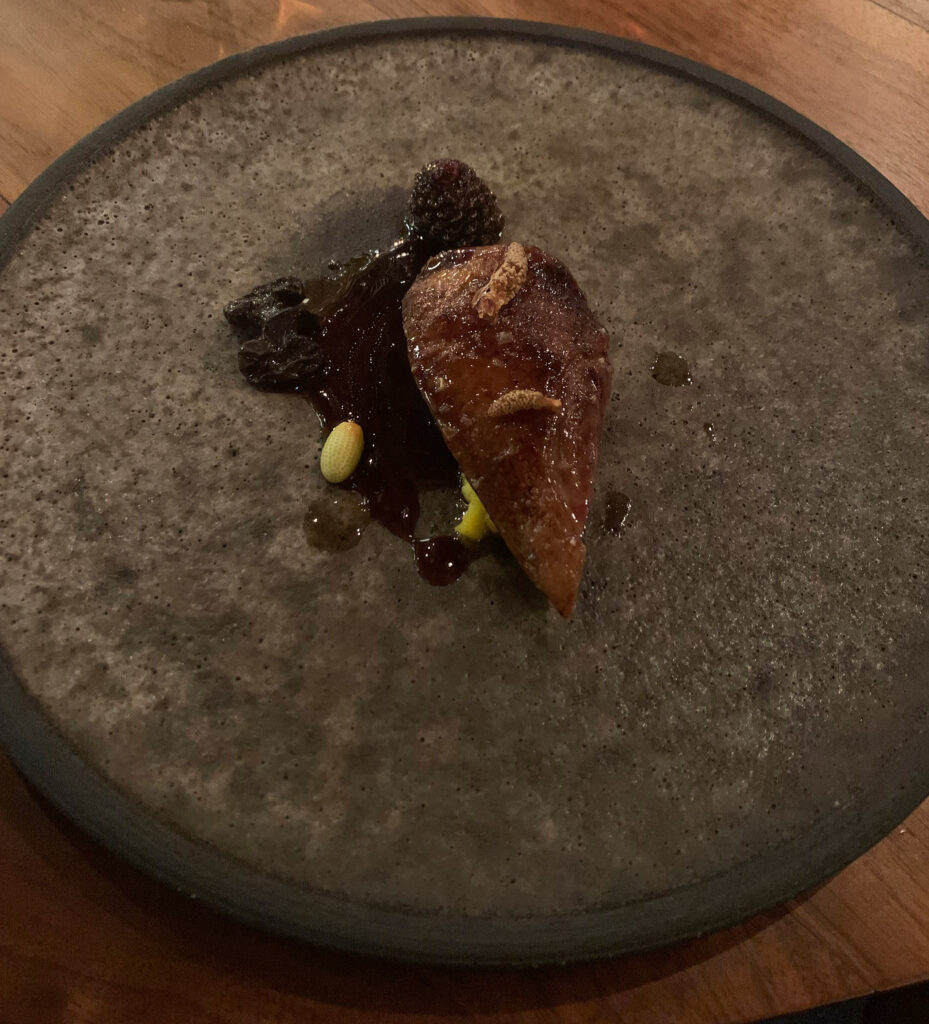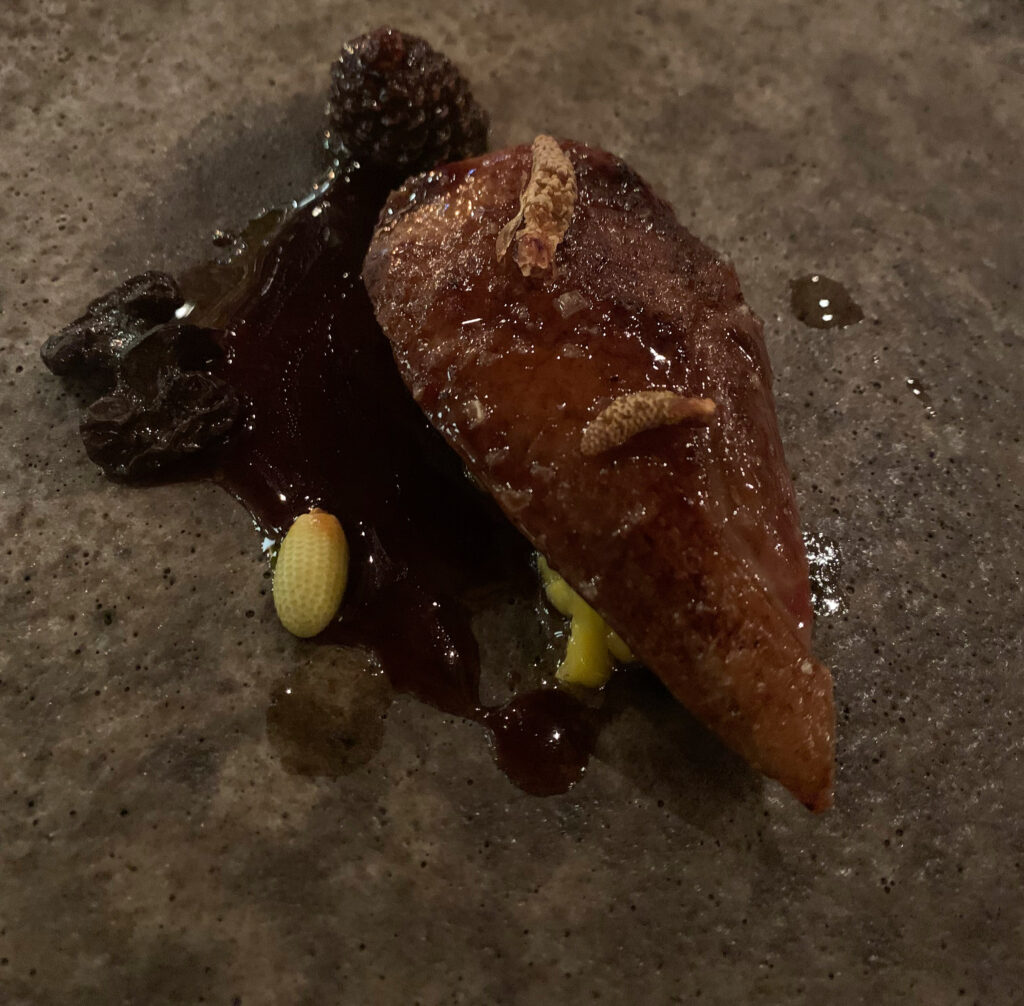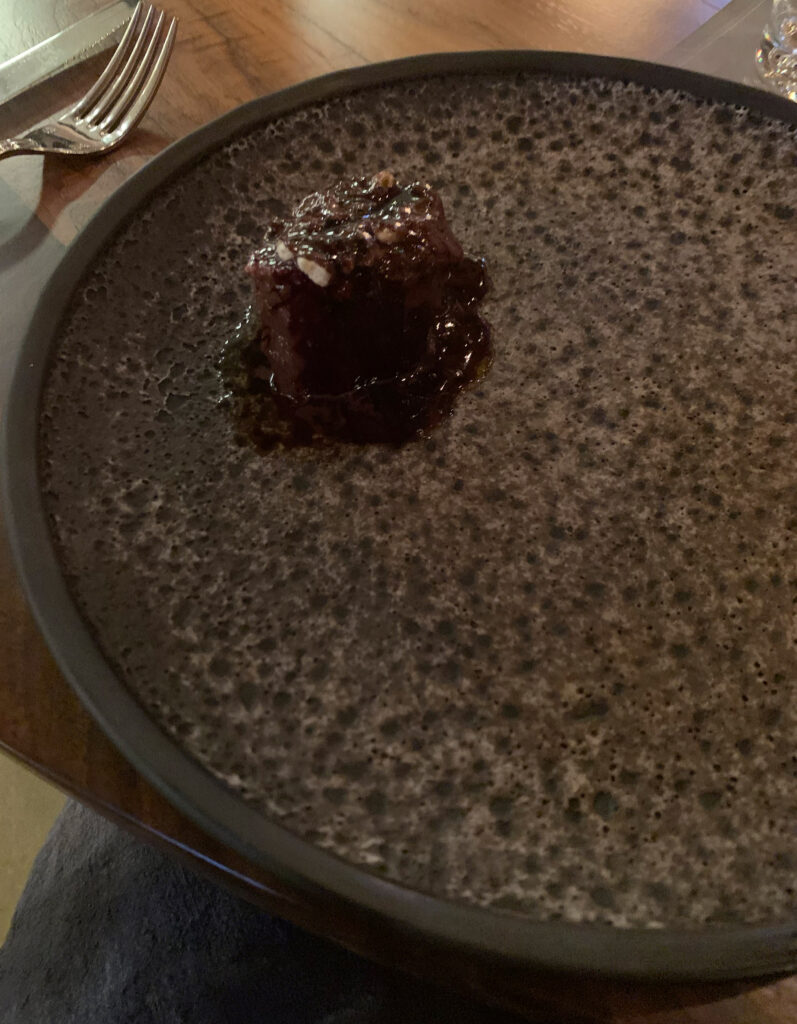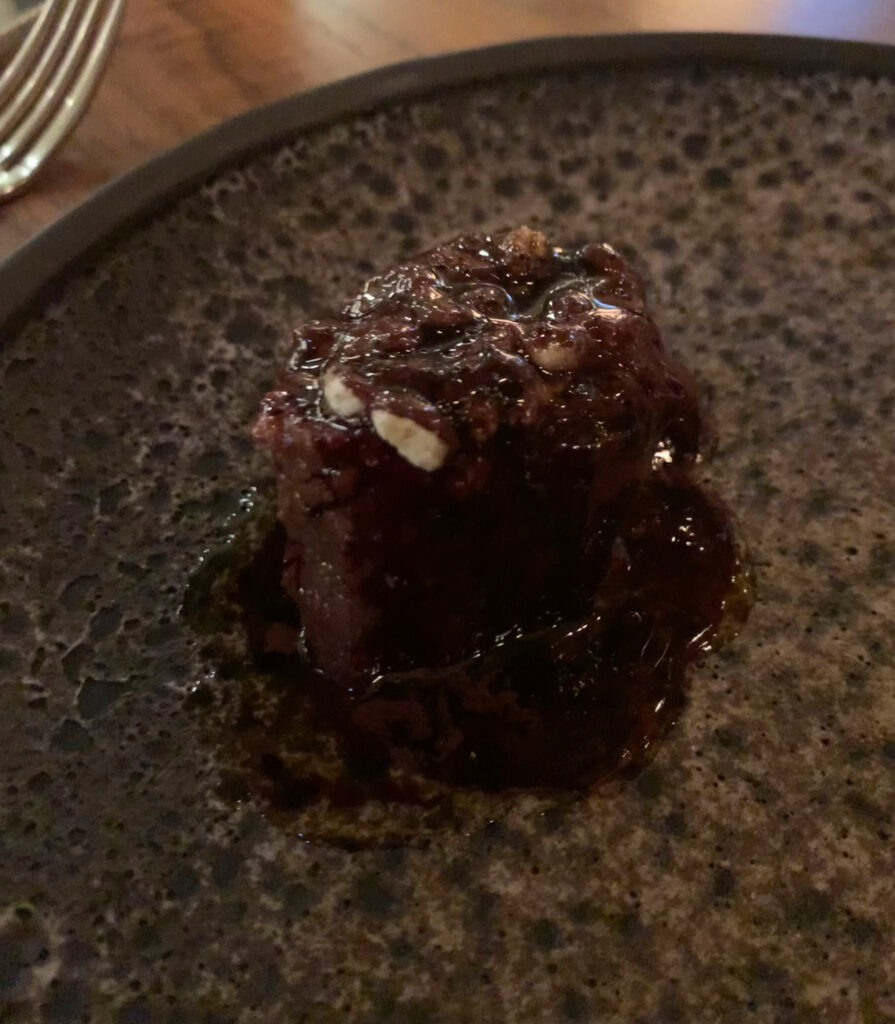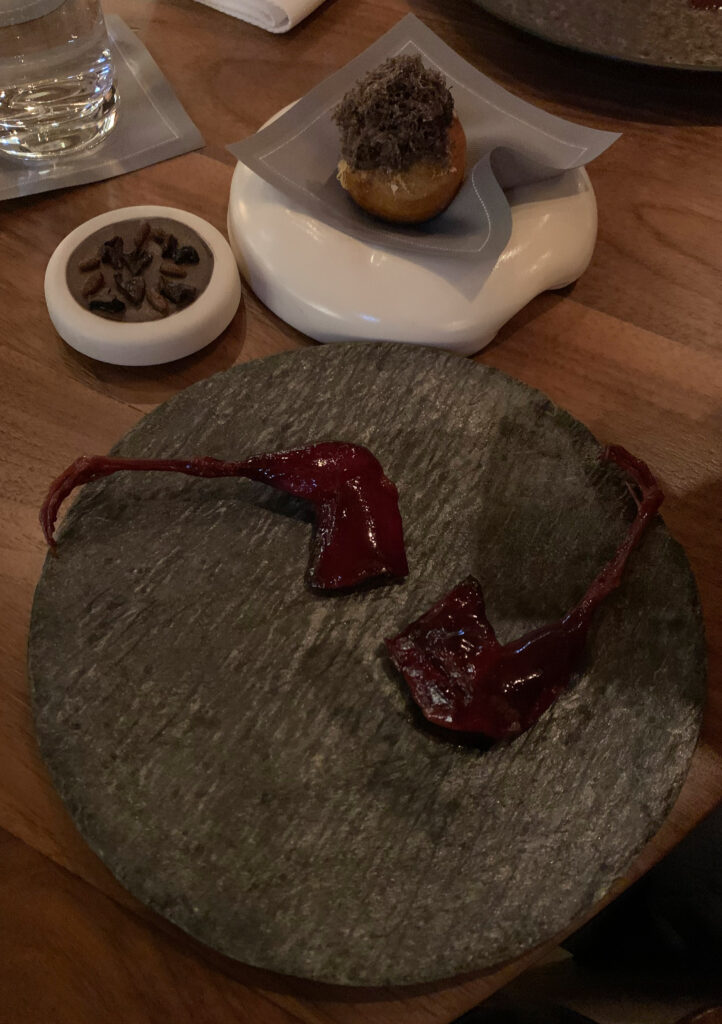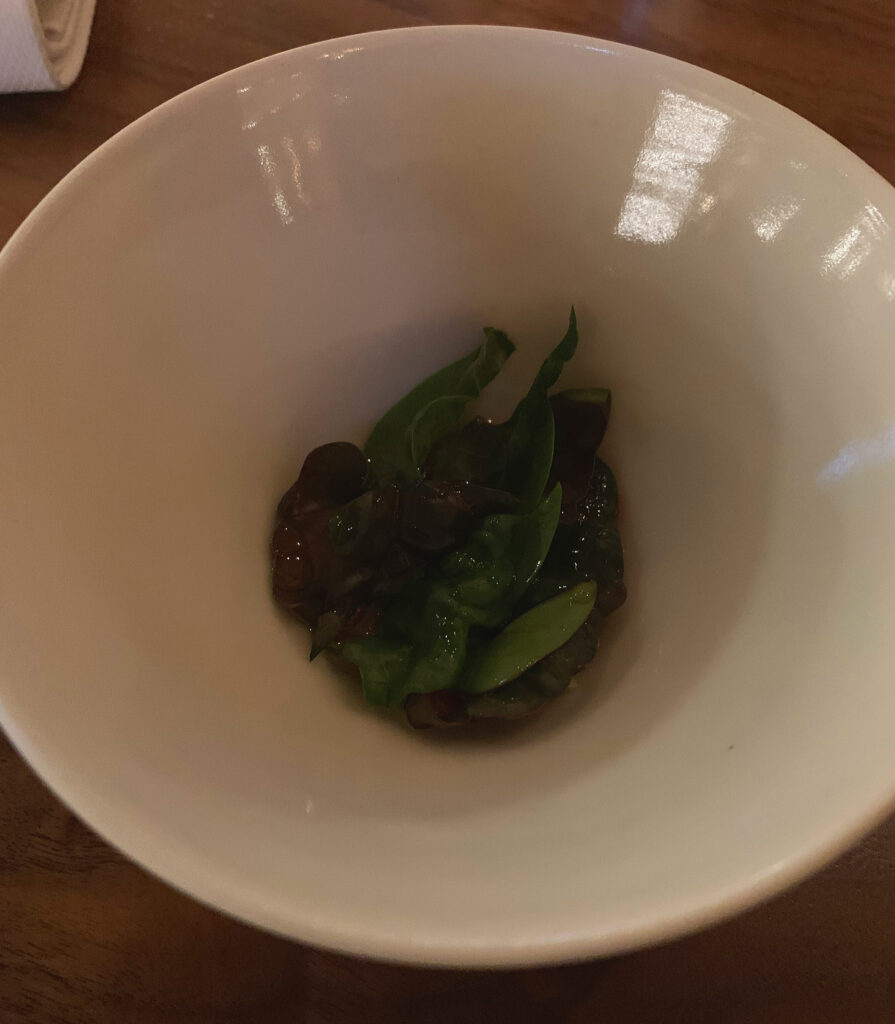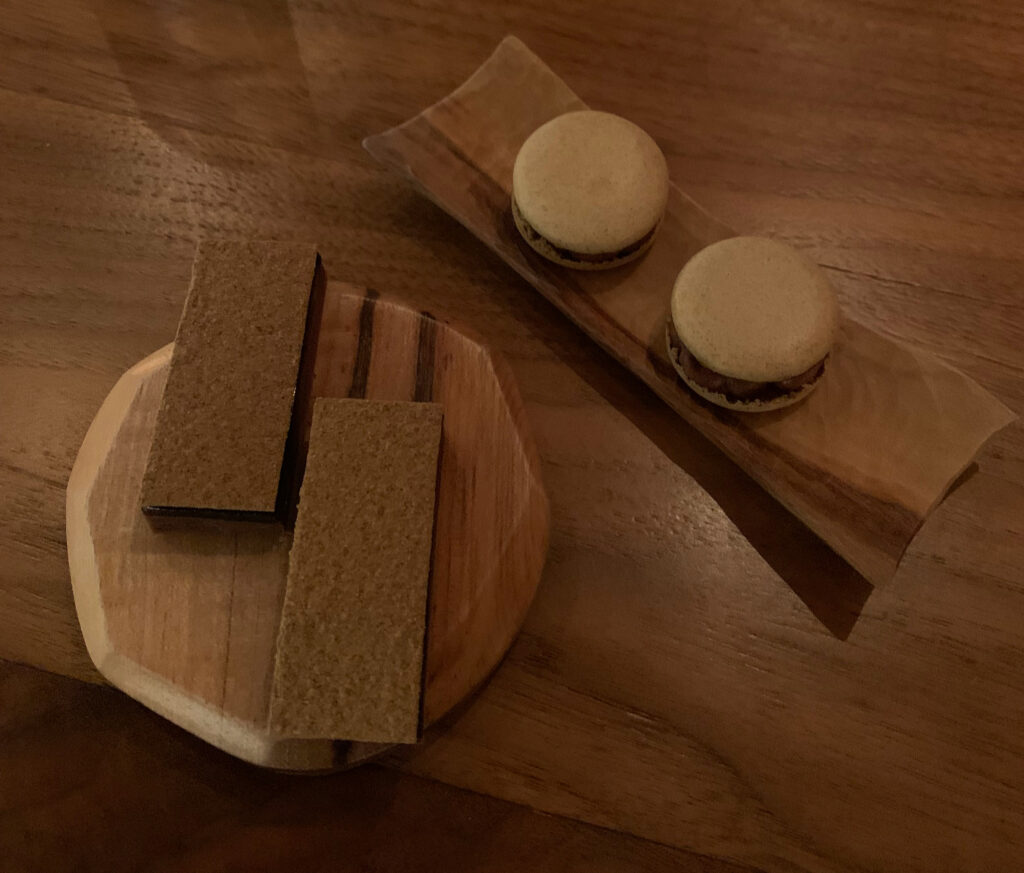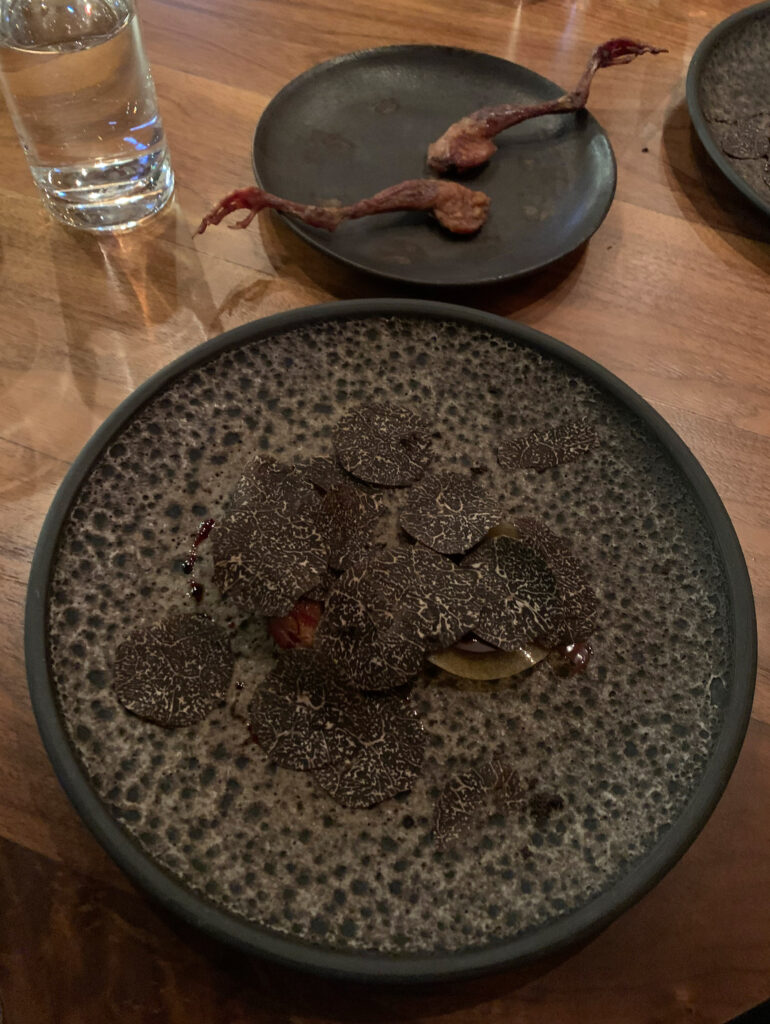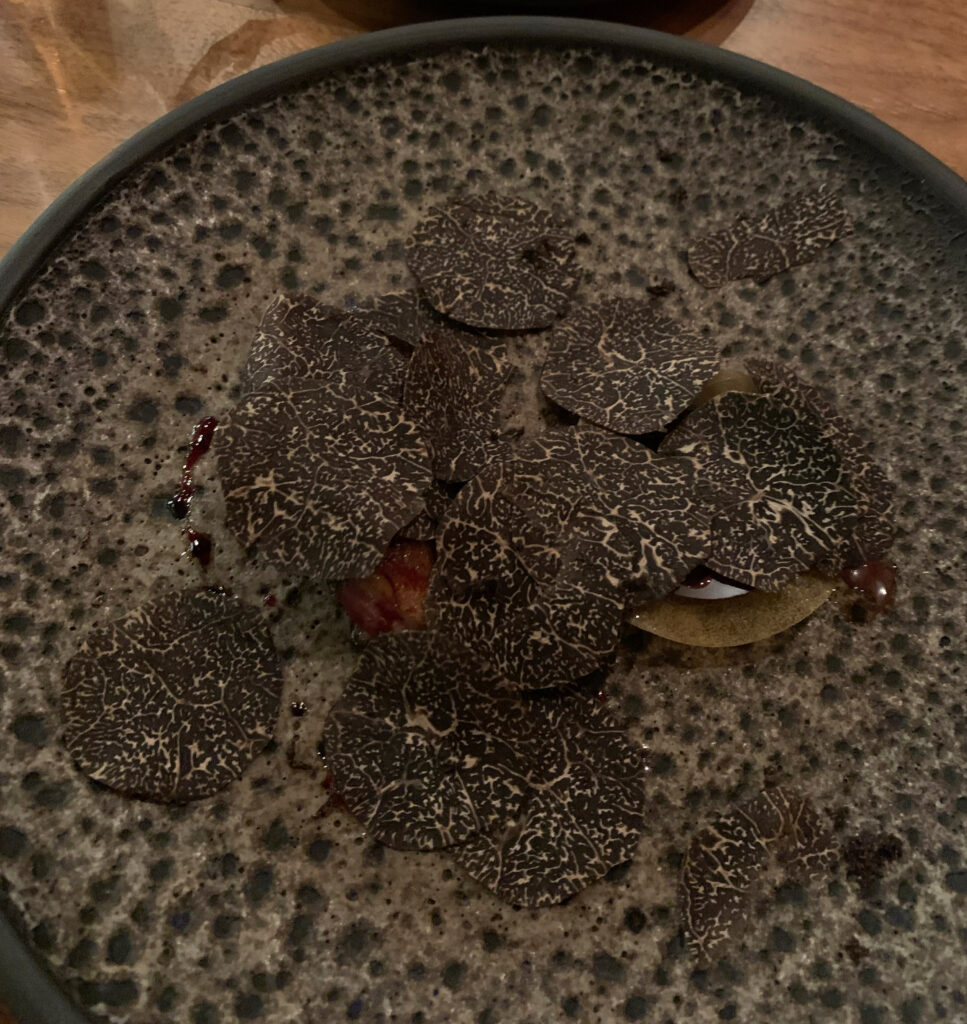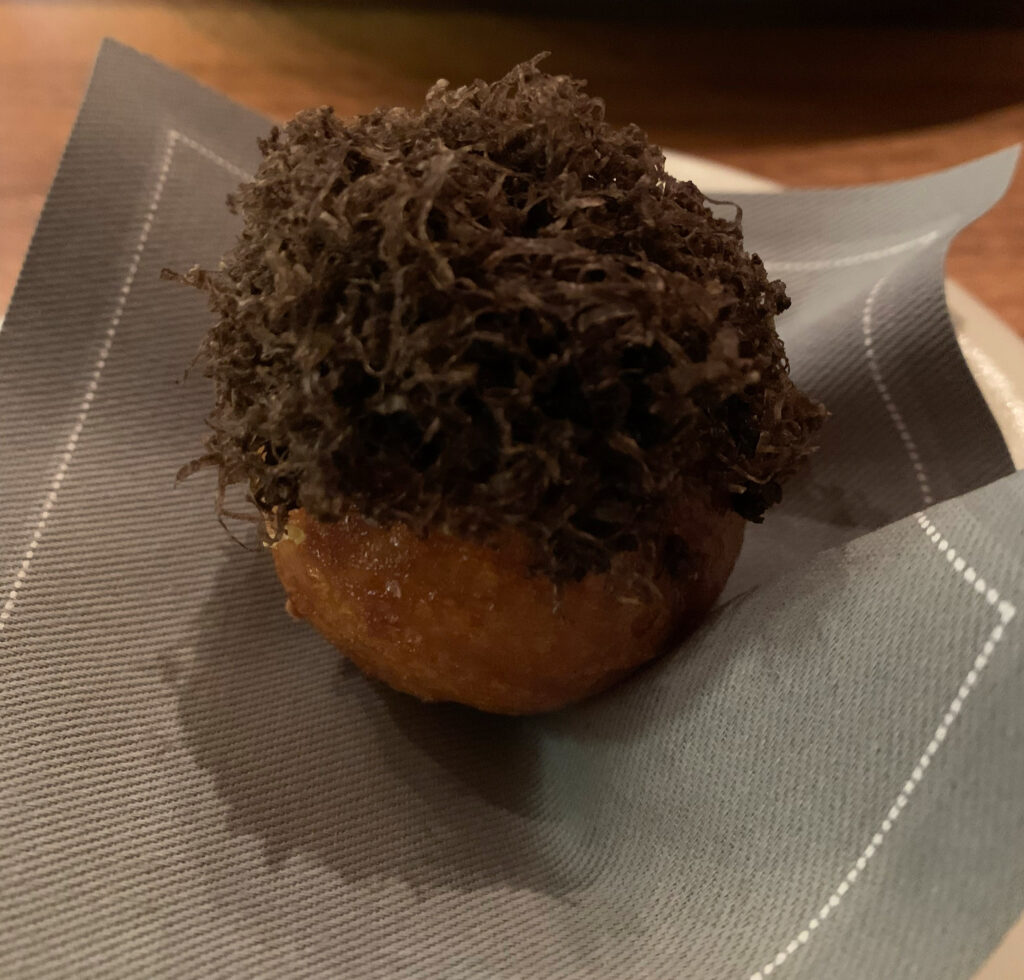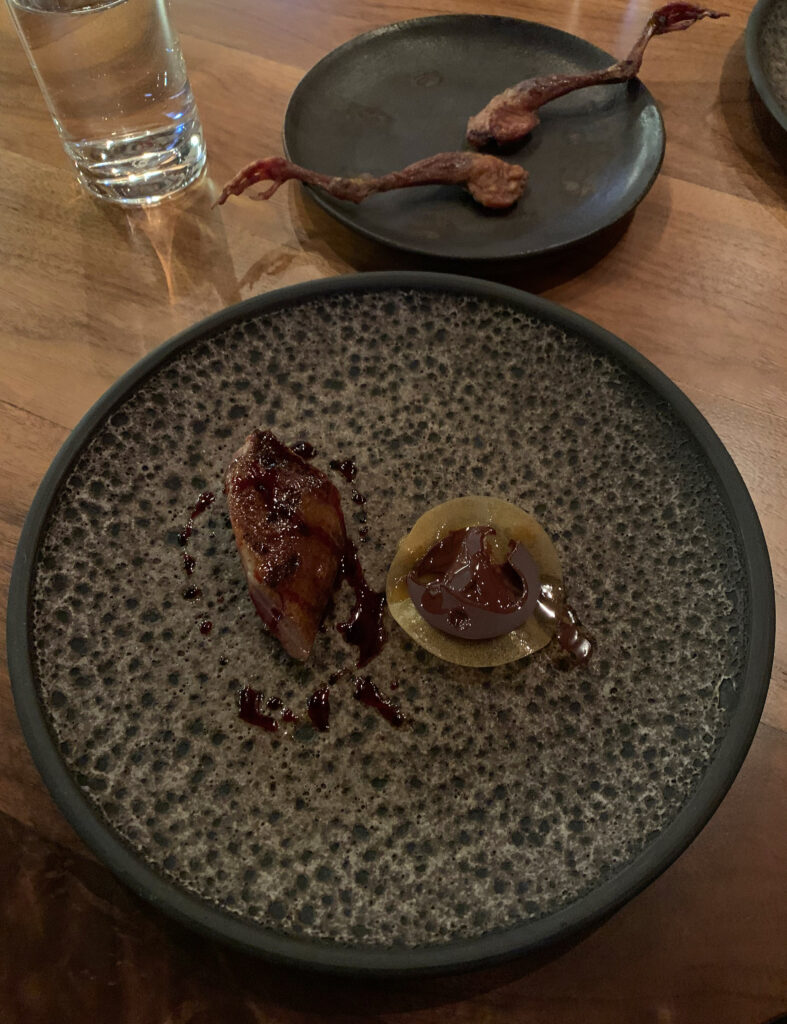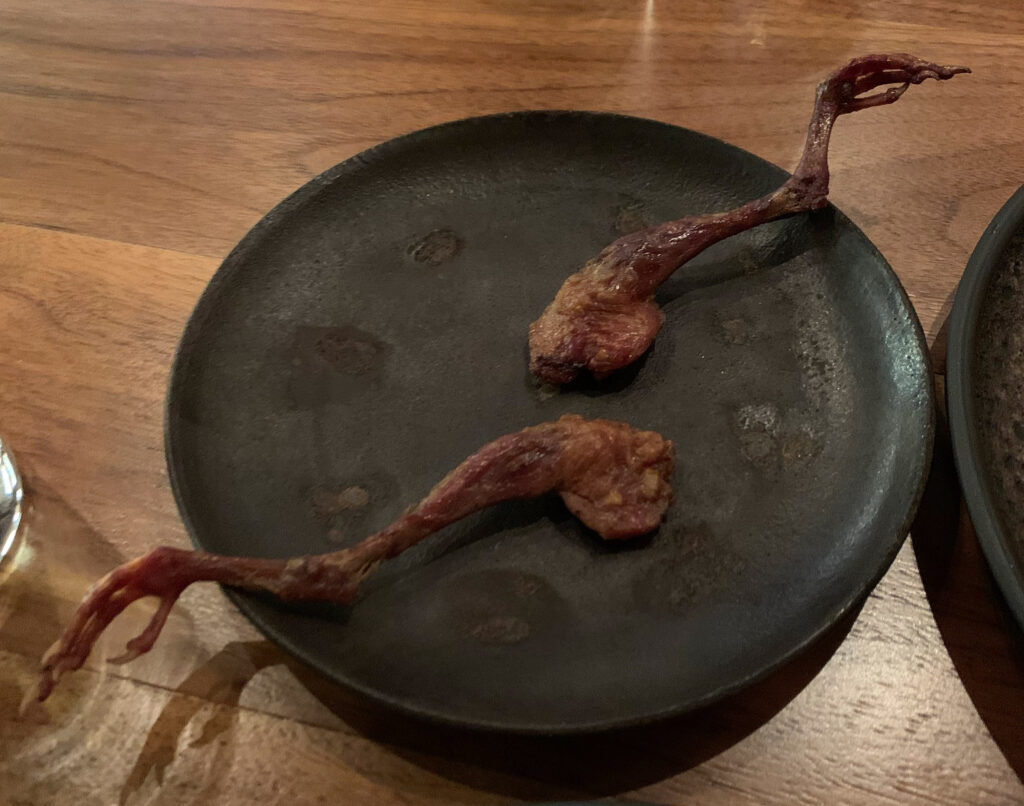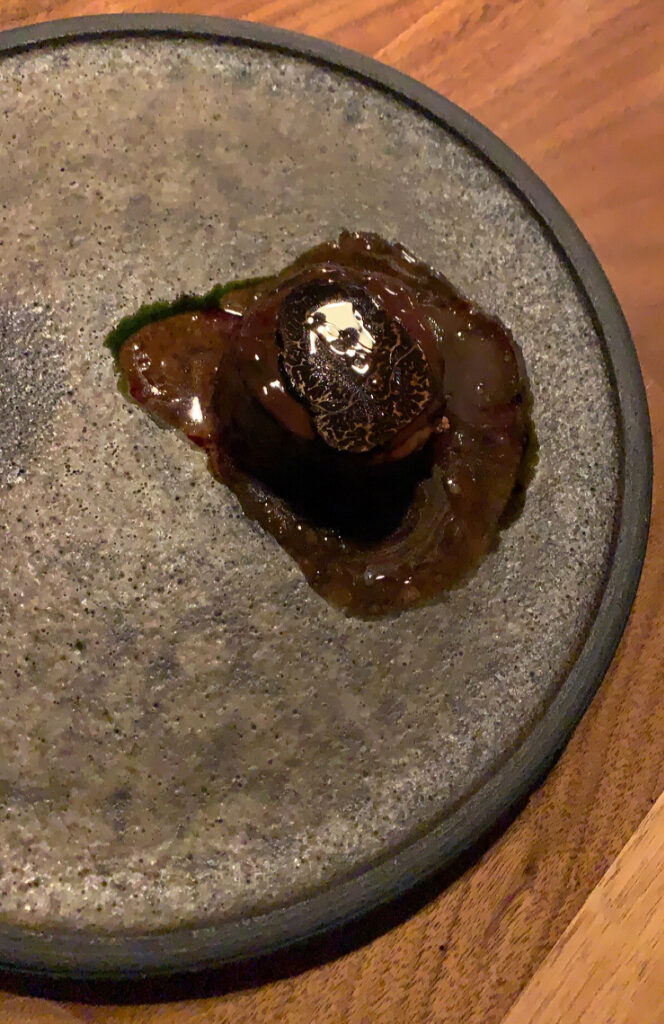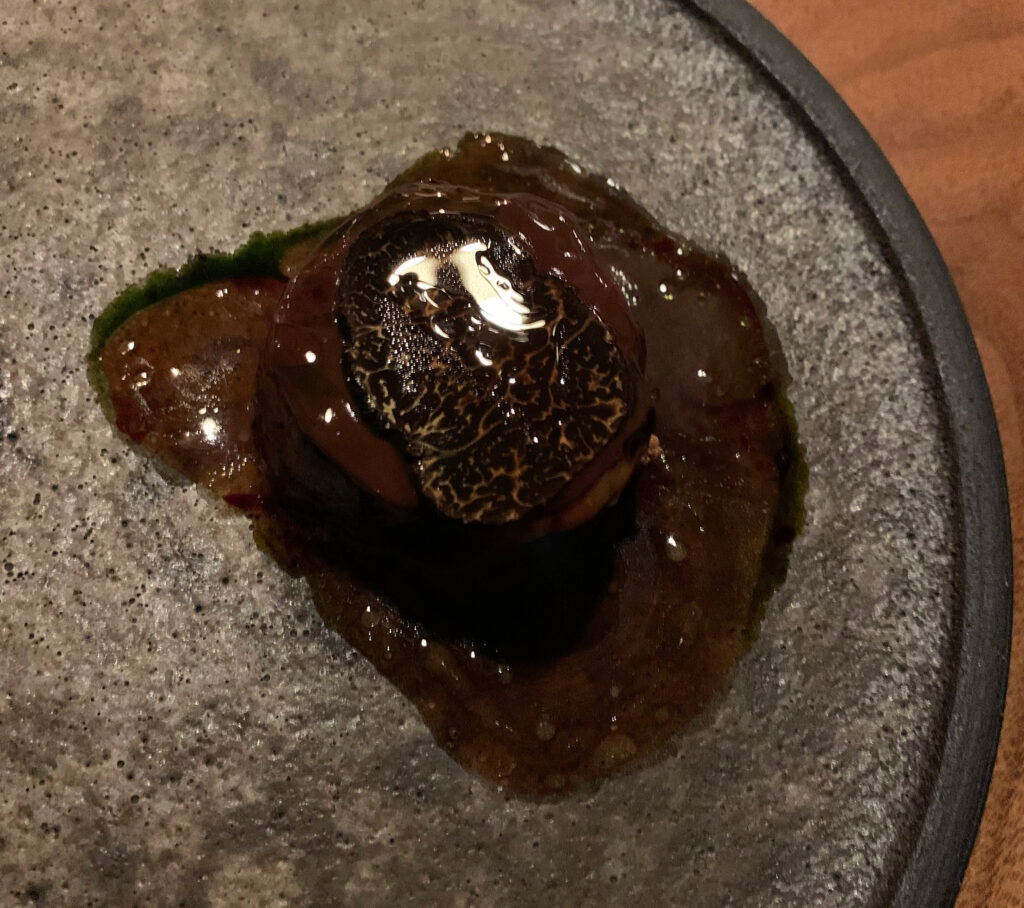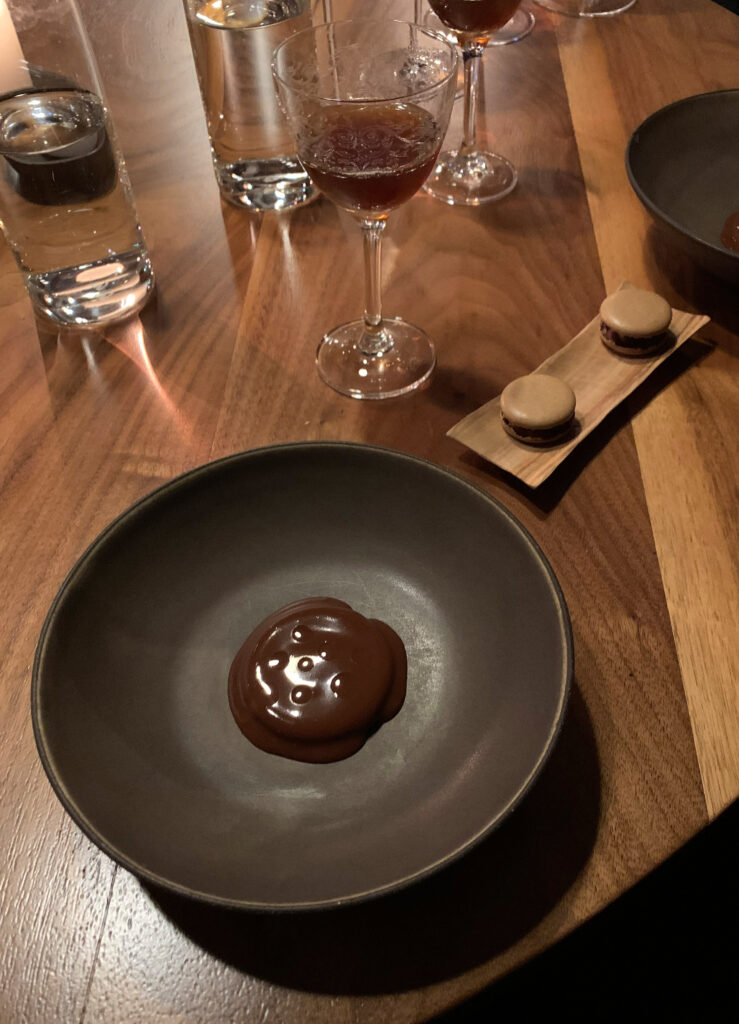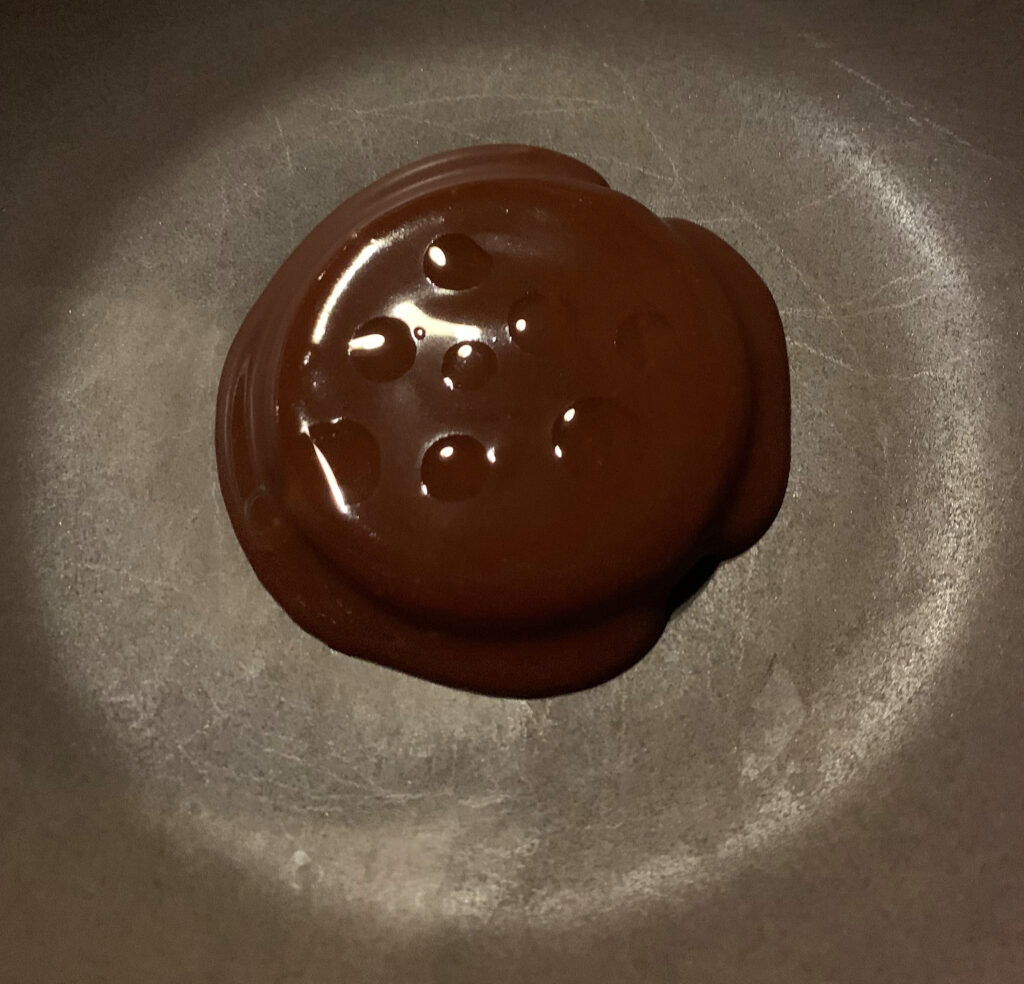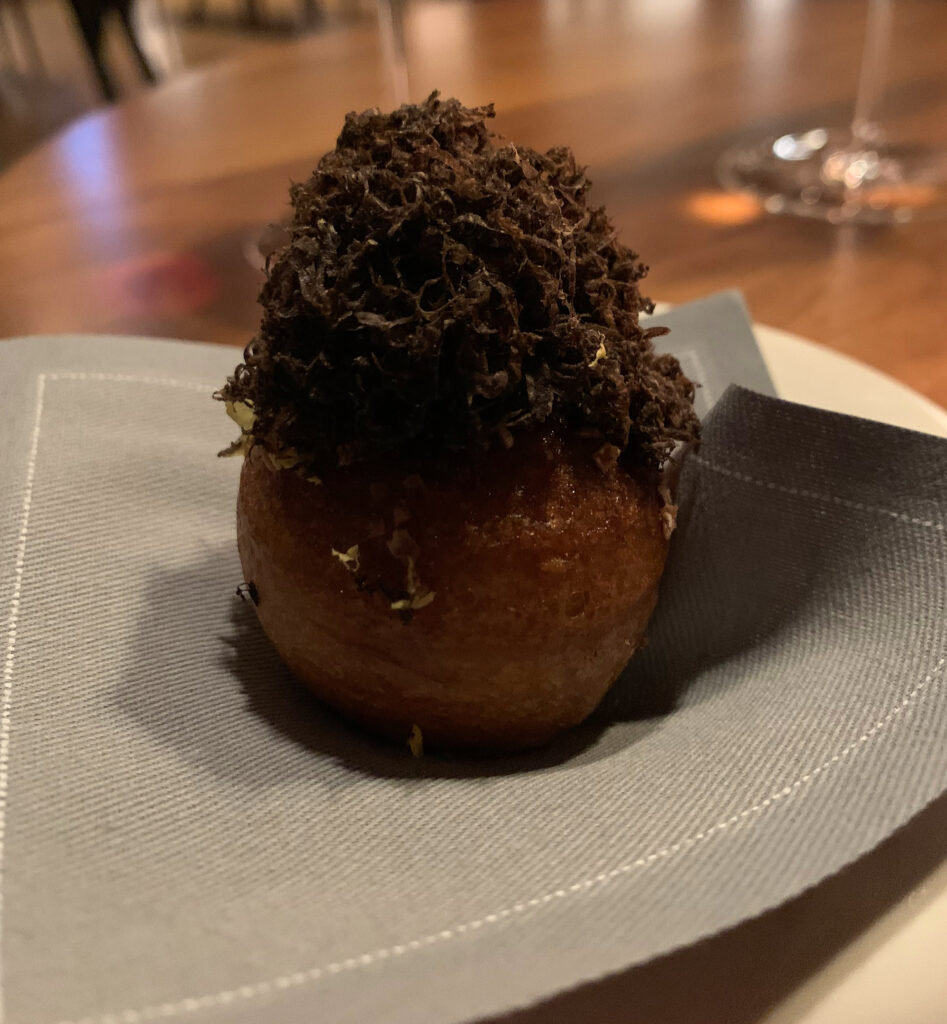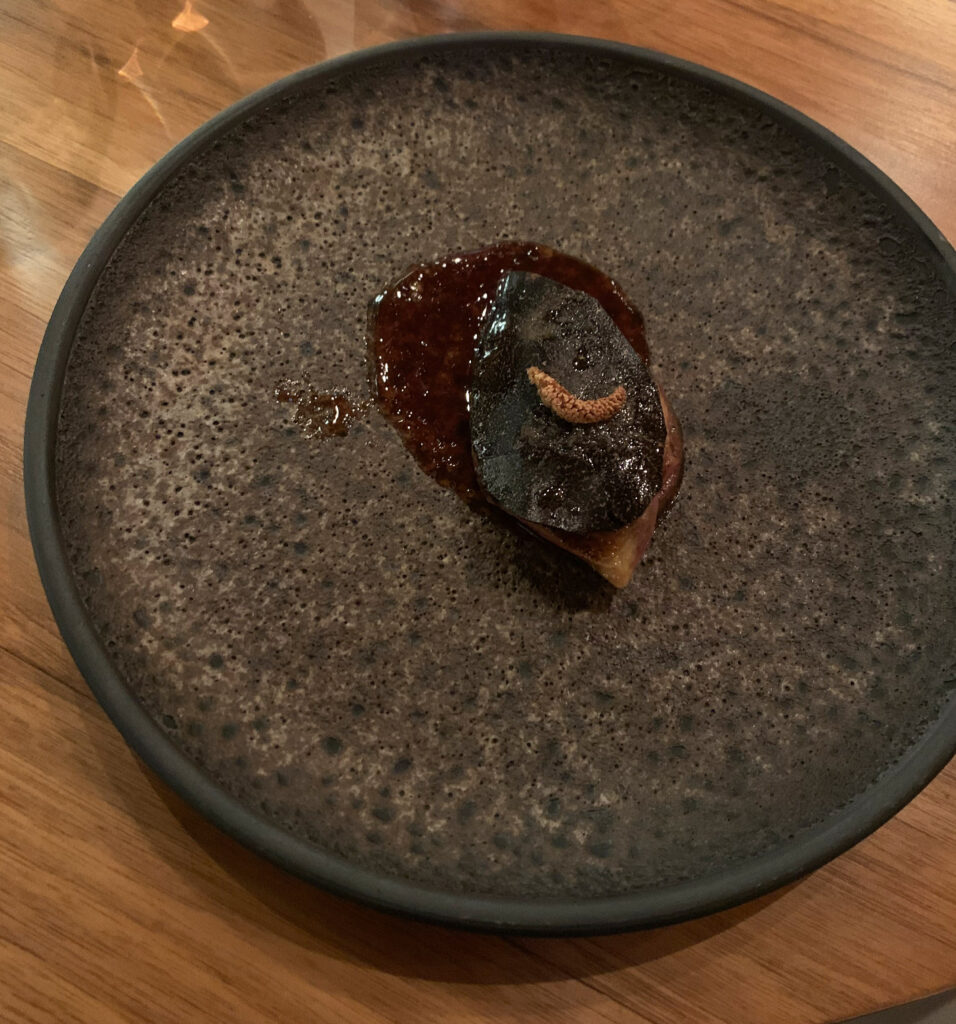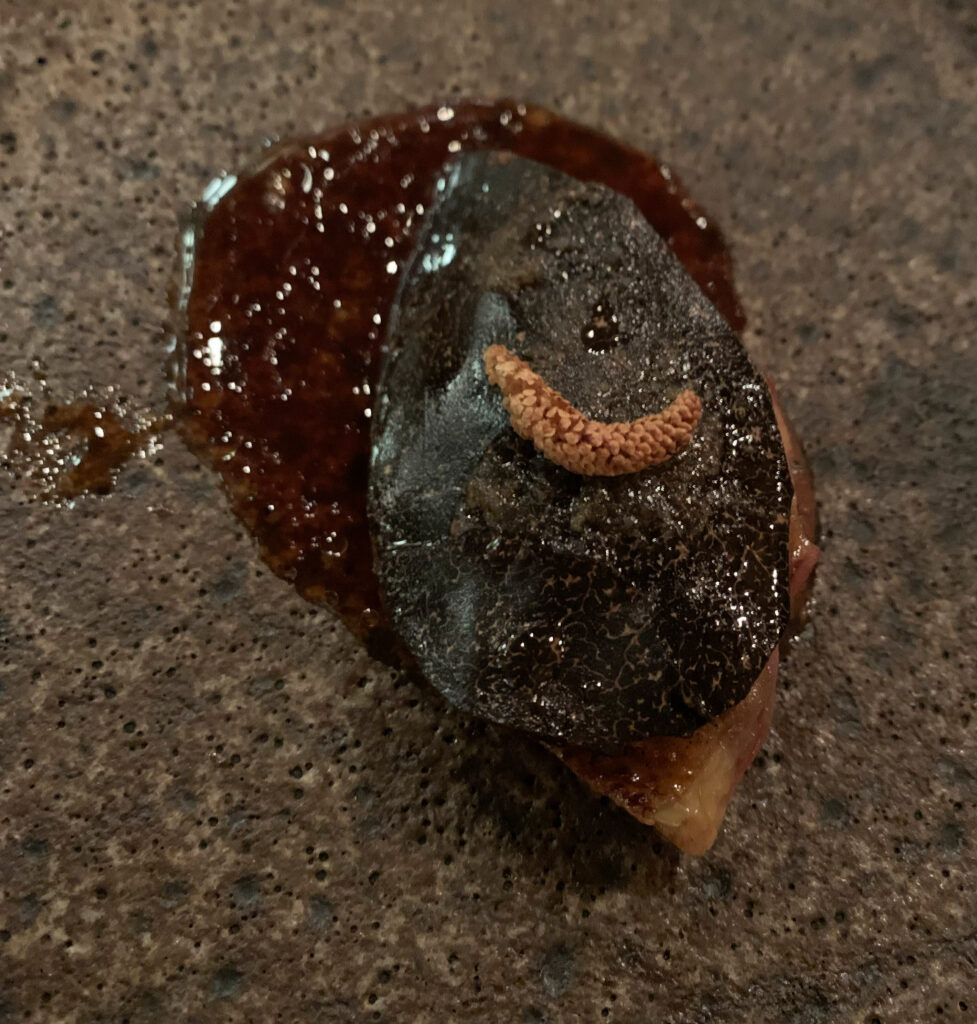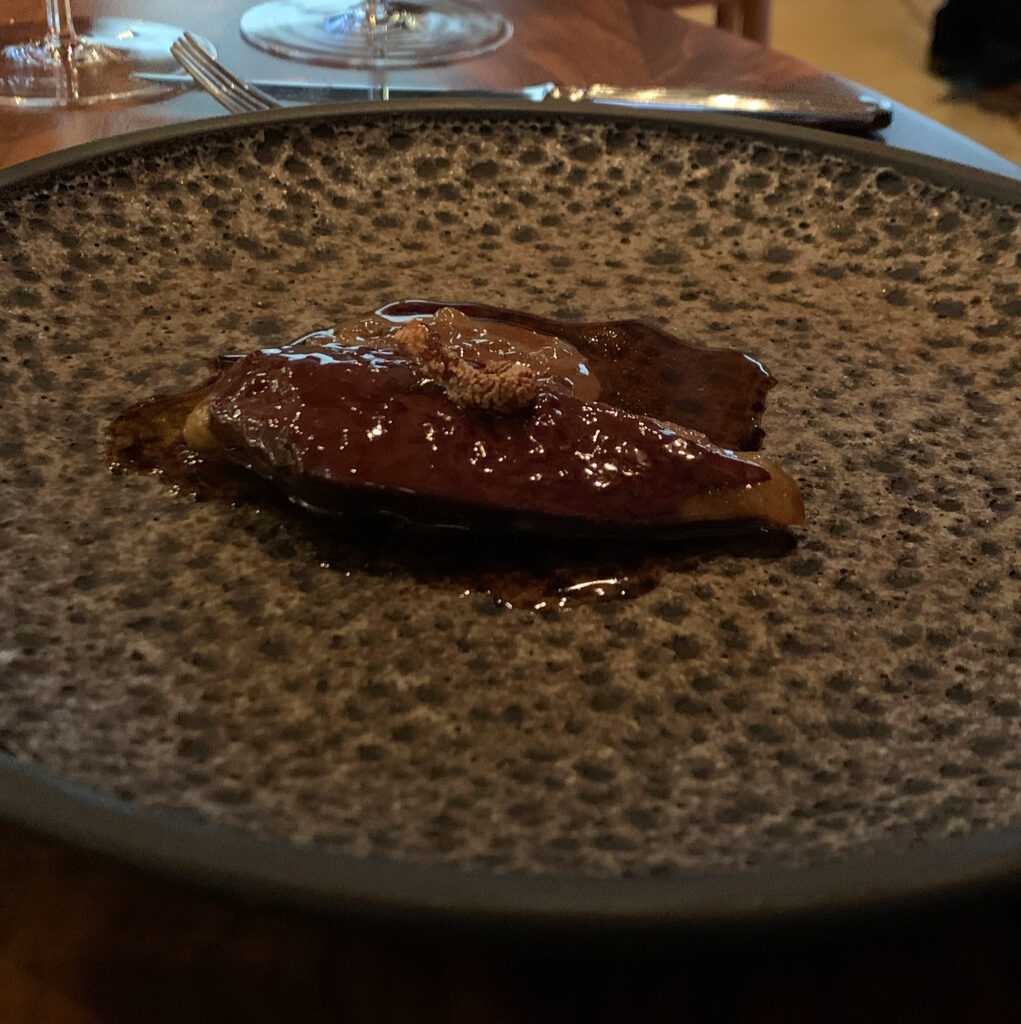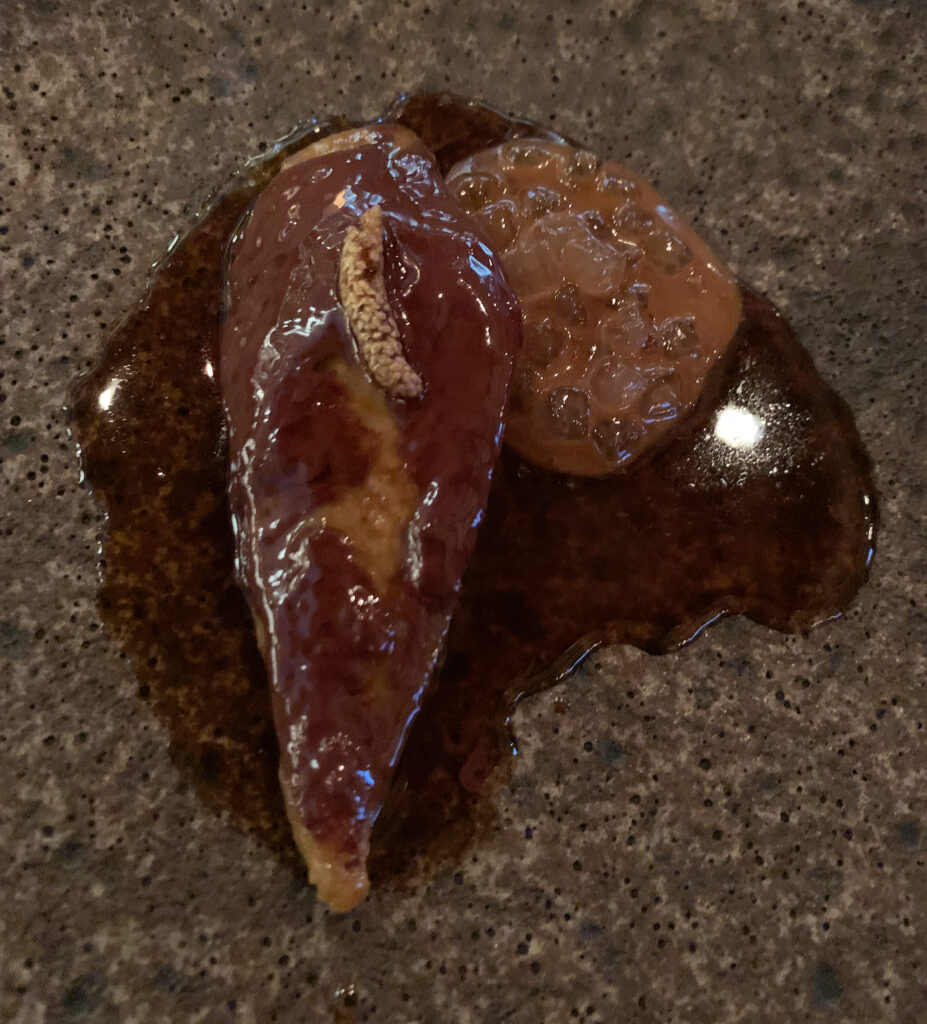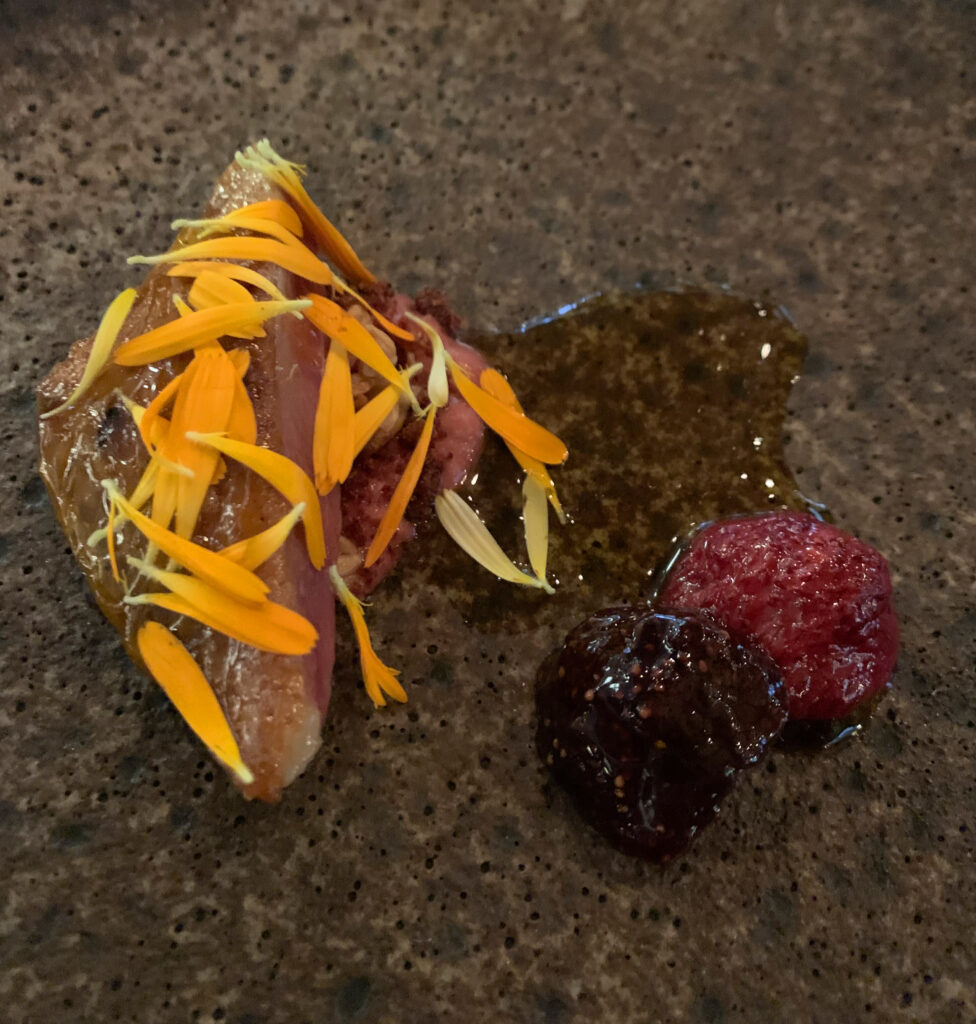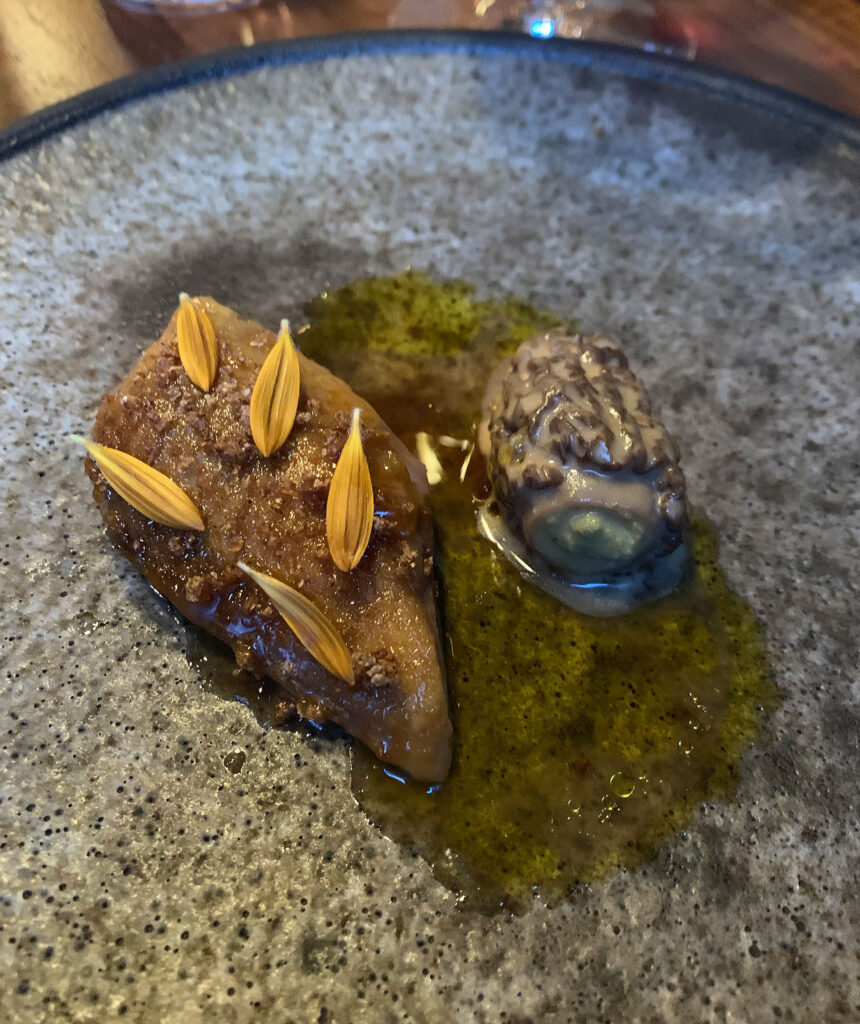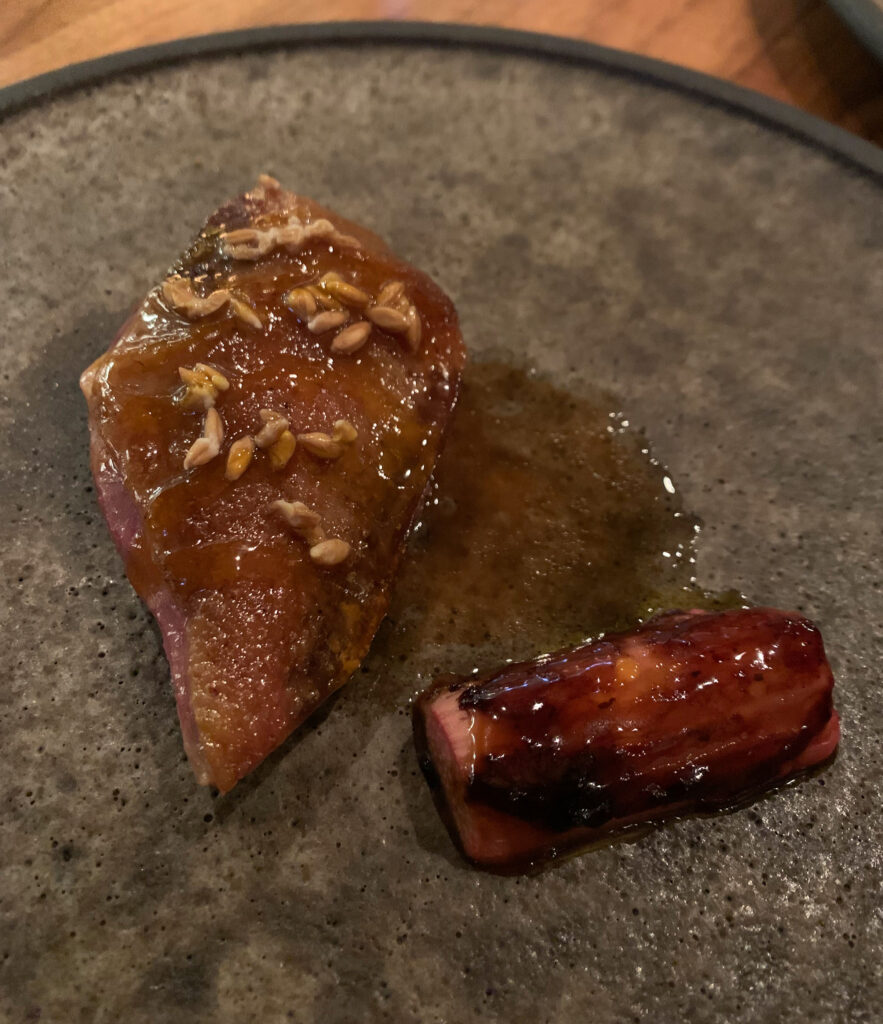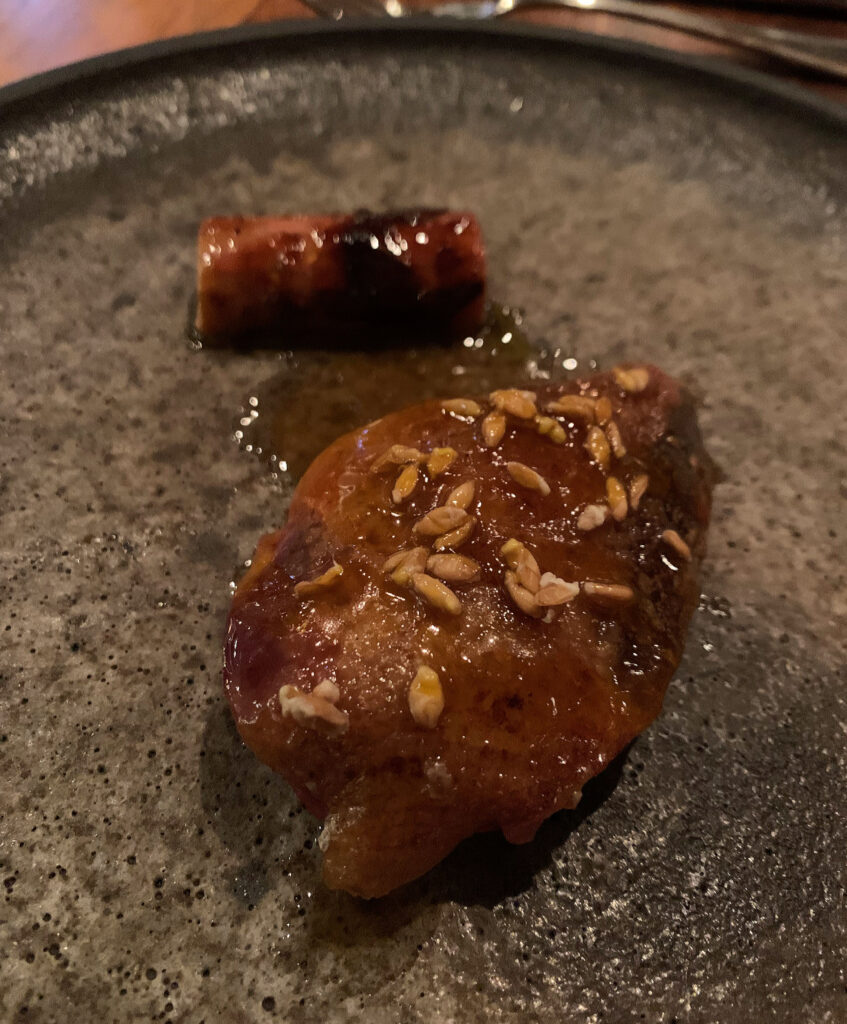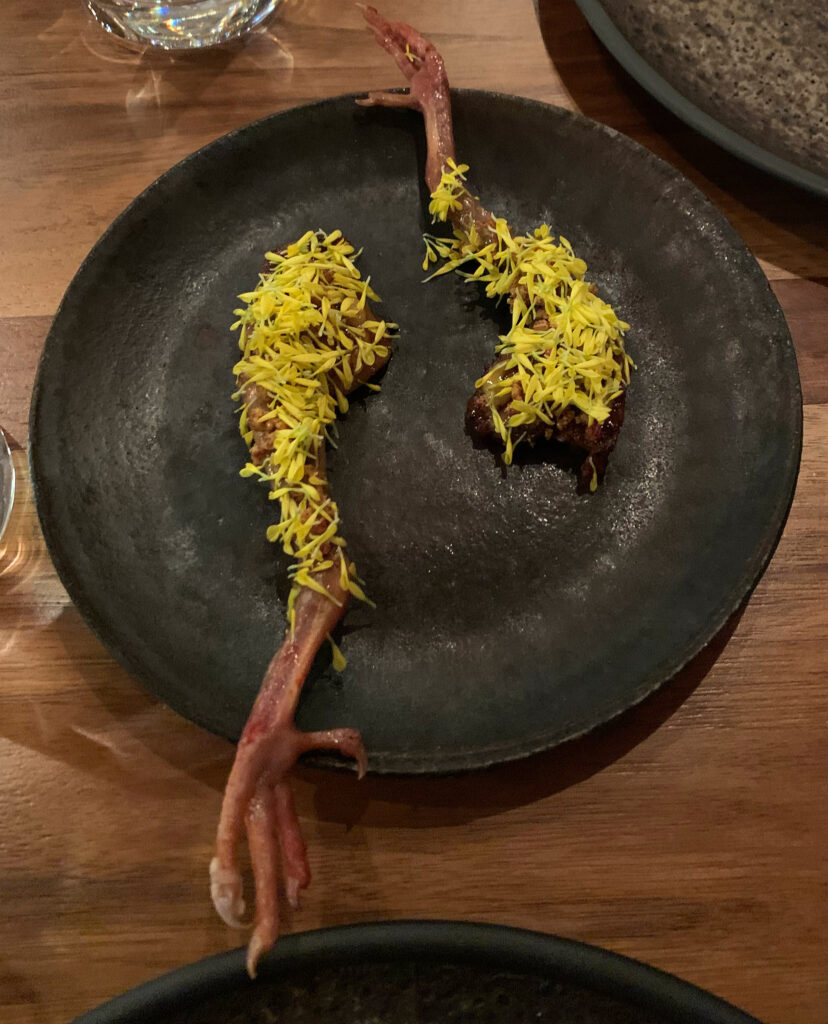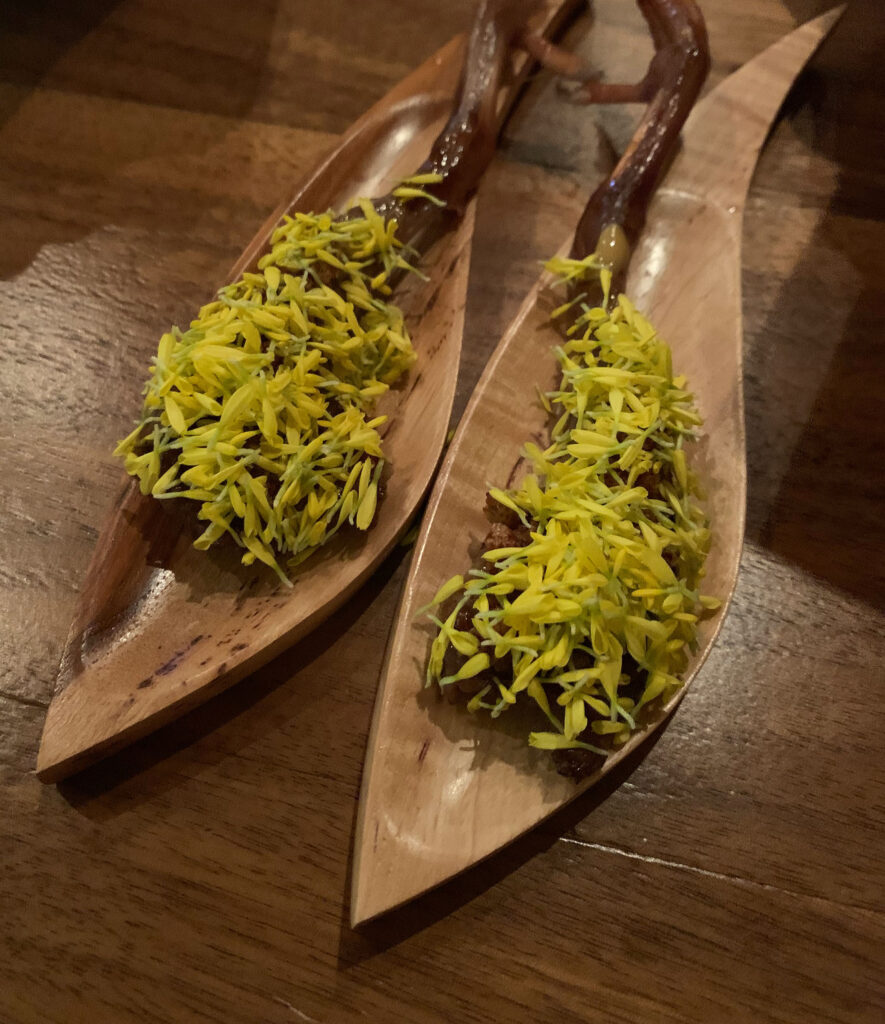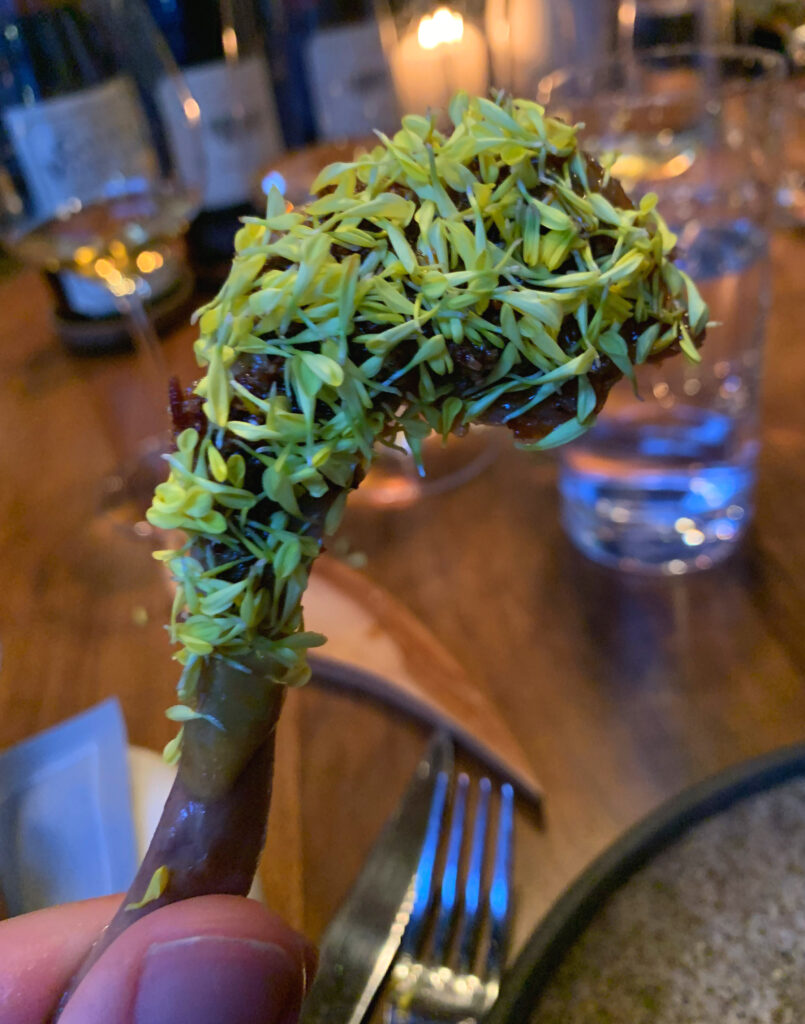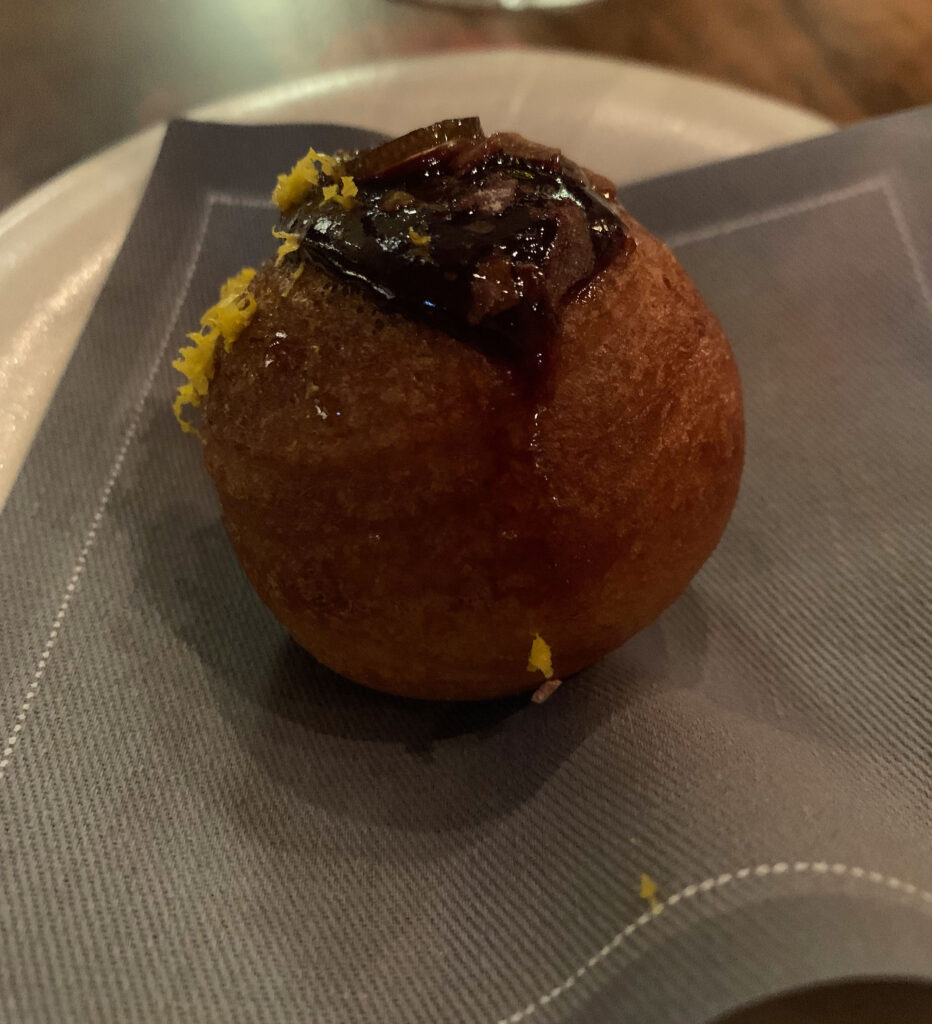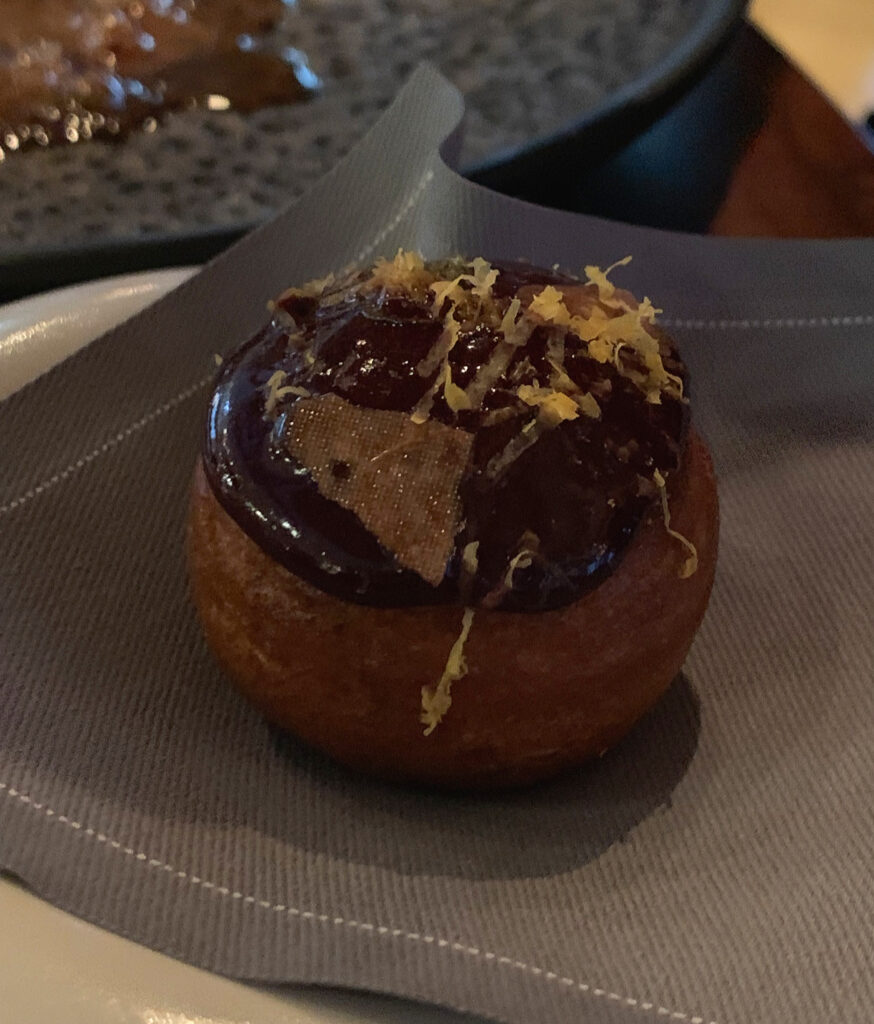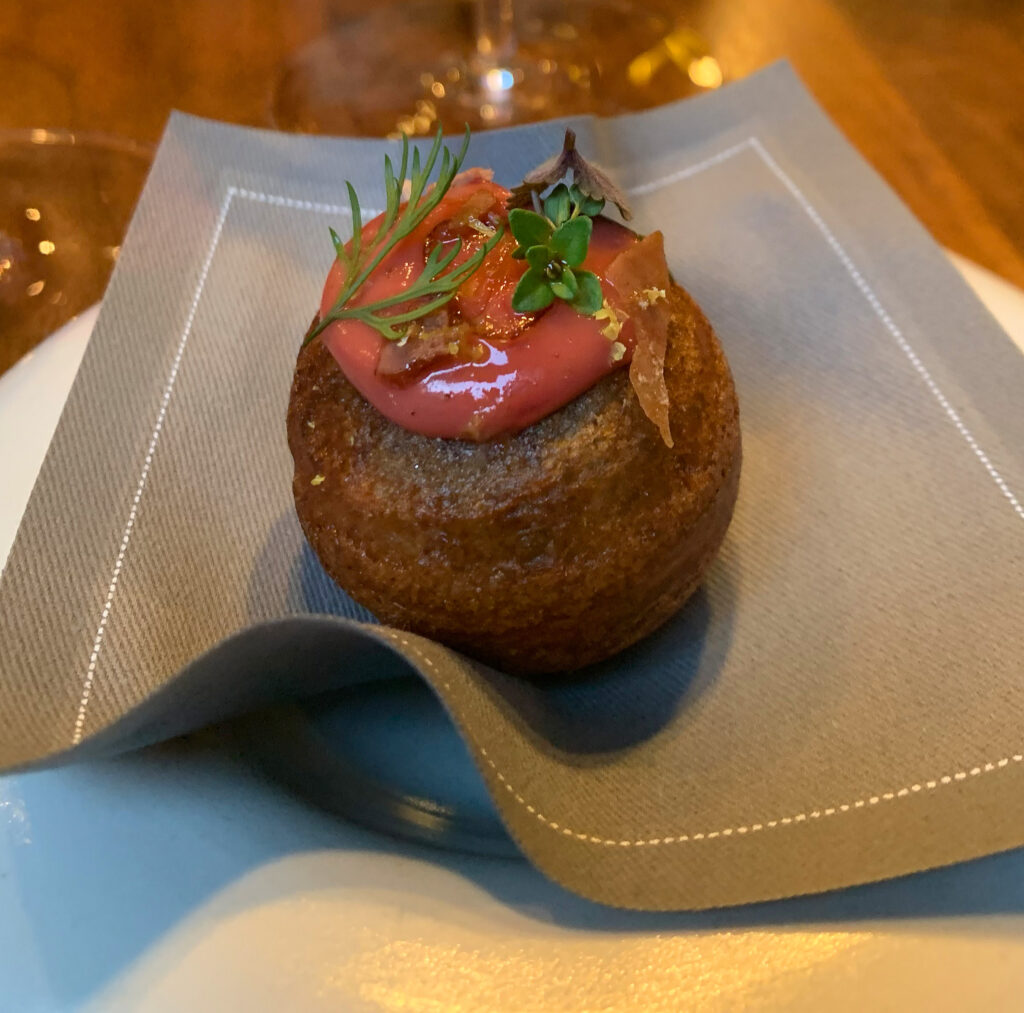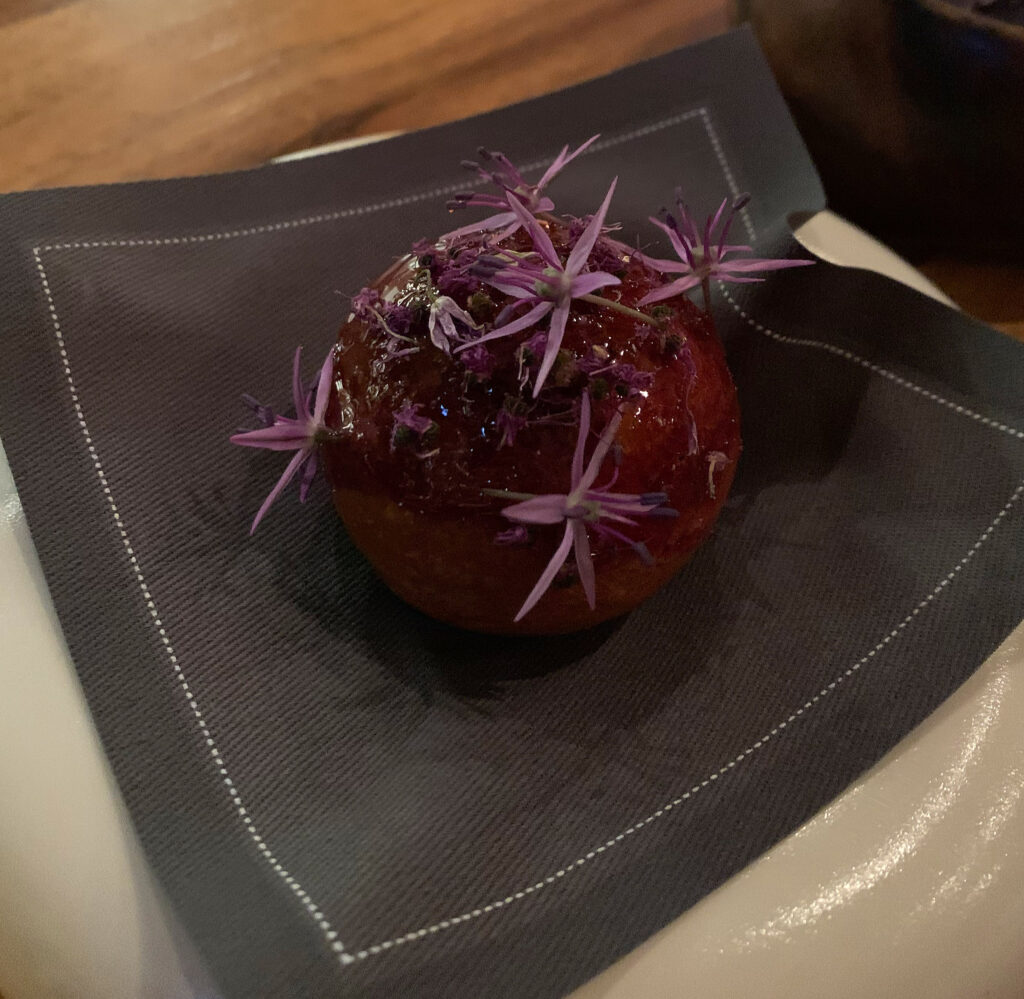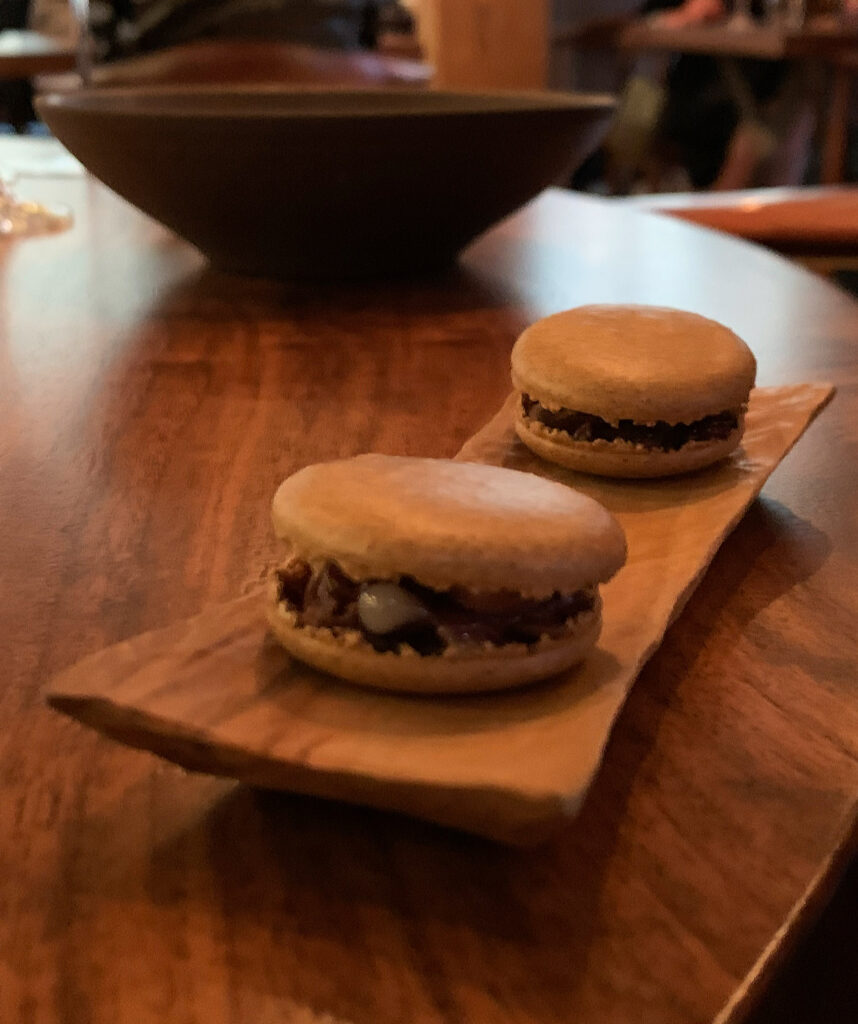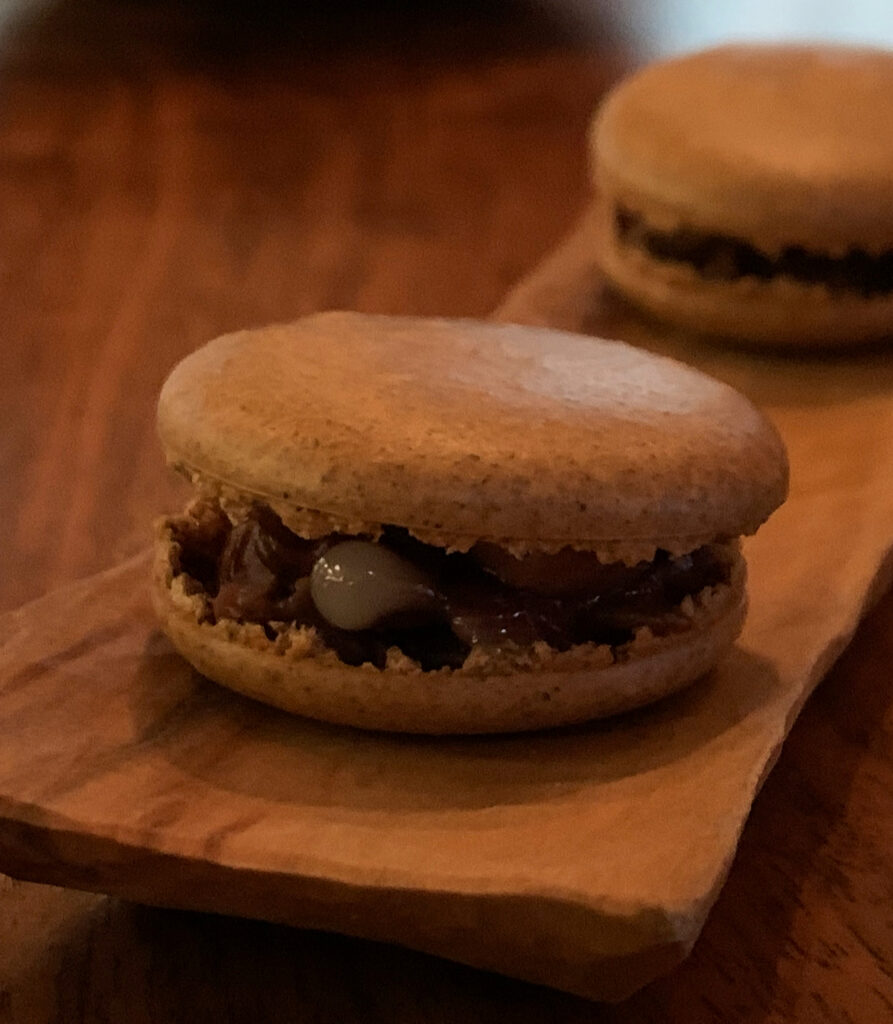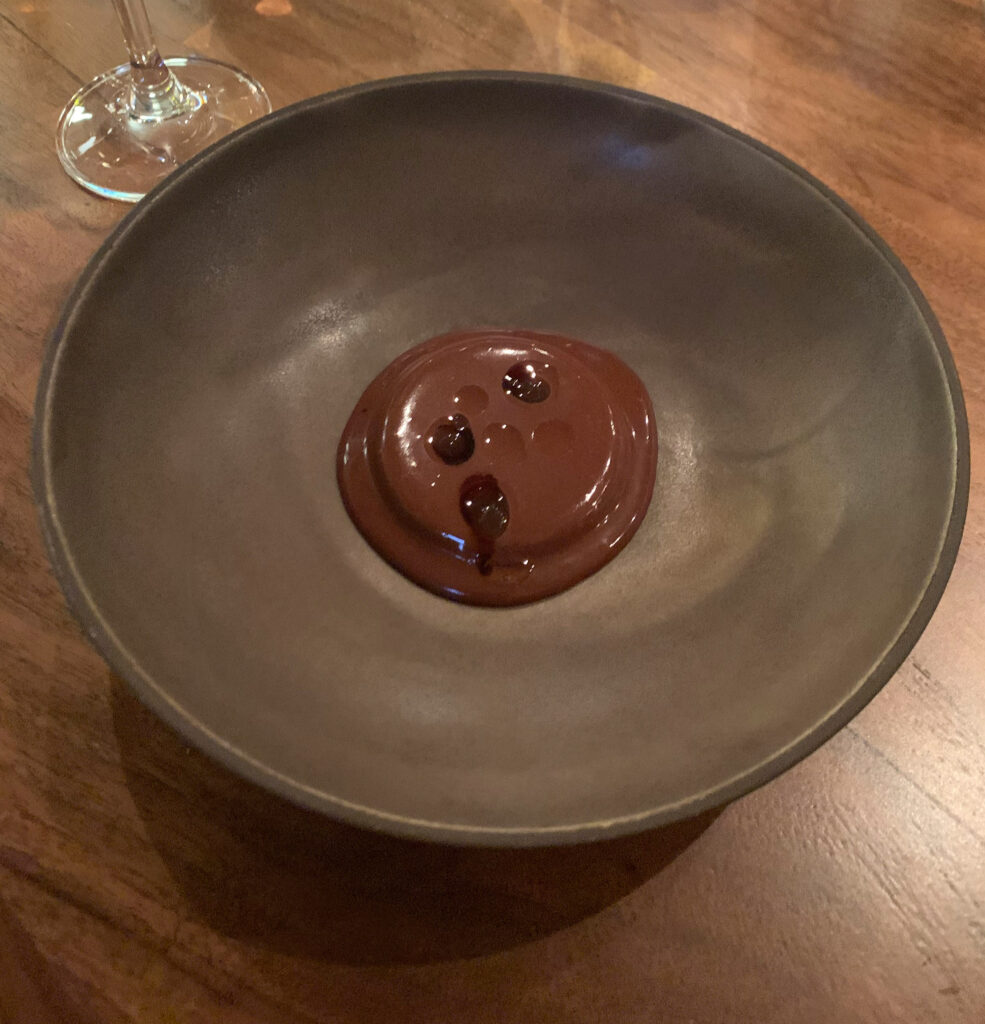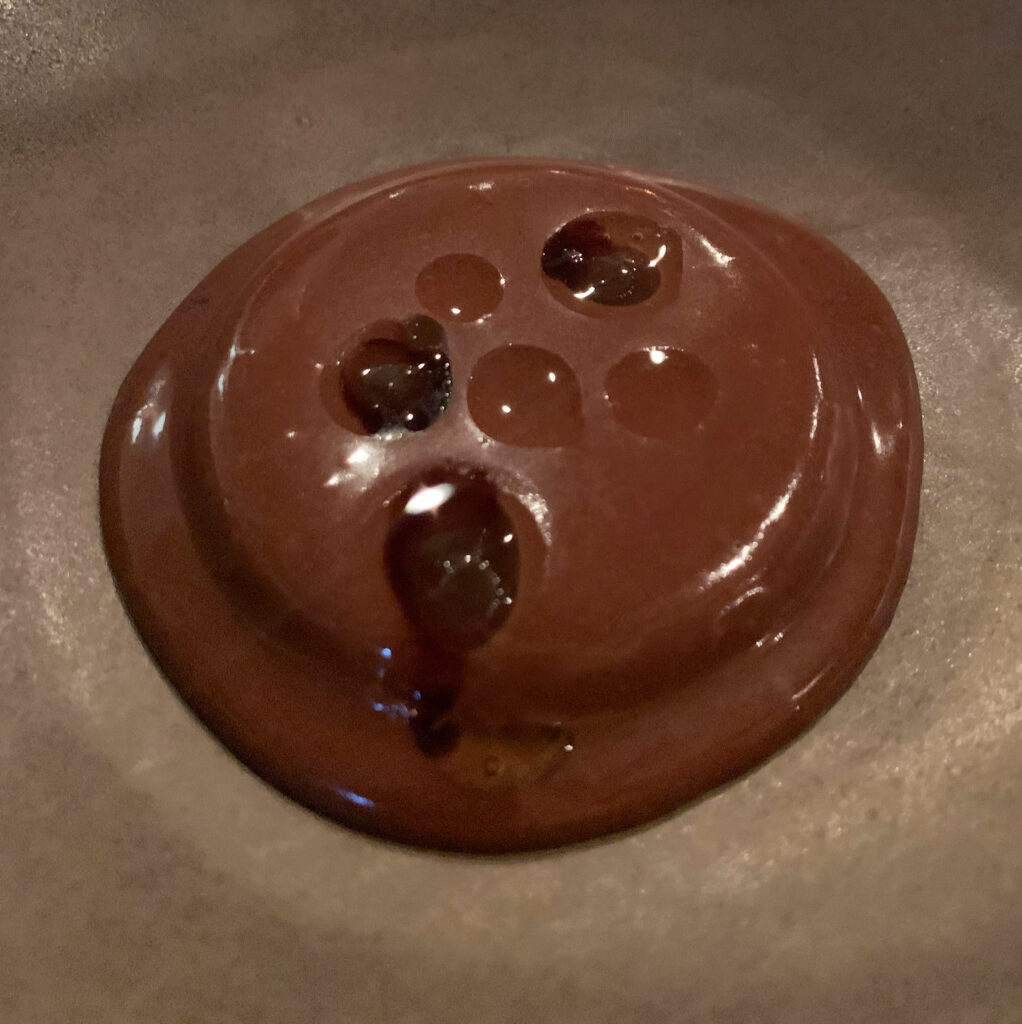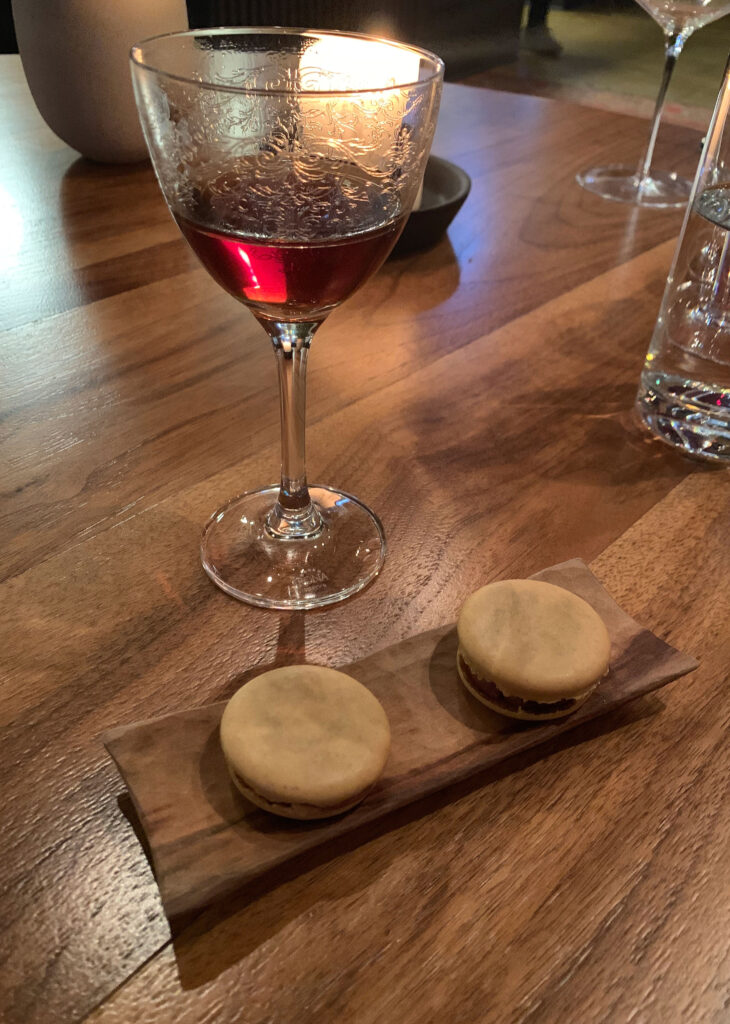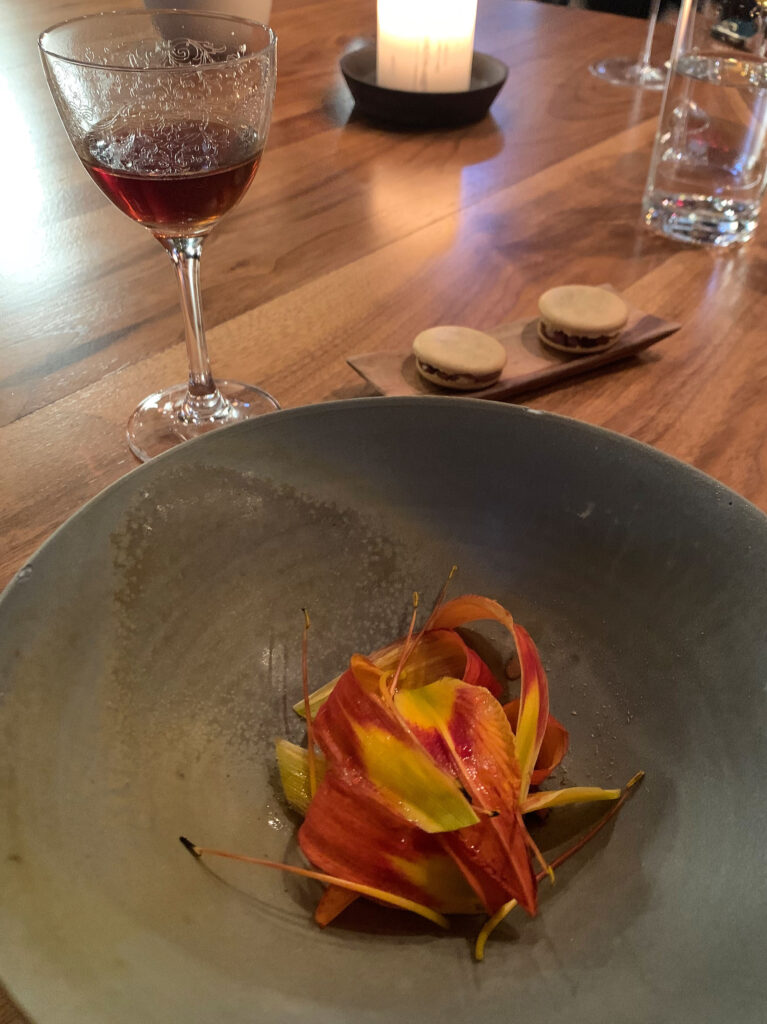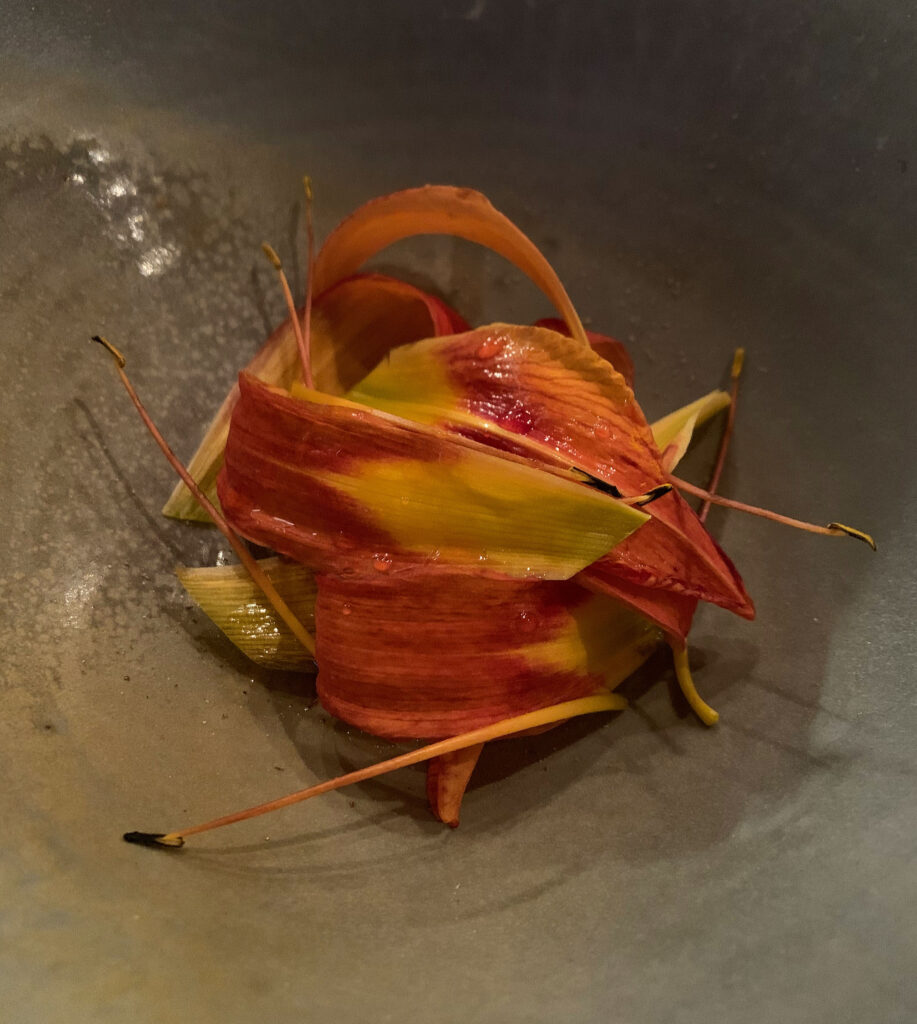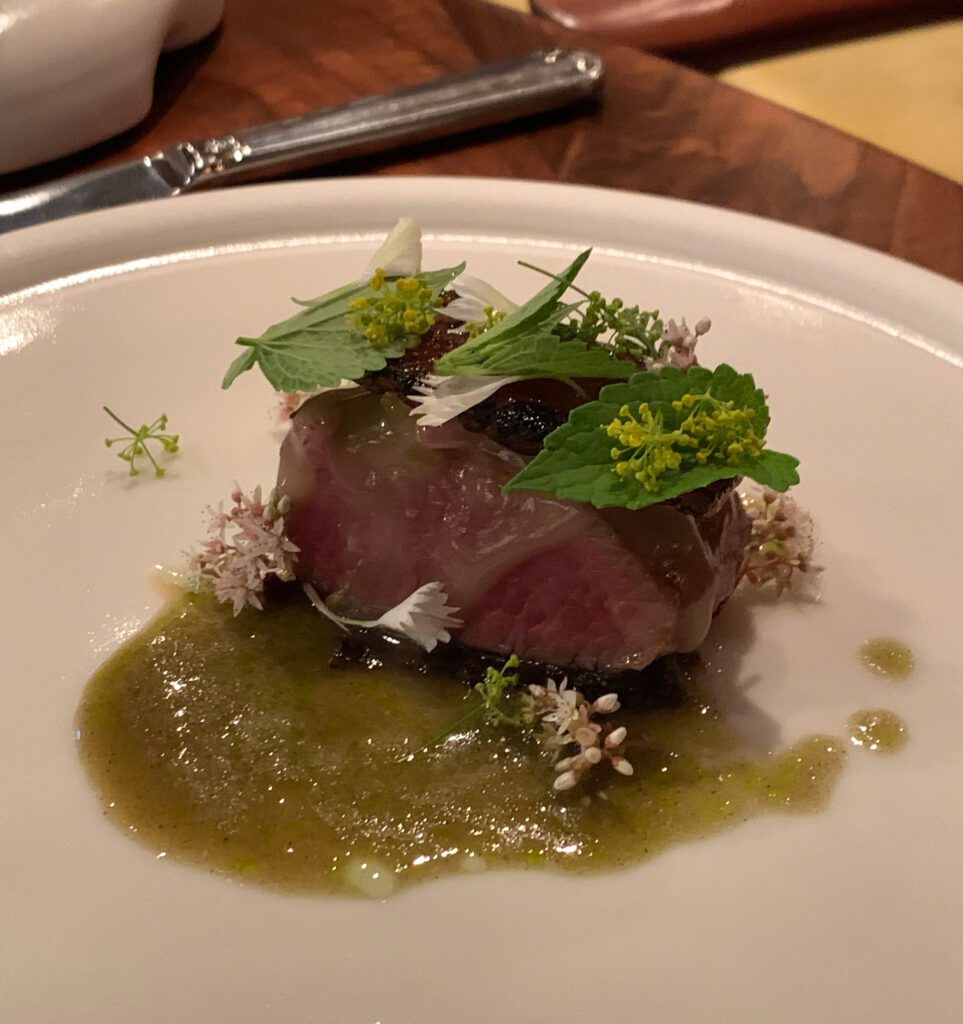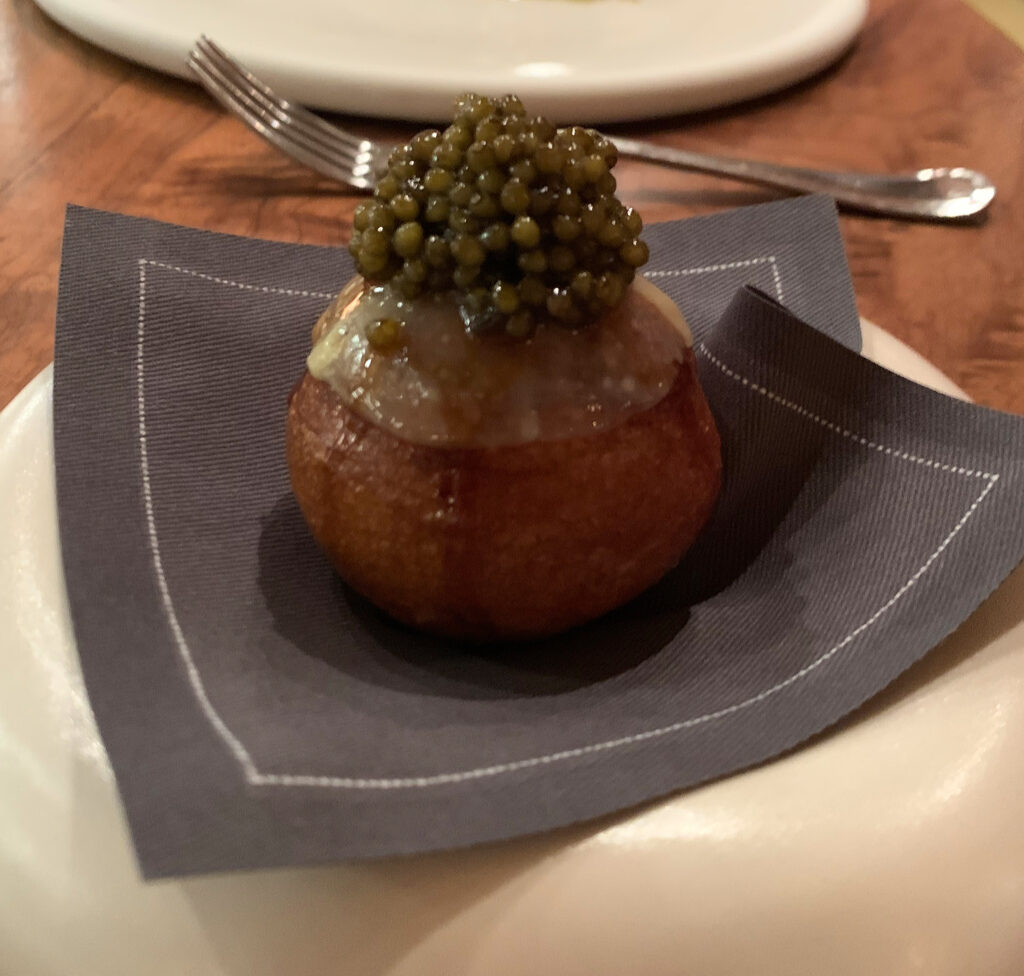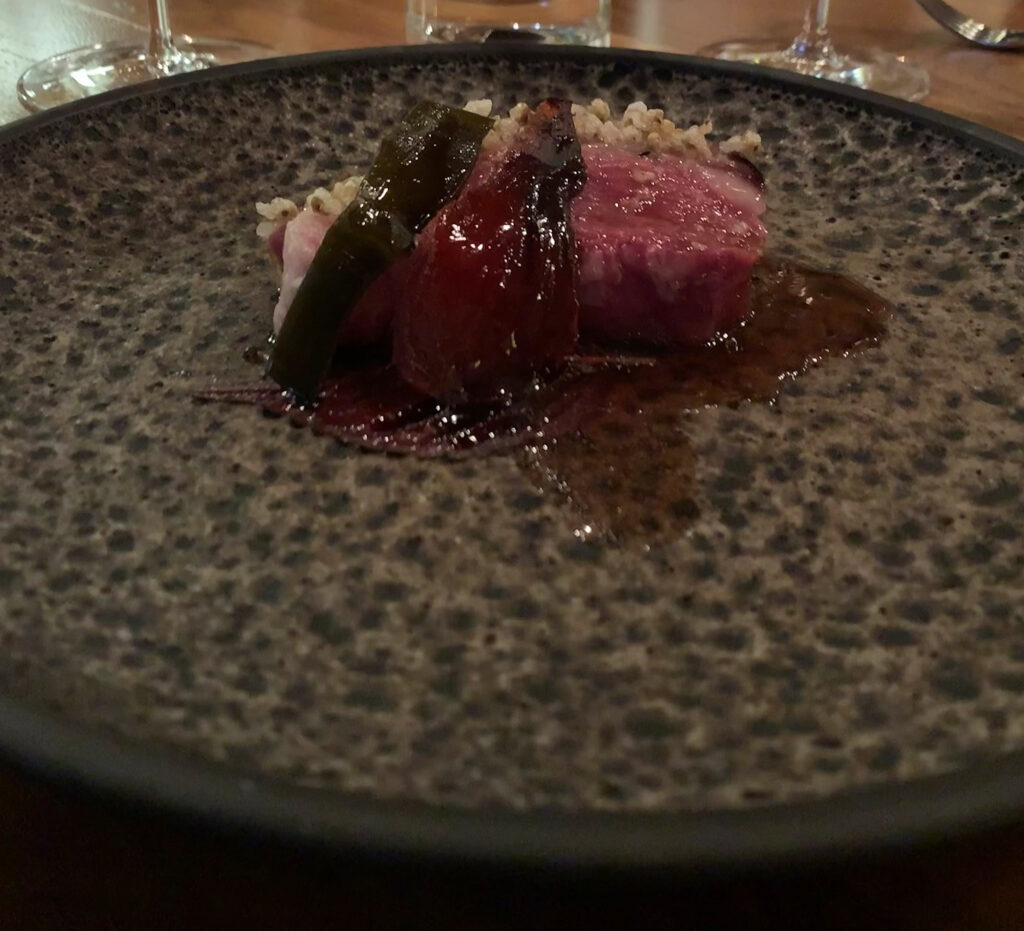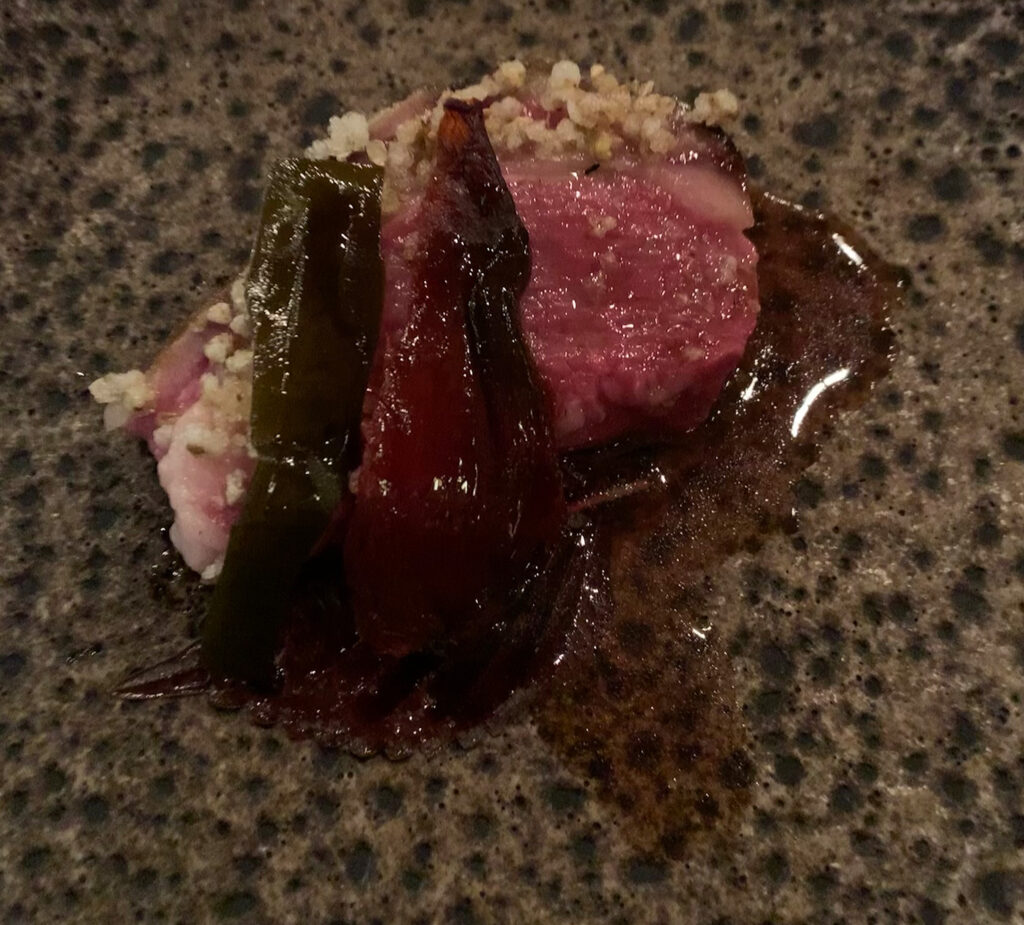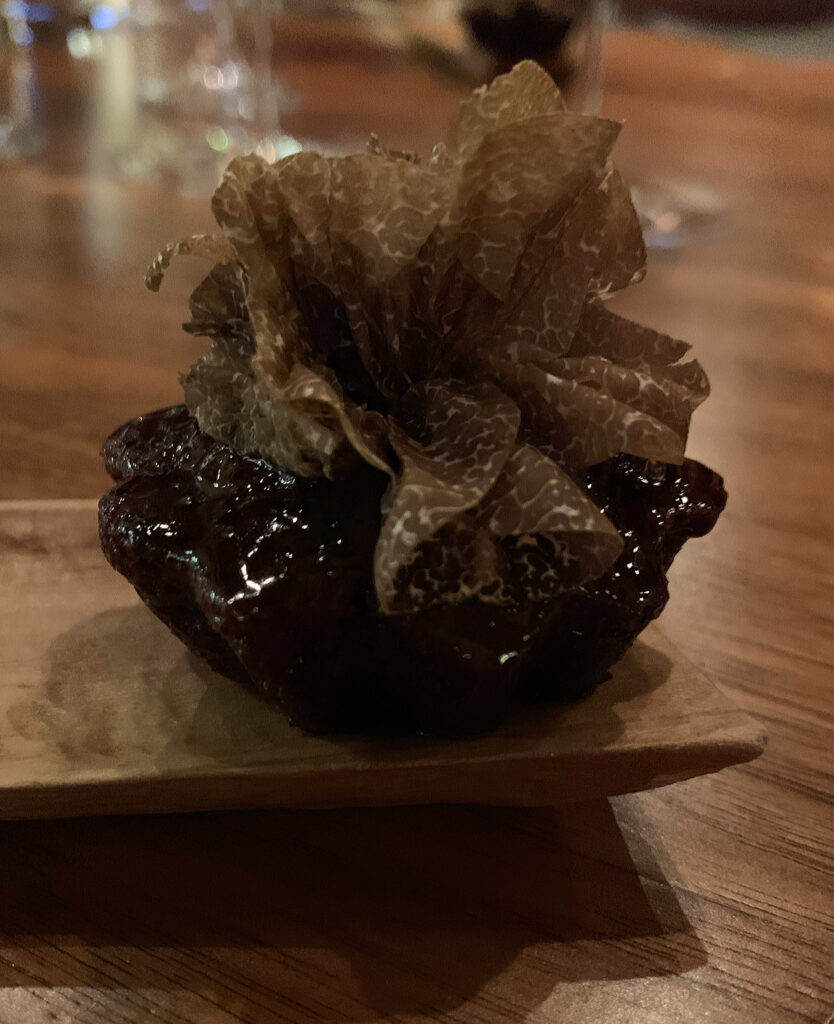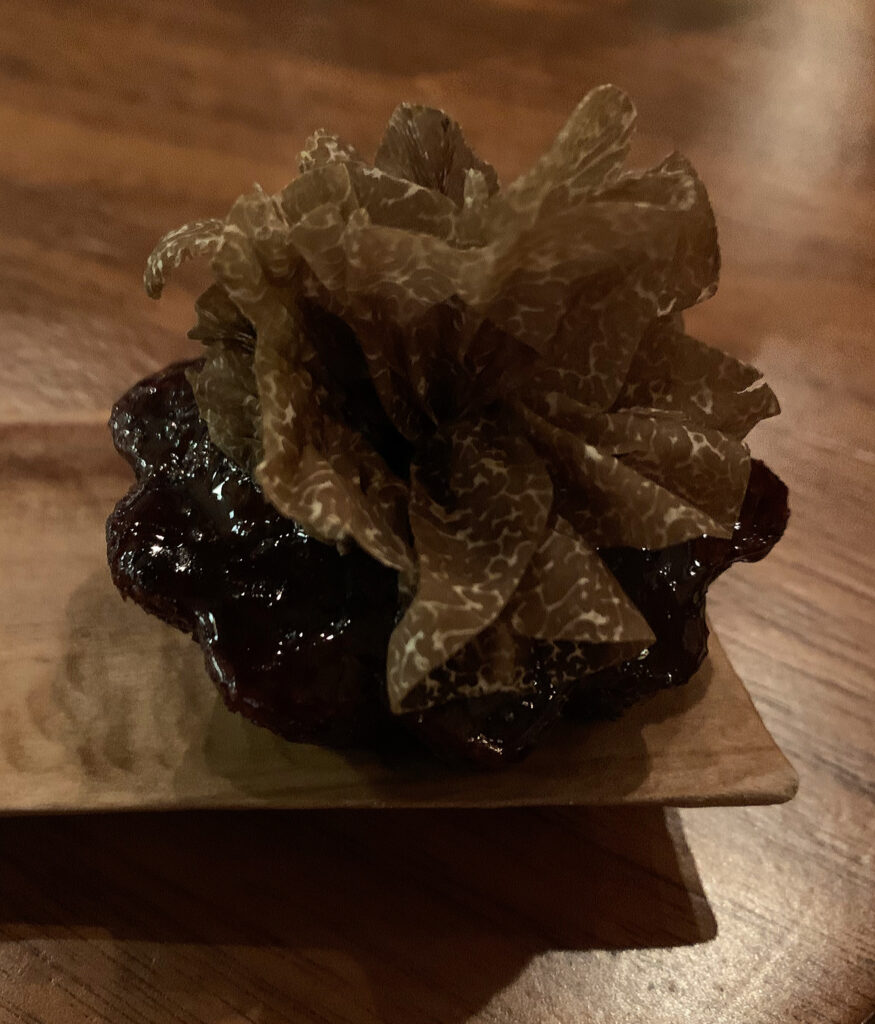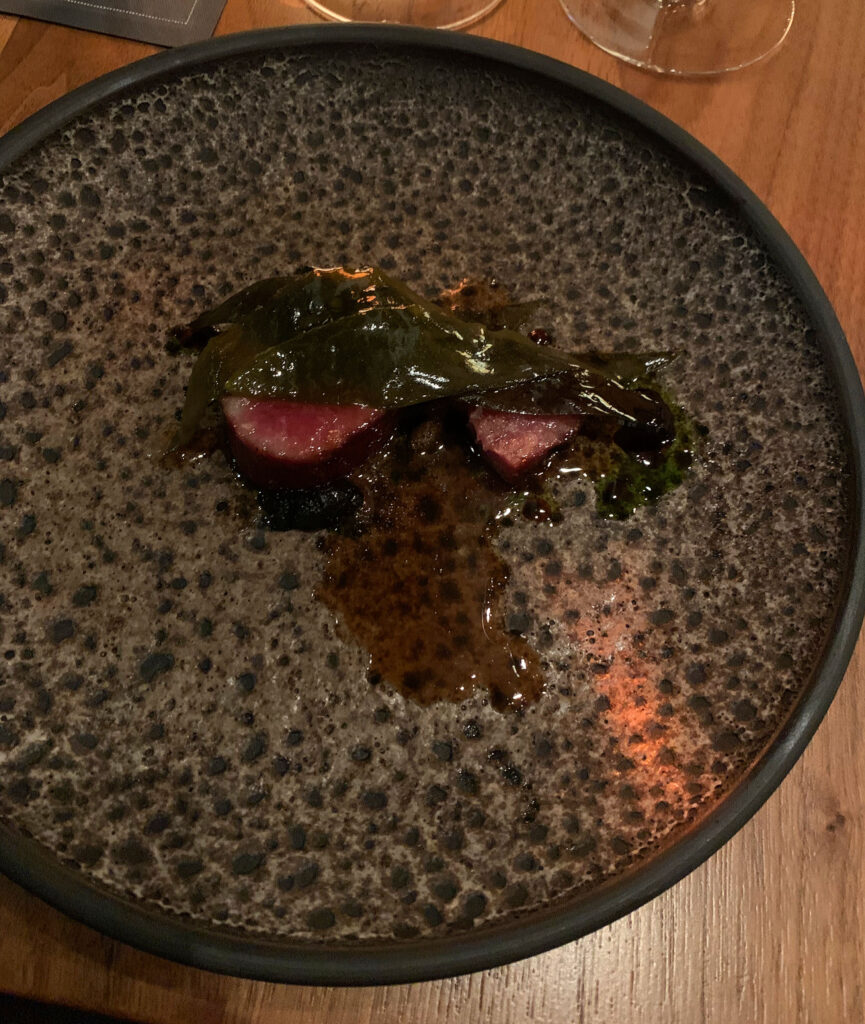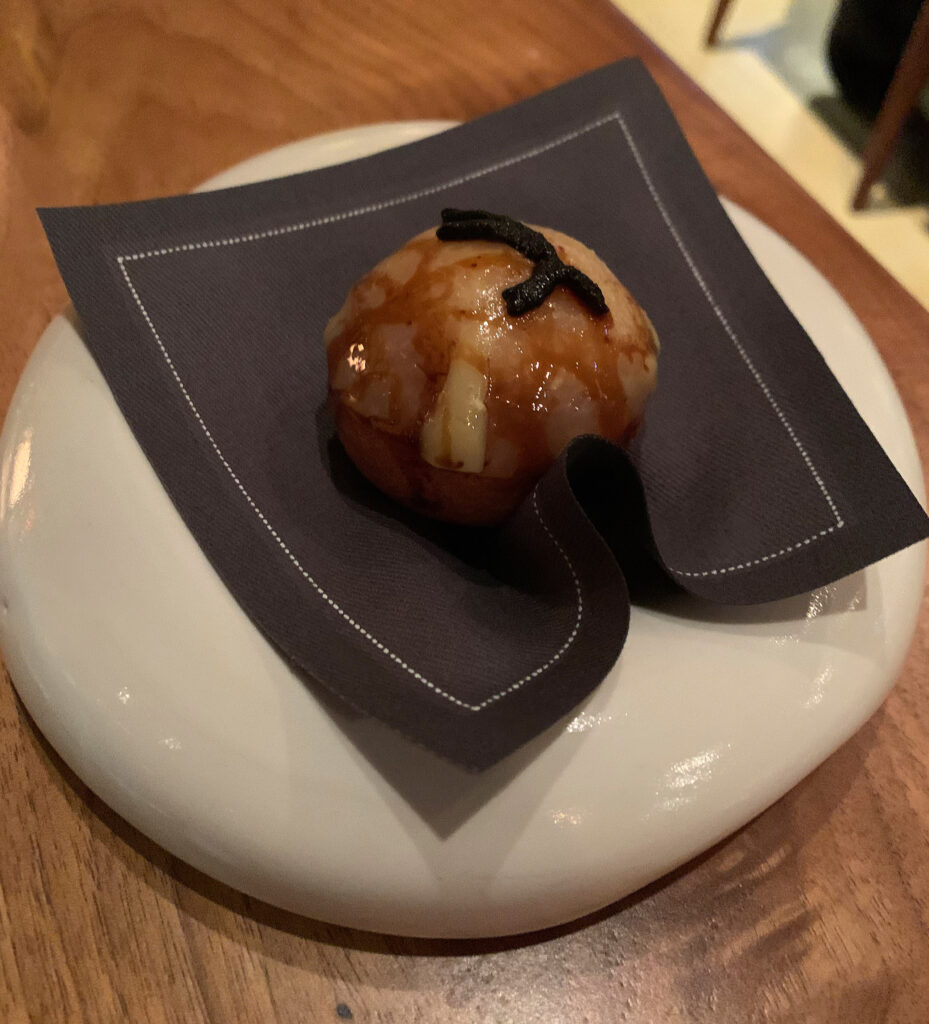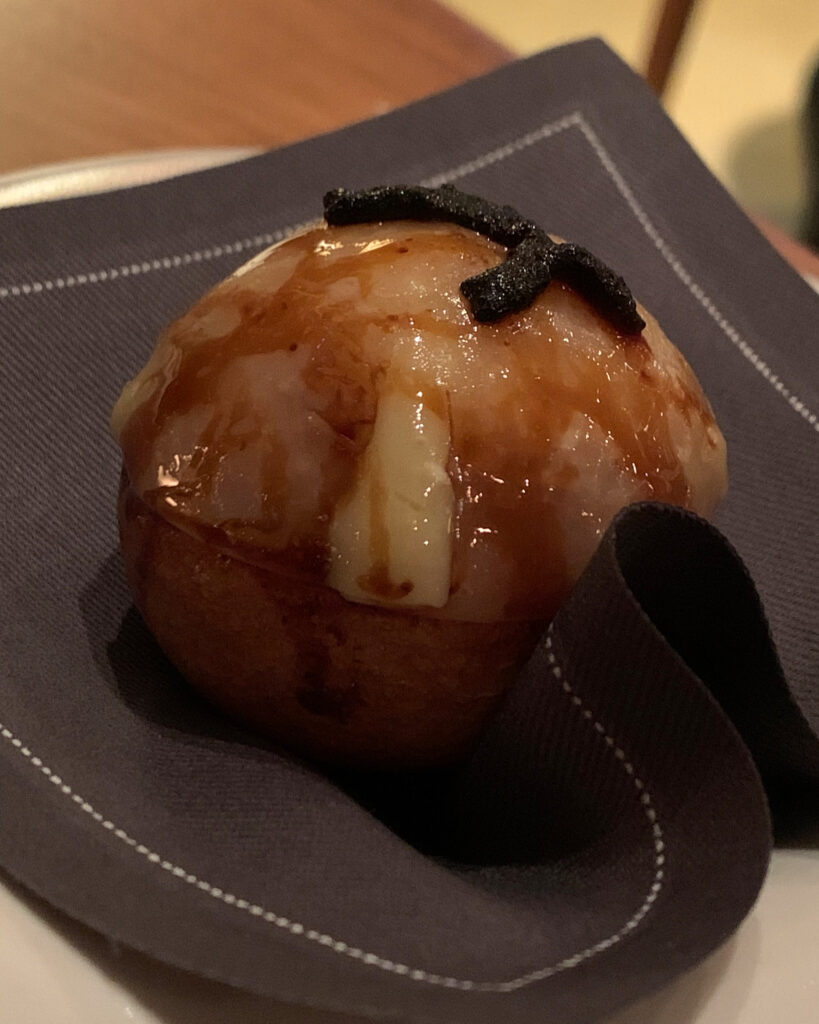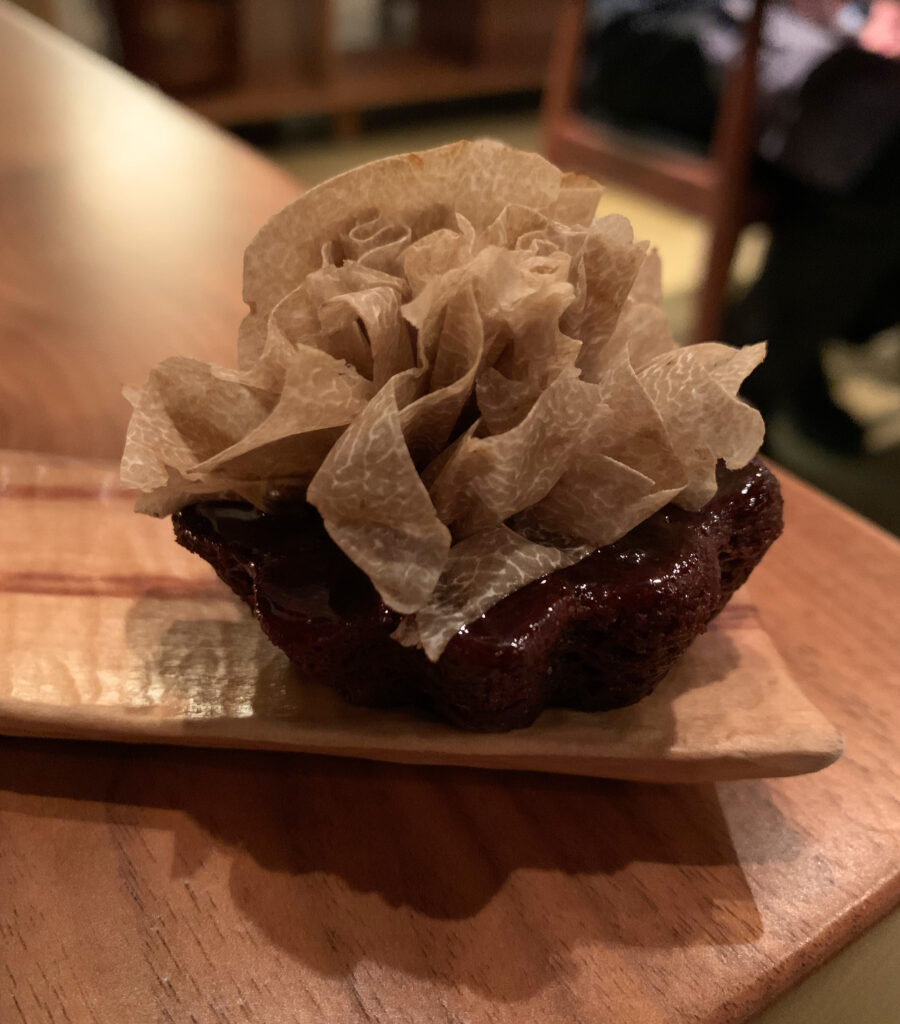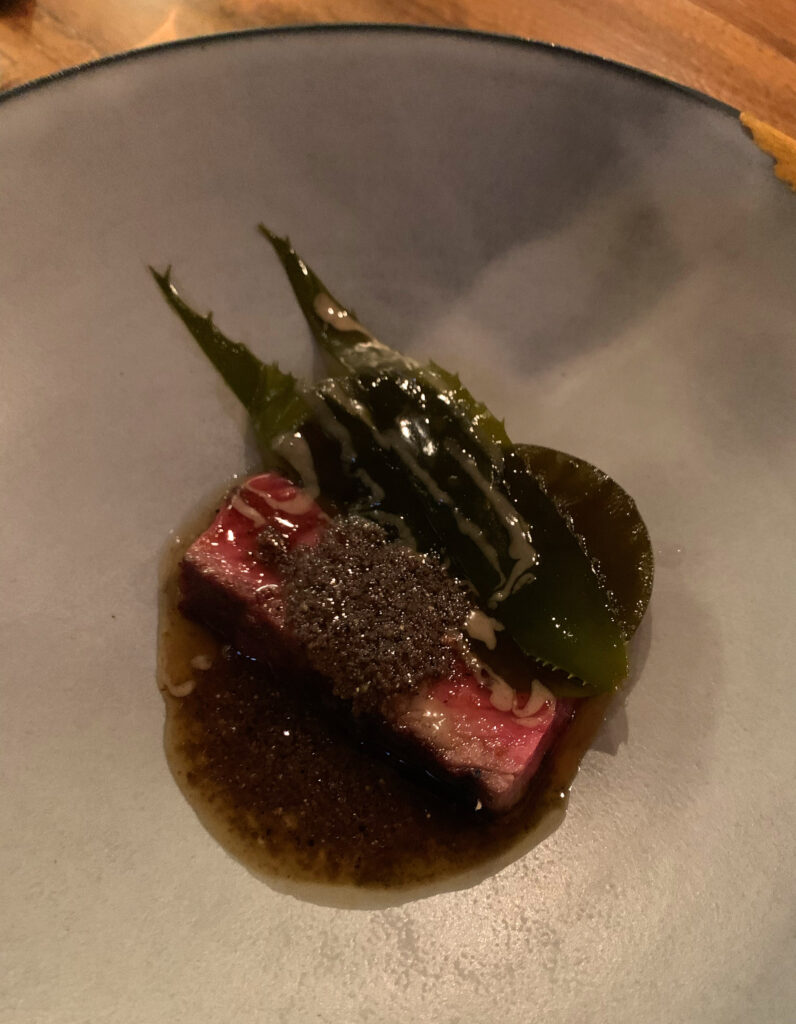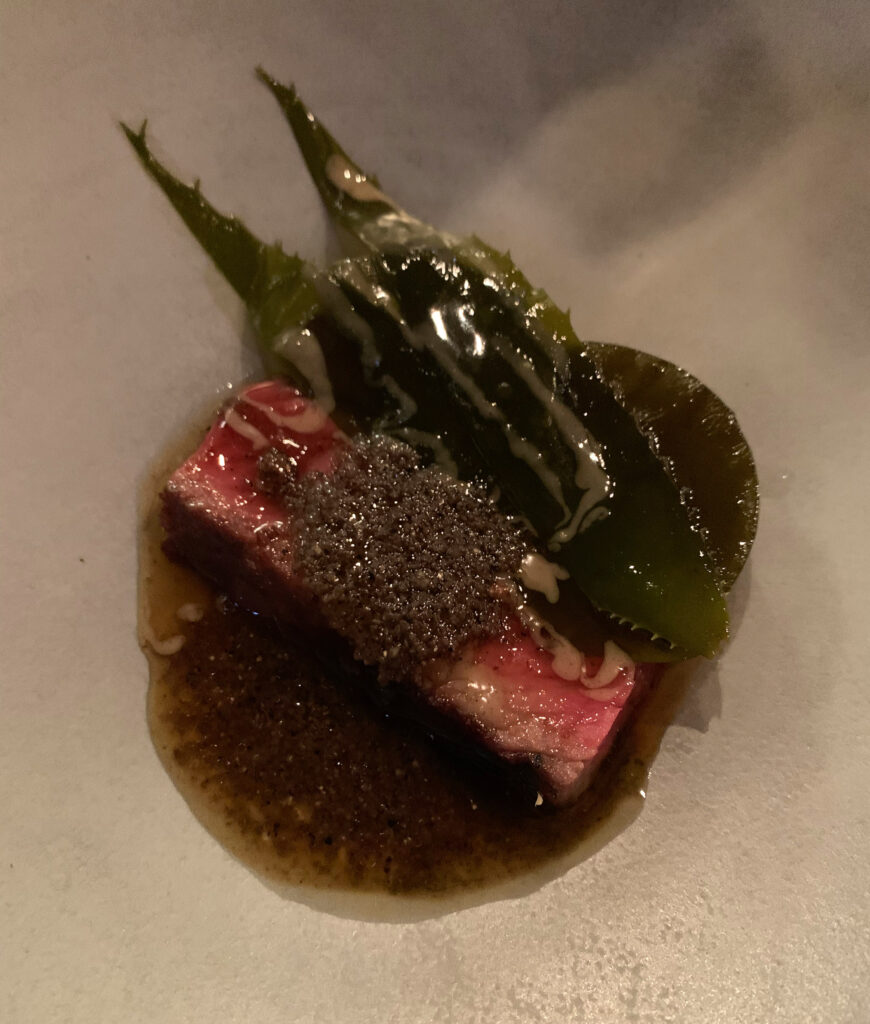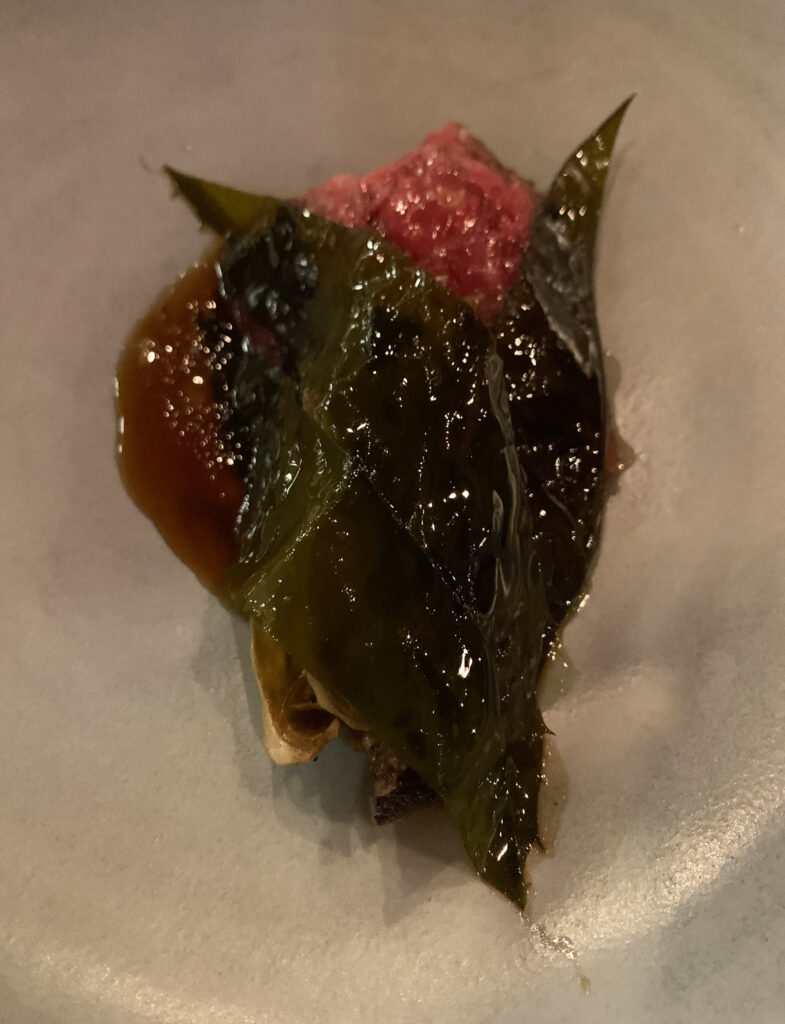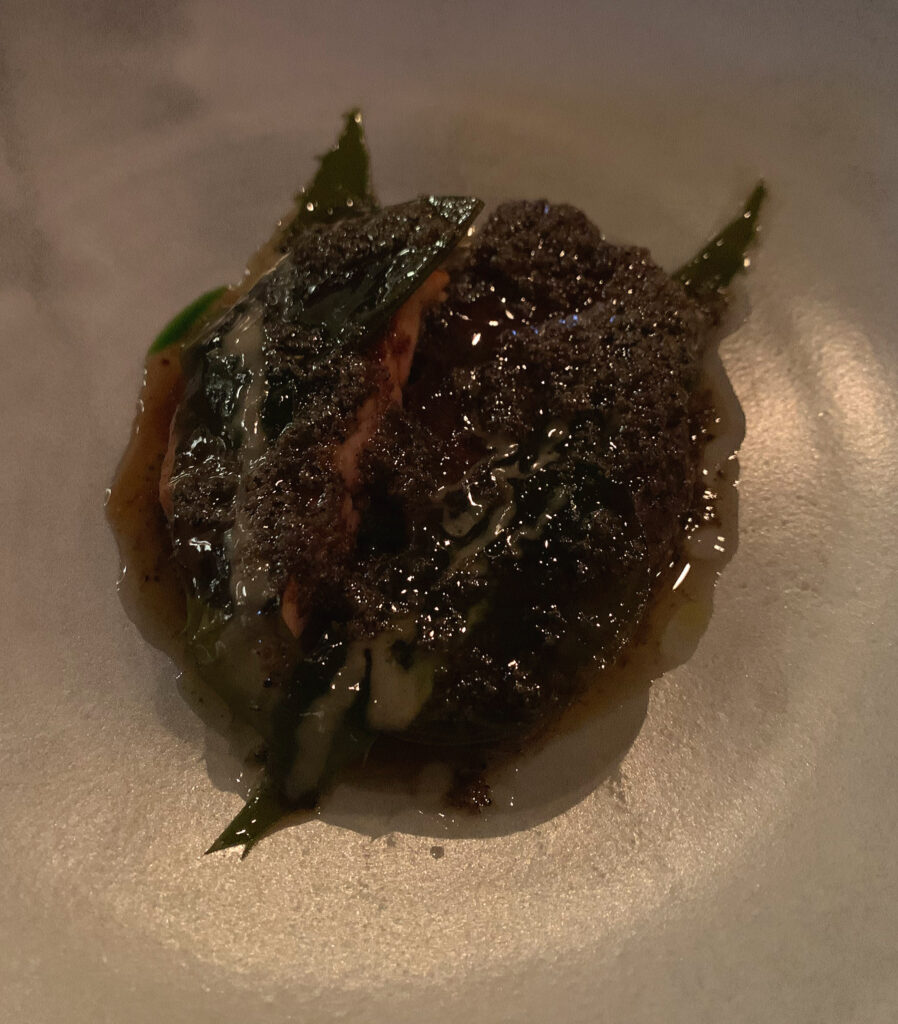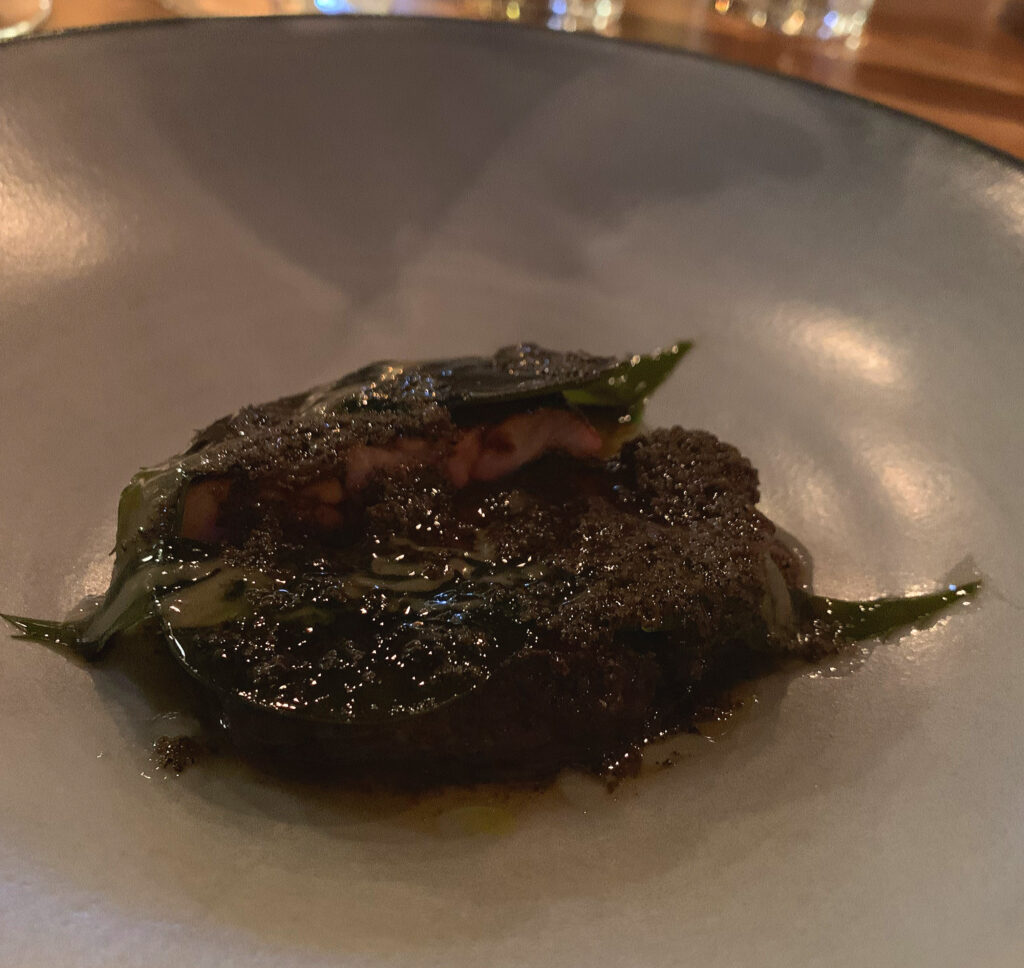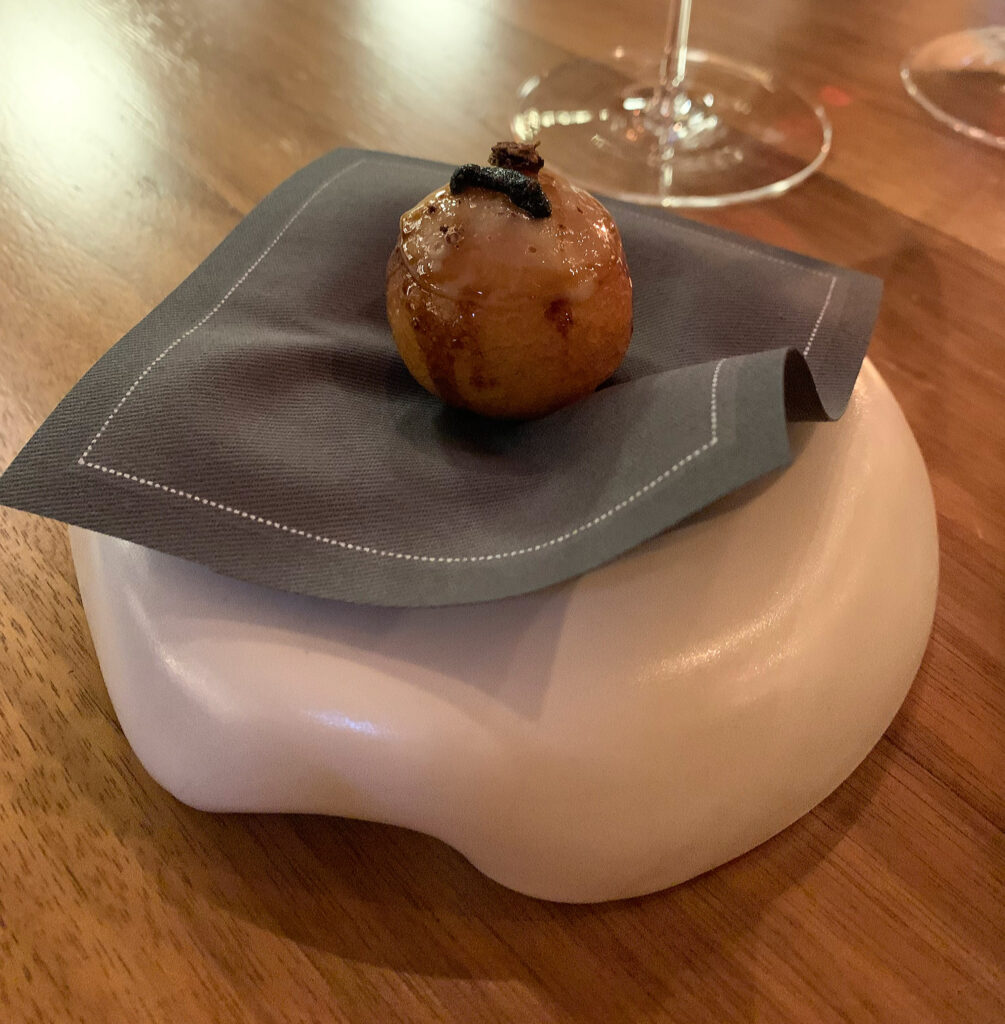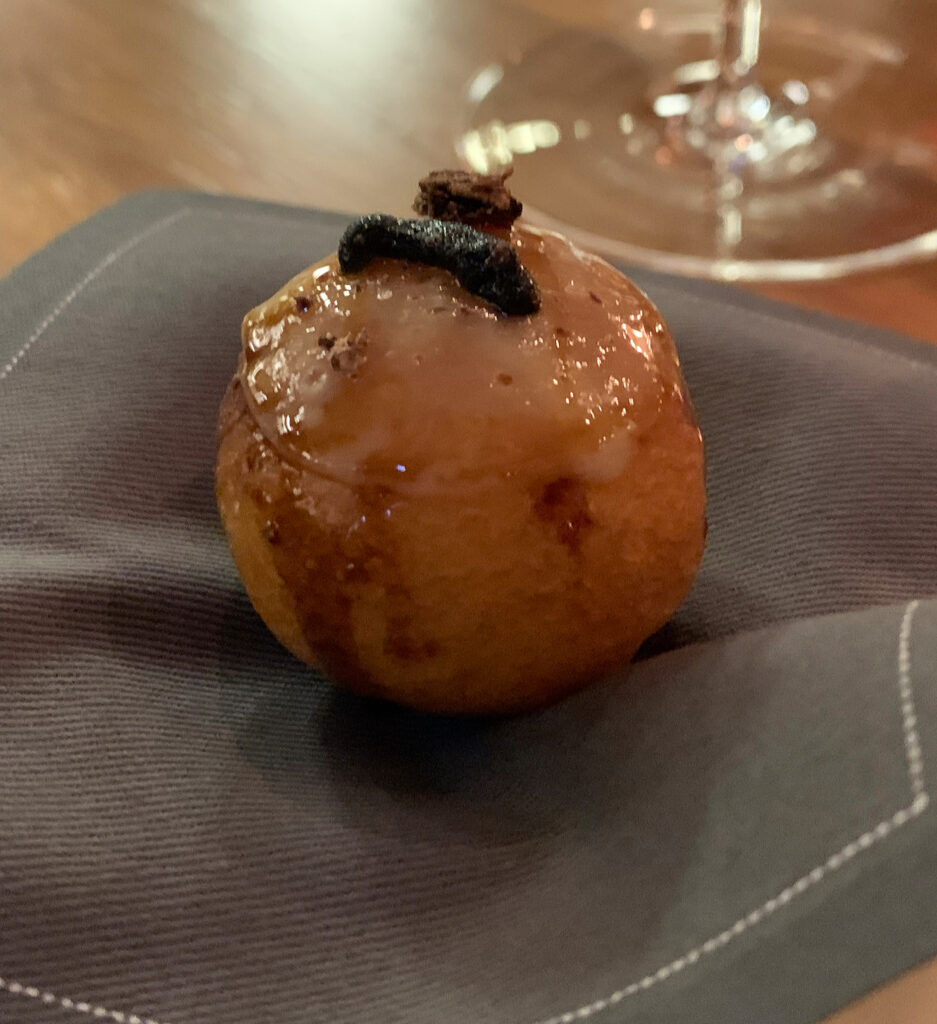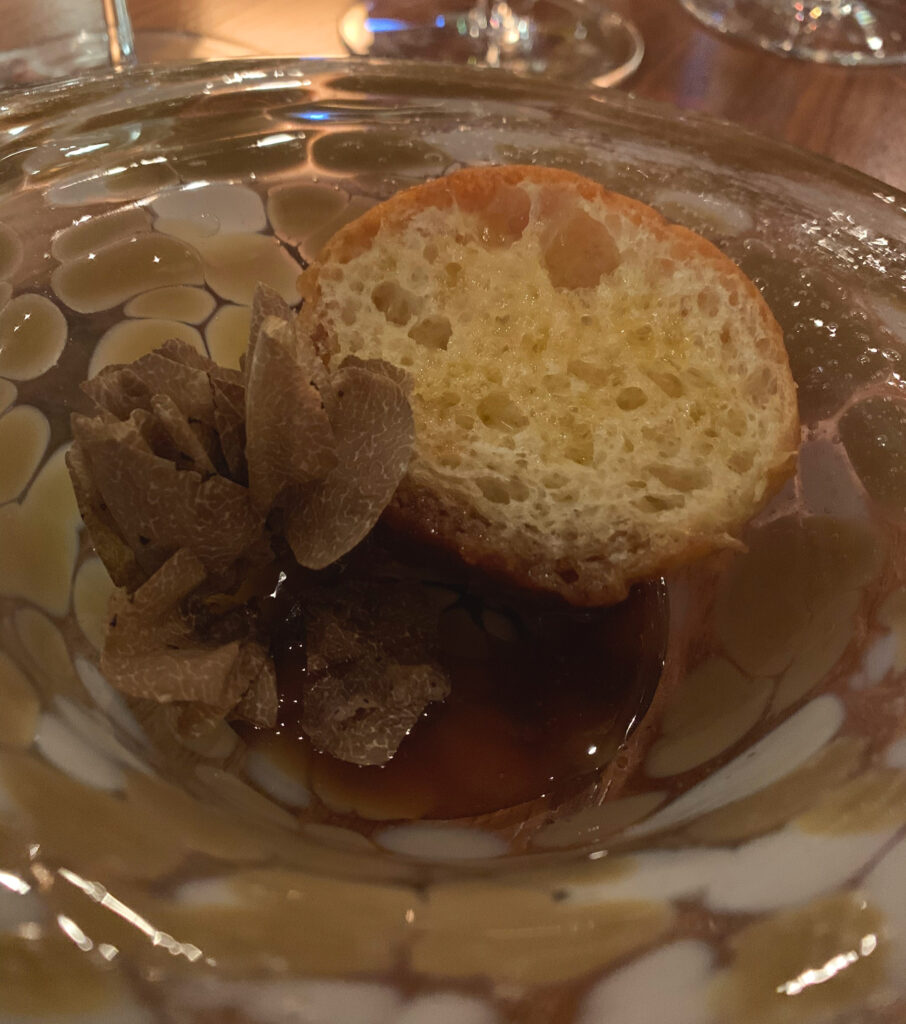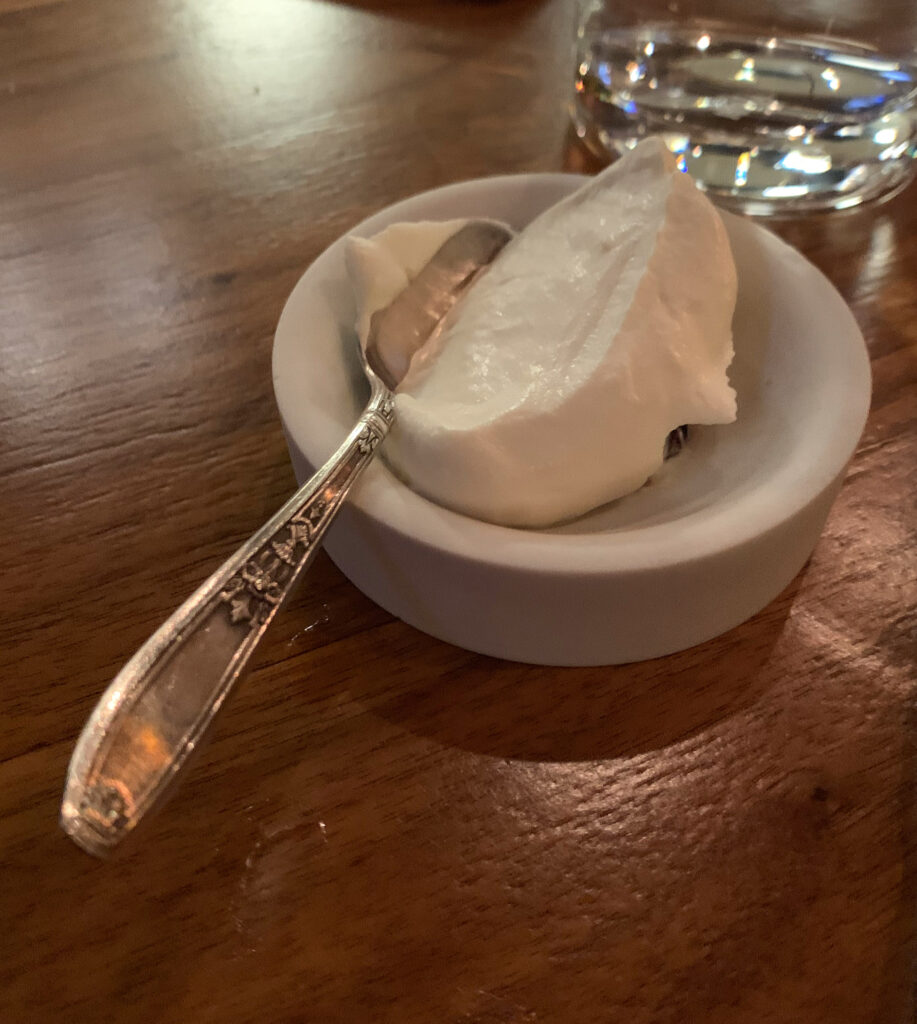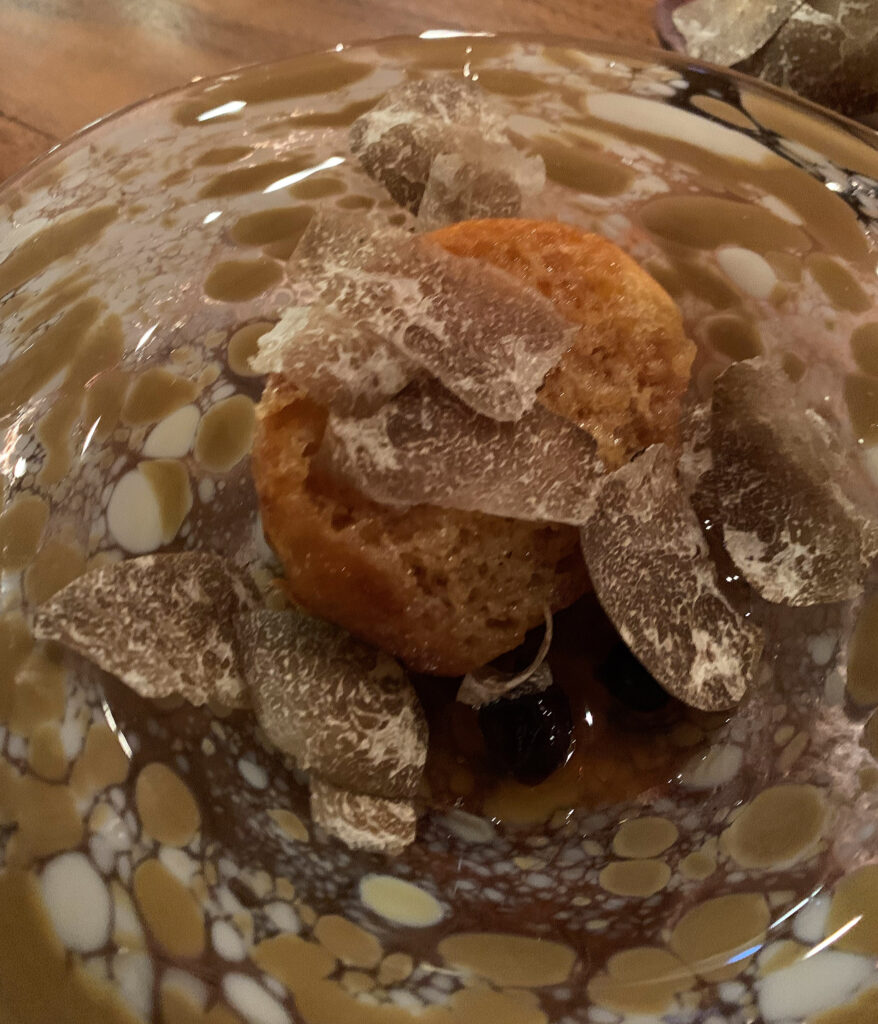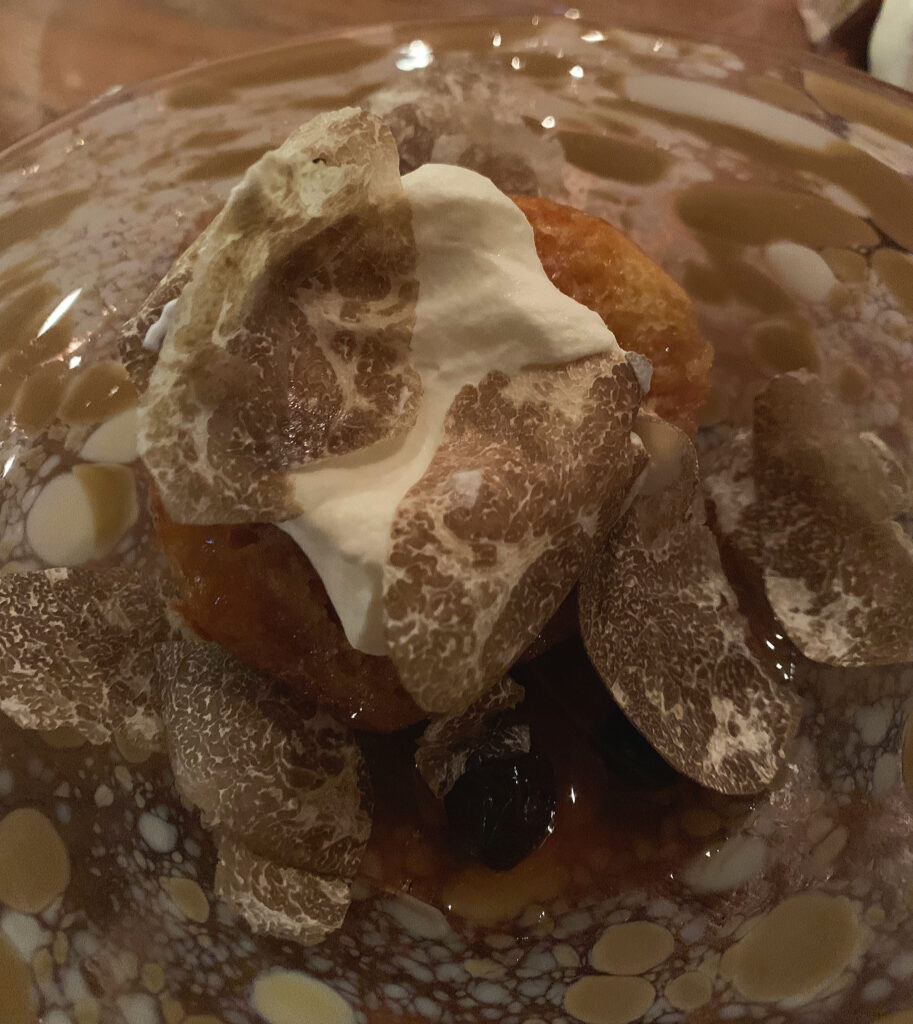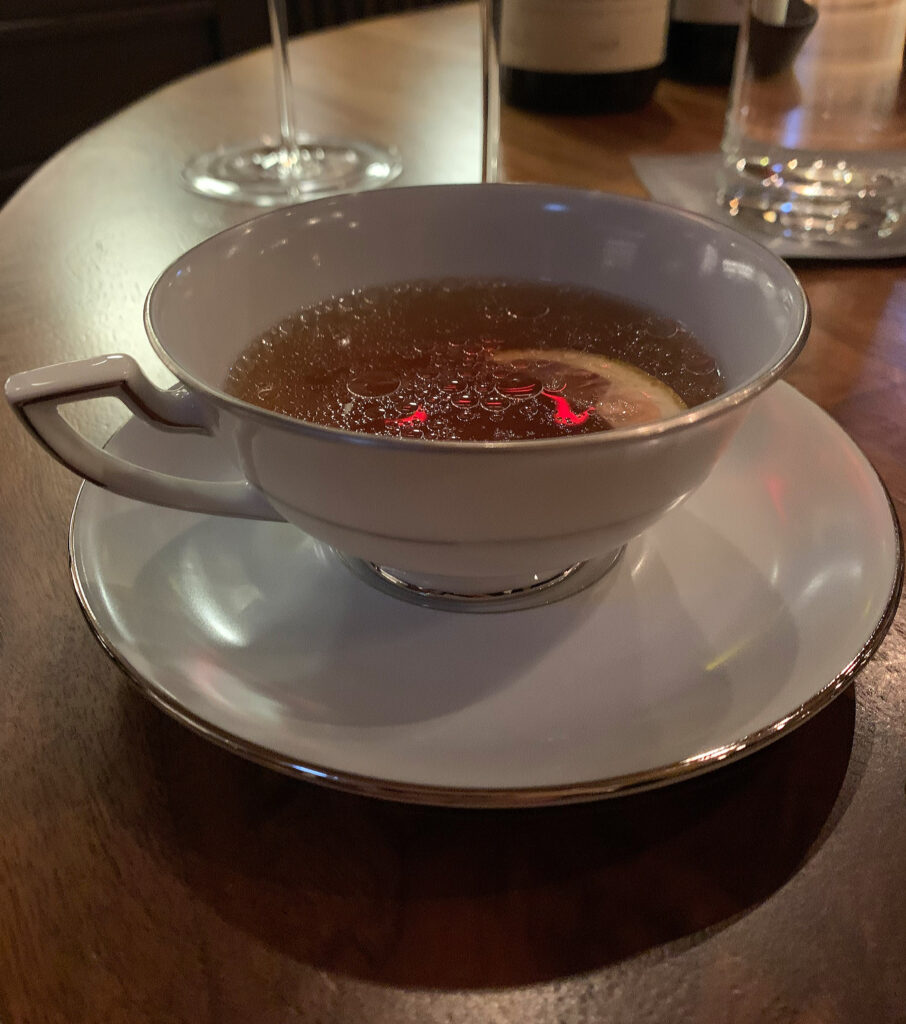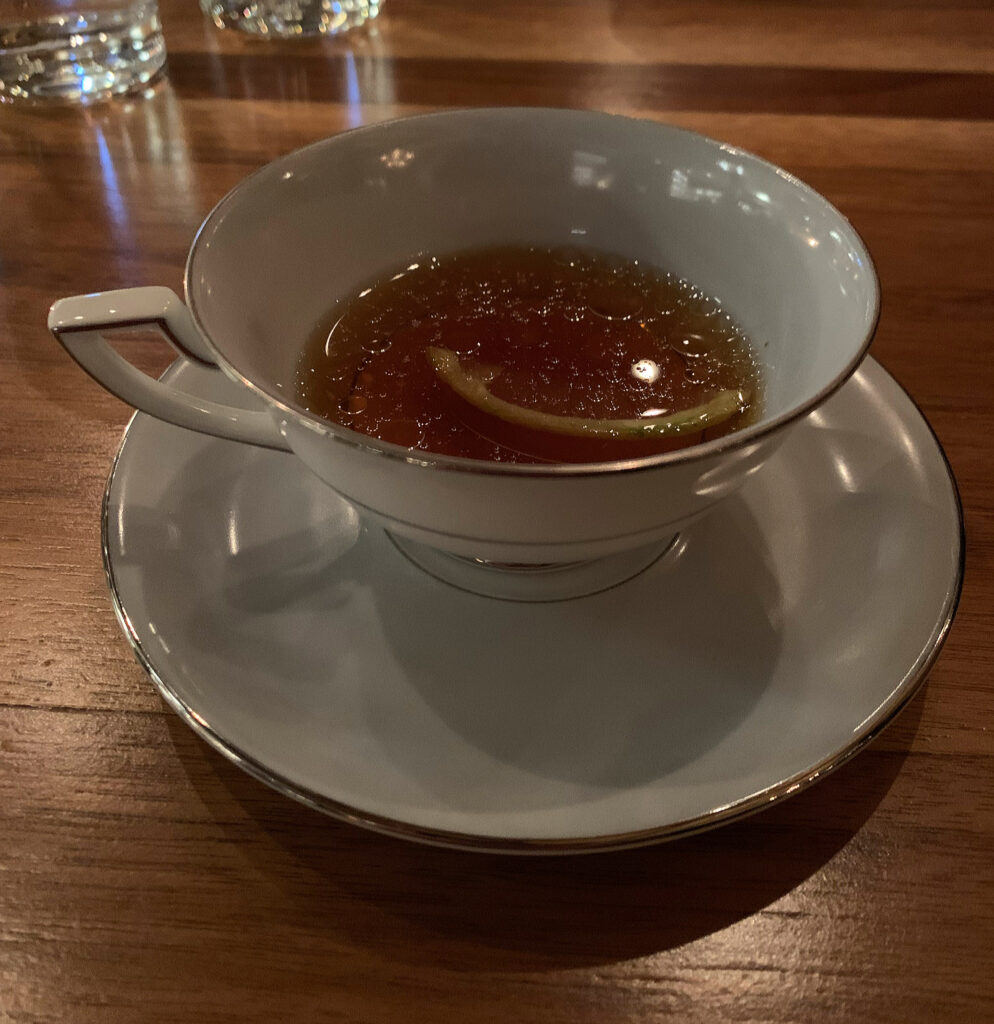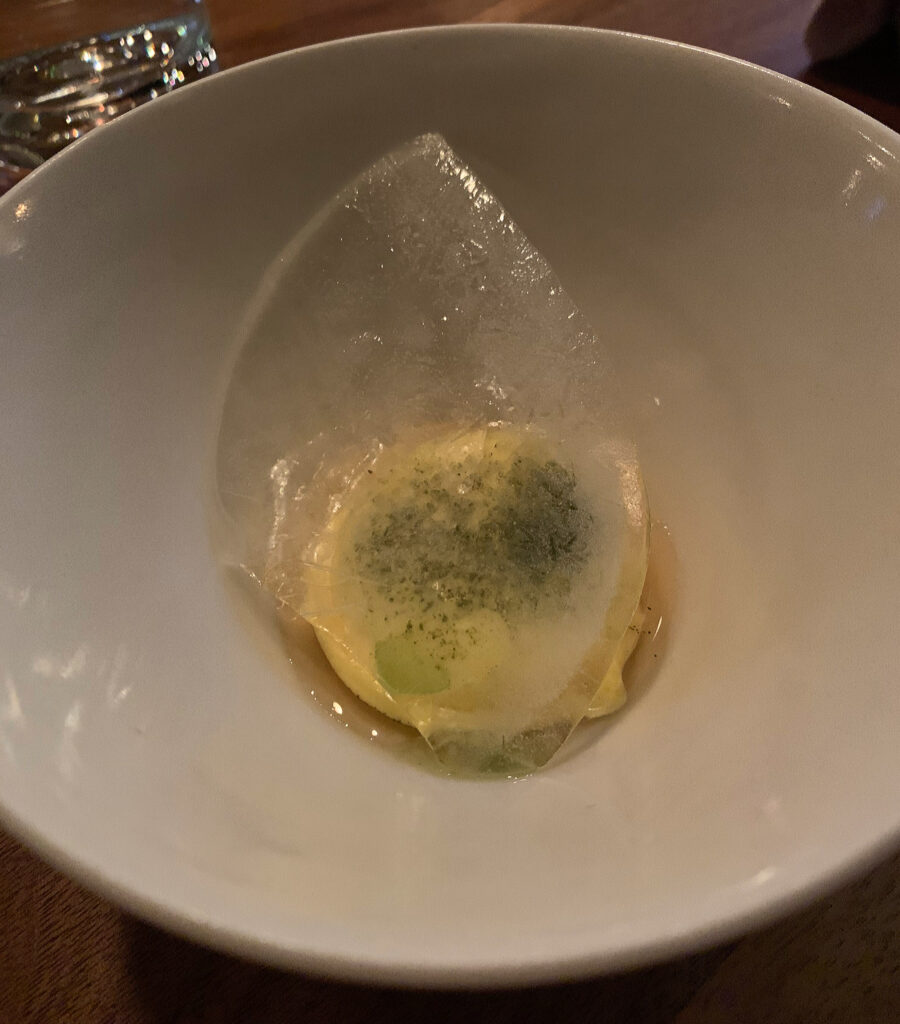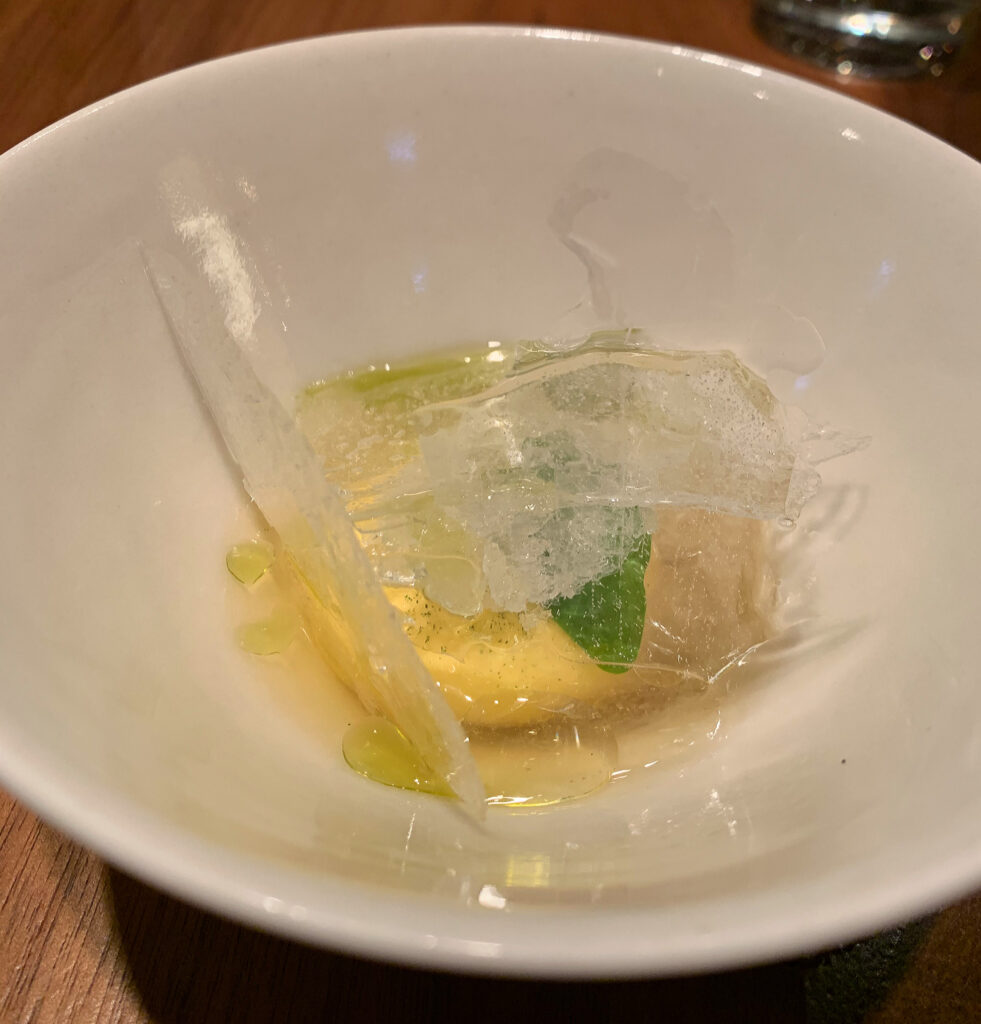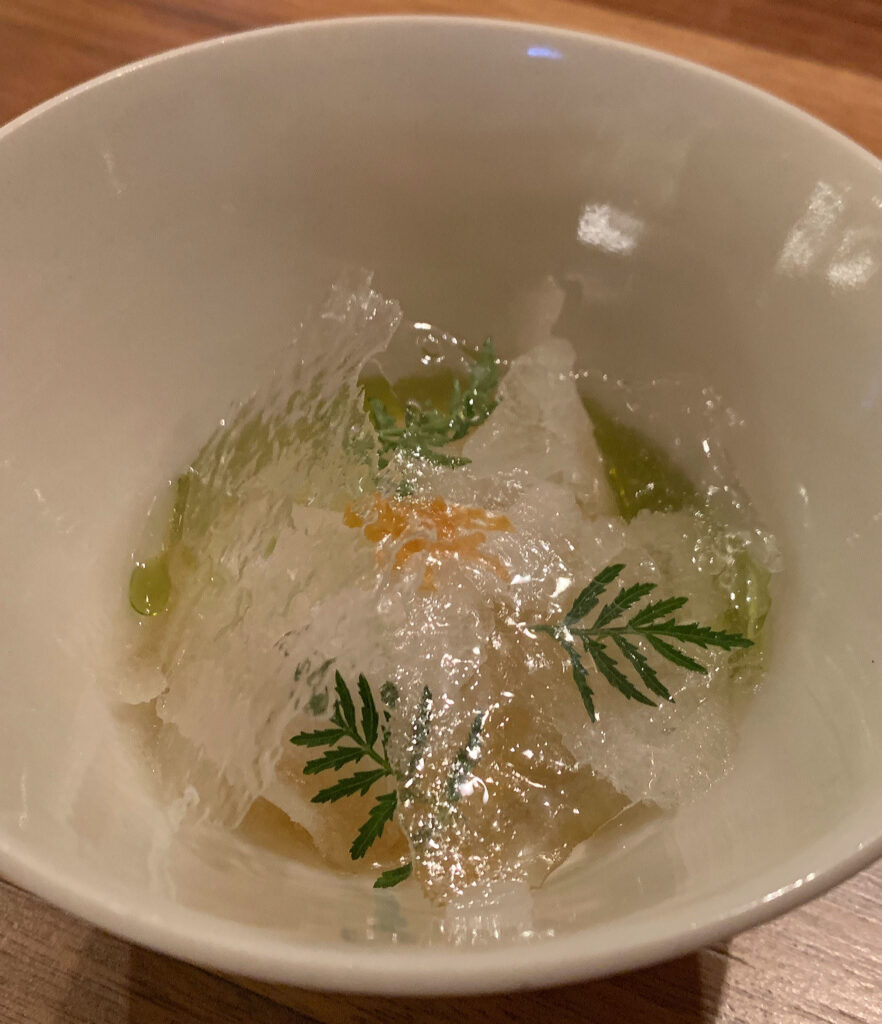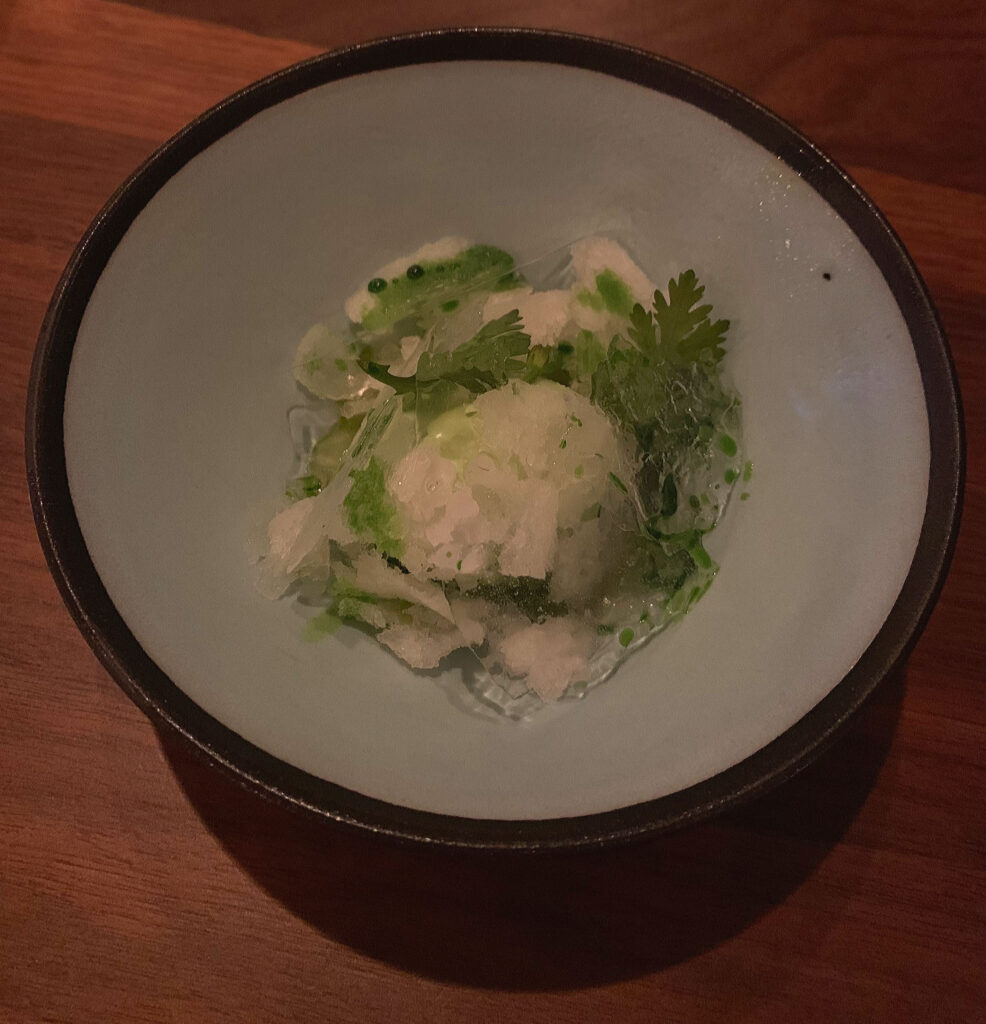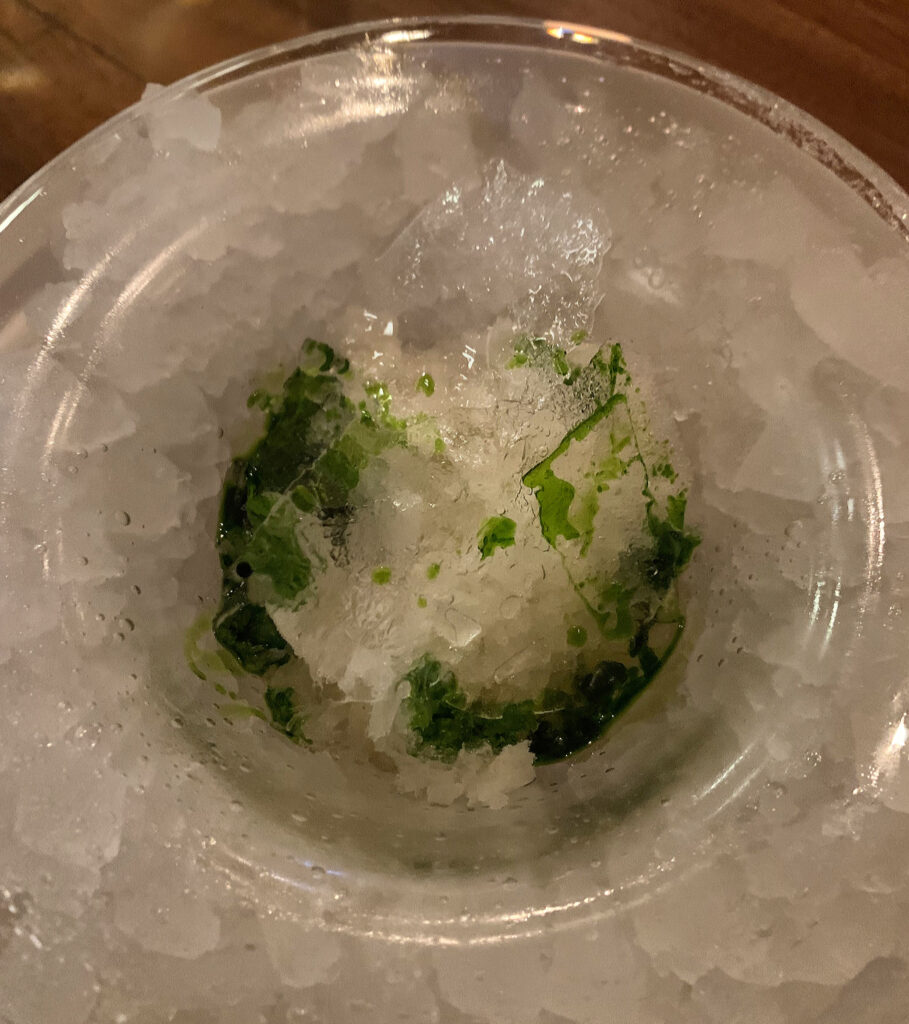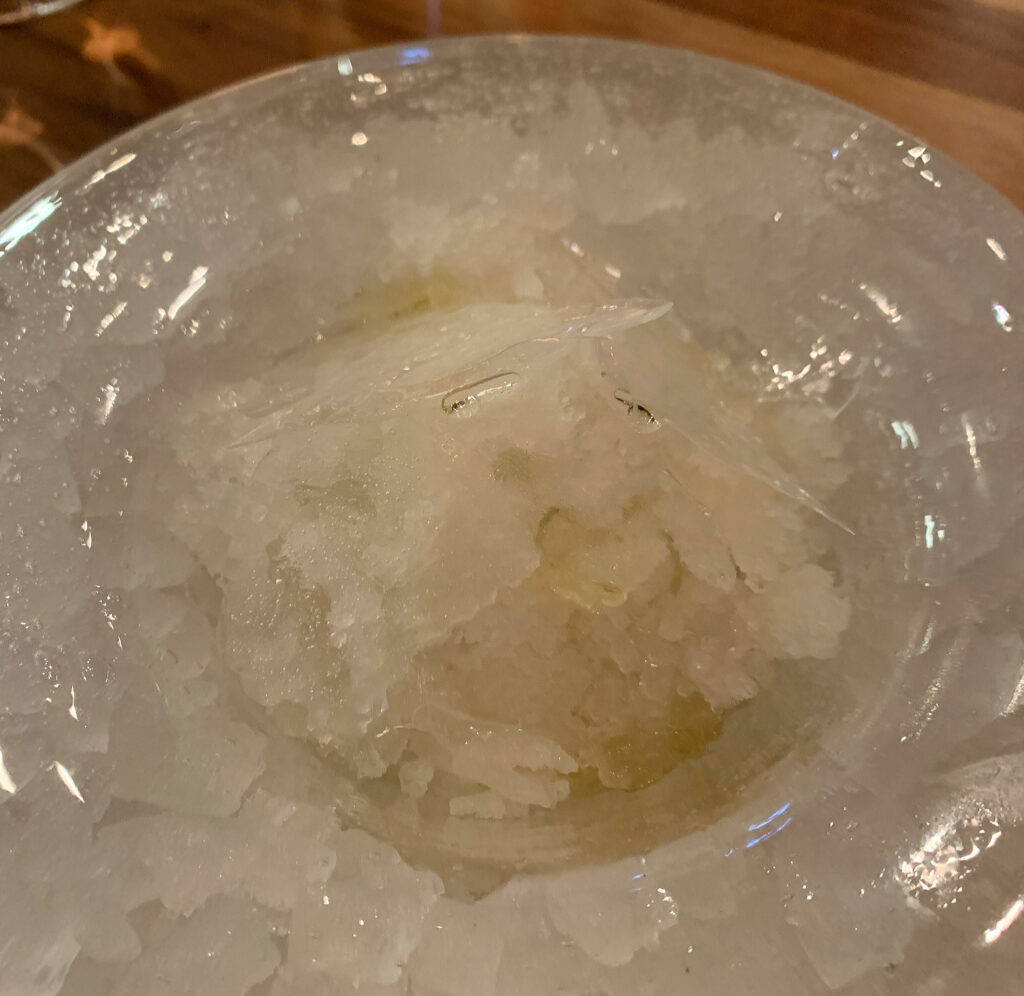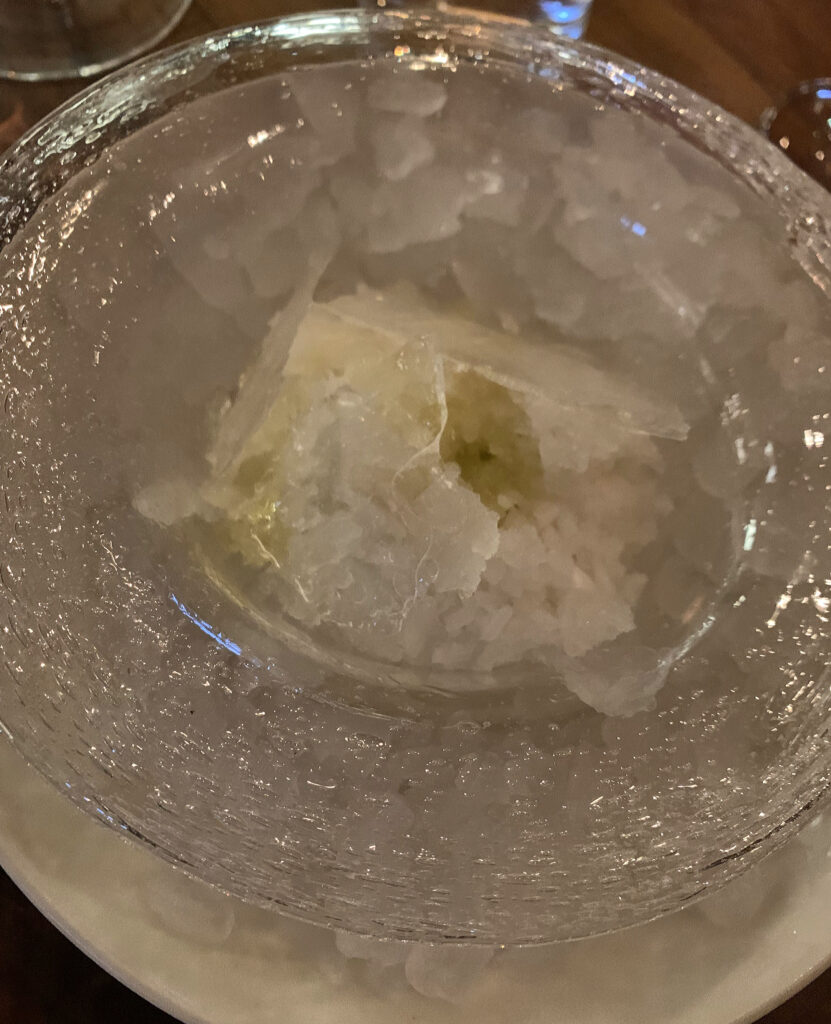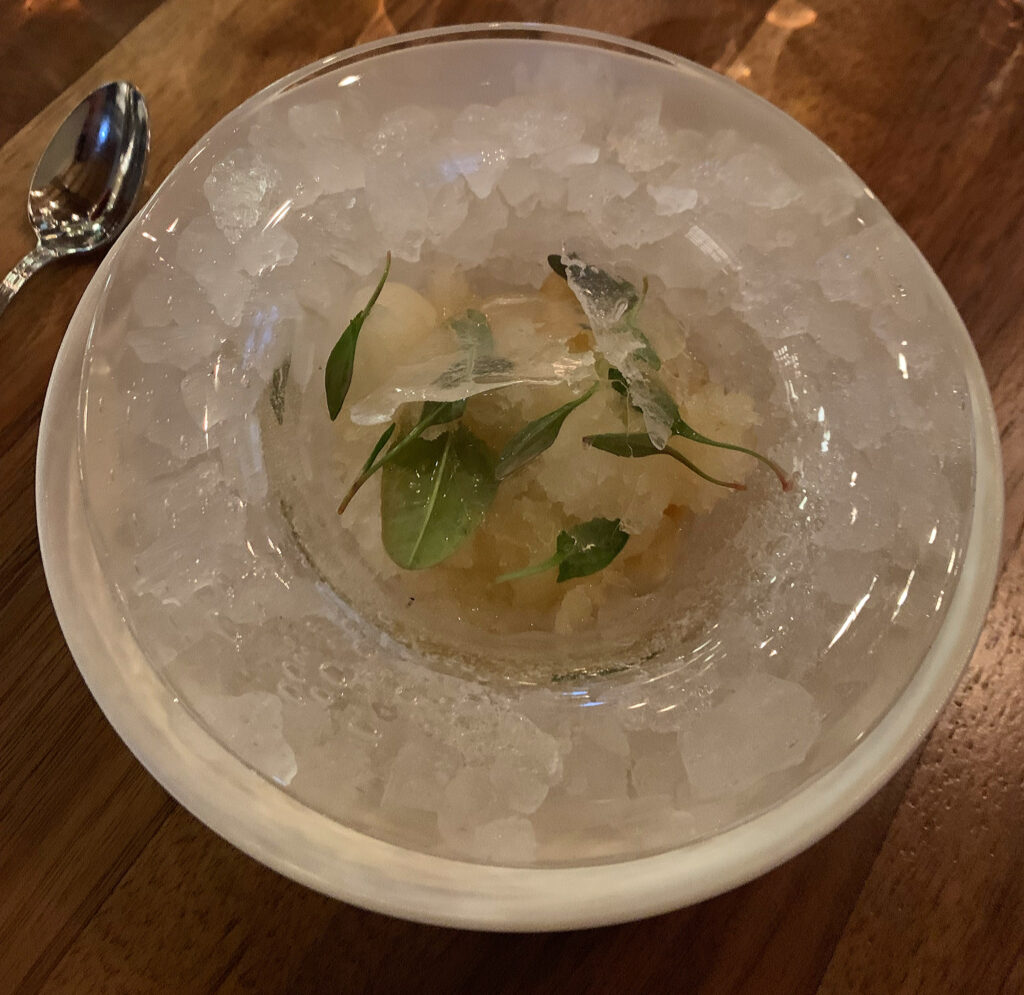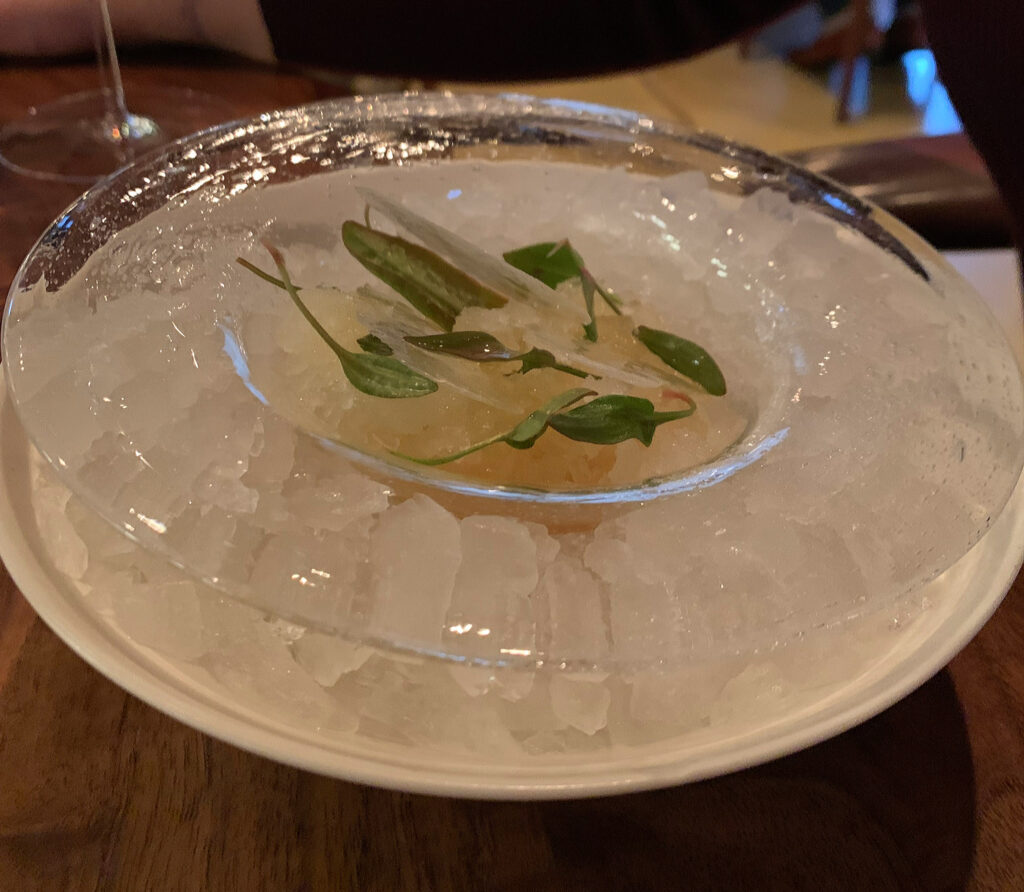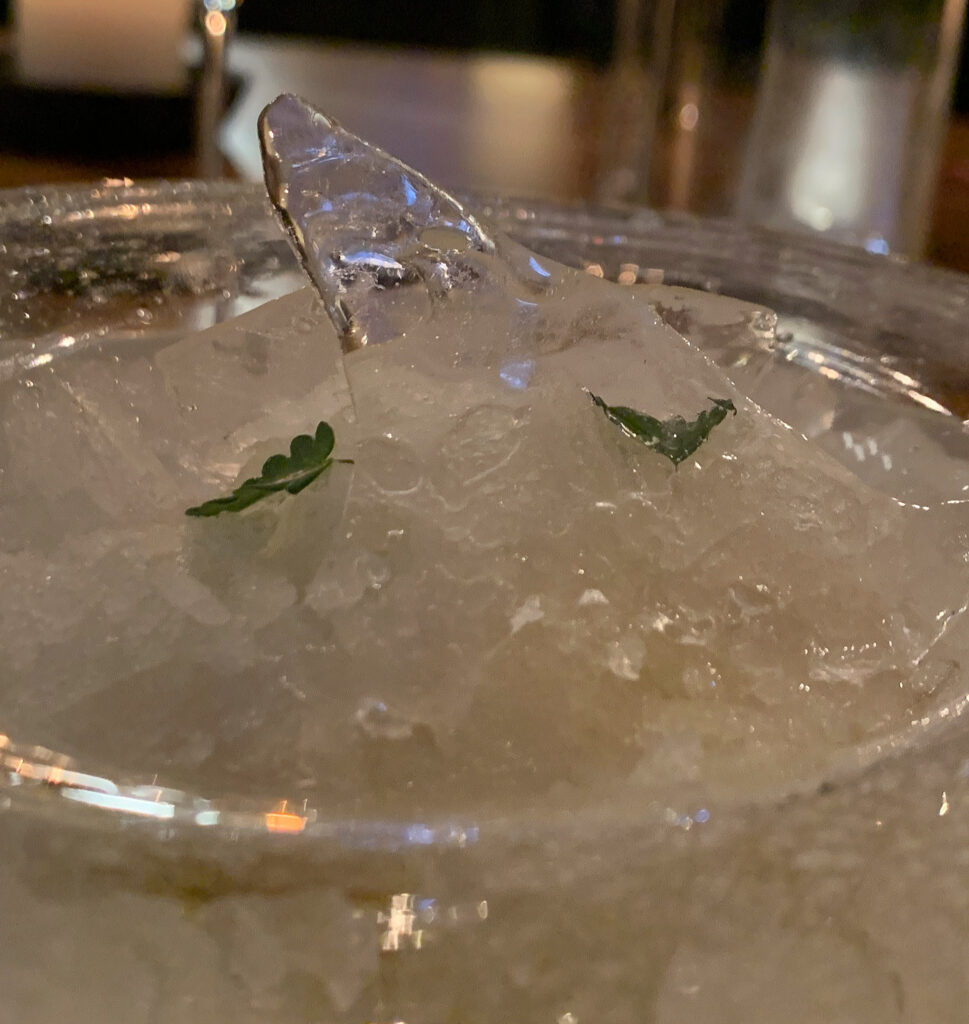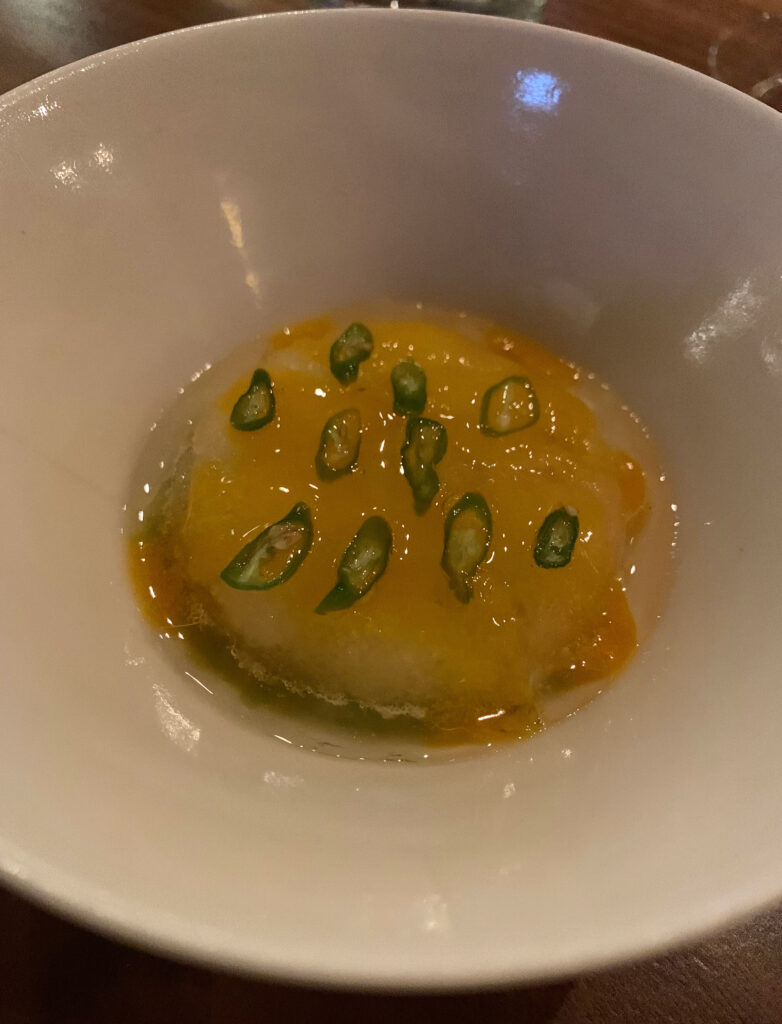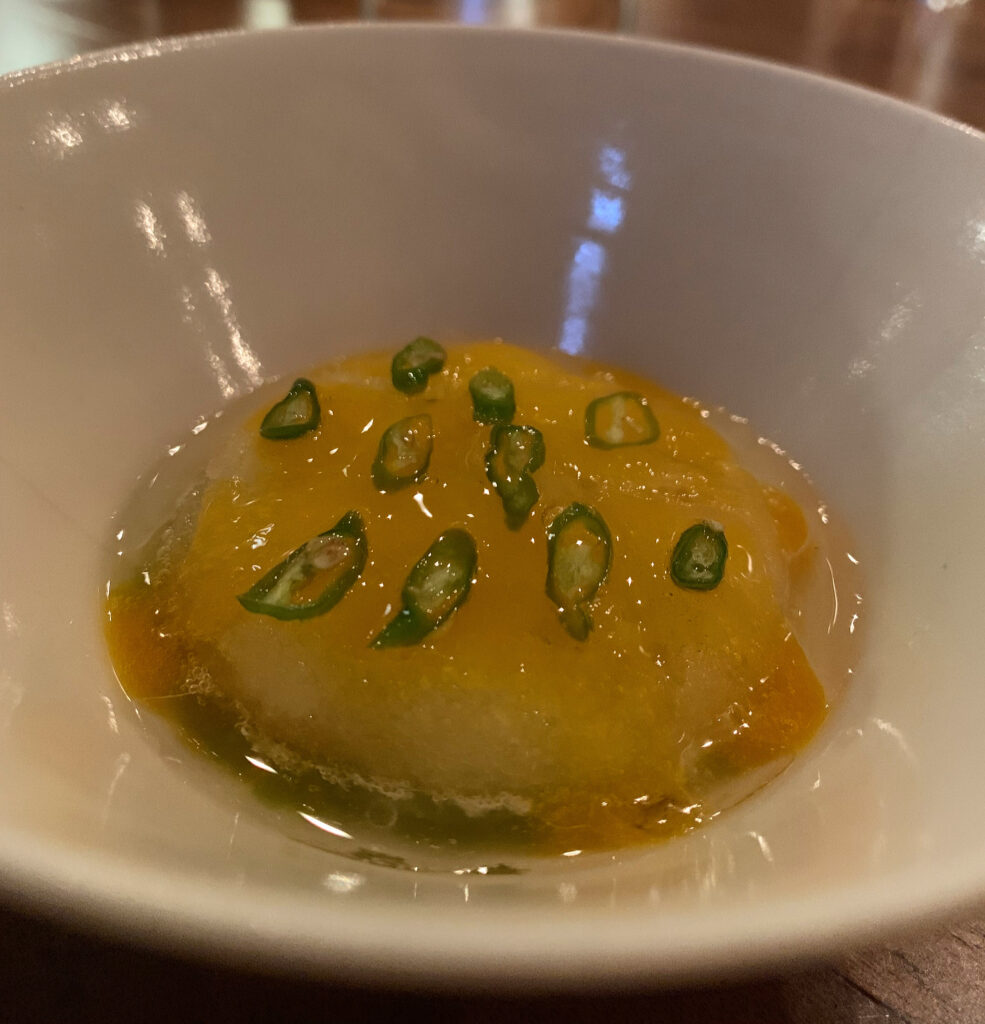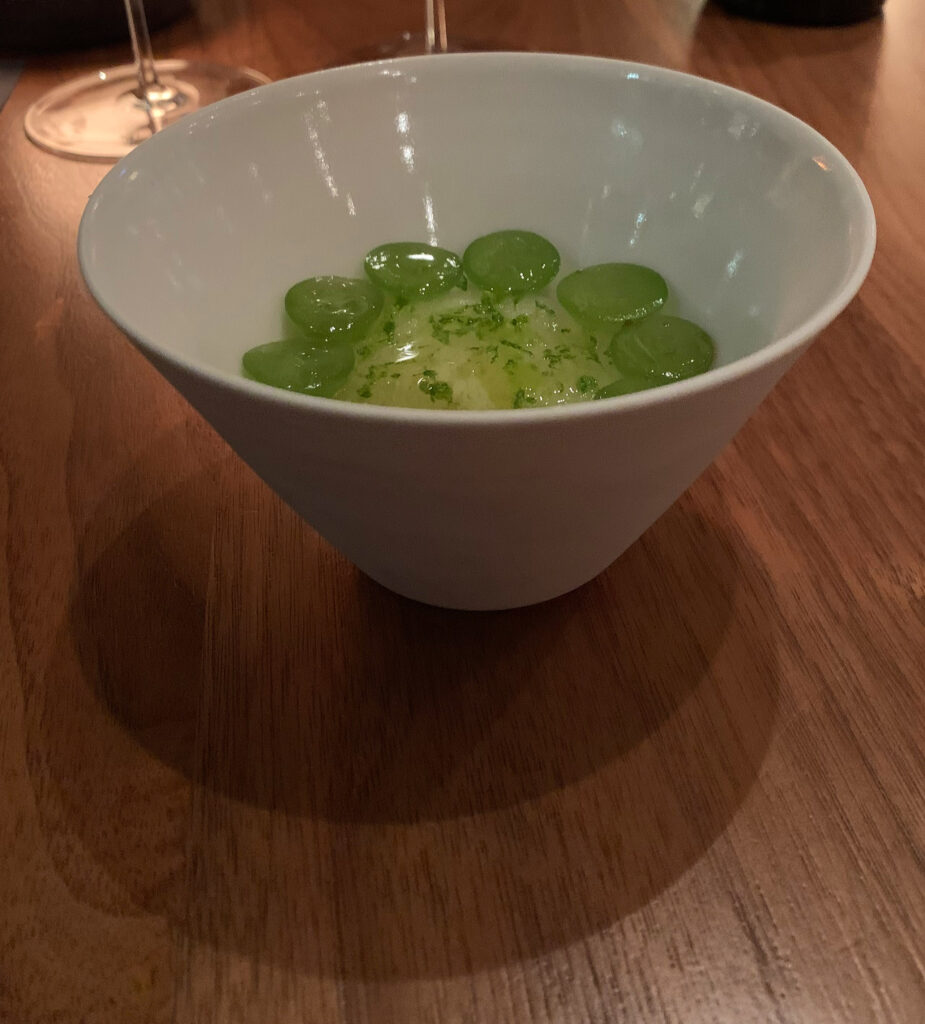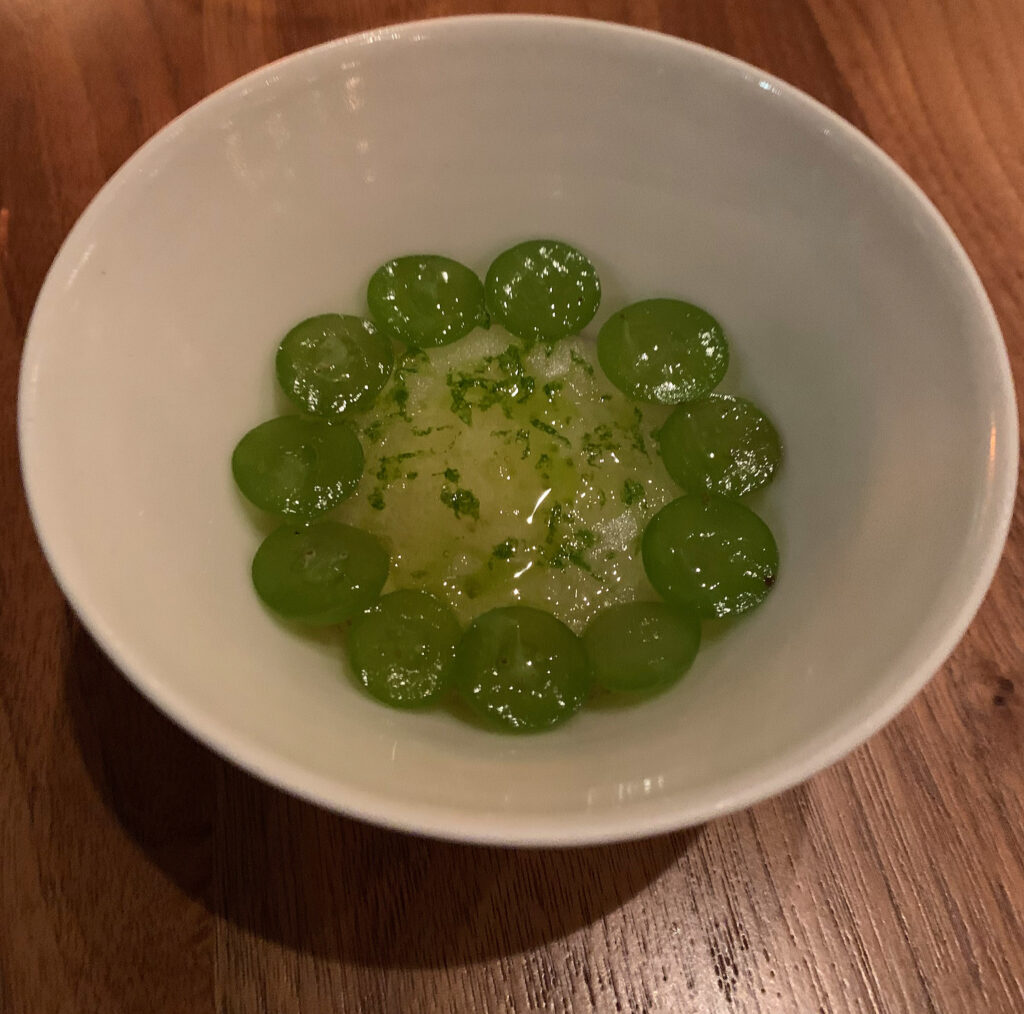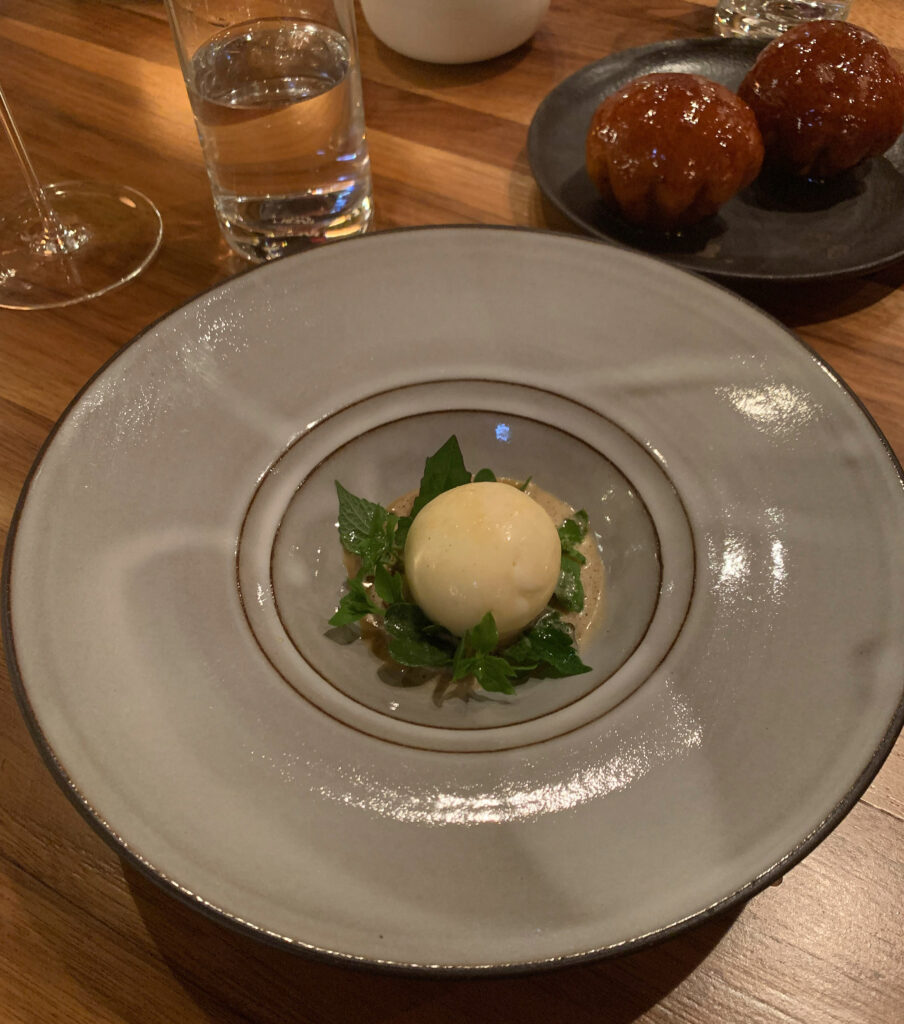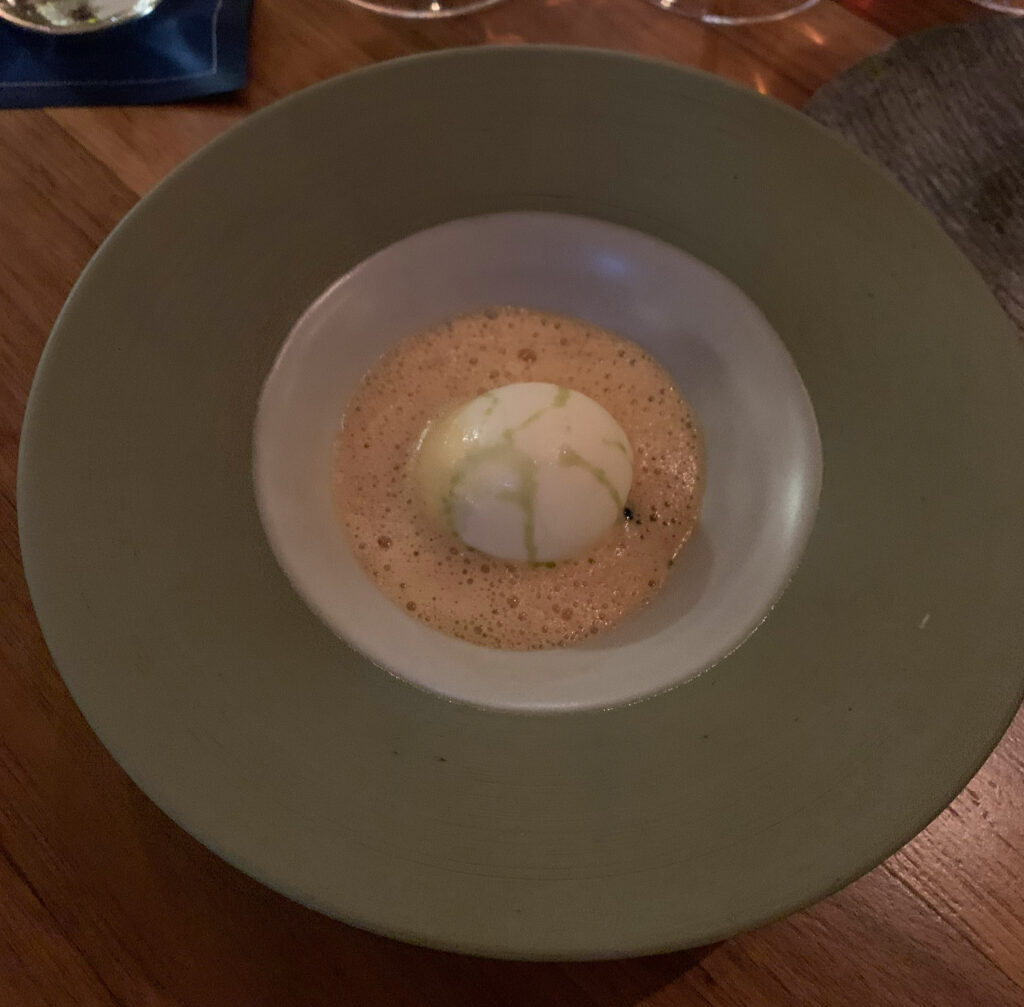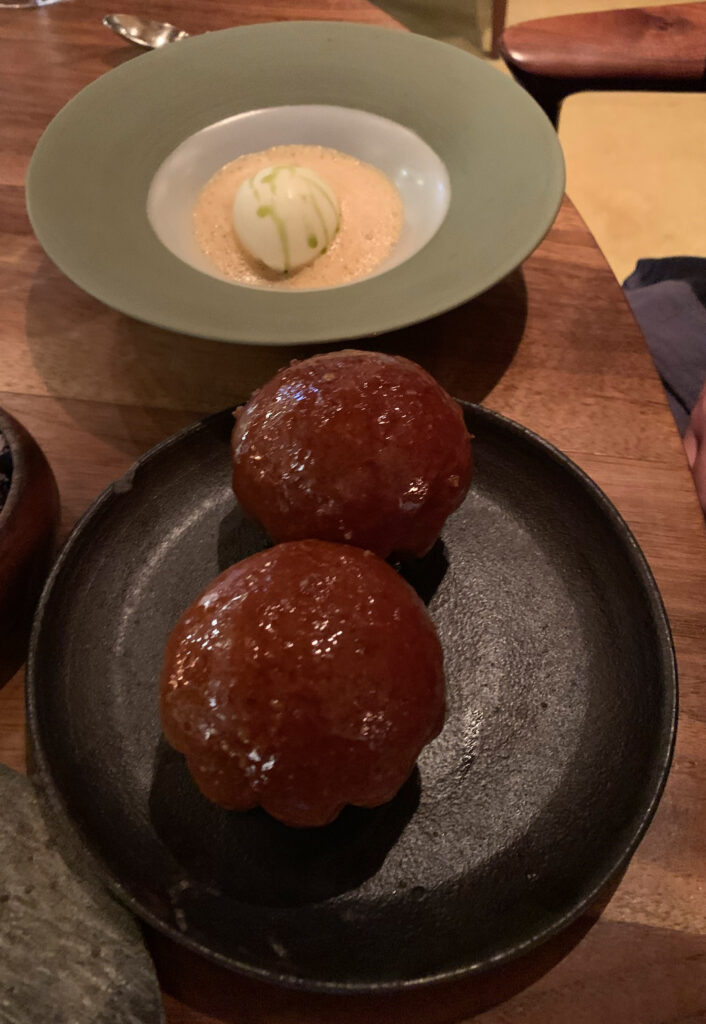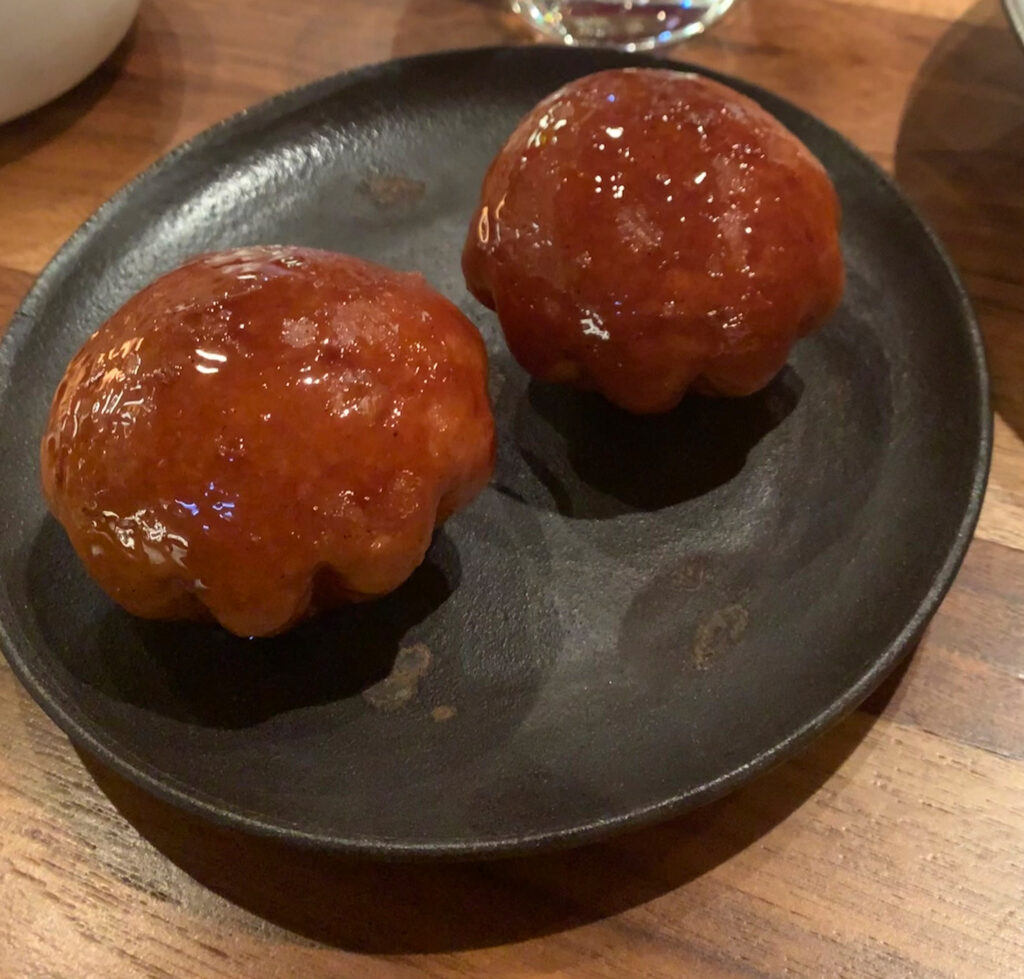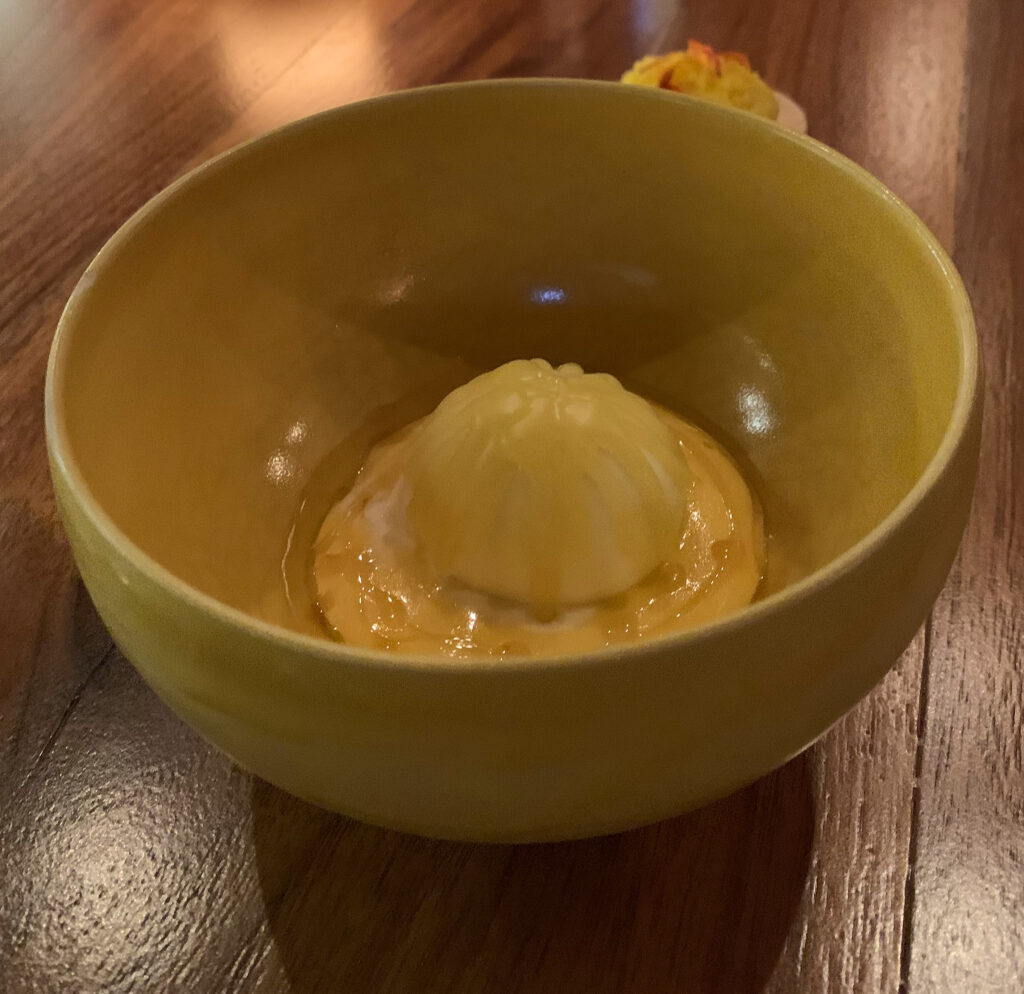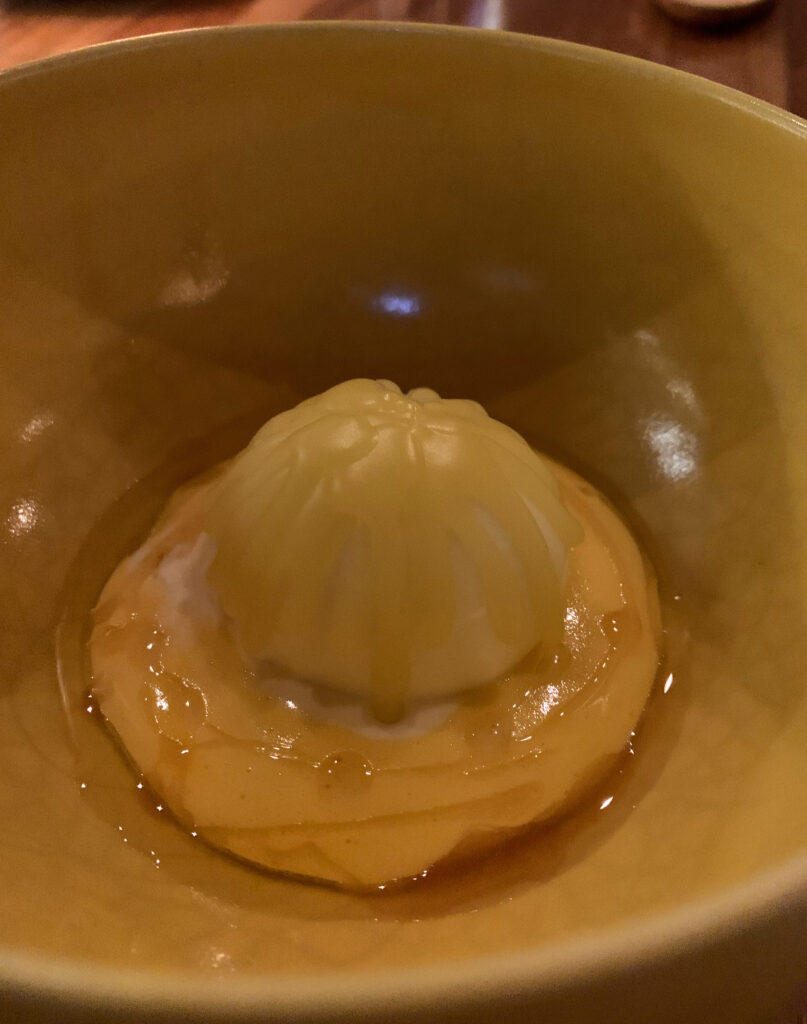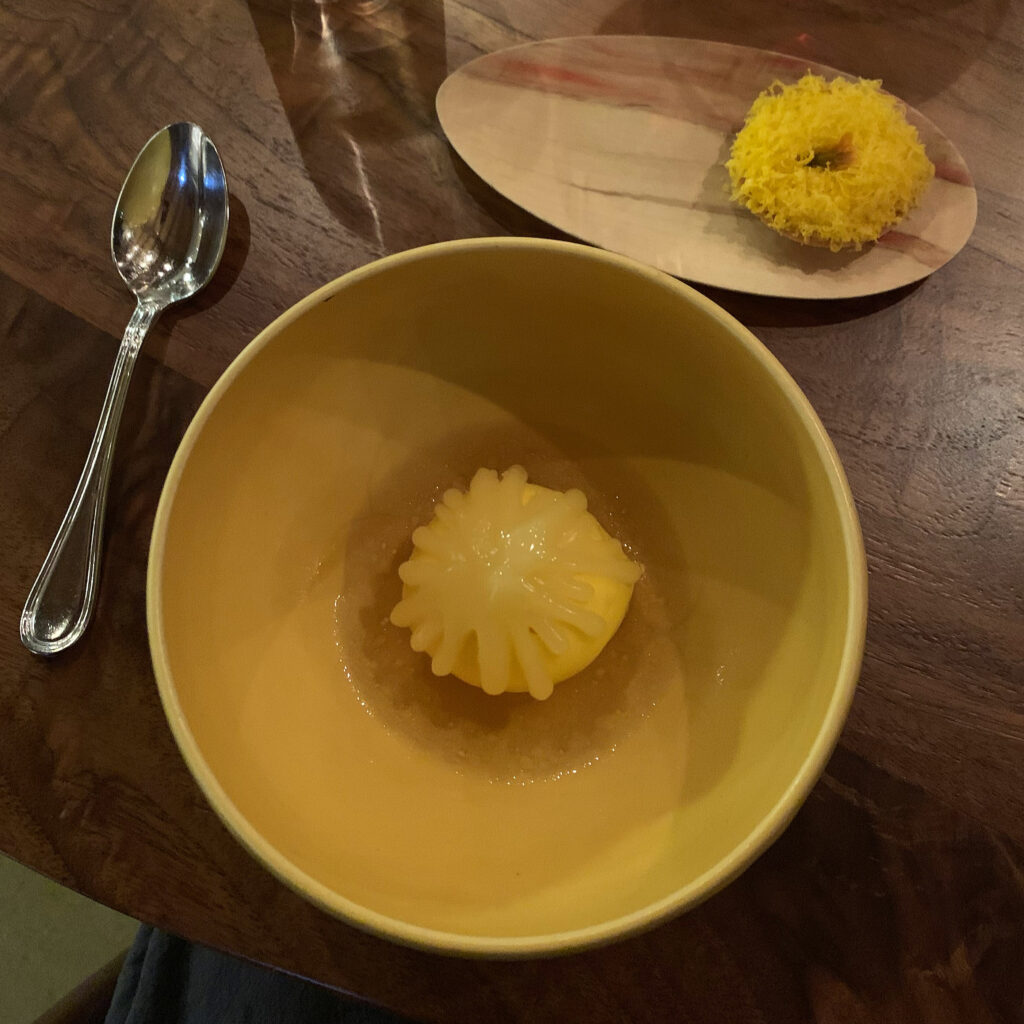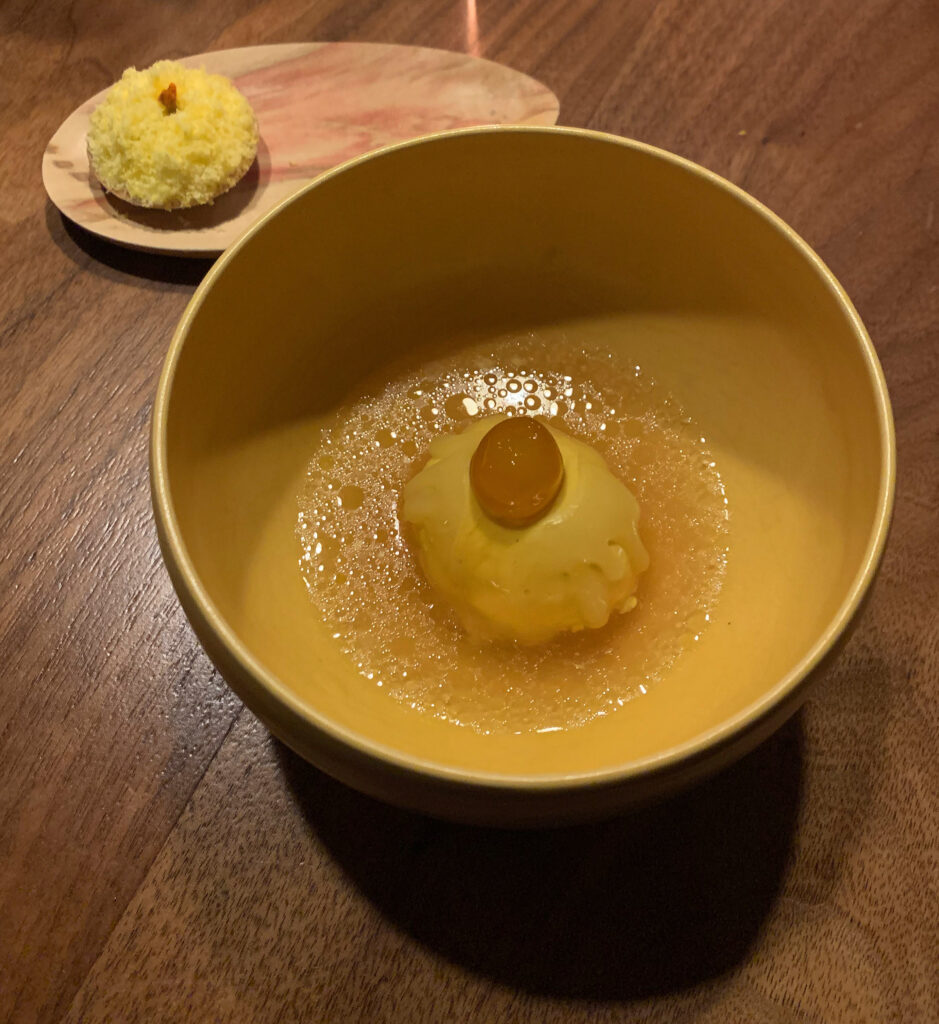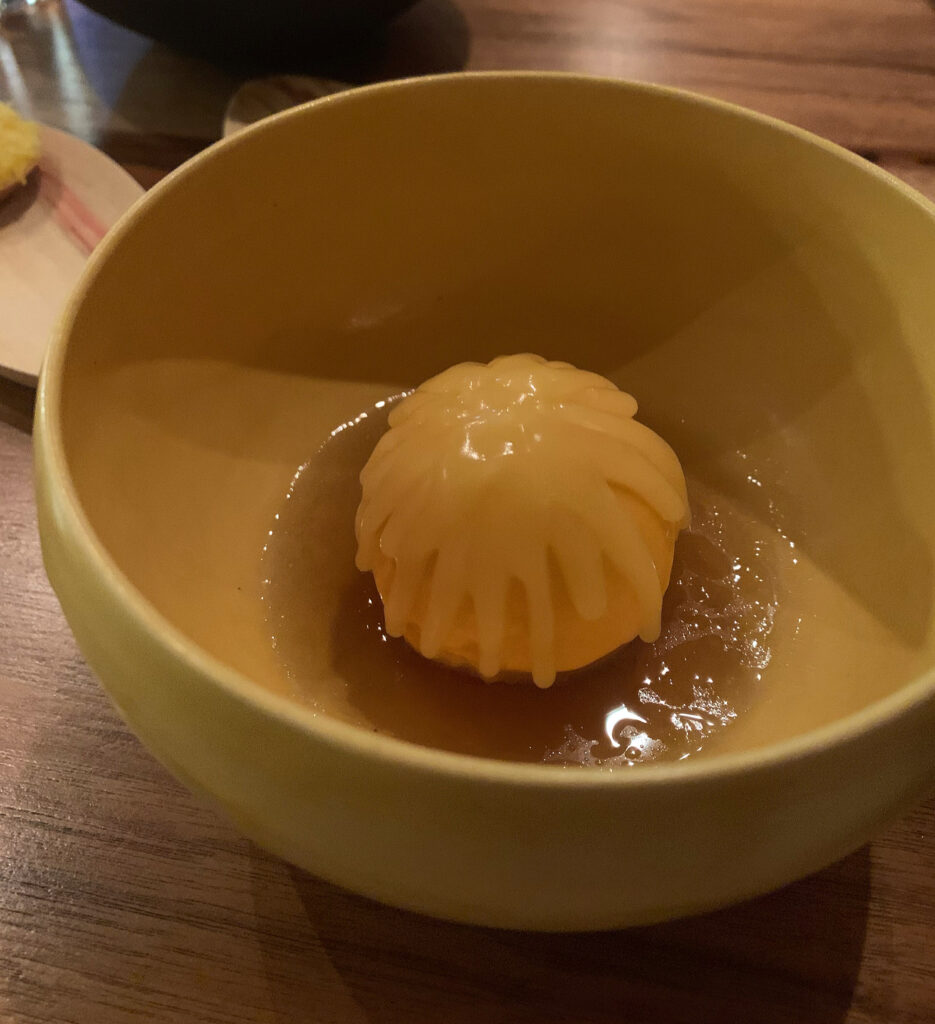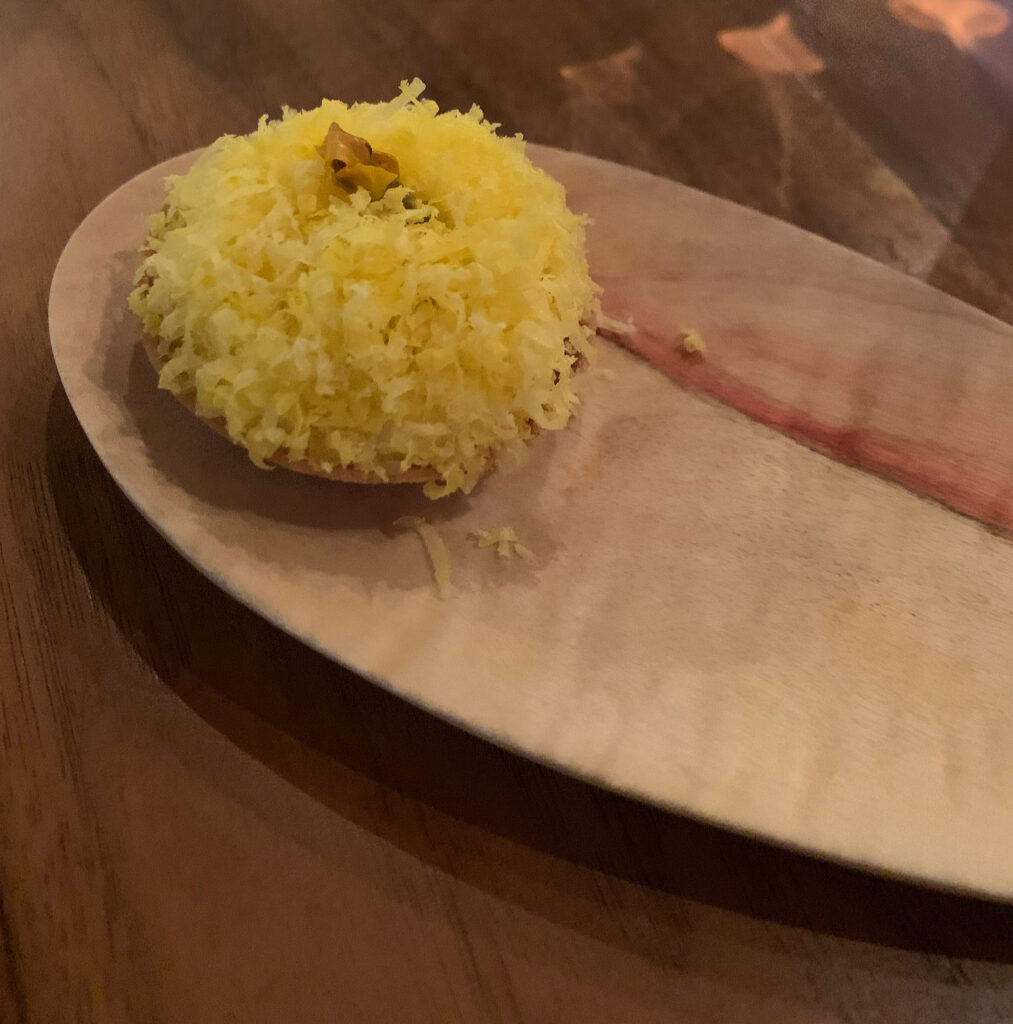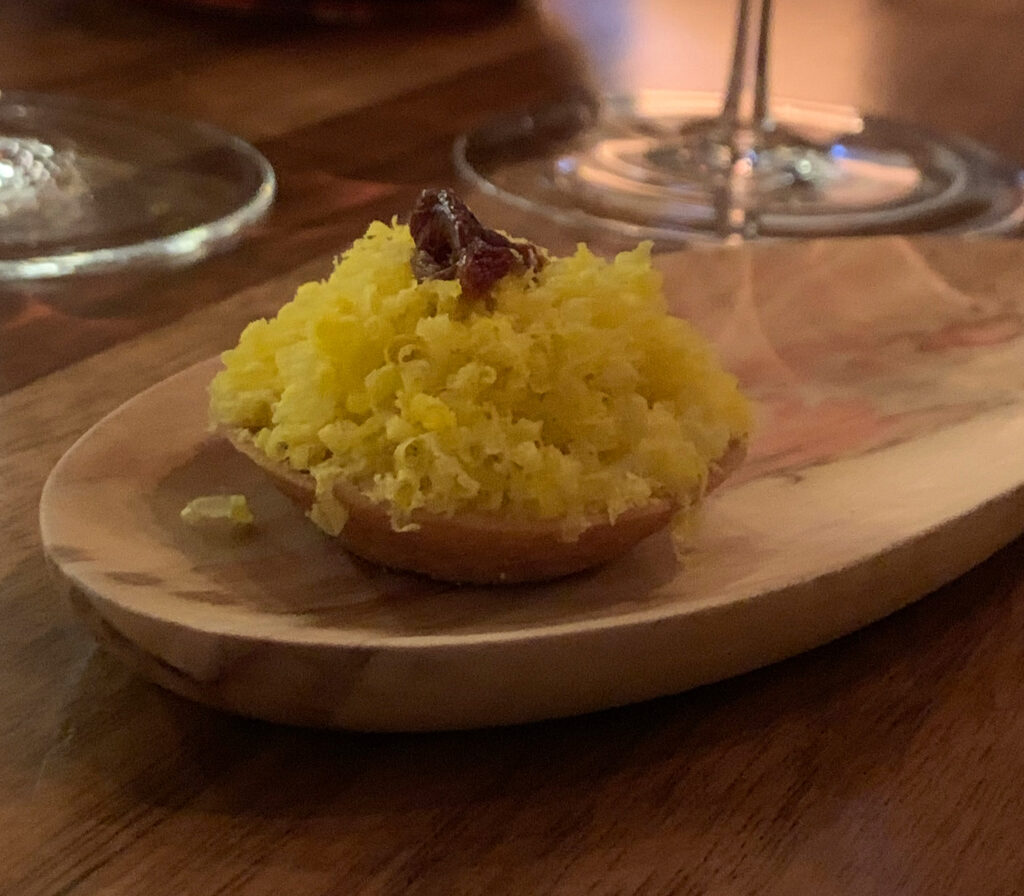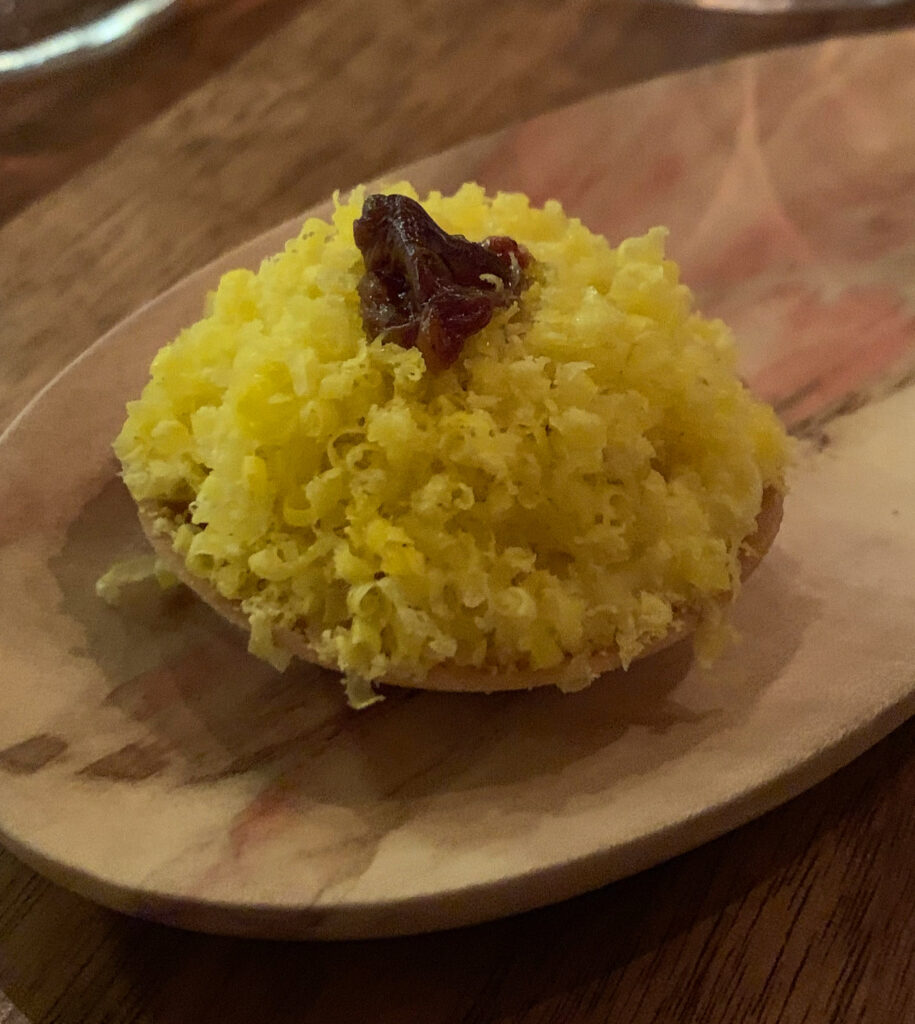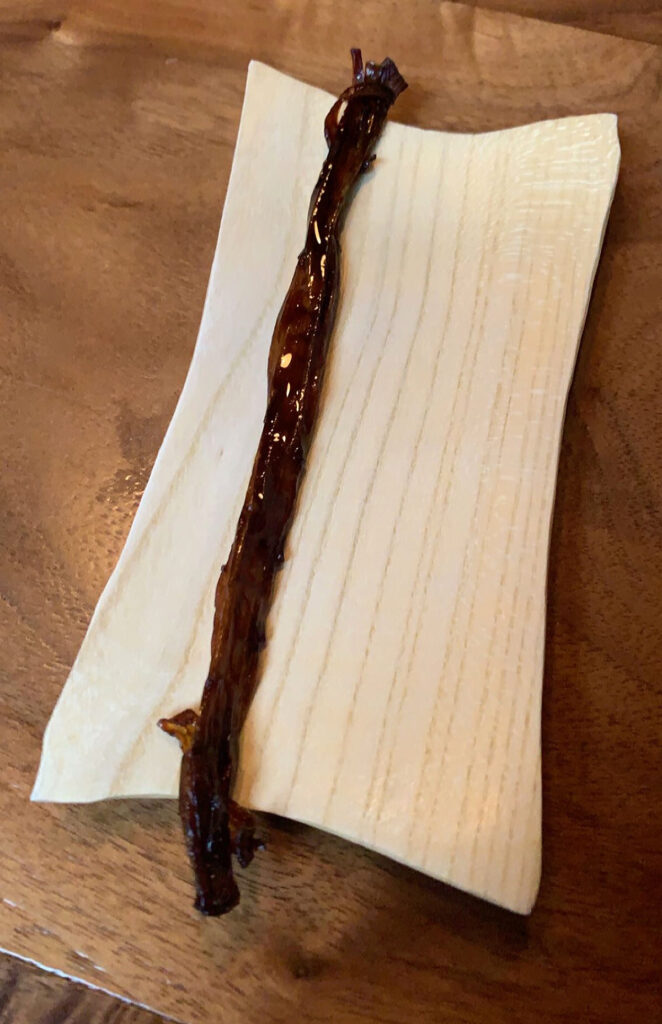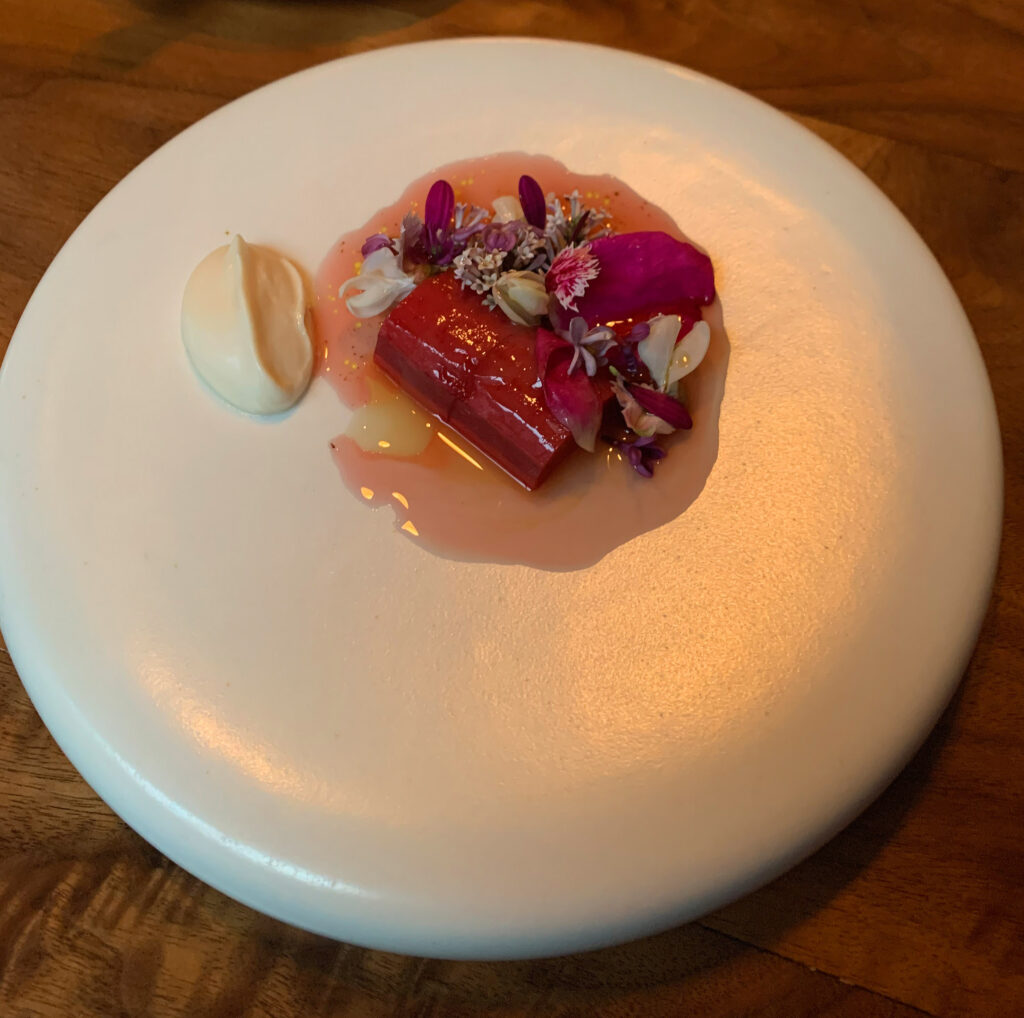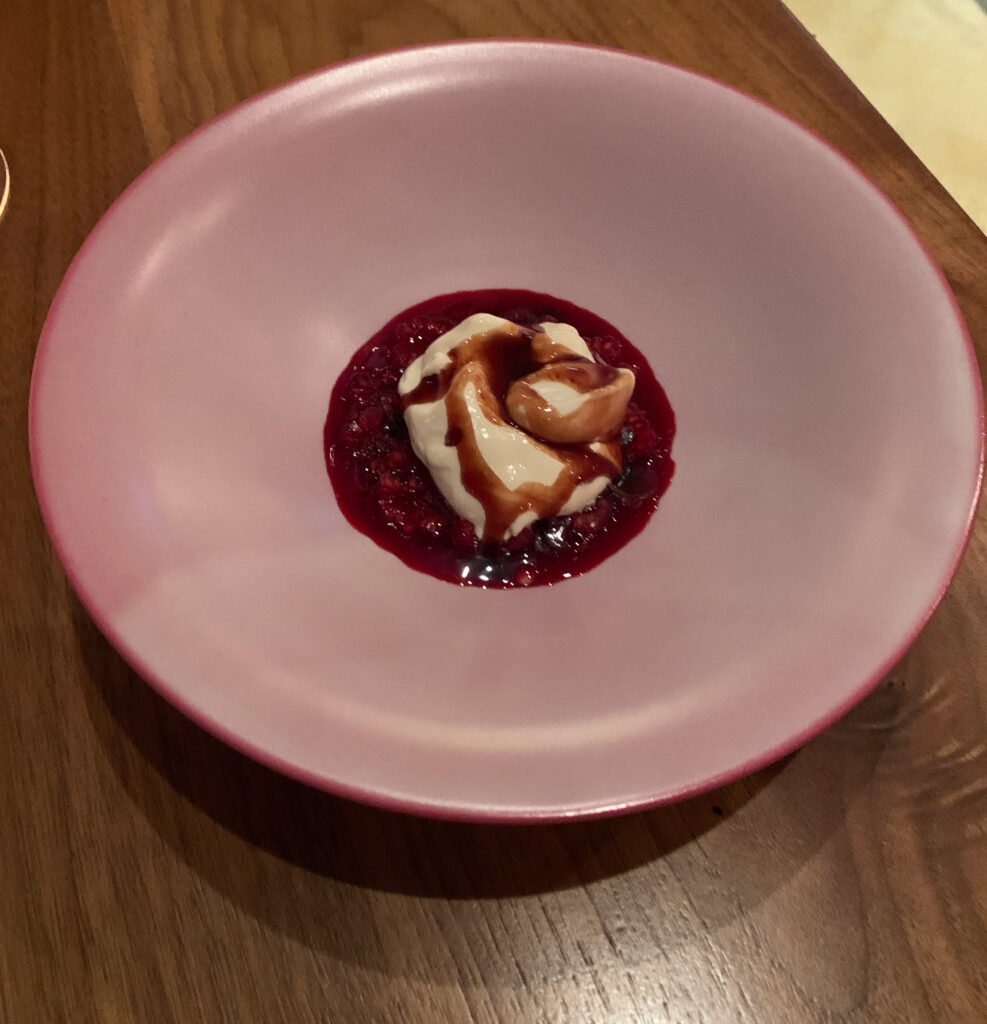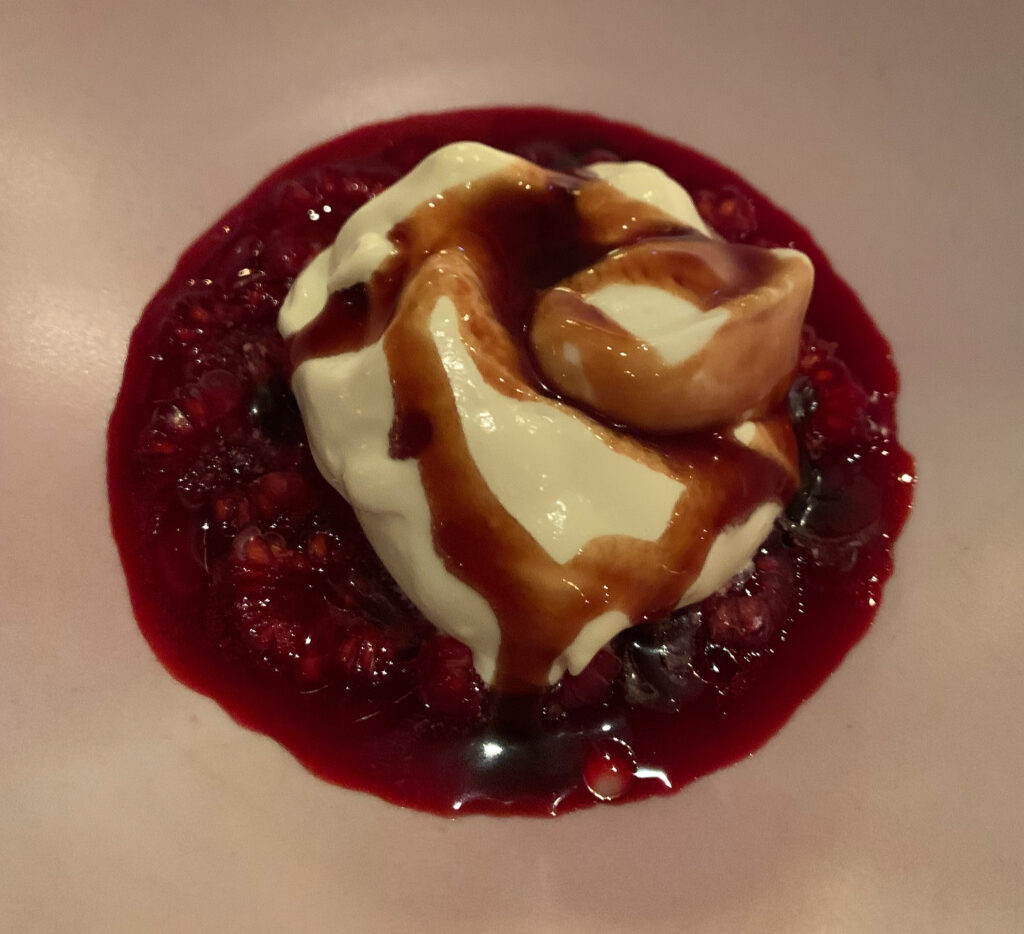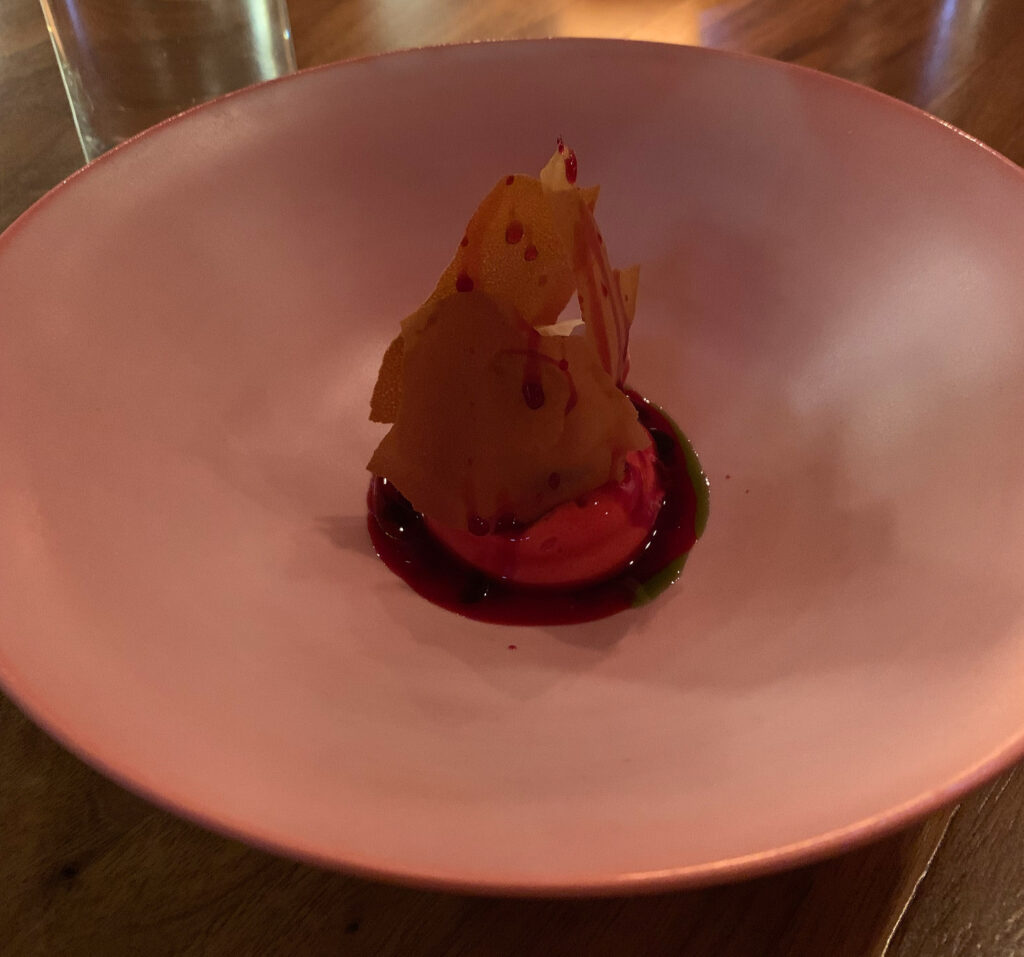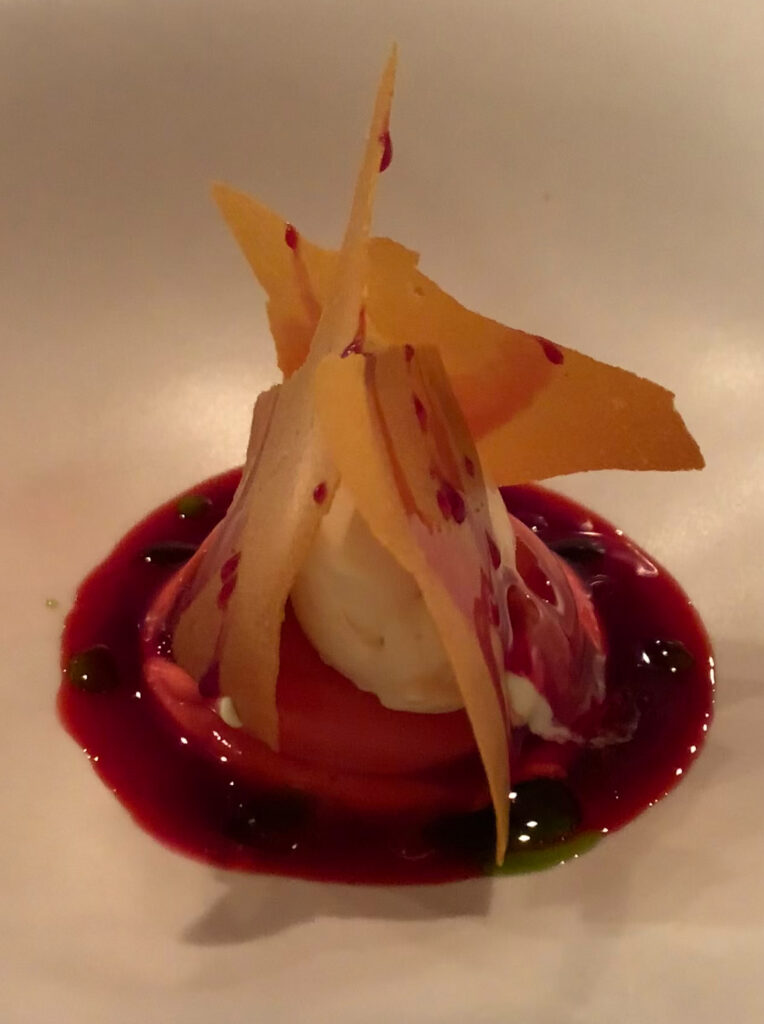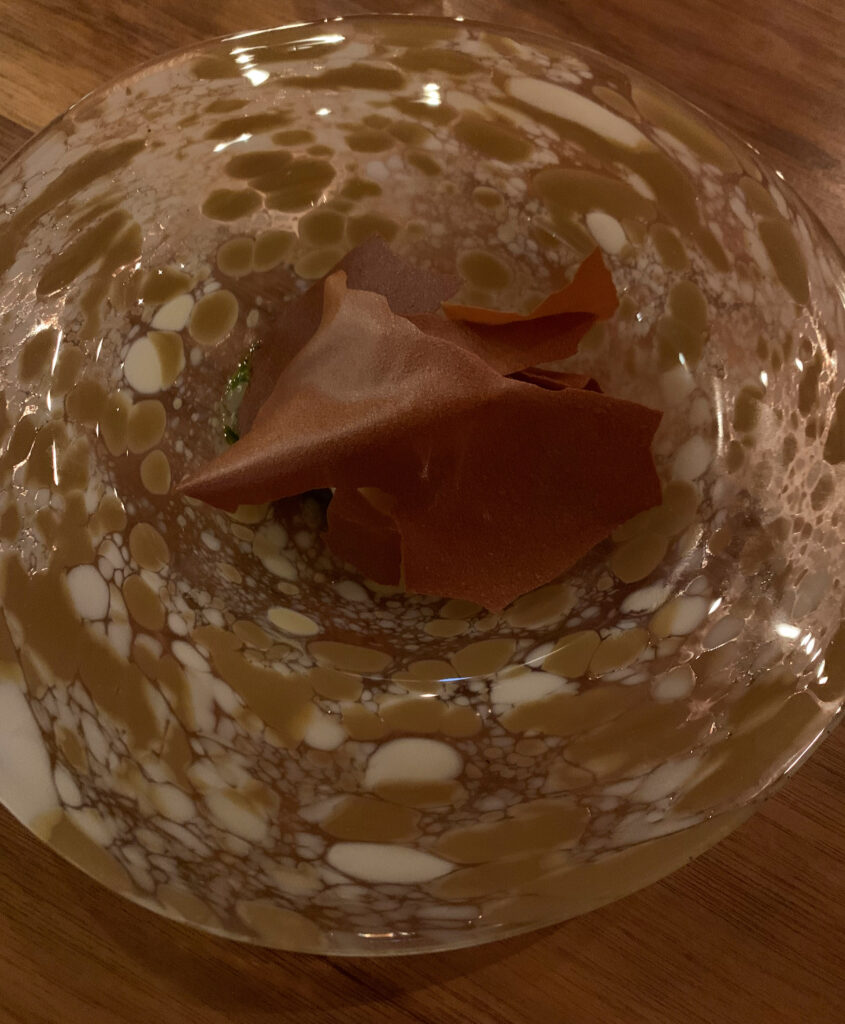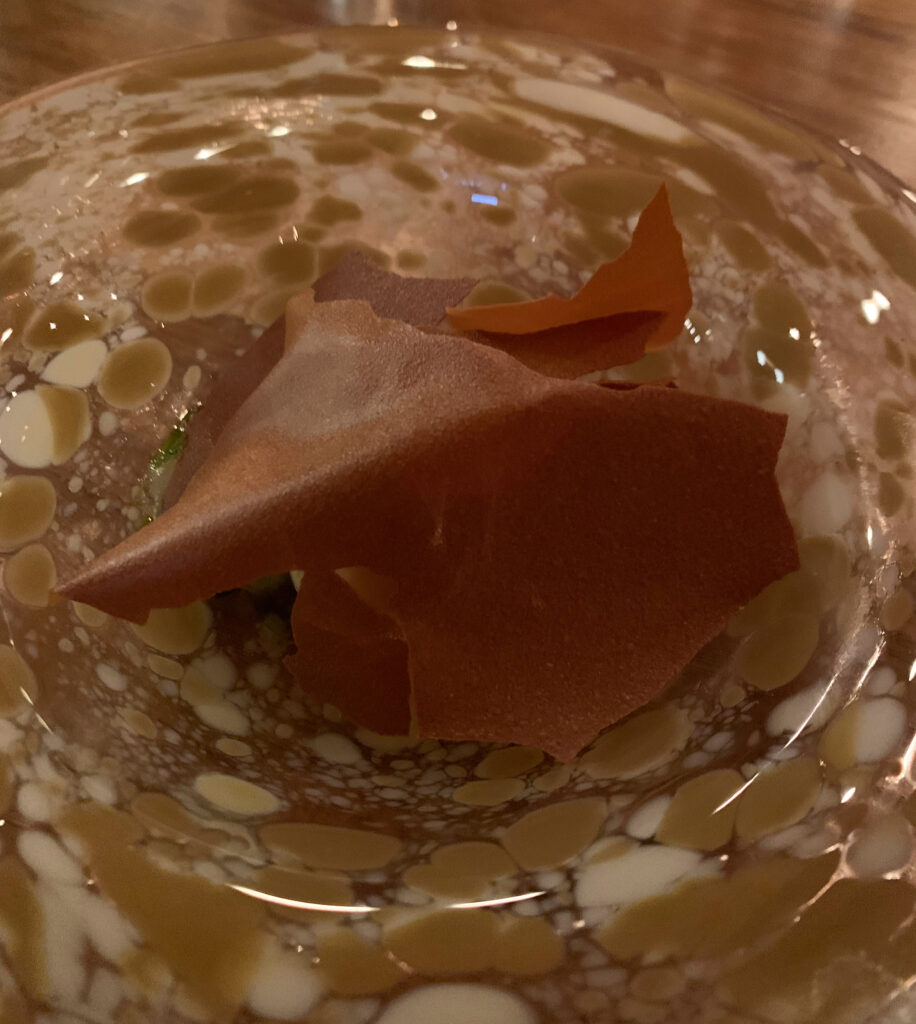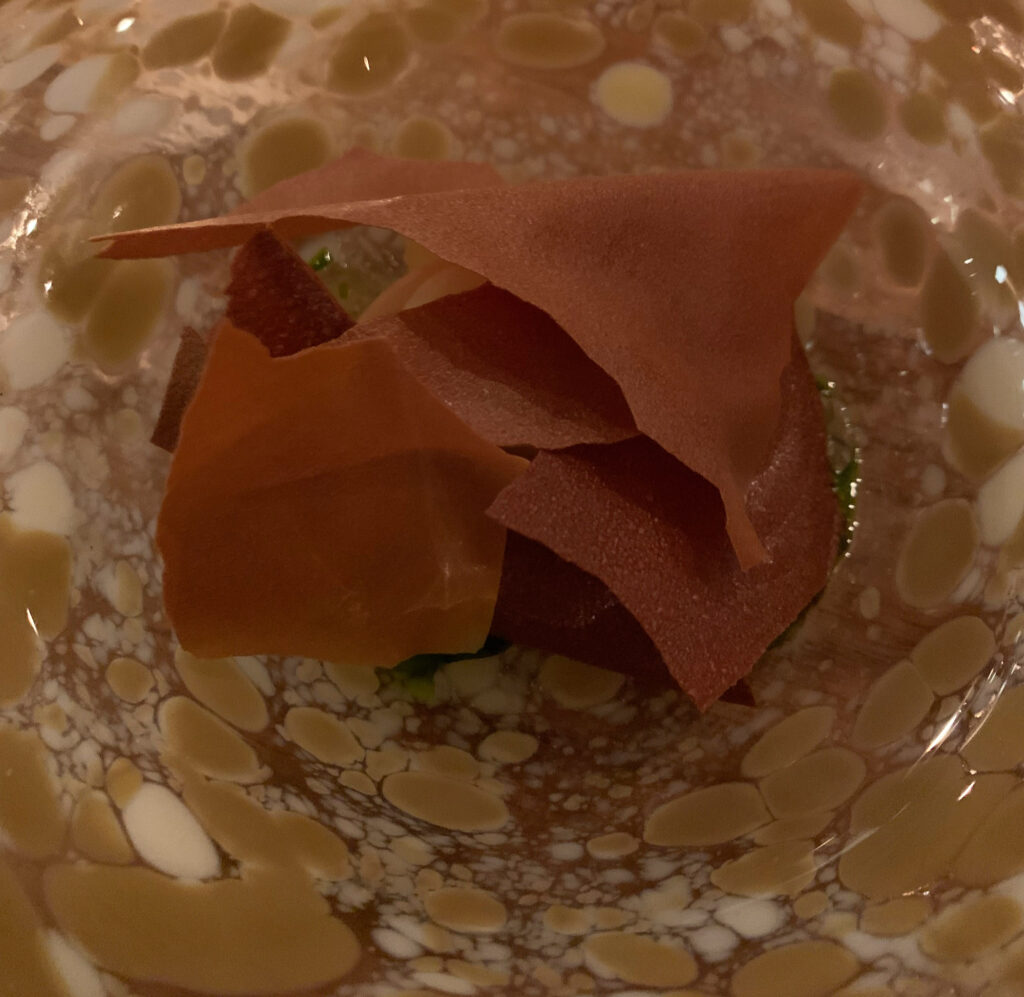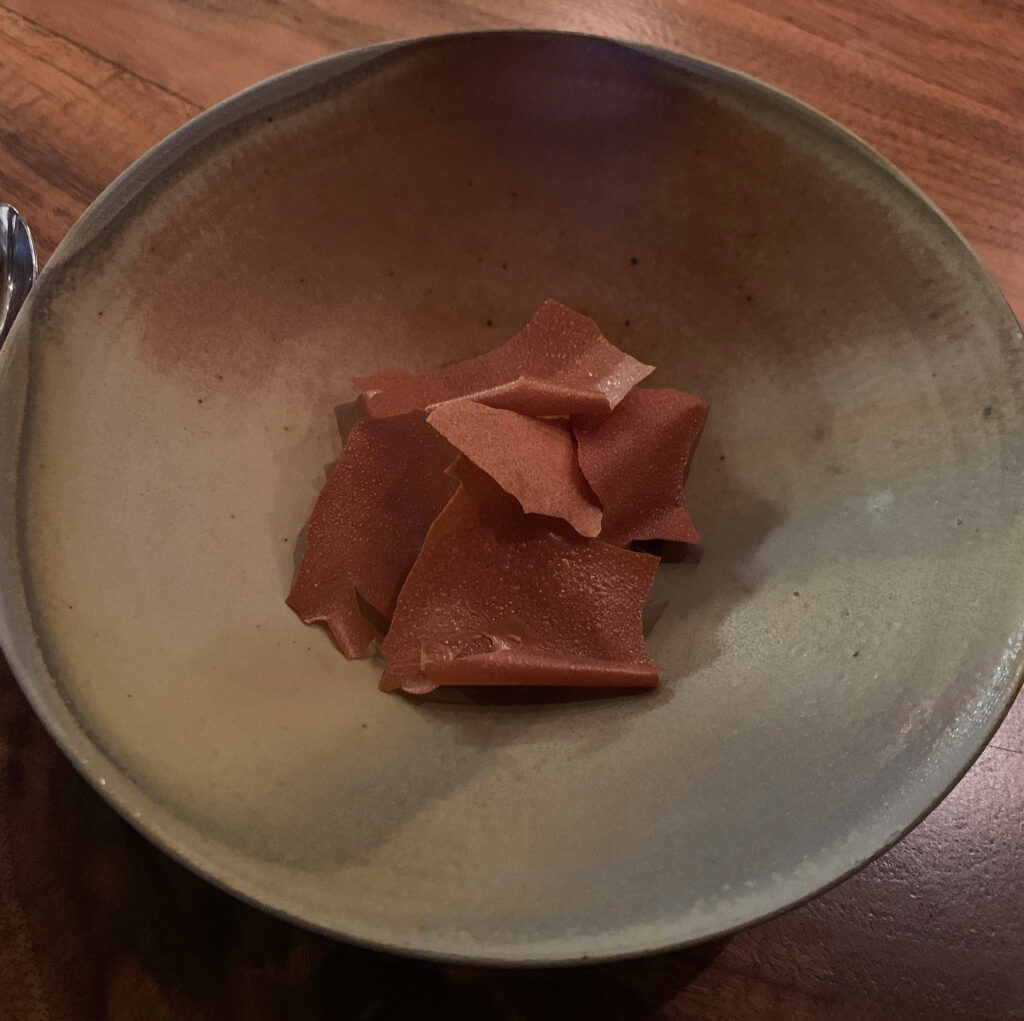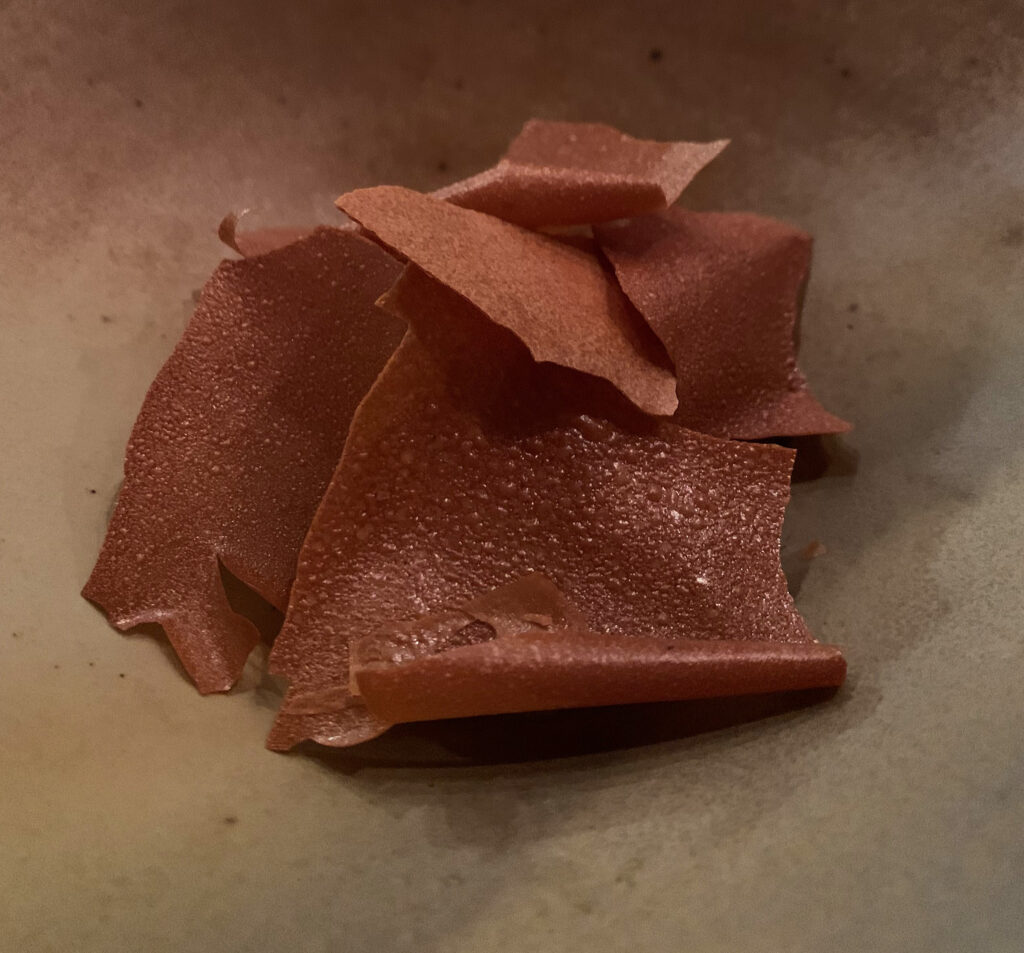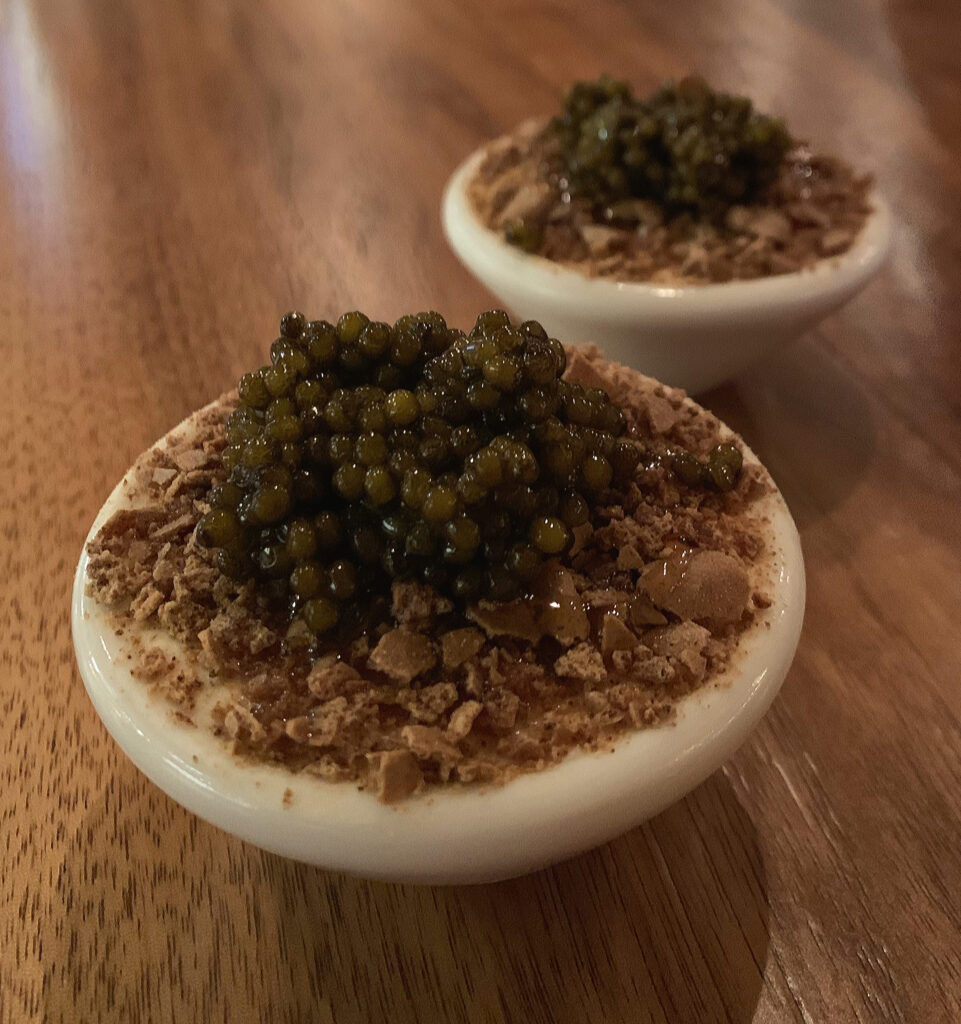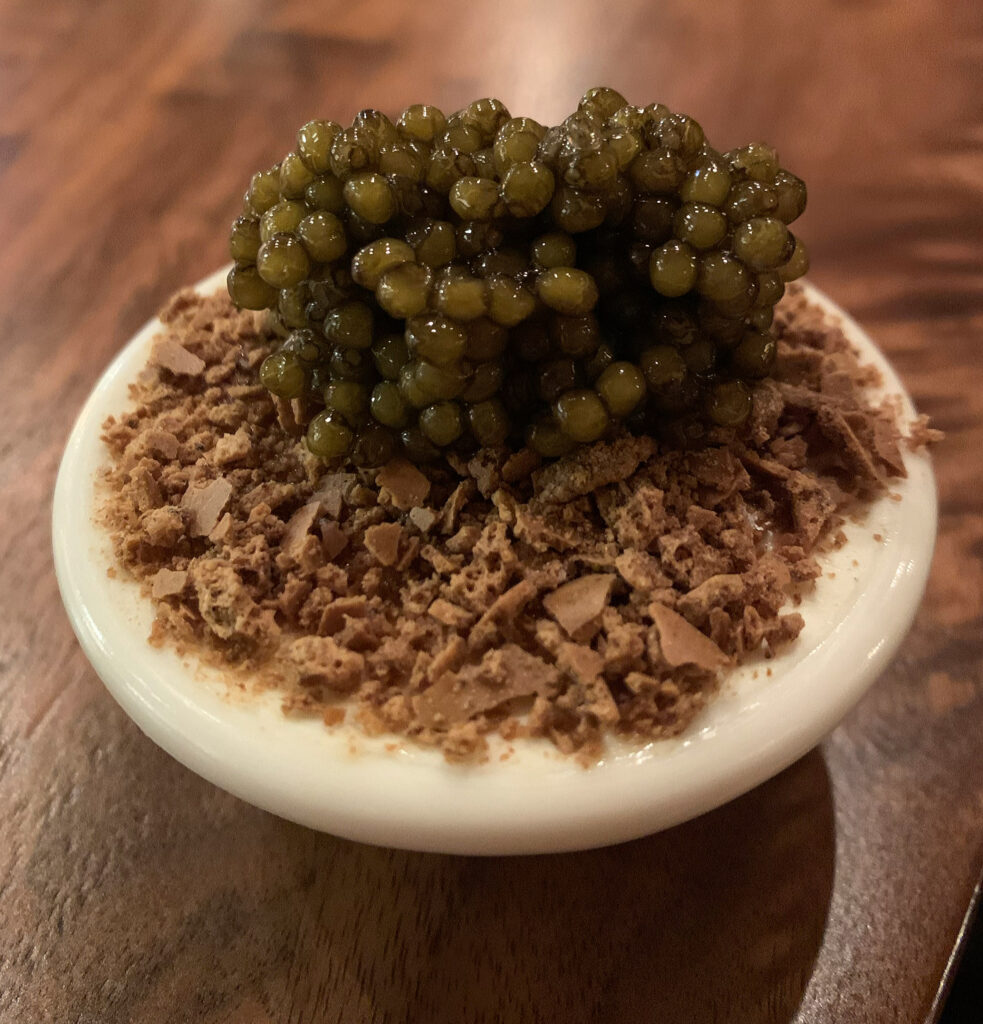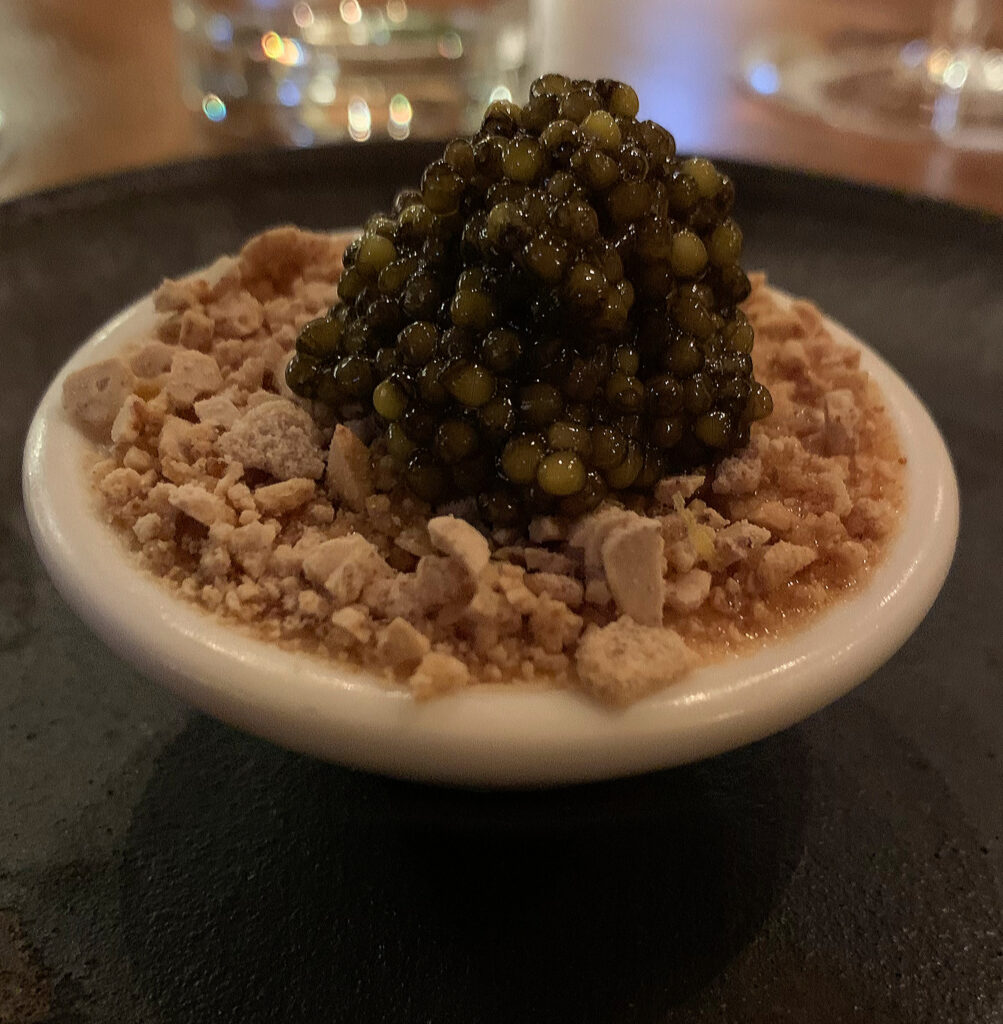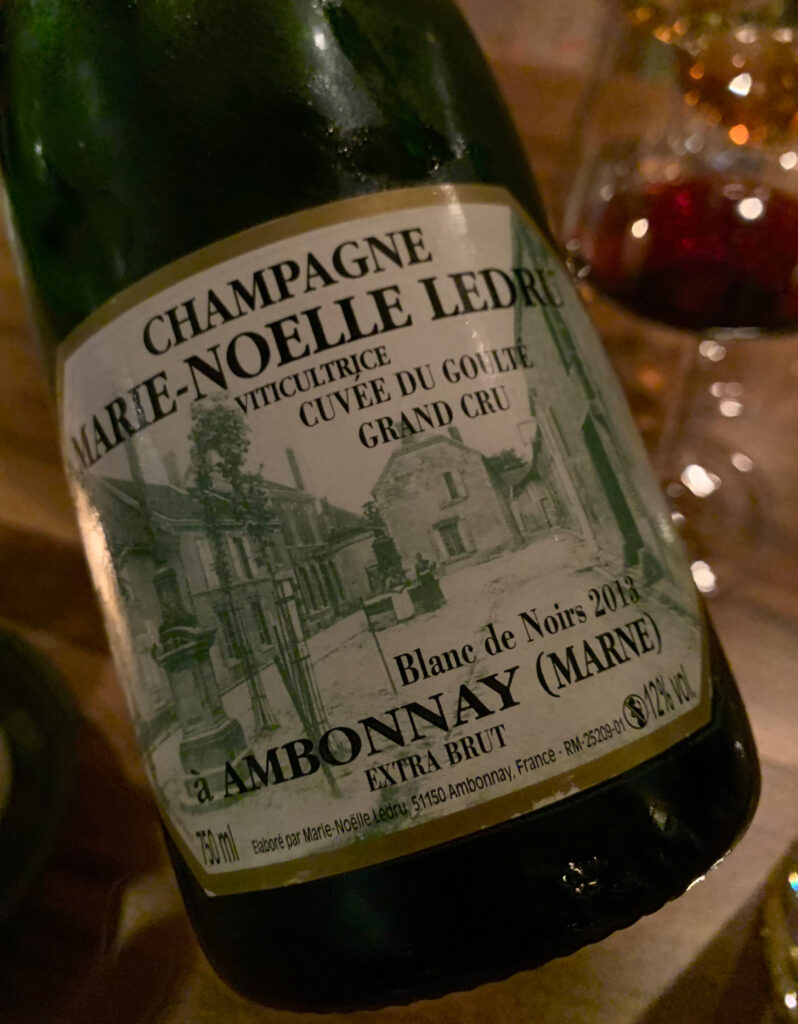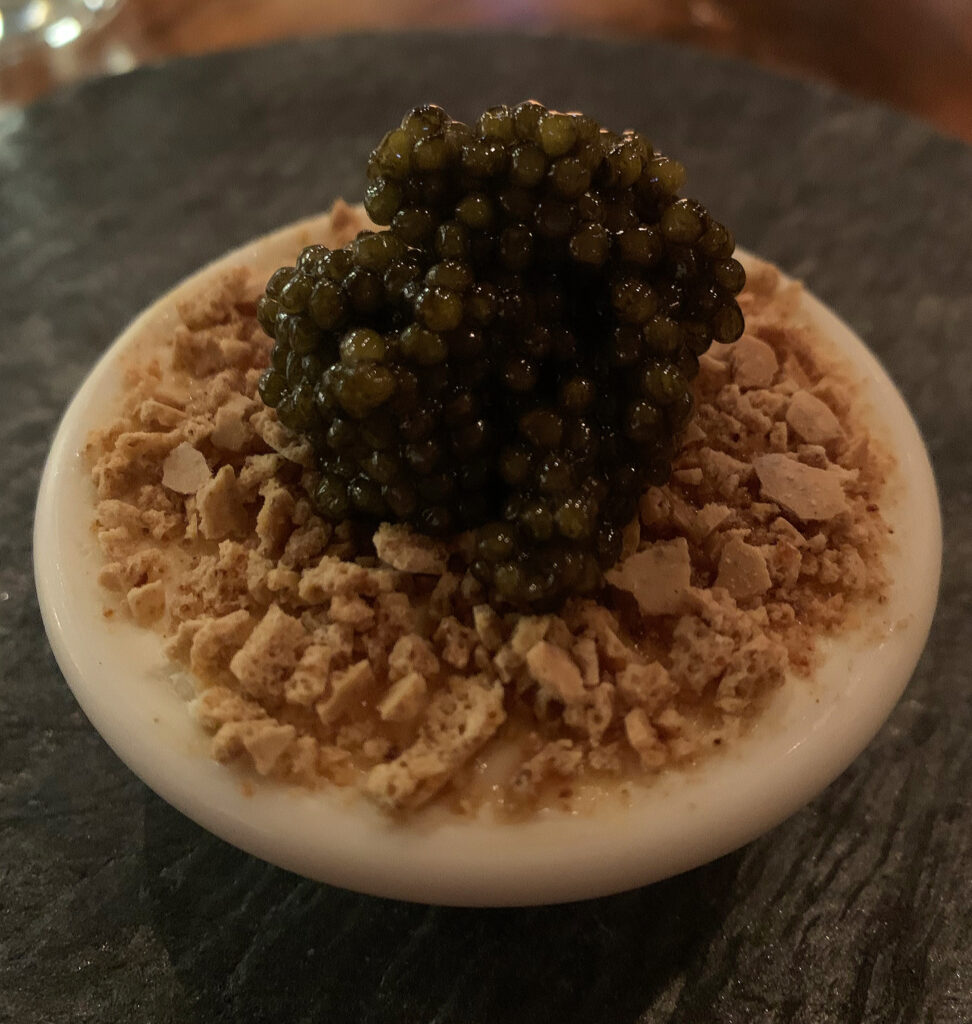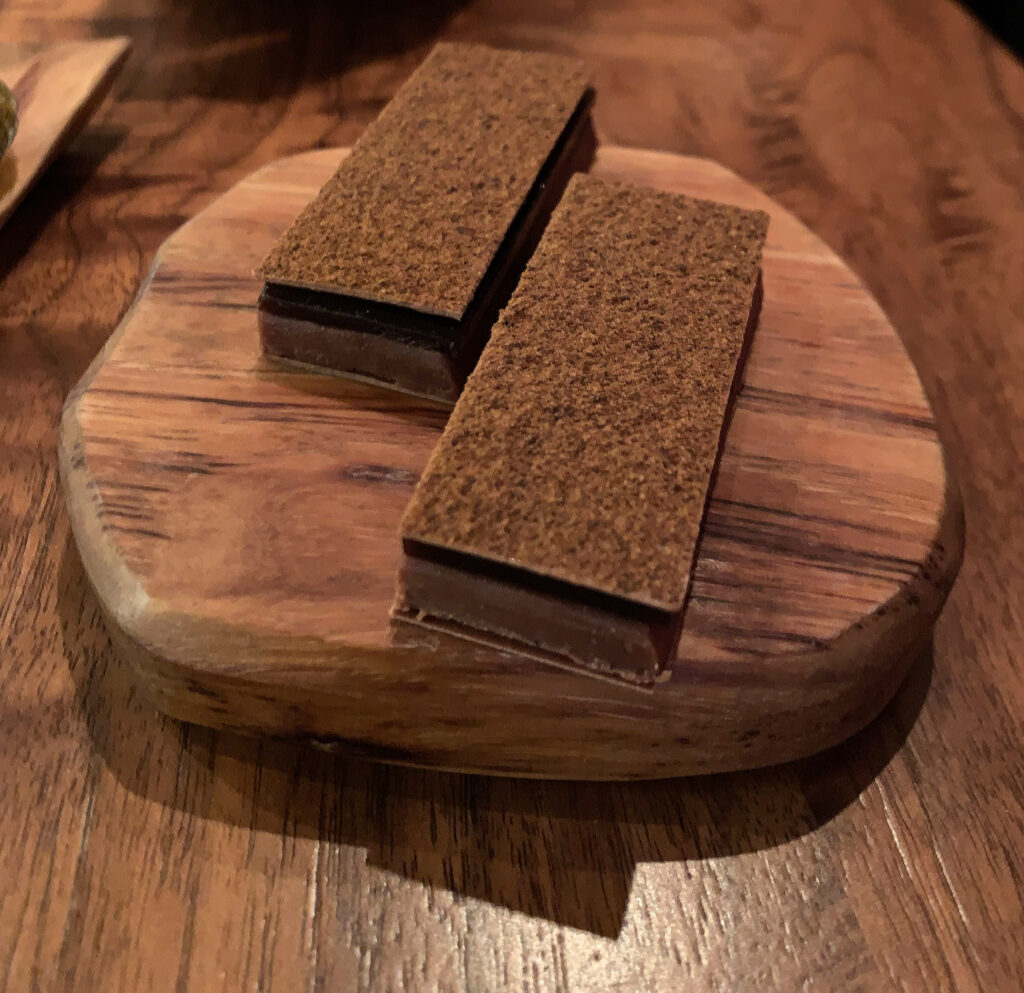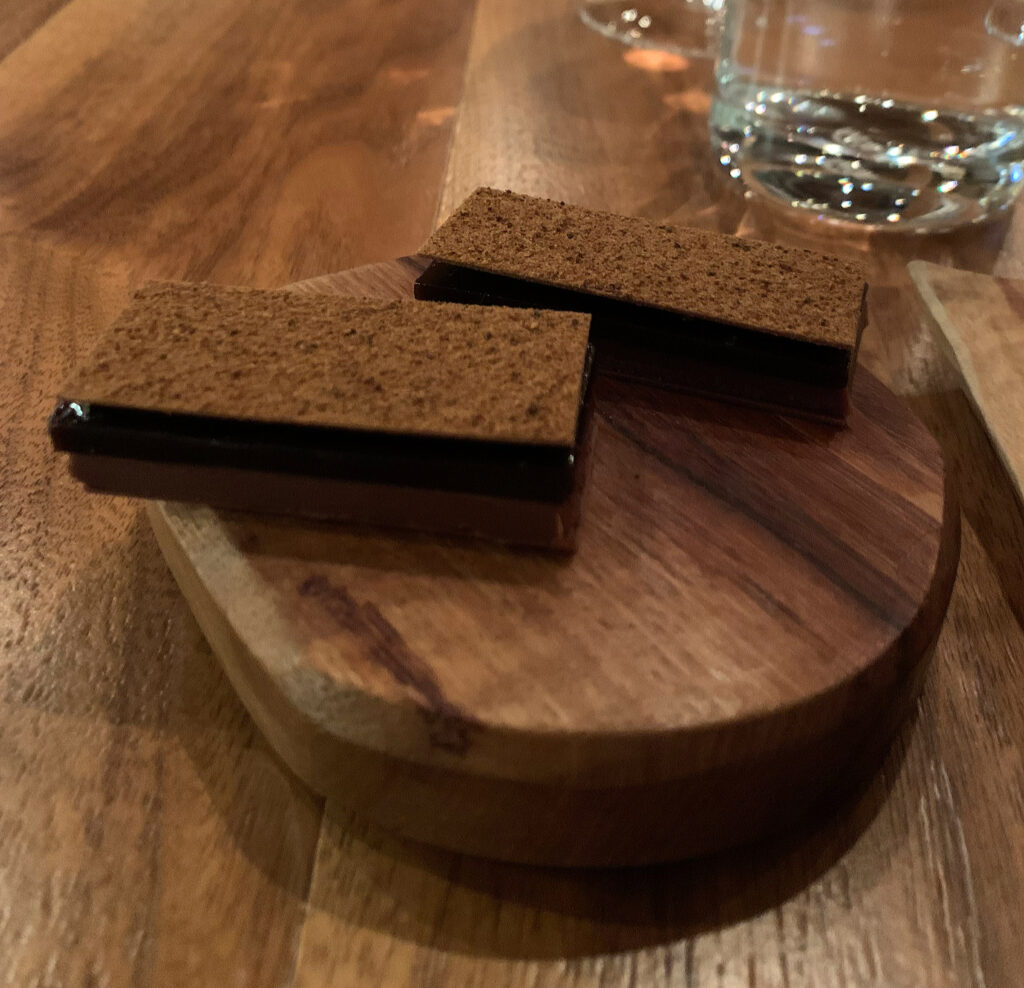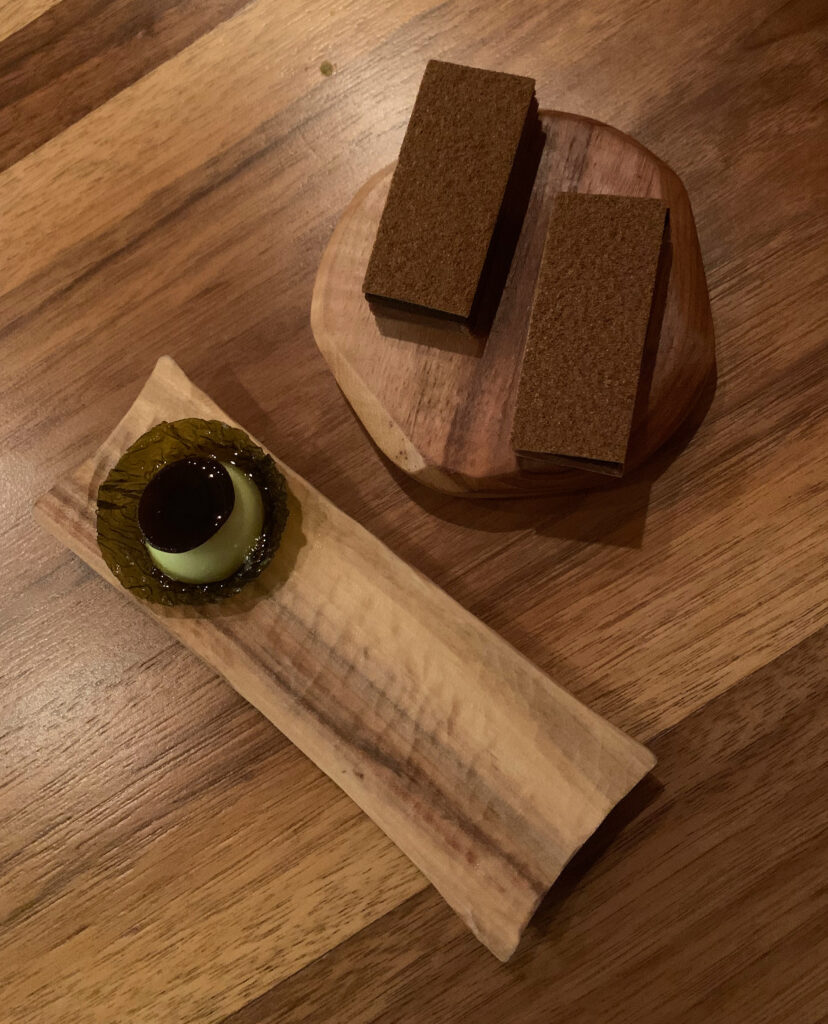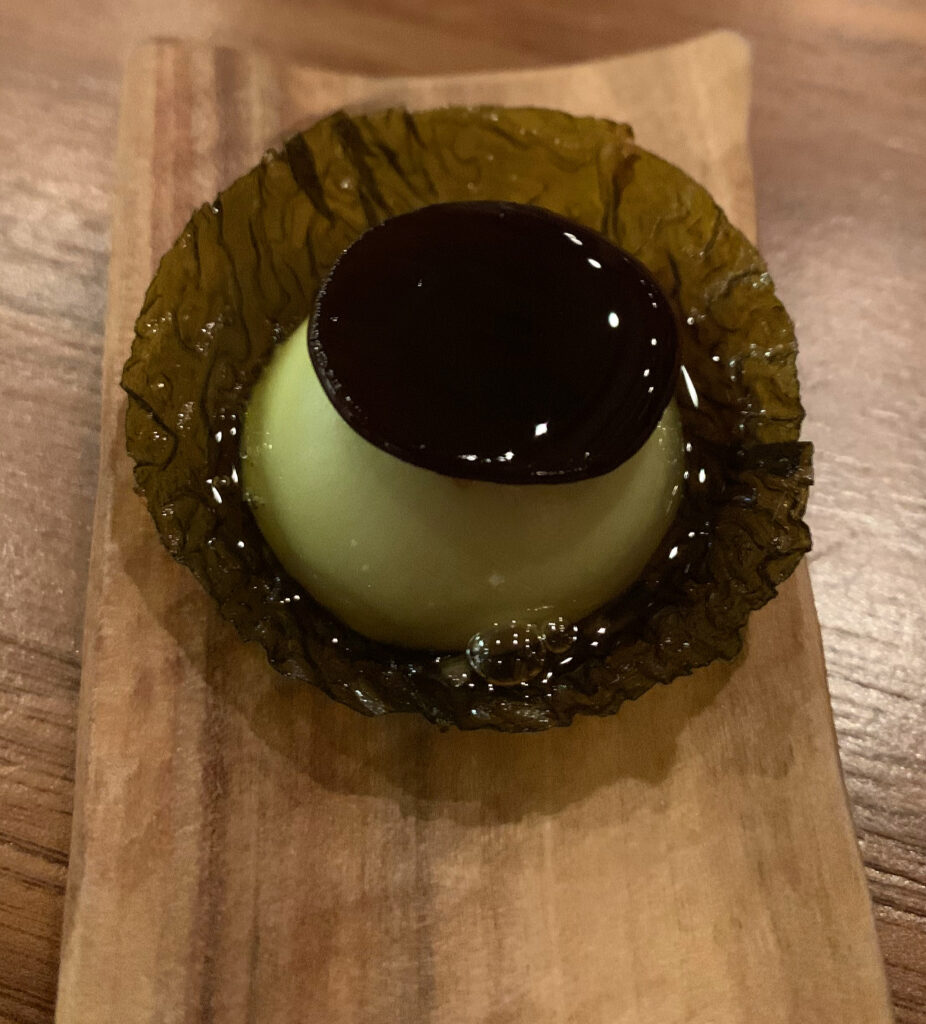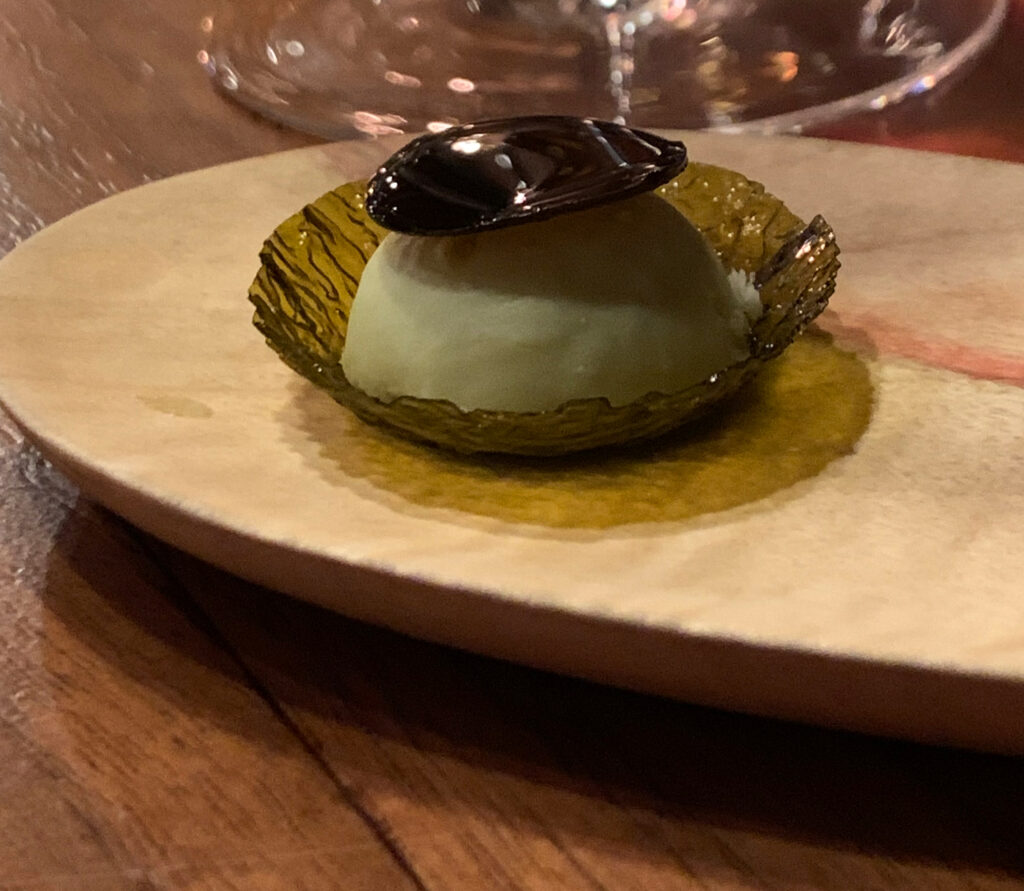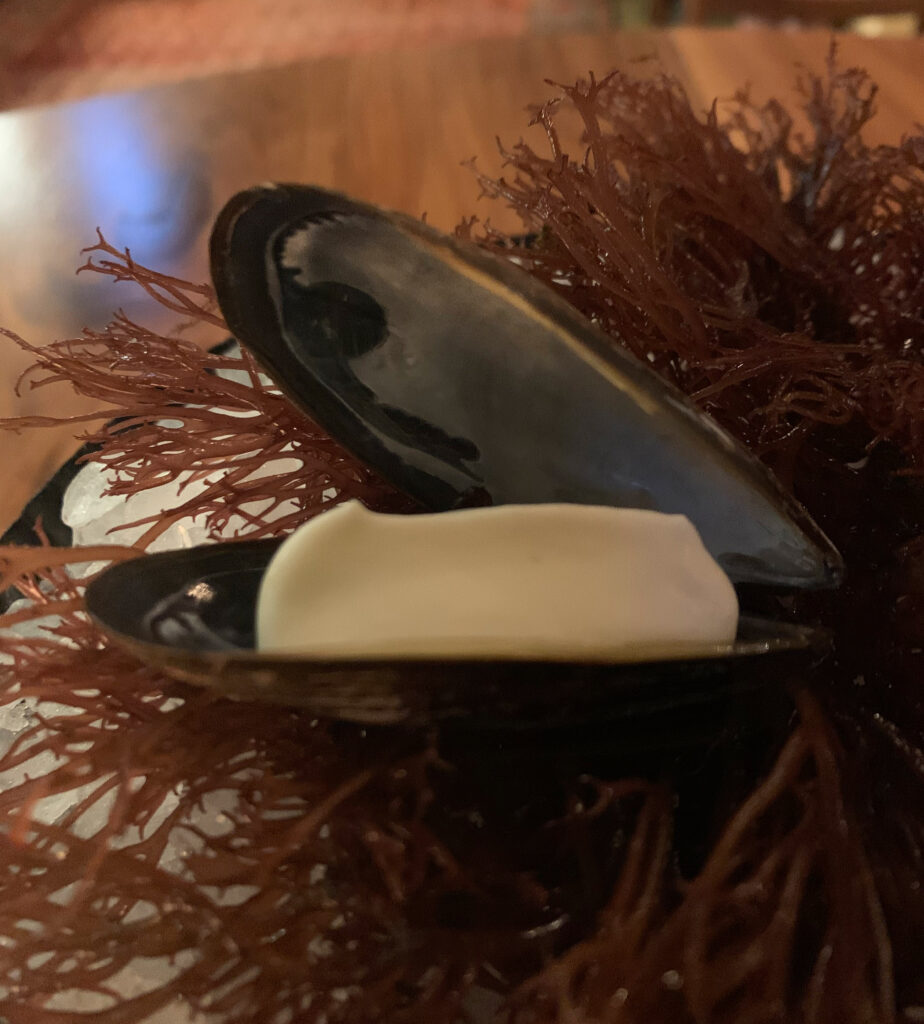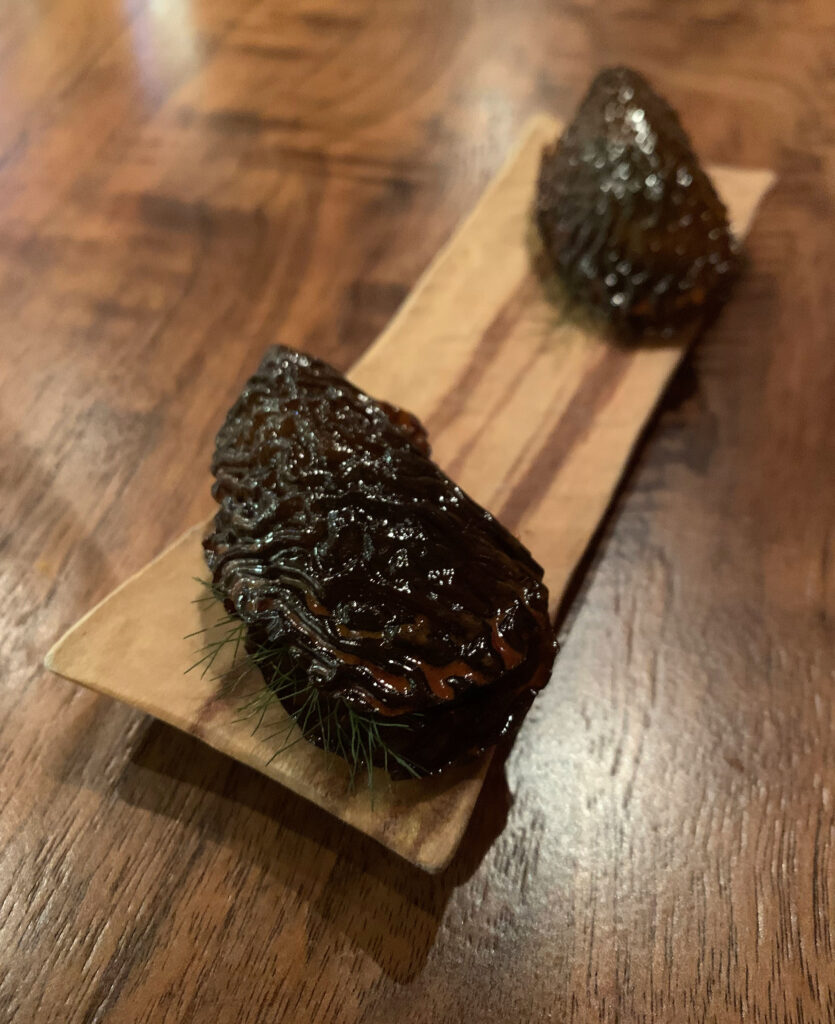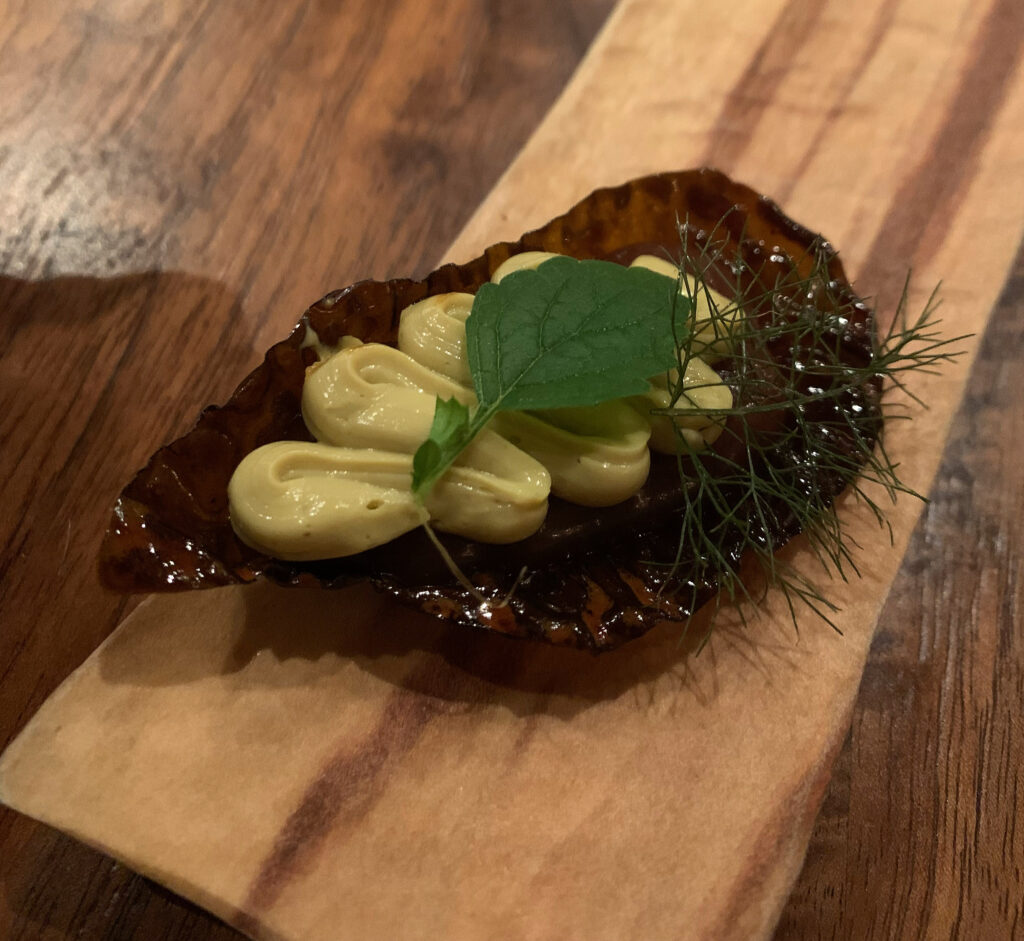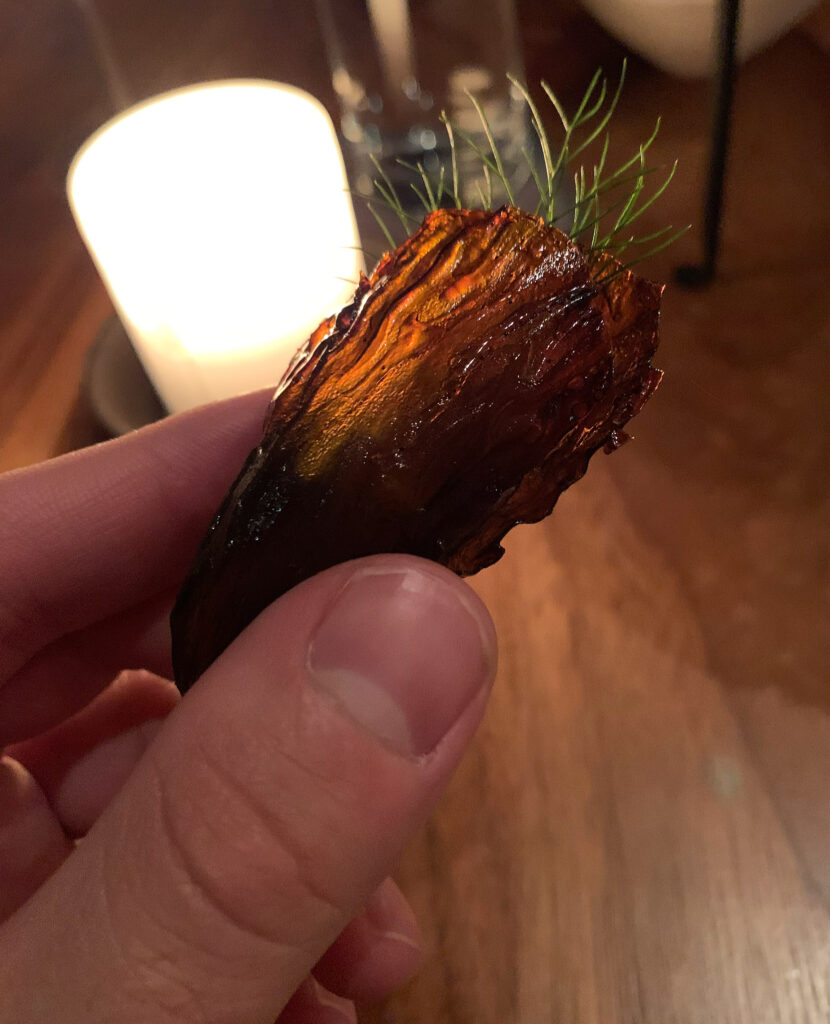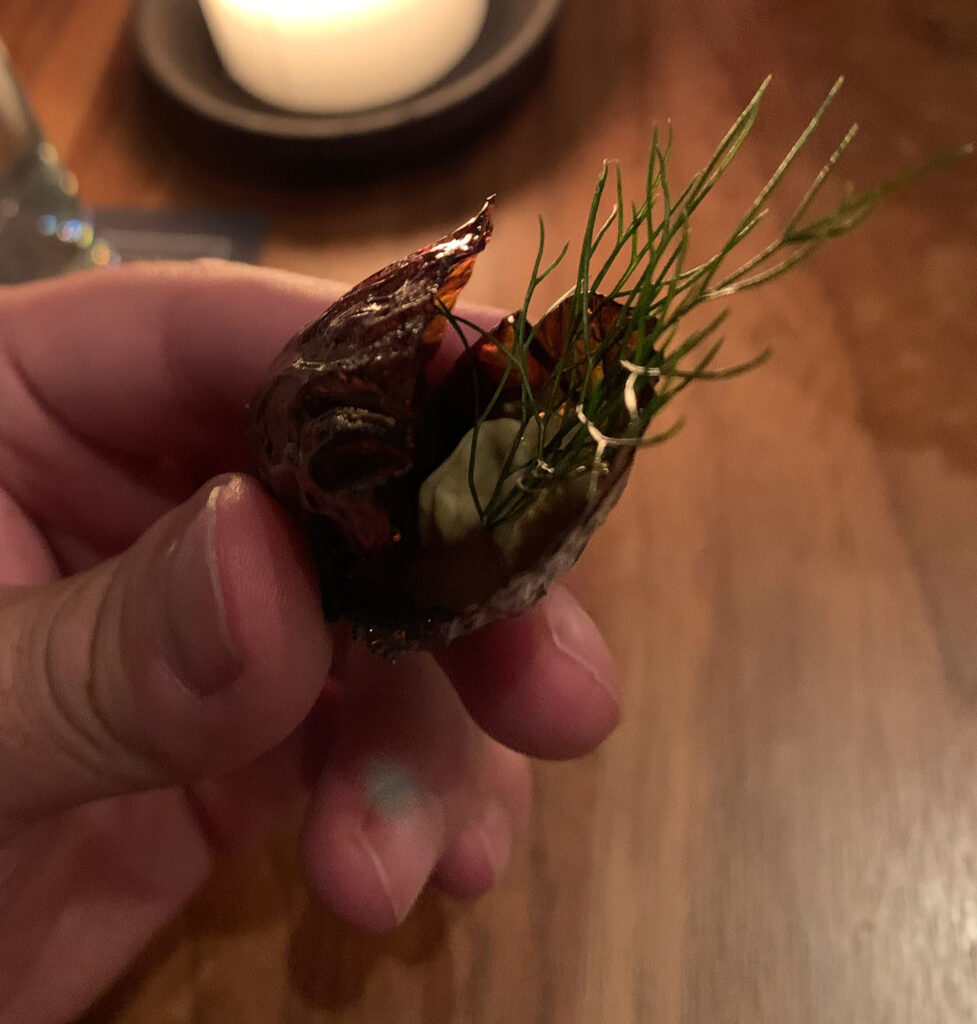With your hundredth visit looming in early 2023, the time seems ripe to step back, reflect, and review the creative output that has flowed ceaselessly from Ada Street’s colossus of seasonal American cuisine. But it is not quite that easy.
Smyth, when you last left it, had weathered the worst of the pandemic and come out the other side. You still remember how resolutely the restaurant labored to stage your third “The Farm Series” tasting menu, outdoors, in early November of 2020. And you remember, despite the perilous circumstances and pervading frustrations of yet another indoor dining shutdown, just how brightly the cuisine shone that night.
When you finally returned to Smyth—after a period of pickup orders and at-home celebrations—to eat in person, you were merely thankful the day had come. It was March of 2021, and the restaurant had devoted the past year to little more than survival at all costs. The hearth, the record player, and the piscine wallpaper remained, but the staff had been depleted and any kind of larger momentum sapped. The core of a stylistic identity, of course, remained. Yet the grand plans you had sensed at the start of 2020, a paradigm shift towards an entirely new set of forms and sequences spun from the same hyper-seasonality, had long faded.
With lingering capacity restrictions and public health concerns to contend with, reopening hardly meant a return to “business as usual.” Rather, for John Shields and what remained of his team, March of 2021 marked a time to dust off the cobwebs and slowly but surely rebuild. Service by service—though the tables were fewer and the menus shorter than before—the kitchen worked to regain its footing and maybe, just maybe start to dream again. However, though sitting in the dining room and going through the motions brought back a feeling of normalcy, there was no question Smyth’s foundation had been irrevocably changed.
The Farm, once the cornerstone of the restaurant’s ingredient sourcing and the protagonist of the meal’s seasonal narrative, gave way to a more varied array of small domestic purveyors. Smyth’s menu, thus, would lose some of its internal logic—no longer being able to defer to the expression of a singular piece of Illinoisan terroir, at a particular moment in time, as the basis of its creative decisions. Instead, shopping from the same amorphous national pantry as the country’s other great chefs, Shields would need to affirm why particular products were worth the fuss. (Though, at the same time, this change in posture held the promise of enabling the chef to paint with a comparably richer palette of flavors and textures all year long).
Further, while the continued leadership of Chris Gerber and Tyler Gore (as general manager and executive sous chef respectively) would forge an essential continuity with Smyth as it was before, this era would be defined by the introduction of new blood and the fruits of their fresh perspectives.
In the kitchen, that has meant the arrival of Luke Feltz as executive chef of both Smyth and The Loyalist. While, seemingly, hiring for such a role would make Shields himself redundant, the resulting division of labor has undoubtedly enhanced the restaurant’s operation while supercharging the development of its cuisine.
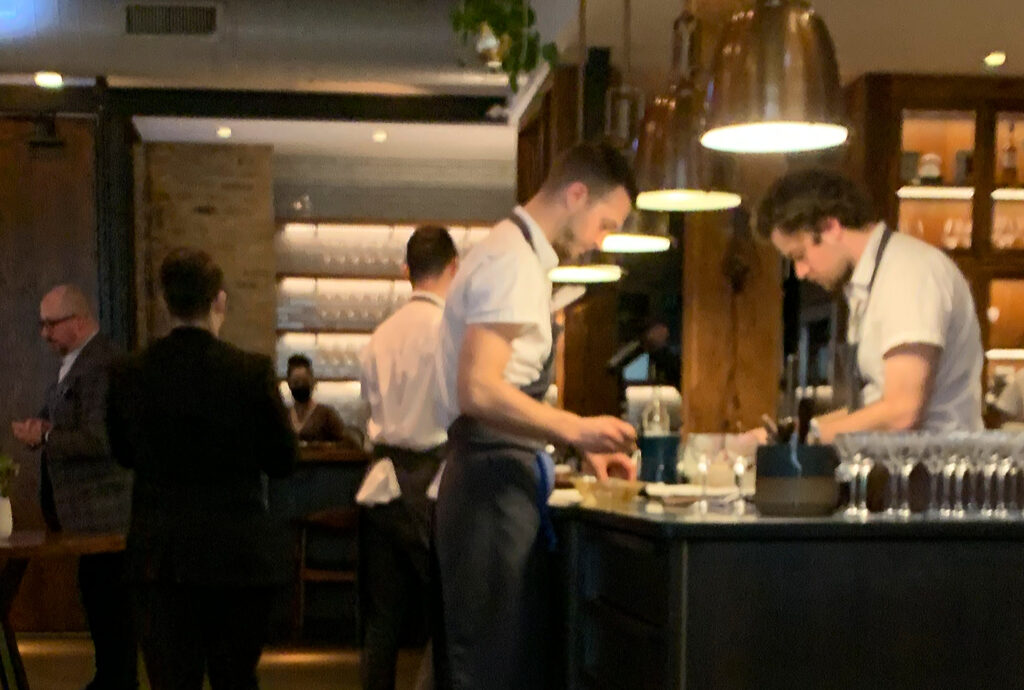
Feltz grew up outside of East Lansing, Michigan and has carried a passion for cooking since childhood, working in kitchens throughout high school and college. Nonetheless, it took a White House internship (under President Obama) and a budding career in nuclear security policy—built upon his degrees in Globalization Studies and Political Science—for him to realize just how deep that passion ran. Feltz cut his teeth as a line cook, then sous chef, then head chef of an “American farm-to-table bistro” in Washington D.C. In lieu of culinary school, the restaurant offered him a golden opportunity for “autodidactic trial-and-error learning there, both culinarily and as a leader.”
With this experience under his belt, Feltz joined José Andrés’s minibar as a chef de partie. Six months later, he found his way to Amass—a zero-waste Michelin Green Star recipient headed by a Noma alumnus—for a three-month stage. Feltz then returned to minibar in the role of sous chef: directing dinner service, writing menus, crafting new dishes with the R&D team, and overseeing the restaurant’s “lauded non-alcoholic beverage pairing” during a period that saw the establishment earn—and maintain—two Michelin stars. (You actually recall meeting Feltz there, in passing, as part of a post-meal kitchen tour in 2018. He prepared an incredibly delicate frozen tart shell that was filled with pumpkin and mandarin then spatulated directly into guests’ mouths).
Feltz had been a fan of Shields—whose Town House and Riverstead restaurants, readers may recall, transformed quiet Chilhowie, Virginia into a destination for East Coast gastronomes—before the Chicago chef joined him at minibar for a collaboration dinner with Sonoma’s SingleThread. But the evening offered a chance for the two to meet face to face and work side by side. This laid the groundwork for Feltz to eventually join Smyth in March of 2019—offering him little more than a year of calm before the storm but providing the kind of pre-pandemic experience that has paid dividends with the return to normal operation.
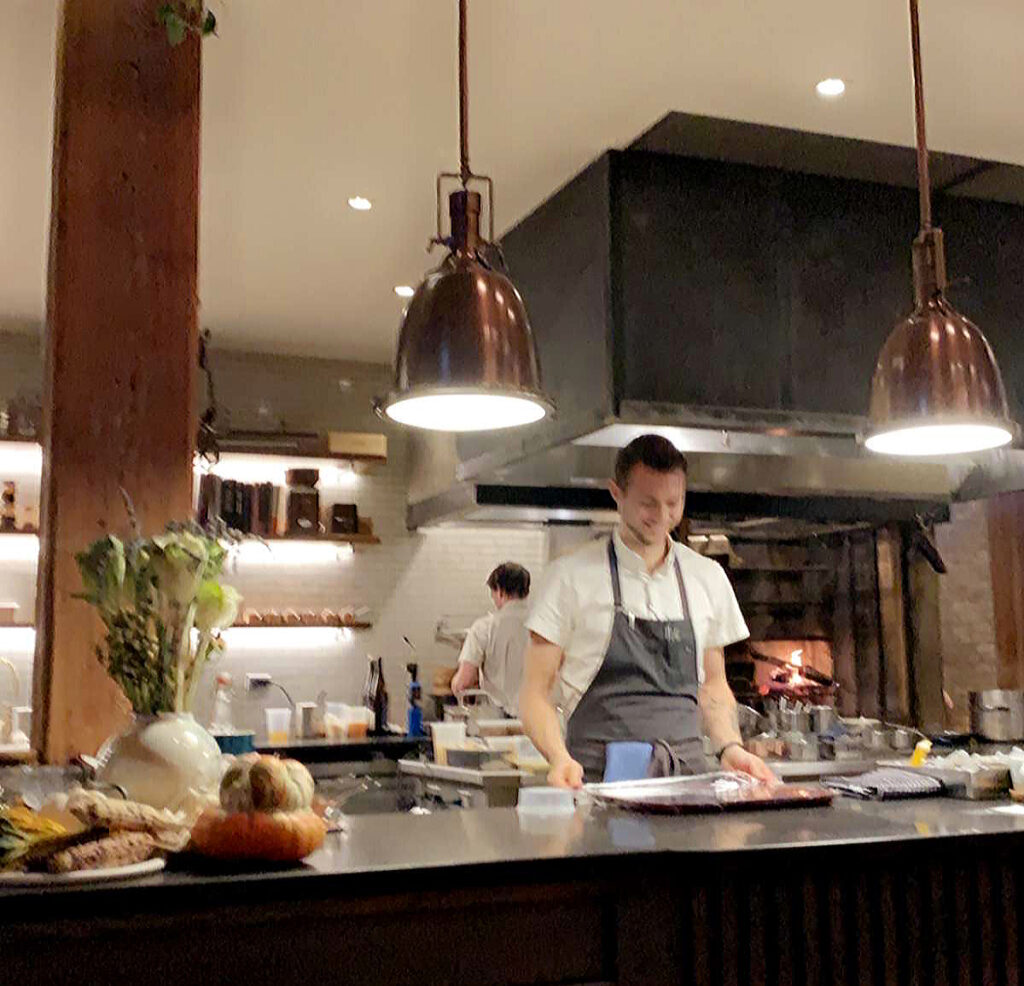
Rather than representing an abdication of his own role, Shields’s hiring of an executive chef has effectively broadened the kitchen’s range of expression. Feltz shares his senior’s molecular gastronomy chops—with minibar, like Alinea, instilling not only an assortment of advanced techniques, but a rigorous process of inquiry through which they are channeled. But, more importantly, his time at Amass signals an essential grounding in the kind of sustainable, hyper-seasonal cookery that has come to characterize Smyth far more than deconstruction for its own sake.
Chilhowie offered Shields a chance to apply his Charlie Trotter and Alinea training, on his own terms, towards a singular slice of American terroir. And Chicago, maybe, offers Feltz the chance to apply his minibar and Amass experiences towards the broader Midwestern terroir. In fact, now that Smyth looks beyond The Farm to encompass the full national bounty, the stage seems set for a new, bold “big picture” perspective to take hold. Feltz, benefitting from the global perspective of his policy background and the distinctiveness of his autodidactic approach to the craft, seems well-suited to writing the restaurant’s next chapter.
Approaching the Smyth space, equipment, and customer base with the fresh perspective a new executive chef entails has helped to ensure a clean break from the past. At the same time, Shields’s steadfast presence preserves the restaurant’s spiritual and philosophical core even as he cedes a certain degree of creative control. Striking this balance allows the concept, unencumbered by whatever came before Feltz’s time, to charge forward toward an unforeseen frontier of flavor and, in effect, be born anew. It allows for the growth (and associated growing pains) of a new team that need not master old recipes but, instead, may engage in the same kind of experimentation that inspired those hallowed dishes in the first place.
All the while, Shields remains there as a guiding hand and stylistic sounding board that ensures, if only by the same purity of intention, some longstanding connection to his past work. The more senior chef, meanwhile, is granted time to pursue his own course of experimentation. He is free to devote himself more fully to the technical, intuitive work of his craft—to get his hands dirty and play the role of provocateur—without needing to worry about the kitchen in a quotidian sense.
Despite the trials of the past few years, it really seems as though Shields enjoys himself more than ever these days, descending from above and bestowing the team with a preparation they have never seen nor heard of before (but that, at this very moment, he is ready to serve for the first time). The senior chef gets to play the part of the consummate host, the patient mentor, and the wily master while affirming—as only a true artist can—that “Smyth,” as an aesthetic expression, exists outside of what comes from his or Karen’s minds. By sharing ownership of the menu in this way, Shields has quietly ushered in his restaurant’s next generation and begun to cement a legacy that transcends individual talent. Just what that has meant for the development of his cuisine will form this article’s central concern.
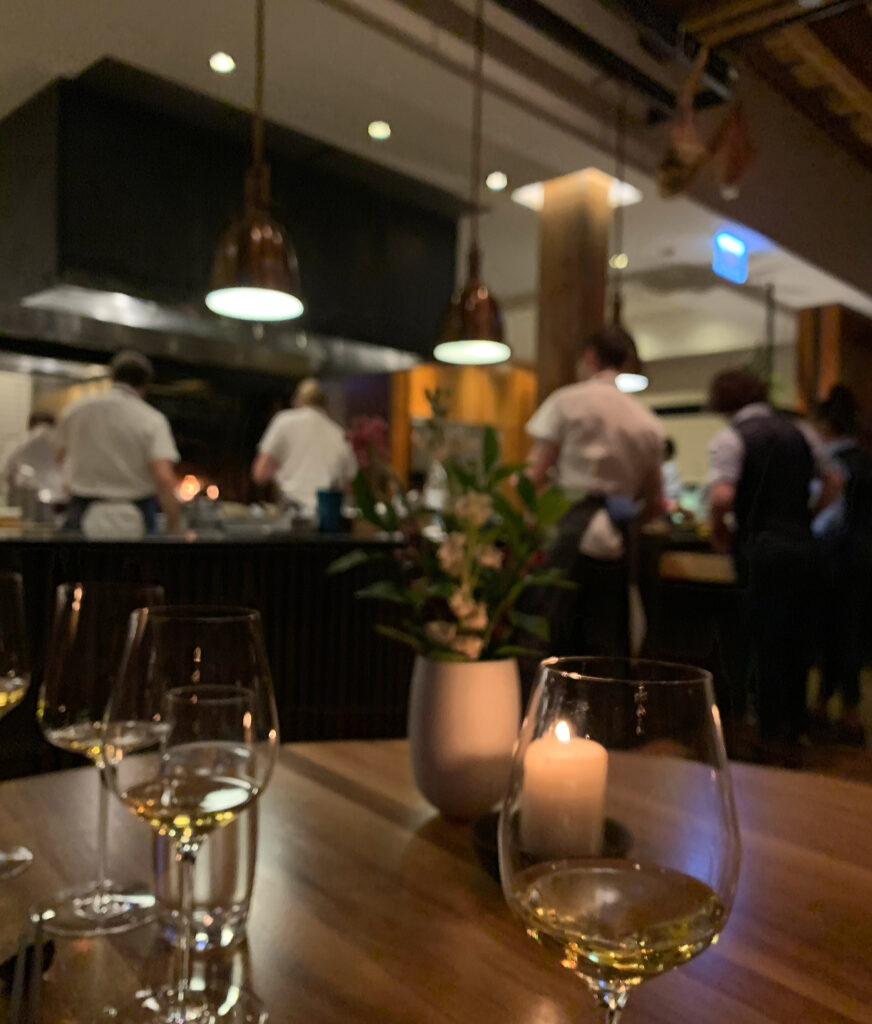
When it comes to the front of house, Smyth—as a consequence of the exodus that extended pandemic closures entailed—has had to set about training a new cadre of captains and their supporting front and back waiters. Surely, the staffing issues that continue to pervade the industry make recruitment itself is no easy task. But how, even if the fresh faces are ready and willing to get to work, does the restaurant recapture the magic of its bygone era?
Yes, the coming and inevitable going of favorite team members stands as one of hospitality’s most bittersweet realities. The singular connections formed between “server” and “served” represent one of the craft’s most transcendent features—revealing all the fancy food and wine to be little more than window dressing for a broader celebration of humanity. And bidding farewell to any one figure—whose visage, relative to an ever-changing menu, remains a comforting constant—feels like the closing of a chapter in itself. Yet each heartfelt goodbye, however painful, is typically buffered by a reserve of other staff with whom you share warm relations and who stand ready to swoop in and provide some continuity of service. But, with almost none of its former roster to draw on, just what remains of Smyth’s culture?
At a mechanical level—and despite some early turnover following the restaurant’s reopening—the front of house team has restored the kind of coordination, poise, and precision that makes conducting service (from the perspective of the customer) seem easy. Little niceties, like remembering guests’ birthdays, their handedness, their allergies, and their water preferences, have also—once more—served to enrich the experience. Pashminas and purse hooks, likewise, always lay close at hand. There have, indeed, been inevitable missteps (you recall being given a rather grainy pot of pourover coffee on one occasion) but no persistent problems. Thus, while it has taken some time for the team to return to full strength, the current crop, in a technical sense, does the restaurant’s legacy proud.
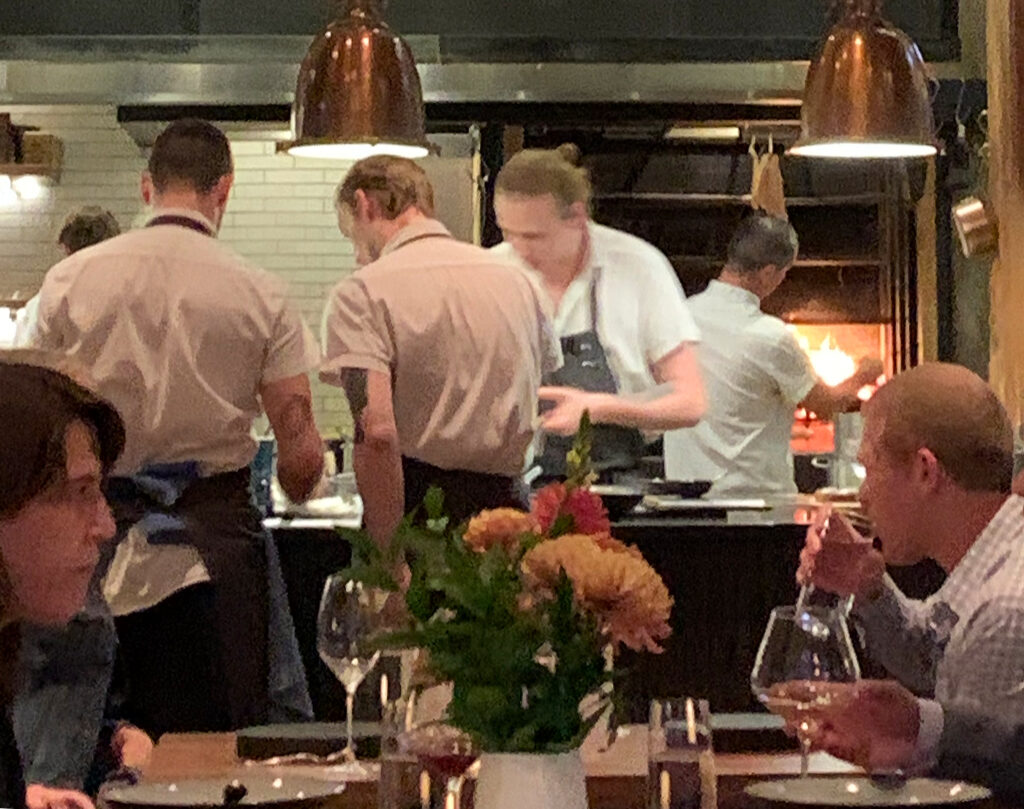
Nonetheless, Smyth’s culture has always gone far beyond this kind of “excellence”—a rather empty word when wielded by staid, award-chasing establishments that substitute it in place of an actual personality. Instead, the restaurant has always been defined by the fullness of the staff’s presence, the sense that—rather than running through some contrived, “uncanny” course of interaction—they are thoroughly “there,” in the moment, with you. This genuine expression of self, unencumbered by the other demands of the job, brings with it a whole range of hospitality virtues: warmth, charm, humor, insight, and a sincere sense of care. But these flourishes cannot be forced or fabricated—lest you end up with “uncanny” scripting of another, even more cynical type.
The best any restaurant can do to forge this exceptional degree of presence is to prepare the soil, plant the seed, and provide the kind of support that allows each member of the team to grow toward it on their own terms. With the right balance between care and struggle, the honing of skills leads to increasing fulfillment and, eventually, a full actualization of one’s identity within the hospitality setting. Of course, mechanically, the structure of service must support this kind of interaction, and Smyth remains the only restaurant where you routinely see the staff relieve each other of their pressing duties so that they may remain devoted to an ongoing guest conversation.
Since each member of the team must walk a wholly personal path to uncover and refine the authentic expression of self, it seems wrong to tally how many people possess that particular energy at this particular moment and how many don’t. Rather, you will say that more than a few do, indeed, capture that intoxicating ease and depth of engagement that has always characterized Smyth’s hospitality at its best. Likewise, the potential for that kind of actualization across the rest of the team clearly exists—and the rambunctious spirit shared by the staff (as observed in those moments when no one is thought to be looking) is infectious. Even the back of house, conscripted to deliver and describe certain dishes, play their part by demonstrating a touching humility—and often rivaling their front of house counterparts when it comes to landing zingers.
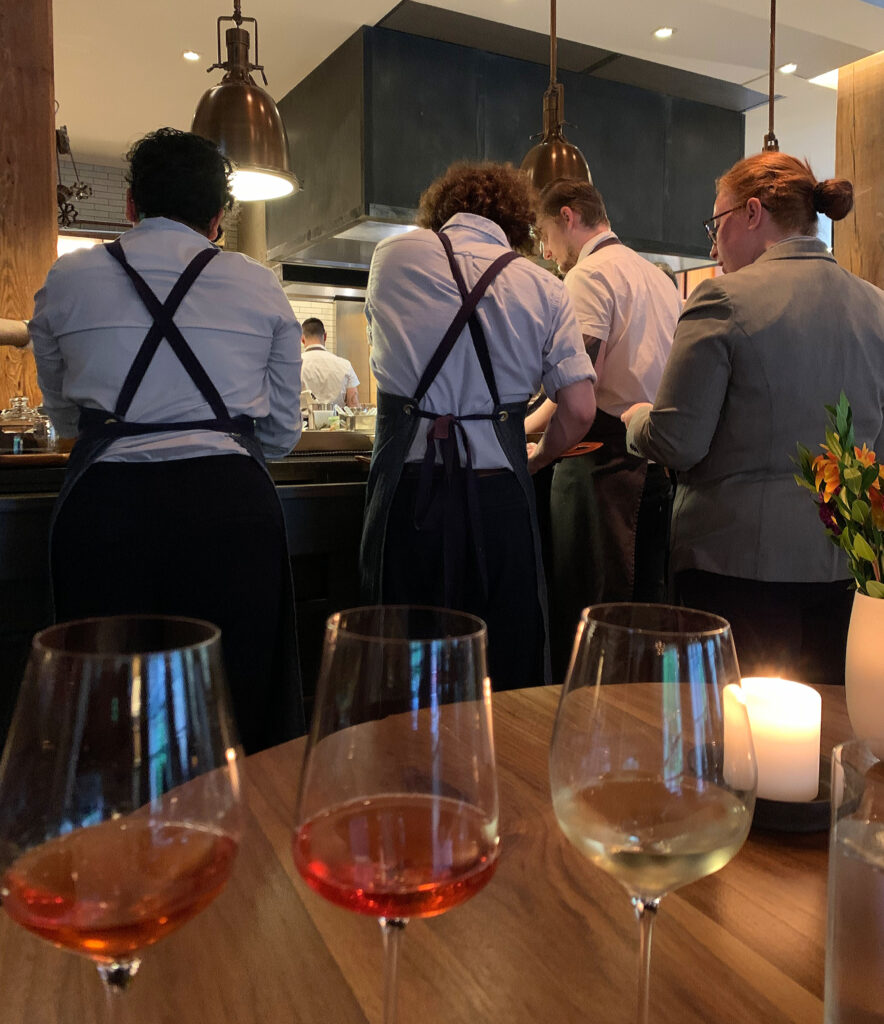
Chris Gerber and David Bedke—The Loyalist’s floor manager (who has been with the restaurant since 2016)—deserve immense credit for preserving this culture during the pandemic and perpetuating it throughout the cultivation of a new team. So, too, do the Shieldses (embodying, as always, the emotional core that guides the concepts) and Feltz (a young leader, shaped by the pre-pandemic era, now entrusted with carrying the torch in the kitchen).
Ultimately, Smyth’s staff works with a common purpose and displays a devotion to each other that transcends business. You recall hearing about an incident during the past year or so (relayed secondhand and then confirmed in person) that really illustrates this point. One of the restaurant’s front waiters had been taking care of a party of VIPs from whom the kitchen sources some of its product. Going about their duties, this individual was exposed to the grotesquely racist comments being made by the diners. They reported their resulting discomfort to the captain, which flowed up the chain of command, and found that the staff stood in total solidarity. The bigoted guests were allowed to finish their meal then informed that they were no longer welcome back. The kitchen, anticipating how their business relationship might be wielded as leverage (or revenge), immediately resolved to source their product from elsewhere.
In this manner, the entire establishment responded in lockstep to affirm its values and safeguard the dignity of its team. You find this particularly heartening because the racist comments were not directed, as far as you recall, toward anyone present (a rather cut-and-dry case of harassment that merits immediately dismissal from the dining room). Rather, the customers’ behavior was considered objectionable in an overarching sense—a reflection of a backwards and demeaning attitude that stands as anathema to the craft of hospitality. Smyth showed no hesitation in proactively protecting its staff and other customers from even the possibility of perceiving such ugly conduct. The restaurant did so at the cost of future repeat business, of any quality the product it was sourcing possessed, and of whatever retributory bad-mouthing that bruising those bigoted egos may entail.
This kind of “sacrifice” (which, in truth, was something more like moral sureness) simply confirms that Smyth views hospitality as something that stems from the hearts and souls of its team members, something that takes as its precondition the total comfort of those working the floor (rather than their ability to look pretty and hit their marks). This enlightened perspective understands that going the extra mile for employees—making them feel seen and heard—forms the finest guarantee that they will do the same for guests. It’s a philosophy that stands totally opposed to the more conventional cost-benefit analyses used by greedy restaurateurs to justify sweeping venial sins under the rug. It represents—in this era of increasing labor valuation—the future of the industry (especially at the high ”luxury” level). But, perhaps, the best thing you can say is that dining at Smyth today—despite all that has gone on in the world—feels just like old times.
One particular bright spot, when it comes to the front of house, has come by way of wine director Kevin Goldsmith. The Virginia native (a fated connection if there ever was one) came to Smyth by way of Alinea—where he served as head sommelier—in October of 2020. Whereas Feltz was able to immerse himself in what pre-pandemic Smyth represented, Goldsmith had to take the reins, mid-pandemic, of a program that had run fallow. But that Alinea heritage, common to so many members of the restaurant’s team, has served him well. And it surely helps that the wine director was already a fan of Shields’s work—celebrating his anniversary there annually.
Goldsmith has built upon the estimable work of Richie Ribando, whom you credit with championing renowned producers like Keller and Guiberteau before (at least in this market) they were fashionable. But the nature of the wine market—especially now that global auction demand and the commodification of cult bottles have surged—means that yesterday’s value plays may cost double or triple today. And Goldsmith, not to mention, must contend with offering a three-tiered set of pairings whose highest level (the “Super Mega Pairing” priced at $375) is the only in Chicago that comes close to Alinea’s “Alinea Pairing” (priced at $395).
(Oriole, readers may recall, opts for a two-tiered system of pairings that tops out with the “Reserve” at $275. Temporis, meanwhile, comes closest to matching Smyth and Alinea with a “Grand Reserve” pairing priced at $325).
You typically critique these ultra-premium offerings for the psychological damage they can inflict on consumers. Aspirational diners, who have scrimped and saved to merely get their foot in the door, are left compromising on a “Standard” (in Alinea’s terminology) pairing that implies their luxurious experience is not quite as refined as it could be. (“The Alinea Pairing,” in contrast, would seem to communicate that it is the only commensurate option to properly honor the food.)
Smyth has always deserved praise for terming its “Standard” pairing as “Traditional” and its “Alinea Pairing” equivalent as “Super Mega”—a turn of phrase that reassures customers this is a particularly exceptional option and nothing like what you “must” select to do things right in the eyes of the restaurant. Likewise, while you feel that Alinea’s ultra-premium offering has typically leaned too heavily on Napa and Bordeaux (big, bold wines matched to comparable morsels of A5 wagyu), Goldsmith’s selections have comprised a more diverse and distinctive assortment of wines.
His ”Super Mega” lineups represent the rare high-priced pairings that actually offer equivalent value when compared to buying two or three bottles off the list. Some of the notable wines that have featured on these selections throughout 2021 and 2022 include:
Sparkling
- NV Bérêche et Fils “Reflet d’Antan” Champagne
- 2016 Bérêche et Fils “Cramant” Champagne
- 2014 Marie-Noëlle Ledru “Cuvée du Goulté” Champagne
- 2007 Dom Ruinart Champagne
- 2005 Bollinger Champagne “La Grande Année” Rosé Champagne
- 2004 Laurent-Perrier “Cuvée Alexandra” Rosé Champagne
- 2000 Dom Pérignon P2 Champagne
White
- NV Schloss Gobelsburg “Cuvée 10 Years”
- 2021 Peter Lauer “Kern Fass 9” Riesling
- 2019 Bernard Moreau Chassagne-Montrachet Chardonnay
- 2019 Keller “Abts E®” Riesling
- 2019 Raul Pérez “Sketch” Albariño
- 2019 Willi Schaefer “Graacher Domprobst” Riesling Spätlese #5
- 2019 Wittmann “Aulerde” Riesling
- 2018 Bernard Moreau Chassagne-Montrachet Chardonnay
- 2018 Domaine Laroche “Les Blanchots” Chardonnay
- 2018 Domaine Laroche “Les Clos” Chardonnay
- 2018 Domaine Vocoret “Les Clos” Chardonnay
- 2017 Château Pape Clément Blanc
- 2017 Jean-Claude Ramonet “En Remilly” Chardonnay
- 2015 Emidio Pepe Trebbiano d’Abruzzo
- 2015 Jacques-Frédéric Mugnier “Clos de la Maréchale” Chardonnay
- 2014 Aubert “Ritchie Vineyard” Chardonnay
- 2012 Trimbach “Clos Ste. Hune” Riesling
- 2010 Schäfer-Fröhlich “Felseneck” Riesling Spätlese
- 2005 F.X. Pichler “Unendlich” Riesling
- 1997 Trimbach “Cuvée Frédéric Emile” Riesling
Red
- 2018 Pascal Cotat “Chavignol” Rosé
- 2016 Domaine des Lambrays “Clos des Lambrays”
- 2016 Tua Rita “Per Sempre” Syrah
- 2012 Sérafin Père et Fils “Les Cazetiers”
- 2010 Vega Sicilia “Unico”
- 2006 Radikon Merlot
- 1996 Château Ducru-Beaucaillou
- 1990 Château Cos d’Estournel
- 2013 Klein Constantia “Vin de Constance”
- 2007 Giuseppe Quintarelli “A Roberto” Recioto della Valpolicella
- 1997 Domaine Huet “Clos du Bourg” Vouvray Moelleux
While, admittedly, the red wines listed are not much to write home about, sourcing any substantial amount of aged Burgundy or Barolo for the pairing would—given current pricing—likely detract from its overall value proposition. Not to mention, a meal at Smyth typically only offers one “proper” red wine course anyway (with rosé of the sparkling or still variety often being used in a transitional role where some sommeliers might serve a lighter red).
Yes, in truth, Shields and Feltz have come to craft menus that center on pristine expressions of seafood and produce that may be enriched by trace amounts of animal fat (or a more composed sauce making use of the same kind of ingredient). Thus, Smyth’s food really shows well with a wide variety of Champagne and white wine. And producers like Bérêche, Ledru, Moreau, Keller, Willi Schaefer, Wittmann, Ramonet, Aubert, Trimbach, Schäfer-Fröhlich, and F.X. Pichler are close to as good as it gets (at least within this market) when it comes to those categories. Goldsmith also deserves credit for many of the back-vintage bottles this roll call comprises, for a well-aged Clos Ste. Hune, Felseneck, or Unendlich makes quite an impression when it comes to the table.
Of course, Smyth’s new wine director must also—and, as far as any program goes, principally—be judged on the quality of his bottle list. Given that many of the finest selections are destined to leave the menu as quickly as they appear (guilty as charged), you think it best to transcribe the most striking offerings that appeared throughout the 2021-2022 timeframe. These include:
Sparkling
- NV Pierre Péters “L’Étonnant Monsieur Victor MK.14” ($475)
- NV Ulysse Collin “Les Maillons” ($275)
- NV Ulysse Collin “Les Pierrières” ($325)
- 2018 Bérêche et Fils “Campania Remensis” ($255)
- 2016 Etienne Calsac “Clos de Maladries” ($275)
- 2013 Jacquesson “Terres Rouges” ($420)
White
- 2020 Eva Fricke “Mélange” Trocken ($135)
- 2020 Stein “Alfer Hölle 1900” Spätlese Feinherb ($175)
- 2020 Stein “Palmberg” Kabinett Trocken ($110)
- 2019 Bernard Moreau Chassagne-Montrachet “La Maltroie” ($305)
- 2019 Bernard Moreau Chassagne-Montrachet “Les Chenevottes” ($305)
- 2019 Bernard Moreau Saint-Aubin “En Remilly” ($245)
- 2019 Miani “Buri” ($345)
- 2019 Pierre-Yves-Colin-Morey Saint-Aubin “Hommage à Marguerite” ($235)
- 2019 Raveneau Chablis “Forêt” ($540)
- 2018 Fontaine-Gagnard Bâtard-Montrachet ($515)
- 2018 Vacheron Sancerre “Les Romains” ($185)
- 2018 Vincent Dancer Meursault “Les Perrières” ($450)
- 2017 Guigal Hermitage “Ex-Voto” ($450)
- 2017 Jean-Claude Ramonet Chassagne-Montrachet “La Boudriotte” ($275)
- 2017 Jean-Claude Ramonet Chassagne-Montrachet “Les Chaumées” ($275)
- 2017 Domaine Roulot Bourgogne ($195)
- 2016 Anne et Jean-François Ganevat “Les Cedres” ($175)
- 2016 Jean-François Ganevat “Cuvée Orégane” ($350)
- 2016 Terlano “Quarz” ($145)
- 2013 Pierre-Yves-Colin-Morey Chassagne-Montrachet “Les Ancegnières” ($375)
- 2009 Vincent Dauvissat Chablis “Les Preuses” ($950)
Red
- 2017 Cappellano “Otin Fiorin” ($285)
- 2017 Domaine Rougeot Pommard “Clos des Roses” ($125)
- 2017 Thibault Liger-Belair “Les Saint Georges” ($360)
- 2016 Joseph Roty Bourgogne ($145)
- 2014 Emmanuel Reynaud “La Pialade” Côtes-du-Rhône ($125)
- 2013 Claude Dugat Gevrey-Chambertin ($245)
- 2013 Giuseppe Quintarelli “Alzero” ($750)
- 2013 Pierre Damoy Chapelle-Chambertin ($575)
- 2012 Littorai “May’s Canyon” ($285)
- 2012 Philipe Charlopin-Pairzot Vosne Romanée ($195)
- 2011 Giuseppe Quintarelli “Alzero” ($750)
- 2007 Château Rayas ($1,100)
- 2007 Produttori del Barbaresco “Asili” ($295)
- 2007 Produttori del Barbaresco “Rabaja” ($295)
This, it goes without saying, is a partial list—and it is rather partial to your particular tastes. But, rest assured, there are plenty of notable wines from Alsace, Austria, Bordeaux, the Loire, Napa, the Rhône, Sonoma, Spain, and Tuscany represented as part of Goldsmith’s selection.
Once again, you find categories like Champagne, German Riesling, and white Burgundy to be strongly represented—with producers like Bérêche, Bernard Moreau, Etienne Calsac, Eva Fricke, Pierre-Yves-Colin-Morey, and Uli Stein offering some relative value. Meanwhile, though bottles from Ramonet, Raveneau, Vincent Dancer, and Ulysse Colin are certainly pricey, they represent a relative bargain compared to what the market currently bears.
For example:
- The 2017 Ramonet Chassagne-Montrachet “La Boudriotte” ($275) has a current Wine-Searcher average of $340 at retail.
- The 2017 Ramonet Chassagne-Montrachet “Les Chaumées” ($275) has a current Wine-Searcher average of $250 at retail.
- The 2019 Raveneau Chablis “Forêt” ($540) has a current Wine-Searcher average of $579 at retail.
- The 2018 Vincent Dancer Meursault “Les Perrières” ($450) has a current Wine-Searcher average of $900 at retail.
- The Ulysse Collin “Les Maillons” ($275) has a current Wine-Searcher average of $472 at retail—and, just for comparison, costs $425 on Oriole’s current wine list.
- The Ulysse Collin “Les Pierrières” ($325) has a current Wine-Searcher average of $502 at retail.
By maintaining standard mark-ups across his entire list, Goldsmith offers oenophiles the opportunity to enjoy highly allocated bottles at appealing prices. Using the restaurant’s buying power to reward—rather than rip off—wine lovers represents the absolute peak, philosophically, that any program can attain. It ensures that you are always excited to browse the selection and see what new, exciting, and limited drinking experiences are at hand. (However, in the spirit of goodwill, you strictly ration how many of these coveted bottles you order so that others may also appreciate the wine director’s good work).
Moving on, you think the Jura wines from Jean-François Ganevat—when they have been offered—represent some of the list’s finest values, showing the kind of slight oxidative notes that make for a heavenly match with Smyth’s food. Nonetheless, you think this category could benefit from being expanded upon.
When it comes to reds, there are a few good values—like the Cappellano, Charlopin-Pairzot Vosne Romanée, Dugat Gevrey-Chambertin, Joseph Roty Bourgogne, Rougeot “Clos des Roses,” and Reynaud “La Pialade”—worth appreciating. These bottles are not quite best in class when it comes to QPR, but they allow you to enjoy red Burgundy (or lauded producers from Barolo and Rhône) at a more friendly price.
Turning toward the more expensive options, you have omitted bottles like the 2018 Emmanuel Rouget “Cros Parantoux” ($1950) because, while a relative steal compared to a $3,531 Wine-Searcher average, these young grand cru and premier cru wines from Dujac, Lignier, Roumier, and so on offer limited enjoyment while also being found on other lists throughout the city. Instead, you most appreciate that Goldsmith has been able to secure wines of premium quality with some degree of age (and, thus, drinkability).
As with the pairings, you think the red wines represent a bit of a relative weak spot compared to just how good the white wine selection is. But, as you mentioned before, this fits well enough with a menu that does not typically offer more than one course of meat. Red wine devotees, surely, will still find something to like. And you think it is sensible to weigh the list towards flexible, harmonious options rather than cynically stacking it with Cult labels that, while they might sell, detract from the program’s identity.
Nonetheless, you can certainly offer some other constructive criticism. The lowest priced bottle you could find on Smyth’s list came in at $115, which seems a little steep. Oriole, by contrast, offers a plethora of wines under $100 with many around $50 and some as low as $30. In Smyth’s case, you suppose it is fair to consider that a basic menu price of $285 per person, along with an entry-level $155 “Traditional Pairing,” can be used to justify what amounts to a relatively meager “minimum spend.”
But, certainly, nobody is forced to order alcohol, and you think it is fair to say that even the cheapest of Goldsmith’s chosen bottles (a $115 Burklin-Wolf Riesling, Selbach-Oster Spätlese, Tondonia Blanco, or 2017 Santa Cruz Pinot Noir) offer a memorable drinking experience. You might say that Smyth looks to funnel customers toward a meaningful encounter with (a slightly more expensive class of) wine while Oriole maintains a friendlier posture (which corresponds to its prominent cocktail program). It is a stylistic decision that makes the former’s program feel more serious even though the tone of service is humorous and engaging. Perhaps the list is filled with wines that all have stories to tell?
Though this is to take nothing away from Oriole’s incredible selection and high standard of service either. Sandoval’s restaurant simply offers more room for guests to imbibe at a humbler level of expenditure. That should be celebrated, for it yields an atmosphere of more varied manners of enjoyment corresponding to different kinds of consumers. Smyth, instead, grounds itself a bit more firmly in a classic European fine dining tradition that privileges wine as a matter of course. The restaurant is anything but stuffy—and patrons face no problem ordering drinks from The Loyalist to be brought upstairs—but it constructs a certain sense of shared wine appreciation across the dining room that can be highly enriching. Still, it is hard for you to know—with by-the-glass and half bottle options—if anyone actually feels sticker shock.
Otherwise, when it comes to the content of the list, you would like to see the selection grow to encompass more still rosés (that can match the early courses while offering some weight on the palate), large-format bottles (perfect for larger parties, especially when sparkling), and wines from the Jura. When it comes to the latter point, you can appreciate that Smyth has not delved as deeply into “natural” producers as Elske, for example, has. The incidence of off flavors and aromas in certain bottles of these wines presents a gamble in a two-Michelin-star setting whose food itself is quite bold. Some drinkers simply do not like the character of such wines to begin with.
But, as you said in relation to the Ganevat offerings, the oxidative notes present in Jura’s white wines seem like a dream pairing with Shields’s cuisine. And the red wines made from Pinot Noir, Poulsard, and Trousseau in that same region offer a light body and earthy character that could make for good affordable, early drinking options within the category. The presence of the Radikon, first chosen for Smyth’s collaboration with Atsushi Tanaka (a devotee of “natural” wines himself), would seem to suggest that the door is open.
Despite these small critiques (for what beverage program in Chicago can be said to be perfect?), you believe that Goldsmith is unquestionably one of the city’s finest wine directors. Certainly, you think that Richard Hanauer (who does the buying for LEYE’s RPM properties) might take the crown when it comes to the sheer scope and scale of fine bottles sold at his restaurants. But Goldsmith joins a short list of professionals—including Aaron McManus (formerly of Oriole) and Christian Shaum (of Bazaar Meat)—who aggressively pursue back-vintage offerings (at auction and via traders like Ventoux) for their lists while keeping their fingers on the pulse of the wine world’s next big producers. These expertly curated selections join with low markups to make for wine programs that actually reward knowledgeable drinkers (rather than reserving the best bottles only for those willing to spend exorbitantly).
But Goldsmith, McManus, and Shaum do not merely direct from behind the scenes. They are sommeliers who work the floor at single establishments (or, perhaps, upstairs/downstairs hybrid concepts like Smyth/The Loyalist or Bazaar Meat/Bar Mar) and weave their enthusiasm for the offered bottles into every interaction. This sense of ownership, which trickles down through every member of the supporting wine service team (Smyth, in fact, can now boast two Advanced Sommeliers on its floor), mirrors that shown on the culinary side by the chef. It makes for a beverage program that really equals (and enriches) the food on account of the degree of self-expression it transmits.

Each bottle at Smyth, Oriole, or Bazaar Meat, no matter the price, feels special because the passion that it stoked in the purchaser is always close at hand (or, at the very least, can be translated by a trusted deputy). No matter your level of vinous knowledge, placing an order inevitably engages you with the sommelier, inducts you into their craft, and earns you all the warmth, charm, and insight that comes with a trek through the cellar. These interactions, though intimidating for the neophyte, may even prove more memorable than a bit of face time with the celebrity chef. A good sommelier could be the one to help a newcomer finally, legibly define their taste and find some foothold from which they may grow their knowledge. Or, for the oenophile, a wine director working the floor may possess some tidbit of arcane trivia that transcends mainstream reference material and deepens your enjoyment of a favored producer.
Goldsmith, beyond the content of his selection, brings this bespoke, dynamic dimension of beverage service to the table and promotes it throughout his team. He establishes a mood of earnest—never sneering—wine appreciation that further glorifies the tasting menu. In truth, it really honors the entire evening because it sparks conversation and connection with a specialized segment of the front of house that, through their work, reveals yet another facet of Smyth’s beauty. That would be: a wine list written and conveyed as the work of enthusiasts, not salesmen, with plenty of pleasure, insight, and exposition to go around no matter what sum you decide to spend.

This is a feeling—of tapping into an eternal, bacchanalian celebration that connects all wine lovers past, present, and future—that you only ever sense at a couple other (aforementioned) places in town. Without the work of professionals like Goldsmith, McManus, and Shaum, Chicago’s wine scene—at least when it comes to the kind of bottles that turn collectors’ heads (and, thus, drive conversation) globally—would risk fading into obscurity. But, more importantly, these figures are helping to cultivate a new generation of drinkers with a combination of intelligence, reverence, and relatability. Perpetuating this culture of good faith enjoyment (while razing any lingering traces of snobbery’s status insecurity) is one of the trade’s most consequential tasks—should wine retain its hard-fought place on the American table.
Finally, before you tackle this article’s principal task (evaluating the growth of Smyth’s cuisine throughout the 2021-2022 period), it is worth noting just a couple more changes that might better contextualize your analysis.
Prior to the pandemic, Smyth’s “Omaha” (or extended) menu was priced at $235 per person with a more customary “Smyth” menu offered for $155 and an abbreviated “Classic” menu for just $95. When you returned to the restaurant in March of 2021, this three-tiered set of experiences had been streamlined and substituted for a solitary “Smyth” option at $225 per person. By September of 2021, the restaurant had increased the price of that sole menu to $240 per person. And, in 2022, the price of the “Smyth” menu has gone up to $285.
That figure—$285—happens to match the price of the tasting menus served at Ever, Moody Tongue, and Oriole while falling short of Alinea’s “Salon” ($295-$365), “Gallery” ($405-$465), and “Kitchen Table” ($475) tickets as well as Kyōten’s omakase ($440-$490). It is also worth noting that none of these sums are inclusive of tax, whereas only Kyōten’s is inclusive of service. So, a two-Michelin-star dinner in Chicago essentially starts at $377 per person exclusive of any beverages. And each of the four restaurants bestowed with that honor—along with Bibendum himself—must be pleased to hold a united front when it comes to defining what visiting an establishment “worth a detour” must necessarily cost.
Certainly, prices have risen across a wide range of industries with particular pain felt in the grocery store and at the pump. Thus, it is certainly not worth clutching your pearls when the city’s upper stratum of fine dining increases the cost of entry in lockstep. (Ever, for what it’s worth, debuted at $285 while Oriole “2.0” savvily bumped its price up from $195 with the reveal of its renovation. Moody Tongue was $155 per person, inclusive of pairings, in 2019 before raising it to $225 in May of 2021 after earning its stars and reopening. The shift to $285, exclusive of the beer pairing, has come about more recently as the brewpub now offers only one seating time on Wednesdays and Thursdays alongside two on Fridays and Saturdays).
You think there exists a demographic of consumers that will always privilege getting a “one-,” “two-,” or “three-Michelin-star experience” for the lowest price possible. These are the same people that critiqued dearly departed Blackbird’s $25 prix fixe lunch as not being of “Michelin-star quality” before eagerly writing the restaurant—and Ryan Pfeiffer’s superb, nighttime extended tasting menus—off altogether.
This class of consumers, in its slavish devotion to Bibendum’s assurance of quality, comes to believe that the concepts of “value” and “luxury” can easily coexist. The $25 prix fixe lunch, which may very well be superlative relative to the fast casual place around the corner, is saddled with all the expectations “Michelin-star dining” entails. This myopic focus on the supposed status of a meal—on the hyperreal symbols and photo opportunities that might work to satisfy the diner’s desired mental picture—distracts from the substance of what is served.
These consumers backwardly view Michelin stars as the sine qua non of gastronomy, a promise that some (totally subjective) idealized version of luxury dining is theirs so long as they buy the ticket and take the ride. But they do not know how much they do not yet know. They do not understand that these awards distinguish, retroactively, establishments that have successfully actualized some particular vision of their own. And that developing one’s taste means engaging each restaurant in good faith, sensing the unique story it tries to tell, and appreciating it (or not) without any deference to what some outside organization thinks.
Michelin stars form little more than a signpost of quality—of potential quality should one be attuned to the vision of a particular chef and the spirit of his or her team. But, interpreted blindly, Bibendum’s recommendation drowns out the restaurant’s own voice and serves as a vessel for the projection of one’s singular dining predilections onto some unsuspecting concept. Unknowingly, these consumers come to view each restaurant at the one-, two-, and three-star level as competing amongst themselves to best satisfy their personal palate. Value—or, “how can I get as much of what I like for the most competitive price”—thus forms an effective heuristic to rule out a plurality of options.
However, while this conceit can be understood at face value, it denies the reality that cuisine, as art, must naturally challenge the diner and look to expand their perception of deliciousness beyond the hedonistic towards the more intellectually appealing. A naïve, wholly egotistical perception of a given restaurant filters its gustatory expression through a unique range of genetic and cultural predispositions (to say nothing of explicit and implicit biases or nostalgias). And this approach to fine dining, characteristic of those who view the Guide’s sanction—rather than the chef’s distinct artistry—as the main draw, naturally leads to the privileging of lowest common denominator menu design and unrelated “smoke and mirrors.”
$285 per person might rightfully represent the threshold where Chicago’s two-Michelin-star restaurants can maintain the proper guest-to-staff ratio (one of Bibendum’s own heuristics in assessing quality) in the post-pandemic era. It might form the minimum price with which these establishments can lard their menus with the totemic caviar, crab, lobster, uni, oysters, tuna, foie gras, truffles, and wagyu that close-minded diners come to associate with “luxury.”
But presenting the population with four choices—Ever, Moody Tongue, Oriole, and Smyth—at the same rating and price point emphasizes an equivalence that does not really exist. For implicitly pitting these restaurants against each other serves to obscure stylistic nuances that are better appreciated in isolation, and you think this proves particularly punishing when it comes to the public perception of Smyth.
For one-and-done aspirational diners, a $285 meal at Ever gets you “diet Alinea” molecular gastronomy in a dark, sleek setting. A $285 meal at Moody Tongue gets you a subsidized celebration of beer paired with generous portions of decadent, globe-trotting fare. A $285 meal at Oriole gets you flavors of striking intensity (with a Japanese sensibility) in a grungy luxury setting. And a $285 meal at Smyth amounts to something intricate and hyperseasonal but, otherwise, hard to define.
The perception of Shields and Feltz’s cuisine suffers because its high degree of dynamism and experimentation cannot be sensed by the first-timer. Plus, even if these qualities were discerned, the novel flavors and textures they amount to hold greater appeal for palates that have become desensitized to the trite totemic luxury ingredients served elsewhere. Forgoing these crutches means abandoning the easy source of satisfaction they provide—and offering, for those who expect certain tropes to be satisfied at the “two-star” level, lower perceived value.
In truth, Ever, while presenting itself as experimental at a visual and environmental level, barely changes its menu when compared to Smyth. The same is true for Oriole—though Sandoval offers a warmer kind of experience, a gastronomic “guarantee,” that excuses certain perpetual offerings. (Moody Tongue’s menu, though you lack as many reference points, shows an admirable degree of change—in line with shifting beer pairings—but also pales in comparison to Smyth).
When your average consumer compares the four Chicago tasting menus that occupy the $285 price point, Oriole often wins. The restaurant offers finely tuned, powerfully flavored preparations (several of them that can already be considered “classics”) without all the molecular gastronomy bells and whistles but within an eminently welcoming setting. Ever and Moody Tongue may also reliably please diners upon their first encounter on account of their novelty value. Duffy’s elaborate constructions and Wentworth’s beer-focused fare seem one of a kind. But, with repeat exposure, the value propositions at Oriole, Ever, and Moody Tongue tend to degrade, and the flaws that hide behind all the flash and decadence start to assert themselves.
Smyth, by comparison, is capable of hitting higher highs and lower lows on any given night. This kind of inconsistency seems vexing—until you realize that each dish, rather than representing one of the kitchen’s finest creations over a period of a few months, expresses something fleetingly rooted in the state of nature during that particular week. Shields and Feltz’s food does not only evolve (as the preparations at Ever and Oriole are also apt to do), it never stops evolving because its foundational ingredients are always in flux. The chefs remain faithful to a process that remains far riskier than its peers but that richly rewards repeat visits. They operate in a way that ensures each week, each night’s menu conveys a totally unique story (and not just the “best of” efforts from the past half a year).
This sense of a singular, bespoke experience is hard to value until you pierce the veil of luxury and realize how static and rehearsed many fine dining restaurants are. So, to the uninitiated, Smyth is doomed to be branded an underperformer in that $285 category. Its dishes do not comprise tried-and-trued favorites (à la Oriole) or inventive constructions (à la Ever and Moody Tongue). Rather, they are quietly complex and a bit eccentric. They offer ingredients you have never heard of nor thought edible. They prize distinction over decadence but, time after time, achieve a striking hedonism unlike anything you have ever tasted elsewhere.
Few diners, presented with three other renowned restaurants to try at the same price, will make it to Smyth for that pivotal second visit. Instead, Oriole is likely to deliver the kind of pleasure that demands a repeat visit six or twelve months later. Ever and Moody Tongue will be remembered as unique, easily digestible experiences (“that place with the frozen hamachi,” “that place with all the beer”) that, nonetheless, needed not be endured again. But Smyth, in retrospect, will likely seem a bit weird: a cuisine that is difficult to label, with ingredients that are hard to comprehend, and flavors that provoke as much as they please. The restaurant will be judged a “bad value” until the aspirational diner tires of their A5 Miyazaki. Most hobbyists will never reach that point. So, would greater price differentiation help?
By breaking with the pack, Smyth might avoid the apples-to-apples comparison that reliably privileges Oriole when it comes to nascent or occasional fine dining customers. It may also shield Shields’s restaurant from having to compete with the comparably gimmicky (or, at least, more legible and marketable) experiences offered at Ever and Moody Tongue. If Smyth raises its price, it may cultivate some sense that it offers a more “serious” tasting menu whose exoticism and added dynamism is worth the ticket price. Just the same, that may lead to greater expectations (and disappointments) regarding the presence of certain totemic luxury ingredients.
Likewise, undercutting the other two-Michelin-star establishments at that $285 price point would allow Smyth to occupy the “value” position relative to its peers. While, surely, this may help deflate expectations regarding those aforementioned ingredients, Shields and Feltz make generous use of caviar and game as part of their menu’s identity. Their kitchen also maintains a pretty healthy staffing level that—along with the front of house—would be hard to ever cut. Not to mention, a lower menu price may also serve to attract those aspirational consumers who want an idealized “luxury experience” for as little as possible (and who are even more poorly equipped to appreciate a cuisine that transcends so many of fine dining’s sacred cows).
Neither raising nor lowering the price—now that the genie is out of the bottle—would seem to make sense. Any competitive disadvantage Smyth, without The Farm as its narrative focal point, faces in highlighting the dynamism of its food should, perhaps, be remedied at the level of service. It should certainly be clarified at a critical level (which you always intend to do). But, when it comes to pricing, Smyth finds itself in a particularly sticky position due to how it presents its “service charge.”
Many of Chicago’s finer restaurants, in the wake of the pandemic, have replaced the uncertainty of discretionary gratuity with a guaranteed 20% applied to the totality of the check (though Alinea, for the record, has done so since 2015). For diners who order expensive wines—those whose price dwarfs that of the meal itself—this additional sum, sprinkled on top of the original mark-up, can seem foreboding. (Some imbibers, per this discussion, consider the difference in labor applied to a $100 versus a $1,000 bottle to be negligible and deflate their tip from 20% to 15% in such cases. However, you generally agree with those who say anybody buying such expensive wine can afford to reward the staff commensurately—should the service, of course, be up to par).
More broadly, these 20% “service charges” serve to codify—regardless of how one feels about tipping culture writ large—a degree of gratuity that has undoubtedly become a best practice (if not a basic point of etiquette to boot). In a time of belt tightening, this stipulated sum ensures that a restaurant’s staff is guaranteed a certain return, regardless of the customers’ generosity (or lack thereof), for their efforts. This may, relative to a typical gratuity that is split only among the front of house, extend to the back of house and reward their (often unseen) work. Perhaps it is used to subsidize the cost of health insurance for the entire team (something that Giant has done, via a 2% surcharge, since 2018 and that Galit currently does with a 5% fee).
But, in fine dining settings where service is reliably of a high caliber, consumers should have little to complain about. 20% gets you out the door without any time devoted to tip calculation or deciding whether 22%, 25%, or 30% might endear you more to the establishment. Yes, it may be more fair—in the interest of full disclosure—to bake the “service charge” into the actual menu price (à la Kyōten). Yet the restaurants instituting this practice know that guests have been conditioned to pay some minimum gratuity for competent service. And, with rival establishments clustered around common price points (like $285), who wants to be the first to up the ante to $342 and risk seeming like the “more expensive” option?
Personally, you have had little trouble navigating these “service charges” in practice, as the no-tipping model had already started to take shape—for better or worse—before the pandemic. However, it has been hard to ignore some of the misgivings that have struck other customers.
Ever includes a 20% “service charge” that is “is applied towards providing fair and equitable wages to our front and back of house employees as well as operating costs (service-ware, fixed costs, food costs, wages, etc.) to ensure the highest level of excellence in our quality of service.” However, the restaurant also presents a line on the receipt through which customers can provide a tip. An insert that comes along with the bill states that “Gratuity, though not necessary, is at your discretion and will be distributed to your service team.”
This phrasing—which leaves it up to customer “discretion” whether or not they will follow the custom of offering a gratuity—feels a lot like double dipping to some guests. They do not understand why things like “fair and equitable wages” and “operating costs” are not already included in the ticket price. Nor do they like the fact that they are being guilted into tipping 20% (“paid to non-salaried, front of house employees who are directly in service of customers”) on top of a total that has already been inflated more than 30% due to the “service charge” and tax.
By comparison, Moody Tongue clearly states: “PLEASE NOTE: the 20% Service Fee represents gratuity for the service team.” So, clearly, customers need not leave any additional sum. Alinea, though this policy has since changed, did not even print a tip line on its receipt for the longest time (as Kyōten still does) to avoid any possible confusion and assure guests that adding further gratuity is not even possible (let alone subtly encouraged). Roister, while representing a more casual format, even stamps each receipt with “20% Service Charge Included” over its tip line.
Oriole, you recall, began applying its own 20% “service charge” following its “2.0” renovation. You certainly, in a moment of drunken revelry, missed that fact early on and provided a full gratuity (on top of what was already charged) on at least on occasion. At some point, Oriole ceased appending the “service charge”—either in general or on your receipts (to save you from yourself)—in lieu of traditional, wholly discretionary amounts. (Kumiko, as a corollary, assesses a “20% Service Charge” to be “distributed equitably amongst the Kumiko staff.” However, their receipts also clarify that “We have kept a tip line on our checks for anyone who would like to leave something extra. Any additional gratuity goes straight to the service team. Arigatou!”).

Smyth finds itself in a position not unlike Ever. That is to say, the restaurant assesses a 20% “service charge” that is listed on the itemized receipt and accompanied by a tip line with no further context. Whereas Ever, in the wake of customer complaints, has fielded the check insert pictured (and quoted) above, Smyth buries its explanation in the Tock FAQ:
“Why am I being charged tax on the service charge? We include a service charge as part of booking your experience. This charge is applied towards operating costs (service-ware, fixed costs, food costs, wages, etc.) to ensure the highest level of excellence in our quality of service as well as to provide fair and equitable wages to our front and back of house employees. Additional gratuity paid on the evening of your reservation is at the discretion of each guest. 100% of any additional gratuity is paid to non-salaried, front of house employees who are directly in service of customers in strict accordance with the Fair Labor Standards Act.”
Smyth’s captains, you think, must also be prepared to respond to questions regarding the purpose of the “service charge” relative to the gratuity being solicited via the tip line. But, considering that the written explanation leaves something to be desired, you do not think these kinds of conversations—which must tiptoe around the conditions that satisfy this “discretion”—are destined to be successful. In fact, you would wager that guests who look to the staff for further guidance invariably end up leaving some additional tip rather than ever feeling like they’ve been let off the hook.
Ultimately, everyone confronted with the check—or with the answer that “additional gratuity is at your discretion”—is simply left to wonder whether they will be viewed as a cheapskate for leaving the tip line blank. Moody Tongue, Alinea, Kyōten, Roister, Oriole, and Kumiko each, in their various ways, totally assuage this fear. They either remove any ability to offer an additional tip, remove the “service charge” (like Oriole eventually did), or make it entirely clear that there is no expectation guests leave an extra sum. They do not leave customers—pleasantly inebriated after a fine meal—reaching for their calculators in order to subtract tax, then “service charge,” and refigure some appropriate gratuity that feels like a cheery form of extortion at the end of the day.
You could argue that “discretion” is an entirely fair term, which allows guests to bump the 20% “service charge” up by an additional 5%-10% (in line with a 25%-30% total gratuity that you think falls more in line with what one should tip for a superlative dinner). This is your own personal best practice. However, you could also argue that your “discretion” may view providing “fair and equitable wages to our front and back of house employees” as precluding any need to offer one single red cent more. For is tipping culture, philosophically, not based around the subsidization of those wages?
But fine dining stands as one of American culture’s most insecurity-laden commercial/social settings, and diners (especially those of the aspirational sort) as often left grasping for what they think to be “proper” etiquette—what they think affirms that they “belong.” Just as tiered menus and wine pairings may make guests feel like they are compromising on some greater expression of luxury, a tip line—even when 20% has already been assessed—feels like a challenge in which one must, despite some misgivings, demonstrate they are a generous, upstanding customer like everyone else. (Who, even if they fault the establishment for maintaining such a policy, can stomach stiffing—or being perceived as stiffing—the server who just catered a four-figure for them?)
Smyth’s “service charge” has, like Ever, attracted negative attention on the restaurant’s Yelp page. However, it has also spurred its own dedicated thread on the “Chicago Food” subreddit (in which the policy was roundly criticized). And, you must admit that you have even overheard another customer loudly complain about Smyth’s “service charge” while seated in an adjacent booth at CLAUDIA (an establishment that, for the record, adds 22% to the bill and solicits no further tip).
Thus, it must be said that Smyth’s handling of its “service charge” represents a strange miscue for a restaurant that you consider a standard-bearer of enlightened, superlative hospitality. When you take the peak-end rule into account, this end of meal shakedown may even work to negate what had, until then, been an exemplary evening. Nonetheless, it should not be hard to find a solution.
First, the restaurant must ask itself if it really lusts for a 40% surcharge to be applied to the totality of the check. If that is the case, the pricing of all food and beverage should have a 20% increase baked in. Then, Smyth could either assess a 20% “service charge” on top of that or leave a traditional tip line (which allows for the possibility of some greater gratuity) but not both.
Second, if the restaurant views a 20% surcharge as the minimum amount it takes to make the staff whole—and views any additional gratuity as a total bonus—it needs to state this more explicitly on the receipt (à la Moody Tongue or Kumiko) rather than borrowing Ever’s weasel wording of “discretion.” Just as easily, Smyth may consider increasing the “service charge” to 22% or even 25% if that forms the comfortable minimum from which they would not be inclined to solicit any further tip.
Lastly, if the restaurant is interested in ensuring some percentage of sales can be put toward “operating costs” and “equitable wages” while leaving the door open to more typical, discretionary tipping, it should change the surcharge to something in the 5%-15% range. While you still think it would be better to bake this amount into the menu pricing, a lower surcharge may encourage customers to more willfully tip an additional 10%-15%, perhaps rounding up, without feeling unfairly squeezed.
Any of these strategies would help anticipate (and quell) a policy that has damaged Smyth’s otherwise sterling reputation. For there remains plenty of goodwill toward restaurants in the wake of the pandemic, and consumers are certainly on board with the idea of assuring their servers are well taken care of. However, anything perceived as a surprise or predatory charge immediately scuttles this sense of bonhomie. It conjures up the old stereotype of some pushy, mustachioed peddler of luxury that flatters you—painting a picture of effortless, unlimited possibilities—while stealthily picking your pocket.
Going back to the question of a $285 price point, it would seem Smyth is stuck between a rock and a hard place if it looks to differentiate itself relative to its two-Michelin-star peers. The way the “service charge” is managed means that the restaurant’s menu price has no real room to be lowered. And any increase, while serving to position Smyth as a more “luxurious” experience relative to Ever, Moody Tongue, and Oriole, may fall flat considering the cuisine’s intellectual (rather than hedonistic) appeal is likely to polarize aspirational diners who choose the establishment based solely on perceived (read: price-based) superiority.
Reflecting on these points, you now realize how important Smyth’s pre-pandemic, entry-level “Classic” menu (available for just $95 in 2019) was in allowing customers to test the waters of the restaurant’s experimental cuisine and naturally build up to more elongated, expensive, and exotic expressions. That, really, formed the concept’s competitive edge at the two-Michelin-star level: the unabashed value play for those who just wanted a taste of what Bibendum deems “worth a detour.”
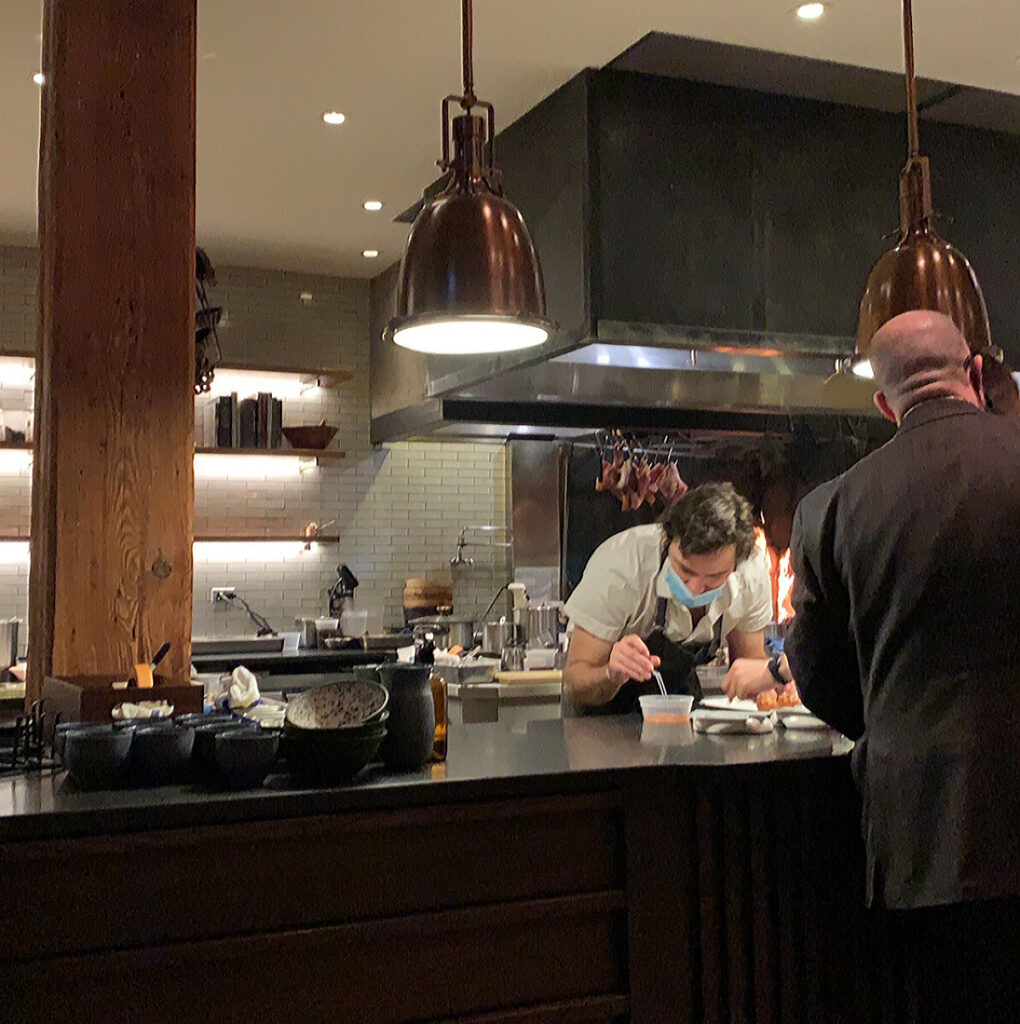
Instead, after about a year of post-pandemic operation, Smyth debuted a $345 per person “Chef’s Table” experience that, beyond offering front-row seats by the kitchen and increased interaction with its team, comprises a longer (“enhanced”) menu filled with even more experimentation. (By comparison, Oriole’s $325 “Kitchen Table” offers premium seating without any additional courses. Alinea’s $475 “Kitchen Table” offers privacy and a couple unique preparations but distinguishes itself more with the “immersive” quality of the room—as expressed through the manipulation of light and sound).
While the absence of the former “Classic” menu makes it hard for Smyth to snare aspirational diners who might not—relative to the restaurant’s flashier peers—understand the its appeal, the “Chef’s Table” affirms that Shields and Feltz aspire to offer the city’s greatest gastronomic experience. The “Omaha” menu, in its time, was also somewhat limited: only a certain number of tables in the dining room could be devoted to what was frequently a four-hour meal. Correspondingly, the kitchen need only focus on crafting a smaller number of those unique dishes that distinguished the “Omaha” tasting from the “Smyth.”
But the “Chef’s Table,” billed as a “one-table-a-night experience” (though actually offered for up to two or three parties as necessary), takes things further. It is, in effect, singular, and it allows the kitchen to channel a large degree of effort toward a small number of special plates. This takes all the precision that is characteristic of sweeping, Michelin-starred dining rooms and applies it in a more intimate encounter. The fact that “the chefs serve and explain each course,” as described on Tock, sounds more like an omakase—or the four-seatings-a-week Chef’s Counter at Rose Mary you just reviewed. The menu carries that intoxicating air of being a friend of the house, of being treated to delights that are for your tongue only.
Alinea’s “Kitchen Table,” surely, offers a bit of that feeling. Yet only for parties of six, which you think is more fitting for special celebrations than any kind of routine date night. It also does not help to be ensconced behind glass as the restaurant’s other guests are paraded through the kitchen. Sure, this privileged position might serve to feed some diners’ egos—and stoke status insecurity in those who, looking in from the outside, have chosen one of the humbler menus—but the effect is a bit too much like a fishbowl. And, quite frankly, everything Alinea does feels so overwrought, so calculated to please tourists and their cameras, that there is absolutely no sense of romance to their top-tier culinary expression.
Smyth’s “Chef’s Table” represents a doubling down on the experimentation that can be so polarizing for one-and-done diners. However, when you come to appreciate the process that Shields, Feltz, and their team engage in, this can only be called the restaurant’s ultimate experience. In talking through the preparations with various members of the back of house, you really get a sense of the warmth and camaraderie that reigns. Many of the ingredients and techniques that get described go over your head. Questions are always welcome, but even those who prefer to sit back and soak in the experience will be struck. For so much of what is served has just come into season, has just been freshly picked, or has been carefully sourced from some small farm (and not a ubiquitous national purveyor).
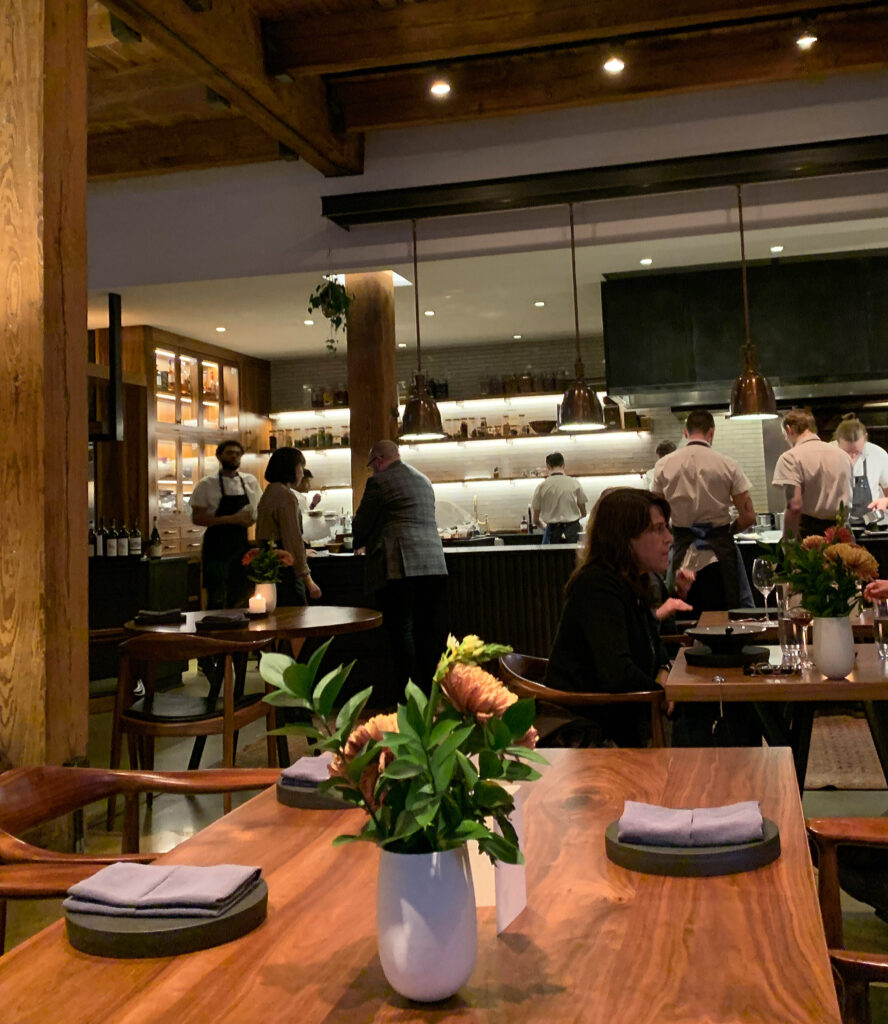
Through the “Chef’s Table” you come to learn—if you did not already—just how dynamically the kitchen operates. Every dish seems to tell the same story: the chef got their hands on some certain ingredient this week and inspiration took hold. Sometimes, that ingredient forms the central component of a preparation. On other occasions, it plays a supporting part in a more persistent recipe that Smyth has been tweaking week to week or month to month. But you always get the sense that the various pieces are constantly changing—that what you are tasting, tonight, will never exactly be replicated.
There is certainly something cavalier about this paradigm. Does the party that only enjoys a tasting menu once or twice a meal really want to pay that premium only to roll the dice on something no other customer has eaten before? Static menus, especially for nationally renowned restaurants like Kasama, help ensure that every guest, on any given night, gets to taste the best of the chef’s creations. But Smyth’s interpretative, generative process—while risky—delivers more deliciousness in the aggregate. The “Chef’s Table” allows diners to embark, alongside the kitchen, on a creative journey. In doing so, it reveals just how short-sighted it is to clutch onto “perfection” when forces like the novelty effect and hedonic treadmill ensure anything perceived as such is destined to be short-lived.
Yet it is only through repeat experiences that this reality comes to the fore, and you hope that showcasing Smyth’s work from 2021-2022 illuminates just how well this process pays off. You may even say that, while most fine dining restaurants offer diminishing returns with further exposure, Shields and Feltz’s food grows exponentially in its expression thanks to the perpetual entry of new ingredients into new and old forms. Once your palate comes to prize this shapeshifting quality, it is hard to ever return to a more broad, nomadic manner of dining out (at least when it comes to Michelin-starred tasting menus).

One last note about the “Chef’s Table.” When booking tickets for the experience, Tock necessitates that users choose between Smyth’s “Reserve” ($225) and “Super Mega” ($375) pairings in order to proceed to checkout. This kind of stipulation is not unheard of: Alinea required the same kind of commitment when purchasing its “Kitchen Table” but, to its credit, no longer does. You think it is fair for restaurants to guarantee that guests booking their most premium seatings will support the wine program to a moderate degree. But this presupposes that consumers value the beverage’s traditional, privileged place at the table. And you cannot recall any restaurant ever justifying such a policy explicitly.
The good thing is that while Smyth makes it so that you must choose one of those options, it does not collect payment for the pairings at checkout. Rather, your selection indicates an intention that is later confirmed at the start of the meal. This provides an opportunity to opt for bottles from the list instead. You think it is good form to spend an amount that corresponds to the cost of the stipulated pairings. But you do not think the restaurant would hesitate to accommodate someone who wanted to drink less wine or no alcohol at all. (Feltz has previously designed the menu’s non-alcoholic pairings, which have yet to return but would certainly fit the “Chef’s Table” format well).
In order to organize Smyth’s creative output from 2021-2022, you will use a loose narrative structure that allows you to preserve the meal’s (each meal’s) momentum. However, the wide array of dishes this period comprises will be grouped thematically, allowing for a richer evaluation of how certain ingredients have been treated over time. Also, the persistence of particular set pieces (filled with ever-changing items that roughly maintain the same form) will allow for certain sections that track the evolution of a certain idea (or obsession) over a longer period of time. You will also look to reference Goldsmith’s chosen pairings when notable.
2021-2022 has seen Smyth host collaboration dinners with Christopher Kostow, Johnny Spero / Rubén García, Paul Liebrandt, Ron McKinlay, and Atsushi Tanaka, which have formed some of your peak gastronomic experiences in Chicago. It is striking not only to taste another chef’s cuisine, but to see the degree to which Smyth changes its own menu—even compared to what was served only a week before. You are able to sense how these collaborations work to fuel the kitchen’s usual creative process and kick it into overdrive. Thus, while you will omit the guest chefs’ dishes from your analysis, you will feature noteworthy Smyth creations from these one-off dinners that help inform the restaurant’s larger body of work.
With all that said, let us begin our exploration of the noted period, an era you might term the rebirth—or reorientation—of Smyth’s cuisine. For, though the restaurant’s core philosophy has remained the same, its practitioners comprise many new faces. And their devotion to the expression of terroir—once of a distinctly Illinoisan type—has expanded to include all the riches of the national bounty. From this mix of old and new and near and far, Smyth has charted a course that breaks from its past while, in your heart of hearts, still ringing true. That, perhaps, forms the silver lining of the crisis the industry has endured: revealing what quietly remains resilient even when everything else turns upside down, reminding chef and diner alike just how precious every fleeting moment—and morsel—is.

But first, before getting all poetic, let us return to Ada Street.
Good ol’, congested Ada Street, which now swells with added traffic from the western end of Randolph Restaurant Row. There, the new Local 130 Plumbers’ Hall and Parq Fulton Apartments (now home to two glitzy Bonhomme concepts) have formed the capstone to a promenade that once—just a few blocks east—seemed to fizzle out. Yes, the days where Smyth and Elske stood as lone fine dining outposts, with parking lots for neighbors, are but a distant memory. Development, now, has formed a pincer movement that has saturated 177 N Ada in all directions.
One block to the north, Ever has clinched two Michelin stars by offering Curtis Duffy’s sweet, herbaceous interpretation of molecular gastronomy—drawn, at least in part, from the Alinea heritage that he and Shields both share. The latter chef, nonetheless, need no longer worry about Rêve Burger stealing his thunder (as if frozen fries and a ketchup + mayo “secret sauce” could ever take down The Loyalist’s “Dirty Burg”). Rather, Ever’s new lounge After will present a distinctly more up-market rival to Smyth’s basement haven.
One block to the west, you find the two aforementioned Bonhomme haunts: Bambola and Coquette. While you find this group underwhelming in a purely culinary sense, they hold a Michelin star (at Porto) and have developed a rather formidable formula for creating aesthetically appealing concepts that turn the heads of the influencer class. Bambola, with its hackneyed “Silk Road” theme, hardly forms a direct competitor; however, Coquette’s “modern and playful takes on bistro classics” treads into the same exact territory as Shields and Feltz’s reimagined menu for The Loyalist. When it comes to food and wine, you think Bonhomme is clearly outclassed. But you think Coquette, nonetheless, will have little trouble attracting diners to its “pink, Parisian, Champagne drenched dream” of a venue.
The area to the south of Smyth—comprising Washington Boulevard and Madison Street—remains surprisingly commercial, with little by way of fine cuisine until you reach Monteverde. However, continued residential development, alongside significant investment in the streetscape, is sure to cement an ever-greater population of patrons ready to fill the seats of Randolph’s restaurants.
Finally, to the east of Smyth lies the same veritable wonderland of hospitality as before. But, at its furthest reaches, that now includes a luxe steakhouse from Feltz’s old boss José. It includes a rejuvenated Oriole (favored, you think, to win a third Michelin star with the foundation its remodeled interior and more immersive manner of service provides). And there are a couple new chef-driven tasting menu concepts—like Joe Flamm’s counter at Rose Mary and Stephen Gillanders’s within Time Out Market—to contend with too.
Smyth finds itself as something of an old warhorse among upstarts, renovations, rotating theme menus, and all manner of superficially appealing “clubstaraunts.” The exact nature of the restaurant’s value proposition is not so easily distinguished as its two-Michelin-starred peers—or even as the Poseys’ place right around the block. That is not for lack of depth or artistry. Shields and Feltz make beautiful food, but they never embellish it. Their dishes are beautiful just as nature, quite simply, is—and, thus, they trade the viral appeal of alien hues and tortured textures for a subtlety that subverts the social media paradigm.
Thus, most visitors to 177 N Ada are destined to go downstairs in search of easy, immediate pleasure. They traverse the sidewalk while falling under the shadow of The Mason, a 13-story apartment building that stands across the street. Seasonally, The Loyalist’s patio—a remnant of the pandemic era—breathes life into the corridor like an open-air café. It humanizes a stretch of road better characterized by honking horns, screeching tires, and the occasional lobbed profanity.
But, once the weather cools, customers cannot wait to slink inside, climb down into the basement, and tuck into one of Chicago’s most totemic burgers—recently christened as the city’s best for the umpteenth time, drawing an appreciative response from Shields along with an even more striking admission, from the chef, that the notion of a “best burger” is inherently flawed. (Philosophically, you must agree: the “best” burger—or rendition of any beloved comfort food form—is always, apart from those examples that stoke intense personal nostalgia, the one sitting right in front of you at a given moment).

All the while, the idea of “Smyth”—of what the concept upstairs may represent—is left shrouded in mystery. The pickled and charred onion, the smash patty, and the frites announce that someone, somewhere back in that kitchen can really cook. The rest of the “Hors d’Oeuvres,” “Plats Petit[s],” and “Plats Principaux” signal that bar food is hardly de rigueur. Guests would be forgiven for thinking that a stuffy French toque reigns with terror over the dining room above. Yet, save for any accidental ingress (something bound to happen despite the signage), The Loyalist’s patrons get little more than streetside glimpse of Shields’s masterwork.
The dining room, they may note, is filled with wooden tables and chairs interspersed with the occasional structural beam. Fine stemware sparkles atop the surfaces, candles flicker, but there’s not a white tablecloth in sight. Instead, you may spy brick walls, a well-worn rug, and an ample credenza (also in wood). There’s a lounge area, and a central kitchen pass from which a tangle of legs intertwines to meet the outflow of dishes. The guests, in their own right, comprise a sea of red bottom heels and loafers with the occasional isle of boots, sneakers, sandals and/or shorts. But that’s about all your Ada Street vantage point—positioned some half a story beneath the floor of the dining room—affords.
Does the average visitor to The Loyalist, lured by the promise of a superlative beef patty and set of buns, dwell on what goes on upstairs? Seated snugly in the bosom of Smyth’s basement bar, who could want for more? Nothing about the two-Michelin-star operation, viewed from the outside, teases or taunts you. The restaurant’s posture is not one of unseen extravagance shielded by a sleek façade or set within a coy alleyway. No, Smyth more or less lays its cards on the table. It begs to be discovered but has refused to enmesh itself with any kind of ambient trickery.
As West Loop reaches critical mass, Ever and Oriole will remain blissfully above the fray: worlds unto themselves situated beyond the mobs of roving yuppies. Passing by the chamber of hanging food—or stepping through the ancient freight elevator—will form the portal to an experience that stands totally removed from the larger neighborhood. But Smyth, with front-facing windows that are open to the world, will find itself woven more and more deeply into the bustle of the city. As the restaurant becomes less isolated, it is bound to feel more ordinary—just another one of countless dining rooms in the area. Yet forming this connection to the reality of big city life, rather than looking to escape it, forms the fulcrum of Smyth’s hospitality.
The Shieldses, as always, offer a vision of luxury that is wholly integrated into everyday life. That is reflected equally by the burger, beer, and a shot offered downstairs—as well as the two- to three-hour tasting menu conducted upstairs. For the view out from Smyth’s windows, toward the quotidian fitness classes and dog walking that define life across the street at The Mason, reminds you that appreciating the moment of the season—an evening at table with those you hold dear—should feel ordinary. That is not to discount the outlay such an experience demands, but to affirm that it engages feelings rooted in the familiar. Smyth does not offer the sugar high of fantasy, but the deeper sweetness that only an awakening—a reflection on (and reconsideration of) our daily habits—can provide.
When you climb the steps and pass through the weighty wooden door that forms the restaurant’s threshold, a feeling of warmth immediately takes hold. There is no imposing host stand, no cold holding area from which to cross-examine those who seek entry. Instead, the host or hostess whisks themself around the counter to relieve you of your belongings. The wine director and general manager are usually on hand to offer their greetings too. But there is no question that this is a restaurant in motion. Almost the totality of the operation is visible from this entry point, and you are guided to a table that feels less like a sanctum and more like a conduit that shares, alongside the other guests, in the energy that flows out from the kitchen.
Otherwise, Smyth’s dining room offers familiar digs. The hearth has been rebuilt, and a couple legs of ham are now strewn from the ceiling right over the pass. The record player—that beautiful touch of atmospheric curation—has not been fussed with since the pandemic. But the room remains bright, comfortably appointed, and moderately spacious. It is easy to people-watch or converse with one’s neighbors should you so choose. Or, just as easily, you may sink back into your banquette or armchair and engross yourself fully in the charms of your dining companion(s).
Water preferences, allergies, beverage selections, and the possibility of a wine pairing are all handled in short order. Service is flowing, conversational, and infinitely adaptive to the needs of the evening. Eventually, the kitchen is directed to open the floodgates. Feltz calls out your table number, and his team repeats it in unison. Working, quite literally, shoulder to shoulder, the back of house begins its onslaught.
(Shields, meanwhile, coolly wades into the action: alternating from upstairs to downstairs and floating from station to station. When you see him stop somewhere for an extended period time and start joking with one of the cooks, it is best to pay attention—a new dish is, just then, being born.)
But Smyth’s tasting menu, for much of 2021 and 2022, has begun with a presentation of seafood. From March to October of 2021, it was titled “Several Servings of Chilled Shellfish” and comprised anywhere from two to four constituent parts. The assortment of pieces would be splayed upon trays of ice that were then placed onto raised stands of varying height. Thus, in the blink of an eye, the table would get set, and the meal would hit the ground running with a medley of bites.
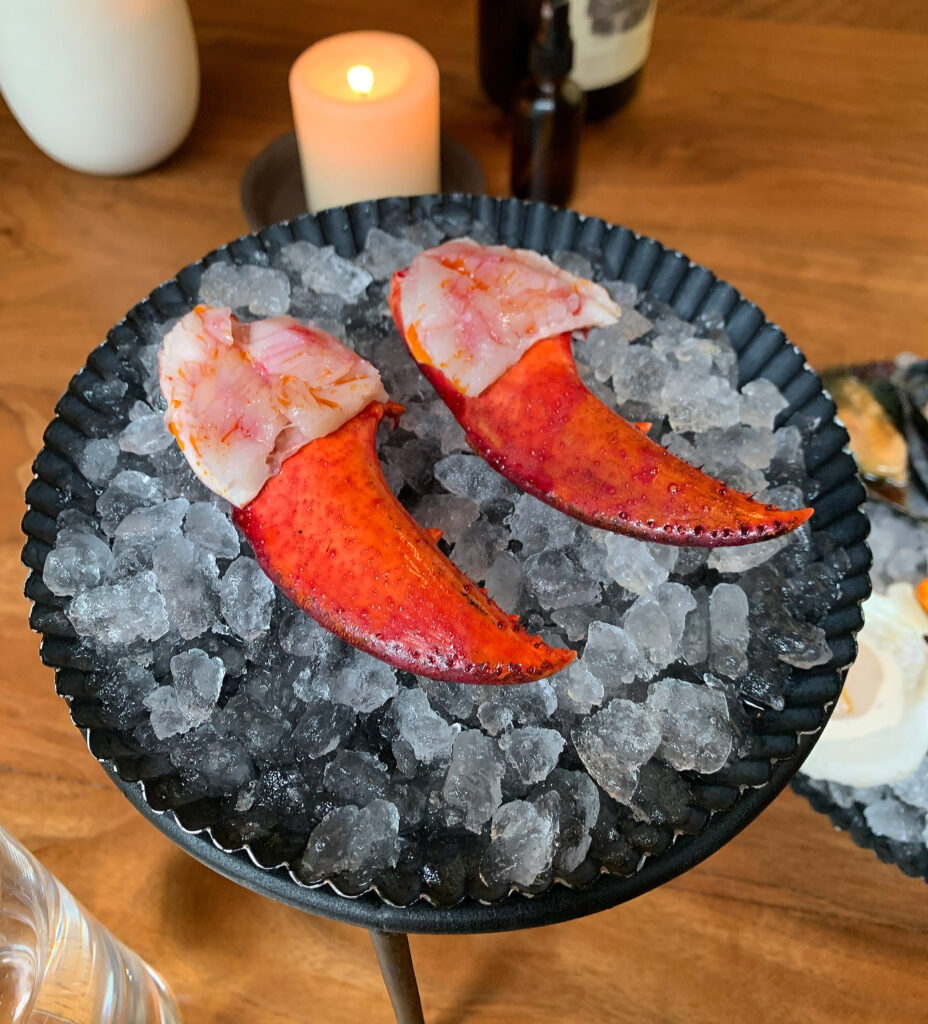
The earliest of these was titled “Barely Cooked Lobster Claw Seasoned with Salted Raspberries”—later labelled “with Salted Fall Raspberries” and “with Salted Fall Strawberries” as time went on. Shields has long been obsessed with the combination of fruit and shellfish, an idea that is not unheard of (when you think of dishes like ceviche) but is rarely pursued to such an extreme.
Each claw serves as its own “utensil,” holding a prime morsel of meat opposite the end of its pincer. The flesh displays a translucent, hot pink hue consistent with its “barely cooked” moniker. It is dressed rather simply with the salted berries, which take the form of a reddish orange sauce set into the lobster’s crevices. The resulting bite features a glossy mouthfeel with just a faint bit of chew. The claw’s flavor is pristine and subtly sweet. (You have always preferred this raw expression to many of the crustacean’s cooked preparations.) Yet the salted berries supercharge the lobster with a fleshy, savory fruit quality—and only a hint of acid—that is totally unlike their fresh counterparts. In this manner, the raspberries and strawberries build on the claw’s sweetness without ever obscuring its own character.
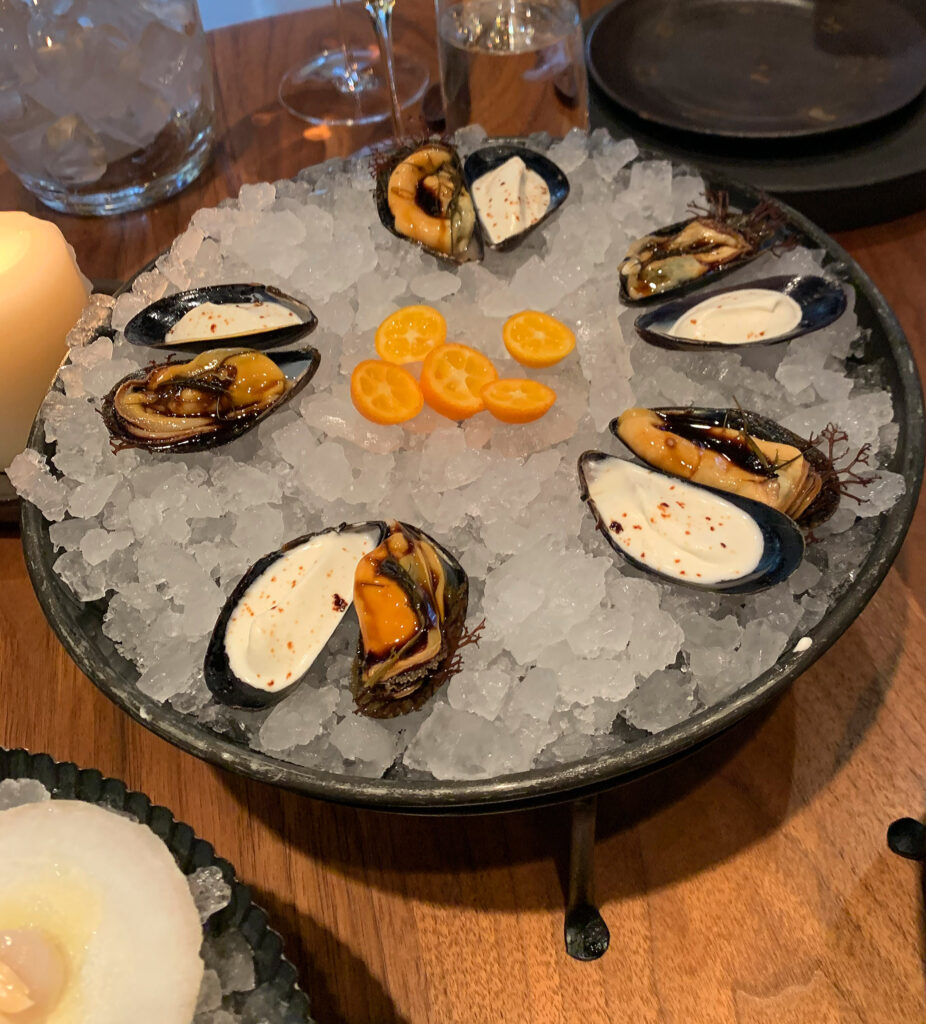
One of the other “Servings of Chilled Shellfish” comprised a bivalve that, more popularly, has featured downstairs in The Loyalist’s preparation of “Moules à la Bourguignonne.” But, whereas the basement restaurant indulges in a greater quantity of the mollusk, Smyth goes the singular route. Its “Wild Maine Mussel in a Savory Licorice with Lightly Whipped Cream”—later titled “with Charred Ramps & Lightly Whipped Cream”—offers a fine-tuned exploration of the ingredient’s depth.
The mussel arrives on the half shell with its meat sitting in a shallow pool of either the savory licorice or charred ramps (both rendered as a viscous oil). The other side of the shell contains a quenelle of the lightly whipped cream. In the center of the ice, a halved cape gooseberry awaits. Guests are instructed to squeeze the fruit’s juices over the mollusk before using a spoon to top it with the accompanying whipped cream. The complete bite offers a tender, slightly chewy texture encapsulated by a smooth, milky mouthfeel with a touch of contrast drawn from microgreens.
The mussel’s own flavor is oceanic and faintly sweet—benefitting from the tart, ripe, and tropical notes of the gooseberry. But it is the “savory licorice,” with its anisey-umami undercurrent, and the charred ramps, combining pungent allium with a pleasant bitterness, that enliven the bivalve. Both of these elements provide ample savory backing to cut through the froth of whipped cream, but—importantly—their flavors resonate more on the finish than the forefront of the palate. Thus, the mussel’s own flavor remains distinguishable despite being layered with a triple threat of accompaniments.
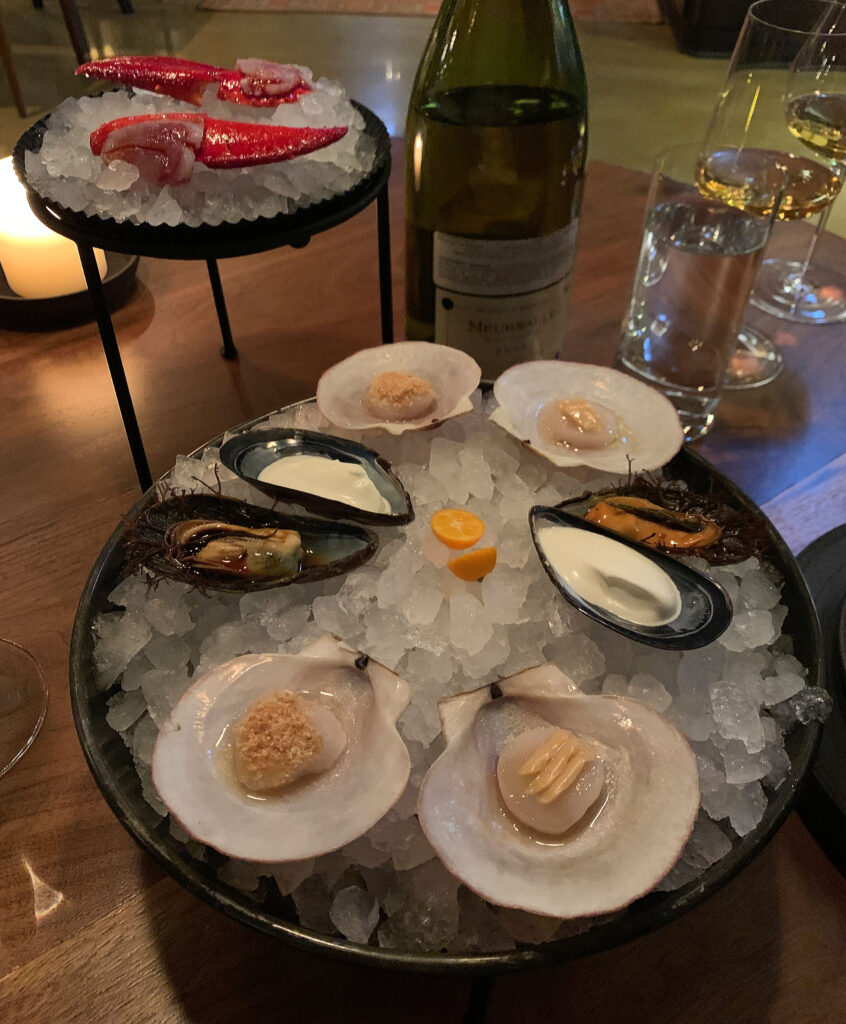
Scallops, too, have also featured as part of Shields and Feltz’s “Several Servings of Chilled Shellfish,” where they have formed—for you—one of the very best items. Initially, the chefs served a lone “Scallop Marinated in Bergamot Nectar & Hazelnut” alongside the mussels. However, that quickly expanded to include a second salvo of “Scallop Dressed with Chanterelle & Hazelnut Miso.” (And, eventually, a “Scallop with Hazelnut & Blackened Yuzu” would also appear).
Each of these preparations, in the same vein as the other shellfish, has showcased a neat serving of the mollusk set within its halved shell. The scallop is sliced in half and portioned across the two preparations so that each can be taken in one go. Both shells are laced with a drizzle of the liquid element: bergamot nectar, hazelnut miso, or one of the kitchen’s signature lactic sauces (in the case of that last preparation). The other components—like the hazelnut, chanterelle, and blackened yuzu—are shaven, piped, or dripped over the bivalve’s top. This allows for a single, cohesive bite whether one dives in with chopsticks or tips the shell toward one’s mouth before slurping.
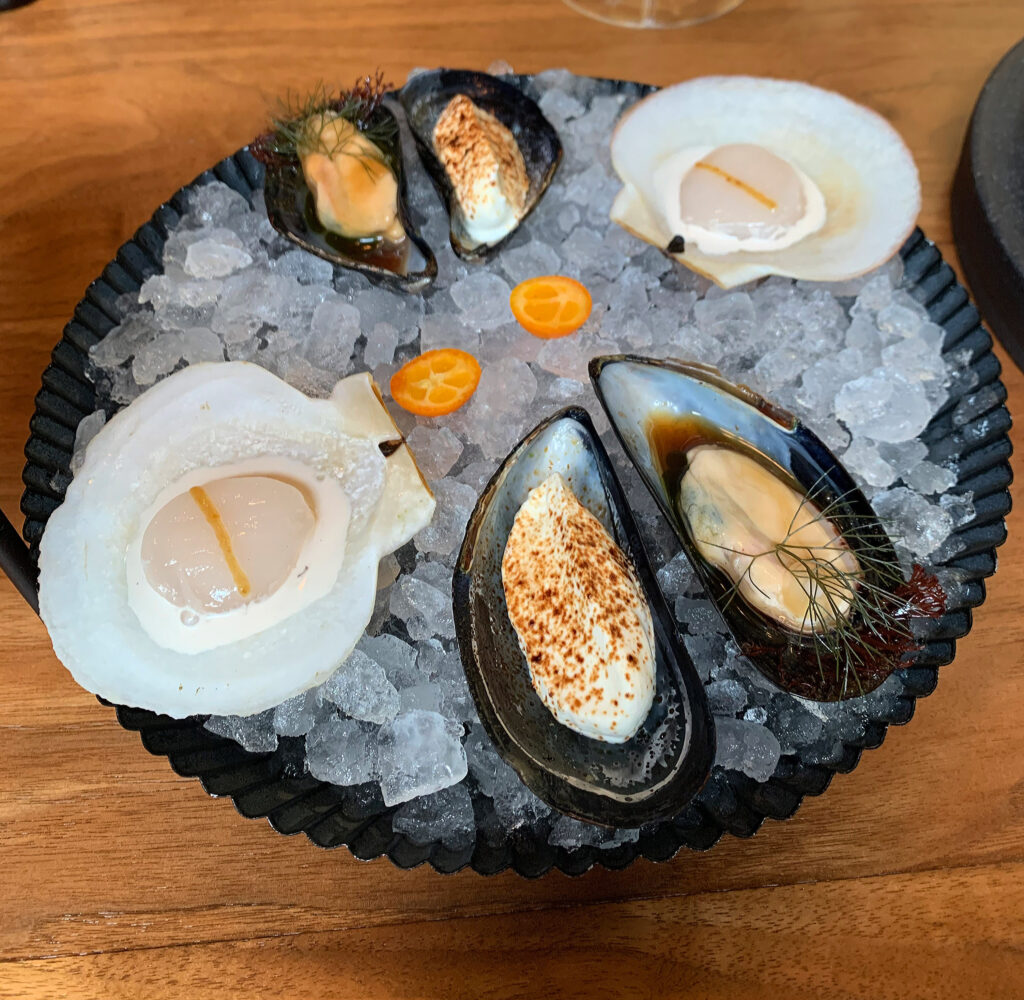
Once the scallop reaches your tongue, you marvel at its smoothness. The flesh offers a bit of resistance before yielding to that transfixing, gushing quality that makes sashimi versions so satisfying. While the bottom coating of sauce serves to moisten the mollusk, the top garnish offers a contrasting crunch (in the case of the hazelnut) or creaminess (in the case of the chanterelle). On the palate, the scallop displays the same pristine quality as the other aforementioned seafood. However, its comparably buttery texture joins with a mild sweetness to make for a feeling of delicacy. That forms a fitting canvas for each of the three flavor constructs: sour, heady bergamot with sweet, earthy hazelnut; fruity, woodsy chanterelles with the concentrated umami of nut miso; or floral, citric yuzu with its own touch of hazelnut. Personally, you have enjoyed the “Scallop Dressed with Chanterelle & Hazelnut Miso” most for its savory intensity, but each preparation uses its star ingredient to great effect.
One of the later additions to the “Chilled Shellfish” sequence has been the humble clam. (Though, in the case of the razor clam, perhaps not so humble.) Shields and Feltz have given this slender bivalve the same five-star treatment as the scallops and lobster, offering two distinct preparations: “Razor Clam with White Asparagus, Black Currant & Bergamot” and “Razor Clam with Hazelnut, Apricot & Chanterelles.” Some of these ingredients, surely, match those used to flavor the other offerings of shellfish, and noting these elements reveals some of the common grammar through which the chefs treat mollusks. However, this hardly signals a “paint by numbers” approach. It is rather more a sign of stylistic consistency and the development of certain foundational combinations.
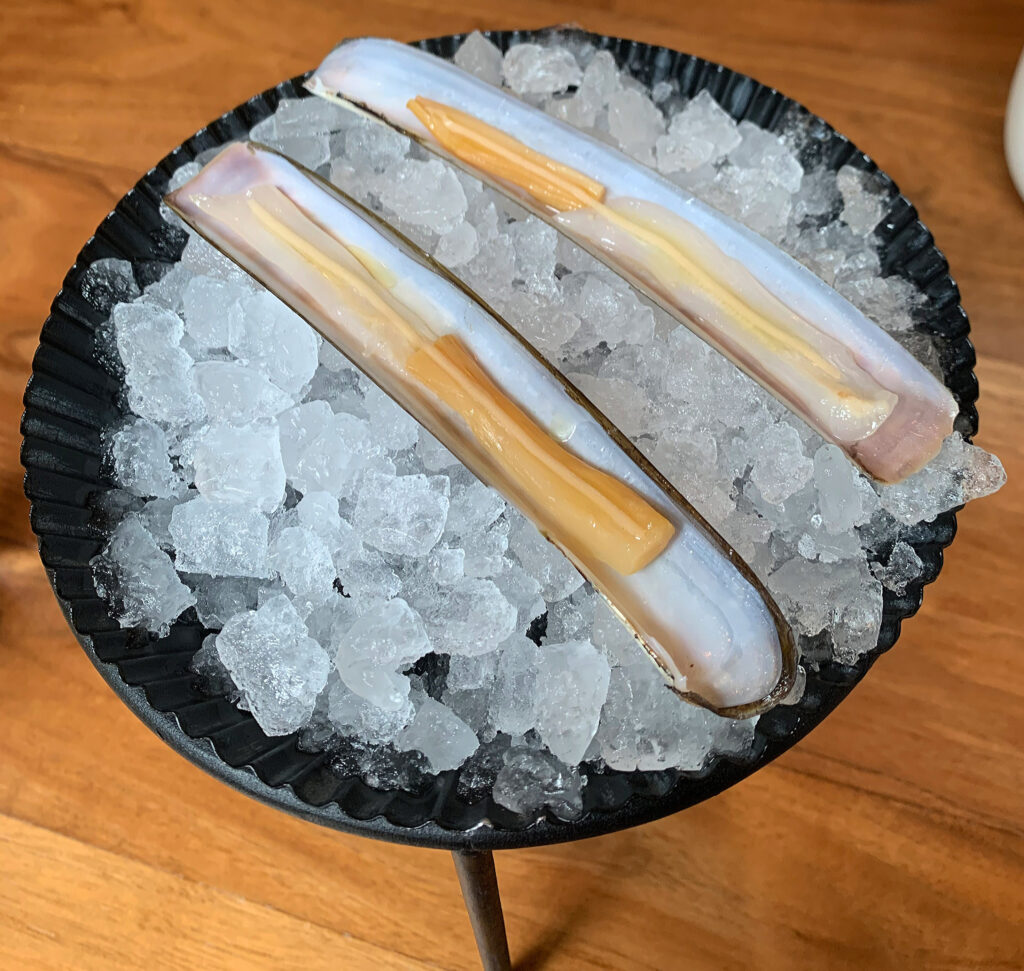
The razor clam, in familiar fashion, is served on the half shell. There, its thin, glistening meat is joined by a strip of the white asparagus (or chanterelle) that, though darker in tone, matches the bivalve’s flesh in terms of length and thickness. The two pieces are lightly moistened with nectar drawn from the bergamot or apricot then topped with a thicker gel made from the black currant or hazelnut. This latter element stretches from the razor clam’s flesh over to the white asparagus/chanterelle, completing the illusion that the two ingredients are actually one.
Diving in, you begin with the asparagus/chanterelle element, which is pointed toward you. Plucked with your chopsticks, they each display a slight crunch that stands apart from the other shellfish preparations. The razor clam, meanwhile, displays a glossy mouthfeel on the palate with a bit more firmness, upon being chewed, than its counterparts. These two textures match each other well and are further connected by the accompanying flavors. The pronouncedly sweet, tart black currant joins with the sour bergamot to soften the bitter, briny qualities of the asparagus and clam. Or, alternatively, the sweet, tart apricot joins with the earthy hazelnut to match the flavor of the chanterelle (often compared to apricot) and enrich the meaty quality of the clam. Both renditions, ultimately, are surprisingly refined considering this bivalve’s lowly status. Bringing in a bit of produce or fungus also serves to connect the opening bites to the greater vegetal scope of the meal.
This reminds you of one particular preparation that was served alongside the “Several Servings of Chilled Shellfish” in May of 2021. After each of the trays were placed onto their stands and the various lobster, mussel, scallop, and razor clam compositions described, your server deposited a ramekin on the table. They called your attention to the vase of flowers that had sat on the surface since the start of the meal, revealing that it held—among the stems—two stalks of asparagus. The vegetables were to be dipped into the accompanying oyster cream—brimming with herb oil, flower petals, and microgreens—as your opening bite. This “Vase of Green Asparagus with Oyster” not only formed a throwback to one of Smyth’s cleverest presentations, but made for a brilliant synergy with the “Razor Clam with White Asparagus” that appeared as part of the shellfish platter.
Drawing this sequence to a close, you have one of the most totemic representations of luxury seafood. It used to be that nearly every tasting menu began with some kind of carefully dressed oyster, and that still holds true at many restaurants today. Smyth, nonetheless, delayed featuring the bivalve until the tail end of its “Chilled Shellfish” set piece. After the “Vase of Green Asparagus with Oyster” (a deconstruction of the ingredient into a kind of “dip”), Shields and Feltz offered an “Oyster with Plum & Blackened Yuzu” on a couple occasions.
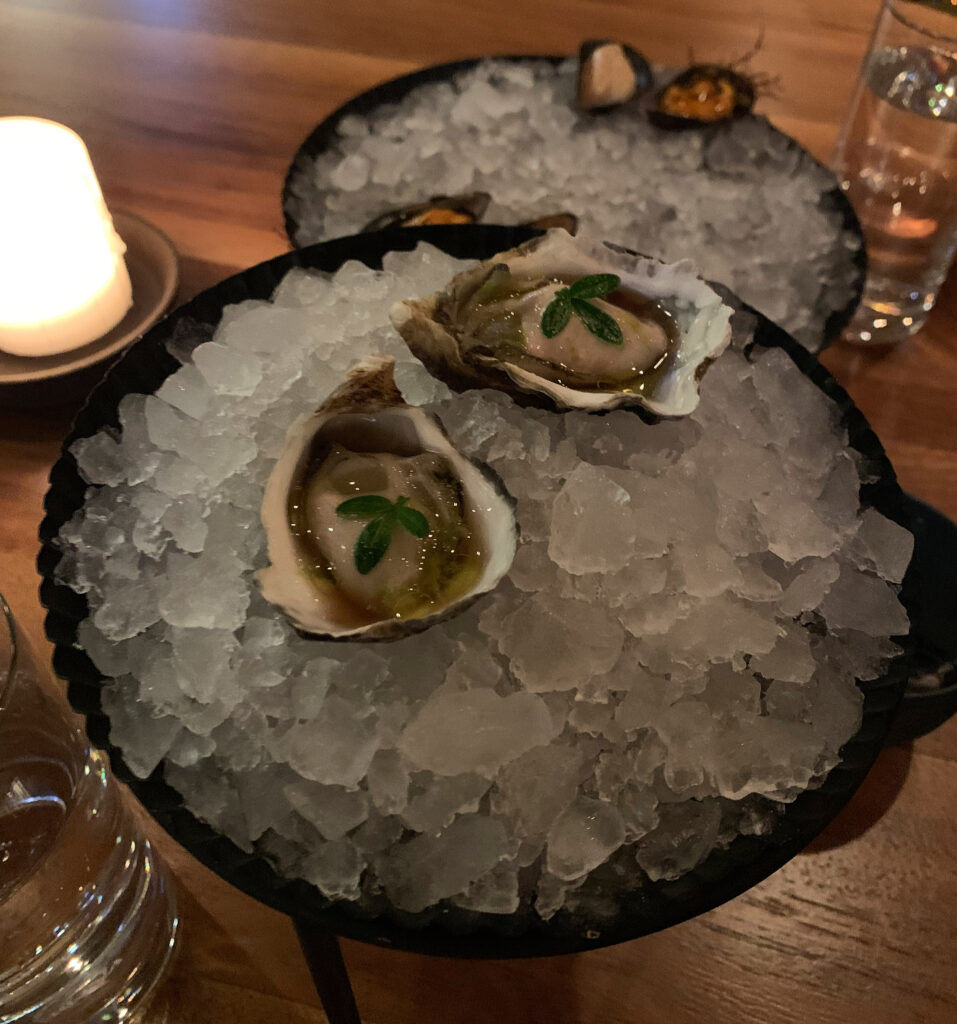
Once more, the blackened yuzu element forms a connection to a previous item (“Scallop with Hazelnut & Blackened Yuzu”). However, the plum represents a new direction. Processed into a sauce, the fruit coats the oyster with a vivid, reddish-purple hue that encourages slurping. Taken in one shot, the bivalve offers a rich, creamy flavor with hints of cucumber but little brine. The plum provides an enveloping sweetness that fleshes out the oyster’s character while the blackened yuzu—with a bit of citrus and a deep florality—brightens the bivalve without detracting from its fullness of flavor. This made for both a bold and delicious take on the ever-present ingredient.
From November of 2021 through March of 2022, Shields and Feltz started the meal with a reimagined presentation of seafood that centered more specifically on mussels (along with a couple other friends). The core of this sequence comprised two different preparations of the bivalve served on the half shell: “Mussel Glazed in Onion Licorice with Lightly Whipped Cream” and “Mussel in a Ramp & Kale Escabeche.” In a sense, these two bites represent the division of the aforementioned “Wild Maine Mussel with Charred Ramps & Lightly Whipped Cream” into a pair of complementary dishes. They also reflect a deeper exploration of one particular (perhaps less conventionally “luxurious”) bivalve rather than an entire medley.
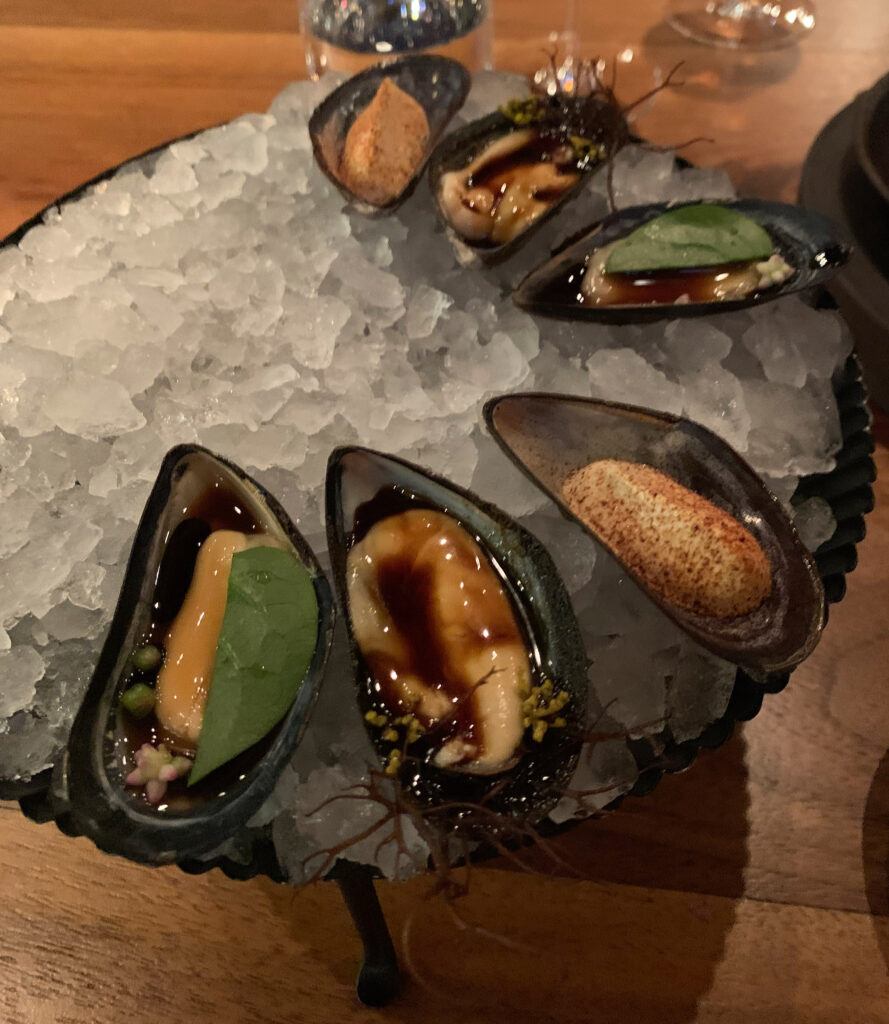
The first of these, “Mussel Glazed in Onion Licorice with Lightly Whipped Cream,” takes a familiar form, but gone are the gooseberries. Instead, you simply spoon the whipped cream—now dusted with an unknown powder—into the halved shell and take it whole. Texturally, the ratio of the mussel to the cream is better managed, ensuring that the bivalve does not get totally drowned out by the encapsulating milkiness. Instead, the mollusk shows a nice softness and meatiness on the palate. When it comes to flavor, the “onion licorice” is very much reminiscent of the more mysterious “savory licorice” that has featured before. This element underscores the mussel’s mushroomy, umami character while also melding well with its sweetness.
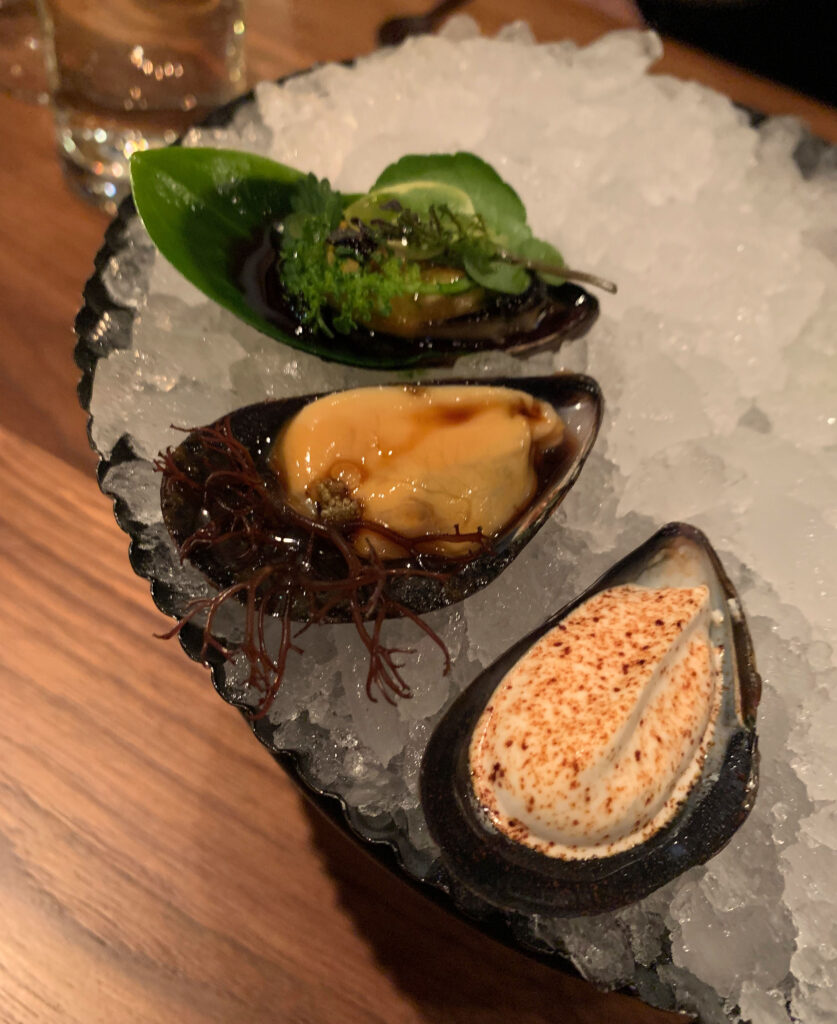
The “Mussel in a Ramp & Kale Escabeche” is served in a similar manner (sans whipped cream) but, by comparison, is defined more by driving acidity than savory depth. While the ramps’ alliaceous quality can be said to match the previous bite’s oniony character, the wild leeks possess a garlicky tinge that is highly appealing. It joins with the pronounced, earthy flavor of the kale and the vinegar notes of the escabeche to charge the palate with a mouthwatering intensity. Taken after the more subtle onion licorice and whipped cream preparation, this bite leaves you licking your lips in anticipation of the next course.
These two mussel preparations were later joined by a “Mussel Cloud with Kombu,” which later transitioned into “One Bite of Frozen Maine Uni & Mussel Parfait.” These creations, in your opinion, come as close to the Alinea/minibar style of molecular gastronomy as you will ever see at Smyth. Nonetheless, their inventive form does not preclude—as is so often the case—pleasing flavors.
The ”Mussel Cloud with Kombu” revolves around a puffed, frozen transmogrification of the mollusk whose many grooves and ridges look a bit like tripe. Yet the substance breaks apart easily and melts on the tongue, leaving behind a haunting oceanic flavor with a hint of sweetness. The kombu (or dried seaweed) is reconstituted and tucked into the bottom of the bowl, where it provides a contrasting firmness and warmth with pleasing umami undertones. You found this dish to be inventive and engaging to eat while also displaying an appealing length and purity to its flavors. However, other diners noted that the serving of “mussel cloud” (despite its ethereal mouthfeel) felt too substantial relative to the amount of kombu.
Thus, “One Bite of Frozen Maine Uni & Mussel Parfait” was born. While not quite a like-for-like replacement, this dish has captured the same sort of sensation in a more streamlined form. Rather than transforming the mollusk into a cloud, Shields and Feltz render the sea urchin as a mound of frozen shreds set atop a tart shell made of seaweed. The interior contains the mussel parfait—essentially a custard made from the bivalve—which also serves to anchor the uni.
Taken as a bite, the tart shell cracks cleanly and quickly yields to the frozen sea urchin that, like the “mussel cloud,” melts on the tongue. The parfait made from the mollusk, meanwhile, shows a bit more staying power. This means that, just as the sweet and briny flavor of uni kisses your palate, the mussel custard strikes with its own deep, lasting shellfish character. The two ingredients, with an added burst of umami drawn from the seaweed tart shell, meld together beautifully. You have rarely ever tasted sea urchin—save for Kyōten’s very finest examples—with such clarity and detail. And to think that Shields and Feltz squeeze such refinement and intensity out of a domestic variety! This bite counts as one of Smyth’s best throughout the restaurant’s shellfish sequences.
Ultimately, the “Mussel Cloud with Kombu” would return in March of 2022 and take its final form as “Frozen Mussel Parfait, Caviar & Roses.” While the previous preparation felt a bit out of proportion, the latter comprises a more compact, disc-shaped serving of the frozen bivalve “cloud.” Its grooves are dressed with an oil made from the roses, and, as before, the parfait gets broken apart to reveal a lower reservoir of flavor.
Relative to the kombu that was solely used before, the presence of caviar—and, later, uni—has offered the dish a more nuanced interplay between the melting mussel component and what lies beneath. Likewise, whereas the seaweed offered the bivalve complementary umami tones, the two types of roe each provide a more distinct expression of the sea. The briny quality of the caviar and salty sweetness of the sea urchin join with the subtle fruitiness of the rose to better flavor each bite of the frozen mussel. The resulting dish is more cohesive and, thus, engaging. It represents a nice refinement of what “Mussel Cloud with Kombu” originally sought to offer.
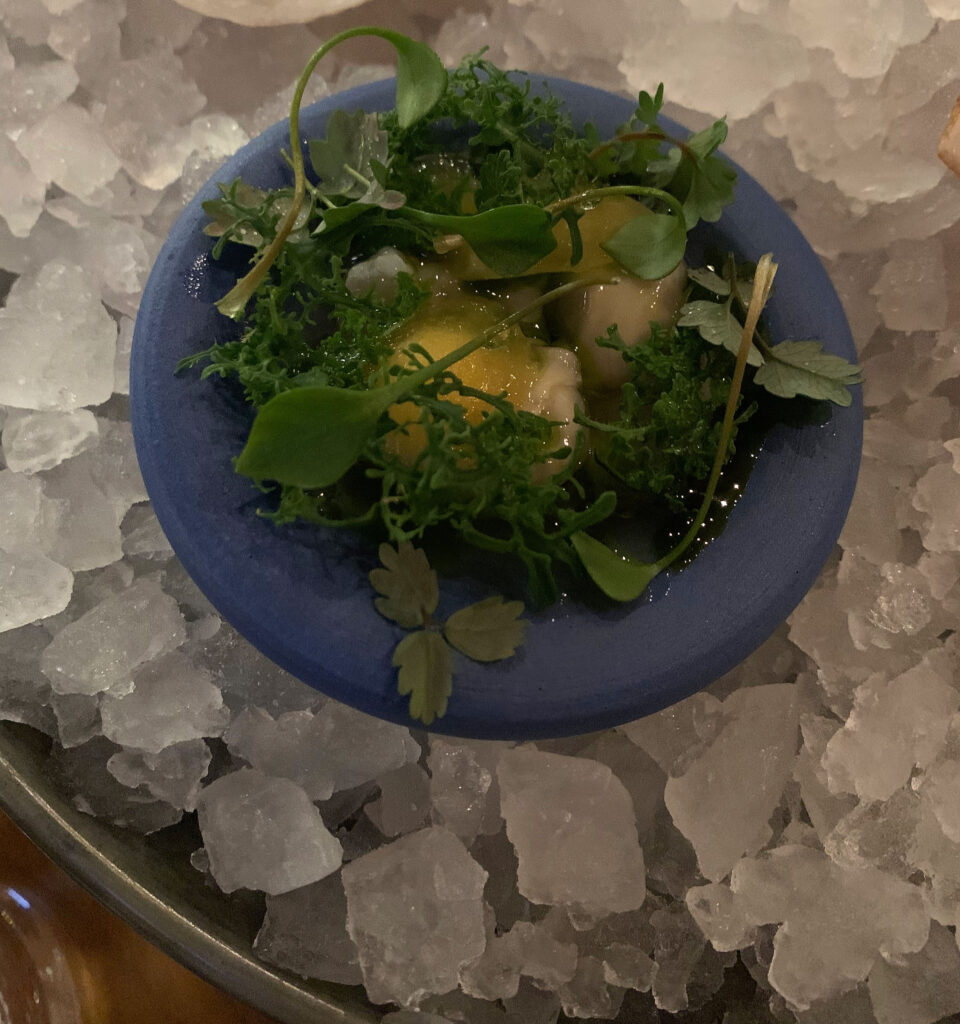
One other accompanying item that appeared during the course of this mussel-driven sequence was an “Oyster with Garden Herbs & Seaweeds.” Over time, the preparation has taken two forms. The first of these was a conventional oyster on the half shell that—relative to the “Oyster with Plum & Blackened Yuzu”—juxtaposes its buttery sweet notes with relatively subdued flavors drawn from the various greens. While, perhaps, lacking a “wow” factor, this preparation fits the Smyth style well and prepares the palate for a transition away from seafood toward the restaurant’s varied expressions of produce.
The second iteration of “Oyster with Garden Herbs & Seaweeds” extricates the bivalve from its shell and placed it in a shallow dish from which it could be taken as a shot. Though the flavor composition remains somewhat understated and “green,” this new form allows for a greater textural experience. The small stalks and leaves of the herbs and seaweeds contrast the smooth, slick mouthfeel of the oyster and help you better appreciate its delicacy. The presentation—with shades of green and tan set against the blue ceramic—is rather nice too.
From March through September of 2022, Smyth’s mussel-driven shellfish sequence took its final form (at least for now). First, that comprised a trio of “Razor Clam & Eucalyptus,” “Scallop & Maple,” and “Mussel on Ice” served in the familiar “Several Servings of Chilled Shellfish” style.
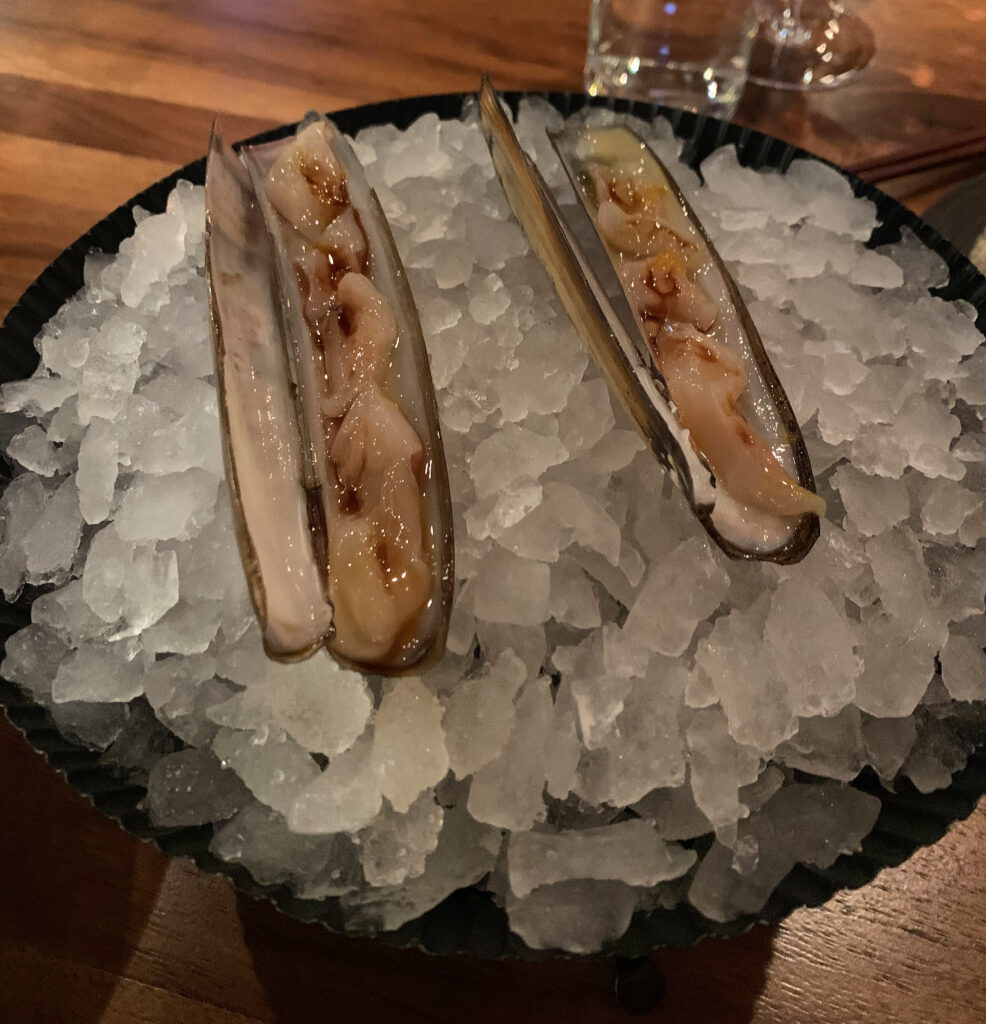
The razor clam, in this instance, lacks any asparagus or mushroom doppelgänger hiding within its shell. Rather, you are served the entirety of the bivalve’s meat divided into three distinct bites. Relative to the “Black Currant & Bergamot” and “Hazelnut, Apricot” renditions of the ingredient, the eucalyptus is relatively straightforward. The leaf, processed into an oil, offers hints of bitter, spicy, and minty flavor though stops short of any actual cooling effect. Instead, it does well to cut the slightly briny, tangy quality of the razor clam while maintaining an overall sense of purity.
The ”Scallop & Maple” bite, meanwhile, follows in the footsteps of the “Scallop Dressed with Chanterelle & Hazelnut Miso,” “Scallop Marinated in Bergamot Nectar & Hazelnut,” and “Scallop with Hazelnut & Blackened Yuzu” preparations. This mollusk, in Shields and Feltz’s hands, has always offered a high degree of decadence. Yet there is a beautiful simplicity to the maple pairing that accesses the scallop’s own sweetness and extends it very naturally via the caramel and nut tones diners associate with their favorite breakfast syrup. This easily measures up to the mollusk’s prior renditions. And it is quite striking how, over time, the chefs have found a way to use even fewer ingredients to conjure the same sweet and savory effect.
The last member of this trio, “Mussel on Ice,” has proven to be the most consequential. Relative to Smyth’s other examples of the mollusk, this presentation is rather simple. It comprises one entire mussel (no longer on the half shell) set within a bed of seaweed that sat atop a bowl of ice. Most intriguingly, the bivalve’s meat has been lightly smoked, extricated from its body, and thinly sliced. It is then delicately layered along both sides of the shell’s interior.
Thus, rather than chewing on a larger nub of mussel (in the familiar fashion), you now pluck slivers of the mollusk using chopsticks and lay them delicately across your tongue. They are lightly moistened with something reminiscent of the escabeche, but the preparation is all about purity. As each thin strip of mussel bends and breaks on the palate, it ingrains a faintly sweet, mildly oceanic and umami flavor that is kissed with smoke and that builds with each subsequent bite. You are left admiring the sensation’s length, and just how pleasurable and pristine the expression of the ingredient—only barely dressed—is.
Perhaps sensing this form’s potential, Shields and Feltz expanded on it. “Mussel on Ice” morphed into “Smoked Mussel Garden,” a set piece that in some way calls to mind the “Vase of Green Asparagus with Oyster.” It comprises a more elaborate and fanciful setup in which several bivalves (corresponding to the size of your party) are posed within a forest of seaweed that is interspersed more methodically throughout the ice. This presentation possesses much more verticality and seems to leap out at you. Eventually, leaves and flowers have come to appear too. They complete the “garden” aesthetic and help bridge the gap between land and sea.
The mussels themselves remain cut into slivers and placed back in their shells. The kitchen has gotten quite good at this technique, and small pieces of seaweed are sometimes interlaced among the mollusk’s layers (allowing it to blend into the presentation even more effectively). Otherwise, the meat of the mussel is still smoked and lightly moistened with some kind of marinade. It is still meant to be plucked with your chopsticks, but the new preparation has now seen the addition of an accompanying sauce. First, that has taken the form of a mussel parfait—laced with tiny flowers—that imbues each bite with floral, caramelly, and umami tones. A later sauce, also garnished with flowers, takes more of a liquid form. It offers a hint of acid with subtle floral, herbal, and seaweed notes.
Both of these dips lend the mussel slivers an added layer of complexity without obscuring their natural character. They also make your experience of the dish a bit more engaging. For, foundationally, enjoying the mollusk bite by bite in such a way—rather than slurping piece after piece in a moules-frites situation—encourages a deeper appreciation of its texture. The mussel feels like it has been raised to the same totemic luxury status as abalone or geoduck. Aesthetically, it is granted the chance to shine as if its jointed shell formed the petals of a flower. The “Smoked Mussel Garden,” in the teasing out the flavor and textural depths of its star ingredient, is utterly worshipful. This preparation represents the culmination of many great shellfish preparations over the course of 2021-2022, and it is sure to continue growing.
Moving on, it is worth noting that the “Smoked Mussel Garden” has actually formed a second course following on the back of a new opening salvo that, for the first time in a while, has nothing to do with shellfish. The sequence began to take shape in May of 2022 with the debut of a “Kombucha” made in house by Matt Orlowski. The cook, as part of the Chef’s Table experience, makes a point of always personally delivering the beverage to the table and talking through the steps of his brewing process. Guava was offered as one of the early flavors—with Shields and Feltz making its scoby the star of one particular dish—but corn and a combination of pear with soba have later appeared.
Whereas the “Several Servings of Chilled Shellfish” course would typically be partnered with the first of Goldsmith’s pairings, the switch to a kombucha-led sequence has worked to change the meal’s tone. Guests no longer get immediately plunged into a medley of mussels, scallops, and lobster claws that is offset by a glass of Grosses Gewächs Riesling. Rather, they are invited to sip—and meditate on—Orlowski’s brew. His kombucha is characterized by a slightly hazy color and rather mild effervescence that, nonetheless, displays a vibrant acidity with clean, pronounced flavors. In the case of the guava, the drink’s character is straightforwardly fleshy and sweet. However, when made using corn (in a manner reminiscent of Tejuino), Smyth’s kombucha offers captivating sour, tart, and earthy tones that are balanced by a bit of sugar but, in fact, show surprising staying power through the finish. Lastly, a “Pear & Soba” flavor—Orlowski’s most recent creation—may be the most delicious yet, displaying a full, sweet flavor with wonderfully nutty undertones.
In June of 2022, the kombucha was joined by a “Tomato & Blade Kelp Tartlet” for the first time. This item, though decidedly more humble than the “One Bite of Frozen Maine Uni & Mussel Parfait,” possesses a similar form—centering on the same impossibly delicate tart shell. This vessel, which can only barely be grasped without breaking, was well-suited to showcasing the ethereal shreds of frozen sea urchin. Here, the tartlet serves a similar purpose: housing the locules of heirloom tomatoes (the segment of the fruit containing its seeds enclosed in gelatinous membranes) within its shell. This filling—which can be red but sometimes takes on a striking alien green tone—feels a lot like tomato jelly, yet its bright, clean flavor reflects a raw, natural expression of the ingredient. You cannot recall ever seeing these locules used so concertedly in a dish, and the context of the tart really helps them shine as a sort of “caviar.”
From the get-go, the “Tomato & Blade Kelp Tartlet” featured a rotating assortment of microgreens and flower petals as a finishing garnish. These shades of green, pink, yellow, red, purple, and violet—in a manner reminiscent of the shape-shifting “Seaweed Cookie” from Smyth’s past—ensure that each rendition possesses a certain degree of visual novelty. However, these leaves and flowers would later be joined by more robust garnishes like fresh English peas, shaven black truffles, or cod roe, and it is through these latter elements that the “Tartlet” has really come to reflect a moment in the season.
In the case of the peas, each piece of the vegetable pops beautifully on the palate and offers a sweet, unabashedly “green” character that joins naturally with the fresh flavor of the heirloom tomato and savory undertones of the blade kelp base. When it comes to the truffle, its thin shavings, too, are nicely accentuated by the delicacy of the tart. However, rather than synergizing with the tomato element, they steer the preparation toward a haunting earthy quality that also melds well with the “green” flavor of the peas (when they have both appeared).
Ultimately, these more luxurious toppings have given way to a comparably “naked” version of the tartlet that more closely replicates its original form. Nevertheless, it is at this moment that the cod roe has swept in and very elegantly matched the consistency of the tomato locule. The fish eggs also provide a salty, oceanic flavor that serves to “season” the mix of seeds and gelatin while naturally complementing the blade kelp shell. But it is at a visual level that the cod roe really shines—its pale, translucent tone blending perfectly into the tartlet’s body and serving to cushion an array of garnishes that transform it into an imaginative “sea flower.” Looking back, there is a beauty to how this dish, in its myriad forms, can act as a kind of gossamer canvas for different ingredients throughout the season and place them front and center at the very start of the meal. Shields and Feltz, to that effect, have found a rewarding form to play with—at least for the time being.
In August of 2022, Orlowski’s “Sweet Corn Kombucha” was given a special accompanying bite that would be served alongside the beverage and just before the “Tomato & Blade Kelp Tartlet.” This would expand the meal’s new opening to a total of three items (the point where it could truly be called a “sequence”) while further enriching one of its most unique components. The “Sweet Corn Macaron & Buttermilk” is not quite made in the pastry’s traditional style (one that Karen Shields has executed to great effect in the past). Rather, the bite feels more like a set of crumbly cookies dusted with a corn coating and sandwiched around a buttermilk cream filling. As much as that may sound like an Oreo, there is a thin, brittle quality to the macaron that matches the delicacy of the tartlet’s shell and connects the pastry to its traditional namesake.
Upon popping it into your mouth, the macaron crumbles, quickly unleashes its buttermilk filling, then leaves you with traces of the corn dust coating on and around your palate. This makes for a drying effect that the “Sweet Corn Kombucha” can then remedy. The brew’s sour notes harmonize brilliantly with the buttermilk while the sweeter, more purely corny character of the drink is naturally complemented by the pastry. In fact, the macaron serves to soften some of the kombucha’s more pronounced flavors and elongate your impression of its finish. Shields and Feltz have even, on one occasion, crafted a version of bite that snuck a layer of caviar in with the buttermilk cream. Though, perhaps, not the best way to appreciate the subtle texture of the roe, this frill offers nutty notes that still work well with the kombucha while amping up the dish’s hedonistic appeal. The “Sweet Corn Macaron,” with or without caviar, has been a real success: enriching its pairing while injecting a playful tone into the start of the meal.
In October of 2022, the macaron bid adieu and saw itself replaced by another kind of “pastry.” Being served after the “Sweet Corn Kombucha” and “Tomato & Blade Kelp Tartlet,” this combination of “Sunchoke Custard, Oyster & Pink Lemon” represents the sequence’s new closing act. Even more fittingly, the bite—at least on the first occasion you encountered it—was cleverly likened to cannoli (and later titled “Sunchoke Cannoli, Oyster & Pink Lemon” fittingly). It comprises a perfectly cylindrical, chip-like shell that, despite its fragility, comes loaded with fairly thick custard and a couple pieces of the bivalve. A pair of many-stemmed microgreens, set into each of the cylinder’s faces, forms a dead ringer for the crushed pistachios that typically crown the end of the Italian pastry. A few grains of puffed rice are interspersed to help complete the effect while, in later renditions, a black truffle paste has formed a decadent crowning touch.
Diving in, the bite feels light to the touch but demonstrates an impressive solidity. You can grasp it and take a bite without shattering the shell or spilling any of its contents. Rather, the crunch of the outer layer yields to the creamy, enveloping mouthfeel of the custard and the luscious texture of the oyster. With regard to flavor, the shell shows a slight caramel note that melds well with the sweet, nutty sunchoke and earthy black truffle. The bivalve, in its own right, is buttery sweet with clean notes of melon. But it is the pink lemon’s lower relative acidity—and higher perceived sweet, tangy, and fruity character—that really serves to connect the components. This citrus serves to brighten the raw seafood element while preserving the sense of richness that lends the “Sunchoke Cannoli” and its shell that “pastry” feeling. This is a fun form and one that Shields and Feltz have already begun to tinker with further.
In November of 2022, the “Sunchoke Cannoli” has seen itself joined by a new kind of macaron made with blood sausage and apple. Texturally, the item is less crumbly than the previous version made with sweet corn. Rather, the macaron has a doubly crisp, almost shattering effect when it meets your teeth. The pastry disappears quickly enough yet unleashes a concentratedly meaty, slightly sweet, and faintly metallic flavor. While that sounds overwhelming (as blood sausage can often be), the apple notes—drawn from fruit that is both roasted and burnt—moderate the meat element’s more wild character. The sum effect is, apart from its boldness, surprisingly cohesive and delicious. It makes for the kind of blood sausage bite that can make a believer out of those who typically find the product to be off-putting.
(In late November of 2022, the “Sunchoke Cannoli” and blood sausage macaron—the latter bite now stuffed with caviar and titled a croustillant—have been joined by a “Lobster Cloud” that represents, many months later, a further refinement of the original “Mussel Cloud with Kombu” construction. Flavored with a reduction made of the same crustacean, the cloud offers a refined texture with a pure, yet surprisingly persistent flavor that transitions beautifully into a subsequent pair of lobster bites—more on those later.)
Following the original “Several Servings of Chilled Shellfish” sequence and its mussel-driven sequel, Smyth has embarked on an exploration of the Sungold tomato—a variety developed by Japan’s Tokita Seed Company in 1992. This course, on the back of an assortment of smaller bites, really represents the first instance when guests can sink their teeth into more than a couple pieces of the same ingredient. It forms, after the frivolity of finger food, the first firm expression of the restaurant’s ethos.
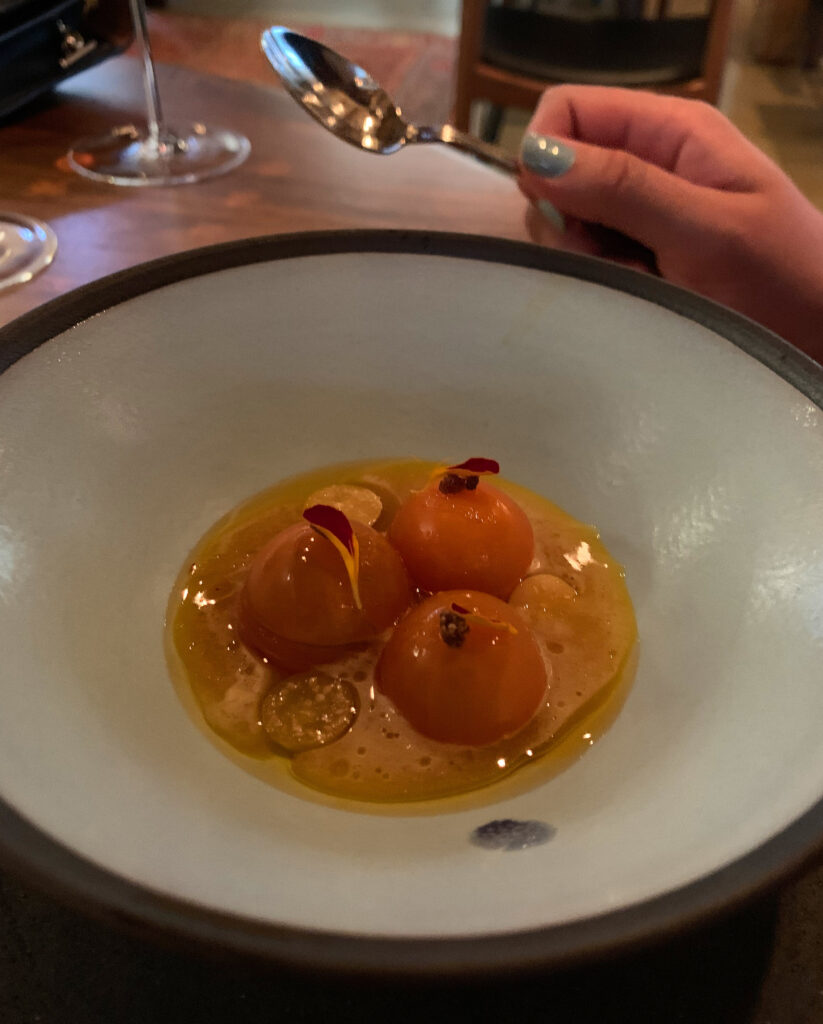
From September of 2021 through February of 2022, the star piece of produce has taken four distinct forms: “Sun Gold [sic] Tomato Sandwiches with Marigold & Peach Soup,” “Sun Gold [sic] Tomato Sandwiches with Habanada & Peach Soup,” “Sungold Tomato Sandwiches with a Pear & Apricot Soup,” and “Sungold Tomatoes, Passion Fruit Seeds & Habanada.” Given the degree to which these preparations relate to each other, you will cover each in turn.
The inaugural rendition of the dish comprised three large, plump Sungolds that had been cut in half and stacked back together at the center of a bowl. These “sandwiches” sat in a chilled peach soup with a few smaller slices of tomato and petals of marigold for company. Upon being popped into your mouth, the Sungolds display a crisp exterior that bursts to reveal a tender and juicy interior. (It is worth noting that the “sandwiching” of the ingredient, apart from allowing it to sop up some of the soup, ensures that it does not pop aggressively and shoot juices out of your mouth.) The tomatoes’ mouthfeel is enriched by the peach component, which shows a slight viscosity, and contrasted by the crispness of the marigold.
When it comes to flavor, the Sungolds possess a sweet, fruity, and borderline tropical character that retains a sense of freshness thanks to its mildly tart and tangy undercurrent. These notes meld nicely with the peach soup, which offers a refined expression of sweetness and vein of acidity that lengthens your perception of the tomatoes’ finish. The marigold petals, while a relatively minor component, add complicating bitter, peppery, and citrus notes that moderate the Sungolds’ fruit quality and express a bit more of its vegetal side. This helps bring the dish into balance without detracting at all from how decadently sweet the tomatoes are.
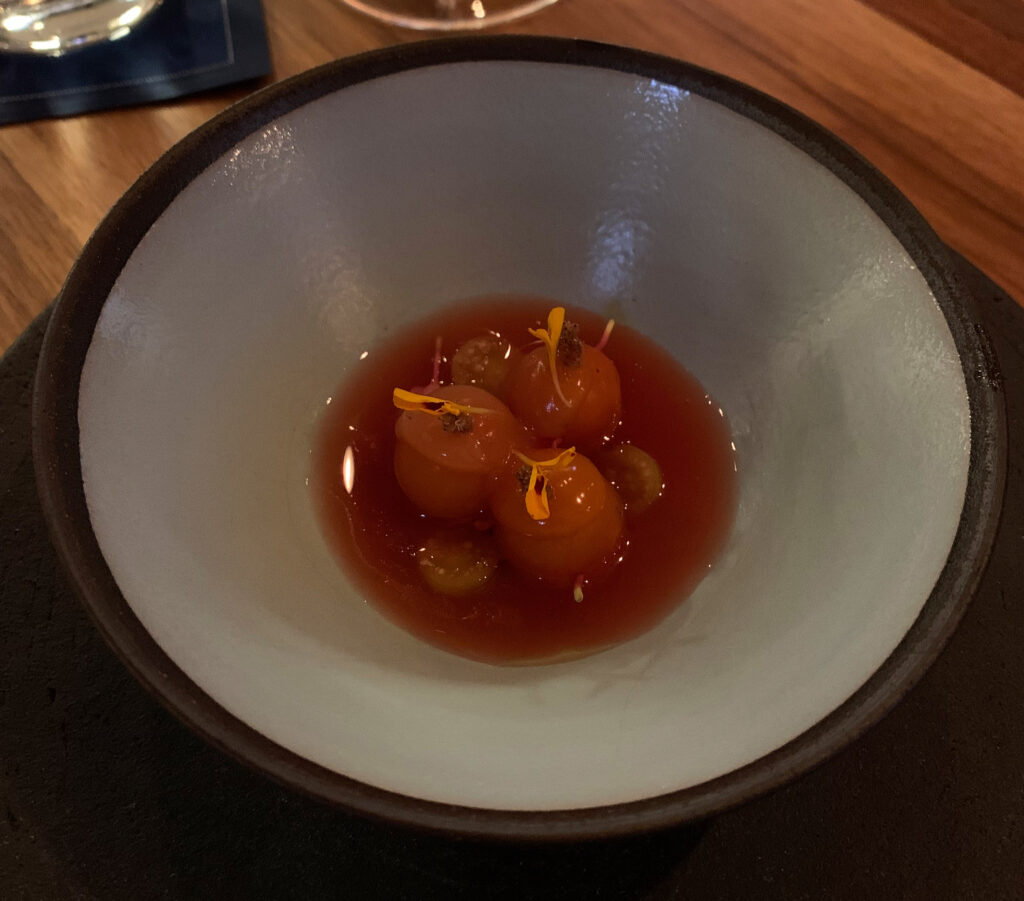
The next version of the dish—“Sun Gold Tomato Sandwiches with Habanada & Peach Soup”—looked very much the same. It comprised another trio of the star ingredient that, apart from being “sandwiched” in a similar fashion, now boasted an additional top layer. This segment, formed from yet another halved Sungold, offers an even more intricate mouthfeel as the many crisp exteriors and plump interiors bump and burst on the palate.
Otherwise, this rendition is really defined by the entrance of the Habanada into the equation. This heatless habanero pepper—bred by Michael Mazourek in collaboration with Cornell University—has been championed by Dan Barber of Blue Hill and has formed one of Smyth’s favorite ingredients over the past handful of years. Its sweet, melony character joins well with the ripe flavors of the Sungold and peach. However, it is the Habanada’s distinct florality that—almost in the same manner as the marigold—helps balance the outwardly fruity character of the tomato and emphasize a bit more of its vegetal side. You think this is a beautiful way of showcasing the pepper’s unique personality.
The “Sungold Tomato Sandwiches with a Pear & Apricot Soup,” meanwhile, represented another reconfiguration of the same form. Relative to the “Marigold & Peach” and “Habanada & Peach” versions of the dish, the flavor combination in this case is a bit more straightforward. While the pear offers ripe, fleshy flavors with a tinge of spice, the apricot offers a combination of sweetness and tartness that is somewhat reminiscent of the peach. Both fruits, in their soup form, envelop the Sungold and enhance its natural character. The components harmonize nicely to achieve a rounded flavor; however, the preparation lacks some of detail drawn from the contrasting elements used previously.
Ultimately, Shields and Feltz’s dish of “Sungold Tomatoes, Passion Fruit Seeds & Habanada” has represented the apogee of this particular form. Nonetheless, in coming to fruition, this preparation has shed some of its forerunners’ common structure. Gone completely are the “sandwiches” of plump tomato. Gone, too, is the soup. Instead, guests receive four halves of Sungold whose seed sides face up from the center of a bowl. The tomatoes’ seeds are draped with those drawn from the passion fruit, and the combination is topped with a slush made from the Habanada. This latter element, as it melts, coats the bottom of the preparation and also acts as a sauce. Meanwhile, there is a gelatinous element to the dish that reminds you of the locules utilized (later in the year) as part of the “Tomato & Blade Kelp Tartlet.”
Diving in, the Sungolds display the same firm-then-tender quality that has endeared them to you over the course of Smyth’s work. However, combined with the encompassing Habanada slush, the tomatoes feel even more as if they were embedded within a “soup.” As they unleash their juices and marry with the essence of the peppers, the passion fruit seeds offer a bit of crunch. Their sour character follows in the footsteps of the peach and apricot utilized in prior preparations—helping, along with the florality of the Habanada, to delineate the Sungolds’ intensity of sweetness. Yet the whole presentation is more streamlined and, thus, elegant.
The cold contrast of the slush, along with the outsize effect of the passion fruit seeds, fulfill (you think) what Shields and Feltz have long been aiming for. Bite by bite, each half of Sungold offers a cohesive flavor experience that begins with bursting sweetness, takes a detour through intense sourness, then closes with a full, lasting fruit character (with vegetal hints) that showcases the variety at its best. It is no surprise that this version of the dish—though still subject to the chefs’ perpetual tweaking—remained on the menu for nearly four months. It stands as a good example of how unexpected ingredients (like passion fruit seeds) and alternate forms (like the Habanada slush) can yield both a simpler and more satisfying preparation over the course of the kitchen’s experimentation.
In February of 2022, just as the Sungolds were set to fade from the menu, Smyth kicked off a new sequence that persists to this day. The items would be situated after the mussel-driven sequence and the kombucha/macaron/tartlet/”cannoli” sequence as they both, respectively, appeared. And they would mark the menu’s turn toward a more indulgent expression of shellfish after a range of relatively teasing opening bites.
Yet this new sequence started off innocuously enough with a single dish of “Warm Lobster Custard, Raspberry & Hazelnut.” Just reading that description, the connection to Shields and Feltz’s “Several Servings of Chilled Shellfish” becomes apparent: the chefs paired salted raspberries with their “Barely Cooked Lobster Claw” and utilized hazelnuts with both scallops and razor clams. However, while those bites were cold and provocative, the custard feels more like a warm hug.
The preparation arrives in a brown, square ramekin with subtle pockmarks and bends that suggest it was handmade. The color of the vessel does well to accentuate the tone of the custard, which shows a tannish quality submerged under the reddish-brown hue of the hazelnut and raspberry (rendered as an oil). Diving in with your spoon, the dish is easily portioned into four, five, or six bites. The custard displays just a bit of gelatinous structure on the palate before breaking apart and forming a cohesive bite with the swirling oils. The lobster’s flavor, relative to the “barely cooked” version of the crustacean’s claw, is less about pristine sweetness and more about deep, dark, mouth tingling umami. The ingredient shows a stunning degree of savory power—that you would liken to salty caramel—with added definition drawn from the earthy-sweet hazelnut and faintly sour raspberry. This dish reflects the kind of wonderful, full-throttle cooking that Smyth only occasionally aims for but accomplishes with aplomb.
The ”Warm Lobster Custard, Raspberry & Hazelnut” would, upon your next encounter with it, be renamed “Lobster Coral Custard.” (“Coral,” of course, refers to the reddish, pinkish roe of the female lobster that has long been used to enrich soups and sauces.) After that, the dish would become “Lobster Coral & Hazelnut Custard.” But, for all intents and purposes, the preparation has remained the same. The custard, even if it did not make use of the crustacean’s coral from the start, certainly tasted as though it did (as there are few other ways to cultivate such intensity of flavor). Further, the removal of the raspberry element and off-again, on-again use of the hazelnut only represent a bit of fine-tuning. For the rich essence of lobster has always been the star, and these accompanying notes (of which a bit of nuttiness was deemed to be most appropriate) only work to glorify it further. (Uni has even seen itself embedded within the custard on one occasion, offering an irony sensation that helps enhance and delineate the dish’s flavor all the more!)
The raspberry, after being excised from the previous dish, would instead find its home in an accompanying bite titled “Caramelized Lobster Claw” that, later, became “Lobster Claw & Raspberry Leather.” The former preparation reminds you even more of the “Barely Cooked Lobster Claw” from before, comprising a similar morsel of the crustacean’s meat that has been lightly glazed with a concentrated sauce made from the fruit. Nonetheless, this expression of the shellfish lacks the previous version’s firmness and sense of chew. Rather, the caramelization lends the lobster a soft, tender, and altogether luscious mouthfeel that guests will find more familiar. Dressed with the raspberry reduction, the claw offers balanced flavors that are sweet, savory, and a little tart on the finish.
Perhaps finding this bite to be a little too conventional (by their lofty standards at least), Shields and Feltz introduced a “raspberry leather” element in lieu of the glaze. This opaque strip is positioned directly over the claw and serves to partially obscure it. Upon reaching the palate, the leather displays a slight chew with impressive persistence of fruit flavor. This serves to moderate the richness of the caramelized lobster and make it feel fresher and tangier on the finish. That not only makes for a smooth transition into the next part of the sequence, but—especially with regard to the leather’s chew—achieves the same sensation as the ”Barely Cooked Lobster Claw” via a different route. How clever!
The third part of this sequence would double down on the use of fruit, comprising a “Lobster Consommé & Melon Ceviche” that, later, became a “Lobster Consommé & Berry Ceviche.” The dish arrives in a small bowl that is set within a bed of ice in an even larger bowl. This keeps the former vessel’s contents at an optimum temperature—understandably so once you realize that the preparation is made up of little more than broth, a dollop of whipped cream, and two dozen tiny flower petals.
Texturally, this dish does a marvelous job of accentuating that floral component. Floating in the consommé and encapsulated by the whipped cream, the petals—despite their usual delicacy—are particularly pronounced on the palate. With mastication, the flowers become shredded and further interlaced with the other components. While the consommé strikes the tongue quickly, the whipped cream element sticks around a bit longer. Thus, as you work your way through the dish, you are first hit with the essence of lobster. That then yields to the slightly acidic cream—flavored with round, honeyed melon or tart-sweet berries depending on the exact version—and, finally, the crisp-and-zesty flowers.
This preparation feels a bit like a palate cleanser relative to its partners in the lobster sequence. It also deals in an expression of the crustacean that is almost hard to detect compared to the other components. However, the consommé has no need to compete with the aforementioned custard, and the dish’s fruit tones extend the raspberry notes of the claw preparation while readying you for what comes next.
The sequence’s crowning touch comes by way of the “Lobster Tail Warmed with Almond Milk & Newly Pressed Walnut Oil” (later titled “Lobster Tail, Almond Milk & Newly Pressed Walnut Oil”) that highlights the most totemically luxurious portion of the crustacean. Structurally, the dish looks simple enough: bits of the shellfish, topped with slivers of green almond, cling to the side of a shallow bowl while a thin pool of liquid waits below. You pluck a piece of the tail with your fork, drag it through the combination of almond milk and walnut oil, then take a bite.
As it hits your tongue, the lobster displays a slight firmness—which, given the relatively small portion, serves to lengthen its impression—that quickly yields to a tender interior. The green almond, whenever it strikes your teeth, offers a halfhearted crunch that avoids detracting from the crustacean’s lusciousness. Instead, the combination of almond milk and walnut oil caresses the lobster with slick and slightly creamy textures that amp up the morsel’s perceived decadence. With regard to flavor, the tail displays mild sweetness alongside hints of caramelization drawn from its crust. While the green almond is faintly grassy and fruity, the almond milk is more pronouncedly nutty. Its sweetness joins with the purely rich and buttery walnut oil to form a dream pairing for the crustacean. This is the quintessential “lobster with drawn butter” taken to the extreme!
Ultimately, Smyth’s “Lobster Tail” has formed a neat bookend for the sequence. This dish and the opening “Lobster Coral & Hazelnut Custard” form intense and memorable preparations that serve to cushion the more thoughtful, nuanced “Lobster Claw & Raspberry Leather” and “Lobster Consommé & Melon/Berry Ceviche” that make up the middle. This structure ensures that guests’ palates are not overwhelmed, but, rather, that they can appreciate the peaks and valleys of hedonistic vs. intellectual pleasure. When, on one occasion, Goldsmith paired this four-part sequence with a 2010 Schäfer-Fröhlich Felseneck Spätlese (for the first two bites) and a 2014 Aubert “Ritchie” Chardonnay (for the latter two bites), the experience was one of both peak complexity and total bliss.
More recently, you have recently seen Smyth opt for a new, truncated version of this sequence that begins with the familiar “Lobster Coral & Hazelnut Custard” preparation and ends with a “Maine Uni & Lobster Ceviche” that has come to represent a new frontier for the old “Lobster Consommé & Melon/Berry Ceviche” preparation. The dish comprises a lobe of sea urchin that is brushed with red chile paste and sits atop some shredded pawpaw at the bottom of a shallow bowl. It is joined by the familiar lobster consommé and dollop of whipped cream (infused, in this case, with horseradish) while flower petals, once more, form a key finishing touch.
Diving in, the creamy mouthfeel of the uni ensures that the preparation feels more substantial than its forerunner—which, as you recall, amounted to little more than a mouthful of flower petals. The sea urchin, to that effect, melds with the whipped cream to coat the tongue and better weather the slight crispness of the floral component. The flavors, meanwhile, combine the sweet and savory tones of the lobster consommé with the deep-sea quality of the uni, the sharpness of the chile/horseradish, and the mango-banana character of the pawpaw. Though the whipped cream adds an appealing milkiness and bit of tang to the equation, some guests have found that the sea urchin’s level of “irony” flavor upsets the dish’s overall balance. Personally, the metallic quality that uni (sometimes) displays does not really bother you; however, you are not sure that the ingredient (nor the lobster) is used effectively here. You certainly appreciate the combination of sea urchin and pawpaw on paper, so it will be interesting to see where this dish goes.
(A more recent version of the preparation, it must be said, has offered a cleaner expression of uni with fewer accompanying flavors. Without the pawpaw, this dish shines with fresh seafood flavors that are further enlivened by the pungency of the horseradish whipped cream and red chile.)
Moving away from seafood for just a moment, Shields and Feltz have also—early on in the meal—offered worshipful expressions of produce in the traditional “Smyth” style. From June through September of 2022, that has taken the form of “Summer Squash, Chamomile & Togarashi Pepper,” a dish situated after the kombucha sequence and “Smoked Mussel Garden” but before the lobster sequence. In that respect, the preparation has acted as a kind of vegetal interlude that ensures the ties that bind the various expressions of shellfish do not work to obscure their unique characters. However, that does not mean that the gourd is given any less respect than its aquatic counterparts.
For this dish, the summer squash is sliced into twenty thin circles that are artfully fanned around the center of a bowl. This gorgeous spiral is partially submerged in a blend of oils: a green one made from the chamomile and an orange one made from the togarashi. Flower petals and a couple carefully placed microgreens complete the presentation, which you think stands as one of the restaurant’s most beautiful.
Both in texture and flavor, this dish is all about purity. Sliced so thinly, the squash displays a shocking delicacy on the palate. This feels worlds away from the heartier, crunchier faux “noodles” made from the produce. Rather, the slick, slightly firm, but ultimately yielding mouthfeel has more in common with the slivers of mussel and scallop that have previously been served. While the presence of the sizable flower petals makes for a contrasting crispness, the two oils work to moisten this element and soften it on the tongue. In terms of flavor, the summer squash displays pristinely grassy, sweet, and slightly nutty notes. The chamomile builds on those with mildly fruity, honeyed tones while the togarashi pepper (not the spice blend, mind you) echoes them with its own fresh, sweet character. The end result extends and intensifies the squash’s own flavor, elevating it to an uncommonly reverential degree. This is a classy preparation.
The next dish undoubtedly stands as one of the most totemic of Smyth’s 2021-2022 era. In fact, it has featured—in some form—on nearly every menu you have sampled during this period (save for only a few). You would even credit this course with wholly changing your perception of its star ingredient, one that has been reduced to something of a trope despite its prized status in Californian (and, subsequently, the national) cuisine. Of course, you speak of the avocado: the nutrient-dense fruit that has induced the mainstream American consumer to “pay extra for ‘guac” for several decades running.
Though you have always found the ingredient to be palatable, you also have long thought its rich texture and mild flavor demands a bit of help to shine. And it certainly startles you to see avocado enthusiasts dive in with nothing more than a spoon!
While Shields and Feltz do not quite serve the fruit plain, the chefs have done more to glorify its natural character than any other preparation you have encountered. They have served four distinct preparations of “Chilled Avocado” (later distinguished as a “Chilled California Avocado”) over the past couple years: one paired with “a Paste of Bangkok Guava & Hoja Santa”; another with “Pistachio Skin & Red Cedar Leche de Tigre”; a third with “Pistachio & Sea Lettuce”; and, most recently, one with “Verbena & Citrus Marigold.” Each rendition of the dish has roughly taken the same form, so you will cover them in tandem.
Early on, the avocado took a relatively naked form. The fruit was sliced, pitted, extricated from its skin, and one half of its flesh was placed face down at the center of a shallow bowl. This particular vessel was totally clear and, thus, revealed the lower bowl of ice on which it sat. The resulting effect helped accentuate the green hue of the avocado while, at the same time, disguising the guava and hoja santa elements that were rendered as a kind of slush located under the fruit.
However, near the end of 2021, Smyth debuted a new style of bowl with an opaque white center and an extended matte green rim. The preparation no longer demanded an additional vessel filled with ice, and the avocado’s color (an altogether darker tone that suggested a change in sourcing) could form an easy complement with the matching ceramic. Additionally, the ingredient—though positioned face down in the same way—now came garnished with flakes of salt, microgreens, larger leaves, and small flowers (in turn). It also shone with what seemed to be a lacquered or oiled finish. These textural and burnished elements would form a new, more intricate visual contrast over the course of the dish’s lifetime.
Structurally, nonetheless, the “Chilled California Avocado” has always been eaten in the same fashion. Guests are provided with two spoons—“one for offense and one for defense” as your server invariably jests—in Shields’s usual eccentric fashion. One of the sommeliers even makes a habit of switching the two identical utensils around as if he has “mistakenly” placed them on the wrong sides, a bit of wry tableside humor that you find highly amusing (especially when guests at neighboring tables truly believe the spoons were, in fact, different).
Functionally, the dual utensils allow you to break apart the avocado—which has subtly been segmented—without piercing or mushing its flesh. At the same time, you can also scoop up an ample amount of the accompanying slush to make a cohesive bite. The overall experience of the dish, in this manner, feels engagingly tactile. The lusciousness of the avocado gets transmitted through the handles of the spoons and primes your palate to savor the ingredient’s richness.
That sensation—the encompassing buttery, faintly grassy, and slightly nutty notes of the avocado—forms the foundation of the dish, but it also sneaks up on you. For, diving in, the slush component is bound to flow onto your tongue and melt. It may unleash the sweet flavors of guava accented by anisey hoja santa, the sourness of leche de tigre spiked with woodsy red cedar, the nuttiness of pistachio underlined by oceanic sea lettuce, or the zestful, peppery pairing of verbena and citrus marigold. Each of these exotic combinations tantalizes your palate—but only for a moment. The avocado sweeps in with a substantial, warming texture that saps whatever is left of the slush and starts to emit its own flavor.
In later versions of the dish, various toppings (the aforementioned flakes of salt, microgreens, larger leaves, and small flowers) add a bit of intrigue, yet the preparation really looks to celebrate the pure flavor of the avocado. The other elements merely function to set the stage for an intimate (double spooned) encounter with the ingredient, one where the character you might normally call “bland” is perfectly offset. For once, you want the avocado to linger on your palate. Its usual nutty sweetness—only ever faintly sensed—now resonates with an outsize power. This is the essence of avocado to the nth degree, framed in such a way that could make anyone a fan.
Personally, you found the original “Chilled Avocado, Paste of Bangkok Guava & Hoja Santa” preparation to be the most delicious due to the fruit component’s hedonistic appeal. However, subsequent renditions of the dish have naturally explored different dimensions of the avocado’s character via more intellectually appealing accompaniments (with elements like red cedar, sea lettuce, and citrus marigold forming rather bold natural flavors to draw on). Like all truly legendary Smyth dishes, the “Chilled California Avocado” offers a platform for endless experimentation. Paired with wines like Domaine Vacheron’s 2017 Sancerre “Le Pavé” or Domaine Laroche’s 2019 Chablis “Blanchots,” the preparation stands as one of the restaurant’s deepest and most rewarding engagements with a single ingredient.
While the aforementioned “Maine Uni & Lobster Ceviche” has left you wanting, Shields and Feltz have indeed made good use of sea urchin across their menus. Sometimes, that has embodied simple, elegant bites like a halved passion fruit stuffed with the orange roe—offering a tart, sweet, an oceanic delight.
But the ingredient has principally taken the form of a dish titled “Maine Uni Glazed in Egg Yolk, Preserved Citrus & Habanada Pepper” served throughout 2021. It was followed, in 2022, by “Maine Uni, Sea Lettuce & Habanada.” But it should be stated that this totemic luxury ingredient appears rather infrequently compared to items like the mussels, scallops, and lobster. Thus, for all of uni’s trendiness, it does not form a crutch. Rather, Smyth truly feels enthusiastic about serving it on each occasion because the quality of a particular tray is so high. (This usual lofty standard perhaps explains why the sea urchin’s irony quality in the ceviche preparation could be seen as jarring.)
Both “Maine Uni Glazed in Egg Yolk, Preserved Citrus & Habanada Pepper” and “Maine Uni, Sea Lettuce & Habanada” are constructed in the same fashion. The star ingredient—rendered as a rather generous serving of three large lobes—sits at the center of a shallow bowl. In most instances, the sea urchin shines with the lacquered coating of an egg yolk glaze. However, in all cases, the uni sits—partially submerged—in a dressing made from the Habanada. At times, this component has taken the form of an oil, making for a kaleidoscopic effect with the yellow of the yolk and the accompanying drops of preserved citrus. Later, the Habanada has formed more of a gelatin or slush that sits under the sea urchin and offers greater textural appeal. The sea lettuce, when present, takes a simple form: a solitary leaf placed atop the lobes as a garnish.
Diving in, both versions of Smyth’s uni and Habanada dish are undoubtedly defined by a seamless texture. The chefs do not draw on rice or pasta or funnel cake (to recall one notable flourish from years past) to cushion the sea urchin with something more substantial. Rather, the gonads—being suspended in liquid, gelatin, or slush—retain every bit of their delicacy. You must use the pressure of your tongue to smush the lobes against your mouth and appreciate the resulting creamy coating that glides across your palate. There, the richness of the egg yolk glaze and viscosity of the Habanada’s various forms accentuate the uni’s mouthfeel all the more.
As these slick and smooth textures swirl on the tongue, the sea urchin’s flavor strikes with total purity: unleashing a sweet, fresh sensation with a transfixing tinge of brine but no trace of iron. The Habanada, with a vibrant florality and its own undercurrent of sweetness, melds effortlessly with the uni’s character and augments its persistence. The preserved citrus and sea lettuce components, in turn, offer complementary tangy and oceanic notes. But, importantly, none of these accompaniments ever feel overwrought. They subtly build upon the sea urchin’s own personality and ensure that the ingredient, though sourced from Maine, offers the kind of refinement you associate with auction-grade trays from Hokkaido. Shields and Feltz know just what aspects of the coveted ingredient are worth emphasizing, and they are able to do so without recourse to the usual tropes. In this manner, the chefs demonstrate an understanding of uni that transcends any other preparation seen in Chicago.
Relative to the other examples of shellfish that have already prominently featured across Smyth’s menus from 2021-2022, spot prawn has only very rarely appeared. Considering the lofty status that shrimp can claim within the city’s culinary canon, that seems like a shame. But mussels and lobster have more than justified their pride of place—at least for now. And, nevertheless, May of 2021 saw Smyth serve a dish of “Spot Prawn with Spring Onion & Strawberry” that put the crustacean through the same paces as its taxonic brethren.
The preparation sees one whole, plump tail of the prawn take center stage at the middle of a plate. Its flesh displays a milky translucence with faint reddish ribbing that suggests the ingredient is served totally raw. The piece of shellfish sits in a pool of reddish broth with a small dollop of reddish slush—both made from strawberry. The spring onion is rendered as a few cylindrical shreds draped over the top while a lone pinkish flower petal floats to the side.
Diving in, you prick the prawn tail with your fork and cut it in two. The resulting piece gets dragged through the strawberry slush, tangles with one of the spring onion segments, and plops onto your palate. As it is chewed, the spot prawn displays a full, firm texture that offers some slight resistance but ultimately yields to a creamier, silkier consistency as it is masticated. The slush component, as seen in other preparations, buttresses the crustacean’s mouthfeel for a moment before quickly melting away. The allium component, likewise, offers only a slightly crisp sensation that coheres with the shrimp.
Yet the dish’s main draw undoubtedly comes from its flavor, as the fresh, sweet, and slightly briny spot prawn joins with the sweeter, mildly acidic strawberry and the vegetally sweet spring onion elements. The end result is harmonious but, perhaps, falls a bit short of being hedonistic. This bite, tantalizing as it is, lacks the layered depth that characterizes some of the restaurant’s other shellfish preparations. It would, instead, be more at home as part of the “Several Servings of Chilled Shellfish” sequence than as its own course. Thus, you think lobster has come to eclipse spot prawn in these kinds of Smyth preparations because it offers a slightly richer canvas with which to work. But you certainly savored seeing the shrimp being given a chance to shine.
Moving back to the vegetable kingdom, January of 2022 saw an interesting preparation of beet situated after the “Chilled California Avocado” but before a caviar course that, in its own right, formed one of Smyth’s definitive creations during this era (more on that later). Keeping pace with these bookending dishes, whose star ingredients naturally carry more mainstream appeal than the perpetually maligned taproot, presents a tall order. But the “Badger Flame Beet Aguachile” holds its own.
The preparation centers on a unique variety of the root vegetable that was first bred by the University of Wisconsin’s Irwin Goldman and later refined at Stone Barns. The Badger Flame, from its inception, was meant to offer a “visually striking beet.” However, Goldman also sought to refurbish the ingredient’s “dirty reputation” by breeding out the earthy flavor “that many blame for their beet aversion.” His work led to the development of a variant that boasts a “vibrant orange-yellow interior” with a “mild and sweet” flavor that is even “delicious raw.”
Of course, Shields and Feltz are fans, for the Badger Flame empowers the kind of pristine beet preparation that raises the ingredient to the same status as their menu’s many seafood indulgences. The chefs even drawn on the idea of aguachile—a classic Mexican dish of shrimp in “chile water”—for inspiration. Their preparation comprises one whole Badger Flame beet that has been skinned and sliced widthwise into about a dozen pieces. These segments sit in a shallow pool of the aguachile alongside a thickened beet paste. A scattering of yellow marigold petals, whose color matches the Badger Flame’s interior streaks, completes the presentation.
Approaching the dish, you prick one or two pieces of the beet, drag it through the accompanying paste and aguachile broth, then try to get a couple of the flower petals too. Owing to its unique breeding (and the recipe from which this preparation is inspired), the Badger Flame is served raw. The vegetable displays an attractive crispness on the palate without any kind of hearty “undercooked” crunch. Its mouthfeel is enriched by the accompanying beet paste and contrasted by the marigolds that, in this case, are numerous enough to make their presence felt. With regard to flavor, the Badger Flame’s hallmark mildness and sweetness form the foundation for more concentrated notes of beet sugar, tangy citrus, and a peppery florality. The aguachile, in truth, is not all that spicy. Yet the beet’s lack of earthy character ensures that the preparation, overall, feels bright and engaging without retreading the same ground as the preceding avocado dish’s “Red Cedar Leche de Tigre” slush.
At this point in the meal, you come across a preparation that—like the “Chilled Avocado”—has loomed large throughout Smyth’s 2021-2022 era. Actually, you would go so far as to say that this dish stands as a titan among all the endless compositions, throughout the world of fine dining, that make use of the same totemic luxury ingredient. But, high praise aside, the course took some time to come to full fruition.
Its inaugural version, “Kaluga Caviar Gently Warmed in Buckwheat Butter, Almond Milk & Newly Pressed Walnut Oil,” can be thought of as the forerunner to the “Lobster Tail Warmed with Almond Milk & Newly Pressed Walnut Oil” that would go on to headline the restaurant’s four-part lobster sequence. (Shields, of course, has long been obsessed with lactic sauces and obscure expressions of nuttiness, so these ingredients form somewhat of a longstanding grammar of flavor formation.) The dish comprises a healthy dollop of the sturgeon roe that flows down the side of a speckle patterned bowl like a rockfall. At the bottom rests a puddle of almond milk that looks particularly thick and cloudy (almost like milt) due to the surrounding coating of walnut oil. Some finely chopped green almonds—accompanied, on some occasions, by a whole nut—complete the presentation.
Diving in, the preparation is undoubtedly defined by Smyth’s choice in caviar: a Kaluga hybrid (that is, a crossbreed of the Huso dauricus with the Acipenser schrenckii or “Japanese sturgeon”) sourced from Regiis Ova and, later, The Caviar Company. The roe displays a dark green tone with golden accents. On the palate, its orbs offer a firm texture that yields to a delicate “pop,” releasing a refined nutty flavor with a buttery finish. Overall, this makes for a nice caviar that lands toward the top end of the vendors’ portfolios but offers some relative value when compared to the more uniformly brilliant (and doubly priced) Golden Osetra or Golden Kaluga Hybrid options.
This sense of value is important because the dish relies on a heaping portion of roe to really work. The caviar, which arrives “gently warmed in buckwheat butter,” essentially forms a canvas for the comparably fleeting flavors of the almond milk and walnut oil. These latter elements, to that point, are only able to assert themselves with repeat exposure. Thus, it is only by the third, fourth, and fifth spoonfuls of caviar that they really take hold—accentuating the roe’s nut and butter qualities (themselves intensified by the buckwheat) with concentrated sweet and nutty tones that make the orbs’ finish last forever. Paired—rather boldly by Goldsmith—with a pour of El Maestro Sierra’s “1830 de Anticuario” Amontillado, the dish’s flavor intensity reaches stratospheric heights.
Shields and Feltz, nonetheless, were not yet done. After serving this preparation for most of 2021, the chefs struck upon a flourish that—beginning in September of the same year—would take this experience of caviar over the top. Structurally, the dish would not really change. It would comprise a similar dollop of the roe, positioned in the same speckled bowl, with the same accompaniments. But “Hot & Cold Kaluga Caviar, Almond Milk & Newly Pressed Walnut Oil,” as the new composition would be called, represents more than the mere addition of an alluring temperature contrast. Rather, it introduces a surprising interactive element that totally transcends the kid gloves with which totemic luxury ingredients are typically treated.
Just moments after setting down a bowl that looks exactly like the dish’s previous iteration, your server returns with a small tray holding a one-ounce tin of caviar—emblazoned with Smyth’s logo—and a mother of pearl spoon. Guests are told, with a tip of the hat to Katy Perry, that this “Hot N Cold” preparation requires that they scoop the roe out of their individual container (which contains a “gently warmed” serving) and combine it with the cold dollop that sits in the bowl. When the server departs and leaves you to your task, the emotional effect cannot be overstated.
For caviar, you must say, ranks as the most emblematic of all luxury totemic ingredients, and you think its draw is largely misunderstood. The roe is fetishized to no end as a hyperreal symbol of extravagance—with the evil oligarch’s overflowing tin of “Beluga” and bottle of Cristal forming familiar tropes in a sinister superyacht setting. At some point, mainstream consumers are likely to encounter some inferior example of roe (sturgeon or otherwise) in a sushi, brunch, or steakhouse splurge setting. They are, on that first occasion, likely to be left wondering what all the fuss is about (even, or especially, if they celebrate their sense of refinement on social media). Just the same, those paying big bucks for three-Michelin-star dining may encounter a superlative example of caviar. Yet the small serving size, especially relative to an untrained palate, will likely leave little lasting impression—other than “ooh, fancy!”
To really understand a totemic luxury ingredient, you must thoughtfully sample it many times with some intention of capturing divergent quality levels and the different flavor and textural aspects that correspond to these divisions. Spoonful by spoonful, that can take quite some time when it comes to caviar—and just how many customers want to spend a luxurious meal taking mental notes about how this roe compared to that roe? Thus, as a corollary, you think it proves equally effective—when seeking to understand an ingredient—to submerge yourself in a singularly large portion and see how you feel when you come out the other end. Such an experience may not yield much breadth or depth of knowledge; however, it will shatter any effect the law of diminishing returns may impart. It will allow you to really grasp—perhaps by having a bit too much of something—what its appeal is really all about.
This latter effect is what “Hot & Cold Kaluga Caviar, Almond Milk & Newly Pressed Walnut Oil” achieves. The dish offers an intimate dance with sturgeon roe in which the customer can take the lead. Grasping the tin that accompanies the course lends you a real feeling of power: you may taste the warm, buckwheat buttered caviar straight from its vessel with no need to share, no ceremonial egg yolk and egg whites and chives to navigate. When you are ready, you shepherd its contents into the speckled bowl and watch the orbs twinkle as they take a dip in the almond milk. Bite by bite, you explore how the caviar’s character changes in line with different temperatures. You note how the same caviar, tasted “hot and cold” at the same time, exhibits a full spectrum of sweet and nutty flavors that need no accompaniment. And yet, the almond milk and walnut oil remain there to up the ante. These elements, being dwarfed by the roe, amount to little more than dressing, but, importantly, they enhance your perception of the caviar without ever obscuring it.
By the time the bowl finally sits empty, you want for nothing more. The restaurant has indulged you, on your own terms, and with an uncommon generosity. This overall effect reminds you somewhat of Thomas Keller’s “White Truffle Risotto”—in which a server returns partway through the course to shave another helping of the coveted ingredient into your bowl. Smyth operates with the same subtlety, the same quiet charm that allows you to be the first to think—to yourself—“wow, that’s a lot of caviar.” That is really the essence of luxury: subverting expectations by understatedly going far beyond the portion sizing even the most experienced diners have become accustomed to.
The ”Hot & Cold Caviar” would be served with few changes through June of 2022. The chefs briefly toyed with adding a “Savory Fried Donut” to the preparation, but this was shelved (and eventually became part of a different sequence). Shields and Feltz would also come to add other gelatinous and custardy dollops to the bowl that, beyond underscoring the same sweet and nutty notes, offered a thicker, creamier mouthfeel to go along with the roe. On some occasions, the accompanying tin would be omitted and the dish would look more like its first iteration. The caviar—or the ingredient cost it represented—would be stuck somewhere else on the menu, but the “Hot & Cold” would later come back and strike with renewed power.
Goldsmith, too, would substitute his precious Amontillado (of which only 75 magnums were produced) for other Sherries as time went on. Ultimately, you can see this pairing as having been challenging for some diners. At face value, it would seem to detract from the feeling of decadence that is preparation so effectively constructs. However, there is no doubt that the Sherries measure up to the caviar’s intense nuttiness and reveal a dimension to the ingredient that is relatively unheard of. The pairing also represents a bit of a conceit—that Shields and Feltz are not going to ply guests with roe without making them think a little bit. Nonetheless, just as you control the contents of your individual tin, you also decide how much of the Sherry you want to drink. The “Hot & Cold Caviar” preparation, at a conceptual and emotional level, is simply genius.
Moving on, Smyth’s caviar course was—in May of 2021—followed by a dish of “Spring Asparagus with a Salad of Spruce, Shoots, & Bee Pollen.” This preparation would only appear once; however, considering that this particular menu kicked off with the “Vase of Green Asparagus with Oyster,” it reflects the kind of synergetic use of ingredients across the menu that the restaurant is known for.
The preparation comprises small segments of asparagus that are hidden under a frothed cream flavored with spruce and charged with nitrogen via an iSi siphon. This latter component, despite being so airy, retains enough structure to hold up the various leaves and flowers that makes up the salad’s “shoots.” Thus, as your fork strikes one of the asparagus stalks below, it easily carries a cohesive bite back with it. The vegetable’s crunch is contrasted by the smooth, enveloping texture of the spruce cream that, in turn, yields to the faint snap of the various shoots. The flavor composition combines the sweetness of the asparagus with the citric, herbal quality of the spruce and the woodsy, floral shoots. A tinge of honeyed flavor from the bee pollen—dusted over the top of the salad—completes the effect. This dish, despite its seeming size, makes for an ebullient expression of spring.
Shields and Feltz’s next course—served, in some form, throughout the entirety of the 2021-2022 era—joins the “Chilled California Avocado” and “Hot & Cold Caviar” as one of the restaurant’s most emblematic preparations. In truth, this dish has been subject to more tinkering than any of the chefs’ other creations during this period. It also features one of the most classic of all totemic luxury ingredients—and one whose controversial cultivation methods have brought it to the brink of outright prohibition in the nation’s gastronomic capital.
Of course, you speak of foie gras. The duck (in this case) liver has featured in no less than seven distinct preparations that, nonetheless, share a common thread. First, there was “Steamed Foie Gras in a Broth of Guinea Hen & Wasabi Leaf.” That was followed by “Foie Gras Swimming in a Broth of Guinea Hen, Wasabi Leaf & Seaweeds” and, later, a preparation “Swimming in a Broth of Guinea Hen, Baby Ginger & Seaweeds.” Eventually, that dish became “Foie Gras, Yeast & a Broth of Toasted Grains”—which, itself, became “Foie Gras, Barley & Burdock Root.” Finally, the foie gras was paired with “Eel & Blade Kombu” and, subsequently, “Avocado & Blade Kelp.”
Each of these compositions centers on a lobe of the duck liver that has been poached (or “steamed” in the very first instance) then sliced into a neat, curved slab. This manner of preparing the foie gras, whose surface—if you look closely—displays a threaded brushstroke pattern, achieves a smooth, homogenous texture that reliably surpasses conventional pan searing methods. (Of course, it took a bit of time for the chefs to get there, as early examples of the dish could still show a bit of stringiness.) The liver, thanks to the poaching, breaks apart cleanly into custardy chunks. These pieces glide across the palate, melt, and impart a rich, fatty mouthfeel married with a pristine, lasting flavor of duck offal.
From this foundation of foie gras, the kitchen has then constructed a striking visual effect. That begins, in most instances, with Robert Dugrenier’s handmade glass bowls. These vessels possess a deep center with a wide, rustically misshapen rim dotted with off-white and brownish-green accents that display the same organic drooping pattern as many of the restaurant’s oil-infused sauces. The duck liver sits in the center of the bowl, where it “swims” in a broth made of guinea hen, toasted grains, or barley. The foie gras is laced with what looks like caramel, onto which are stuck an assortment of kombu chips. These jagged pieces lend the liver some sense of having “scales” (perhaps completing the illusion that the ingredient is “swimming”) or, alternatively, help it match the look of the blade kombu (which, itself, boasts an array of “teeth”). However fancifully you choose to view them, the color tones of the foie gras and seaweed match those of the bowl and make for a beautiful, naturalistic tableau.
With regard to texture, the dish—in its various forms—is defined by the smooth liver’s interplay with its warm broth and accompanying greens. Elements like the wasabi leaf, blade kelp, and other assorted seaweeds soak in the bowl’s liquid and take on a juicy quality that melds seamlessly into the foie gras. In contrast, ingredients like the baby ginger and burdock root offer a bit more crunch that is, nonetheless, still partially dampened by the presence of the broth. Even the kombu chips are relatively crumbly and avoid causing too pronounced of an effect once they reach the palate. Thus, the rich, custardy mouthfeel of the foie gras is well preserved and only given a bit of added definition via its wet, leafy, and faintly crunchy accompaniments.
Meanwhile, versions of the dish like the “Foie Gras, Barbecued Eel & Blade Kombu” and “Foie Gras, Barbecued Avocado & Blade Kelp” take things just one step further. They pair the duck liver with the kind of substantial texture that can measure up to its own mouthfeel. In the case of the eel—an ingredient, you will later see, that Shields and Feltz have worked extensively with throughout most of 2021-2022—the accompanying sensation is fleshy, a bit flaky, but ultimately soft and soothingly meaty. In the case of the avocado—an ingredient you have already covered in some detail—barbecuing the fruit serves to soften its structure and augment its smoothness. Both the eel and avocado, which appeared later in the preparation’s lifetime, really helped the dish achieve a higher degree of decadence without detracting from the star item.
When it comes to flavor, you must admit that “Foie Gras Swimming in a Broth of Guinea Hen,” in its various guises, formed the most challenging dish of the 2021-2022 era. While the textures of liver, liquid, greens, and ginger harmonize well, the resulting rich mouthfeel demands a pronounced expression of flavor to match it. The guinea hen broth, in that role, offers a fairly intense essence of poultry. That works well enough. The wasabi leaf, when present, provides some sharpness—just as the baby ginger does in turn. Yet you find in the seaweed element an expression of umami that is so deep as to seem a little dirty in a funky or mushroomy way. The kombu—with the guinea hen as a base layer of savory flavor—emphasizes the purely meaty, “livery” side of the foie gras and does so with a staggering depth. It is really quite a brilliant combination when you think about it.
For Shields and Feltz, when working with foie gras, in no way resort to the usual bag of tricks: all manner of fruit- and wine-based sauces that achieve an exquisite (though hackneyed) degree of hedonism. (Oriole, to its credit has found an engaging way to package this sensation, and it stands steadfastly as one of your favorite bites in Chicago.) Rather, the chefs have crafted a preparation that eschews traditional notions of decadence in favor of flavors that speak resolutely to the foie gras’s own character and little more. That, in essence, means taking duck liver down from its pedestal and seeing what it has to offer as itself. It is worshipful cooking that reveals how deeply ingrained certain culinary tropes, vis-à-vis totemic luxury ingredients, really are.
But, in practice, the flavors of those “Broth of Guinea Hen” iterations left you only with an intellectual thrill. They were, at times, jarring and complicated even further by a pairing that doubled down on the dish’s boldness. Goldsmith chose to pair a 2005 Terada Honke “Kaikoshu” nama (unpasteurized) aged (15 years) sake with the preparation, a bottle whose cocoa, coffee, and toffee notes only underscored those darker umami tones you found overwhelming. The overall sensation, situated before any particularly substantial courses, could be a bit shocking to the stomach. But the pairing is undoubtedly smart and really takes the chefs’ flavor composition to its peak.
Nonetheless, Smyth’s “Foie Gras” preparation began to change in 2022. Iterations like “Foie Gras, Yeast & a Broth of Toasted Grains” and “Foie Gras, Barley & Burdock Root” have come to the fore and shifted the balance of flavor toward the more approachable side. In the case of the former dish, the seaweed element is altogether excised, and its umami tones are replaced by the estery (or faint fruity bubblegum) character of the yeast and the earthy, caramelized notes of the toasted grain broth. In the case of the latter dish, the seaweed remains but is subsumed by the earthy, slightly sweet burdock root and nutty barley components. Both these preparations turn away from the concentrated savory expression of the earlier versions, packaging the same superb textural experience with brighter, more multifaceted flavors that carry a broader appeal.
Appearing even later in 2022, the “Foie Gras, Barbecued Eel & Blade Kombu” and “Foie Gras, Barbecued Avocado & Blade Kelp” iterations of the dish more closely replicated the original “Broth of Guinea Hen” versions. However, just as these barbecued elements help the preparations achieve a higher degree of textural decadence, they also impart more pleasing flavors. In the case of the former, the eel offers a dense kind of sweetness that matches the duck liver’s intensity and moderates the pure umami of the blade kombu. In the case of the latter, the avocado displays a smoky, fruity, enveloping quality whose persistence also helps to balance the seaweed’s deep savory tones. Both of these barbecued elements—like the yeast, toasted grains, barley, and burdock root—demonstrate how the kitchen has advanced its understanding of the dish over time. These ingredients—which, on one occasion, even included shaved black truffle—have augmented the preparation’s deliciousness while preserving the nuances of the duck liver/seaweed pairing.
Nonetheless, as is bound to happen, Shields and Feltz have eventually tired of this longstanding construction and extricated the foie gras from Dugrenier’s fanciful bowls. The chefs have ensconced the duck liver under white foam as part of a new course that has taken two forms: “Koji Porridge, Foie Gras & White Asparagus” and, later, “Rice Koji Porridge, Foie Gras & Toasted Hay.”
Both of these dishes have traded away the pristine slabs of duck liver, whose smooth, homogenous texture totally defined the ingredient’s prior preparations. Instead, the fat of the foie gras is fully incorporated among the grains of broken Carolina Gold rice that make up the porridge. At first blush, this seems like an aberration—altogether denying the luxury item a chance to express its own texture. However, unless you are enjoying it with an exquisite Sauternes, you do not really demand that foie gras—as a well-defined lobe—take center stage when its richness can be further processed or incorporated in some streamlined fashion. The ”Rice Koji Porridge” proves how effective such a strategy can be.
Diving in, the porridge displays a creamy texture through which the individual, heterogenous grains of rice can still be sensed. (Broken rice—also known as “middlins”—is, essentially, a waste product cultivated from fragments of grains “broken in the field, during drying, during transport, or during milling.”) Nonetheless, they are smooth, just a little crisp, and blanketed by a rich, fatty coating drawn from the foie gras. The aforementioned foam component—made alternatively from the white asparagus or the toasted hay—offers yet one more encapsulating, ethereal texture. Thus, the sum effect feels something like a grain of rice surrounded by three different swirling, fleeting mouthfeels.
Once this delicate confluence fades, the flavor moves in. The sweet notes of the koji (a mold that inoculates and saccharifies rice for fermentation) help to moderate the savory character of the foie gras and emphasize a clean, buttery, and only faintly meaty quality. The foam, meanwhile, provides a touch of bittersweetness (in the case of the white asparagus) or of roasted, grassy notes (in the case of the toasted hay). These components marry harmoniously and make for a soothing dish of both intrigue and pleasure. Even though the foie gras—when compared to its headlining appearances earlier in 2021-2022—takes a relative backseat in these preparations, you find the ingredient shines more brightly as part of a supporting cast. That is to take nothing away from the texture Smyth achieved with its poaching method, for the instances when it was joined by eel or avocado were also sublime!
Before the emergence of Smyth’s dedicated “lobster sequence,” the crustacean featured more conventionally throughout 2021 and early 2022 as one of several dishes situated before the meal’s main course. Sometimes, the ingredient would appear right on the back of the caviar preparation, representing a further descent into the delicious treasures of the sea. On other occasions, it would follow the foie gras and offer some more substantial respite from the liver’s fleeting texture and savory intensity. Eventually, Shields and Feltz would come to position eel (more on that later) directly before the menu’s principal serving of meat, so lobster formed something of a half step between the lighter and heaviest expressions of seafood. However, no matter where it was placed in the overall flow of the evening, this crustacean attested to the kitchen’s mastery.
For much of 2021, the “Barely Cooked Lobster Claw Seasoned with Salted Raspberries” would appear as part of the “Several Servings of Chilled Shellfish” that started the meal. The ingredient would not appear again until later on when, situated closer to the meat course, the kitchen would serve a “Maine Lobster Tail Cooked Over the Embers with Honey & Barley Butter, Seasoned with Pine & Bee Pollens.” Relative to the daintier “Lobster Tail, Almond Milk & Newly Pressed Walnut Oil” item that would later feature in the restaurant’s four-part sequence, this sizable dish spoke more to the crustacean’s classic sense of decadence.
The preparation centers on a half lobster tail that has been sliced into five magnificent morsels. Each piece comes coated in a creamy froth of the honey and barely butter—some of which is liquified at the bottom of the plate—and topped with a piece of dried pine pollen (that, in effect, looks like a chunk of baby pinecone). The bee pollen, meanwhile, takes more of a granular form that hides within the layer of butter. Diving in, the crustacean displays a slight crispness to its exterior on account of the ember cooking. Nonetheless, this crust forms a key, contrasting buffer between the lusciousness of the butter coating and the softly chewy then tender flesh of the lobster. As these smooth textures persist in the mouth, your sense of the crisp exterior fades and elements like the pollen (and, in one later instance, marigold petals) can assert themselves on the palate.
When it comes to flavor, the bitter tinge of the lobster’s crust quickly yields to the richly sweet notes that have secured the tail’s totemic luxury status. The flavors of honey and nutty barley drawn from the butter work to intensify the crustacean’s character and up the dish’s perceived decadence. The bee pollen, likewise, offers another burst of sweetness but also possesses a complicating hint of florality the relieves some of the richness. This is even more true of the pine pollen, which has a unique yeasty or cheesy character that adds to the preparation’s savory power while distinguishing itself enough to keep things interesting. Meanwhile, the marigold petals—when present—provide peppery and citrusy notes that also help cleanse the palate between bites.
Ultimately, “Maine Lobster Tail Cooked Over the Embers” stands as one of Smyth’s most straightforwardly pleasing and hedonistic dishes of the 2021-2022 period. It demonstrates just how effectively the kitchen can regale guests when working with a construction that is a bit more conventional. Yet, at the same time, the dish speaks clearly to the chefs’ distinct style of cooking and some of their favorite ingredients. You certainly miss this preparation but cannot deny that the subsequent “lobster sequence” would prove a more effective vehicle for staging varied, intricate, and creatively satisfying expressions of the crustacean.
Nonetheless, before that sequence would take shape, Smyth toyed with yet another preparation during the first few months of 2022. “Lobster Tail Gently Warmed with Fall Raspberries & Cream,” as it would be called, spoke to some of the kitchen’s favorite ingredients: the raspberries that have been paired with the crustacean’s claw from the very beginning and the lactic element that has appeared via almond milk in various seafood dishes. Despite this sense of familiarity, the composition achieved a sensation more like the previous “Cooked Over the Embers” iteration than the lighter fare in which those elements appeared.
The preparation comprises a slightly smaller portion of the tail—more like two or three large chunks—that is set within a shallow bowl and obscured by a light and bubbly froth made of the cream. (This kind of both is termed a “nage” in reference to the à la nage—“in the swim”—style of combined steaming and poaching in what later becomes the seafood’s sauce.) The raspberry element is rendered as an oil that is set within what looks like clarified butter. On occasion, caviar even joins the party—once appearing as a relatively minor garnish and, later, forming a rather large dollop on top of the shellfish. When you tuck into the dish, the lobster displays the same slight chew and succulence as the previous dish while also displaying greater fullness thanks to each morsel’s larger size. It lacks the slight crust drawn from the embers, yet the cream—relative to the honey and barely butter—offers an intricate and engaging fizzy sensation. The oils at the bottom of the bowl imbue the crustacean’s mouthfeel with a pleasantly slick finish. Meanwhile, the caviar, when present, contrasts all these smooth textures with a subtle pop of roe.
When it comes to flavor, the lobster is as rich and subtly sweet as before. The cream, despite its ethereal texture, provides a surprising intensity of nutty (and also faintly sweet) notes that amplify the crustacean’s character. While the caviar, when utilized, gilds the lily with the same kind of sensation, it is the raspberry element that proves most consequential. The oil made from the fruit offers yet another layer of sweetness; however, it also possesses a vein of tartness that shoots through all the decadent flavors. The resulting tang is what allows you to come back for bite after bite until the bowl is empty. Even though you slightly preferred the “Cooked Over the Embers” preparation, the “Lobster Tail Gently Warmed with Fall Raspberries & Cream” affirms just how delicious Smyth’s work with the ingredient was—as the star of a larger plate—before later developing the aforementioned sequence.
Relative to seafood like mussels and lobster, crab—in its various forms—has featured a bit less frequently throughout 2021-2022. (Smyth, for what it’s worth, can count the ingredient as a key element in some of the restaurant’s classic preparations from years past.) Perhaps such a decision suggests that the clawed crustacean’s surging pricing has hit a point of diminishing returns (relative to its proportional impact on food costs). Maybe the kitchen, faced with such a reality (or possibly in a totally unrelated manner), has simply sought to work with new, exciting products that break with the past and transcend totemic visions of luxury. Whatever the rationale, crab has unquestionably appeared as more of an occasional treat—yet one that carries an outsize impact.
Of the crustacean’s appearances during this period, some have seemed rather familiar. The “King Crab Leg with an Egg Yolk Emulsion and Vinaigrette” (later simply titled “King Crab Leg with a Vinaigrette”) coyly revived the old “King Crab in Beeswax” construction that you used to enjoy so much. Guests receive a pristine segment of the crustacean’s leg that comes encased in a faux “shell” made from the aforementioned wax. After you apply just a bit of pressure, the crab’s housing shatters and the meat can be cleanly extracted as one entire morsel. You dip the flesh in an accompanying bowl filled with vinaigrette, flower petals, and—on occasion—the egg yolk emulsion then take a bite. The crab, when it reaches the palate, is plump, sweet, and expertly enlivened by its sauce. Though the emulsion, when present, ups the perceived lusciousness of the bite, the tang of the vinaigrette provides the essential contrast and definition that allows the dish’s star ingredient, despite being served so simply, to really shine.
Another dish, “King Crab Gently Warmed with Fall Raspberries & Cream,” is quite familiar too. Appearing throughout the latter part of 2021, this preparation represents the forerunner of the “Lobster Tail Gently Warmed with Fall Raspberries & Cream” that would feature so prominently in 2022. Visually, the crab rendition looks every bit the same. Morsels of the crustacean meld with an oil made of the raspberries while being obscured under an “à la nage” style sauce/foam. Flower petals, on occasion, complete the presentation, but the effect they have is minor. Rather, the crab—relative to the lobster—displays a finer, flakier texture with far less chew. This allows the crustacean to more effectively sop up the frothed cream and raspberry oil, making for successive bites that grow ever greater in sweet, tangy intensity. The sum effect is more pronounced, if a bit less rich and lasting than that of the lobster. Between the two versions, it is hard to pick a favorite!
After disappearing for almost the entirety of 2022, crab returned to Smyth’s menu in October—though the crustacean did so without its crown. Yes, now that the Dungeness has replaced the king as the kitchen’s crab of choice, perhaps it can be surmised that difficulties with ingredient sourcing and subsequent pricing are to blame. But, even if the former variety—sourced from the western Pacific—lacks the totemic luxury appeal of its Alaskan counterpart, Shields and Feltz have not been deterred. They have brought the crustacean back into the fold with a set of preparations, one familiar and one totally novel, that transcend customary notions of the ingredient’s “status.”
The Dungeness crab, that favorite of West Coast home cooks, has seen itself introduced in the same manner as the caviar and lobster tail dishes that have come before. The ingredient is, through the prism of Smyth’s common grammar, elevated alongside these coveted items in a fashion that seems tailormade for its kingly predecessor. But the dish of “Dungeness Crab, Almond Milk & Newly Pressed Walnut Oil” does, indeed, place its headlining crustacean in that favorite setup. The flesh of the shellfish—rendered as a mound of tiny shreds—climbs up the side of a speckled bowl. At the bottom lies a pool of the almond milk set within shining, flowing reservoirs of the walnut oil while, over the top of the crab, sit the familiar segments of green almond.
Diving in, this iteration of the dish is principally defined by just how small those shreds of the Dungeness actually are. Texturally, the crab’s flesh lands somewhere between the small orbs of the caviar and the chewier chunks of the lobster tail. The mound of Dungeness meat shows a flaky, finely woven character that helps it soak up the mixture of almond milk and walnut oil. When the crab hits your tongue, this liquid flows out from the grooves of the tangle of flesh and makes for a moist, tender, and flavor-packed sensation. The resulting notes are not unlike the sweet and nutty tones shown in this preparation’s previous examples. However, the crab’s intricate, yielding texture allows the flavors of the almond milk and walnut oil to build with each bite. There is no relieving “pop” of roe or chew of lobster—only gushing, buttery extravagance that fills the mouth then suddenly fades. You think, discounting the emotional and interactive element of the “Hot & Cold Kaluga Caviar,” that this is the most hedonistic example of this particular presentation to date.
While pairing Dungeness crab with “Almond Milk & Newly Pressed Walnut Oil” seems a bit old hat, the crustacean has recently come to feature in a novel dish that stands as one of Shields and Feltz’s best creations of the year. In truth, the preparation is actually situated after the “Chilled California Avocado” and before the course you just described. But it came onto the menu later and connects, rather poignantly, with another dish served after the almond milk and walnut oil composition. So, here you will place it while also looking to illuminate how it functions sequentially.
The dish of “Squash Amazake, Dungeness Crab & Cured Egg Yolk” takes the form of a small, white cup. Shreds of the crustacean’s flesh—many times larger than those which featured in the previous preparation—rise from the bottom of the vessel. The morsels are glazed with the egg yolk and awash with the amazake, a lightly fermented broth (also likened to a yogurt beverage) made from rice inoculated with kōji and then fermented. The squash, in some manner, has been totally incorporated into the liquid and lends it a telltale orange hue. The sum effect, peering into the bottom of the cup, is of crab segments swimming in a luscious gold coating.
Texturally, the larger shreds of Dungeness display more weight and persistence on the palate than the tiny pieces of meat utilized before. The cured egg yolk offers the crustacean a rich, creamy coating while the amazake ensures that each spoonful is pleasantly juicy. However, the crab impresses most with a gentle flake that fans out on the tongue and imparts a satisfying mouthfeel. When it comes to flavor, the sweet and nutty character of the Dungeness finds a fitting partner in the intensely savory egg yolk. Nonetheless, it is the amazake that proves key.
The fermented rice broth brings enliveningly sour notes to the equation with a deep current of sweet and nutty flavor drawn from the squash. These components meld effortlessly with the Dungeness crab, richly accentuating its own character while doing just enough to revitalize the palate between bites. Though not a custard per se, this dish echoes the same immense, lip-smacking concentration as the “Lobster Coral & Hazelnut Custard” while effectively integrating seasonal produce. It has formed a unique and delightful showcase for the Dungeness crab that sets the stage for the more pure, delicate expression of the ingredient (with “Almond Milk & Newly Pressed Walnut Oil”) that follows.
However, given that you have already covered the “Dungeness Crab, Almond Milk & Newly Pressed Walnut Oil” preparation, you will leapfrog it. Following that course—and, when it appears, the “Rice Koji Porridge”—comes another iteration of squash. However, this most recent creation does not only further glorify the gourd, it actually represents the next chapter of Smyth’s caviar usage after the retirement of the “Hot & Cold” composition.
The dish of “Fall Squash, Wild Rice Beurre Blanc & Kaluga Caviar” comprises a circular segment of the fruit that has been lightly charred and set within the center of a bowl. The inner cavity of the gourd holds a healthy dollop of the sturgeon roe. Surrounding it are numerous, carefully placed pepitas and a pool of the beurre blanc. That latter element, in the usual manner, is interlaced with blobs of oil. Yet, in this case, they are spaced in a more consistent, artful manner. Texturally, the squash displays a firm, dense exterior (drawn in part from its charred crust) that ultimately yields to a moist and creamy interior. The Kaluga’s pop asserts itself upon this canvas while the pepitas offer a subtle crunch. The beurre blanc and oil elements, meanwhile, wrap the elements in a slick coating that helps them cohere on the tongue.
With regard to flavor, this dish has gone through some growing pains. The earliest rendition, despite seeming delectable at first glance, saw itself dominated by an intense nuttiness that—when combined with the gourd’s kiss of char—seemed to mute the other elements. Nonetheless, by the second time you encountered the preparation, the kitchen had achieved a greater harmony. Those nutty notes, at present, are better integrated into the richly sweet squash. The beurre blanc is not only luxurious, but vibrantly acidic and a bit earthy (thanks to the wild rice). Thus, as the Kaluga comes to the fore, the roe’s own nutty, briny, and buttery tones form a beautiful resonance with the other ingredients. Paired, as Goldsmith does, with a pour of Nicolas Joly’s 2017 “Clos de la Coulée de Serrant” Savennières, the dish reveals a depth of smoky, honeyed, and salty flavors that meld with the squash and delineate the caviar beautifully. This makes for a memorable preparation in which the totemic Kaluga, rather than hogging the spotlight, actually works to glorify seasonal produce.
As you inch your way ever further toward the meal’s main savory event, it is time to engage more deeply with one of the most distinctive ingredients Shields and Feltz have utilized throughout 2021-2022. You have already noted unagi’s appearance as part of the “Foie Gras, Barbecued Eel & Blade Kombu” variant of the restaurant’s longstanding duck liver preparation. But this freshwater American eel, sourced from Maine, has headlined no less than half a dozen dishes from July of 2021 through March of 2022.
The first of these, “Barbecued Unagi, Plum & Turnip Juice,” would form the prototype for many of the others. It comprises a rectangular morsel of the eel’s flesh that, owing to its manner of preparation, displays a craggy, charred crust. The unagi is topped with a piece of chewy plum and sits at the edge of a small pool of juice drawn from Scarlet turnips. A bit of unidentified oil serves as a glaze while, in the familiar fashion, also circumscribing the liquid at the bottom of the bowl.
Texturally, the freshwater eel has consistently impressed across each of its preparations. Its meat—after crunching through the charred exterior—is soft, gently flaky, and—most importantly—porous. This ensures that the unagi easily soaks up any accompanying sauce and, thus, displays a wonderful juiciness as you savor its flesh. The presence of the chewy plum, of course, helps elongate this effect. But the eel’s own mouthfeel is totally singular, occupying an interesting textural territory that seems closer to a leaner cut of chicken or pork than an oily fillet of fish. This ensures that, after multiple teasing courses featuring smaller portions of various crustaceans and bivalves, the unagi strikes you with an impressive feeling of sustenance.
When it comes to flavor, the eel’s own tinge of sweetness is enlivened by the more richly sweet, slightly sour plum and the earthy-sweet Scarlet turnip juice. The resulting combination is not quite as cloying as the classic unagi (or nitsume) sauce, but it touches on some of the same darkly sugary and tangy notes. At the same time, the kitchen’s light touch ensures that the eel’s own subtly fishy character shines through.
In October of 2021, a variant of the dish titled “Barbecued Unagi, Concord Grape & Turnip Juice” came into the picture. It took largely the same form as before, substituting the plum component for the equally sweet—yet perhaps a bit more tart—grape. In November of 2021, “Barbecued Unagi & Hibiscus” came to be. Apart from the addition of a visual flourish drawn from the plant’s leaves, the dish’s composition remained faithful to the original—this time leaning on the tart, earthy, and cranberry-like character of the hibiscus to accentuate the eel.
Nonetheless, this particular preparation would take its final form later in November of that year with the introduction of “Barbecued Unagi, Lardo & Togarashi.” In this iteration, the freshwater eel sees itself draped with a thin, translucent, and nearly invisible slice of the cured fatback. The togarashi pepper, meanwhile, takes the form of a greenish sauce at the center of the bowl. (You also note an unidentified, milkier liquid placed alongside it.) Texturally, the lardo lends the unagi an added layer of fat that—being so thin—effortlessly melts on the palate and amps up the preparation’s richness. Meanwhile, the togarashi offers a mild vegetal character and hint of sweetness that delicately underscores the unagi’s character. This makes for a decidedly purer expression of the eel that—without the overt sweetness of the former fruit components—still achieves a nuanced and enjoyably savory flavor.
You are tempted to say that Smyth’s substitution of the plum and concord grape components for hibiscus and togarashi amounts to “taking off the training wheels,” for few Chicago restaurants (you count Kyōten as one) are confident enough to serve eel without recourse to some sappy, sickly sauce. However, in truth, the chewy fruit toppings Shields and Feltz made use of are hardly ordinary, and the chefs have proceeded to draw on similar sources of sweetness when reconfiguring the dish.
Appearing in January of 2022, “Barbecued Unagi, Green Blueberry & Seaweeds” represents one such reinterpretation. In this preparation, the eel sees itself buried under a pile of leaves and stems. Yet, out of this thicket, the ingredient’s more pronouncedly charred crust peeks through. The green blueberry component is rendered as something like verjus (the highly acidic juice of unripened wine grapes). The fruit is transformed into a kind of vinegar that is liberally applied over the entirety of the plate and that coats its various ingredients with an attractive sheen.
Diving in, it is immediately apparent what role the various seaweeds play. Free of the chewy plum/concord grape and rich lardo components, the eel now derives a greater sense of umami and elongated presence on the palate from the crisp and crunching texture of the greens. (Of course, it helps that the unagi’s skin is itself a bit crisper than the previous preparations—easing the transition from the snap of the various stems into the leafier, almost chewy character of certain seaweeds.) The green blueberry component, meanwhile, delivers an electric acidity and intense tartness that—leavened by mild sweetness—invigorates the unagi and its surrounding foliage. Because the eel otherwise lacks any dressing, this underripe berry component remains in balance and, once more, helps showcase the star ingredient’s understated character.
The eel would take its final form—at least for now—in February and March of 2022. Then, the ingredient would appear in a preparation titled “Maine Unagi, Winter Greens & Guinea Hen Escabeche” (later titled “Marinated Quail Egg, Smoked Unagi & Guinea Hen Escabeche.”) In some ways, the dish reminds you of “Foie Gras Swimming in a Broth of Guinea Hen & Seaweeds,” for it draws on the same assemblage of flavors and textures to enrich its star ingredient.
The course, in both its renditions, comprises a tangle of stems and frilly leaves surrounding a quail egg, whose top is only barely perceptible above a pool of the escabeche. The eel—which is now smoked instead of barbecued—lurks below. Texturally, the winter greens exhibit a familiar combination of crunchy, crisp, and chewy sensations. The unagi offers its usual meaty mouthfeel while the quail egg provides a rather satisfying bursting and slightly gelatinous character. With regard to flavor, the escabeche infuses the dish with the darker poultry notes of the guinea hen and a good dose of vinegar. These help to balance the earthy, bitter notes of the winter greens and also meld well with the quail egg, which displays sweet and savory tones drawn from its soy marinade. The sum effect of these elements serves to accentuate the eel’s own mild sweetness while, thanks to the guinea hen, also emphasizing (alongside the smoking method) a particularly meaty character that the other preparations have not shown.
Ultimately, on one lone (but memorable) occasion, the “Marinated Quail Egg, Smoked Unagi & Guinea Hen Escabeche” was preceded by the “Foie Gras, Barbecued Eel & Blade Kombu” and succeeded by a dish of “Rice Koji & Eel Bone Porridge” (a forerunner of the more recent “Rice Koji Porridge” preparations) to make for a three-part sequence. This study of the freshwater eel’s sweet and savory depths represented the high-water mark of Smyth’s work with the ingredient. It affirmed that there may be some place on the table for American unagi that transcends the omakase counter. However, just as quickly as the sequence took shape, it disappeared—perhaps for good.
(The same holds true for the quail egg, which featured in individual preparations like “Quail Egg Salad [& White Truffle],” “Lightly Pickled Quail Egg & Black Truffle,” and “Marinated Quail Egg, Winter Greens & Guinea Hen Escabeche” from December of 2021 through February of 2022 before featuring alongside the unagi and altogether disappearing thereafter.)
While eel once formed the boundary between the meal’s many seafood preparations and its headlining dishes of game, lamb, and beef, the slithering fish has recently seen itself replaced by another species. The Murray River cod—Australia’s “largest exclusively freshwater fish” (and one more akin to grouper than the cod found in the Northern Hemisphere)—first appeared in August of 2022 before securing a more permanent place on the menu in October of the same year. Compared to many of Smyth’s courses (including the unagi, which you found rather meaty), this long-lived, carnivorous lowland specialist forms one of the evening’s most sizable indulgences.
The fish’s first appearance comprised “Murray River Cod, Sweet Corn & Chanterelle Mushroom,” which later transformed into “Murray River Cod, Sweet Corn & Cod Roe.” Both preparations center on a hefty fillet of the fish that sits at the center of a shallow bowl. The sweet corn element takes the form of a thick caramel that is drizzled over the fish and around the plate. While the chanterelles, in the earlier instance, nestle up against cod, the roe—cured in house—cascades down the side of the fillet and totally surrounds its base.
Diving in, the fish displays an attractively browned, slightly charred crust with a small segment of crispy skin drawn from its pan searing. Nonetheless, the cod yields to the side of your fork and displays a broadly flaky texture that feels juicy, rich, and creamy upon reaching the palate. While the mushrooms contrast the smoothness of the fillet with a subtle crunch, the small orbs of roe infuse each bite with a multipronged popping sensation. With regard to flavor, the Murray cod’s mild, buttery notes are accented by the concentrated sweetness of the corn caramel, the peppery-fruity chanterelles, and/or the salty-fishy roe. Though not all that eccentric of a composition by Smyth’s usual standard, this dish is big on pleasure. In fact, it attains a high degree of hedonism rather simply: a beautiful piece of fish, artfully cooked, and paired with fresh produce (to say nothing of its own roe!).
The second iteration of the dish, “Murray River Cod, Cod Bone Toffee & Cod Roe,” takes things one step further. The fillet, still boasting an attractive crust, sits at the center of a bowl with nothing more than a shallow pool of sauce to join it. (You think the “Cod Roe,” in this case, was mistakenly listed on the menu.) Yes, the “Cod Bone Toffee,” despite sounding akin to the sweet corn caramel, is far less viscous. Instead, the liquid seeps into large flakes of the fish and infuses its luscious flesh with a flavor than can only be called the quintessence of sweet and savory fish flavor.
The dish is paired with an accompanying bite of “Smoked Cod Head Doughnut” in which the aforementioned cod roe actually features as a topper. Visually, the bite—which also may sometimes boast a garnish of flat-leaf parsley—reminds you of Oriole’s longstanding “Sablefish Belly Croquette” (that is also topped with smoked roe). However, Smyth’s take on this idea comprises a softer, more yielding dough that better contrasts the pop of the tiny egg topping. Smyth’s version also consistently arrives at a pleasingly warm-to-hot temperature (whereas Oriole’s has varied between room temperature, lukewarm, and warm in turn). That being said, you only make such a comparison due to the striking coincidence these two kindred bites—at a pair of two-Michelin-star restaurants—embody. Both finger foods shine as clever ways to incorporate other parts of their respective fish (with Smyth, perhaps, getting extra points for utilizing more of a “waste product”). Juxtaposed against the bowl of luscious Murray cod and its bone toffee sauce, the doughnut echoes the intense fish flavor with playful, contrasting textures.
Another course—in the leadup to the main event—turns back toward the expression of fresh produce; however, it does so with a level of decadence befitting its late appearance in the meal. “Heirloom Tomato, Black Garlic & Dulse” (later titled “Heirloom Tomato, Black Garlic & Beef Tea”) comprises a hearty slice of the vegetable that sits in the center of a bowl. Its surface serves as a canvas for small pieces of dulse (a dried sea lettuce) and reservoirs of black garlic sauce (that sit in various shallow grooves). The tomato itself soaks in a pool of the titular beef tea, which—itself—is circumscribed by a green oil.
Attacking the dish, you approach the vegetable, whose orangish flesh leads you to believe it is a Brandywine, much like a cut of meat. With fork and knife, you trim off a section—being sure to get a piece of dulse, a vein of black garlic, or both—and drag it through the beef tea. On the palate, the tomato displays a slight firmness to its flesh that quickly yields to a gushing, juicy interior. The latter effect is augmented by the various liquid components while the dried sea lettuce offers more of a lasting chew that carries through the bite’s finish.
When it comes to flavor, the Brandywine’s mild acidity frames a full, slightly sweet tomato character that feels substantial. This helps the ingredient measure up to the triumvirate of umami notes drawn from the black garlic, dulse, and beef tea. While the effect of these elements seems somewhat redundant, they combine to offer a multifaceted savory flavor that ensures each forkful of the sizable tomato is, despite its natural juices, adequately seasoned. The dish, in this manner, readies the palate for the protein to come while retaining a high degree of freshness that makes for an elegant transition.
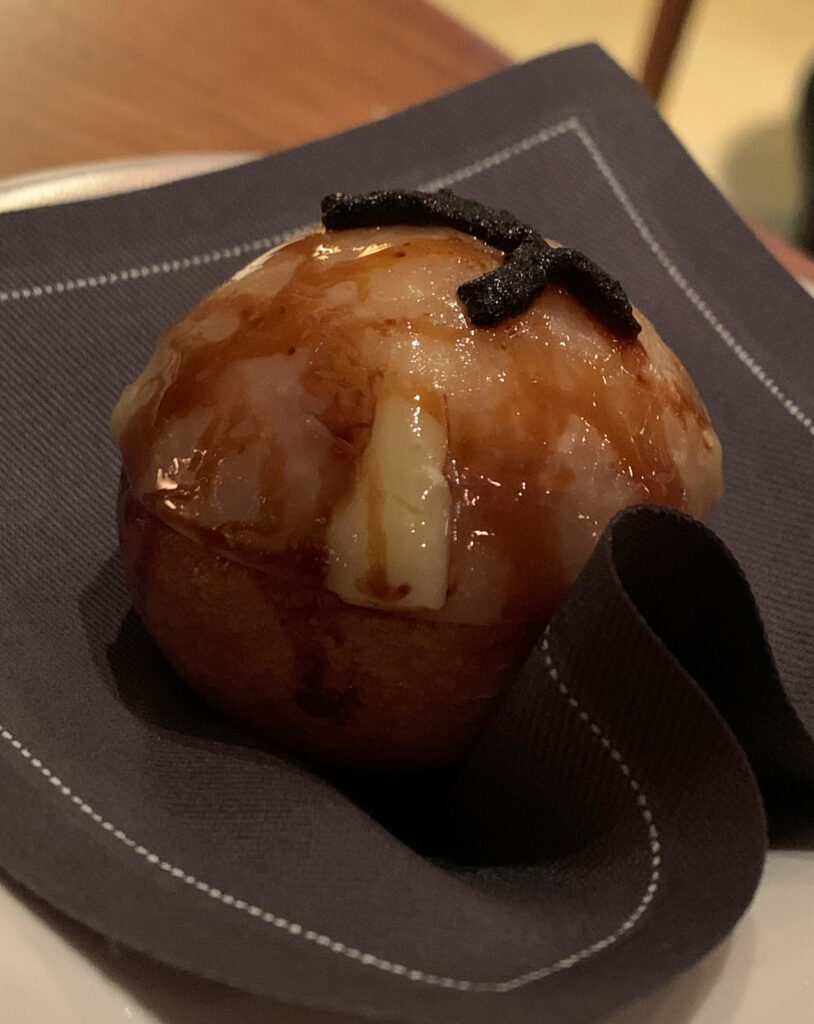
Adding to this effect, the heirloom tomato has been joined by a rather extravagant bite in the form of a “Pleasant Ridge Reserve Cheese & Caviar Doughnut.” This item, which predates the “Smoked Cod Head Doughnut” (but not the “Murray River Cod” course itself), represents yet another playful morsel made using one of Smyth’s favorite longstanding forms. Texturally, the baked good displays the same soft, fluffy character as its previous preparation. Unlike the cod roe, which was blanketed the top of the previous donut, the caviar is here ensconced within the bite’s inner cavity. A thin slice of the cheese, in turn, is draped over the top and allowed to melt. Meanwhile, the finishing touch comes from a garnish of the same dulse utilized in the “Heirloom Tomato” course.
Taken as a bite, the doughnut strikes the palate with gooey cheese, a soft crumb, oozing orbs of gently warmed roe, and a chewy bit of sea lettuce successively. The Pleasant Ridge Reserve—an Alpine-inspired cheese made from unpasteurized cow’s milk in Wisconsin—imbues the fluffy baked good with caramelly and nutty notes that display a hint of tart, fruity character. This matches the faint sweetness of the crumb and the nutty notes of the caviar well enough while the dulse component, likewise, underscores the roe’s briny quality. The doughnut’s various components certainly gel well enough, offering a surprisingly nuanced savory sensation. However, you are not sure this represents the most effective use of caviar. Yes, it’s a playful bite that takes the totemic luxury ingredient off of its pedestal. The mere idea is sure to surprise and delight guests. But, judged either as a doughnut or caviar dish, you think the preparation falls short of the hedonism its list of ingredients should promise.
One final vegetable dish that has been served before the main course comprises a “Roasted Eggplant Parfait with Yeasted Cream.” The preparation arrives in a small bowl whose interior is filled with the kind of frothed foam the kitchen clearly loves to use. You plunge your spoon past this layer and down to the bottom of the vessel, upon which you strike a custard made from the eggplant. On the palate, it feels totally smooth and a bit weighty. The foam element, inevitably taken as part of the same scoop, offers a prickly effervescence that lightens your perception of the eggplant’s texture. When it comes to flavor, the vegetable “parfait” offers pronounced vegetal and caramelized notes with a tinge of bitterness on the finish. The yeasted cream, in turn, displays tangy and fruit tones that make for a surprisingly sharp finish. You are not sure if this dish really shines as its own course; however, taken as a pre-meat tantalizer, it works quite well. Diners who are averse to eggplant’s flavor should, nonetheless, beware.
At last, you come to the meal’s crescendo: the final sequence of savory dishes in which Smyth pulls out all the stops and aims squarely at satiation. Truth be told, no other segment of the menu has undergone as many changes and as much experimentation over the 2021-2022 period. And no other segment of the menu proves more consequential in distinguishing Smyth from its peers, within Chicago, at the two- and three-Michelin-star level. For Shields and Feltz do not only spurn the clichéd cuts of A5 Miyazaki wagyu that perpetually feature on those other tasting menus, but they offer, as part of their main course, as many as six distinct (yet related) components. Thus, rather than expecting you to ration the tiniest piece of striploin to go along with your finest red wine, the restaurant welcomes you to indulge in a veritable feast that leaves you wanting for nothing (though a cheeseburger, upon request, is always close at hand).
Throughout March of 2021, the meal’s main course had comprised “Various Preparations of Game.” This selection includes a “Smoked Beet Slowly Cooked in a Sauce of Venison,” “Texas Venison Loin Glazed with Black Walnut & Spruce with Truffled Liver Ragout,” and a “Savory Éclair with Sauce Civet & Fermented Shiitake Mushroom.” These are followed by a “Black Walnut, Blood & Armagnac Tea” and a “Black Malt Macaron Filled with Blood Sausage & Chocolate.”
The first of these—the smoked beet—represents a favorite trick of modern chefs, one that you particularly associate with the New Nordic tradition. The oft-maligned root vegetable, when treated with care, takes on a soft texture with a faintly fibrous structure that is totally reminiscent of braised meat. Paired with a “sauce of venison”—and affixed to the end of a twig like a bonafide shish kebab—the beet’s smoky-sweet flavor takes on a gamey, earthy character to completes the illusion and achieves a high degree of decadence.
By comparison, the venison loin itself is more conventionally served at the center of a plate. The deer meat is a bit leaner than beef but attains an admirable degree of juiciness to balance its more substantial mouthfeel. While the spruce offers the venison uplifting citrus notes, the preparation is defined by the superlative concentration of the liver ragout. This sauce measures up to the meat’s richer, earthier character and—with the help of a generous shaving of black truffle—makes for a dish of supremely savory flavor. Goldsmith’s pairing of a 1990 Château Cos d’Estournel—loaded with notes of black cherry and tobacco—was well-conceived! (In May of 2021, this same preparation would substitute the venison for South Texas Antelope, offering much of the same texture with a tinge of sage and more pronounced meatiness.)
The “Savory Éclair” that accompanies these items will seem familiar to those who have dined at The Loyalist (where an “Éclair au Foie Gras” and “Éclair d’Oignon” have both featured). However, the sauce civet—modeled after a game stew made with chocolate and red wine—and fermented shiitake mushroom provide the pastry with a depth of earthy, slightly sour flavors that complement both the beet and venison well. The same goes for the “Black Malt Macaron,” whose perfectly formed and delicate shell houses a balanced chocolate and blood sausage filling that reminds you of that aforementioned pastry, made with apple and blood sausage, that currently appears toward the start of the meal. Of course, this rendition is the forerunner and admirably subsumes the irony quality of the blood into a palatable expression of chocolate.
Lastly, the “Black Walnut, Blood & Armagnac Tea” speaks to many of the same notes seen throughout the rest of the sequence. While inventive and aesthetically pleasing (when served in a crystal stem alongside the macaron), this drink strikes you as a little “hot” (or alcoholic) on the palate. Still, to its credit, the tea balances its blood element in a way that is not off-putting but, rather, deeply savory. Thus, the sum effect—looking across the scope of this sequence—is one of fine textures and deeply meaty flavors that are echoed and intensified by various expressions of blood, nut, mushroom, and chocolate. In this manner, the beet and the venison loin form the cornerstones of an expert, unapologetic exploration of the game: one that plumbs depths of concentration that are almost unheard of when chefs work with luxury beef.
In the summer and early fall of 2021, Smyth would move away from the “Various Preparations of Game” sequence in favor of a more abbreviated sequence (and, later, a solitary dish) revolving around lamb. This would include “Slow Roasted Lamb Loin, Pine Cone & Alliums” (accompanied by the aforementioned éclair, macaron, and tea), “Slow Roasted Lamb Loin Glazed with Black Currant & Black Garlic,” and “Lamb Loin Glazed with Black Currant, Black Garlic & Black Truffle.”
This preparation, in its various guises, takes much the same form as the venison and antelope that came before it. A thick cut of the lamb—with a glistening white cap of fat—sits at the center of a plate, where it is glazed with its sauce and covered with a scattering of the pine cones, alliums, and/or black currants (depending on the exact iteration). The meat, when you dive in, offers an engaging degree of chew that ultimately yields to moist flesh. The pine cone and alliums augment this sensation with crisp and crunching textures while the black currant, in turn, offers more of a sappy, slightly bursting finish. With regard to flavor, the dish combines the lamb’s naturally grassy character with fresh, woodsy notes of pine and sweet onion (in one instance) or earthy, umami, and tart fruit tones (in the other). Each composition has its place relative to the point in the season; however, you preferred the heightened hedonism of the latter given that the lamb needed to anchor the main course without other elements of a sequence to draw on for support.
It should be said, there were one or two occasions when the lamb featured some stringy segments that were hard to chew—as well as one occasion in which the fat cap was more or less inedible (though you certainly tried). For as much as you criticize the use of A5 wagyu, the composition of luxury beef almost never allows for such an error: the sort that can blemish an entire evening. You do not doubt that Smyth would have refired the dish on these occasions, but, instead, you merely brought the error to the chef’s attention later on. It represents a rare lapse in execution for the kitchen and a particularly bitter pill to swallow for any first-time customers unlucky enough to be served such a cut. It also stands as a case in which all the restaurant’s experimentation is undone by some fundamental inconsistency. Nevertheless, these represent only a few rare miscues across nearly forty meals throughout 2021-2022.
Moving on, October of 2021 saw Shields and Feltz shift away from game ever so briefly in order to showcase beef. Yes, beef—but not the A5 Miyazaki wagyu whose reputation you were only just besmirching. Rather, the chefs privileged flavor intensity over marbling and patience over luxury branding. They would serve a preparation of “100 Day Dry Aged Beef, Wasabi & Black Truffle” during the course of the month that demonstrated just how steak could effectively be used on an avant-garde tasting menu without seeming to pander.
The dish centers, simply enough, on a glistening strip of meat. Its blushing red interior, nonetheless, is obscured by a black truffle paste that coats almost the entirety of the beef’s surface. Some bits of pale green wasabi assert themselves against this dark backdrop while a solitary piece of oyster mushrooms forms the finishing garnish. Attacking the steak with fork and knife, you find that its tissue tears easily without smearing any of the truffle topping. You deposit a piece onto your palate, where it offers some faint resistance—just a little bit of chew—that yields to a refined, condensed, and almost crystalline structure that unravels on the tongue. The oyster mushroom, when it comes along for the ride, augments this bite with a plump, bursting component that reminds you somewhat of rendered fat (only more pristine).
In this manner, Smyth’s steak displays admirable weight and presence on the palate. The beef’s effect is not one of slick, melting pockets of marbling, but of a restrained juiciness that ensures each morsel lingers just long enough to impart a fulsome feeling of carnal delight. This sense of length is married with the distinguishing mark of the extended dry-aging: a hauntingly earthy, funky, but totally clean umami character that is suggestive of fine aged cheese. The beef’s hard-earned flavor joins effortlessly with the equally intense black truffle paste and the fresh, nutty quality of the mushroom. The touch of pungent wasabi, meanwhile, ensures that this high degree of richness does not become overwhelming. Yet, for comprising a relatively small portion, the dish undoubtedly packs a punch, subverting the timeworn trope of the bland strip of wagyu used to anchor a tasting menu. Instead, Shields and Feltz have prepared a steak that tastes like ten steaks’ worth of beefiness concentrated together. That is just the kind of peak sensation you demand when witnessing fine dining chefs work with such clichéd expressions of luxury. It is reflective of a kitchen that operates with a clear vision on how to best exploit—rather than merely sustain—the presence of high-quality beef on its menu.
In November of 2021, “Various Preparations of Game” would return as a new sequence titled “Several Servings of American Game.” Certain elements remained familiar, with dishes like “Texas Venison, Chicken Liver Ragout & Dark Chocolate,” “Savory Éclair & Squab Civet,” “Black Walnut & Venison Consommé with 25 Year Armagnac,” and “Black Malt & Foie Gras Macaron” each replicating their earlier forms with only some slight tweaks. (The substitution of “blood”—in the tea—for “venison consommé” and of “blood sausage”—in the macaron—for “foie gras” reflects some greater restraint when it comes to divisive irony notes. Likewise, introducing chocolate—previously found in the macaron—into the venison’s liver ragout helps soften the effect of the offal while enhancing the sauce’s depth.) However, these four listed elements were now accompanied by a new, fifth preparation that would arrive on their back and close the sequence with style.
The ”Hearth Roasted Fall Squab,” in this manner, represents a return to Smyth’s pre-pandemic roots. The bird, cooked above the open fire that features so prominently within the kitchen, is one of Shields’s hallmarks—with its breast and leg meat having been presented in countless ways over the years. It that sense, the ingredient stands as one of the restaurant’s true totems: a distinctive kind of luxury drawn from life in the fields rather than some nebulous national purveyor’s price catalogue. To that point, the squab sees little ostentation when it comes time to be prepared.
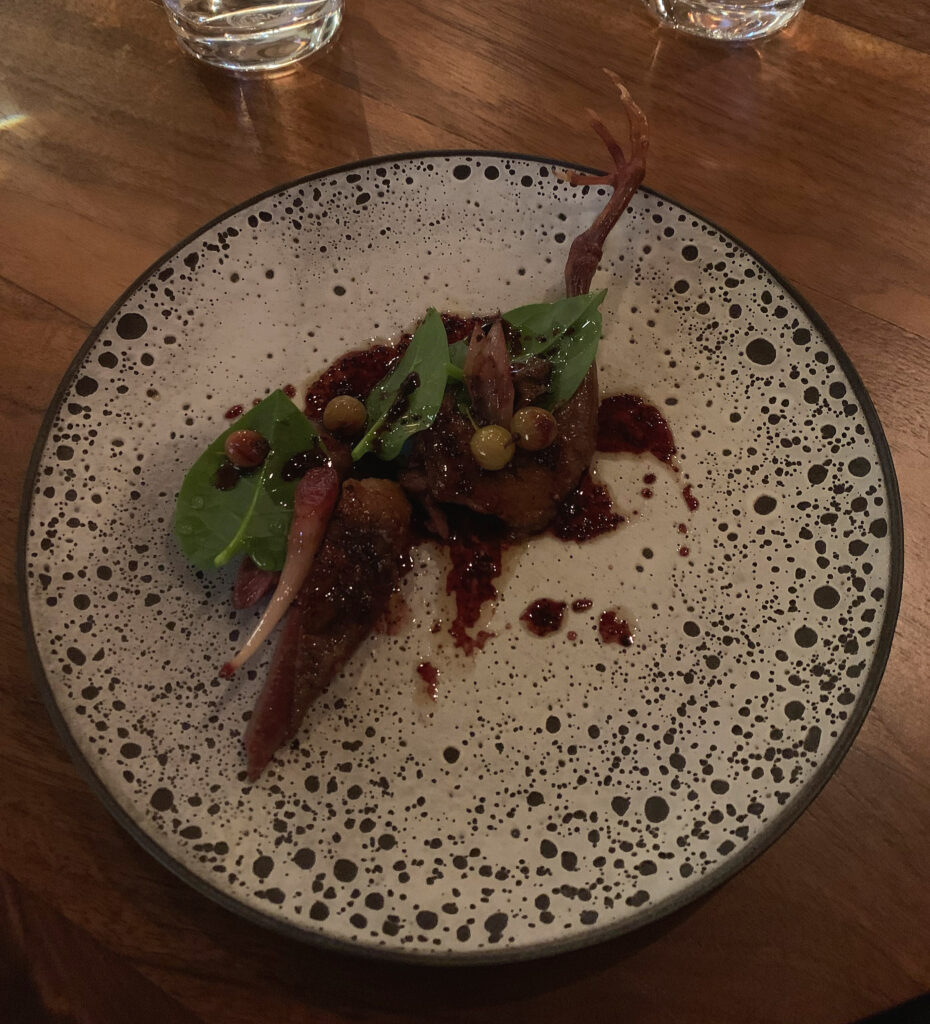
A neat slice of the bird’s breast, along with a whole segment of its leg (talons and all), sit on a speckled plate. The two pieces are blanketed by a few leaves, some lengths of charred allium, and a handful of gooseberries. A coagulated sauce—made from the carcass’s drippings—completes the effect. Attacking its flesh, the squab displays a beautiful golden-brown skin that crunches and crackles to reveal a succulent medium rare interior. The snap of various stems and pieces of scallion, when thrown into the mix, enhances your impression of the skin’s crispness while the bursting gooseberries, in turn, accentuate the meat’s juiciness.
When it comes to flavor, the bird strikes the palate with a pristine dark meat character not unlike duck (while, at the same time, avoiding any of the livery notes that develop with overcooking). The pan sauce that coats the squab’s flesh, meanwhile, resonates with an intense savoriness that, nonetheless, falls short of what might be called “gamey.” Instead, it joins with the sweet and sour gooseberries to form a surprisingly vibrant, perfectly balanced dressing that echoes the meat’s delicacy while tickling your tongue and invigorating each subsequent bite. Paired, by Goldsmith, with a glass of Vega-Sicilia’s 2010 Único, the bird’s depth of savory flavor shines alongside sappy notes of cherry and mocha encapsulated by silky smooth tannins. The dish’s overall effect, juxtaposed by a wine of such class, is one of unparalleled intrigue and refinement. It reminds you why game (as an expression of Illinoisan prairie cuisine) formed the cornerstone of Chicago’s early expressions of fine dining, and why—as a category—it may still provide an antidote to the thoughtless kind of luxury now proffered in its place.
Later that same November, Shields and Feltz would craft a streamlined version of the “Several Servings of American Game” that, omitting the venison loin, dove headfirst into the squab. Some items—like the “Savory Éclair with Squab Civet,” “Black Walnut & Venison Consommé with 25 Year Armagnac,” and “Black Malt Macaron with Foie Gras”—would retain their usual form. However, they were now preceded by a trio of novel preparations.
Starting off, the “Squab Salad with Garden Herbs” offers a couple carefully picked morsels of the bird’s flesh that are hidden under a teepee of leaves then dressed with a light vinaigrette. Various flower petals and pods, scattered around the base, form a finishing touch. This fairly naturalistic presentation is echoed by your experience of the dish: a crisp and crunchy couple bites with an attractive tang and a hidden deposit of tender flesh. The squab only shows a glimpse of the dark, flavorful character that stars in the ingredient’s previous “Hearth Roasted” rendition, yet the small taste you are granted leaves a lasting impression. It sets the table for the bird’s glorious reappearance later in the sequence.
First, nonetheless, you are served yet another new tidbit: a “Savory Brioche Donut” that, sans any Pleasant Reserve cheese or caviar, offers a more conventional take on one of Smyth’s favorite pastries. The baked good, in this case, is glazed with nothing more than some oil, strings of onion, flakes of salt, and curls of lemon zest. There is no hidden, delectable stuffing; rather, the donut feels like more of a dinner roll. You take a bite to quell the tang of the salad and find a warm and fluffy crumb with a couple bright accents. There is a perfectly judged sweetness to the dough that makes it attractive on its own. However, you think it best to save a nibble or two to drag through the sauce of the sequence’s next dish.
That takes the form of “Roasted Squab with Chocolate,” a slightly refined version of the “Hearth Roasted Fall Squab.” The preparation, in this case, omits the bird’s leg and comprises only a thick cut of its breast. The meat, nonetheless, displays a gorgeous, lacquered crust garnished with flaky salt and a couple miniature pinecones. It is joined on the plate by a dark, shining chocolate sauce as well as some more pinecones and a few pieces of dried prune. Texturally, the squab offers the same dramatic balance between crispy skin and succulent, only faintly chewy flesh. The pinecones crackle in harmony with the former element while the prunes offer a lasting, gummy consistency that melds into the meat with further mastication.
In terms of flavor, the bird shows the same concentrated, dark meat character as before, yet it is now amped up even further by the bittersweet chocolate and earthy, tangy prune. These two elements seem rather subtle upon entry but demonstrate impressive persistence and display staggering depth as you chew your way through the breast. The woodsy, slightly honeyed notes of the pinecone, on the other hand, struggle to assert themselves but are in no way jarring. Instead, the squab achieves a lasting, decadent, sweet-and-savory sensation (reminiscent in some ways of a duck mole) that allows the sliver of breast—something of a small portion for a headlining course—to make an outsize impression on the palate.
In December of 2021, Shields and Feltz would shift toward a hybrid version of the “Several Servings of American Game” that, once more, combined both venison and squab to great effect. Coming in at eight separate components, the sequence would even introduce another game bird into the mix and would stand—overall—as the longest cohesive assemblage you have ever seen the restaurant serve. Once more, a couple of these items would be repeats—the “Black Walnut & Venison Consommé with 25 Year Armagnac” and “Black Malt & Foie Gras Macaron” as before. However, the remaining half dozen dishes have each brought something new to the table.
First, the “Texas Venison, Squab Civet & Dark Chocolate” offers something of a hybrid between the “Texas Venison, Chicken Liver Ragout & Dark Chocolate” and “Savory Éclair with Squab Civet” that come before (the latter construction, in this case, no longer forming a part of the sequence). Instead, the deer meat—its savory tones already set alight by the bittersweet cocoa—is complemented by notes of the traditional game stew. Whereas the chicken liver ragout offered some of the same richness, the civet sauce provides a deeper, darker tone of flavor. This better augments the venison’s earthy character while readying the palate for its next encounter.
That would be, in this case, a “Hearth Roasted Quail Leg”—something of a rare departure from squab (that you think must have been driven by the ingredient’s particular quality on this occasion). Relative to its counterpart, quail is smaller with meat that is a bit less dark and characterful. Nonetheless, the game bird’s leg arrives beautifully crisped to a deep brown (bordering on black) tone whiles its meat receives a glaze of the same dark chocolate sauce used with the venison. Grasping the quail’s talon in your hand, the bite feels incredibly delicate. With each nibble, the bird’s skin crackles to reveal a shred of juicy flesh that immediately melds with the thick sauce. The meat possesses a fuller flavor than chicken but remains cleaner than the squab. Thus, the bittersweet chocolate seems a bit more pronounced, yet it achieves a nice balance with the bird’s charred exterior. It also makes for a rather elegant dark-to-light transition coming off of the venison: deer to squab to quail moderated by notes of cocoa.
Next, the “Black Truffle & Citrus Doughnut” offers a more involved iteration of the “Savory Brioche Donut” that came before. While the latter preparation seemed more like an accompanying “dinner roll,” the former better integrates itself into the sequence. That, of course, comes courtesy of the earthy black truffle, whose flavor forms a natural connection with the various cuts of game (and even the civet or chocolate sauce components). Nonetheless, notes of citrus ensure that the doughnut (an ancestral spelling that you think the restaurant was right to adopt) still offers a bit of bright, sweet relief from the more decadent components of the sequence.
The same can be said about the “Squab & Offal Citrus Salad,” a new iteration of the “Squab Salad with Garden Herbs.” In terms of form, the preparation seems quite similar: a thicket of leaves, dressed with vinaigrette, obscuring a small mound of meat. However, the addition of the offal provides a greater sense of chew that extends the overall textural sensation of the salad. Likewise, the citrus notes offer a greater sense of connection to the “Black Truffle & Citrus Doughnut” (and, thus, the larger sequence). Ultimately, the dish still works to refresh your palate, but it does so with a more engaging mouthfeel and pronounced savory flavor than before.
The “Squab Royale Custard,” by comparison, moves in the opposite direction. It is not a “cleanser,” but a “closer.” It represents the very peak of the chefs’ savory powers—and, for you, one of Smyth’s very best creations across the entire 2021-2022 period—while also forming something of a last hurrah before dessert. The dish, of course, is inspired by “Lièvre à la Royale,” a so-called “Royal Hare” in a sauce made of chocolate, mushroom, red wine, blood, brandy, cooking jus, foie gras, and black truffle (along with comparably ordinary ingredients like herbs, garlic, and shallots). It is hard to imagine a more decadent concoction—or that any serving of meat could really measure up to such rogues’ gallery of enrichment. But therein lies Shields and Feltz’s genius.
For the “Squab Royale Custard” arrives on the back of the venison and quail, which are both flavored with chocolate (the former also with the hearty civet) but fall short of the classic royale sauce’s extravagance. Following these opening items, you refresh yourself with the donut and salad, whose citrus notes revitalize the palate even as hints of black truffle and offal connect to the game you tasted before. Just when you think you are out of the woods, the custard arrives. Comprising nothing more than a disc of what looks like sauce-drenched pudding, the dish is clearly not another serving of meat. Your spoon and your tongue prepare for something sweet, and the custard displays a soft, smooth, and creamy consistency.
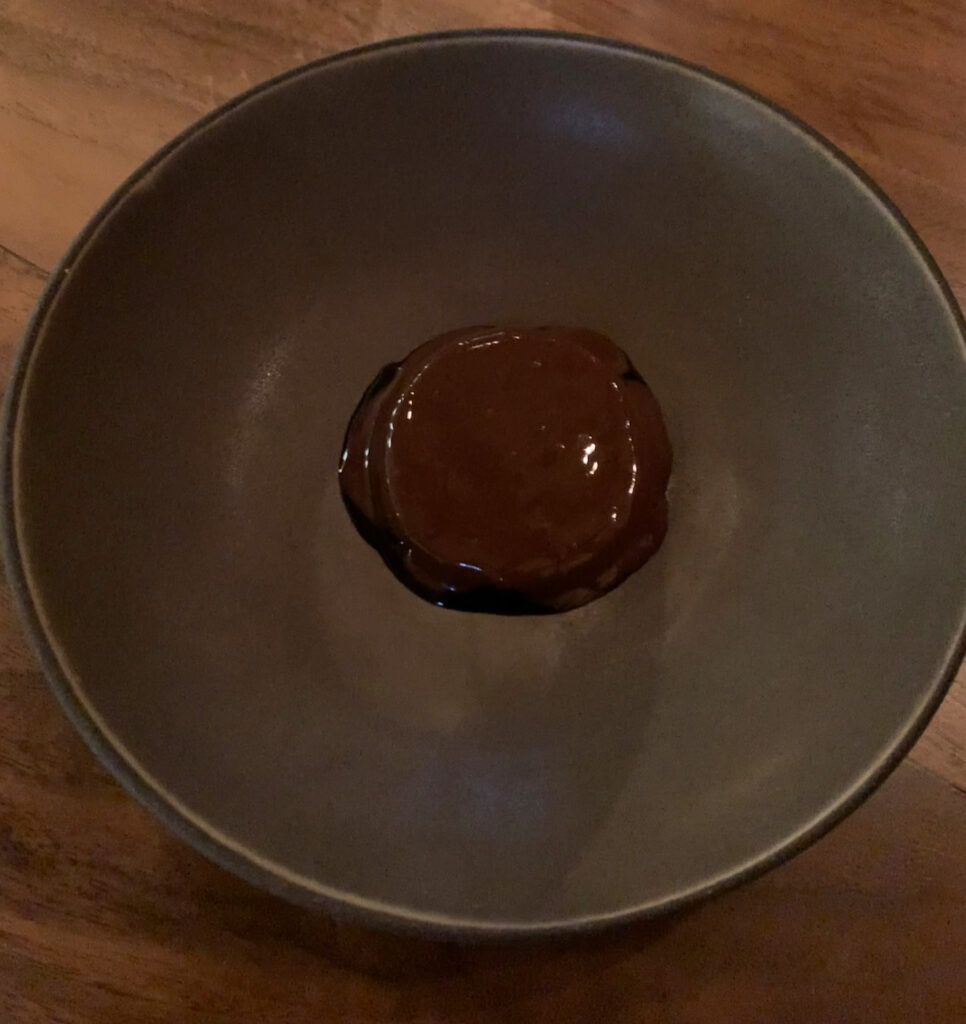
However, as the royale sits on your palate, the savory flavors suggested by the venison and quail—then hinted at by the doughnut and salad—come back with force. The custard, larded with every sweet and meaty thing under the sun, represents the quintessence of the entire game sequence dialed up just one more degree. And yet, that superlative savory flavor sees itself matched by a greater overall sweetness than any of the preceding dishes. The balance of these two elements lands right on the razor’s edge: an absolutely staggering sensation that tastes something like “Tournedos Rossini” meets Portillo’s (pre-private equity) chocolate cake. The concentration here is simply immense, yet the flavor composition just works so perfectly for you (and, having sampled the dish at least a handful of times, consistently so). Crafting food that aims at this territory—the liminal state between savory food and dessert—seems incredibly promising, and Smyth, indeed, has explored it further. But the “Squab Royale Custard” deserves your particular praise for putting an exclamation point on the entire “Several Servings of American Game” idea. It is undoubtedly one of the best things you have ever eaten.
Finishing up this particular iteration of the sequence, the “Black Walnut & Venison Consommé with 25 Year Armagnac” and “Black Malt & Foie Gras Macaron” are joined by a bite of “Milk Chocolate Ganache, Black Currant & Black Garlic.” This item, which you sometimes refer to as the “Seaweed Chocolate,” is an original Karen Shields creation that has featured on Smyth’s menus since the beginning. In many ways, it stands as the forerunner of all the restaurant’s bewitching savory-to-sweet transitional courses. Here, in the wake of the “Squab Royale Custard,” the chocolate bar can show even more of its class. Served after the macaron, it forms a gradient of rising sweetness and falling meatiness (respectively) that closes the “Several Servings of American Game” with the same level of care and nuance applied to the opening expressions of game themselves. By honoring the more “dessert-like” components in this way, Smyth imbues the sequence with a seamless quality. The eight distinct elements combine to offer a progressive, multifaceted expression of kindred flavors.
In January of 2022, the “Several Servings of American Game” would shrink to a “mere” five items. Of course, the “Black Walnut & Venison Consommé with 25 Year Armagnac” and “Black Malt & Foie Gras Macaron” remained—making for a very civilized, perhaps a bit dainty end to the sequence. The “Black Truffle & Citrus Doughnut,” too, would remain: retaining its crown as one of the finest bread courses around. Instead, Shields and Feltz tinkered with the core components of the quintet—a bolder choice (relative to their status as the meal’s savory lynchpins) that, nonetheless, affirms the adaptability of the sequence’s minor elements in fulfilling the chefs’ larger aesthetic goals.
Gone now is the venison, along with that interloping game bird the quail. Rather, the squab would now appear in a duo of preparations: “Roasted Squab, Marmite & Dark Chocolate” and “Squab Leg with Trimmings.” With regard to form, these dishes do not seem all that novel. The former comprises—if you can peer beyond the pile of shaved black truffle—a cut of the breast with its crispy layer of skin. However, there is also a small, loosely formed seaweed tart filled with what looks like that delectable “Squab Royale Custard.” The latter dish arrives—talons and all—in the familiar fashion, but the leg’s skin boasts more of a delectable golden-brown tone in this case. The crisp exterior layer clings to the flesh, which includes a little “trimming” (or additional morsel of meat), appealingly.
Diving in to the former preparation, the squab’s breast displays the same mesmerizing combination of crisp skin and succulent flesh that has made the bird a staple at Smyth throughout this period. The avalanche of black truffles, when present, adds a faint crunch to the mix. (Ideally, the Tuber melanosporum would be warmed a little more, yet it is hard to fault the restaurant’s generosity when some portion of the mushroom joins with the warm flesh to exhibit a greater aromatic effect.) The accompanying “Squab Royale Custard,” set within the seaweed tart, is crisp, a bit chewy, but ultimately smooth and rich. It helps the breast meat attain an even higher level of decadence than the dark chocolate sauce alone. Nonetheless, it is the Marmite—that infamous British yeast extract spread (and relative of the equally polarizing Vegemite)—that offers the key touch. Its salty soy sauce notes provide the chocolaty squab with valuable savory backing, ensuring its dark meat character asserts itself against the sweetness.
When it comes to the latter preparation of the bird’s leg, there is not so much to say. However, just as the Marmite affirms the squab’s meaty quality, this separate serving—free of any sauce—offers a relatively pure expression of game. The extra crisp skin and unadorned flesh feel unapologetically carnal, a sensation that is echoed by that extra morsel of “trimming” affixed to the end of the leg. Given how distinctive Smyth’s manner of saucing the bird usually is, this particular item affords guests a more conventional—but highly enjoyable—encounter with the ingredient. (This is particularly true when it comes to the skin, executed in a manner that nostalgically calls rotisserie chicken to mind.)
Throughout February of 2022, Shields and Feltz would shuffle the pack yet again. Headlining the “Several Servings of American Game” sequence, the “Texas Venison, Squab Civet & Dark Chocolate”—last served in December of 2021—would return as “Texas Venison, Black Truffle & Dark Chocolate.” While certainly not representing a dramatic change to the dish, the presence of the coveted mushroom—rendered as a thick, singular slice that crowns the top of the loin—lends the preparation more visual appeal. The dark chocolate sauce, too, displays greater thickness and a warming quality that helps emphasize the truffle. Despite the flavorful quality of the previous squab civet element, this new combination amounts to a comparably unadulterated expression of venison in which the meat and its accompanying earthy, cocoa notes can better shine.
Rounding out the middle of the sequence, the “Black Truffle & Citrus Doughnut,” “Black Walnut & Venison Consommé with 25 Year Armagnac,” and “Black Malt & Foie Gras Macaron” take their familiar forms. However, that beloved “Squab Royale Custard”—last seen as a more minor component in the “Roasted Squab, Marmite & Dark Chocolate”—now takes the form of a“Black Trumpet Mushroom Custard with Venison Royale.” In terms of construction and consistency (i.e., rich smoothness), this dish remains as delectable as ever. But you are impressed by the deeply sweet, savory, and—of course—umami notes that the chefs are able to derive from a mushroom-based custard. The venison version of the à la royale sauce, meanwhile, provides the preparation with its bewitching intensity of flavor. It offers, relative to the squab version, a slightly earthier character that helps the dish dial up its decadence one step further.
Finally, from March through July of 2022, the “Several Servings of American Game” would reach its zenith. The chefs ceased their breakneck experimentation—having shifted from beet to venison to quail and squab (and back again)—and settled on a more consistent seven-part sequence. This did not, nonetheless, quell the menu’s dynamism completely. Rather, it meant that the kitchen could focus more on tinkering with the fine details (and not the overall composition) of the chosen dishes.
Headlining the sequence would be a preparation of “Aged Squab, Black Truffle & Dark Chocolate” paired, as you have so often seen, with a serving of the bird’s leg. While these essential elements are, at this point, old hat, the listed ingredients bely the progression of Shields and Feltz’s technique. The principal presentation of squab comprises a portion of the breast that, compared to past iterations, displays less of a crisped outer crust. Instead, the bird sees itself covered: either with the truffle (formed, rather impressively, into a cohesive layer that plays the part of the “skin”) or, later, with pinecones, flower petals, and a glaze of the chocolate sauce. The squab would also, during the course of this particular sequence, see itself paired with rotating accompaniments like foie gras (done up as in the “Swimming in a Broth of Guinea Hen” preparation), liver-stuffed morels, and fruit compotes.
The bird’s leg, meanwhile, would be roasted in the familiar manner but served free of any thick sauce. Instead, the skin receives only a light glaze that helps it retain its crispness and serves as an adhesive for a generous coating of yellow flower petals. (This element, which would eventually be applied to the breast, was a hallmark of the leg preparation for the entirety of the final sequence’s length.)
Ultimately, the squab distinguishes itself not by its garnishes (which really comprise the kitchen’s usual bag of tricks) but by the effect of its aging. This process demands hanging the bird for two to three weeks: an investment of time that has only otherwise been seen—more conventionally—via items like the “100 Day Dry Aged Beef.” However, while whole ribs of meat are easily held for extended periods then processed into smaller portions as needed, preparing the tiny squab in such a manner demands rigorous planning.
The results, nonetheless, are worth it. What the dry-aged bird’s breast lacks in terms of crisp exterior is more than made up for by its more luscious, homogenous interior. You do not speak of a livery texture (which, again, reflects overcooking), but a more finely woven flesh whose condensed layers effortlessly unwind on the palate. This sensation—which goes beyond the bird’s usual, pleasing chew to achieve a rare sort of tenderness—is matched by a greater concentration of flavor. Nonetheless, the resulting notes remain free of any funkiness. The bird’s pristine dark meat character simply strikes with even more force, allowing the other elements of the plate to assert themselves in like fashion. Of those, the pinecones, petals, and chocolate sauce remain fairly subtle. The foie gras and stuffed morsels, by comparison, augment the dish’s richness while the compotes of prune and raspberry provide a nice contrasting acidity and sweetness. You can thank the dry-aging process for opening up these new, ever-more-delicious avenues. (And paired, by Goldsmith, with wines like a 2017 “Les Saints Georges” from Thibault Liger-Belair, lovers of Burgundy could hardly ask for more.)
However, when it comes to the squab’s leg, Smyth’s insistence on a flower petal crust strikes you as a bit controversial. Relative to the breast, this segment retains a bit more natural crispness while still benefitting from a finer, more tender texture. Its flavor, too, displays an added intensity drawn from the dry-aging. But the fine coating of yellow flower petals affixed to the leg’s flesh—no matter how beautiful—detracts from the meat’s texture with a soft, wilted quality that may be interesting but, to your palate, cannot be called decadent. The tinge of bitterness that the petals provide—while, once more, interesting—also saps some of the preparation’s hedonistic appeal. Thankfully, you think the squab breast is rich enough to guarantee ample pleasure at this moment in the sequence, yet you cannot help but think the totally unadorned “Squab Leg with Trimmings” stands as the most delicious iteration of the dish. Would it really be a proper Smyth menu if the kitchen didn’t push the boundaries of flavoring though?
The rest of this final, seven-part “Several Servings of American Game” sequence is filled with old friends: namely the “Black Truffle & Citrus Doughnut,” “Black Trumpet Mushroom Custard with Venison Royale,” “Black Walnut & Venison Consommé with 25 Year Armagnac,” and “Black Malt & Foie Gras Macaron.” Of these, only the doughnut really saw any tinkering in the form of various glazes, edible flowers, and seaweed chips utilized as garnishes when truffles are out of season. Otherwise, the general movement remains the same: an elegant gradient of dark and meaty flavors transitioning into sweet with a touch of warming broth and alcohol on the finish. You must say, this final version of the sequence—with the one exception of the (still rather intellectually appealing) squab—represents a worthy plateau for the dishes’ development over the course of so many months.
From July through September of 2022, Smyth served a new sequence that centered, not on venison or squab, but lamb (an ingredient last seen during the fall of 2021). This new assortment of dishes would start off, in the first instance, with something of an inversion. The familiar “Black Malt & Foie Gras Macaron” arrives as an opening bite alongside its usual sidecar. However, the beverage is now rendered as a “Black Currant & Lamb Consommé with 8 Year Japanese Whisky.” These two items are joined by a simple salad made of large, light dressed flower petals in vibrant yellow, orange, and reddish tones.
While this combination—a fresh, crisp salad juxtaposed by concentrated, closing sweet-savory bites—seems to clash, it effectively sets the table for what follows. This is due to the lasting bitter notes of the petals and the milder character (relative to the “25 Year Armagnac” that featured before) of the Japanese whisky. For, though the macaron continues to offer a deep sweetness, the consommé is less obscured by the alcohol and its savory, fruity qualities shine through. These elements join with the tang and florality of the salad to achieve a surprising harmony: one that balances a decadent finish with lightness and brightness on the attack.
Once the main course arrives—a preparation of “Slow Roasted Lamb Saddle, Porcini & Bitter Greens”—all makes sense. The meat itself is slightly firm, offering a pleasing chew and plenty of juiciness with further mastication. Its flavor, most immediately, echoes that of the consommé. Nevertheless, as the small leaves, petals, and stems that make up the “Bitter Greens” strike the palate, your tongue recalls the prior salad. The porcini element (rendered as a sauce at the bottom of the plate), too, touches on the dark, savory character displayed by the macaron. Even the black currant sees itself matched by the fruity quality of the “Pleasant Ridge Reserve Cheese & Caviar Doughnut” (now extricated from its “Heirloom Tomato” dish to be paired with the entrée).
Nonetheless, you will note that the lamb saddle and doughnut arrive some time after the sequence’s opening trio of bites. Thus, any effect the macaron, consommé, and flower petal “salad” have—vis-à-vis your perception of the other dishes—is delayed and, perhaps, based more on priming rather than a visceral combination of flavors. With that in mind, you still appreciate the kitchen’s decision to turn the order of the items on its head; however, the faint bitterness of the flower petals forms the only component that absolutely must be situated before the roasted lamb saddle in such a manner. (And maybe that suggests why this particular ordering of bites never occurred again.)
Instead, Shields and Feltz would press onward with a new set of accompaniments as part of an alternative, more abbreviated lamb sequence. Whereas, in the heart of summer, the chefs opted for flowers, the approach of fall would see them turn back toward a more wholly hedonistic expression of flavor. The lamb arrives, just as before, boasting a glistening medium-rare interior, yet its garnish of leaves and flowers sees itself exchanged for the larger segments of blade kombu that have featured, here and there, across the menu. As for sauce, the cut of saddle sits in a pool of its own emulsified fat while bits of dehydrated seaweed crown its cap as a finishing touch.
Texturally, the chew and juiciness of the lamb remains consistent, but you prefer the slick, crisp mouthfeel of the kombu and crunching bits of the dehydrated seaweed to the wilted texture of the bitter greens that appeared previously. (The saddle’s cap, in this case, also offers a bursting, gushing sensation that benefits from the contrast provided by the brittle flakes.) Whereas the previous preparation of lamb built an intriguing balance from bitter and floral notes, the present version aims more wholeheartedly at a meaty flavor that is augmented by rich fat and subtly umami seaweed. This combination ensures that the saddle, representing the meal’s only substantial serving of flesh, offers the greatest sense of satiation possible.
It also makes for an elegant transition into the “Black Currant & Lamb Consommé with 8 Year Japanese Whisky”—served after, rather than before, the main course yet again. But the most consequential development, as far as this sequence goes, is the retirement of the “Black Malt & Foie Gras Macaron.” The pastry is, instead, replaced with a “Lamb & Black Walnut Treacle” that, despite referencing the classic British shortcrust and sugar syrup tart, looks more like a mini devil’s food cake at first glance.
The “Lamb & Black Walnut Treacle” does, indeed, display the ridged sides of a small tart, yet the crust—rendered in a dark black tone—is hard to discern. The pastry’s filling, just the same, comprises a shimmering black syrup that looks every bit like chocolate. Only a topping of shaved Burgundy truffle, rendered as a ruffled flourish that effectively double’s the treacle’s height, really stands out. Popping the bite into your mouth, you are struck by how effortlessly the tart’s shell yields to its filling. It is this quality, you think, that really gives the impression of biting into a particularly dense cake, for you find yourself chewing on the inner reservoir of syrup without any sense of a crisp or crumbly crust.
Your palate, rather, suddenly finds itself awash with a concentrated expression of sugar that is transfixingly detailed by the earthy black walnut and notes of savory lamb. The resulting flavor goes well beyond prior pastries like the éclair, the doughnut, and the macaron. No, it is more like the ”Squab Royale Custard”—a blend of sweet and savory in the extreme that, nonetheless, is perfectly judged and amounts to the most superlative kind of dessert you can imagine (as someone, it should be said, who always favors the savory side). With the added aromatic quality of the truffle to draw on (something the “Squab Royale Custard” never made use of), the treacle represents an extraordinary new peak of Smyth’s sweet-savory transitional prowess.
In October of 2022, Shields and Feltz would switch the lamb out for beef but, otherwise, preserve much of the same sequence. Their “Aged Ribeye, Charred Mustard Green & Braised Kombu” would arrive with an accompanying “Pleasant Ridge Reserve Cheese Doughnut” while, subsequently, a “Black Currant & Beef Consommé with 8 Year Japanese Whisky” would be joined by a so-called “Black Walnut Treacle & Burgundy Truffle.”
Relative to the “100 Day Dry Aged Beef, Wasabi & Black Truffle” construction that featured in October of 2021, the new preparation comprises a pair of cuts—one large and one small (taken from the deckle)—draped with long leaves of the kombu and mustard green (that, braised and charred respectively, actually come to resemble each other). The dual pieces of aged ribeye tout slightly caramelized crusts and dustings of flaky salt. They sit, in a manner reminiscent of the lamb, in their own emulsified fat. And, like the lamb, the steak offers a pronounced meaty flavor—with a smooth, condensed texture drawn from the dry-aging—adept at anchoring the savory portion of the meal. While the braised kombu, in its familiar fashion, lends the beef a bit more umami, the pungent mustard green acts as a mild, slightly bitter substitute for the wasabi.
As an accompaniment, the “Pleasant Ridge Reserve Cheese Doughnut”—free of its caviar topper—offers more conventional creamy and nutty notes to go along with its faintly sweet crumb. This matches the more straightlaced preparation of beef and helps the entrée achieve a broadly appealing, satiating effect.
When the latter part of the sequence arrives, the “Black Currant & Beef Consommé with 8 Year Japanese Whisky” plays well off of the previous flavors. (The use of the Japanese whisky, as a matter of course, has made the beverage more approachable no matter what meat is used to form the broth.) Meanwhile, the “Black Walnut Treacle & Burgundy Truffle”—though no longer imbued with lamb—takes much the same form. The topping of truffle has grown even more intricate, looking something like a flower in full bloom. Yet the tart’s flavor remains as delectable as before. Opposite the cheese doughnut, it offers a deeper, more unabashedly sweet sensation that leaves you awash with pleasure. Overall, this makes for one of Smyth’s most hedonistic sequences to date (even if the preparation of steak, relative to the totemic wagyu courses you routinely criticize, is not exactly bursting with creativity).
In late October and throughout November of 2022, this beef sequence would take its final (for now) form. The main course, in this case, comprises a preparation of “Dry Aged Ribeye, Braised Kombu & Maitake Mushroom.” However, over time, the steak has been substituted for “triple-seared” wagyu tongue and, later, a duo of wagyu sweetbreads (from a farm in Georgia) and beef cheeks (from Slagel Family Farm). Each cut, nonetheless, sees itself presented in the same manner: topped with the seaweed and mushroom components while soaking in a shallow pool of jus.
Texturally, the dry-aged ribeye offers the most familiar mouthfeel. It is tender and juicy with a telltale fineness to its flesh. The wagyu tongue, by comparison, offers a much heartier chew. Nonetheless, that “triple searing” method ensures the cut offers a crunching, shattering outer layer to help contrast its more lasting interior. The wagyu sweetbreads, in their own right, are totally unique. Though you have a particular affinity for this ingredient when it is fried, Smyth’s relatively unadorned preparation impresses you with its wholly smooth, almost custardy consistency whose loose structure reminds you of milt. Finally, the beef cheeks offer what might be your favorite mouthfeel of the bunch. Their ample collagen, upon being braised, imbues the meat with an extraordinary softness that, to your taste, always triumphs over more conventional steaks. Ultimately, each cut benefits from the velvety texture of the seaweed and the fine-grained consistency of the maitake, which is rendered as something of a duxelles. While these elements blend seamlessly into the more tender expressions of beef, they also work to moderate the tongue’s chew.
When it comes to flavor, this set of preparations follows the recent trend of unabashed meatiness. The dry-aged ribeye, of course, is refined and a bit nutty. The tongue, for its increased firmness, is pristinely beefy with a nice undercurrent of caramelization from its aggressive sear. By comparison, the sweetbreads are rather mild, but their creamy consistency allows them to soak up the accompanying jus and, thus, also offer more pleasing notes of the meat’s essence. That sensation culminates in the cheeks, which combine the best flavors of the ribeye with the absorbent properties of its accompanying cut of pancreas. The braised kombu and maitake mushroom, meanwhile, underscore each member of this quartet with an added dose of earth and umami. None of this sounds particularly novel (by Smyth’s lofty standard), but—particularly as the kitchen makes use of less conventional cuts of beef—the various preparations (and relatively generous portion sizes) effectively anchor the savory peak of the meal.
Generally, the “Dry Aged Ribeye, Braised Kombu & Maitake Mushroom” and its variants are served with the “Pleasant Ridge Reserve Cheese Doughnut.” Once more, without the caviar element (however generous and charming at an emotional level), the pastry helps add to a more straightforward expression of meaty, cheesy hedonism. However, it is really the second flight in this new beef sequence that is worth highlighting, for it represents a turn away from the ever-present ”Consommé” while also offering a new sweet-savory dish that matches—and maybe even surpasses—the towering pleasure offered by the “Squab Custard Royale” and “Black Walnut Treacle” that have come before.
The “Brioche Baba Glazed in Veal & Burgundy Truffle,” according to Feltz, represents the latest creation that accentuates an upstairs/downstairs dichotomy between Smyth and The Loyalist. (You recall that the “Savory Éclair with Squab Civet” matches, in some sense, the “Éclair au Foie Gras” and “Éclair d’Oignon” served at the latter venue.) In this case, Smyth’s construction references The Loyalist’s “Baba au Rhum” that is presently made with brioche, crème anglaise, and a vanilla Chantilly cream.
While the downstairs version of the dish comprises a whole piece of the yeast cake that is given a tableside flambéed rum finish, the upstairs rendition centers on a half portion that is placed, open-faced, in the shallow bowl previously used for the “Foie Gras Swimming in a Broth of Guinea Hen.” The baba soaks in a veal syrup that is studded with black currants before being topped, tableside, with a shaving of the truffle. An accompanying quenelle of salted crème fraîche, which you are invited to incorporate as you see fit, takes the place of the Chantilly.
Diving in, the cake displays a light, airy crumb that, while partially soaked, is not totally awash with the syrup. Rather, using your spoon, it is easy to pull the baba apart from the bottom and draw its upper, dryer end down toward the bottom of the bowl. By itself, the crumb is faintly sweet, yet its interior structure effectively takes on the flavor of the veal syrup: an incredibly concentrated—but altogether light, delicate—expression of savory flavor with its own tinge of sweetness. The black currant, though a relatively minor component, offers a burst of acid and tart, grapey flavor when it finds its way onto the palate while the crème fraîche, meanwhile, brings a cleansing sourness and bit of salt to the equation.
Ultimately, when these various notes combine, the preparation strikes you with a deep, lasting caramel note that subsumes the disparate elements of meat, fruit, and cream into a cohesive package. As with the “Squab Custard Royale,” it is hard to imagine how the taste drawn from the veal is so well disguised. Actually, you might say that its intensity is masked by the concentration of the other ingredients so that only the most perfectly attuned, pleasing sweet-savory sensation resonates through the dish’s finish. This, you have found, is a hallmark of great food and wine: extreme, hedonistic flavor is not attained by layering more and more of the same thing on top of itself; rather, it is formed through a tapestry of diverse supporting notes that drive the principal expression of pleasure to its peak. The balance here is so well conceived that the truffles, more than perhaps any other usage across the menu, really shine. They provide a last, haunting kiss of earth and musk that nearly makes your eyes roll back in your head. The “Brioche Baba” stands as yet another extraordinary transitional course in what has become, throughout the 2021-2022 era, one of the menu’s most memorable tropes.
The cake, most recently, has seen itself paired with a cup of “Sunchoke, Pink Lemon & White Truffle Tea” that represents, as previously mentioned, a move away from the various spiked consommés. It also rather cleverly represents a callback to the “Sunchoke Cannoli” that began meal. Without any warming effect of alcohol, the tea echoes the baba’s truffle notes with a tart, palate cleansing effect drawn from the lemon. However, it is the base of sunchoke—a root vegetable commonly substituted for potatoes in the world of fine dining—that expands on the sweet, caramelized notes of the veal syrup with a bit of a nutty finish. This works to elegantly preserve the set piece of “warm beverage with pastry” that ends the savory portion of the meal while, at the same time, doing so with a softer touch.
Now, at long last, you arrive at dessert “proper” (something of a tongue-in-cheek descriptor given just how much Smyth blurs the line between savory and sweet). And, owing to the degree of decadence typically offered by the meal’s main course, you could use some refreshment.
What better than ice? Not ice cream—but actual sheets of ice. From March of 2021 through March of 2022, the restaurant has eschewed the sorbets and sherbets that typically feature as palate cleansers in fine dining. Instead, you might say that the kitchen has altogether deconstructed the very idea of frozen dessert with a quintet of preparations centered on refreshing expressions of fruit. These comprise “Nagami Kumquats with Citrus Blossom, Eucalyptus & Sheets of Ice,” “Nagami Kumquats with Citrus Blossom, Lemon Verbena & Sheets of Ice,” “Calamansi, Lemon Verbena & Sheets of Ice,” “Sea Lettuce, Guava & Sheets of Ice,” and “Lemongrass, Pear & Sheets of Ice.”
The earliest versions of the dish—made with the small, orange, and oval-shaped Nagami kumquat (the most popular variety in North America)—centers on a base of custard made from the fruit. The thick, creamy scoop is garnished with leaves of eucalyptus or lemon verbena and dressed with a few drops of oil made from the citrus blossom. The finishing touch comes from those aforementioned sheets of ice—rendered, first, in one long piece and, later, as a couple smaller segments. Visually, the frozen shards are quite striking, sitting atop or alongside the custard and partially obscuring its bright yellow color. (There’s surely a joke about “yellow snow” somewhere in there.)
Striking the sheets of ice with your spoon yields an incredibly satisfying, shattering effect. You try to incorporate the pieces into the custard but, in your impatience, stop short of really pulverizing them. Thus, as you take a bite, the creamier consistency of the kumquat is offset by the brittle, crunching shards. There’s a good amount of tart, sweet flavor drawn from the fruit, and, in some cases, that’s enough to overcome the blandness of the frozen water. However, some scoops are undoubtedly dominated by the plain ice, and—while the sensation is not totally objectionable—it is hardly pleasant.
Thankfully, with time, the preparation has evolved. The arrival of the “Calamansi, Lemon Verbena & Sheets of Ice” version marks the move away from a thick, custardy fruit base toward one that is more like an ice slush. The shards scattered over the top have grown smaller and thinner too without detracting from the overall visual effect. In fact, the dish now benefits from a clever tableside flourish in which lemon verbena syrup is drizzled over the surface of the ice (like raindrops on a window) and allowed to soak into the slush. Struck by your spoon, the sheets still offer a satisfying shatter. However, rather than crunching pronouncedly against a smooth custard, they meld into the finer texture of the slush and make for a much less jarring bite. The calamansi—likened to a combination of lemon, lime, and orange—offers some of the same tart flavor of the kumquat with a bit less sweetness. Some spoonfuls, to your palate, remain a bit bland (for the manner of drizzling the syrup leads to a random disbursement), and getting the full sourness of the citrus does not provide much relief. Yet the preparation, in this instance, is certainly much improved.
Nonetheless, Smyth would continue to refine this idea, and it would reach its culmination in the final two iterations: “Sea Lettuce, Guava & Sheets of Ice” and “Lemongrass, Pear & Sheets of Ice.” The structure of the dish would, essentially, remain the same: comprising a base layer of slush covered with larger shards onto which a syrup of sea lettuce or lemongrass is drizzled. You still shatter the sheets of ice and feel them meld into the finer grain of the slush; however, both the pear and the guava—relative to their citrus counterparts—offer much deeper fruit flavors. Their encapsulating sweetness and fleshiness strike you as more soothing than the tart, sour kumquat and calamansi. Thus, even when you get a bite that is mostly ice, your palate remains adequately engaged. In this manner, the dish refreshes without even seeming flavorless (much less forcing you into that dreadful habit of chewing on ice). It was fulfilling to witness this preparation, over the course of a year, really come to fruition.
While the custardy kumquat version of the “Sheets of Ice” dish was phased out, fruit custards would return to the menu during the fall of 2022. The dishes, in this case, would fulfill the same transitional, palate-cleansing purpose, yet, to do so, they would draw on the flavors of culinary vegetables that are, in fact, botanical fruits.
Smyth’s preparations of “Habanada Custard, Sakata Melon & Togarashi Syrup” and, later, “NuMex Pepper Custard, Concord Grape & Baby Ginger” indulge in one of the restaurant’s favorite tricks: emphasizing the fruit qualities of peppers that are more widely known for their heat. In this case, the Habanada and NuMex varieties are transformed into what seems more like a slush than a custard. Nonetheless, this consistency helps the frozen desserts absorb syrups of togarashi and baby ginger (in turn). While the concord grape component (in the latter dish) crowns the NuMex slush as a garnish, the Sakata melon element (in the former) is rendered as a juice that joins the runoff of syrup at the bottom of the bowl.
Diving in, both custards display a smooth, slick consistency that is further accentuated be their syrup toppings. While the grapes, in the case of the latter dish, provide a contrasting pop, the former dish benefits from faintly crunchy slices of shishito pepper (the literal pepper—not counting the spice mixture—to which the word togarashi refers). When it comes to flavor, the Habanada displays the sweet, floral quality that distinguished the meal’s earlier Maine uni and Sungold tomato preparations. This joins with the more concentrated sweetness of the Sakata melon—often compared to a perfectly ripe honeydew—and fresh, peppery togarashi to make for a pleasing, slightly piquant transition away from the savory fare.
The NuMex pepper, by comparison, is termed a “habanero with just a bit of heat.” This pungent quality, of course, necessarily makes the preparation less soothing than the Habanada version. However, the more pronounced fruit flavor of the Concord grapes—along with the comparably mild, but still zesty baby ginger—ensures that the NuMex pepper’s heat is effectively moderated. Thus, the dish constructs a sweet, slightly sharp sensation like its predecessor while forming the same balance from relatively bolder ingredients.
Beyond the various custards, slushes, and sheets of ice you have already covered, Smyth has—indeed—served sorbet. However, the examples are hardly conventional. From August of 2021 through October of the same year, the restaurant would kick off dessert with a “Sorbet of Goat Yogurt with Warm Buttermilk Caramel & Black Malt” and, later, a “Sorbet of Cow Milk with Warm Buttermilk Caramel & Candied Kelp.” Both dishes would be paired with yet one more delectable baked good too: a “Milk Bread Brioche Brushed with Maple, Onion & Lamb Fat” that then became a “Milk Bread Brioche Brushed with Maple, Onion & Black Malt” (in the case of the latter preparation).
Both preparations revolve around a perfectly shaped, glistening orb of the frozen milk, which sits at the center of a bowl. The warm buttermilk caramel—as delectable a sundae topping as you have ever heard of—sits at the bottom while the candied kelp (when present) encircles the sorbet (helping to prevent meltage). Scooped with your spoon, both the goat yogurt and cow milk versions of the dish display a texture that lands somewhere between creamy milk and flaky ice, with the former seeming just a bit smoother. (The term “sorbet” typically denotes a frozen dessert made without dairy; however, you take it that, in this case, the moniker suggests that no additional dairy has been added.) Thus, the scoop’s mouthfeel is akin to a fruit sorbet flavored with milk, preserving a certain refreshing quality as the ice crystals melt on your tongue.
The buttermilk caramel, nonetheless, coats the frozen dessert and starts to cool. It offers a pleasing temperature contrast with a sticky, slightly chewy quality that softens your perception of ice. The candied kelp, meanwhile, offers a beautifully brittle texture that shatters to form a crisp topping. In the case of the goat yogurt, the dish displays a mildly sweet (and not earthy or overly grassy) flavor that forms a beautiful canvas for the rich, slightly tangy caramel and roasted notes of black malt. In the case of the cow’s milk, the dish displays a familiar, clean flavor that matches the caramel just as well but also benefits from the earthy (like coffee), umami quality of the candied kelp.
As pleasing as the sorbets are, your milk bread brioche begs to be to be devoured. The baked good boasts a wavy bottom reminiscent of the “Lamb & Black Walnut Treacle,” yet its top is beautifully puffed and rounded. It glistens with a sticky glaze of maple, onion, and lamb fat (or black malt, depending on the preparation), necessitating the accompanying hand towels. Tearing through the surface of the bread, you are impressed by the fineness of the crumb and the intricate lacing of its air pockets. The outer crust offers enough resistance to hold the bun’s structure together, yet its interior melts in the mouth without too much chew or density. This allows you to drag the fluffy bread through the dregs of sorbet and caramel, upon which its subtle maple sweetness comes to the fore. And yet, there remains a savory quality—drawn from the onion and the lamb fat (when present)—that, like the icy quality of the sorbet, prevents things from getting too indulgent. This represents yet another artful baked good from Smyth’s pastry team, and one that really distinguishes an otherwise straightforward, palate-cleansing course.
From September through October of 2022, the restaurant would revive its dairy sorbet concept for a trio of novel preparations: “Sheep’s Milk Sorbet, Apricot & Elderflower,” “Elderflower Sabayon, Apple Bee Pollen Honey & Goat Milk Yogurt,” and “Sungold Tomato, Chamomile & Sour Yogurt.” While each of these dishes sound rather different on paper, they are almost impossible to distinguish at a visual level.
The preparations center on a scoop of the sorbet (later termed a “yogurt”) that is coated in a stream of hardened beeswax. The frozen dessert is surrounded by a light, whipped sabayon—alternatively made with elderflower or Sungold tomato—and dressed with apricot sauce, the apple/bee pollen honey, or chamomile syrup (depending on the iteration). Diving in, the sorbet’s beeswax topper breaks apart easily, imbuing the creamy dairy with a slightly denser (yet still smooth) counterpoint. The sabayon component, by comparison, is airy and encompassing. All three textures meld together elegantly, making for a bite that feels rich on entry but quickly melts away.
Both the sheep’s milk sorbet and goat milk yogurt taste clean and mild with just a hint of tang, allowing the tropical fruit flavor of the custardy elderflower sabayon to take hold. Nonetheless, the sweet, tart apricot sauce and deeply fruity apple honey (brightened by bee pollen) each offer a more concentrated sweetness that helps bolster the relatively neutral notes of the dairy. When it comes to the sour yogurt, however, the balance of flavor is a bit more boldly conceived. The frozen dessert’s natural tang finds itself matched by the concentrated sweet and tart tones of the Sungold tomato sabayon. You would almost never suspect the (culinary) vegetable’s presence—save for the grassy, floral notes of the chamomile syrup (which serve to accentuate a fresher, greener quality in the dish). Though you certainly miss the accompanying “Milk Bread Brioche” from before, these renditions of the dairy sorbet comprise more engaging flavor combinations that, nonetheless, achieve a sense of refreshment and pleasure.
In some sense, these later sorbet/yogurt preparations are the successors of a pair of dishes that were served from August of 2021 through April of 2022. The “Saffron & Toasted Almond Honey Pot” and “Sea Buckthorn & Sunflower Honey Pot,” as they are known, presaged the presentations that would be utilized later in the fall. They each comprise a scoop of honey sorbet housed under the same hardened beeswax topper. Sometimes, a cured quail egg yolk—in something of a reference to Karen Shields’s legendary licorice-cured egg yolk dessert—even appears as the “cherry on top.” But the dishes eat the same way, being distinguished by the sweet, earthy, and floral saffron or tangy, citric sea buckthorn in turn. The toasted almond and sunflower components, meanwhile, provide an attractive undercurrent of nutty flavor.
More importantly, these “Honey Pots” have been accompanied by a tiny bite that has become one of Smyth’s newest totems (appearing, throughout the 2021-2022 period, alongside various desserts or, simply, as a closing petit four). The “Preserved Egg Yolk Tartlet, Marigold & Jasmine” is a genius construction made up of a delicate pastry shell filled with layers of yolk fudge, salted egg custard, and marigold curd with a topping of cured egg yolk that is shaved on top like a striking snowcap. All of the eggs, in this case, are sourced from Spence Farm in Fairbury, Illinois—with their quality being so extraordinary as to inspire this worshipful preparation.
Taken in one go, the “Preserved Egg Yolk Tartlet” crumbles, unleashing its fudge, custard, and curd fillings while the mound of shaven egg yolk coats the top of your mouth. The sensation is startling—at first—but, as you crunch on the pieces of pastry shell, the smooth components coalesce and those weightless yellow shreds start to melt. By the time everything combines, the bite has just about disappeared from the palate, unleashing the most extraordinarily rich, lasting flavor of egg leavened only by the most subtle sweetness and touch of citrus from the marigold. The tartlet is subdued but persistent and, by the second or third time you try it, totally unforgettable. It stands as one of Smyth’s very best ever creations, a microcosm of the Shieldses’ longstanding style that reveals—from layering many expressions of the same ingredient—its superlative essence. (You may even note how “The Dirty Burger” derives its intoxicating character from a blend of onions prepared in different ways.)
One philosophically similar preparation, served in May of 2021, would revolve around rhubarb, a botanical vegetable that features as a culinary fruit. Americans may know the stalks best when paired with strawberry, but Smyth makes it the star in a duo of dishes. First, the restaurant serves a “Rhubarb Licorice,” something of a Twizzler doppelgänger with a pleasantly sweet, tart flavor. After chewing on this bite for a bite, the main component arrives: “Baked Rhubarb Covered with Lilacs, Rhubarb Root & Cream.”
The dish comprises two large, semicircular segments of the stalk that are nestled together on a plate. These pieces are dressed in a light broth made from the vegetable’s root—an ingredient classically used in ancient medicine. A dollop of cream and scattering of lilacs (along with some other small flowers) complete the presentation. Relative to the licorice, the baked rhubarb displays a firm exterior that yields to a moist, tender, and almost jammy interior that separates into glistening chunks. Its flavor is deeply sweet with a more moderate tartness that joins nicely with the earthier character of the vegetable’s root. The cream works to further neutralize the rhubarb’s sour character and emphasize its sweetness while the sharp, bitter notes of the lilac complement it nicely. This all makes for a bold, intellectually appealing dessert that, nonetheless, proved short-lived as the anchor of the end of the meal.
After all the unique custards, sorbets, and yogurts Smyth has served over the past two years, the restaurant has—indeed—served ice cream. Of course, it is hardly conventional. From October through November of 2022 the restaurant has served a dish of “Caramelized Potato Ice Cream, Fall Raspberry & Lavender” (later titled “Potato Ice Cream, Fall Raspberry Sorbet & Lavender”).
In its first iteration, the preparation has comprised a relatively “soft-serve” style scoop of the ice cream that is finished tableside with a sauce made of the fall raspberry and a dollop of lavender cream. These smooth textures—studded with crisp bits of the berries—offer a conventional, sundae-like mouthfeel in which the potato’s mildly sweet, earthy character is enlivened by the tart, more pronouncedly sweet notes of the fruit and the spicy, minty quality of the lavender.
The second iteration of the dish, featuring a fall raspberry sorbet, excises a bit of the tableside plating in favor of a new textural element: shards of what amount to a caramelized potato chip. They are thinner than your quotidian Lay’s and form a raised structure that looms over the ice cream. In some sense, they even replicate the “Sheets of Ice” dessert—particularly when dressed with a raspberry sauce that drips down their surface. Otherwise, the balance of flavors generally remains the same, with the sorbet element providing a more substantial feeling. However, the potato chips provide both a key textural contrast and vein of darker, sweeter tuber flavor that makes the preparation more engaging. It stands as a smart addition alongside the ice cream that, indeed, would go on to shape the future of the composition.
In its current (perhaps final) form, the dish has abandoned the raspberry and lavender elements in favor of a purer expression of potato. The ice cream sits beneath a thicket of the chips with a dollop of crème fraiche and small cubes of compressed pear. You crash your spoon through the crisps (once more, quite like the “Sheets of Ice”) and scatter its pieces about the smoother textures that make up the bowl. They crunch and shatter in the mouth with each scoop of the frozen dessert while the compressed pear, when it finds its way onto the palate, gushes with its condensed juices. The resulting flavors, now, are more pronouncedly potatoey, displaying the mild sweetness of the ice cream and the more caramelized character of the chips. The crème fraiche offers a pleasing sour cream/baked potato kind of tang that sharpens the full, fruity quality of the pear (that, itself, does a nice job of emphasizing the tuber’s natural sugars). This all makes for—after a bit of experimentation—quite a creative and pleasurable dish.
One of Smyth’s new hallmark desserts—from March of 2022 through the present day—has totally turned one totemic luxury ingredient on its head. After the retirement of the “Hot & Cold Kaluga Caviar” preparation (and alongside the “Pleasant Ridge Reserve Cheese & Caviar Doughnut”), the restaurant has sought somewhere for the excess roe it so generously used to serve to go. Shields and Feltz have found their answer in the menu’s penultimate dish of “Barley Mousse, Burnt Chocolate & Caviar.”
The preparation comprises a tiny bowl filled with a sweet barely and yogurt mousse, the burnt dark chocolate, some lemongrass oil, and bits of crumbled almond butter macaron. (A maple custard has also featured in certain iterations). The finishing touch comes tableside, as a member of the pastry team maneuvers a healthy dollop of Kaluga caviar from a separate bowl on top of your own. The effect—of, once more, being blessed by such a healthy serving of the totemic luxury ingredient—is a welcome surprise. It ensures that the menu, from top to bottom, is imbued with the feeling of generosity that the staff actualizes so well.
Diving into the dish, the smooth mousse retains its structure well as you scoop it from the bowl. The tiny bits of macaron—a genius topping—crumble delicately against your teeth and set the stage for the more pronounced pop of the roe. While you have found the preparation’s flavors, during early iterations, to be a bit too much on the roasted, bitter side, the kitchen has remedied this. Now, the mousse offers a clean, nutty quality (underscored by the bits of macaron) that does not obscure the Kaluga while the notes of dark chocolate are better balanced by the uplifting, citrus notes of the lemongrass. Paired brilliantly, as Goldsmith has done, with Marie-Noëlle Ledru’s 2013 “Cuvée du Goulté” this end of meal indulgence makes a massive impression (think peak-end rule) just when you think things are winding down.
Yet, indeed, the meal does draw to a close at this point with only a few fleeting bites remaining. The first of these—appearing from March of 2021 through June of 2022—is a total classic: Smyth’s “Milk Chocolate Ganache” that has been flavored with “Black Raspberry & Spruce,” “Pinecone & Spruce,” “Black Currant & Black Garlic,” and “Black Raspberry & Black Garlic” in turn. You remain amazed at this morsel’s seemingly endless iterations, and—despite sampling it countless times—it has never seemed better.
The milk chocolate ganache, rendered between two thinner pieces of chocolate to form what looks like a bar, displays the most beautiful chew and persistence on the palate. The various fruit and conifer components—far from moderating the sense of indulgence—drive it higher by offering tiny, contrasting details that cleverly call several of the menu’s preceding savory dishes to mind. However, you must say that you adore the use of black garlic, an element reminiscent of the restaurant’s other, incredible sweet-savory compositions and that drives the notes of milk chocolate ever-higher toward absolute ecstasy. This creation simply never gets old.
Another set of closing bites—from October of 2021 through May of 2022—has centered on the delicate seaweed tart shells that have featured in opening dishes like the “One Bite of Frozen Maine Uni & Mussel Parfait.” Here, they contain a confectionary filling akin to a bonbon, leading to a range of morsels titled “Kombu Tart,” “Seaweed & Hazelnut Tart,” “Strawberry Scoby Tart” and, later, “Hazelnut Bon Bon” and “Licorice & Kombu Bon Bon.”
Despite being impossibly brittle, these tarts offer concentrated expressions of some of the meal’s most memorable flavors dialed up with a nice amount of sweetness. The “bon bon” component, too, ensures that the crispness of the shell is balanced by a flowing, creamy interior. In one instance, the tart was even topped with yet another dollop of Kaluga caviar! But you have tended to like the combination of hazelnut and seaweed along with the iteration containing notes of licorice—a subtle callback to the cured egg yolk preparation for which the restaurant is known.
Lastly, from April of 2022 through the present day, Smyth has sought to bookend the meal (with regard to its opening mussel sequence) with a kindred bite. On one occasion, that had taken the form of a bivalve, presented as it is at the start of the menu, filled with a sweetened cream. You would scoop the stuff out of the shell and then leave the carcass, rather inelegantly, where you had found it. Yet, by the next time this presentation appeared, the entire thing had become edible. Yes, the “Mussel Caramel” is an exact replica of the shellfish—craggy shell and all—that is carefully filled with caramel mousse and some microgreens. The “shell,” in this case, is made of the same delicate seaweed that forms the base of the aforementioned “Kombu Tart.” Popping the morsel, which is slightly closed in on itself like the actual bivalve, feels surreal, but the resulting sensation is crisp, creamy, and delectably sweet. Wow.
At long last, your survey of Smyth’s 2021-2022 era comes to a close (though a post-meal “Dirty Burger” always lurks—ready to strike—when called upon). Frankly, with the dawn of the restaurant’s Chef’s Table, you find yourself reaching for that succulent beef patty, sesame seed bun, and fries far less often. Yes, The Loyalist’s famous sandwich still represents the finest counterpoint to the fussy tasting menu format imaginable. It forms the most gratifying ace up your sleeve when subjecting less experienced diners to Smyth’s singular delights. However, seated front and center by the pass, the indulgence hardly seems necessary.
Over the course of each interaction throughout the evening (and across what seems like countless servings of caviar), you are made intimately aware of the pride the kitchen feels for its work. The team pursues some new experiment—explores some new frontier of flavor—every day while never neglecting the emotional underpinnings of a fine meal: the need to be welcomed, surprised, delighted, and even a bit spoiled. They will give you that burger (and your server, to their credit, is kind enough to offer it without being prompted), but these days it feels a bit wrong. The cooks have clearly given their all, working at a breakneck pace with total precision. The devotion they feel toward terroir (as expressed through the ingredients that the chefs source) is elaborated not only through a laundry list of foams, oils and creams, but the deeper sense of ownership that resonates through the tableside presentations.
These pieces and personalities fit together in a way that transcends your more quotidian, carnal cravings. Smyth serves storytelling and social bonding within a naturalistic gastronomic framework. The restaurant constructs a deeper, spiritual kind of satisfaction that, along the way and almost incidentally, comprises plate after plate of inventive, often rather delicious food. By the time the music stops and the chance to crush that burger lies before you, such ordinary pleasures have lost their appeal. You long to return to the dream state, the dance between server and served. You crave some further, sustained connection to nature—and not just another morsel for your stomach. The burger speaks to a shallow, biological need that, if Smyth has done its job right, sees itself totally eclipsed by life-affirming hospitality. You, thus, feel a contentment that should not be blemished by any interloper from downstairs, any signifier that nature’s bounty—on this very day—is not enough.

Ultimately, you have sampled more than 20 distinct creations when all is said and done, and—though never amounting to more than a few forkfuls—they add up. Not that you feel stuffed—a complaint you have encountered from rootless gastrotourist types yet, personally, find to be unfounded—but, rather, satiated. For no single dish, even when Shields and Feltz opt for a preparation beef, is all that imposing. Rather, the chefs hit your palate in the same spots with many subtle jabs of flavor that—despite being paired with different kinds of seafood, vegetables, and meat—add up to a coherent, complete tapestry of pleasures.
You have long found this kind of intricate “sequencing” to be one of fine dining’s greatest virtues: one that only great chefs aspire to—let alone achieve—via their menus. Yet this is not (apart, perhaps, from the opening “Several Servings of Chilled Shellfish”) the Alinea, “smoke and mirrors” style of sequence that comprises a large set piece surrounded by three, four, or five bites (of which only one, at best, is memorable). Smyth does not, in that manner, rely on shock and awe to slide anonymous, esoteric bites down your gullet—leaving you with nothing more than a pretty photo.
Rather, there are pauses, different pairings to be poured, and a certain rhythm that renews your focus and allows you to engage each kindred course thoughtfully. The restaurant does not take you on a Disneyfied journey “around the world” that poorly disguises its tortured ingredients in pandering, cosmopolitan trappings. Instead, the meal is more like a walk through the fields, the forests, and along the coasts. Flora and fauna coalesce—appearing and reappearing over the course of the menu—with total effortlessness. Their preparations are not concocted in a laboratory setting, but rooted in the biomes where they are respectively found. The dishes are not contrived to be beautiful, but stand as sincere, evocative expressions of a natural world—boundless in its beauty—that narcissistic peddlers of “luxury” expend so much effort obscuring.
Most other fine dining restaurants work to sell you a fantasy that, by the second visit, has entirely worn off. They prostitute themselves for plaudits that are built on the shifting sands of uncanny, lowest-common-denominator service and trite totemic luxury ingredients. They appeal to the mainstream consumer’s worst instincts, knowing—when the marks lack confidence in their own taste—they will follow the social media herd and keep the craven charade going. Who would think to gripe about an expensive, incomprehensible molecular gastronomy meal so long as the experience can—with a few dashes of empty, “knowing” praise—be successfully converted into a handful of “likes”?
Smyth, in this post-pandemic era, remains the anti-luxury dining experience par excellence. That, perhaps, sounds a bit ironic when you recall the amount of caviar the kitchen is slinging. But do those gestures—caviar on top of caviar or, otherwise, a bonus serving tacked onto dessert—not effectively strip the roe of its power? By providing this feeling of plenty, Shields and Feltz pierce the veil of conspicuous, soulless “luxury.” They rob the totemic ingredient of its power and spoil the efforts of those who look to use it as a perpetual crutch. Then, after a few months, weeks, or even days, they move on to the next recipe—using the roe in yet another bold way—as if to say: “yes, you can be inspired and be creative with something treated so preciously as to almost become anonymous in other kitchens.”
The same holds true for oysters, scallops, prawns, mussels, sea urchin, clams, crab, lobster, foie gras, and even beef—each prepared in a manner that sounds totally alien but retaining some connection to the ingredient’s most essential, familiar quality. The same holds true for ingredients like eel, quail, squab, venison, and antelope—distinct proteins that push the boundaries of meatiness and pleasure (as typically conceived). And the same especially holds true for asparagus, avocado, beets, eggplant, rhubarb, Habanada peppers, potatoes, Sungold tomatoes, squash, and the litany of nuts, berries, mushrooms, seaweeds, and flowers that distinguish many of the plates. Shields and Feltz, through their menus, achieve a leveling effect that demolishes the traditional hierarchy of ingredients and proves that the most satisfying flavors are often drawn from the most humble places.
Over the course of 2021-2022, there were—indeed—dishes that left you scratching your head, but they would continue to change and often come into their own later on. Moreover, the tone of service always made the expectations (vis-à-vis some particular experimentation) clear. The team, from top to bottom, is confident enough to invite feedback—dare you say even to provoke it? That alone is a breath of fresh air when, in certain other dining rooms, an honest appraisal of a dish (even if totally free of malice) would earn you a heavy-handed visit from the manager in order to ensure “everything is okay.”
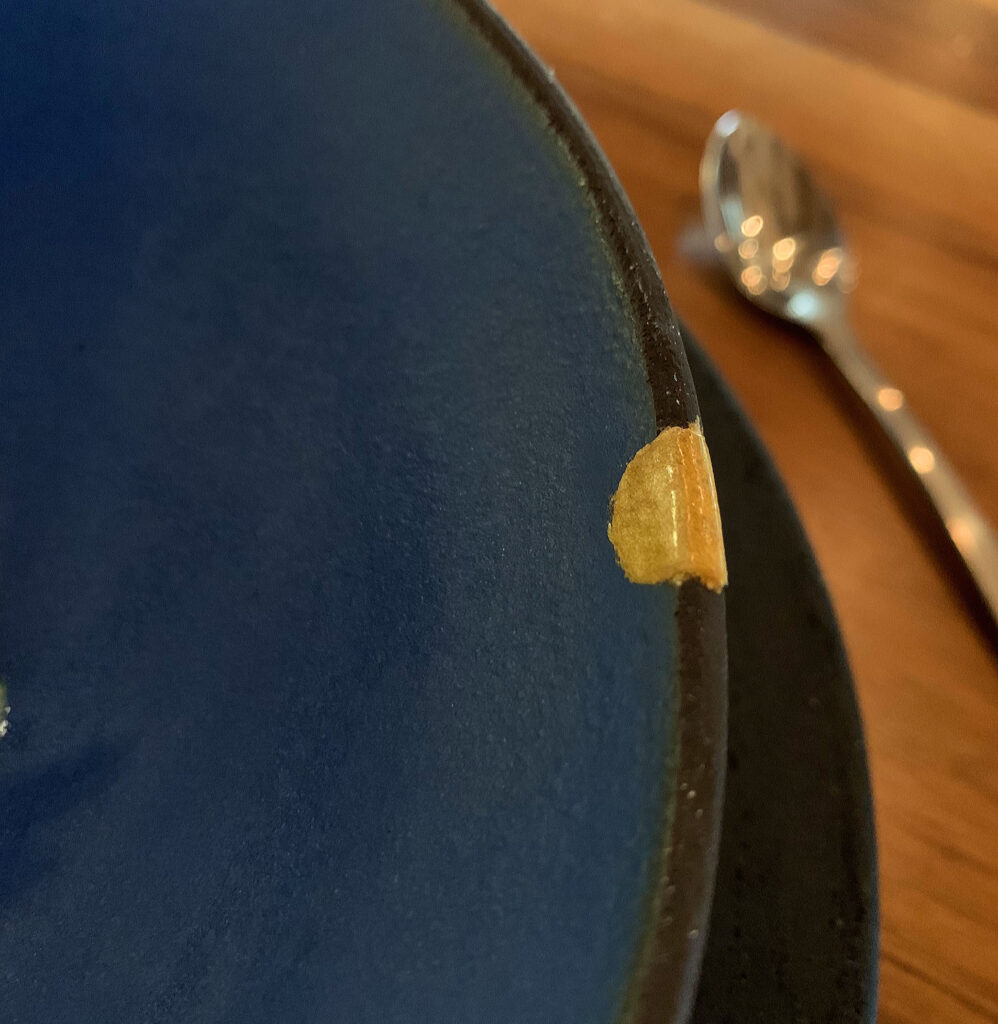
Smyth’s humility, in this manner, is a huge virtue. The restaurant’s cuisine is naturally more dynamic and experimental than those peers who consciously brand themselves in such a way. That means that certain dishes, on a given evening, are still in the process of being “perfected.” It means that the kitchen’s creativity is raw and sometimes polarizing. But the overall process, hitting an ever-moving target using this week’s particular ingredients, takes precedence. “Perfection,” when it appears, is a by-product. It is an accident, as well as a reward for pursuing some greater ideal through the craft of food.
The thought that a $300 tasting menu might serve you a dish that is only half-finished conceptually seems antithetical to notions of “luxury.” It certainly stands wholly opposed to the market researched, bucket list, one-and-done kind of establishments that rely on impressing a steady stream of suckers. “Perfection,” to them, is everything, and they will play their hits endlessly so they can play the role of Michelin-starred chef on TV. Yet, for those experienced enough to see that the emperor has no clothes, such restaurants seem suffocatingly static and a bit despicable. Why invest so much time and effort in scaling the mountain—one mountain—only to stop short of pursuing the personal peak that lies ever-higher? Why freeze yourself in time, jealousy clinging to media status, rather than actualize the fullness of your craft and reward those who might like it enough to come again?
You cannot answer those questions, but it is clear—upon dining at Smyth—that Shields and Feltz are of a creative caliber that cannot be found elsewhere in Chicago (and that remains all too rare across all global gastronomy). This necessarily entails that some dishes will fall flat. The chefs, in their work, will hit lower lows than some of their peers, but the highs are so high and so ceaseless—month after month—that the process proves its value. Structurally, this hyper-seasonality demands quite a bit of extra work. The restaurant, certainly, no longer has the easy story of The Farm to fall back on and ground its decisions. But the faultless warmth of the entire team and the magic of the peak-end rule ensure the kitchen can always carve out a bit of space to experiment and to dream.
Once you get a sense of the creative journey that Smyth, six years on, remains wholly devoted to, how can you stand to go anywhere else and watch a mere rerun? You do, perhaps, sell your city and its other chefs a bit short. But dining at Smyth represents a paradigm shift away from the uglier, “exclusive” side of luxury toward a kind of good eating that stands rooted in—rather than apart from—the flow of life. Shields and Feltz invite you to connect with the community that has formed within their four walls, with the vision that guides them (sometimes blindly) toward fulfilling nature’s potential. They succeed, as Smyth always has, in conjuring feelings that penetrate beyond this mortal coil—beyond mere sustenance, status insecurity, and star ratings—to arrive at the sublime. The restaurant’s best work, undoubtedly, still lies ahead.


